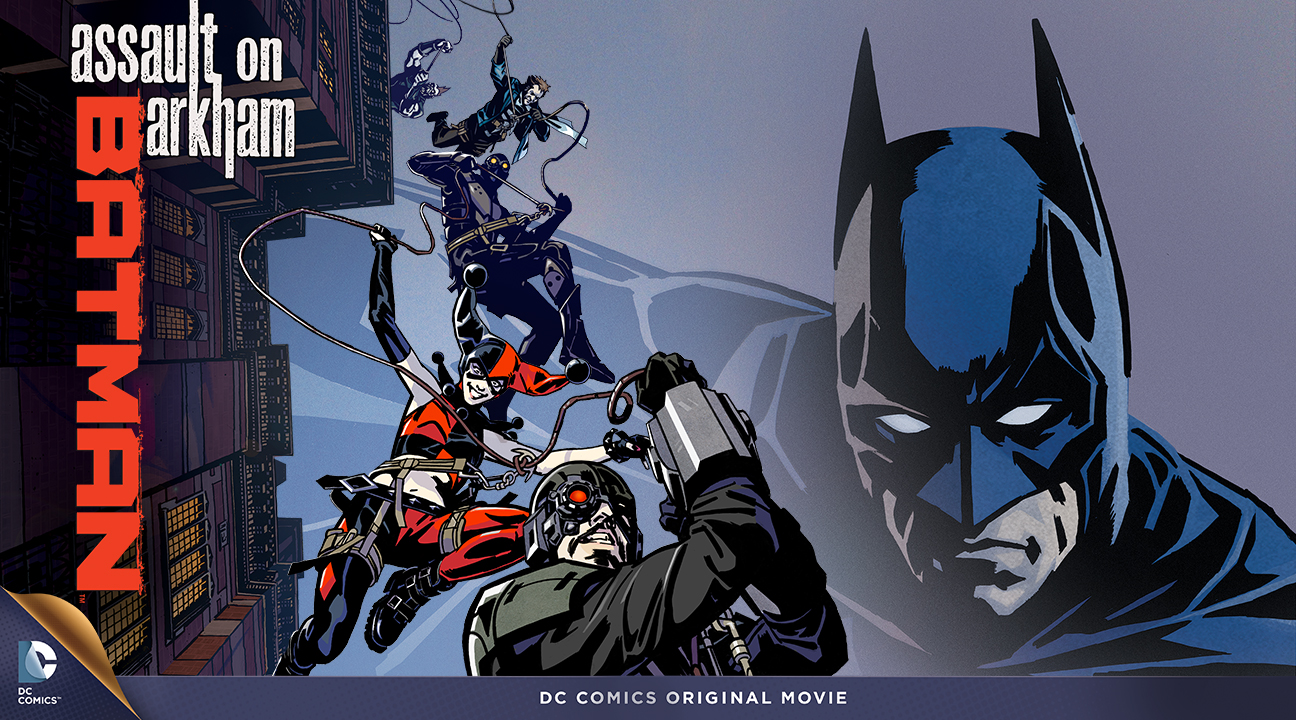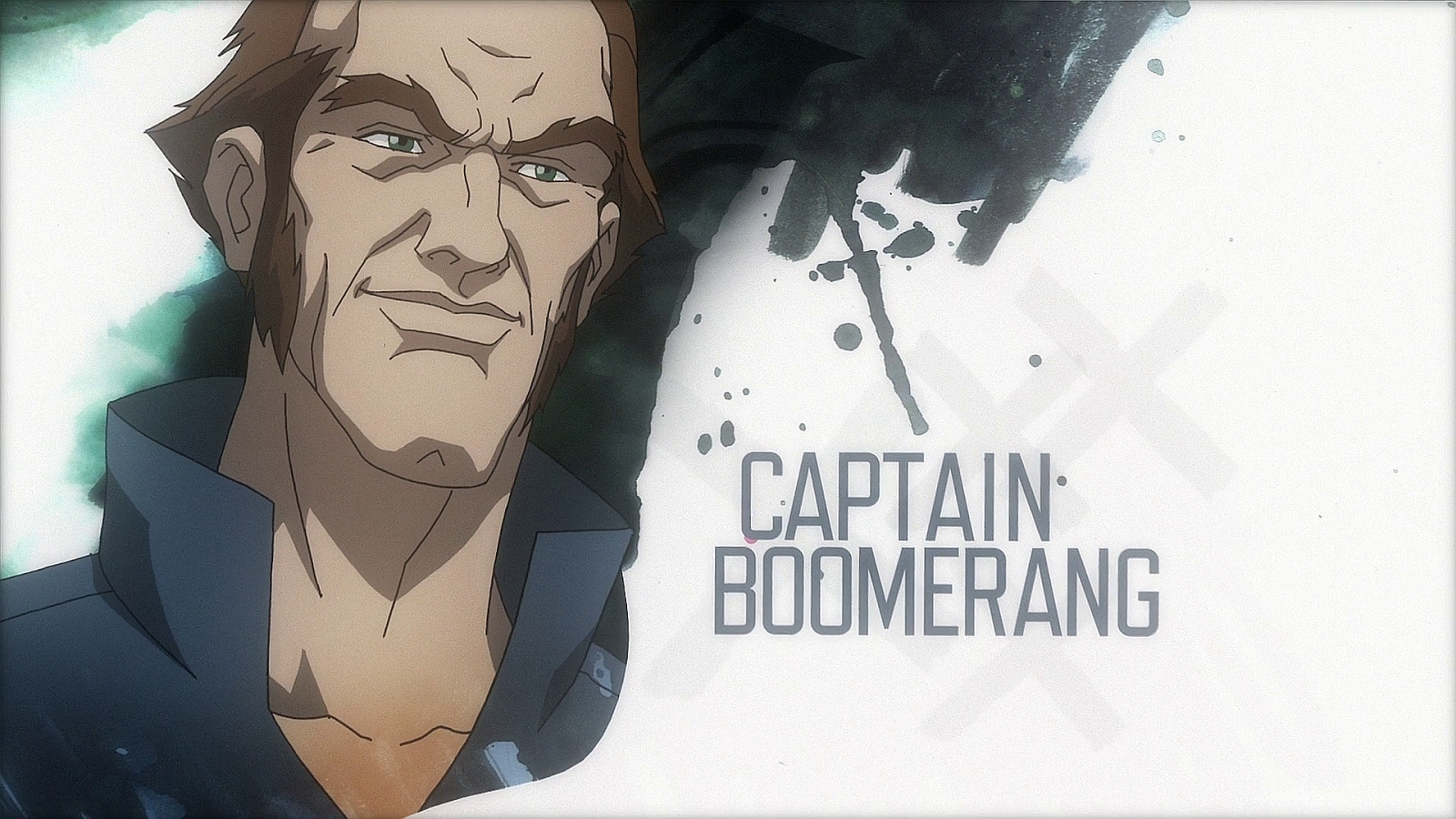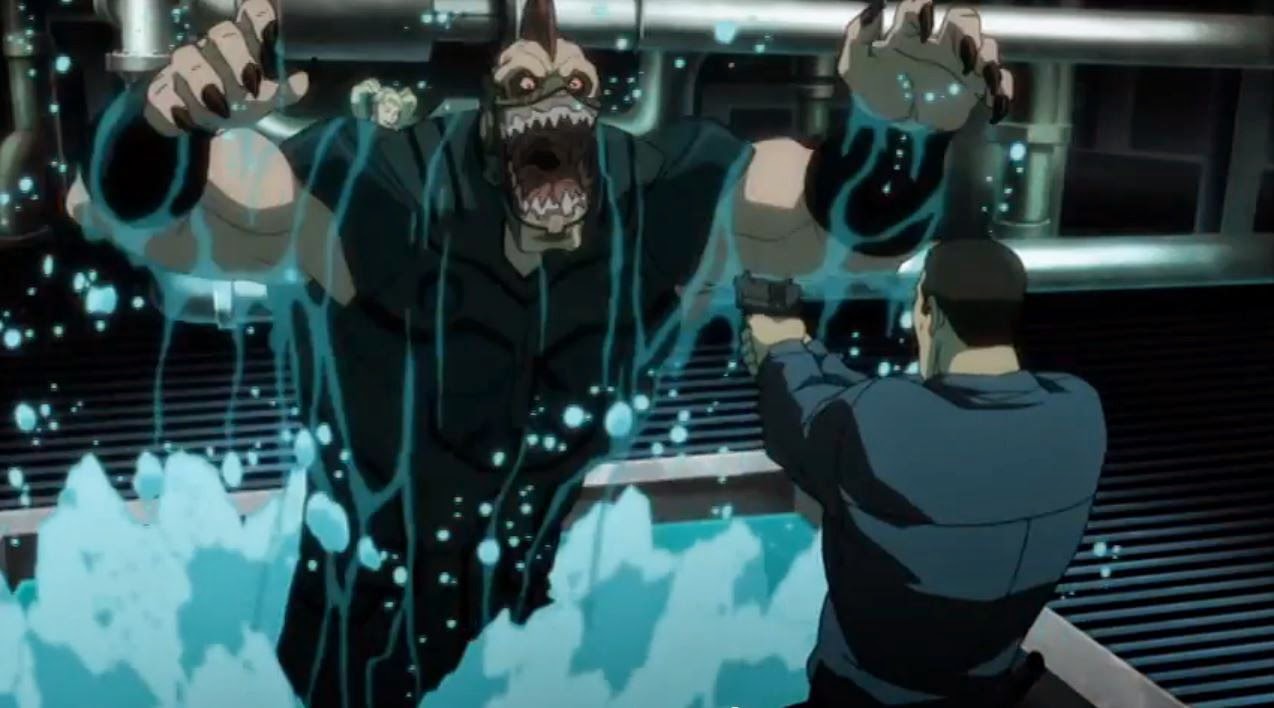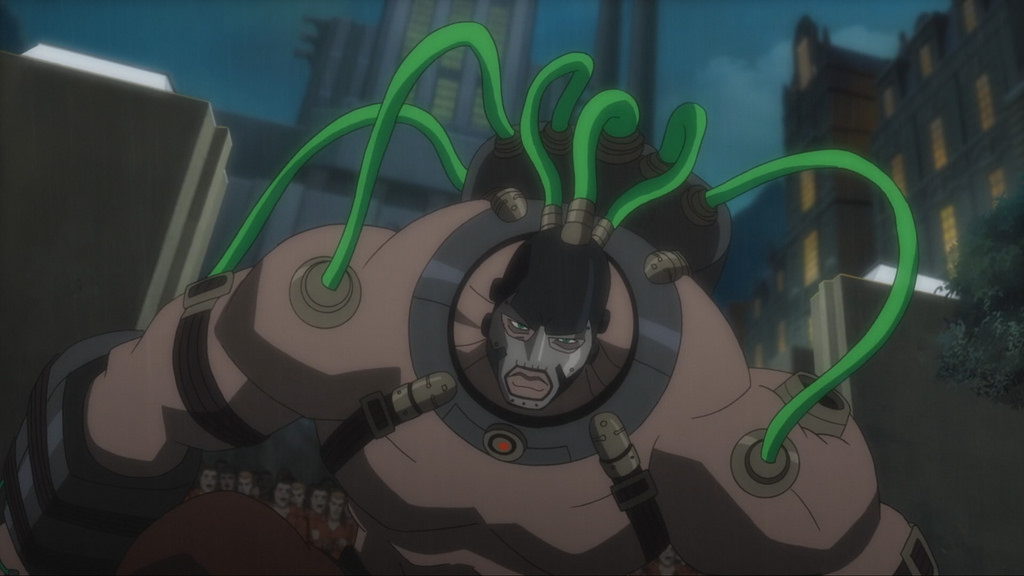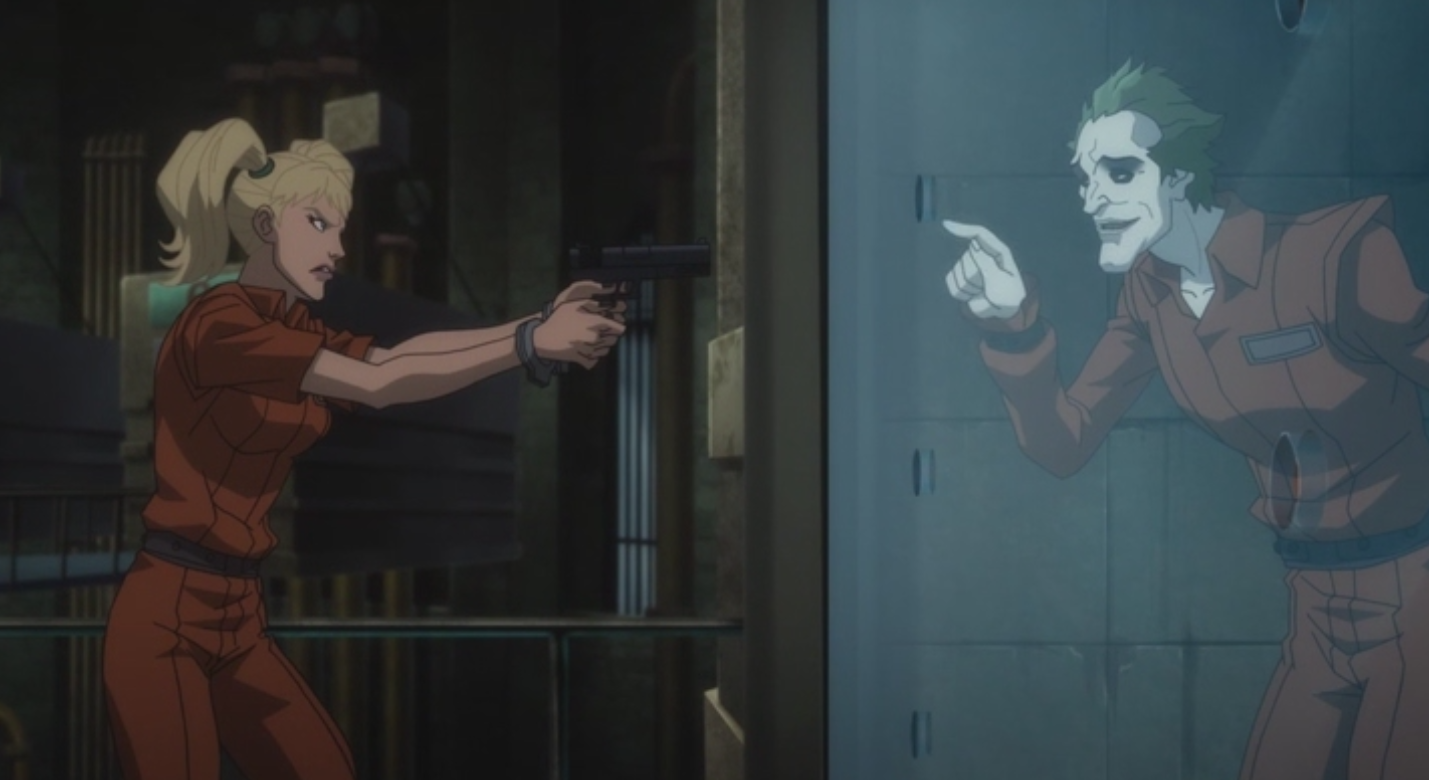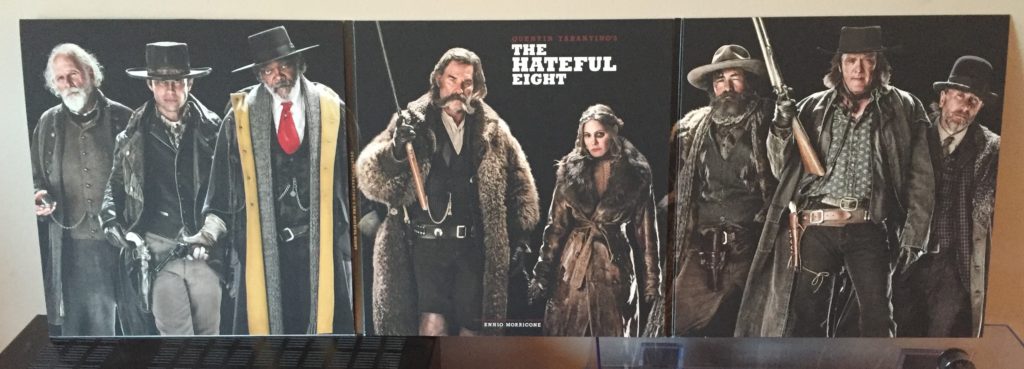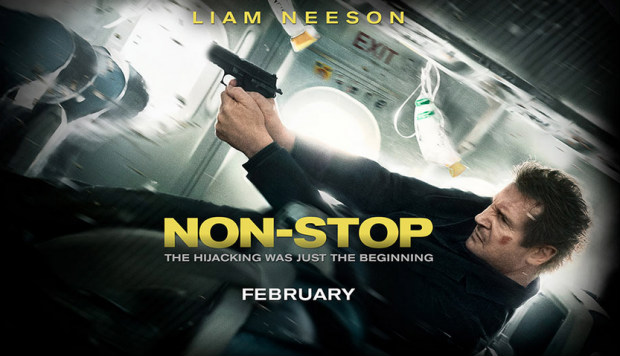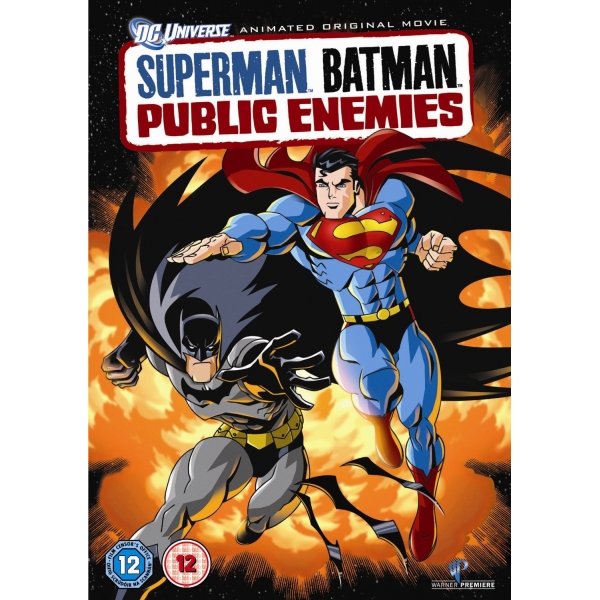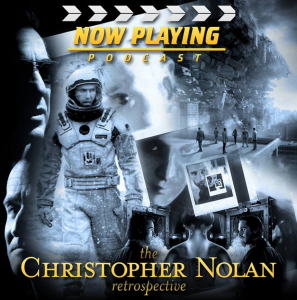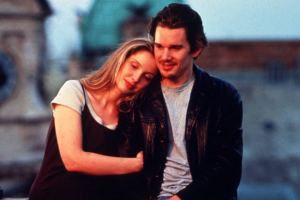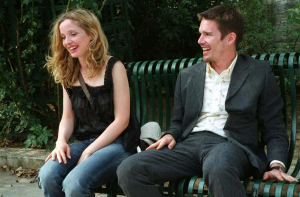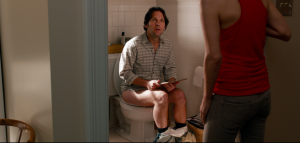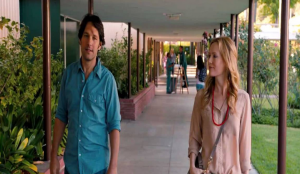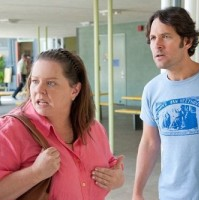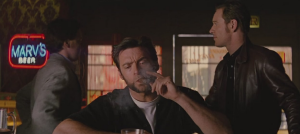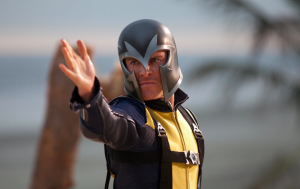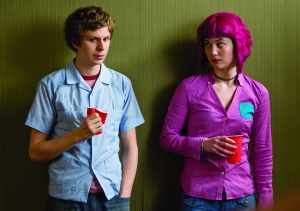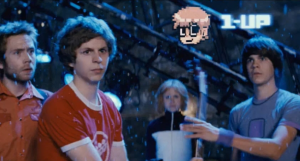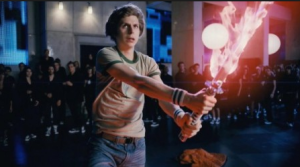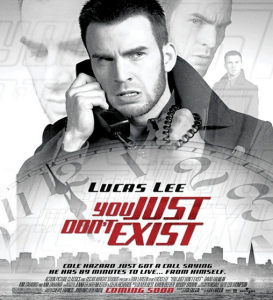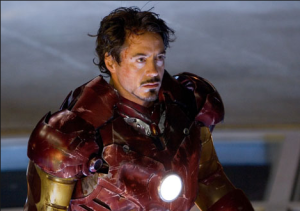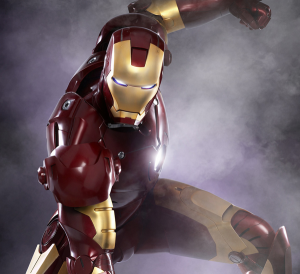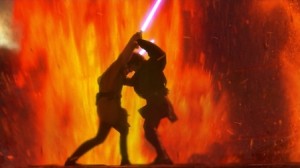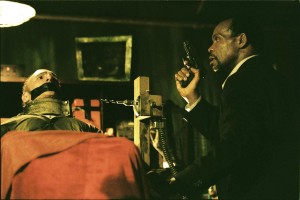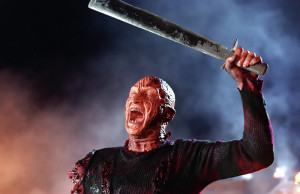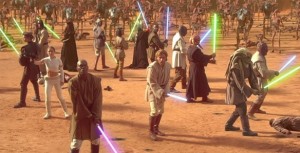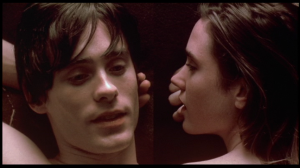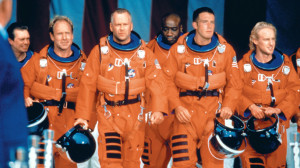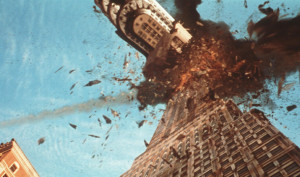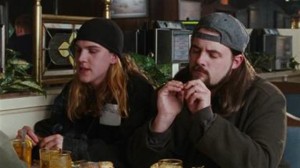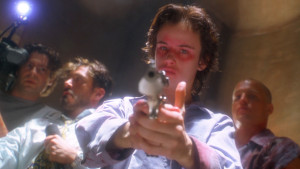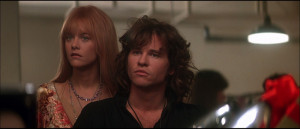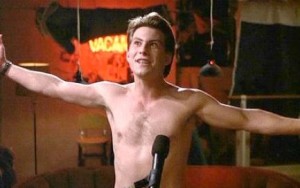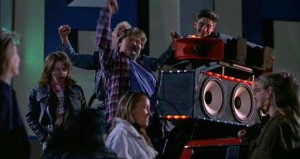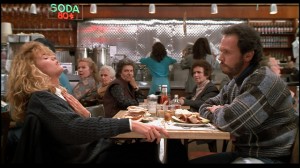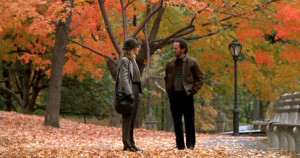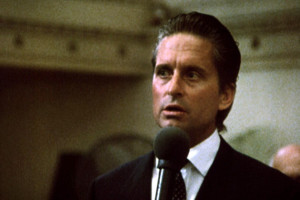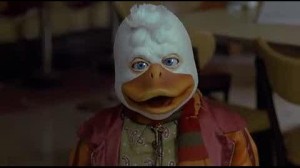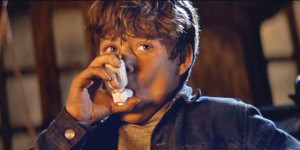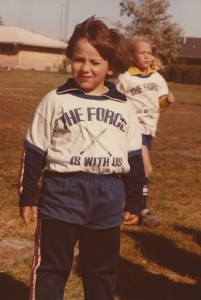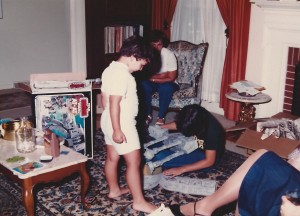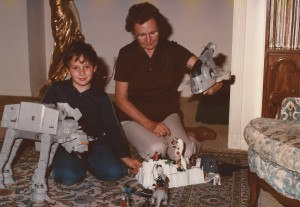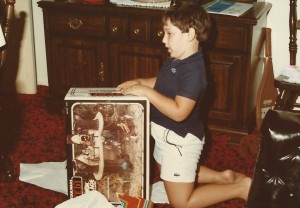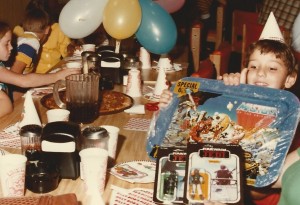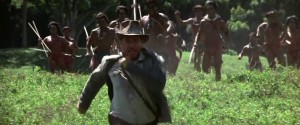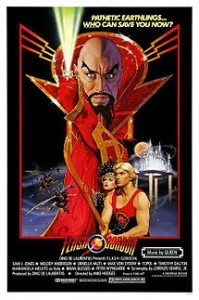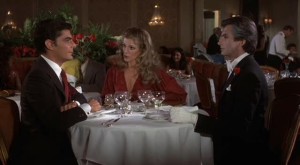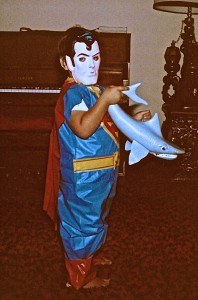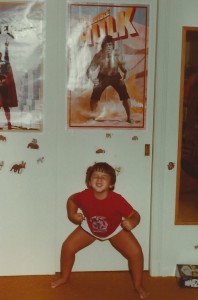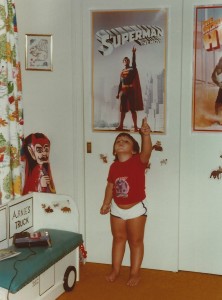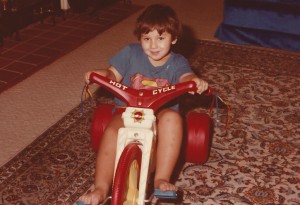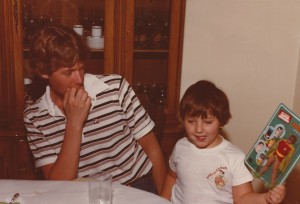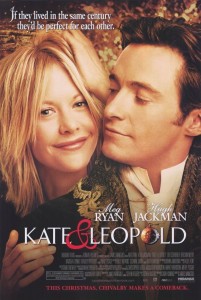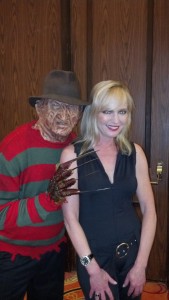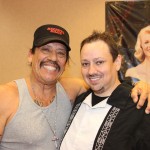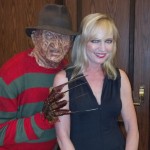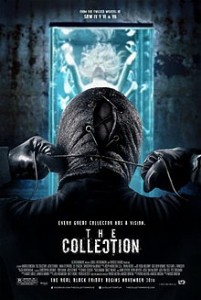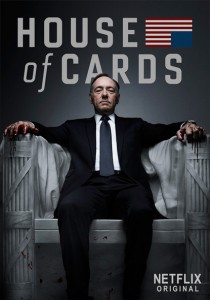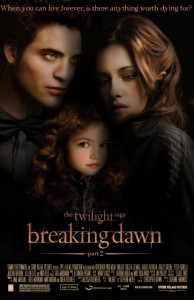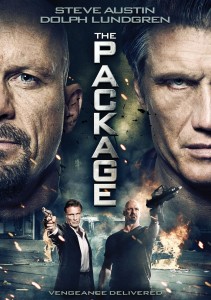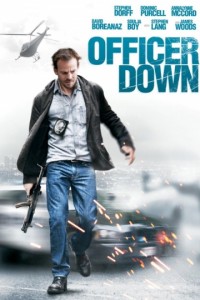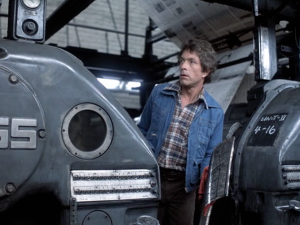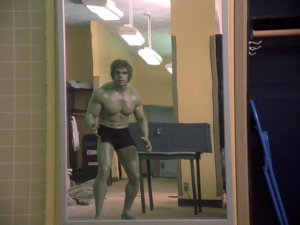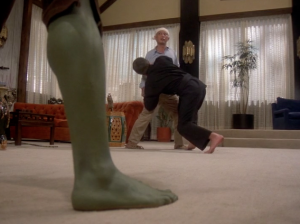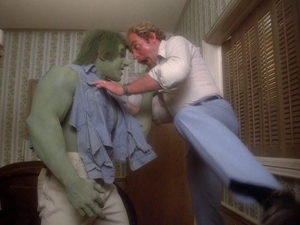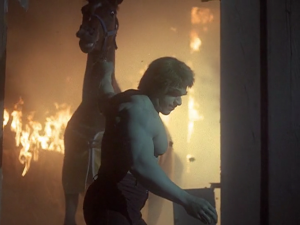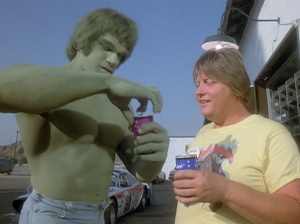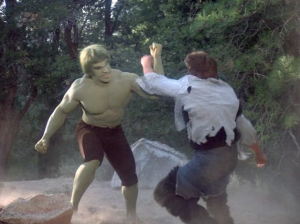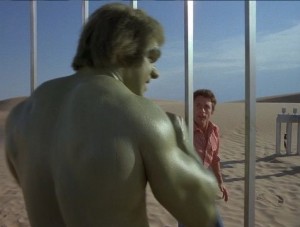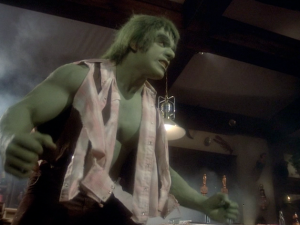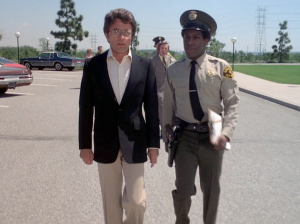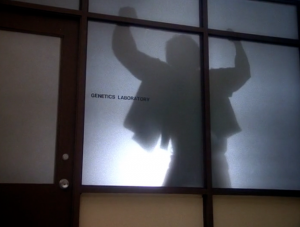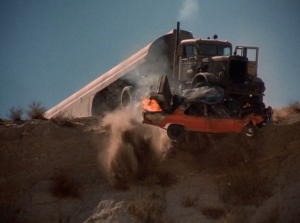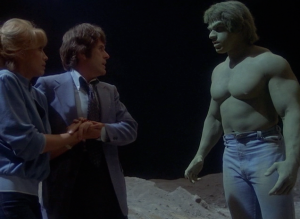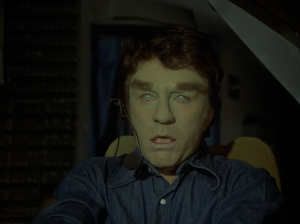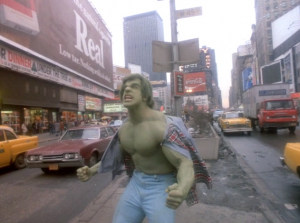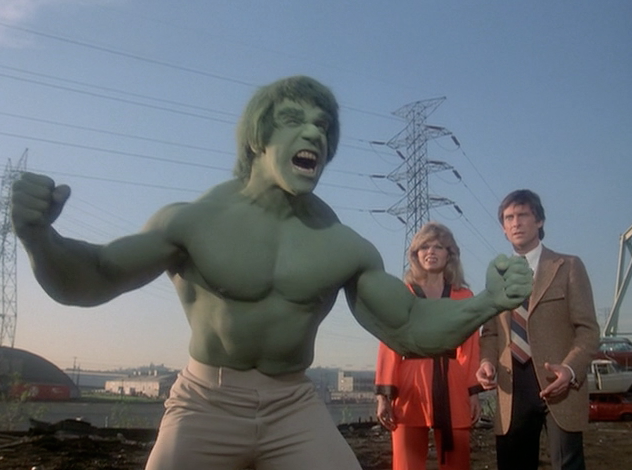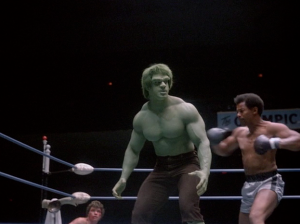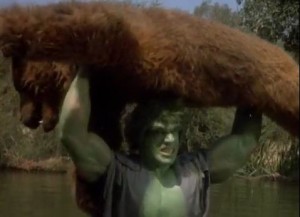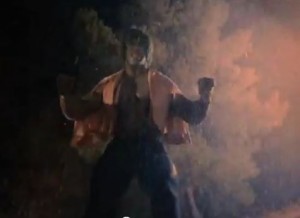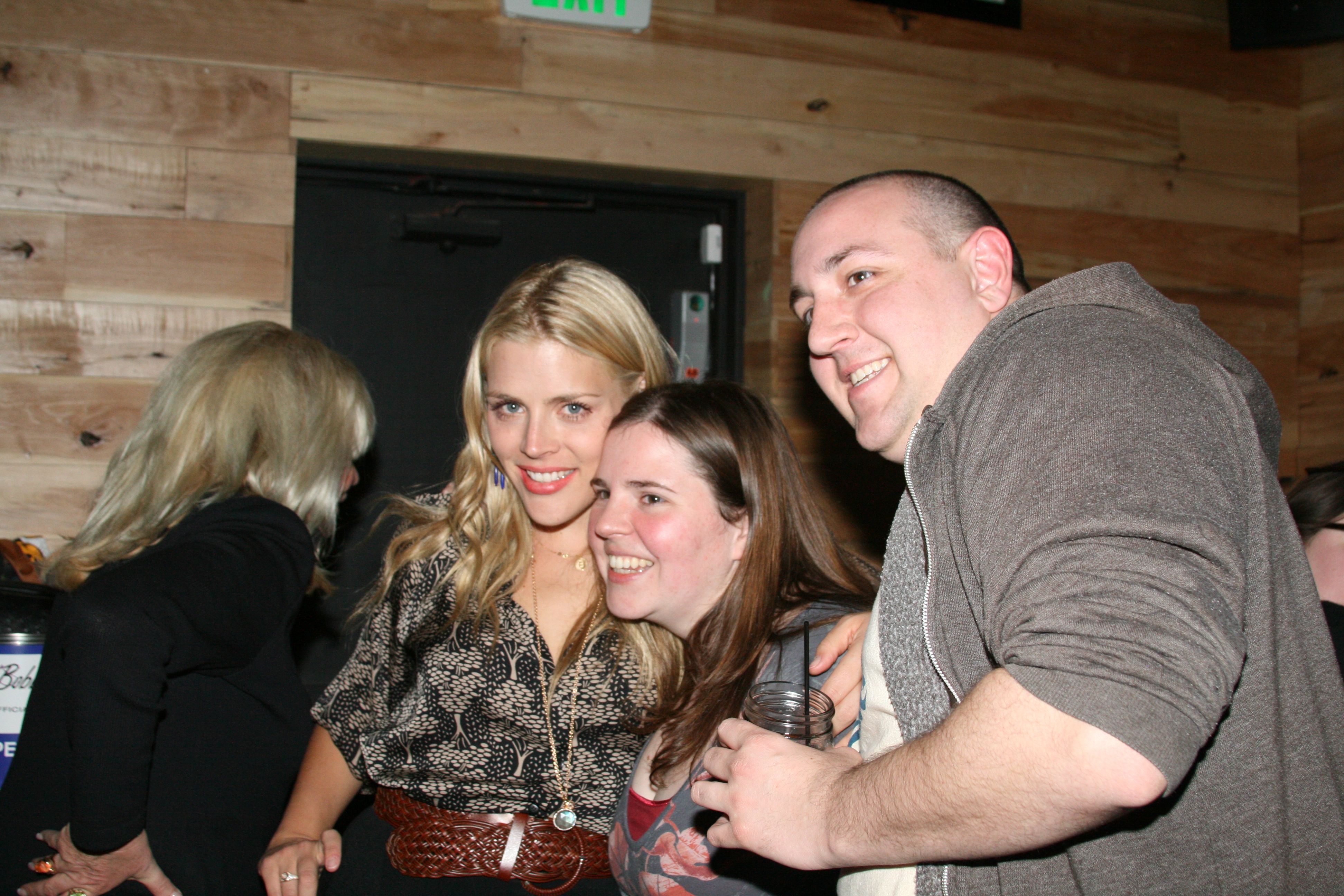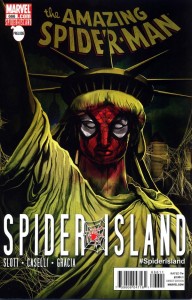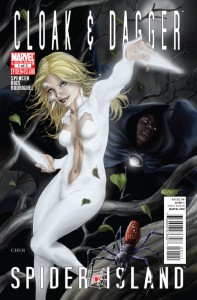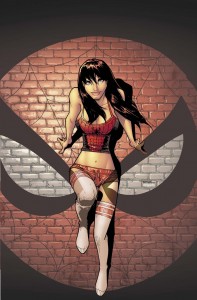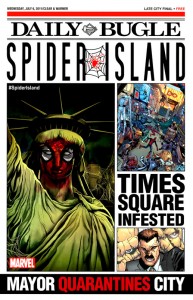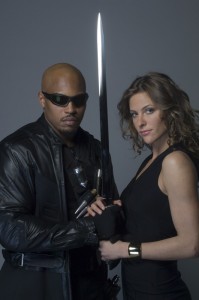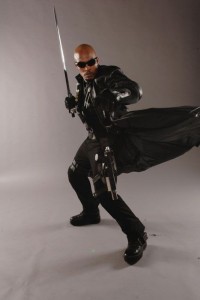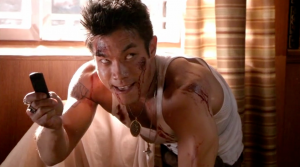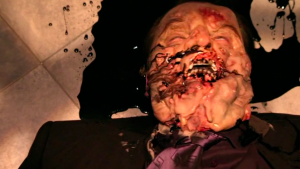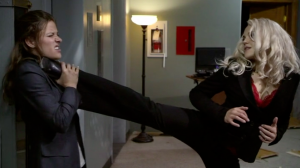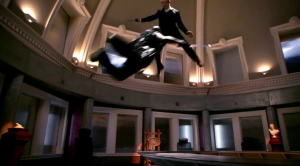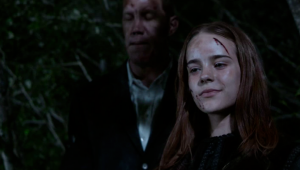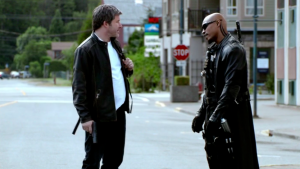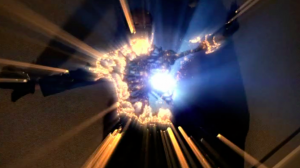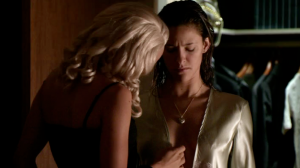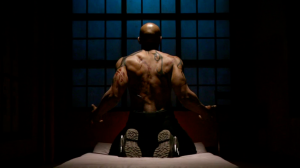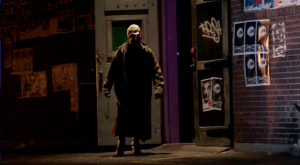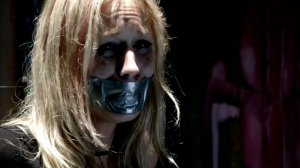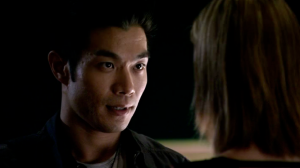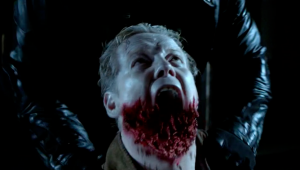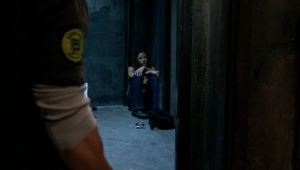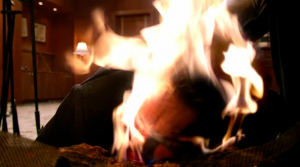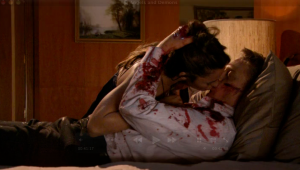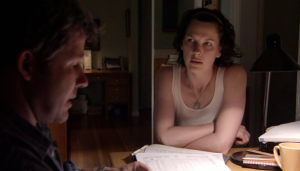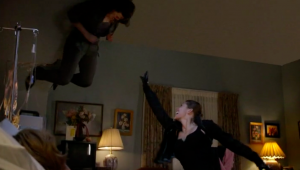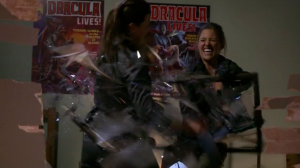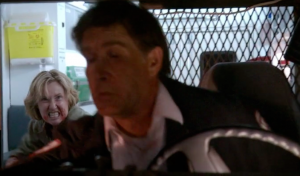Friday the 13th (2009) – Revisited
by Arnie Carvalho

“No matter how much you love the original films in the Friday the 13th series,
it’s virtually indisputable that the 2009 remake/reboot/re-
imagining is far and away the best made of all of them.”
— Adam-Troy Castro, Syfy.com
“Can we now admit ‘Friday the 13th’ 2009 was damn good?”
— Michael White, Bloody-Disgusting.com
“It is one of the best film franchise reboots put out in theaters in the past 15 years.”
— Jason Parker, Friday The 13th Franchise.com
“I’ve always been of the mind (and it’s a hill I’ll die on), that it kinda just
makes no sense to be a fan of the original Friday the 13th movies and yet not
a fan of Friday the 13th ’09”
— John Squires, Editor in Chief of Bloody Disgusting.com, on Twitter
“Stay away from this movie. It really is one of the bad ones…
Run from this movie. Do not reward the makers with your money”
— Arnie, Now Playing’s 2009 Podcast review
“In three years no one, absolutely no one, will remember that they saw it, that
they liked it, it will have no aftertaste whatsoever. People will remember
the original, they will not remember this movie.”
— Stuart, Now Playing’s 2009 Podcast review
Still Now Playing 10 Years Later…
Today is a momentous day in my life. It’s a birthday of sorts.
While Now Playing Podcast started in 2007 it (like many shows, TV, radio, podcast, and otherwise) went through some growing pains. Cast changes, an irregular release schedule, and format changes all marred the first two years.
That began to change on January 9, 2009 — the date we released the first episode in our first retrospective series: a review of 1980’s Friday the 13th leading up to the 2009 reboot. The show went from two hosts to three (that would begin rotating later that same year). The “Recommend/Not Recommend” finale was solidified, as were patterns of series-specific opening credits, art, and titles for each film series.
Yet it’s arguably today, Friday, February 13th, that could be seen as Now Playing’s true 10th anniversary. It was the day we recorded our final Friday the 13th review. By that point we knew the retrospective was a big hit. Despite initial misgivings, we decided to immediately continue the format and review Star Trek leading up to its reboot. Stuart even went out and bought a microphone and literally stopped “phoning it in.”
I’ll never forget the night of Friday, February 13th, 2009. I was in New York City covering Toy Fair International. I went to see the Friday the 13th reboot in a Times Square movie theater, accompanied by my wife Marjorie. The excitement that caused me to begin the retrospective series was reaching its peak as the lights went down and the movie started.
Flash forward to five hours later. I’m in our hotel room (small, as most all NYC rooms are). I’m pacing. My iPhone 3G is hot against my face from being on a call for so long. I’m on a telephone recording my disappointment with the 2009 Friday the 13th reboot. Brock is in Chicago recording the call, and he would edit the show released to our listeners the following Monday.
All three of us had very similar reactions, and the reboot became the fourth Friday the 13th, out of 12, to get three red arrows on our website.
I honestly never looked back.
“Distance not only gives nostalgia, but perspective, and maybe objectivity” — Robert Morgan
As the 10th anniversary of the Friday the 13th reboot approached I came upon an interesting and unexpected turn of events: a number of think pieces were published celebrating the film. Even those who had reacted poorly to the movie initially had come around and not only enjoyed but celebrated director Marcus Nispel’s fresh take on iconic slasher Jason Voorhees (played by Derek Mears).
I started to question my own memory. Could they be right? Could that movie have aged well?
Having been a movie critic for over a decade I know from experience one of the hardest things to do when reviewing a film is to separate expectations from the final product. Movies are marketed to create expectations–to get you into a theater seat and spending money expecting delivery on what trailers, interviews, and even posters have sold.
Going into Friday the 13th in 2009 my expectations were sky high. I had loved Nispel’s Texas Chainsaw Massacre remake far more than the original Tobe Hooper film. I loved Jason as a killer. Jason’s last appearance on screen in 2003’s Freddy vs Jason was one of his best, and that movie’s writing team of Damian Shannon and Mark Swift were writers for the remake.
Could the movie have been good, or at least recommendable, but simply not met my expectations?
10 years have passed, so I decided to find out. For this re-review of 2009’s Friday the 13th I watched the extended “Killer Cut” released on Blu-Ray and Video on Demand. This cut was nine minutes longer than what I saw in theaters.
The Review
I watched the movie having not listened to our 2009 podcast since it was released. I remembered very little going in, only that Stuart thought Jason was a pothead. Then after watching the movie I listened to our old podcast to see what it was that got me so worked up.
SPOILERS BELOW for this 10-year-old movie!
I liked the opening. This is a reboot, and people want Jason as the killer, not old lady Pamela Voorhees. Yet Pamela’s plight from Sean S. Cunningham’s 1980 original Friday is integral to the Jason mythos. To have the climax of the original movie done in montage fashion pays homage and checks the boxes. It does create a confusing timeline as to Jason’s supposed drowning, but handled well.
Then we have the second prologue and, not having seen the movie in a decade, I was faked out. I thought this would be the movie and these five characters, Wade (Jonathan Sadowski), Richie (Ben Feldman), Mike (Nick Mennell), Whitney (Amanda Righetti), and Amanda (America Olivo), were going to be our core cast. They actually seem like a fun group and call back to so many earlier Friday the 13th casts where there’s couples hooking up…and the lonely odd man out. That Jason comes in and killed so many so quickly was a shock.
Then comes our new Jason by Derek Mears. One of my big problems in 2009 goes back to expectation: I was used to the Jason played by Kane Hodder. Jason had gone through many iterations, from bag-wearing woodsman to space-zombie, but the walking after people who run, the nearly supernatural way of catching the prey, seemed like a staple.
This Jason was fast and aggressive. He killed brutally. And he used tools and more thought power than earlier Jasons. Hanging one woman over the campfire to burn while setting a bear trap for another victim really wasn’t in Jason’s modus operandi. But then I had to remember, this is a reboot, not a remake. The Friday the 13th series had lost its luster by doing the same things again and again. In 2009 I couldn’t reconcile this Jason with the ones before. Now I realize this reboot gives us an entirely new Jason.
If I just accept this is a new character, perhaps call him “Jimmy Voorhees”, I’d have no trouble with these new killings. Nispel wanted to revitalize the character and return him to his violent, horror roots. Nearly 30 years had passed since Jason first wielded his machete. It may not be the Jason I wanted, but this viewing I can accept this “Jimmy Voorhees.”
The two characters coming upon Jason’s cabin (plus the bag over Jason’s head) took me back to 1981’s Friday the 13th Part II, and I can go with it.
Not only did the prologue surprise me in killing (seemingly) everyone so fast, I also understand the need to have a body count. One of the pressures with each new horror movie installment was to have more kills. Here, we establish Jason as a badass killer, and we got five good kills. And for those who expect topless women in your Friday films, you got that out of the way too.
Plus, the gore! I was watching the unrated cut, but I marveled at how freely the blood flowed.
Then we actually get to the movie. Again, my expectation was, since we had Shannon and Swift writing again, that we would have a group of fun, believable characters like they gave us in Freddy vs. Jason. Instead, we have a group of character types that would never be friends. I had a real problem with that in theaters.
Yet, when watching it at home on a television, I found myself more forgiving. How many groups of totally different people went camping together in the past? Sure, Parts 1 and 2 made them counsellors thrown together, and 8 had them as classmates, but the victims in parts 3 and 4, and especially 7, don’t feel like they’d hang out together either. So, is this bad writing…or is this an intentional homage to the bad writing in previous installments? More, if I can accept these weird groups in earlier films, why not here too? So, I compartmentalized that complaint and, instead, found these seven young adults appealing, flawed characters, most of whom were obviously going to end up impaled on a machete.
Trent (Travis Van Winkle) is a great douche you love to hate (and with a rich boy name like Travis Van Winkle I wonder how much he was acting). Bree (Julianna Guill) is a wonderful seductress, and the attraction Chewie (Aaron Yoo) shows for Bree takes me back to Crispin Glover’s character in The Final Chapter.
Lawrence (Arien Escarpeta) is a stoner that feels like he would hang out with Chewie. The other couple of Chelsea (Willa Ford) and Nolan (Ryan Hansen) aren’t in the film long enough for me to get a bead on them.
Which does raise one flaw–this group is too big to keep track of. They’re here for a body count, but I’m not sure they are disparate enough where I can even assign them tropes of “the smart one” and “the shy one”, etc. Especially Chelsea and Nolan, they are the flattest of characters.
Then we have typical last-girl Jenna (Danielle Panabaker). Like so many Jason survivors in films past, she’s a brunette, she’s smart, she doesn’t smoke weed, and she doesn’t get naked. And when she encounters, and partners with, Clay Miller (Jared Padalecki) who is searching for his missing sister Whitney, I’m taken back (in a positive way) to the similar plot in The Final Chapter.
The kills also are varied. I had a problem with Jason using an arrow to kill Nolan, but he used a crossbow in Part II so this wasn’t so far off. And again, this is the new “Jimmy Voorhees.” He’s a survivalist. He has to hunt to survive. It makes sense he’d be good with a bow. (It equally makes sense that this Jason is far more intelligent than the previous incarnations and so he uses Kerosene to power his home). And Chelsea’s machete-in-the-head gave Jason his usual, nearly supernatural sense of where his victims hide.
So halfway in the movie I wonder…was I too harsh on Friday the 13th? Did I allow my expectation to cloud what was delivered?
The answer is….partially, for the movie really does fall apart in the second half.
Nispel was best known (and may still be best known) for his Texas Chainsaw reboot. I don’t know if Nispel rewrote any of Shannon and Swift’s script, but the second half does turn this new Jason into a wannabe Leatherface. Why are there catacombs underneath Camp Crystal Lake? It makes no sense. Why did Jason kidnap Whitney? It makes no sense. Why does Whitney look so good after six weeks of captivity? It makes no sense.
Yet the deaths continue to impress. In this “Killer Cut” Chewie’s slow death in the tool shed was painful to watch as he writhes, groans, and bleeds for a very long time. Lawrence’s kill by Jason throwing an ax goes back to the survivalist skills, and creates a more “realistic” Jason who can’t just walk after every person who runs.
The best death/fake-out may belong to Trent, though. Waving down a tow truck, a silent hand waves Trent to get on. Can this Jason drive a car? No…it’s an old man on oxygen, unable to shout to the young man whose hesitation results in his being impaled on the truck as it drives away.
Yet another decent fake-out is Jenna. She seemed like the perfect “last girl” and, echoing The Final Chapter‘s Trish, I thought it was a given she’d escape. But two brunettes is one to many in a Friday the 13th film so when Whitney is discovered alive Jenna had to die.
The rest is pretty rote action with Jason just dead enough for a climax, yet, of course, always ready to come back for another sequel.
The Verdict
So, was I too harsh on the 2009 Friday the 13th? Yes, I clearly was. My expectation of what the previous Fridays had given clouded my ability to appreciate the changes Nispel tried to bring to make a Jason that could be scary in the 21st century.
Yet, the writing becomes very lazy in the second half. The film is almost a straight downward line, its quality decreasing with every passing frame of film, start to end. At no point does the body of the film reach the highs of its two prologues.
While this is a totally new Jason, much of the film, including the group of victims, is a throwback to the installments released 1980-1984. I wasn’t a fan of many of those early groups, so this is not a success, but it’s not worthy of the damnation I gave on the podcast.
So is it a recommend or not recommend?
It is on the borderline. I think that slasher fans will have a lot to enjoy, while old school Friday the 13th fans will have a lot to swallow.
The ridiculous ending, including everything after the rescue of Whitney (the tunnels under the camp, the convenient machinery, the obvious final “jump scare”), make me stand by my red arrow. But it’s a close call, and it’s what I’d call on the podcast “A very weak not recommend”…which is the most positive thing said about this movie in the entire history of Now Playing Podcast. |  |
(the tunnels under the camp, the convenient machinery, the obvious final “jump scare”), make me stand by my red arrow. But it’s a close call, and it’s what I’d call on the podcast “A very weak not recommend”…which is the most positive thing said about this movie in the entire history of Now Playing Podcast.
Yet the film has had a longer lifespan than I had imagined ten years ago today and, had it not been for endless legal wrangling over Friday the 13th’s IP rights, I have no doubt “Jimmy Voorhees” would have returned to slay again.
Yet while lawsuits continue over who has the right to make the next Friday film, I look forward to it. Ten years is the longest Jason has ever gone without a movie since his inception in 1980. He is missed, and hopefully Jason Voorhees, not “Jimmy”, will return to the silver screen again in the near future.
Agree? Disagree? Let us know in the comments below!
Hear Now Playing Podcast’s original retrospective series, 12 reviews of Friday the 13th films (plus a bonus recap episode), all available now at NowPlayingPodcast.com
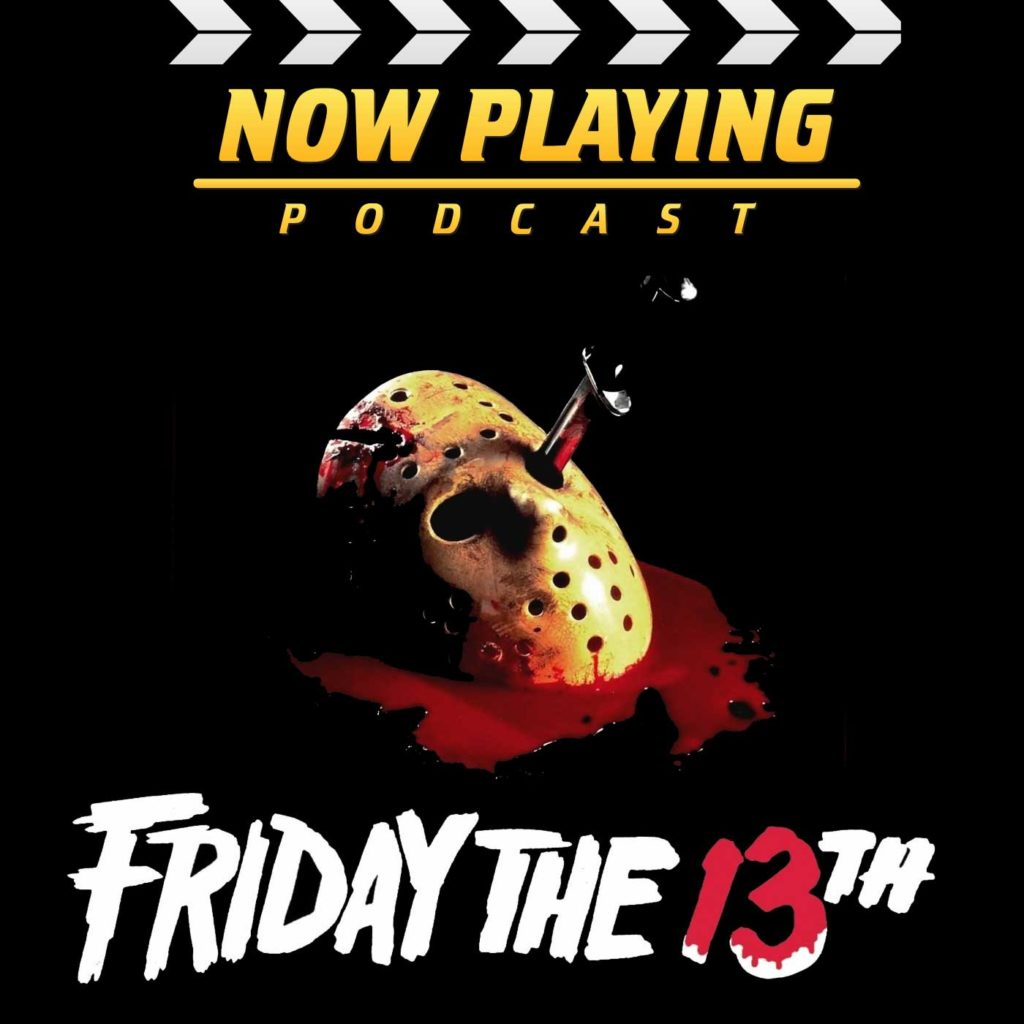
February 13, 2019 Posted by Arnie C | Movies, News, Now Playing Podcast, Podcasts | 2009, Friday the 13th, jason voorhees, Marcus Nispel, Movie, Movies, Now Playing, Now Playing Podcast, Podcast, Podcasting, Podcasts, Reboot, Remake, Review | 3 Comments
PEELERS Review: This Zombie/Stripper Film Isn’t APEEL-ing, it’s Appalling.
Review copy provided courtesy of October Coast Publicity
I like zombies. I like strippers. So it seems zombie-strippers would be (pardon the pun) a no-brainer. But 2008’s Jenna Jameson/Robert Englund film Zombie Strippers fell in its high heels. 2012’s Zombies Vs Strippers failed to get a rise out of me. And defying my expectations, Sevé Schelenz’s new film Peelers is even worse than those two previous efforts.
Peelers’ concept is simple enough. When four coal miners accidentally strike oil they head to the Titty Balls Strip Club to celebrate. And it’s the club’s last night as owner “Blue” Jean Douglas, played by Wren Walker, has sold the club to a land developer who plans to shut it down. Soon their night of revelry turns into revulsion as the black ooze infected the miners turning them into bloodthirsty, mindless killers. No one in the club is safe, and the infection is spreading.
This set-up seems like a perfect throwback to ‘80s slasher films. I had low expectations for Peelers, but if it could give me base genre thrills along the lines of Prom Night 3 (yeah, part 3, not even part 1) or Friday the 13th Part VIII: Jason Takes Manhattan I would have given this film a solid recommend.
Sure enough, the film’s set-up seems to indicate that’s what I’ll get as we’re introduced to owner “Blue Jean”, her bad-boy brother Logan (Madison J. Loos), and the various strippers, bouncers, bartenders, and cooks that populate the Titty Balls. Instantly we see a large cast we know will lead to a decent body count. And it doesn’t take long before the miners arrive, and one begins regurgitating and transforming into a zombie.
And I was jazzed by some comic book cred. One character is named Logan, and another is Remy. I could chalk that up to a coincidence, but when the bartender drops a line about adamantium it’s obvious writer Lisa DeVita is an X-Men fan.
From there all the film had to do was coast on “cruise control” and give me some inventive kills along the way. Unfortunately first-time screenwriter DeVita can’t even accomplish that.
The set-ups in this film are so obvious I thought DeVita was trying to be funny. In the first fifteen minutes of the film we are introduced to what I can only call Chekhov’s arsenal: the strip club has a baseball bat, several handguns, and even, improbably enough, a chainsaw. Clearly every awkwardly-shown item will (and does) lead to later zombie defense.
But soon I realize the script wasn’t being ironic, it’s just poor. The plotting is confusing in several ways. For example, the miners believe they found oil, but it smells awful and converts them to zombies. Yet later we’re told it is still actual oil that can fuel your vehicle…and turn you into the living dead?
Beyond ridiculous, the script is downright ignorant. (Minor spoiler) The kryptonite for these oil monsters isn’t a gunshot to the head, it’s….water? The rationale is “Water and oil don’t mix” so, obviously, water will kill these bloodthirsty beasts?
Unlikely as it seems, the stupidity only escalates from there! The survivors in the club could just run away, but “Blue Jean” marshals them to stay and fight, lest these monsters go to the general population. Yet no one realizes that if they just wait out one good rainstorm then the problem will take care of itself.
Additionally, this group has every weapon known to god and man, but not one person has a cell phone?
If I gave the film the benefit of the doubt I’d say this was all intentional humor, but the leaden dialogue delivered by a cast of complete unknowns makes it all seem deadly serious. And deathly boring.
Yet I found myself slightly impressed with the production. Post-viewing research told me Peelers was a Kickstarter-funded film made for about $20,000. For that small sum Peelers achieved quality sound work, and decent camerawork. I looked up cinematographer Lindsay George and he has over a decade’s work on shorts and television. The result is a professional looking production that seems to make spectacular work of existing lights, and good effect of digital video cameras that work well in low-light conditions.
Some of the gore effects are also passable for cheapie-horror.
But if I’m complimenting a movie for saying it’s well lit, I’m stretching to find compliments. George is a good cameraman but he had nothing good in front of the camera to film. And several times he’s let down by poor staging and editing that makes action scenes downright confusing.
If you’re only requirement for this film is gratuitous nudity, yes, you’ll find it here, but every single bit of it is undercut by the most repugnant of “humor.” One stripper does her dance, only to end by giving guys in the front row a golden shower. Another stripper is late into her third trimester. I’ve been to a couple dive clubs in my life, but this is simply grotesque.
And yes, one zombie is indeed killed when the pregnant stripper’s water breaks on his head. If you think that sounds cool, you’ll still be bored as hell by Peelers.
It takes a lot to revolt me. The strippers here pulled it off. So…congratulations? But it wasn’t even in the fun Human Centipede way. More in the vein of “no one should have to watch this.”
Finally, the title Peelers was misleading. From the poster, showing an amputated stripper, and the title I thought I’d be watching a film about creatures that peel the skin off their victims. It would be the ultimate strip-club irony–a monster that continues to “undress” their nude victims. But these beasts just bite and gouge. The title, I suppose, references the strippers, but I’ve never heard a dancer called a “peeler” before. I suppose it’s a shame the title Striptese, Zombies vs Strippers, Zombie Strippers, Showgirls, and Zombeavers were taken. (FYI, every single movie listed there is more enjoyable than Peelers).
The end result is a film that seems to think it’s a cheapie From Dusk ‘Til Dawn rip-off, and ends up being so much worse than either of Dawn’s direct-to-video sequels. It’s not even fun in a so-bad-it’s-good way. It’s a mind-numbing 90 minutes that I will never get back.
The cover art reads “You may not get the happy ending you were looking for.” I certainly didn’t. Neither will anyone who watches this imbecilic production.
Congratulations to the film crew for accomplishing what they did on so little budget, but next time perhaps give that script a second draft before you start shooting.
July 14, 2017 Posted by Arnie C | Movies, News, Reviews | horror, Movie, Movies, News, Now Playing, Now Playing Podcast, Podcasts, Review, Reviews, Romero, Slasher, Strippers, Zombies | Comments Off on PEELERS Review: This Zombie/Stripper Film Isn’t APEEL-ing, it’s Appalling.
Batman: Assault on Arkham is the Original Suicide Squad!
NOTE: Now Playing Podcast and La La Land Records are giving away 5 copies of The Killing Joke limited CD Soundtrack. Follow @nowplayingpod on Twitter and retweet their pinned tweet to enter!
Starting today, DC movies are committing Suicide. Sure, everyone knows Batman, Superman, and Wonder Woman – the featured characters in last Spring’s Batman v Superman: Dawn of Justice. But Killer Croc? Deadshot? Captain Boomerang? These are some lesser known characters–and the stars of the new movie Suicide Squad. With an August release date and a story of criminals out to do good, it’s obvious DC is hoping to capture some of Marvel’s Guardians of the Galaxy magic (and dollars). Outside of comic book die-hards these characters aren’t household names, but with this film DC hopes they will be. So to prepare for this live action film, I watched another movie version of this tale: DC’s 2014 animated direct-to-video Batman: Assault on Arkham.
Like the live-action film, this cartoon tells of a “Suicide Squad” formed to infiltrate Arkham Asylum — Gotham City’s infamous sanitarium for the criminally insane. Government official Amanda Waller calls together a team of seven criminals to covertly infiltrate the prison. Batman foe The Riddler is imprisoned there, and he has a thumb drive that could expose Waller’s above-the-law operations. The group she assembles consists of five lesser-known DC baddies: Captain Boomerang, King Shark, Killer Frost, Black Spider, and the hilariously named KGBeast. For a little star power, the headliners are two more popular Batman enemies: Harley Quinn and Deadshot. For full disclosure, I certainly hadn’t heard of most of the characters in this film. When it comes to DC comics, if a character wasn’t featured in a live-action film or the ‘60s Batman TV show, odds are I don’t know them. I have seen a handful of episodes of Batman: The Animated Series though, and I find great enjoyment in several of DC’s direct-to-video animated films.
I suspect those excited by seeing Captain Boomerang and KGBeast in action are already DC Comics readers and fans. Those die-hards would excitedly pre-order a Suicide Squad animated film, because they know what that means. Instead, for marketing, this movie is called Batman: Assault on Arkham but the Dark Knight is very much a supporting player in this tale. This movie should have been called Suicide Squad, but wasn’t, I suspect, for two reasons. First, invoking Arkham in the title shows this movie is set in the universe of the immensely successful Batman: Arkham video games. In fact, the movie is a sequel to Arkham: Origins and takes place about two years before the original Arkham Asylum game. Second, giving Batman top billing appeals to more casual fans like me. Without a heavy marketing campaign like the live-action film has, I would likely skip an animated movie called Suicide Squad. Call it Batman and you have my interest. If you don’t know these characters as I didn’t, it won’t be a barrier to your enjoyment. These enslaved villains are introduced quickly with ‘70s style title cards announcing their names. Before you know it, this motley crew is rounded up and told of their mission. If they don’t comply, Waller will detonate explosives planted in their necks.
Why are these specific people chosen? Why use criminals instead of more traditional assassins? The film glosses over the answers so we can get to the action! |
| Once the titular Assault begins, the fun never ends. The plot is full of so many twists and turns I am hesitant to discuss them lest I rob you of the fun of discovery. Suffice it to say the team’s objectives change every ten to fifteen minutes, and when Quinn’s former beau The Joker shows up, it all goes sideways.
The animation is rudimentary, and I sometimes had trouble distinguishing between Deadshot and Black Spider. Even though one is African-American and the other Caucasian, the coloring muted the skin tones. Add to that identical facial hair, somewhat similar hairstyles, and my lack of familiarity with these characters, at times I found myself confused.
Despite that, this hard PG-13 cartoon did the seemingly impossible–the action excited me. This Squad isn’t afraid to kill some cops in brutal ways. In truth, I haven’t seen so many decapitations since David Cronenberg’s original Scanners! Not only are nameless guards and cops taken out, but so are some characters from DC Comics. The team is called a Suicide Squad and, surely enough, some of them don’t survive the mission. This feeling that all the characters are at risk upped the suspense–no one feels safe in this cartoon. If you know these characters, if you are steeped in the Arkham video game universe, I can only imagine your enjoyment is even greater than mine. I did, however, become giddy when Poison Ivy, Bane, Penguin, and other characters I actually knew, made minor appearances.
Beyond violence, there is a PG level sex scene, and some “almost see it” nudity with the femme fatales Quinn and Frost. What the film lacks in visuals, it makes up for in the score. The music is omnipresent and sets a mood that the script and characterizations sometimes fail to do. But I found myself tapping my fingers throughout. The voice acting is also well done. Nearly all the actors, including Kevin Conroy (Batman), C.C.H. Pounder (Waller), and Jennifer Hale (Killer Frost), have played these characters for years. Their familiar performances were welcome. Newcomers Greg Ellis (Captain Boomerang), Neal McDonough (Deadshot) and Giancarlo Esposito (Black Spider) also do very well.
I did, however, truly miss Mark Hamill and Arleen Sorkin, the respective voices of The Joker and Harley Quinn since the ‘90s Batman: The Animated Series and several of the Batman: Arkham games. Both had retired from the role (though Hamill reprised in this year’s Batman: The Killing Joke). Troy Baker and Hynden Walch are fine in the roles, but I felt a lack of menace and chaos from both. While Batman: Assault on Arkham is by no means a perfect movie, its manic action is a blast. The script does an admirable job of introducing the characters and the “Suicide Squad” concept. And, based on the trailers, I strongly suspect today’s live-action Suicide Squad took many beats from this animated version. I give Assault on Arkham a solid Recommend. Now Playing Podcast’s review of Suicide Squad will be released Tuesday, Aug 9th! Buy Batman: Assault on Arkham now on Blu-Ray Buy Batman: The Killing Joke now on Blu-Ray Hear Now Playing Podcast’s entire Batman movie review series. *Note: There are no plans for Now Playing Podcast to do podcast reviews of the direct-to-video DC Animated films. |
August 4, 2016 Posted by Arnie C | Comic Books, Movies, Music, Reviews | Batman, Comic Books, Comics, DC Comics, Enertainment, Film, Harley Quinn, Movie, Movies, Now Playing, Now Playing Podcast, Podcasts, Review, Reviews, Suicide Squad, The Joker | Comments Off on Batman: Assault on Arkham is the Original Suicide Squad!
CIVIL WAR: Choose your side – VOD on 9/2 or Blu-Ray on 9/13!
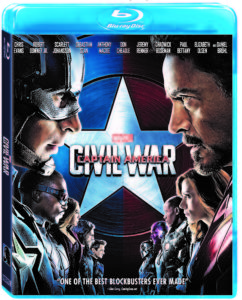 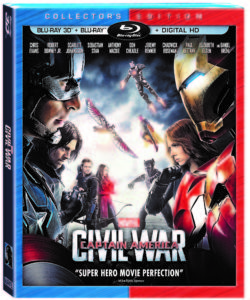 |
|||
| Captain America: Civil War comes home! Video on Demand Sep 2, Blu-Ray Sep 13!
The year’s best action film, Captain America: Civil War has a release date set. The question is: can your home theater handle all the heroes on screen? Featuring Captain America and Iron Man, along with Winter Soldier, Black Widow, Falcon, Vision, Black Panther, Scarlet Witch, Hawkeye, Ant-Man, Spider-Man, War Machine, and more, this is the biggest super-hero movie ever and it’s coming to your home! A 3-D Blu-Ray deluxe set will be released, alongside a regular Blu-Ray. Bonus features include a commentary by directors Anthony and Joe Russo, “United We Stand, Divided We Fall” – a two-part making-of documentary, deleted and extended scenes, and more! Hear Now Playing Podcast’s full review of the movie, then head to Amazon.com now and get your pre-order in! The full press release about Civil War is below.
|
|||
June 30, 2016 Posted by Arnie C | Comic Books, Movies, News | Ant-Man, Avengers, Captain America, Civil War, Collecting, Comic Books, Comics, Enertainment, Film, Iron Man, Marvel, Marvel Cinematic Universe, Marvel Comics, Marvelicious Toys, Movie, Movies, Now Playing, Now Playing Podcast, Podcasts, Pre-Order, Press Release, Review, Scarlet Witch, sci-fi, Spider-Man, Television, Vision, War Machine, Winter Soldier | Comments Off on CIVIL WAR: Choose your side – VOD on 9/2 or Blu-Ray on 9/13!
Soundtracks on Vinyl: The Hateful Eight
One of the draws to collect vinyl releases of movie scores and soundtracks is the large artwork for the film that accompanies it. These entries will review the vinyl record release of a film score/soundtrack from the music to the artwork, as well as the film…
The Movie
The Hateful Eight is a western about a bounty hunter played by Kurt Russell en route to deliver a wanted fugitive played by Jennifer Jason Leigh to the law when they take refuge in a log cabin during a snowstorm in Wyoming. The two are joined by six other strangers looking for sanctuary from the blizzard. But as the night proceeds, it becomes clear that some of the strangers have secretly planted themselves there to free the female criminal. A tense standoff proceeds as identities are discovered and the body count rises.
A big deal was made over the Ultra Panavision 70 ultra-widescreen format director Quentin Tarantino used to film The Hateful Eight. No small part of that hype was due to Tarantino himself doing a very limited 70mm roadshow screening of the film with extra footage. However, the film underperformed at $55-million (U.S. box office) after his previous two films, Django Unchained and Inglourious Basterds, brought in over $100-million each domestically.
April 29, 2016 Posted by jakob | Movies, Music, Now Playing Podcast | Hateful Eight, Movie, Review, Score, Soundtrack, Tarantino, Vinyl, Western | Comments Off on Soundtracks on Vinyl: The Hateful Eight
Soundtracks on Vinyl: You’re Next
One of the draws to collect vinyl releases of movie scores and soundtracks is the large artwork for the film that accompanies it. These entries will review the vinyl record release of a film score/soundtrack from the music to the artwork, as well as the film…
The Movie
You’re Next tells the story of a well-to-do family getting together in their home in the woods for a reunion. However, none of them seem very excited to see each other. Their ambivalence soon turns to terror and fear as a gang dawning animals masks invades the home and starts killing off members of the family. But the intruders meet resistance when one guest displays a special set of skills for fighting back.
I’m not one for slashers, but the striking posters for the film caught my attention. Each poster featured the close up of one of the intruders in a plastic animal mask (the lamb mask always stuck out to me) with You’re Next written out as painted in blood. Even the title had a simplicity that immediately expressed the mood of the film (it’s appeal similar to the title of Simon Pegg’s fake Grindhouse trailer for Don’t).
February 26, 2016 Posted by jakob | Movies, Music, Now Playing Podcast | horror, Movie, Review, Score, Slasher, Soundtrack, Vinyl, You're Next | Comments Off on Soundtracks on Vinyl: You’re Next
Liam Neeson Brings Non-Stop Stupidity
Is Liam Neeson consciously trying to emulate Nicolas Cage’s career path? Both actors won Academy Awards for dramatic roles, and then signed up for a series of increasingly inane action films until all the credibility they once had is gone.
Neeson continues his descent with Non-Stop in which he plays alcoholic Air Marshall Bill (not to be confused with Jim Carrey’s Fire Marshall Bill). Bill’s personal problems impact his professional career when he receives an anonymous text threatening one person on the flight will die every 20 minutes if $150 million isn’t deposited into an account. Worse, this mysterious mastermind is framing Bill for the plot, setting up a fake account in the Air Marshall’s name.
The film kept me on the edge of my seat, not because I cared about Bill or any of the other passengers, but because I really wanted an explanation of how these faceless felons pulled off such a trick. Yet the film never bothers trying to explain the “how”, possibly realizing the entire story is so outlandish that it’s pointless to try and explain it away. In short–if you care about plot you shouldn’t be watching this film, and the filmmakers know it. Truly, this film is Non-Stop stupidity.
Worst of all Julianne Moore is completely wasted in a role far beneath an actress of her stature and ability. I’d like to call her a red hair-ring but she doesn’t even rise to that level.
Truthfully I watched most of this film completely ambivalent. Midway through I tried to decide if that makes it a “recommend” or not. Then the film’s absurd climax happened. No answers may have been given as to how the criminals pulled their job, but the answer of how I rank this film was crystal clear.
Neeson’s career is not quite there, but if it continues its current path it will drop below 8,000 feet–which as the film tells me is such a dangerous altitude that fighter planes may scramble to shoot it down and prevent danger to civilians on the ground.
Where’s that A-Team sequel when Neeson needs it?
Strong Not Recommend.
February 22, 2015 Posted by Arnie C | Movies, Reviews | Bad Movies, Hijacking, Liam Neeson, Movie, Movies, Non-Stop, Review | Comments Off on Liam Neeson Brings Non-Stop Stupidity
Review: Superman/Batman: Public Enemies
| Lex Luthor is the beloved President of the United States. Most of the world’s superheroes, including Power Girl and Captain Atom, are agents for his government. Refusing to join up, Superman and Batman are wanted criminals in the Warner Bros. animated movie Superman/Batman: Public Enemies.Based on the graphic novel by Joseph Loeb and Ed McGuinness, this alternate-universe story creates a low barrier of entry for any fan. I didn’t have to watch all the previous DC Universe animated films or the Batman and Superman animated series to follow what was going on. An engaging opening montage sets the stage for this alternate universe, and the focus is on the most well-known characters Luthor and Superman. | |
| But as the story progresses, Superman and Batman teaming up against heroes and villains alike. There are characters in this movie I’ve not thought of since I watched Challenge of the Super Friends in the 70s, including Solomon Grundy, Captain Cold and Black Manta. For fans of the DC universe this deep roster of characters including Starfire, Bane, Metallo, Giganta, and dozens moren. Plus there were many more characters I didn’t know but the comic fans would likely will be a treat to see in full-motion animation. Power Girl, voiced by Allison Mack, gets a critical role as well in her first film appearance (boob window in full effect).The story reminds me of the video game Injustice: Gods Among Us where heroes fight heroes and villains in mortal combat. It may be base, but it’s really fun to watch Superman punch out Shazam and Batman taking on Captain Atom. The story is not what keeps me engaged–it’s the action. In the end, it’s simply a fun film. | |
| The animation is detailed, not feature film quality but better than most TV shows. More than serviceable, it has moments of beauty. With so many character designs it’s impressive that each get detailed representations.The ending is very silly (involving a robot that is literally half Superman and half Batman, split down the middle like Prince in the “Batdance” video), but getting there is fun.
I finished this movie thinking next year’s Batman v Superman: Dawn of Justice will be damn lucky if it is as good as Public Enemies. Recommend. |
|
|
Arnie is a movie critic for Now Playing Podcast, and host of the Marvel collecting podcast Marvelicious Toys.Hear Arnie review every Marvel Comics based film, and most DC Comics films, in the Archives at NowPlayingPodcast.com
Support Now Playing’s Kickstarter initiative — Underrated Movies We Recommend! Pledge today. |
February 21, 2015 Posted by Arnie C | Comic Books, Movies, Reviews | Animated, Animation, Batman, Batman v Superman, Challenge of the Super Friends, DC, DC Universe, Direct-To-Video, Movie, Movies, Power Girl, Public Enemies, Review, Superman | 4 Comments
After lows of ‘Corn’ series, ‘Now Playing’ looks forward to Nolan films
Now Playing Podcast host Arnie Carvalho once read an email from a listener urging him to review only bad movies because it leads to funnier conversations.
“He said we should just be a comedy show,” the film critic said from his Manhattan hotel room on Saturday, while on a break from covering New York Comic Con.
Did that listener have a point?
“None of us wants that,” Carvalho answered. “We enjoy covering all types of movies, but if we only watched low-rent trash I think our souls would die.”
It’s a marvel he and his Now Playing co-hosts — Stuart Atkinson and Jakob Brewster – even have any life left in them after enduring nine films based on Stephen King’s Children of the Corn.
This week’s review of Children of the Corn: Genesis not only marks the climax of the Corn saga, but also an exhausting exploration of King’s Night Shift collection; more than two dozen reviews of mostly forgettable film adaptations like The Mangler, Graveyard Shift and Trucks.
Few films in the Night Shift series have been worthy of a recommend, but that hasn’t kept hardcore Now Playing listeners from making the show one of the highest rated on iTunes throughout 2014, with seven of the nine Corn reviews appearing in the Top 10 rankings for TV/Film podcasts.
“I really expected listenership to drop off as we got deep in those fields,” Carvalho said. “But our listeners are awesome.”
“I only half-jokingly say more people downloaded our review of Children of the Corn 7 than actually saw Children of the Corn 7.”
With Night Shift in the rear view, Now Playing Podcast launches its next retrospective on Tuesday: A five-episode study of director Christopher Nolan’s filmography, leading up to next month’s Interstellar.
After considering other horror properties to follow Corn — including Hellraiser and The Amityville Horror — Carvalho shifted gears and lobbied hard for a director-focused retrospective, targeting Nolan after Now Playing previously covered his Dark Knight Trilogy and Inception.
“The hosts needed some meatier films to chew on, and I also think listeners want to hear about movies they’ve actually seen,” he joked. “With the good movies we usually can have deeper conversations about filmmaking, themes, and intent.”
“The problem with the Corn series was that by the 9th film there was nothing left to say, it’s like the old joke about the definition of insanity.”
October 11, 2014 Posted by Jason Latham | Now Playing Podcast, Podcasts | Arnie Carvalho, Children of the Corn, christopher nolan, dark knight, graveyard shift, inception, interstellar, jakob brewster, mangler, Now Playing Podcast, Review, Stephen King, stuart atkinson, trucks | 2 Comments
Hot Toys goes Solo, Han Solo, with the Star Wars license
Over the past six years Hot Toys has emerged as the superstar company for 12-inch highly articulated, collector-oriented action figures.
Their product lines in the past have ranged from Robocop to Predator to Terminator to even one-offs like Michael Jackson and Back to the Future. But where they’ve really shown is with their Marvel Movie Masterpiece Series figures. From Blade to Iron Man to Spider-Man to Ghost Rider, Hot Toys has amazed and astounded with their actor-accurate facial likenesses, the attention to detail, and the seemingly endless number of accessories, including interchangeable hands, feet, and heads, that come with their figures. Even the boxes each figure come in is a work of art.
I have covered Hot Toys figures for three years on the Marvelicious Toys podcast, and own every single Marvel Movie Masterpiece figure they have done–the only 12-inch line I am ‘all in’ on. Their quality and workmanship is unmatched. I’ve often wondered why Sideshow’s 12-Inch Star Wars line could not match the quality of Hot Toys’ Marvel line.
Sideshow and Hot Toys did partner once in the past, for Sideshow’s 12-Inch Bespin Luke Skywalker figure. But now Hot Toys has gotten the licence for their own lines of 1/6 scale and 1/4 scale Star Wars figures and collectibles.
Right out of the gate come not one but two sixth scale Movie Masterpiece Star Wars figures–Han Solo and Chewbacca. Available individually or as a set, these two smugglers are ready to join your collection.
- Interchangeable hair sculpt with headset
- Newly developed body with over 30 points of articulation
- Ten (10) pieces of interchangeable palms including:
– One (1) pair of relaxed palms
– One (1) pair of gloved relaxed palms
– One (1) pair of partially clenched gloved palms
– One (1) right palm for holding blaster
– One (1) left palm for supporting blaster
– One (1) right gloved palm for holding blaster
– One (1) left gloved palm for supporting blaster - Each piece of head sculpt is specially hand-painted
- Brown leather blaster holster belt
- One (1) blaster pistol
- One (1) droid caller
- Specially designed figure stand with Han Solo nameplate and movie logo
Plus if you order the Sideshow Exclusive edition you also get a Stormtrooper belt and blaster rifle!
- Authentic and detailed likeness of Chewbacca in Star Wars: Episode IV A New Hope
- Brown fabric hair throughout whole body
- Movie-accurate facial expression
- Newly developed body with over 30 points of articulation
- Approximately 36 cm tall
- Two (2) pairs of interchangeable palms including:
– One (1) pair of relaxed palms
– One (1) pair of palms for holding bowcaster - One (1) bowcaster
- One (1) brown bandolier bag
- One (1) headset
- Specially designed figure stand with Chewbacca nameplate and movie logo
 And if you order the pair together you get everything listed above (including the Stormtrooper belt and rifle) plus an additional accessory exclusive to the set–a heavy blaster for Chewbacca to wield.
And if you order the pair together you get everything listed above (including the Stormtrooper belt and rifle) plus an additional accessory exclusive to the set–a heavy blaster for Chewbacca to wield.
Long time Sideshow sixth-scale figure collectors, there is no word yet on how the scale of Hot Toys’ figures will fit in with Sideshow’s long-running line. As Sideshow uses their own figure bodies for most of their figures there is a chance these figures may look slightly taller or smaller than their Sideshow counterparts. This is not an evolution of Sideshow’s figure line, but an entirely new sixth scale figure line from Hot Toys.
It is canny of Hot Toys to be out of the gate with Chewbacca–a figure Sideshow has long teased but never brought to market.
However, and this is ironic, the only authorized US seller of Hot Toys is Sideshow Collectibles. As mentioned, I have purchased many Hot Toys figures, but as with any detailed piece I have received a fair number of damaged and broken figures and accessories. Hot Toys will not provide a warranty on any product purchased at an unauthorized reseller. The one Hot Toys figure I purchased from a reseller other than Sideshow, Hot Toys would provide no repairs and the seller could not offer a repalcement. If you are interested in the Hot Toys Star Wars line, my strong recommendation is you only purchase from Sideshow Collectibles, or risk having a damaged or broken piece with no recourse.
As for these figures, you can hear my first impressions on this Monday’s episode of the Star Wars Action News podcast!
In the meantime, head over to Sideshow’s site and check out these new figures. If you order, please consider supporting our site and our podcasts by using our affiliate link!
September 24, 2014 Posted by Arnie C | Comic Books, Movies, News, Star Wars | Avengers, Blade, Collecting, Enertainment, Film, George Lucas, Hot Toys, Iron Man, Marvel, Marvel Comics, Marvelicious Toys, Movie, Movies, News, Podcasts, Pre-Order, Review, Reviews, Sideshow Collectibles, Spider-Man, Star Wars, Star Wars Action News, Toys | Comments Off on Hot Toys goes Solo, Han Solo, with the Star Wars license
The 40 Year-Old-Critic: Before Midnight (2013)
In The 40-Year-Old Critic, Venganza Media creator and host Arnie Carvalho recalls a memorable film for each year of his life. This series appears daily on the Venganza Media Gazette.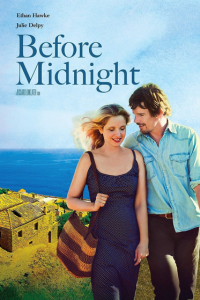
I described yesterday my fear of watching This Is 40 — fear of a movie that may make me examine my own life in uncomfortable ways. I never expected the film I really should have been nervous of was one I raced to opening weekend; Richard Linklater’s Before Midnight, the third film in his Before series.
I first saw Before Sunrise in the mid-90s. I had discovered indie director Linklater with his mainstream 1993 hit Dazed and Confused. I considered that film to be the American Graffiti for Generation X. Both films were period pieces that spoke as much to the trials of teens in the present day as they did in the times in which they were set. Both films also focused on the period rock to help advance the story and the mood. After Dazed, Linklater became a director I wanted to follow.
More than just the director, I was also drawn to Sunrise by its male lead, Ethan Hawke, an actor I enjoyed seeing in Dead Poets Society and, more recently at the time of Sunrise‘s release, Reality Bites.
Finally, the genre seemed up my alley — the romantic comedy. From the trailers Sunrise seemed like another Reality Bites or Singles — Jesse (Hawke) was an American 20-something traveling through Europe. On a train ride he meets Céline (Julie Delpy), a blonde French beauty. The two have one night together in Vienna before Jesse returns to the United States.
When I saw the film I was surprised that it was far more of a romance film than a comedy, but also a tender and moving one. Few films made me feel I was watching an honest romance. Hawke and Delpy sold their attraction and affection for each other. Though they had only one night together, the two had laughs, arguments, and an honest connection. They fell in love with each other, and I fell in love with their relationship.
It was a great film, but not one I ever expected to have a sequel. It simply wasn’t the genre of film that spawned sequels. I would revisit Before Sunrise regularly in the 90s but never expected to see the characters again. I knew that Delpy, Hawke, and Linklater always teased the thought of returning to Jesse and Céline, but I just didn’t believe it would happen. As such I was utterly stunned in 2003 when I read the trio was reteaming for Before Sunset. This time the film was written by Linklater as well as Hawke and Delphy — the actors were helping shape the story of their characters. That was a major change from the original and showed that the director and stars were creating something truly unique and special.
Before Sunset told of Jesse and Céline meeting up again for the first time in 9 years. I was excited to see the film; I felt like Linklater was giving me a mini-college reunion — my own chance to catch up with two people I fondly remembered from the 90s.
When the film came out in limited release I was concerned it wouldn’t open in Springfield. As such Marjorie and I drove 8 hours round trip to see the movie in Chicago; it meant that much to me (ironically it opened in our town about two months later). I really enjoyed the sequel, though it had a totally different vibe than the original. Now in their 30s, the two have followed different paths; Jesse is married with a son, adding a complication and moral complexity to the prospect of a rekindled romance. Like most reunions, it was good to see these friends again, but we had grown apart a bit, and I didn’t feel as strongly about them as I did in the 90s.
But the door had been opened, and when Before Sunset came out Linklater, Delpy, and Hawke said they may return to these characters every nine years and check in on them. I wouldn’t have been shocked if a third film never came, but I equally wasn’t surprised when the third film, Before Midnight, was announced.
Now it was time for the cinematic equivalent of my 20th college reunion — it was time to see Céline and Jesse again. I was a bit concerned. Trailers let me know that the two characters had been together for the past nine years. While Linklater was a director I trusted, it seemed like a totally different concept than the previous two films. It felt like we had captured the characters’ every moment together on film, but in the years between Before Sunset and Before Midnight Jesse had left his wife and moved to Europe to be with Céline; they were now married and had twin girls. Could the film carry the same emotional resonance now that we were getting a “day in the life” type of story instead of seeing their only encounter?
My concerns were secondary, though; I saw Linklater, Hawke, and Delpy again teamed to find these characters’ stories, and so Before Midnight was my only must-see film in 2013 that wasn’t reviewed for Now Playing Podcast (though we came really close; I championed it, Stuart also wanted to, but it didn’t fit the schedule). This time there was no question Before Midnight would play in Springfield, and Marjorie and I went opening weekend. I sat down and watched the best film I would see all year.
Before Midnight never feels rushed. Though Linklater needs to catch us up on the nine years of history between our characters, the movie starts with a long scene of Jesse and Hank, his son from his previous marriage. After spending time with Céline and Jesse in Greece he was returning home to his mother. Jesse’s desire to be a good father is at odds with his current marriage — he’d like to move back to the states and be closer to his son.
When we again meet Céline and their twin daughters Ella and Nina we see a happy family, at least on the surface. With Jesse back, the four are taking a road trip for a weekend vacation at a house in the country. On the way the strains start to show as Céline starts discussing her dislike for her career and desire to change jobs though it would greatly impact their family.
But once we reach the country house and are introduced to Jesse and Céline’s various friends the theme of this movie became clear: it’s an exploration of ideas about love, sex, and commitment. Long conversations are had with middle-aged Céline and Jesse seeing new passion kindled between a twenty-something couple, and an older couple discussing their many years together. These stories tell of love at different stages, but also provide interesting debate on what it means to be in love, and to be committed. Céline and Jesse are committed it seems, and in love we hope, but they now want different things in their lives. In the grand spectrum of life, where does love fall on the priority list? What compromises must be made in order to work the logistics of staying together both emotionally and geographically?
As with the film’s view of love, the movie also changes as time passes. Céline and Jesse are given a romantic night at a hotel; their hosts will watch the girls. Now the film is back on familiar footing, with Jesse and Céline visiting a European locale and having meaningful conversations. Yet the stage has been set, and this time they must address their lives and their next steps.
It doesn’t go well. As couples do, new arguments lead to the trudging up of old dirt; Jesse had an affair while on a book tour, but it was just sex, not love. Meanwhile it’s strongly suggested Céline also cheated, rekindling an old romance. The fight grows bitter, raw, and real. It ends with Julie leaving the hotel room and her husband, saying she doesn’t love him anymore.
The film is dark and brooding. This was the film that I had feared This Is 40 would be; a hard look at middle-age and differing views of marriage and love. More, it is well-balanced. Both characters have made selfish choices and transgressions. Neither character is fully right, nor fully wrong, and, as accusations are made in the midst of a bitter fight, it’s hard to tell even what is fact and what is unsubstantiated accusation. It’s likely due to both lead actors participating in the script that this delicate balance is achieved. Neither character is the “bad guy” — nor is either good. Both are operating from their own points of view, and now they’re realizing their viewpoints don’t match up as they once thought.
This film hit incredibly close to home. Marjorie and I had been together for 13 years, married 11. Those years have been full of happiness, but all lives have hardships and all couples have spats. Watching Jesse and Céline break down in Europe when they realize they each had different ideas of marriage made me reflect. First, Marjorie and I were planning a romantic European vacation just weeks after watching this film — Before Midnight certainly seemed like a cautionary tale to not pick that time to discuss major life-changing decisions.
Marjorie found herself identifying with Céline; not just for the gender but also because Marjorie had a job and employer that made her miserable. Like Céline, Marjorie was looking for a career change, and that type of major decision can have a ripple effect. It did so happen that she interviewed for a new job the day before we flew to Europe, and while it didn’t diminish the fun of our vacation one iota, the question of career choices was discussed often on the trip.
I found myself identifying with Jesse. Sure, he’d made some poor decisions, but he was trying to balance his career with his desire to be a good husband and father. While I have no children, I completely identified with his being pulled in multiple directions. I also saw in Jesse my own artistic nature, but one not as accomplished as I’d like due to compromises and other priorities. I completely felt what Jesse was going through and empathized with him.
Yet what the movie really exposes is that two people can be together and have totally different views of their relationship. While happy and playful on the surface, beneath there could be unknown angst and tension. And it’s not that both parties are sublimating — it’s completely possible one person is miserable while the other is content.
The film led to some great conversations with my wife, ensuring we were indeed on the same page with our lives and not a tangled mess of miscommunication like Jesse and Céline. It was very interesting leaving the theater and cautiously discussing the themes; especially when we each took different sides in the argument. It didn’t, but it could have easily led to an argument between us, and that is how real Before Midnight feels.
In private I continued to ruminate on this film and the ideas it put forth. What is love? How does it change over time? These aren’t just academic discussions; these are the emotions that rule our lives. I love that Linklater, Hawke, and Delpy don’t give definitive answers; they raise viewpoints and it’s up to each individual member of the audience to supply the answers that are true for them.
This film is not the tearing down of what Before Sunrise and Before Sunset — its end message seems to indicate love conquers all, and it seems Céline and Jesse are in love after all.
As am I with my wife. As I write this we are on another romantic getaway for my 40th birthday. And, no, there have not been any fights, no storming out, no near-divorce moments.
But Before Midnight is one of the greatest types of films, one that hits home emotionally. I don’t know if Linklater, Delpy, and Hawke will reteam again in 2022. If they do, I don’t know if Célene and Jesse will still be married, or a divorced couple meeting again. What I know is I’ll be there to see what these characters say about people in the next stage of their lives, and I wonder how it will mirror my own.
Arnie is a movie critic for Now Playing Podcast, a book reviewer for the Books & Nachos podcast, and co-host of the collecting podcasts Star Wars Action News and Marvelicious Toys. You can follow him on Twitter @thearniec
September 12, 2014 Posted by Arnie C | 40-Year-Old Critic, Movies, Reviews | 2010s, Before Midnight, Before Sunrise, Before Sunset, Enertainment, Ethan Hawke, Film, Julie Delpy, Movie, Movies, Now Playing, Now Playing Podcast, Podcasts, Review, Reviews, Richard Linklater | 2 Comments
The 40 Year-Old-Critic: This Is 40 (2012)
In The 40-Year-Old Critic, Venganza Media creator and host Arnie Carvalho recalls a memorable film for each year of his life. This series appears daily on the Venganza Media Gazette.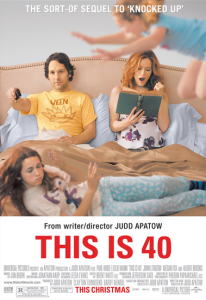
Have you ever wanted to see a movie and yet been afraid to watch it?
It’s an interesting feeling — the allure of a film that should be very good and entertaining, but the anticipation is tainted by fear that I may have an uncomfortable experience. Not that I feel the movie may be bad, but that it could be so good that it makes you a different person after watching it.
As a child I held this fear about many horror movies. From A Nightmare on Elm Street to Hellraiser II, I was scared of what the movie might contain. But as I grew up it wasn’t horror movies that scared me; it was stories about people, and movies that may hold up a mirror and force me to look deep inside myself.
In 2012 the film I feared watching most was This Is 40.
On the surface that may seem absolutely silly. After all, what is there to fear about a comedy, especially a spin off to the easy, breezy stoner sex romp Knocked Up?
The problem lies entirely in coincidence. This is 40 was released in the holiday season of 2012, a time in which those numbers — 4 – 0 — loomed large in my future. This entire review series is a retrospective of my 40 years of watching films, but it ends with me being forced to say, “So… this is 40.”
More, this movie was written and directed by Judd Apatow, best known for his 2005 comedy, The 40-Year-Old Virgin. Though I had watched a few episodes of his TV series Freaks and Geeks, it was through Virgin that I became aware of Apatow’s work.
Clearly he was a funny writer; The 40-Year-Old Virgin had me laughing out loud throughout. But despite being funny and raunchy, there was something about the film that felt real and true. Andy, the sexually-challenged obsessive toy collector played by Steve Carrell, may have been a caricature, but he was also sweet and earnest. By the end of the film he’d gone from wanting sex to wanting true love, and the audience rooted for him. More, his friends all seemed to have more realistic problems; one constantly cheats on his girlfriend, another is obsessed with his ex.
This combination of heart and humor became Apatow’s trademark, and while I didn’t feel his follow-up films Knocked Up and Funny People reached the heights of The 40-Year-Old Virgin, they both were films with a human story surrounded by comedy. Even the films Apatow produced, but didn’t direct or write, often followed that pattern, with Superbad, Forgetting Sarah Marshall, Wanderlust, and The Five-Year Engagement all being character studies as well as comedies.
It was specifically Funny People that made me fear This is 40 the most. That film featured Adam Sandler as a comedian dying of leukemia. While the movie pulled several punches and most of the jokes didn’t hit (like any 21st Century Sandler film), it showed a dramatic weight and had several moments that tugged at the heartstrings and made me contemplate my own death — what would I do if I became terminally ill at a still relatively young age?
Now Apatow was going to set his sights squarely on middle-aged suburbanites. As an Apatow fan I wanted to see the film, but as a man about to turn 40 I feared what I would see.
I have a good life. I love my wife, I have a steady job, we have a nice house, and we travel a lot. Through my podcasts I get to touch the lives of hundreds of thousands of people all over the world, and some of the doors opened by those shows allow me to have experiences many only dream of. I am not unhappy in my life, but any major milestone is a time for reflection. Should I have chased my dreams harder than I did? Should I have become comfortable in my job? Did I compromise too much?
It’s hard to start living a life where you see the clock start ticking the other way, and life starts being gauged by the things you’ll never do instead of the things you’ll do someday. That is being 40 — and I wasn’t sure I wanted to see a movie that would epitomize that experience.
The trailers showed a couple seemingly at a crossroads. The opening scene showed Paul Rudd’s character, Pete, chatting with a friend, Barry (Robert Smigel), confiding that he sometimes fantasizes about his wife’s death and the second wife he may find after.
“God, I can’t wait to meet my second wife,” Pete tells Barry. “I hope she likes me better than this one.”
Yes, it was somewhat amusing but it also was about death. I know too many remarried widows and widowers, and the thought of losing Marjorie was uncomfortable.
Lines then floated from the screen, such as, “I have responsibilities, I can’t afford to sit in my apartment getting baked,” and, “It doesn’t seem like our lives should be this much work.”
Another line that resonated with me; “We’re gonna blink and be 90. We have to make a choice to make things different.”
It then ends with a turnaround, showing Pete’s wife Debbie (Leslie Mann) admitting she also fantasizes about his death.
While the parenting situations portrayed were not ones to which I could relate, these messages of reflection on aging mirrored my inner thoughts to a frightening degree. If I was already undergoing extreme neurotic self-examination, what would I see in the mirror held up by This is 40?
I didn’t see the film in theaters. I eventually rented it on iTunes during a trip; the 30-day rental expired with me never having pushed “play.” Then I set up my Tivo to record it, where it sat for months.
Finally, one night at 3 a.m., I found myself restless and unable to sleep. Though it was a weeknight and I had to work in a few hours, I got up and went into the home theater. It was time to face my fear and watch This is 40, though it was a path I chose to walk alone, intentionally watching when Marjorie was sound asleep.
What did I find in that film? Was it an honest portrayal of 21st century middle-age? Was it a scathing look at modern marriages? Was it going to try to sell me on the trite message that children are the only thing worth living for; a path I intentionally never took?
Nope. All my fear was for nothing — all I got was an incredibly unfunny and poorly written movie.
Despite the title, Apatow didn’t focus on the issues of an aging Generation X. This was not our mid-life crisis version of The Breakfast Club; a cultural touchstone that we could all look at while sadly remembering days gone by. No, This Is 40 is not even attempting to speak to a generation; it is simply a situation comedy with a broad title.
That is fine, and actually I was relieved to not have an uncomfortable movie experience. My dislike of this film is not because it wasn’t what I expected; my dislike is that this is an ugly portrayal of unlikable people in which none of the jokes work.
Pete and Debbie are a married couple who seem to genuinely dislike each other. The death fantasies were not wanderlust; they were manifestations of extreme aggravation. And, honestly, both are right to sometimes hate the other.
Apatow films often feature a man-child in the lead role, and here that character is Pete, a man who keeps chasing his dreams, though he’s about to turn 40. That, in itself, isn’t so bad. Some of his behaviors were even slightly amusing. He sneaks food like a child. He hides out in the bathroom to play on his iPad versus talk to his family. But in this type of character there is a line where you cross from funny into pathological, and Pete crosses that line. He lies to his wife about money, taking their life savings and giving it in chunks to his deadbeat father Larry (Albert Brooks). He also hides his business troubles.
His wife Debbie is no better. If the Apatow male is irresponsible, the counter is the Apatow female — the shrew. Apatow’s real-life wife Mann is often cast in that role, and here she’s the most extreme and horrible version of that character. Vain and neurotic, she leaves her husband to his own devices while she goes out trying to recapture her youth, partying with her young employee Desi (Megan Fox). She flirts with other guys, and there’s a fine line between wanting to feel validated and cheating on your husband; Debbie skirts that line. Most, Debbie discovers she’s pregnant and hides that from Pete.
Looking at these two characters that do whatever they can to not spend time together, who lie to each other versus having hard conversations, I hoped this film ended in divorce. This was not a couple I wanted to see work it out, not even for the children.
Apatow includes scenes of the two working in unison, such as when they have to visit the school principal about an incident with another parent (played by the always one-note Melissa McCarthy). I think the director intended to show that while the couple may fight and struggle, together they are strong. Instead of that, I took away that they are lying, manipulative characters who treat the rest of the world as badly as they treat each other.
It seemed an ugly portrayal — a marriage of convenience and obligation versus love.
Still, I’m not sure this movie had a “plot” so much as it was a loose stringing together of subplots. For instance, Debbie has an employee stealing from her business. It’s a mystery at first, but eventually revealed to be Desi, who is stealing to finance a drug habit. This is supposed to be a revelation that makes Debbie realize young, sexy Desi isn’t perfect and that she should no longer yearn to be in her 20s, but that character turn doesn’t make sense. It really just shows that Debbie is a poor judge of character. More, Desi’s troubles are never examined, and she is cast aside in the film.
Another subplot involves Debbie attempting to reconnect with her wealthy physician father, Oliver (John Lithgow). I thought that subplot was there to provide an “out” for the various financial issues the couple put themselves in, but no, the film offers that solution and then refuses it.
When credits rolled I was relieved that I no longer had to spend any more time with Pete, Debbie, and their dysfunctional family and friends, and I’d have been hard-pressed to tell you the point of the film.
This is 40 is clearly Apatow’s worst directorial effort to date, on par with some of his worst-produced films, notably Wanderlust and The Five-Year Engagement. The jokes fall flat, focusing on such inane topics as an obsession with the TV show Lost. More, the story is non-existent. That could all work if I liked the characters, but the script makes that impossible. Even Rudd, who has oozed charisma in every role I’ve seen, stumbles badly. Usually his charm can make him stand out even when he’s working with sub-par material, but here the most extreme version of his lovable, immature routine comes across as whiny and spoiled.
The worst part of 40 is the length. Perhaps I made a mistake watching the even longer unrated cut, but in a movie where most of the jokes die and the characters have no appreciable arcs, the goal should be to cut as much as possible. Instead Apatow became as self-indulgent as his characters and the film ballooned to more than two hours and fifteen minutes.
I guess I was right for fearing This is 40, but for all the wrong reasons. In the end, I just spent nearly two-and-a-half hours of my last year in my 30s watching a pathetic, unfunny, and unoriginal film.
Now just days away from that milestone birthday, I’ve gotten past my fear — not only of this movie but of that age. The amount of thought given, both through this review series, watching This is 40, and private reflection has shown me that 40 may not be so bad after all. My beard may have a few gray hairs, but I have used this time to build a terrific life.
Being 40 isn’t so bad at all, but This is 40 is miserable.
Tomorrow — 2013 — the final review!
Arnie is a movie critic for Now Playing Podcast, a book reviewer for the Books & Nachos podcast, and co-host of the collecting podcasts Star Wars Action News and Marvelicious Toys. You can follow him on Twitter @thearniec
September 11, 2014 Posted by Arnie C | 40-Year-Old Critic, Movies, Reviews | 2010s, 40-Year-Old Critic, 40-Year-Old Virgin, Comedy, Dramedy, Enertainment, Film, Judd Apatow, Leslie Mann, Movie, Movies, Now Playing, Now Playing Podcast, Paul Rudd, Podcasts, Review, Reviews, This Is 40 | 1 Comment
The 40 Year-Old-Critic: X-Men: First Class (2011)
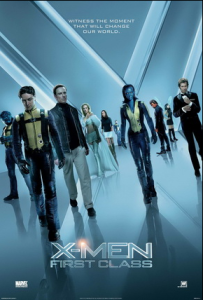 In The 40-Year-Old Critic, Venganza Media creator and host Arnie Carvalho recalls a memorable film for each year of his life. This series appears daily on the Venganza Media Gazette.
In The 40-Year-Old Critic, Venganza Media creator and host Arnie Carvalho recalls a memorable film for each year of his life. This series appears daily on the Venganza Media Gazette.
I didn’t really want to review the X-Men films for Now Playing Podcast.
Don’t get me wrong, I enjoy discussing any movie in-depth, whether it’s Leprechaun in Space or Touch of Evil. But for X-Men I had a specific hesitation.
I had, in passing, already discussed these films with longtime friend and podcast co-host Stuart. It was clear we didn’t see eye-to-eye; he expressed a preference for Bryan Singer’s earlier, dour X-films; I actually enjoyed Brett Ratner’s third X-Men movie, The Last Stand, the most — finally giving the superheroes fight sequences they’d been denied on screen.
I hadn’t seen the X-Men films in a few years by 2011, when we started our Marvel Movie Retrospective Series, but I was fully prepared to stand alone with my minority opinion.
It wasn’t that I loved X-Men: The Last Stand. I felt all the X-Men films were lacking in some areas, and expressing my preference for Ratner’s vision didn’t mean I could champion it. I loved Marvel, especially the movies, but to this franchise I held no allegiance.
That is why in 2009 we took a pass on that year’s X-Men Origins: Wolverine. After the film was released we felt doubly justified.
But, as I discussed in my Howard the Duck article, in 2011 Now Playing was beginning its most ambitious endeavor; reviewing every Marvel-based movie ever released in theaters (U.S. or overseas). That meant Stuart, Jakob, and I would have to tackle the X-films, eventually.
How we approached this retrospective was the subject of some debate. I initially pitched doing all the films intermixed, in chronological order. Perhaps because it would have seemed odd to have 2002’s Spider-Man review immediately followed by 2003’s Daredevil and Hulk (both released before Spider-Man 2) Stuart wisely suggested breaking the series into a number of smaller sub-series; do Spider-Man as a unit, Blade as another group, and the X-Men by themselves. But then how would we order them? First-to-last according to release date? Or do we start with the most recent film?
Finally, realizing the interest listeners had in our theatrical release reviews, we decided to just shuffle all the series’ around to whatever order fit; but two rules presided. First, we would arrange series’ so that if they had a theatrical release, as happened for X-Men and Ghost Rider, we would tie into that release. Second, we would do all the movies in time for the ultimate Marvel crossover movie: 2012’s The Avengers.
(Sony then threw a wrench in that plan by releasing their The Amazing Spider-Man reboot in the weeks following Avengers, making Marvel’s most popular superhero the only one we hadn’t reviewed)
This massive undertaking meant we could delay it no further; we had to review X-Men. More, while we had done three one-off Marvel movies — Howard the Duck, Man-Thing, and Kick Ass, in a loose group we called Marvel Misfits — X-Men was our first real series in the Marvel Movie Retrospective. This was demanded by the release of 20th Century Fox’s impending reboot/prequel of their X-franchise, X-Men: First Class.
I wasn’t terribly excited for First Class. It was the latest offering in a scattershot series. More, it didn’t have Wolverine. While his 2009 solo film was an over-the-top testosterone-fueled orgy of explosions, I still enjoyed the character and did wonder if his absence from First Class was a blessing, giving him a rest after Origins, or a curse, the new film lacking the series’ star.
It turns out all of this fear was for nothing. While Stuart and I did disagree over the merits of the first three X-Men films and Origins, the conversations were always fun. More, Jakob provided a great third perspective that tempered both of our points and prevented the conversations from following any preconceived pattern I’d feared. Also, revisiting the films with revised expectations allowed me to appreciate them more than I had in the past.
More importantly, though, in 2011 the X-Men got their first truly great film with First Class. I had feared not finding a film I loved in the X-series, but new director Matthew Vaughn delivered that in spades.
First, the film had a lead cast that was nothing short of amazing.
I knew James McAvoy from his earlier teen comedy Starter For Ten, a film funnier than its teen game show premise deserved. The actor was also a standout in Wanted, holding his own against Morgan Freeman and Angelina Jolie, and imbibing his character with personality that seemed lacking from the movie’s thin script.
Still, while I liked the man’s work, I had a hard time imagining him as Charles “Professor X” Xavier, the lead X-Man portrayed by Patrick Stewart in the earlier films. But with Vaughn’s direction and the script (co-written by the director) this was a young, cheeky Xavier, and McAvoy owned the part.
He was, however, overshadowed by co-star Michael Fassbender, who took the role of Erik “Magneto” Lensherr; previously occupied by Ian McKellen. X-Men: First Class took elements from a canceled X-Men Origins: Magneto script — and truthfully this film is Magneto’s. Like the original X-Men film, First Class opens in a Nazi concentration camp showing Magneto, still a child, discovering his powers. But it continues that story line and shows the Nazis grooming Lensherr and training him. Magneto’s quest for revenge is the true arc of this film, and, playing Erik as an adult, Fassbender commands the screen.
I can’t recall even hearing Fassbender’s name before First Class. I had seen him in only two films: 300 and Jonah Hex, and neither performance was memorable. From this role I knew Fassbender had amazing range. With the X-Men franchise under his belt Fassbender has picked a variety of mostly smaller films allowing him to demonstrate his range, but he was truly the best find of First Class.
That is probably a somewhat unpopular opinion, especially for any Hunger Games fans reading this review, as First Class also featured Jennifer Lawrence, starring as the shape-shifting mutant Mystique (a role previously played by Rebecca Romijn). Unlike Fassbender, I knew of Lawrence before First Class due to her role in Winter’s Bone. Strong word-of-mouth brought that movie to my attention, and Lawrence earned an Academy Award nomination for her role. Still, while already an acclaimed actress, she was just beginning her career. Few could have predicted what her future held; becoming Hollywood’s biggest actress thanks to her role of Katniss in the aforementioned Hunger Games series, plus continuing to make critically acclaimed films, as well as winning an Oscar for her role in Silver Linings Playbook.
In X-Men: First Class it was clear she was as talented as her more seasoned co-stars. While not much more than a sexy henchman in the original X-Men trilogy, here Mystique’s dilemma is the heart of the film; she can do amazing things but her true form is scaly and blue. The film shows her path of self-acceptance and, as a by-product, her allegiance shifting from the more diplomatic Professor X to the more militant Magneto.
Even the smaller roles were stacked with great performances, with Kevin Bacon, Rose Byrne, Nicholas Hoult, and Oliver Platt being stand-outs. I felt the only weak link in the film was January Jones, the Mad Men star who played “White Queen” Emma Frost.
Yet while the cast was amazing, its director was even more so. I knew Vaughn only for his 2010 superhero parody Kick-Ass, and he brought that same visual flare and fast-paced storytelling style to First Class. Also, like Kick-Ass, this film had actual character development intermixed with a healthy dose of comedy.
Out of all the X-Men films, this was the first one that had been really, truly fun while also establishing amazing rivalries and human drama. It was the first great X-Men movie.
It was a delight to watch, and I was ecstatic while recording the Now Playing review when I discovered Jakob and Stuart had seen the same film I did. The only thing better than watching an amazing film is sharing that enthusiasm with other film lovers.
The movie, and that podcast review, were my personal high points of our X-Men retrospective series, and it kicked off our Marvel Retrospective with a huge bang. There were good times ahead.
In the three years since this film’s theatrical release I’ve seen it at least a dozen more times. I went back to see it in theaters even after Now Playing’s review, just for fun. I bought it on its Blu-ray release date, and watched it immediately. It’s a staple, any time it airs on television I turn it on again. On flights it’s the movie that gets the most play on my iPad.
Yet this enthusiasm is tinged with sadness. While I did not share a dissenting opinion on the podcast, all three of us seem to be in a minority group for our love of this film. It became the lowest grossing X-Men film ever — audiences just didn’t turn out to see the movie. Perhaps they were put off by the lack of Wolverine? Maybe the 1960s period piece feel didn’t appeal to 21st Century moviegoers? Perhaps the summer was just too full of superheroes with Thor and Captain America also hitting screens? No matter the reason, the film failed to find an audience and made less money than 2000’s original X-Men, even with 11 years of ticket inflation taken into account.
More, it seems this movie didn’t catch on in home video. I thought it could have a second life in home theaters, but my anecdotal evidence suggests people simply preferred the movies with the original cast to this new vision.
If there is no greater joy than discussing a beloved film with others who share that sentiment, there are few feelings more depressing than feeling alone and wondering why everyone else can’t see in this film the great things I see.
Worse, lack of fan response ended First Class‘ run in the X-Men. Fox, knowing they have to battle Marvel (who are the creators of the X-Men characters, but don’t hold the film rights), decided a major course correction was needed for the studio’s premier superhero franchise. They had definite ideas for the next X-Men movie, and were prepared to spend more than they ever had before to ensure their mutants could stand their ground against the Avengers. Studio interference and demands, including bringing back some members of the original cast to appeal to fans, led to Vaughn abandoning development on the sequel film, and in his place Bryan Singer returned to the franchise.
The result of Fox and Singer’s work was this year’s X-Men: Days of Future Past. It was a very good movie — Singer’s best entry in the franchise by a mile. Yet it didn’t do as good a job juggling the characters, the story line wasn’t as tight, and it lacked the groovy, kinetic fun of First Class. It lacked Vaughn, who was the X-factor the franchise needed most.
But again I may stand alone in that opinion, as Days of Future Past became the highest-grossing X-film to date; besting X-Men: The Last Stand’s take in 2006.
I have no doubt that with the upcoming X-Men: Age of Apocalypse, the X-films will continue to get grander and mix in more cast members new and old. I just hold out hope that at some point they look back and see all that First Class did right, and bring some of that lighthearted humanity back to the X-Men.
Tomorrow — 2011!
Arnie is a movie critic for Now Playing Podcast, a book reviewer for the Books & Nachos podcast, and co-host of the collecting podcasts Star Wars Action News and Marvelicious Toys. You can follow him on Twitter @thearniec
September 10, 2014 Posted by Arnie C | 40-Year-Old Critic, Comic Books, Movies, Reviews | 2010s, 40-Year-Old Critic, Avengers, Comic Books, Comics, Enertainment, Hasbro, Jennifer Lawrence, Marvel, Marvel Comics, Marvelicious Toys, Matthew Vaughn, Movie, Movies, Now Playing, Podcasts, Review, Reviews, Spider-Man, X-Men, X-Men First Class | 3 Comments
The 40 Year-Old-Critic: Scott Pilgrim vs. the World (2010)
In The 40-Year-Old Critic, Venganza Media creator and host Arnie Carvalho recalls a memorable film for each year of his life. This series appears daily on the Venganza Media Gazette.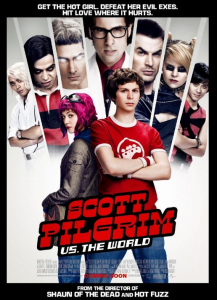
On the surface this may look like I’m again revisiting a movie reviewed on Now Playing Podcast. But that’s not the case. This is actually the first time I’m getting to share my views on Edgar Wright’s 2010 romantic comedy Scott Pilgrim vs. the World.
Looking back, I recall 2010 was a very busy summer for me. I was approaching my 5th anniversary of podcasting with Star Wars Action News, which was, at the time, our most-downloaded show. However, Now Playing was on the rise in the iTunes ranks, and while 2009 saw the show go several weeks without a new episode, by 2010 we were putting out a new show almost every week. We even decided to experiment with fundraising to help cover our costs by doing two shows a week in October: The Texas Chainsaw Massacre Retrospective Series on our main feed and the Child’s Play Retrospective Series for those who donated money to the show.
Doing so many podcasts at once was becoming a heavy load for me to carry, and I hit a bit of a breaking point by late summer. Not only were we doing two Now Playing shows per week and Star Wars Action News, but we also were covering San Diego Comic-Con in July (which had us producing an SDCC-exclusive bonus podcast review of I Know Who Killed Me), and the Star Wars Celebration V convention in mid-August. There Marjorie and I, as part of Star Wars Action News, were throwing a party that was to be attended by hundreds of people, hosting several panels on Star Wars Collecting and the Star Wars Radio Dramas, and, of course, trying to put together our reports on the convention.
I felt I needed a break; priorities had to shift. SWAN was Venganza Media’s flagship podcast, so it and Star Wars Celebration V demanded my attention. I needed time off from Now Playing.
Until that point I had been Now Playing’s constant. I was the producer and — for most of the run — editor of the show. The other hosts rotated, but I was always there facilitating the show and making sure it went smoothly. Yet I still made plans, communicating with Brock, Stuart, and Jakob to do the Philip K. Dick Retrospective Series without me. It seemed perfectly timed, as The Adjustment Bureau was coming out in July. The guys would record the shows, and our first editor, Jay, would cut them. I could finally be “hands off.”
It wasn’t that I didn’t want to be on the series; Blade Runner is a long-time favorite that I’ve seen more often than I can count. Total Recall is another favorite. With Minority Report also in the series, I would have liked to be there to express the minority opinion that the film isn’t very good.
Still working the schedule, I could see we needed one more show for August, specifically for the weekend of Star Wars Celebration. I suggested the guys do Scott Pilgrim vs. the World. I knew nothing about the movie beyond having seen some trailers, but to me it seemed in line with Now Playing’s usual fare. First, it looked like a film full of comedic action and special effects. Second, it was coming from Edgar Wright, the director of the awesome and quirky Shaun of the Dead and Hot Fuzz. Third, Jakob was a huge fan of the comic books and hyped for the film.
It seemed all set and ready to go.
Then it all fell apart.
Right after the July 4 weekend Universal Pictures announced it was moving The Adjustment Bureau’s release to February 2011. These Hollywood schedule shifts always cause headaches for us, but none had been worse than this one; most of the Dick series had already been recorded and we had to scramble to get other shows ready and released to fill that gap — not what I wanted to be doing in an already jam-packed July.
Then came Scott Pilgrim vs. the World. I was in Orlando for Celebration when the show was released, which made it the first (and only) time in Now Playing history I was hearing the show as a listener. I had complete faith in the guys to do a great job, but it was odd to be so out of the loop on my own show. Yet I listened, even without having seen the film, and it was a solid episode. Still, it was hard for me to judge — I was too busy to see the movie.
Finally, after returning from Celebration in late August, Marjorie and I made it to the theater to see Scott Pilgrim. It was a chore — the movie had quickly vanished from our local theaters, so we had to drive two hours each way to see it. Yet it was completely worth it. I sat there enraptured as Wright delivered what, to this day, remains his best film.
Part of the thrill came from the fact I didn’t really know what the film was about. The trailers suggested that the characters were living in a video game world, collecting coins and getting 1-Up extra lives. It was quirky, but what was it about? I expected the movie to offer some explanation; perhaps, Tron-like, Scott had fallen into a video game world, or maybe he had an overactive imagination like The Secret Life of Walter Mitty?
No, it turned out Wright was a confident enough filmmaker to just make a fantasy film in which this was the world. It wasn’t strange to any character that mortal combat would break out in the streets, that two-headed dragons would emerge from speaker systems, or that coins magically appear when people die. All taking place in the magical land of… Canada. It was a vision that Wright completely committed to, and the result is a phenomenally immersive experience. I usually don’t like fantastical scenarios (going to Tolkien’s Middle Earth holds little appeal) but I would love to visit Wright’s Canada.
The editing and music on the film were honestly the best I’d seen in a film that year. Wright’s kinetic montage-style of filmmaking had been a high point of his previous two movies, but here was the first time he seemed totally at ease with his own storytelling ability. It was the same effective, short-hand repetition Darren Aronofsky had used in Requiem for a Dream, but here it was fun and it worked. More, it hit me in a sweet spot: its video game references were all of the late 80s and early 90s 8-bit and 16-bit systems like Super Mario Bros., games I spent thousands of hours playing in my youth.
The film’s saturated color palette, the comic book-style words that filled the frame, the soundtrack and score, every element came together in Scott Pilgrim to create an incredibly fun movie experience.
But there was more to this movie than just a good time — it was also a romantic comedy. The primary plot surrounds Scott Pilgrim (Michael Cera), his crush on Ramona Flowers (Mary Elizabeth Winstead) and their courtship. In order for them to date, though, Scott had to engage Ramona’s “Seven Evil Exes” in battle.
The trailers told me that was the setup for the film, but the focus had been on the fights and the comedy. I had no idea that the movie would be so deep on the romance.
The film is virtually a love quadrangle: Scott starts the film dating underage Knives Chau (Ellen Wong), a girl so infatuated with him that she practically seems like a groupie for Scott’s band, Sex Bob-omb. Scott is a very passive character so he can’t bring himself to break up with Knives until he is certain things are going well with Ramona.
Then, in the background, is Sex Bob-omb drummer Kim Pine (Alison Pill), Scott’s ex-girlfriend who seems fed-up with her bandmate’s immature relationships.
This wasn’t your standard rom-com where everything is clean-cut and neat — there were messy relationships at work. In this magical land of Canada real emotions and moral dilemmas were being had. Were Scott’s actions right, or was he wrong for dating Ramona while still going with Knives? Did I want to see Scott with Ramona?
Yes, Scott was infatuated with Ramona; she was the princess in the castle and Scott was the video-game hero who had to rescue her. He didn’t just have to court her; he had to fight for her. Literally. Ramona has had seven romances in her life and Scott must defeat each one.
First, this is an awesomely delivered metaphor for any new romantic relationship. When two adults start to date each brings with them the wounds of heartbreak and the baggage of previous boyfriends and girlfriends. New love often is accompanied by hesitation and a degree of paranoia; will this person try to control me like my last girlfriend did? Will he cheat on me like my previous boyfriend?
In real life those “evil exes” are simply previous loves lost, and a new suitor must battle it by earning trust and proving themselves better than those who came before. But that’s the real world; in Wright’s fantasy-land of Canada these evil exes have to be fought Mortal Kombat-style… to the death. It’s a storytelling conceit that is fun but also drives home that Ramona carries some serious baggage.
Wright has perfect casting in the film, with Cera a particular highlight. I first encountered the actor in Superbad and then caught up on his breakthrough television role of George Michael Bluth on Arrested Development. He carries with him a shy niceness that makes him seem sweet even when making bad decisions. More, he’s thin and wiry, and doesn’t look well-equipped to engage anyone in combat. When Matthew Patel, the first evil ex, appears, it’s easy to think Scott’s ass will be handily kicked.
Yet this is Canada, normal rules of fighting don’t apply. Scott pulls out fighting moves that astound Patel and the audience. While Patel and Scott fight in hand-to-hand combat, no two battles follow the same video game convention. From Rock Band to Tony Hawk Pro Skater, each fight has its own video game analog.
But as Scott battled I started to wonder if he and Ramona really should be together. Ramona was non-committal; she couldn’t even go a few days without changing her hair color, let alone her boyfriend. Even as Scott battles ex after ex, Ramona is not forthcoming about her past — Scott’s every day is a surprise of what’s coming next. More, as each ex arrives Ramona finally reveals to Scott her relationship with that person, and how she broke up with them. It turns out Ramona was always the one to initiate the break-up, she’d never been dumped.
Scott was fighting for Ramona, but I wondered if Ramona would fight equally for Scott. Winstead’s performance is wonderfully reserved, giving me that hesitation. We know Knives would, and does, fight for Scott’s love, but is Ramona the one Scott should end up with? Or will she dump him as she has all seven of her exes?
More, it turned out Scott himself had a history, having been dumped by Natalie “Envy” Adams (Brie Larson) when she became famous with her band The Clash at Demonhead. Scott is as evasive about Envy as Ramona is about any of her exes.
For a movie that was sold as an 8-bit video game fight, I was just as enthralled with the emotional resonance and depth of characterization occurring on-screen.
The actors, from large roles to small, also delivered great performances. Kieran Culkin almost stole the film as Scott’s gay roommate Wallace Wells. Every scene with Culkin is full of quotable dialogue and unexpected humor. Minor roles in the film are stocked with familiar faces, including Rushmore’s Jason Schwartzman as seventh evil ex Gideon Gordon Graves, Brandon Routh (Superman Returns) as a psychic vegan Scott must fight, and Captain America Chris Evans as a skateboarding action movie star. The latter two had both done superhero films I disliked (Routh in Superman, Evans in Fantastic Four), but their performances here won me over and I left the film actually liking both of them. Plus cameos by Thomas Jane (The Punisher) and others always had me going, “I can’t believe he’s in this film too!”
I don’t wish to sound trite, but everyone in this movie was perfect — and that’s a term I don’t use lightly.
That this film didn’t find its audience at the box-office was disappointing. This was a movie I thought everyone should see, and most would enjoy. It had come out of nowhere and became my favorite film of 2010 (with Kick-Ass a very close second).
More, though, I was heartbroken. This was such a great movie and I couldn’t talk about it. That spot on the show had been given up, through my own action. I had said, “You guys go ahead, take this one without me.” Now I can never spend two hours debating the various romantic entanglements, and relishing in the great performances delivered in Scott Pilgrim. Despite putting more than 2,000 words of praise into this article, it will never be as widely disseminated a review as the one you’ll hear on Now Playing Podcast.
I have very few regrets in my podcasting history. Not being on the panel reviewing Scott Pilgrim vs. the World is one of the biggest.
That day I made a vow — I wouldn’t make that mistake again. After Scott Pilgrim there would never again be a Now Playing review I did not co-host. Barring massive illness or injury, I will remain Now Playing’s constant. It is in my blood to discuss film. I love the conversations, even if I don’t always love the film.
Another host approached me when Jakob, Stuart, and I were doing our Steven Spielberg donation retrospective series covering Close Encounters of the Third Kind, E.T., and War of the Worlds, asking for a turn on the panel. His argument was, “You don’t even like Close Encounters,” so why would I want to be on the review. The answer was pure and simple — I wanted to be there to say why I didn’t like Close Encounters. I wanted to have that debate with two fans of the film. It’s not just about the movie; it’s about the analysis, the debate, and the conversation. There’s no fun if everyone agrees on everything, having a minority opinion is vital to good debate.
I will always regret not being able to be on a podcast review of Scott Pilgrim vs. the World, but I came out of that knowing how important Now Playing truly is to me. And that is a happy ending.
Tomorrow — 2010!
Arnie is a movie critic for Now Playing Podcast, a book reviewer for the Books & Nachos podcast, and co-host of the collecting podcasts Star Wars Action News and Marvelicious Toys. You can follow him on Twitter @thearniec
September 9, 2014 Posted by Arnie C | 40-Year-Old Critic, Comic Books, Movies, Reviews | 2010s, Comic Books, Comics, Edgar Wright, Enertainment, Film, Michael Cera, Movie, Movies, Now Playing, Now Playing Podcast, Podcasts, Review, Reviews, Scott Pilgrim, Star Wars Celebration | 1 Comment
The 40 Year-Old-Critic: Avatar (2009)
In The 40-Year-Old Critic, Venganza Media creator and host Arnie Carvalho recalls a memorable film for each year of his life. This series appears daily on the Venganza Media Gazette.![]()
Avatar is the highest grossing film of all time. Audiences loved the film, as did most critics. Yet in 2009 the film failed to excite me, my review was controversial, and to this day Avatar continues to give me a headache. To this day I also remember the buildup to that film’s release… and the aftermath.
I had heard rumblings about Avatar for years. James Cameron’s last theatrical film had been Titanic in 1997 — then the top-grossing film of all time — and after that massive success the director dropped out of the spotlight, focusing his time on a few IMAX documentaries. It seemed quite possible in my mind that Cameron might not ever make a film again, and with each passing year I paid less attention to the rumors that swirled about his next project.
It wasn’t until San Diego Comic-Con in 2009 that Avatar truly grabbed my attention. Signs showcasing the blue Na’vi aliens were everywhere, and all the buzz at the convention was about 20th Century Fox’s panel and the Avatar footage they would show.
My curiosity was piqued. I was a fan of Cameron’s films in the 80s and early 90s; the two Terminator films and Aliens are among some of my favorite movies. I was less thrilled with The Abyss and True Lies, and Titanic was the breaking point. The film was way too long in all respects, and while I thought it was competently made I never cared for it. As such, I wanted to see what the man who made Terminator 2 would do, but his later works prevented me from being excited.
As I wasn’t passionate for Avatar I never even thought it should be reviewed on Now Playing Podcast. That idea came from my co-host Stuart.
My memory is slightly fuzzy, but as I recall Avatar was the first film Stuart ever championed to review on the show.
Before 2009 Stuart had reviewed two only two movies for Now Playing. In 2008 I asked him to review Star Wars: The Clone Wars. I knew that compilation of episodes that Warner Bros. laughingly called a “film” was an atrocity that made The Phantom Menace look like The Maltese Falcon by comparison. Yet due to my primary podcast, Star Wars Action News, I didn’t want to eviscerate the film myself for fear of alienating any Star Wars fans excited for Clone Wars. Stuart had been writing reviews for another website for some time, and as he was one of my few friends who was not a fan of Star Wars, I felt he’d be perfect for the job.
Later that same year Stuart came to visit and we ended up seeing the Clive Barker film The Midnight Meat Train. Marjorie suggested we record a Now Playing review and I was shocked how much fun I had. Stuart’s knowledge of film plus my own horror fandom made that easily one of my favorite “early episodes” we recorded. But it was a one-off recording; there were no plans for there ever to be another. Still, I wanted to talk more horror with Stuart.
But Now Playing was not a priority for me in 2007 or 2008. During those years the show had languished; lack of regular content caused downloads to drop from the thousands to the tens. Several efforts to reignite the show had not caught on with listeners, but I enjoyed having an outlet to discuss movies when so inclined.
Things started to turn around in January 2009 when I was inspired to return to Now Playing to review the rebooted Friday the 13th, and it wasn’t enough to just do that one movie — I wanted to review the entire Friday the 13th series. And I wanted Stuart to join us.
He was hesitant. He didn’t love the franchise and wasn’t entirely sure what would be involved. Still, he agreed. Even with the lower caliber Friday entries, the recording sessions were fun. More, the audience was responding, and we started getting thousands of listeners again. As such, near the end of the Friday the 13th Retrospective we decided to continue going with Star Trek.
Things snowballed, and by late 2009 Stuart had been on dozens of shows discussing The Terminator, Halloween and more. Yet it seemed he was going along with the group. Even though there were series where he strongly liked early installments, the new releases didn’t excite him. The theatrical weekend-of-release recordings left him cold.
Until Avatar. After a long series of Halloween movie reviews Stuart wanted to do a one-off review for Cameron’s newest film.
Now it was my turn to resist.
I was hesitant for a number of reasons. First, Now Playing had tried for years to do weekend-of-release reviews, but it was the retrospective series’ that really clicked with listeners. Even in 2009 Marjorie and I had done a couple one-off reviews, but they didn’t reach a wide audience.
More, I was the editor for weekend-of-release recordings. Those shows take a bigger time commitment than any other. It’s easy to be a host on a series that doesn’t excite you — two hours of watching, two hours of recording, and you’re done. As the editor I’d have to spend another dozen hours, or more, editing and polishing the show. It’s hard to commit that amount of time for a film in which I had only mild interest.
But Stuart had been agreeable, reviewing some schlocky horror along the way. And he had already signed on for 2010’s Nightmare on Elm Street retrospective, a series I was ecstatic about. Now Playing scheduling is all about negotiation, so I agreed not only to Avatar but also to his idea of a Martin Scorsese/Leonardo DiCaprio team-up retrospective that would kick off 2010.
Plus Stuart followed film development and studio tracking far more than I did, and he knew how big Avatar would be.
Not to say I was totally resistant. More than wanting to be a team player and “give one up” for Stuart, as the film’s marketing started to hit I was curious. As I recall though, that curiosity was more muted, and it never reached a Spider-Man 3 level where I’d have been moved to podcast about the movie. But I did get swept up in the hype enough to give Avatar the “full Now Playing treatment” — special opening and closing credits.
In many ways Stuart was right. I never would have predicted Avatar would be the biggest film ever. That Cameron’s work could best even Titanic seemed unreal to me, yet it happened. And Stuart was also right that our review would get a lot of downloads; there was interest in the movie, and so it followed that our downloads were the highest we’d gotten for a one-off review at that time.
But I had to be honest in my review of the film, and I didn’t like it very much. Avatar was made by the James Cameron who directed Titanic, not the Cameron who directed The Terminator. The story was unoriginal and propagated the story trope of an indigenous people needing a white, male savior. The movie wasn’t terrible, but it was overly long and I never found myself enthralled with the world of Pandora. It seemed Cameron had spent too much time making documentaries and forgot how to tell a story.
But the technology impressed the living hell out of me. Cameron, at his best, is a filmmaker of tight, exciting action movies, but even when he’s not at his best he pushes the envelope of filmmaking. The Abyss, Terminator 2, and Titanic all represented giant leaps in computer-generated effects. With Avatar, Cameron not only used computer imagery, but he also advanced 3-D technology to a level I’d not seen outside of theme parks.
In 2009, 3-D films were still a novelty to me. Growing up after the boom of 3-D in the 50s I only got to see two films in that format: Jaws 3-D and Freddy’s Dead: The Final Nightmare (which only had the climax in 3-D). Yet the idea of being immersed in a film was exciting, so I went to see the Terminator show at Universal Studios with its amazing 3-D effects, I went to a museum to see the IMAX 3-D documentary Space Station, and I even went to see Spy Kids 3-D: Game Over in 2003 despite never having seen the first two Spy Kids films.
Slowly, 3-D films were returning, propelled by digital projection technologies. I had to travel hours to digital theaters to see such films as My Bloody Valentine 3D and The Final Destination just for the effects. They were good; gimmicky, but fun.
Yet none could hold a candle to Avatar, which not only had eye-popping effects but added depth to the frame. The 3-D was at times attention-grabbing, but at other times subtle. For the first time I saw how this new technique could really aid films in drawing viewers into the story.
That was what I thought leaving the theater in 2009. For this article I revisited Avatar on video (albeit in 2-D), and listened to the archived Now Playing Podcast review. I stand by everything I say; the movie was really impressive to look at, but also horribly dull.
The film ended up with one “Recommend” from Stuart. Marjorie — who had also co-hosted the Terminator reviews and thus was the natural choice to co-host more Cameron reviews — sided with me, and we gave two “Not Recommends.”
Reviews are a funny thing, no matter what you say, it pisses someone off. Every Now Playing host has received vitriol-filled e-mails, tweets, reviews, and more from listeners who disagree with their opinions. Rarely is this feedback constructive, filled with counter-arguments that support an opposing view. Usually the e-mails feel like notes from a kindergarten student, tantamount to saying, “You are a doodie-head,” though with many more four-letter words and, in some special cases, threats of physical violence.
Sometimes liking a film can be cause for this type of reaction, but it’s more common with negative reviews. No matter what title is being discussed, somewhere that film has an ardent fan whose feelings are hurt by having their film criticized. Superman IV, Halloween III, even Star Trek V, they all have their supporters.
While we received a few nasty-grams for our negative reviews of the Friday the 13th reboot, Rob Zombie’s Halloween II, and even 2009’s Star Trek, nothing prepared me for the backlash I would receive for giving Avatar a mild “Not Recommend.” The attacks came from all sources, but primarily nasty e-mails. Listeners not only said they were never listening to our show again, they wanted to be sure I knew it, and not just from watching server traffic. They wanted to make noise as they (supposedly) walked out the door.
Our audience only continued to increase throughout 2010, but the scathing, often personal, attacks let me realize that by putting myself out there and expressing my thoughts I was really opening myself up for a lot of negativity.
While that trend has continued — each host speaking unpopular truths — I’m happy to report the positive feedback from listeners far outweighs the negative, but in the midst of Avatar-gate there were times it didn’t feel that way.
Yet, for all the attacks I received in 2009 for giving Avatar a red arrow, I have to wonder; is there still the love for this film? It truthfully feels like that movie was a flash in a pan. I see the disc on Walmart movie racks, but I know of no one who regularly re-watches the movie. It’s not in rotation on cable, network, or pay television. I see no Na’vi cosplay at conventions, and rarely does Avatar show up on lists I read of favorite or best films.
If you still love, or even strongly like, Avatar, please let me know in the comments below. For while the studio talks of two, and now three, sequels in concurrent production, I simply don’t see the demand from the fan base. Actually, I don’t even see the fan base existing at all.
So in that regard I feel vindicated. Unlike Titanic, which was inescapable for many years after its release, Avatar seems forgotten.
But I am not above issuing a correction when due, and I did say something in our 2009 review that history has proven untrue. I stated Avatar was the best looking film I’d ever seen, with the greatest 3-D effects to date, and I stand by those thoughts. I continued, though, that the next year we’d see films with even better CGI visuals, and even greater 3-D, and in that I was dead wrong. Cameron is more than an artist, he’s a technician. He has both the will, and (thanks to his track record) the studio support, to linger in development and ensure the films he makes always reach new heights. Yet here we are, five years later, and no film has bested Avatar‘s use of 3-D in film. Cameron’s work is still my high watermark against which I measure all other 3-D.
More, it seems no filmmaker is even trying to achieve that result. Technical difficulties have kept many directors away from filming in 3-D. Joss Whedon had intended to shoot 2012’s The Avengers in 3-D, but while filming the Thor stinger scene he encountered numerous production delays caused by the cameras. As such, he abandoned the medium and chose to shoot in 2-D.
Disney then post-converted The Avengers to 3-D for theaters.
And that may be Avatar’s longest lasting, and worst, outgrowth — the 3-D cash grab. It was not just by popularity that Avatar became the world’s top-grossing film, much of that was due to inflated ticket prices. The general cost of movie tickets has been steadily rising for decades, but premium surcharges put on IMAX presentations and 3-D films boosted Avatar to even greater heights. Studios wanted to continue to reap those rewards. It took a year for studios to implement the change, but by 2011 almost every major motion picture released was in 3-D — the majority post-converted in order to make more money through higher ticket prices.
Recently it seems that audiences are wising up to this gimmick and realizing that, especially with post-conversion 3-D films, the effects are not worth the extra cost. Many articles I’ve read point to a decline in 3-D film popularity. But to this day, every time I go to theaters and pay a 3-D surcharge, and every time I leave the theater with an eye-strain headache due to a piss-poor 3-D post-conversion job, I know that is truly Avatar‘s legacy.
Perhaps Cameron will succeed in bringing Avatar back to the screens. Hopefully the story will be more original, and tighter. More importantly, maybe they will change Avatar‘s place in film history from “the film that popularized 3-D” to “the sci-fi fantasy saga of the 21st Century.”
Or perhaps I’ll give more negative reviews to dull films.
Time will tell.
But then again, perhaps the true, best legacy of Avatar was expanding Now Playing’s boundaries. It’s not often that we do one-off reviews, but Stuart’s correct insistence that we review Cameron’s 2009 epic exposed our show to new listeners and helped expand even the type of film we review. For that, I am grateful.
Tomorrow — 2010!
Arnie is a movie critic for Now Playing Podcast, a book reviewer for the Books & Nachos podcast, and co-host of the collecting podcasts Star Wars Action News and Marvelicious Toys. You can follow him on Twitter @thearniec
September 8, 2014 Posted by Arnie C | 40-Year-Old Critic, Movies, Reviews | 2000s, 3-D Film, 3D, 40-Year-Old Critic, Avatar, Enertainment, Film, James Cameron, Movie, Movies, Now Playing, Now Playing Podcast, Podcasts, Review, Reviews, sci-fi | 5 Comments
The 40 Year-Old-Critic: Iron Man (2008)
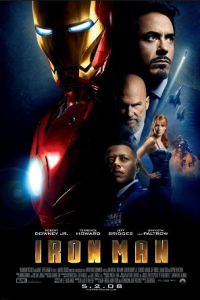 In The 40-Year-Old Critic, Venganza Media creator and host Arnie Carvalho recalls a memorable film for each year of his life. This series appears daily on the Venganza Media Gazette.
In The 40-Year-Old Critic, Venganza Media creator and host Arnie Carvalho recalls a memorable film for each year of his life. This series appears daily on the Venganza Media Gazette.
We truly live in the golden age of Marvel movies. In the past six years Marvel Studios (and now Disney) have set the standard for comic-based films, and racked up some of the highest-grossing hits of all time.
This year, the company proved how golden it really is with Guardians of the Galaxy, a film featuring a talking raccoon and his friend, the tree. On paper, that’s laughable. This movie shouldn’t have worked; the concept is so far removed from The Avengers that it conjures up memories of Howard the Duck (who even made a cameo).
But as I sit here typing this, Guardians has the designation of being 2014’s top grossing picture in the U.S.
It’s a wild success story that no one could have predicted — certainly I didn’t — back in 2008 when Marvel Studios released its first film: Iron Man.
As I detailed in my reviews of Superman and Spider-Man 3, I was a Marvel Comics fan in my teen years. At my peak I had several thousand comic books; long boxes stuffed with popular titles like Spider-Man, X-Men, and The Incredible Hulk, as well as Darkhawk, Ravage 2099, and Fantastic Four. Conspicuous perhaps by his absence, I didn’t own a single issue of Iron Man.
The character did make appearances in many comics I owned. Massive crossovers such as Secret Wars prominently featured the Armored Avenger. Yet none of those appearances made me feel like picking up an Iron Man comic. A businessman who pretends to be his own bodyguard in a suit of armor? The concept sounded pretty cheesy. The suit’s design, a garish red and yellow, also was a turnoff. He could fly. He could shoot lasers from his hands. And? Why would I want to read about that?
More, why would I want to see a movie about that?
The arm-chair studio moguls online and in magazines like Entertainment Weekly seemed to agree with me. Phrases like “B-list superhero (at best)” were used to describe Iron Man. It is hard to believe now, but just seven short years ago Iron Man had virtually no name recognition among the common public. Marvel had sold the movie rights to many its most well-known superheroes, including Spider-Man, Hulk, Wolverine and the X-Men, and those characters had gone on to star in their own pictures. Even other B-listers like Daredevil, Blade, and Ghost Rider had been picked up by other studios. What did Marvel have left?
They had Captain America, a man out-of-time goody-two-shoes. They had Thor, a Norse god that may have been even less well-known in his comic incarnation than Iron Man. They had The Incredible Hulk, who had a good history but a recent box-office disappointment thanks to Ang Lee’s Hulk. And they had Iron Man.
Yet Marvel had a vision. More, they had a plan. They didn’t release one film in 2008, they released two. They let it be known immediately that they were going to do on screen what they had done in their comics: create a shared universe where characters would cross over. The end game was announced before Iron Man was in theaters, Marvel wanted to assemble The Avengers.
I thought it was crazy talk. While, thanks to Harry Potter and Lord of the Rings it had become more common to have sequels in production, or even entirely filmed, before the first film was released. Even those seemed risky though, with pundits noting Lord of the Rings could have bankrupted New Line Cinema. Yet here Marvel Studios was going this route for its first features.
Iron Man didn’t excite me, but Marvel’s strategy sure got my attention. It was audacious, it was bold, and it was risky. I admired them before I ever saw a frame of the film.
Even crazier — they hired Robert Downey, Jr. to play Iron Man/Tony Stark. If you’ll recall, in the late 90s and early 2000s, Downey had a fairly toxic reputation in Hollywood. His well-publicized battle with addiction and his prison stints had branded him as unreliable. Worse, he was uninsurable — no company would put up a bond for the actor lest he again be arrested and his filmed scenes became unusable.
Despite his off-screen troubles, I had always been a fan of Downey. While I’d seen him in Weird Science and Back to School he first really caught my eye as someone to watch in The Pick-Up Artist, a film in which Downey is the only redeeming quality. I followed him for many years with Less Than Zero, Chances Are, Air America, hell I even watched Soapdish because he was in it. But two roles really defined Downey for me: his 1992 Oscar-nominated lead in Chaplin, and his role as a tabloid TV reporter in Natural Born Killers. But the more public his personal troubles became the more I felt he was an actor on the decline. I was really saddened by this — the man could act! From Two Girls and a Guy to U.S. Marshals to Kiss Kiss Bang Bang, I’d always been captivated by him.
That he was the star of Iron Man had me both worried and excited. On the one hand it seemed like on-the-nose casting — if I knew one thing about the Tony Stark character in comics it was that he was an alcoholic; if most people knew Downey for only one thing it was for his substance abuse problems.
The trailers with the rocking Black Sabbath track, Downey’s quick quips, the great action, and the effects — the film looked better than I expected; better than it deserved to look. Plus, rumors spread like wildfire that the film would include a cameo by Samuel L. Jackson as S.H.I.E.L.D. boss Nick Fury. By the time Iron Man was released, my curiosity was piqued.
Still, I was more interested in the second of Marvel’s one-two summer punch: The Incredible Hulk. I was a Hulk fan, he was the hero with name recognition; plus it had Edward Norton, an actor I believed was every bit as talented as Downey. But until Hulk came out I thought Iron Man could help me pass the time.
My expectations were low, but I was still there opening night to see Iron Man. I even drove 90 minutes to the closest new-fangled digital projector in the area.
The film, in short, rocked. I never expected to have so much fun in a superhero film. Movies like Blade, X-Men, and Batman Begins had seemed to say there was only one way to make a comic book movie, and that’s deadly serious. Iron Man eschewed that attitude with the flippant irreverence I’d expect from its main character. The movie did have its serious scenes, but the majority of the picture was filled with a kinetic energy and a constant sense of fun. I walked into the theater not getting Iron Man’s appeal; I walked out an Iron Man fan.
This was bolstered by Downey’s now-iconic performance. I couldn’t take my eyes off him. His jokes, his charisma, he owned this film. His line, “I am Iron Man,” was 100 percent accurate, for I couldn’t imagine this movie without him. Given the wide range of roles I’ve seen Downey portray I am hesitant to call this his best performance ever, but it is my favorite (with his 2008 follow-up Tropic Thunder a very close second).
Iron Man even brought Now Playing Podcast out of a brief retirement in 2008, and we followed up that short review with an even more extensive breakdown of the film for our Avengers Retrospective Series in 2012.
Yet, despite my love of the movie, I still thought Marvel’s overall strategy was ill-formed. Iron Man did well, Hulk did not. More, the only superhero film people seemed to remember from 2008 was Christopher Nolan’s The Dark Knight — a film that was more than a blockbuster, it was a cultural touchstone.
In 2008 it really seemed Marvel had lost the battle. More, they had no movies planned for 2009. Iron Man was a big enough hit to keep the wheels turning for Iron Man 2 in 2010 but I never thought Marvel could go the distance. Avengers seemed like a pipe dream.
Again, I bet wrong. Iron Man 2 built on the brand in 2010, and the following year saw two more Marvel films, Thor and Captain America: The First Avenger. Both did respectable business, but neither broke the $200 million domestic mark to be qualified as a blockbuster. They didn’t need to; Marvel was playing the long game, they were building a brand.
It paid off — big time. The Avengers took the world by storm. It almost seemed a rematch of Marvel versus DC as, that same year, Nolan returned with The Dark Knight Rises. Iron Man once again faced Batman, but this time Stark brought his friends and when 2012 ended it was The Avengers that had become the benchmark for comic book movies. Sorry, Batman.
Marvel Studios’ brazen gambit paid off in spades. Not only has the company become an unstoppable movie juggernaut, they have expanded their cinematic universe to weekly network television, to four different Netflix series’, and even drawn plans for up to three movies per year in the future.
Other studios now desperately try to ape Marvel’s success. After trying for 20 years to get Batman and Superman on screen together, next year finally brings us Batman v Superman: Dawn of Justice, with a list of superheroes that include Wonder Woman, Cyborg, and — according to rumor — Aquaman, the Flash, and others. DC is now playing catch-up to Marvel.
Even other studios with Marvel properties have tried to follow this formula, though to less success. The same year The Avengers was released Sony tried to build its own multi-chapter story with The Amazing Spider-Man. This year they announced that a Spidey universe of films is coming, including two spin-offs featuring villains — Sony is now grasping for whatever characters to which they hold rights. At 20th Century Fox, studio executives also bet big-time on their X-Men franchise, bringing back original director Bryan Singer to revitalize the series. The Marvel Studios tactic of ending each film with a “stinger” to tease the next picture is now so commonplace, audience members are afraid to leave the theater before the end credits are finished.
Yes, for the past 6 years movies have been following Marvel Studios’ formula. It all started with a big gamble that paid off: Iron Man.
As for me, Iron Man opened a door that had been cracked the year before with Spider-Man 3. The Marvel movies were really an exciting property to follow. My dormant comic fandom was back with a vengeance. Marjorie, knowing my love of Iron Man, bought me my first high-end Marvel collectibles: a Hot Toys “Mech Test” Tony Stark figure, as well as a Kotobukiya Iron Man statue. The door was opened and before long the podcast Marvelicious Toys was launched as a companion piece to Star Wars Action News, focusing specifically on Marvel collecting.
More, Marvel Studios’ films had me wanting to build up to The Avengers. Now Playing Podcast had been following, almost exclusively, the retrospective format in 2009 and 2010, but after seeing Iron Man 2 I pitched to co-hosts Stuart and Jakob the craziest, biggest retrospective yet: every Marvel movie ever. Up until then our series’ had all been of manageable length of a dozen films or less. It took a year of discussion. First, Stuart thought we should only do the six Marvel Studios films. Then he thought we should do the major franchises. Finally he agreed to all theatrical films, and we had started Now Playing’s Complete Marvel Movie Retrospective. Over time I was even able to find a back door — several 1970s TV movies had aired in theaters in foreign countries.
It put Now Playing on a path to greater success, as described in my review of Howard the Duck — our first review in that very long series.
Yet while I still ride the high Iron Man gave me in 2008, bolstered regularly by a new “fix” from Marvel Studios, I do wonder how long this will last. Movies are defined by trends; after Star Wars every studio fast-tracked their space films, but by the mid-80’s those had become passé; after Gremlins any script with tiny attackers, from Ghoulies to Critters was given the green light. The cases of Hollywood me-too-ism are legion, but they all have one thing in common: they end when the next big thing comes along.
I often ruminate on what that next trend will be, and when audiences will tire of the serialized cinema storytelling and prefer movies that provide a singular experience with no “to be continued…” at the end. I have no doubt that day will come, but I think we’re in for many more years of the Marvel Age of cinema before we get there.
Tomorrow — 2009!
Arnie is a movie critic for Now Playing Podcast, a book reviewer for the Books & Nachos podcast, and co-host of the collecting podcasts Star Wars Action News and Marvelicious Toys. You can follow him on Twitter @thearniec
September 7, 2014 Posted by Arnie C | 40-Year-Old Critic, Comic Books, Movies, Reviews | 2000s, 40-Year-Old Critic, Avengers, Batman, Captain America, Collecting, Comic Books, Comics, Enertainment, Film, Hot Toys, Iron Man, Marvel, Marvel Comics, Marvelicious Toys, Movie, Movies, Now Playing, Now Playing Podcast, Podcasts, Review, Reviews, Robert Downey Jr, sci-fi, Sideshow Collectibles, Spider-Man, Statues, Tony Stark, Toys, X-Men | Comments Off on The 40 Year-Old-Critic: Iron Man (2008)
The 40 Year-Old-Critic: Spider-Man 3 (2007)
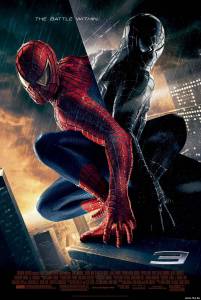 In The 40-Year-Old Critic, Venganza Media creator and host Arnie Carvalho recalls a memorable film for each year of his life. This series appears daily on the Venganza Media Gazette.
In The 40-Year-Old Critic, Venganza Media creator and host Arnie Carvalho recalls a memorable film for each year of his life. This series appears daily on the Venganza Media Gazette.
See a list of all reviews
Earlier this week, when I discussed Star Wars Episode III: Revenge of the Sith, I described how I tend to channel my excitement into creative venues. I’ve been doing it my whole life, whether that meant writing fan fiction, building model kits, customizing action figures — the point is, I like to build upon my imagination. In 2005 that drive led to the creation of the Star Wars Action News podcast.
Two years later, a near-equal level of excitement gave birth to an even larger idea that became Now Playing Podcast. The excitement was for Sam Raimi’s Spider-Man 3; the first film Now Playing ever reviewed.
I had been a longtime Spider-Man fan, from the 1970s Spidey Super Stories on The Electric Company to Spider-Man and His Amazing Friends and even Stan Lee’s daily The Amazing Spider-Man newspaper strips, but even I didn’t anticipate my own hype for this sequel. I barely caught the first Spider-Man film in theaters (its release in 2002, directly against Star Wars Episode II: Attack of the Clones, and my wedding, was much of the reason). I was more excited for 2004’s Spider-Man 2, but I wouldn’t say I was “hyped.”
But the bug bit me in 2007 — Venom had gotten into my system.
I started reading comics in 1990. I never got into them as a child; I simply wasn’t exposed to comics through friends or media. My Star Trek fandom drew me into the comics culture, because I wanted to read the “official” stories taking place after the events of Star Trek V: The Final Frontier. The first time I stepped into a comics shop the clerk tried to sell me Spider-Man No. 1, from the highly-acclaimed Todd McFarlane series.
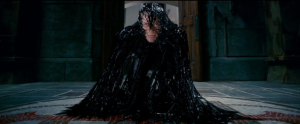
This tease ignited the fanboy in me.
I passed. I always thought the comics were just color reprints of the daily newspaper strip, until my longtime friend and Now Playing co-host Stuart started telling me stories about how Spider-Man changed his costume to one that was black-and-white. Incredulous, I didn’t believe him, especially when he told me the suit turned out to be an evil alien. In response, and to prove his point, he pointed me to a comic book store. I went back to read many of McFarlane’s Amazing Spider-Man back issues. Of specific interest were the stories that involved Venom, a muscle-bound baddie named Eddie Brock with whom the alien suit had bonded. Venom had all of Spider-Man’s powers, but none of his responsibility.
For years I read every Spider-Man comic, but I anticipated none as much as those that starred Venom. When Brock went from villain to anti-hero in his own series, Venom: Lethal Protector, I was even happier; I could now read about him every month!
I honestly wonder if I liked Venom even more than Spider-Man himself.
As a fan I read rumors about a big-screen adaptation of Spider-Man, but it languished in development hell for more than a decade. I remember reading a Wizard Magazine in 1992 that teased a James Cameron directed Spider-Man film starring Charlie Sheen as Peter Parker and using Terminator 2 special effects for the villain — Venom! I couldn’t have been more excited but, alas, that film never materialized. When Spider-Man did hit theaters in 2002 Sheen, Cameron, and Venom weren’t even under consideration.
Finally, after enjoying two Spider-Man films in theaters (as you can hear in the Now Playing Podcast Spider-Man Retrospective Series), word came that Raimi was finally getting to my favorite Spidey nemesis.
Venom was first teased at the 2006 San Diego Comic-Con. I wasn’t in the Sony panel, but friends excitedly described the scene of alien ooze landing on Eddie Brock (Topher Grace). That the scene took place in a church really upped my expectations — Raimi had been pretty loyal to the Spider-Man mythos thus far, and despite casting the wiry Grace as the muscle-bound Brock, it seemed he was continuing that trend with Venom.
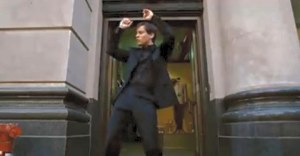
I’d seen the black outfit take Peter Parker to dark places in the comic…but never as dark as Maguire’s uncomfortable dance scene.
Venom, Raimi, and Spider-Man created a perfect storm of hype.
I am a collector by nature, and often I express my fandom through displays of movie memorabilia. It all started with my Star Wars toys in 1977, but from Superman to Gremlins to Ghostbusters to Star Trek, I’d always buy the trading cards, toys, and books for films I loved. Of course, Star Wars remained my primary focus — I bought every figure, vehicle, book, and game released.
By the year 2000 my townhouse was a crowded toy box, full of Star Wars toys, but also X-Men movie figures, Spider-Man toys, McFarlane Toys’ Movie Maniacs series’ Leatherface, Freddy, and many more. But in 2001 I quit my job and became a full-time student, and with that drastic reduction in income came a drastic reduction in collecting. I actually sold most of my toys and narrowed my focus down to my first love — Star Wars. Even as my career started to take off, my income increasing, I was never tempted to return to collecting anything but Star Wars until Spider-Man 3.
By 2007, Star Wars Action News was heard by tens of thousands of listeners every month, and hundreds congregated on our forums to discuss the toys. Surprisingly, many of those fans were also swept up in the excitement to see Raimi’s next Spider-Man film. When I mentioned on the podcast that I was drawn to — but couldn’t allow myself to buy — a particularly cool Venom figure sold by Sideshow Collectibles, these listeners came to the forums en masse to encourage my spending! Some even tried to take up a collection to buy the $80 figure for me; an act of generosity I could not possibly accept.
The flames of my Spider-Man 3 excitement were fanned by Star Wars Action News listeners, and that combination caused me to move on an idea I’d had for some time: a movie review podcast. The first movie we’d review would be Spider-Man 3, obviously.
It wouldn’t be a stretch, my wife (and co-host) Marjorie and I had already reviewed one movie together, Snakes on a Plane, the year before.
Coincidentally, another Marvel character first planted the seeds in my head that I should launch this show. Coming out of 2007’s Ghost Rider Marjorie had me almost doubled over with laughter as she lambasted the Nicolas Cage film. Not only were her observations on point, they were quite amusing. I knew many of our listeners loved Marjorie’s color commentary, and I thought that if I’d had a microphone on us walking out of Ghost Rider we’d break download records.

Despite the film’s numerous flaws, the CGI work on Sandman was impressive, and moving.
But I was daunted. Movie review podcasts were a dime a dozen. Anyone with a microphone seemed to be reviewing movies. With Star Wars Action News we’d made a big splash in the Star Wars community — a big fish in a tiny pond. Yet, even with that success I knew that we’d be out of our comfortable pond and thrust into an ocean of movie podcasts. I wasn’t sure how to make us stand out, and so I never acted on it.
More, SWAN had gone from a one-day-per-week hobby to a very time-consuming new career. Two hours of recording became 10 hours of editing, and then toy photography and travel — suddenly I was spending more time on podcasting than I was on teaching my college courses. Plus, teaching was my second job; I also had a full-time day job. With all of these commitments the thought of doing another podcast regularly was overwhelming.
Still, the seed had been planted, and my excitement for Spider-Man 3 turned it into action. Marjorie came up with the name, taken directly from the screen of her iPod that always said at the top, Now Playing.
It’s laughable now as I spend 30 or more hours per week on the show, but I originally thought Now Playing Podcast wouldn’t take much time. I figured we’d stick to my first idea and take the portable recorder (the one I’d purchased for the Samuel L. Jackson interview) to the theater and when the movie was over I’d have a microphone to capture our initial reaction. Marjorie and I went to the movies nearly every week, so we could have a spoiler-free review with just a few minutes of recording. I’d release it unedited, just add music, and be done.
As for the way to differentiate ourselves from the thousands of other podcasts? That would take me a couple more years to really figure out. In the meantime we had Marjorie and a built in audience for Star Wars Action News.
Deciding to launch Now Playing on the same day as Spider-Man 3’s release had two profound effects. First, my excitement for the next Spidey film had an outlet that didn’t involve buying collectibles. I was preparing our own launch of a podcast, so my time and money was spent getting domain names and setting up web pages (Though I was visiting Burger King more than usual to get their Spider-Man 3 kid’s meal toys — the Venom still eluded me).
Second, the anticipation for May 4, 2007 increased 50-fold — that was the day I’d get to watch Spider-Man and we’d launch our newest podcast!
My excitement level was so high we actually took that afternoon off work. There were no midnight shows, but we were there for the first matinee of the day. It was time to see Venom fight Spider-Man, and classic Spider-Man bad guy Sandman (Thomas Hayden Church) would be in there somewhere as well.
In my mind I felt I knew how the movie would be paced. The trailers had shown Spider-Man fighting Sandman while wearing his black suit. I thought for certain it would follow the structure of the original film, with the first half largely about the origin story, only this time it would be the origin of the black suit (again with Sandman in there somewhere). Then, I assumed the second half of the picture would be about our hero battling his arch-nemesis, only this time instead of Green Goblin it would be Venom.
The more I heard about Sandman being the main baddie in this film, though, I started to form a back-up theory. The trailers never showed Venom outside of the church, so I thought this entire film could be a setup for Venom, who would return as the main bad guy in Spider-Man 4.
No matter what, in Raimi I trusted. From Evil Dead to Army of Darkness, Darkman, and more, he had proven time and again to be a director with style and vision (that late 90s period including For the Love of the Game notwithstanding).
We got to theater early, after an obligatory trip to Burger King to try and get that damn Venom toy. No luck.
I can still remember being so excited I was practically vibrating in my seat. The film started, the score played over an opening credits montage reminding us of the first two films. Little did I know this would be the high point of the movie for me — thinking of the earlier, better films.
The introduction of the alien symbiote that became Spider-Man’s black suit was the opening scene, and completely convenient. It just happened to land near Peter Parker and take him over. No reason why, it just happened.
Faith was restored with the introduction of Sandman, Church having bulked up for the role and really looking like the comic book character come to life. The CGI effects during his transformation marked a new standard for humanity conveyed by computer animation.
But that was quickly lost by the contrived retcon tying Sandman to the death of Spider-Man’s Uncle Ben, and a subplot involving Peter Parker’s love life.
I won’t rehash the entire review again. You can hear our full, detailed, scene by scene review in the Now Playing Podcast archives. The disappointment you’ll hear in my voice mirrors my thoughts sitting in that theater. During that theatrical experience I realized not only was I watching a movie that was not very good, but that Now Playing’s first review would not be very positive. I had hoped for the show to be a celebration of Raimi’s film — the orgasmic climax after five years of build-up. Instead, we would have to be honest and discuss how everything — from the plot to the acting to the score — was not only far below my expectations, but also not very good at all.
No matter the quality of the movie, Now Playing Podcast had arrived. Star Wars Action News listeners and forum members were anxiously awaiting the review. So we went to the car and, raw from the experience, recorded our thoughts. We sat in the car, Spider-Man toys from BK in the back seat, and gave our initial reactions. I tried to temper my disappointment, but when I listen to that show I can hear the sound of a heart breaking.
In the years since I’ve come to focus on some of the better parts of the movie. The effects are mostly top notch, Topher Grace adds needed energy to the cast, and some of the jokes are winners. With the dour nature of The Amazing Spider-Man reboots, I even sometimes finding myself actually wishing for some of the spirit Raimi put in all of his films… even Spider-Man 3.
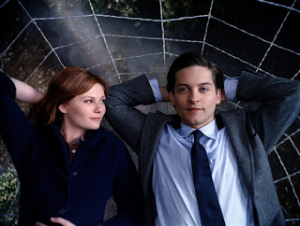
The tangled web that is Peter Parker’s love life would never straighten out; after Spider-Man 3 Sony decided to reboot without Raimi at the helm.
Yet from that bad movie experience something good did come — Now Playing. It would take years for me to realize that. Despite my best intentions, the show went from being recorded on the run to being done in the studio; it went from unedited to lightly edited to full edits. The time commitment was growing, and the listenership wasn’t. We were now one very tiny fish in an ocean so overpopulated that most shows suffered from listener famine. Without listener involvement the show became neglected, and the fewer shows we did the fewer listeners we had when we would put out new reviews. For a while we even gave up hosting altogether.
It wasn’t until 2009 when another movie, another hype machine, got me going: the Platinum Dunes remake of Friday the 13th. Then I had the idea of the Retrospective Series and a three-person rotating cast of hosts. The hype for that movie also ended in disappointment, but we had finally found the format that made our show stand out.
Today Now Playing is a regular show in iTunes’ Top 10. I’ve met hundreds of listeners in person and talked to thousands through social media. Each person with whom I interact is an experience I cherish, and it’s stunning to think none of this would have happened if it weren’t for Spider-Man 3.
And as for my resistance to collecting Marvel, Spider-Man 3 helped me stave that off… for a couple more years at least. As anyone who’s heard my Marvel collecting podcast, Marvelicious Toys, knows, I have now fully embraced it and enjoy it as a smaller side-collection to my primary Star Wars collecting.
Tomorrow — 2008!
Arnie is a movie critic for Now Playing Podcast, a book reviewer for the Books & Nachos podcast, and co-host of the collecting podcasts Star Wars Action News and Marvelicious Toys. You can follow him on Twitter @thearniec
September 6, 2014 Posted by Arnie C | 40-Year-Old Critic, Amazing Spider-Man TV Series, Comic Books, Movies, Reviews, Television | 2000s, 40-Year-Old Critic, Collecting, Comic Books, Comics, Enertainment, Film, Marvel, Marvel Comics, Marvelicious Toys, Movie, Movies, Now Playing, Now Playing Podcast, Podcasts, Review, Reviews, Sam Raimi, Sideshow Collectibles, Spider-Man, Spider-Man 3, Star Wars, Star Wars Action News, Toys | Comments Off on The 40 Year-Old-Critic: Spider-Man 3 (2007)
The 40 Year-Old-Critic: Snakes on a Plane (2006)
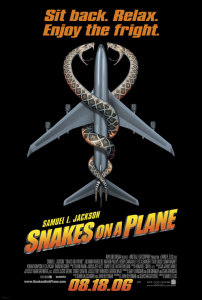 In The 40-Year-Old Critic, Venganza Media creator and host Arnie Carvalho recalls a memorable film for each year of his life. This series appears daily on the Venganza Media Gazette.
In The 40-Year-Old Critic, Venganza Media creator and host Arnie Carvalho recalls a memorable film for each year of his life. This series appears daily on the Venganza Media Gazette.
As I discussed in yesterday’s The 40-Year-Old Critic entry, I began my podcasting career in 2005 with the Star Wars collecting show Star Wars Action News; launched shortly after the release of Star Wars Episode III: Revenge of the Sith.
It had seemed like an easy enough hobby, we just record for 30 minutes each week.
However, the reach exceeded our every expectation, and in February 2006, we realized that recording from home wasn’t enough. All of the new Star Wars action figures and statues that would be released in 2005 had been revealed at Toy Fair International in New York City — and we weren’t there. We had our friends Pete and Chuck from the website Jedi Temple Archives call the show and share the news, but we knew we had missed out.
Pete and Chuck also told about the huge Lucasfilm and Hasbro presence at San Diego Comic-Con. New toys would again be revealed at the summer convention, and we felt Star Wars Action News should be there to cover it.
Marjorie and I had become more experienced con-goers since our first trip to Star Wars Celebration II for the release of Attack of the Clones, but we had never flown to an event. Airline tickets were expensive. Still, we had a show, and we needed the toys. Soon tickets were purchased, press passes obtained, and we were going to SDCC.
Then things got interesting.
As registered press for the convention, Marjorie and I started getting numerous e-mails from various companies seeking exposure. From toymakers to authors to movie studios, we were invited to exclusive events and given opportunities to interview total strangers.
Then came the e-mail that gave us the opportunity to interview Samuel L. Jackson and others for the upcoming film Snakes on a Plane.
I had heard about Snakes on a Plane but paid it little attention. Entertainment Weekly had written several articles about the silly movie with the overly-literal title. From the name alone hundreds of fan websites had sprung up. Despite its premise, the film had a groundswell of good buzz and the film’s producers wanted to capitalize on press coverage at the convention. With Jackson being a vital presence in the Star Wars prequels I thought an interview would certainly be of interest to Star Wars Action News listeners.
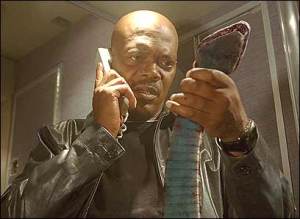
I like to imagine this is Jackson calling his agent wondering how he got on this Plane.
It seemed too good to be true. Jackson was an A-list star; I’d been podcasting for 9 months. I couldn’t believe it would actually happen. I told absolutely no one — after all, if it fell through I didn’t want to be mocked or thought of as a lying braggart. But I prepared: I bought a high-end digital audio recorder and I researched the film to be as informed as possible going in.
Yet the entire event could have been called San Diego Snakes-on-a-Plane Con. On the exhibit floor was a giant booth that was shaped like a snake, yet inside the mouth it had the feeling of a cramped airliner. The music video for Cobra Starship’s “Snakes on a Plane (Bring It)” was omnipresent (and I strained my eye every time it played for a glimpse of Maja Ivarsson’s nipple). We had gone to the convention with some friends who had just discovered the Badger Mushroom song, and so throughout the convention we’d regale each other with the refrain, “Snaaake! It’s a snaaake!” Our friends even brought rubber snakes to the convention as practical jokes.
I was swept up in the utter hype for Snakes on a Plane. I couldn’t wait for them to “Bring it.”
Sure enough, the next thing I knew I was in my first press roundtable interview. Jackson was the biggest star at the event, but it turned out there were four interviews in play. First, we interviewed director David R. Ellis, who I knew from his work on Final Destination 2. The other reporters at the table seemed disinterested and I got to ask a few questions.
Then we talked to the film’s snake wrangler Jules Sylvester. He wore an amazing serpent as he talked about the challenges of dealing with more than 450 snakes on set.
Finally, Sam Jackson visited our table.
Now the other reporters had perked up, and because I was still unaccustomed to the rhythm of the roundtable, I had to work hard to get questions in. I wasn’t entirely new to interviews; I had done many for journalism classes, and interviewed Star Wars collectors and authors on the show. But this was an A-list star. Jackson was there and actually joked with me a bit. It was surreal. He even gave me an autograph on a Star Wars book.
Finally the last interviewee came, Keenan Thompson, who Marjorie knew primarily for his work on Saturday Night Live. I got a couple of questions in there as well.
Leaving the interviews I realized I had far more content than I had thought. While the Jackson interview would be of some interest to Star Wars fans, the rest of the interviews were full of good information, though I knew they had no place on Star Wars Action News. Early feedback from Star Wars listeners was that they did not care for bad language, and so I figured the audience crossover between an R-rated reptile disaster film and Star Wars Action News was minimal.
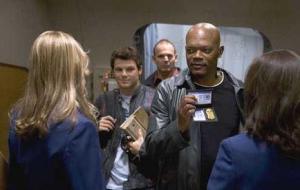
I’m not sure if a movie titled Snakes on a Plane needs more plot than, well, snakes on a plane. Yet this film also gives us a crime story to explain…sort of…how the snakes, and Sam Jackson, got on that plane.
But with four great interviews in the can I decided to start our second podcast, Snakes on a Podcast. It was a limited show, with only five episodes. The first four would lead up to the release of the movie and each would contain one interview. Then, for the fifth show, Marjorie and I would review the movie.
We publicized the show heavily on Star Wars Action News and it got a decent number of downloads. More, anticipation was high for our review; people wanted to know if we thought Snakes on a Plane was worth seeing.
Marjorie and I went to see Snakes opening night in August 2006. We had pre-purchased tickets, the Internet and Comic-Con hype convincing us it would be a sold-out show. It wasn’t.
More, the movie itself wasn’t very good, and we knew it in the theater. It wasn’t terrible, we had seen far worse that year, yet we had hoped for a pulpy B-movie full of laughs and fun. This was long before there was a Sharknado or Piranha 3D, but it was those films’ campy vibe that we hoped Snakes on a Plane would capture. There were moments of that in the film, but they were few and far between. The studio had initially made a PG-13 movie, then went back and added in scenes for the R-rating based off Internet fan demand for the line, “I want these motherfucking snakes off this motherfucking plane.” Those added scenes were what we wanted, that line was legendary, but in between moments of fun were long stretches of stupidity.
You can hear our thoughts, recorded minutes after leaving the theater, in the archived Snakes on a Podcast show. It is the first movie Marjorie and I ever reviewed in podcast form, and is the precursor to Now Playing Podcast, a show we started nine months later.
While the movie failed to meet our expectations, the theatrical viewing didn’t. It was an experience akin to The Rocky Horror Picture Show. While the theater wasn’t packed, everyone there was a built-in fan and the energy of the audience made for a good time. I have watched Snakes once since that theatrical viewing and it is clear that without the fans surrounding us there was little fun to be had.
Snakes on a Plane will always hold a special place in my heart. Not only was it the first time I ever felt like a real reporter for a podcast, it also is one of the last movies to consume San Diego Comic-Con. In the 2000s the complaints were that SDCC was no longer about comics; the fans had come for the movies. That was certainly true in my case. Hollywood studios saw SDCC as an opportunity to push genre movies to greater success, and spent hundreds of thousands, sometimes millions, of dollars at the convention trying to do so.
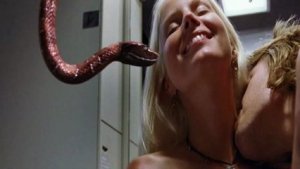
One of the films better, funnier scenes–added later to ensure an R-rating.
Despite the impressive imprint the movie had on the convention floor, Snakes on a Plane fizzled at the box office. Since 2006 a single film has always been pushed at the convention, from Hamlet 2 to Balls of Fury to Scott Pilgrim vs. the World, and they all failed to meet heightened studio expectations. Now it seems film studios have all but abandoned Comic-Con. The giant, custom booths that used to grace the floor are mostly gone. While stars still fly in to host one-hour panels, the convention has morphed into a showcase of genre television shows like Doctor Who, Game of Thrones and Arrow.
Yet each year I hope for another Snakes on a Plane-type experience, another extreme booth attempting to immerse fans in the world of their movie. It may not happen again, but at least I got these motherfucking snakes on this motherfucking Plane.
Tomorrow — 2007!
Arnie is a movie critic for Now Playing Podcast, a book reviewer for the Books & Nachos podcast, and co-host of the collecting podcasts Star Wars Action News and Marvelicious Toys. You can follow him on Twitter @thearniec
September 5, 2014 Posted by Arnie C | 40-Year-Old Critic, Conventions, Movies, Now Playing Podcast, Podcasts, Reviews | 2000s, Cobra Starship, Comedy, Enertainment, Film, horror, Movie, Movies, Now Playing, Now Playing Podcast, Podcasts, Review, Reviews, Samuel L Jackson, San Diego Comic-Con, SDCC, Snakes on a Plane | 1 Comment
The 40 Year-Old-Critic: Revenge of the Sith (2005)
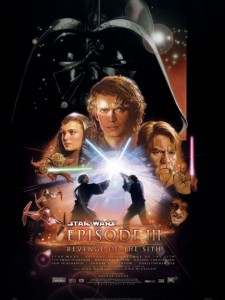 In The 40-Year-Old Critic, Venganza Media creator and host Arnie Carvalho recalls a memorable film for each year of his life. This series appears daily on the Venganza Media Gazette.
In The 40-Year-Old Critic, Venganza Media creator and host Arnie Carvalho recalls a memorable film for each year of his life. This series appears daily on the Venganza Media Gazette.
Star Wars’ greatest legacy may not be the (now endless) sequels, or the billions of dollars in box office revenue, or even the tens of billions of ancillary revenue the franchise has generated for Lucasfilm (now Disney). No, the longest lasting impact of Star Wars may be the people inspired by that film saga to go on and create themselves.
Filmmakers as varied as Jon Favreau, Damon Lindelof, and Eli Roth have all cited Star Wars as an important inspiration to their works, as have numerous authors, artists, game designers, and more.
In 2005 Star Wars inspired me as well… to become a podcaster.
By the time Star Wars Episode III: Revenge of the Sith was released I was pretty far-gone in terms of my fandom. Any lull I had experienced from 2000 to 2002 was long gone. My 2-bedroom townhouse had become a virtual Star Wars shrine with toys, prop replicas, and other various bric-a-brac on display in every room. As much due to my collection as it was a desire to build equity, Marjorie and I eventually left the rental property behind and moved into a home specifically selected for its ability to handle and display my Star Wars collection.
I had gotten three Star Wars tattoos since Attack of the Clones was released, including a Yoda that was based on the art in Genndy Tartakovsky’s Clone Wars micro TV series that bridged the story between Episode II and III. I was the ultimate Star Wars consumer — if it had a Star Wars logo I either bought it or put it on a long list to buy. I even, much to the amusement of the Target clerk and the embarrassment of my wife, bought a pair of Star Wars underwear intended for small children. To outsiders it was an undergarment, but to me it was a collectible.
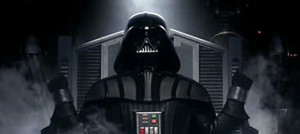
The birth of Darth Vader was the moment fans had waited 28 years for.
The excitement grew as we drew close to Revenge of the Sith’s May 2005 release date. The premiere was May 19 at 12 a.m., and I took the day off of work to sit outside the theater trying to get the best seats. Though I arrived at 10 a.m., I was not the first in line.
Coming off the high of the Star Wars Celebration III convention we attended in April, Marjorie and I had prepared line party events, including trivia, prizes, and music. I rolled up in my convertible with two 12-inch subwoofers in the trunk and blasted dance mixes of Star Wars themes. It was a party, and a blast.
I did have to leave the party for a couple hours to teach class — which I did wearing a Darth Maul tie.
What about the movie? It was far from an afterthought in all the festivities, it was the main event. The conventions, the toys, the party, they were all ways to express our fandom and excitement for the upcoming release. But when I sat in that theater the early morning hours of May 19 I was enthralled. Instantly I knew this was the best of the Star Wars prequels, by a long shot. It was the first of the new trilogy to have emotional weight. Plus it had great action, exciting new characters, and even succeeded in besting The Phantom Menace by having the best lightsaber fight of the entire series. I had high expectations for Episode III and the film lived up to them.
I lived on a euphoric high for weeks after seeing Revenge of the Sith. I went several times in local theaters, not out of a sense of obligation as I did with Phantom Menace but because I wanted to enjoy the film again. Then Marjorie and I drove to Chicago to see the film digitally with Stuart, my Now Playing Podcast co-host and longtime friend.
My Star Wars collecting went to even greater heights. Every day during our lunch hour Marjorie and I would go on a toy run, visiting one or more stores looking for new Star Wars toys.
Weeks passed, though, and while my fandom never wavered the anticipation turned into a feeling of melancholia. I had been looking forward to the Star Wars prequels since they were first officially announced in 1993 (in, of all things, a Star Wars screensaver). For twelve years I’d always had the next Star Wars film to which I could look forward. With the prequels done I wondered if I would ever again experience that level of anticipation.
To continue to experience fandom in new ways I read more Star Wars novels and comics, and visited websites and online forums. There I saw repeated mentions of something called a “podcast.”
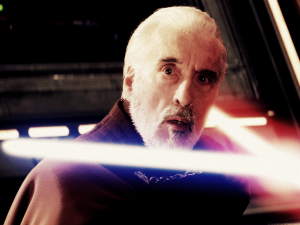
Still a better ending than Christopher Lee got in the Lord of the Rings series.
Being a tech head and, at that time, a college professor of Computer Science, I had heard of podcasting. I never understood the appeal; I was no fan of talk radio. More, I didn’t have an iPod, preferring the Creative Labs Nomad player. Yet now I saw there were podcasts discussing Star Wars, so I listened, and was excited. In my daily life I knew no Star Wars fans other than Marjorie, but on these shows were fans just like me, and they spent hours each week talking about nothing except Star Wars! Even more impressive, the Canadian podcast Star Wars En Direct even had Star Wars authors on the show to discuss their books.
I not only listened to the new podcasts, I went back and consumed the archives of many of these shows. Yet one thing frustrated me; while there were podcasts about Star Wars books, movies, and comics, none existed to talk about Star Wars collecting. Slowly the idea dawned on me… I should do my own.
I had a background in audio production. My desire to entertain, inspired by Pump Up the Volume, had sent me to study Mass Media Communications as an undergraduate. I was a radio DJ, and in my spare time experimented with digital audio, including rudimentary audio editing. As time went on I experimented in other computer multimedia, including video editing. I had the basic skills to do it, and just a few hours of research showed me all the technologies I would need to make it happen.
I also had my own website. My career goal had been to become a video game designer, and to build my resume I created a site reviewing PC games new and old.
So on Sunday, August 28, 2005, a little more than three months since Revenge of the Sith had visited theaters, I was inspired to create my own Star Wars podcast. I will never forget the conversation I had with Marjorie that Sunday morning.
“What plans do we have today?” I asked.
“Nothing,” she replied. It was a rare day that we had no obligations.
“Do you want to help me make a podcast?”
“Sure.” Then, after a moment, she asked “What’s a podcast?”
Within a few hours I had dug some old microphones out of a tote in my closet, installed the necessary audio editing software, and we were off. I didn’t know if anyone would listen, though I hoped they would. No matter what, though, I knew we’d always have the designation of having done it first.
That day Star Wars Action News was born.
I eventually learned that people did listen. I had reached out to several of the Star Wars websites and podcasts I’d read as a fan, and they actually posted about our show. I received immediate feedback, and that first week we had more than 50 downloads. The very next weekend I was at Best Buy to purchase better microphones and take some of that feedback to improve the show.
Tens of listeners became hundreds. Hundreds became thousands. Our show was a success. And while it was not earning money, I had finally found an outlet for my dream of entertaining people. Sure, I worked days at a bank, nights at a college, but on weekends I was a Star Wars commentator and collector.
That one podcast led to another… and another… and another. Marjorie and I have since traveled the country as invited Star Wars experts to speak at conventions. We have taken the mentality of throwing a Star Wars line party and grown it — at the last Star Wars Celebration we threw a party for almost 500 listeners and friends. Plus every year at San Diego Comic-Con we host the Star Wars Fan Breakfast for a sold-out crowd.
Most importantly, though, new friendships were formed. Marjorie and I met people near and far thanks to the reach of our Star Wars podcast. Now I had friends with whom I could chat about the saga, in addition to the regular show discussing my collecting.
And, of course, you’re probably reading this specifically because of Star Wars Action News. After all, without Star Wars Action News there’d be no Now Playing Podcast, the movie review show Marjorie and I started in 2007 and, with years of nurturing and attention, has grown to have an audience that even exceeds that of our cardinal show.

Darth Maul take note: lightsaber fights mean more when there’s a background between the characters.
These days it’s common for me to say “My life is weird.” I think this when I attend press events to interview the stars and directors of Leprechaun: Origins. The thought crosses my mind when I’m having a normal day at work and a piece of fan mail appears on my phone. I say it out loud when I see lines of people anxiously waiting to get into an event I’m hosting, just as I was anxious to see Star Wars in theaters. I’ve had the tremendous fortune to do things, meet people, and go places that many only dream of. I don’t take any of that for granted, but I always acknowledge that it’s a path I was inspired to take because of Star Wars Episode III: Revenge of the Sith.
Tomorrow — 2006!
Arnie is a movie critic for Now Playing Podcast, a book reviewer for the Books & Nachos podcast, and co-host of the collecting podcasts Star Wars Action News and Marvelicious Toys. You can follow him on Twitter @thearniec
September 4, 2014 Posted by Arnie C | 40-Year-Old Critic, Movies, Now Playing Podcast, Podcasts, Reviews, Star Wars, Star Wars Action News | 2000s, 2005, 40-Year-Old Critic, Anakin Skywalker, Collecting, Enertainment, Film, George Lucas, Movie, Movies, Now Playing, Now Playing Podcast, Obi-Wan Kenobi, Podcasting, Podcasts, Revenge of the Sith, Review, Reviews, sci-fi, Star Wars, Star Wars Action News, Star Wars Celebration, Toys, Yoda | 1 Comment
The 40 Year-Old-Critic: Saw (2004)
![saw-poster[1]](https://venganzamedia.com/Gazette/wp-content/uploads/2014/09/saw-poster1-210x300.jpg) In The 40-Year-Old Critic, Venganza Media creator and host Arnie Carvalho recalls a memorable film for each year of his life. This series appears daily on the Venganza Media Gazette.
In The 40-Year-Old Critic, Venganza Media creator and host Arnie Carvalho recalls a memorable film for each year of his life. This series appears daily on the Venganza Media Gazette.
During the last decade, much of our national conversation was centered on torture, both in current events and entertainment.
We’d read headlines about waterboarding and rectally-inserted broom handles, leaving us questioning the purpose and moral justification for torturing prisoners of war. Then, when we turned the page to the Entertainment section we’d read about reality show contestants undergoing some form of painful humiliation for fame; while at the multiplex, a new sub-genre of film was emerging: torture porn.
The term was coined by New York Magazine writer David Edelstein in 2007, but his christening of the brand name came after the release of Saw, the film that put torture porn in front of the masses and defined the horror experience of the first decade of the 21st century.
With torture surrounding us in real life why would audiences pay money to see make-believe torment on screen? I think Americans are comfortable taking horrible scenarios and making them “safe” through fiction. During the September 11 attacks we heard stories about people so panicked by the oncoming fire that they jumped from the high windows of the Twin Towers. Their terrible choice was a nightmare for our nation, that thought of having to either burn or leap to your death. Yet with films like Saw writers and directors took that same life-or-death choice and, because it was a movie, made it safe.
With these films we in the audience could both sympathize with the tortured, while also desensitizing ourselves to the acts on screen.
Perhaps we needed fictional torture to help us accept what the nation was experiencing?
Or perhaps we just wanted to push the boundaries of experience a little further through film?
I know I was looking for something new in horror. After 1999’s successful The Blair Witch Project it seemed Hollywood was smitten with low-budget ghost stories. Recycled J-Horror found success, praised by audiences and critics. I saw those films, but I continued to seek something more; something that was more dangerous than a PG-13 rating would allow, a movie that would push my boundaries the way Hellbound: Hellraiser II had in the 1980s. I wanted more than a bit of spooky suspense found in films like The Ring and The Grudge. I wanted a visceral feeling of life stretched to its most extreme limit.
I had no idea that’s what I would find when I watched Saw.
The film was low-budget — barely more than $1 million — and made by filmmakers who were inspired by the scares Blair Witch delivered, despite that film’s smaller cast and even smaller cost. Saw creators James Wan and Leigh Whannell started by making a 30 minute proof-of-concept film. Its effectiveness helped them raise the money they needed to hire a cast of accomplished actors, including Danny Glover and Cary Elwes.
The story seems simple enough — two men are chained up together in a room, and a dead body separates them. They must uncover clues, or saw off their own feet, to escape. Yet, while keeping a small scope, Whannell’s script created the first iconic horror villain of the 21st Century: “Jigsaw” John Kramer. Played by Tobin Bell, Kramer was a man dying of cancer. With little time remaining he begins to set intricate traps for people to help them live the rest of their life to the fullest — or die trying to escape.
As Jakob, Marjorie, and I mentioned in our 2009 Saw Retrospective Series, the concept of Jigsaw was not terribly original. This mastermind is merely an iteration of John Doe from Seven, but with a dash of the self-fulfillment agenda of Fight Club’s Tyler Durden. After all, Jigsaw’s trap of making a suicidal man cut himself is not that different than John Doe’s punishment for “Lust”; death by intercourse with a bladed phallus.
Yet, despite the similarities, there is one key difference: in Seven we found almost all of John Doe’s victims after the fact. When Seven‘s main characters, two police detectives, discover “Sloth” he’s already wasted away, and “Pride” is already dead. In Saw the cast has expanded; our main characters are the victims of the trap and we get to watch them faced with their tests.
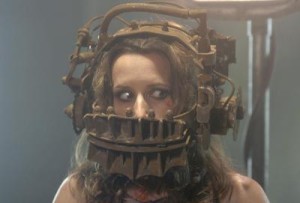
Shawnee Smith’s character Amanda escaped this trap to appear in five more Saw films.
More than just the two men in the room, the story grows to include more victims. Even for those introduced after an encounter with Jigsaw we still get to witness their torment in flashback. These scenes are myriad, from a woman in an iron collar that will tear her skull apart to a man, covered in napalm, having to hold a candle to read writing on a wall.
It’s not just that these victims were going to die in brutal ways (that was de rigueur for horror films since The Texas Chain Saw Massacre), but Saw upped the stakes by combining the suspense of impending horror. It was no longer just a killer behind the door, now there is a ticking clock and when it reaches zero someone will die, and in their last seconds they will harm themselves or others trying to escape.
These types of torment made waterboarding actually seem safe!
Though the creators of Saw would later claim the film was not torture porn, it was clearly the template for the dominant horror movement of the mid-2000s. Saw progressed through the scenes with characters put in increasingly more complex and convoluted traps, and I had the visceral reaction I’d sought. This movie did not scare me as Blair Witch did, but it repulsed me. I would flinch every time the next test came, knowing that the pain inflicted on the characters was fictional, but yet it hit home just the same.
The best part of it was that I was repeatedly asking the question: what would I do in those situations? Would I be able to cut off my own foot to escape a room? Could I kill a man in cold blood if the result was saving my own life? Could I take the pain of the razor cuts and escape the other side? And the absolute worst: could I shove both my hands in a shit-filled toilet to try and find a key?
Yet, a decade later I look back and wonder if subconsciously I made the connection between Elwes’ character, chained in a dirty shit-filled room, with those held in Guantanamo Bay. Neither the fictional character nor the real prisoner know if they will ever see daylight again, and both undergo horrible experiences before it ends… however it ends.
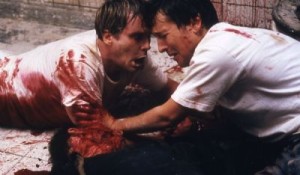
Dr. Lawrence Gordon (Elwes) and Adam Stanheight (Whannell) become brothers in blood on Saw’s dingy bathroom floor.
I can understand why Wan and Whannell would blanch at their hit being called torture porn. Porn usually indicates gratuitous sex (or sometimes action or gore) with no plot. Indeed, Saw has a plot as convoluted and twisted as any of Jigsaw’s traps. It’s clear to me that the two went through a lot of effort to create an involving story. Yet the fact remains that on my first watching I had trouble paying attention to the story for all that was thrown at me. It was a story that would become even more stretched and tangled as sequel after sequel followed, and for its labyrinthine complexity I actually grew to appreciate the franchise more.
Leaving that theater in 2004 I thought Saw wasn’t actually very good, but that’s because I was focusing on the plot (and the various holes it contained). Yet the images of the people in their torment stuck with me for quite some time.
More, as I previously stated, this film’s success created a new horror sub-genre, combining elements of the classic splatter film with the tropes of the slasher horror, yet drawing out the kill scenes in new and inventive ways. From the six Saw sequels to the Hostel films to The Collector to Turistas; each provided a new type of terrible vicarious experience. Truly the most extreme example in this sub-genre must be The Human Centipede — a film that I rejected in concept, but once its torture porn roots came through in the trailer I knew I was in for a treat.
But the genre burned out quickly. By 2009 Saw was clearly over, the sixth installment in the franchise losing a box office battle with the micro-budget found footage film Paranormal Activity. While a few more films, such as Saw: The Final Chapter and Human Centipede II were still to come, the election of President Barack Obama brought with it a shift in media attention away from Guantanamo Bay. That could be coincidence, but it seems more a causation — by the end of the decade humans were tired of facing torture, real or imagined, and preferred supernatural scares on screen. Their votes for political office matched their dollars spent at the box office.
As such, it seems torture porn will remain a symbol of early 21st century American movie-making. Yet out of that sprung some wildly inventive and visceral pictures that may yet inspire a future generation of filmmakers.
Tomorrow — 2005!
Arnie is a movie critic for Now Playing Podcast, a book reviewer for the Books & Nachos podcast, and co-host of the collecting podcasts Star Wars Action News and Marvelicious Toys. You can follow him on Twitter @thearniec
September 3, 2014 Posted by Arnie C | 40-Year-Old Critic, Movies, Now Playing Podcast, Podcasts, Reviews | 2000s, 40-Year-Old Critic, 9/11, Bush, Carey Elwes, Danny Glover, Enertainment, Film, horror, Jigsaw, Movie, Movies, News, Now Playing, Now Playing Podcast, Obama, Podcasts, Review, Reviews, Saw, Shawnee Smith, Terrorist, Tobin Bell, Torture, Torture Porn | Comments Off on The 40 Year-Old-Critic: Saw (2004)
The 40 Year-Old-Critic: Freddy vs. Jason (2003)
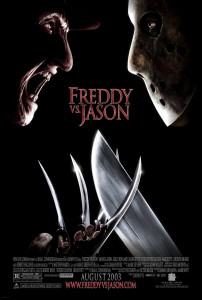 In The 40-Year-Old Critic, Venganza Media creator and host Arnie Carvalho recalls a memorable film for each year of his life. This series appears daily on the Venganza Media Gazette.
In The 40-Year-Old Critic, Venganza Media creator and host Arnie Carvalho recalls a memorable film for each year of his life. This series appears daily on the Venganza Media Gazette.
How many times will I review Freddy vs. Jason? It was one of Now Playing Podcast’s earliest reviews as part of our first retrospective series covering the Friday the 13th franchise leading up to the 2009 remake. Even then we planned to revisit the film and look at it from Freddy’s point of view, which we did the following year during the review series leading up to 2010’s A Nightmare on Elm Street.
By now this should be well-trod ground, and what more could I have to say?
Yet the fact that this is the only movie to be covered twice in Now Playing Podcast retrospectives is indicative of its importance — to film in general and to me personally.
Since our 2010 review I’ve spent a lot more time thinking about the crossover. What is it about two franchises coming together that creates such excitement, especially in the “geek” community? I don’t ask this hypothetically. I personally get swept up in the frenzy when two franchises come together, and it doesn’t even matter necessarily if I like them both! The thought of two universes colliding seems to have a geometric, not additive, increase in interest.
I think to some degree it is fan rivalry at its best. For reasons I don’t understand it seems some fans feel the only way to feel good about their fandom is by putting down others. For example, when Firefly was at its zenith a parade of “Joss Whedon Is My Master Now” shirts filled Star Wars conventions, as if to say, “Star Wars used to be cool.” As such, the “my dad can beat up your dad” mentality started to apply to fan groups; “My stormtrooper can beat up your browncoat.”
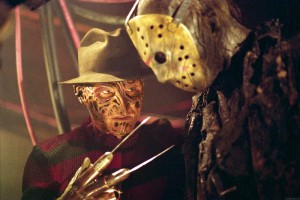
Freddy vs. Jason — whoever loses, the fans win.
That question of who would win in a fight certainly applies to superheroes. In real life, on screen, and online I’ve heard endless debates about which hero is faster, The Flash or Superman. Who would win in a fight, Superman or The Hulk? It is a curiosity, but the chosen winner usually aligns with the speaker’s fan allegiances.
Certainly, speaking of superheroes, comic books have benefited greatly from the crossover. DC Comics had a major hit with its Justice League in 1961, prompting Marvel Comics to respond with its own super team, The Fantastic Four, a move that inadvertently launched the entire Marvel Universe.
Yet, to me, the crossover seemed relegated to just that medium — the comic book. It seemed comics were pulp enough that you could do anything.
Aliens vs. Predator? Sure.
Robocop vs. Terminator? Why not.
Star Trek and X-Men together, you say? Absolutely.
Even rivals Marvel and DC had several crossover series’ that, for instance, led to Superman meeting Spider-Man or Batman fighting the Hulk.
Despite the success and excitement generated by these crossover comics, the concept was rarely conceptualized on film. Universal Studios had done it in the 1940s, when horror icons Dracula, Frankenstein and the Wolf Man came together for the studio’s “Monster Mash” pictures. But Universal owned each property, and when that series ended, crossovers on screen were scarce.
I can recall two that made an impact on me.
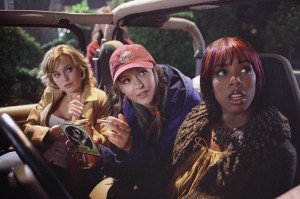
Freddy and Jason aren’t the only names in this cast. Monica Keena (Dawson’s Creek), Katharine Isabelle (Ginger Snaps), and Destiny Child’s Kelly Rowland play teens caught in the middle of the battle royale.
I remember being a young child on vacation with my parents when I saw a trailer for King Kong vs. Godzilla. I had seen numerous Godzilla films, and the 1976 King Kong several times. So the thought of them fighting broke my fragile little mind. I demanded we stay in the hotel room that night so I could watch.
Then, in 1988, Who Framed Roger Rabbit brought together animated characters from Warner Bros., Disney, Turner Entertainment, and more. As I was a teenager, and never really into these characters at my youngest age, the impact was totally lost on me. I saw the film in theaters, thought it was mediocre, and haven’t seen it since.
Beyond those two I can’t think of any groundbreaking crossovers. Some minor ones occurred; such as Star Trek: Generations bringing together cast members from two Trek television series’ (something that had already been done numerous times on Star Trek: The Next Generation, thus lessening the film’s impact). Also, The Monster Squad reassembled the classic Universal Monsters for a kiddie comedy.
But fans wanted more.
So many ideas were teased. Studios knew what we liked, so 1997’s Batman and Robin made sly references to Superman, and 20th Century Fox put an Alien xenomorph skull on a Predator ship in Predator 2. The latter seemed most likely to happen again on film — both franchises were Fox properties in need of a boost. Yet, outside of the Dark Horse comics, nothing materialized for years.
For me, though, more than Aliens and Predators, more than Superman and Batman, Freddy and Jason were the two I wanted to see. Long had the rumor brewed about Hollywood’s (then) top-grossing slashers, Jason Voorhees and Freddy Krueger, going toe-to-toe. I read about it in multiple Fangoria articles in the late 80s and early 90s.
I first saw A Nightmare on Elm Street during a party in 1987, around the time of A Nightmare on Elm Street 3: The Dream Warriors’ release. I found the films so inventive and fun that I rewatched them endlessly, and anxiously awaited each new installment in the series. As detailed during the Now Playing Podcast review, I even cosplayed for the release of Freddy’s Dead: The Final Nightmare. By 2003 I was happy for any new Nightmare, let alone one that pitted villain Freddy against Friday the 13th icon Jason.
I was never as big a fan of the Crystal Lake zombie as I was Freddy, but I did also enjoy the Friday the 13th series. Some of the first R-rated horror I ever saw was Friday the 13th when I came home to find older kids in my house watching it. I tried to join them but the carnage, specifically the decapitation at the end of the 1980 original film, had me fleeing the room. When I finally became a full-fledged horror hound in my early teen years I returned to the franchise when Jason Takes Manhattan was released. While the films lacked the visual panache of the Nightmare series I still enjoyed the films as a guilty pleasure. Over time the series grew in my esteem to be another favorite.

Freddy was killed by fire, but flames don’t slow down Jason.
As such, having both serialized slashers come together would be a dream come true. Or, if done wrong, perhaps a nightmare.
Yet despite the rumors in the horror press and the anticipation by fans such as myself, the killer crossover took 15 years to materialize. Full credit for finally bringing the crossover to screen in the 21st Century must be given to New Line Cinema.
The biggest problem in the 1980s and 1990s was the rights: Jason was owned by Paramount, Freddy was New Line Cinema’s cash cow. The studios tried to work together during the slasher heyday but each wanted to earn 100 percent of the profits by licensing the other’s character. Obviously, that never happened.
Eventually, though, profits started to dry up. Paramount had run Friday the 13th into the ground with crazy concepts like Jason fighting a telekinetic or taking Manhattan. When original Friday creator Sean S. Cunningham wanted to see the franchise continue, specifically with a Freddy crossover, Paramount had no interest. This gave New Line an opportunity. They licensed Jason from Paramount and went to work on Freddy vs. Jason.
While Jason’s creator wanted the crossover, Freddy creator Wes Craven had other ideas. The Springwood Slasher had been given what New Line considered a proper sendoff with 1991’s Freddy’s Dead: The Final Nightmare. But the sequel proved profitable and Craven started planning a return to his iconic franchise. As such, Freddy vs. Jason was put on hold and, instead, Wes Craven’s New Nightmare was made.
Cunningham bided his time, though. In 1993 Jason Goes to Hell: The Final Friday was released and ended with a fan-baiting stinger; Freddy’s glove comes out of the ground and pulls down Jason’s mask. The game was afoot!
We would still have to wait more than a decade for Freddy and Jason to properly share the screen. New Line executives knew the importance of finding the perfect balance between the two famous killers, and so more than a dozen pitches were drafted and subsequently rejected.
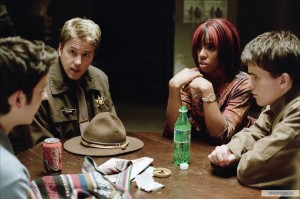
More victims caught in the middle of the killer clash.
Eventually I gave up all hope on Freddy vs. Jason. Nightmare star Robert Englund had not put on the makeup in almost 10 years and I thought Freddy would never grace the screen again. Jason, meanwhile, had gone to space with Jason X (which sat on a shelf for 2 years before its release). Finally, in the early part of the last decade, news — real news — started to come out that the movie was being made.
I honestly believe my excitement for Freddy vs. Jason was on par with my feelings about 1999’s Star Wars Episode I. A countdown clock sat on my computer desktop for 4 months, and when the day finally came I took an afternoon off work to see the first showing.
It met my every expectation.
Directed by Bride of Chucky’s Ronny Yu, the film was outrageous, gory, and over-the-top fun. Both characters got their due (even if Jason inexplicably was suddenly afraid of water) and I couldn’t have asked for more. You can hear a blow-by-blow analysis and both of my reviews at the Now Playing Podcast website, but in short I gave it a strong recommend both times.
Yet loving a movie isn’t enough to garner inclusion in this 40-Year-Old Critic series, there has to be a long-lasting impact. For Freddy vs. Jason, there were two.
First, this film gave Robert Englund a proper Freddy sendoff. It was the best film starring the dream stalker since 1988’s The Dream Master. It cemented a positive feeling for the Nightmare franchise that remains unsullied to this day. Just two weeks ago I had my photo taken with Englund, who was dressed in the full Freddy make-up. I even have ideas for a Nightmare inspired tattoo–the dream killer’s glove slicing into my skin.
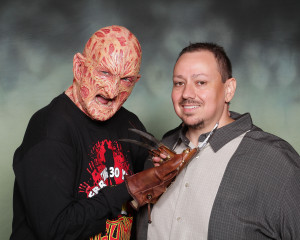
Freddy vs. Arnie — Robert Englund and Arnie pose for a photo at Flashback Weekends in Aug. 2014
Second, though, Freddy vs. Jason’s success launched more than a decade of franchise crossovers. The next year finally saw the release of Alien vs. Predator, which I anticipated every bit as much as Freddy vs. Jason — and which was an utter letdown.
Other pictures released that year include the low-rent, made-for-television crossover Puppet Master vs. Demonic Toys (co-written by Blade and The Dark Knight scribe David Goyer), as well as a return to the “Monster Mash” formula with Universal’s Van Helsing.
Yes, the track record for crossovers wasn’t stellar, but that was honestly my secondary concern — the primary concern was that they were happening. Finally, after decades of teasing, universes were being shared and the world of movies suddenly felt as open as the page of a comic book. But, after 2007’s Aliens vs. Predator: Requiem a shot of adrenaline was needed. I do think the crossover was starting to be seen as desperate, until Marvel Studios took it to the next level.
In 2008 Marvel released its first movie produced in-house: Iron Man. The film stood alone, introducing wide audiences to a superhero that was considered B-list at best. Yet Marvel took a page from New Line Cinema’s book: at the very end Nick Fury showed up to discuss “The Avengers Initiative.” This was the comic book equivalent of Freddy’s hand bursting up from the ground, and Marvel kept its momentum building toward the third-highest-grossing film of all time: The Avengers.
There is a direct lineage from Jason Goes to Hell to Iron Man, from Freddy vs. Jason to The Avengers.
So next spring when you buy your ticket for The Avengers: Age of Ultron (and then download the Now Playing Podcast review) think about the trailblazer that pioneered the modern crossover film: Freddy vs. Jason.
Tomorrow — 2004!
Arnie is a movie critic for Now Playing Podcast, a book reviewer for the Books & Nachos podcast, and co-host of the collecting podcasts Star Wars Action News and Marvelicious Toys. You can follow him on Twitter @thearniec
September 2, 2014 Posted by Arnie C | 40-Year-Old Critic, Comic Books, Conventions, Movies, Now Playing Podcast, Podcasts, Reviews | 1980s, 1990s, 2000s, 40-Year-Old Critic, Avengers, Comic Books, Comics, Crossover, Enertainment, Film, Freddy, Friday the 13th, horror, Iron Man, Jason, Movie, Movies, Nightmare on Elm Street, Now Playing, Now Playing Podcast, Podcasts, Review, Reviews, Ronnie Yu, Sean S. Cunningham, Slasher, Wes Craven | Comments Off on The 40 Year-Old-Critic: Freddy vs. Jason (2003)
The 40 Year-Old-Critic: Attack of the Clones (2002)
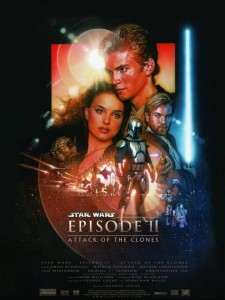 In The 40-Year-Old Critic, Venganza Media creator and host Arnie Carvalho recalls a memorable film for each year of his life. This series appears daily on the Venganza Media Gazette.
In The 40-Year-Old Critic, Venganza Media creator and host Arnie Carvalho recalls a memorable film for each year of his life. This series appears daily on the Venganza Media Gazette.
A week ago, while attending Wizard World Chicago, I had a debate with a Now Playing Podcast listener who claimed Star Wars Episode II: Attack of the Clones was the worst movie in the Star Wars saga. I strongly disagreed.
Not to say I think any of the Star Wars films are bad, per se. I have three tattoos taken from the series. I host Star Wars Action News, a biweekly podcast about Star Wars collecting. I am a devoted Star Wars fan — but I’m also a discerning Star Wars fan that can recognize that those Ewok TV movies are horrible and also distinguish differences in quality among the six films in the saga.
To me, Attack of the Clones was a much needed course correction for the Star Wars prequel trilogy.
To say Episode I: The Phantom Menace left me cold would be a literal truth, as I sat out one night in the freezing rain to get tickets. But it’s also metaphorically true. Perhaps it was how I binged on that first prequel film, seeing it seven times in three days. More, though, I think it was the movie itself. While it boasted the most exciting lightsaber fight in the series, the overall story was somewhat incomprehensible — I had to read various “expanded universe” novels to understand what the Trade Federation was trying to do, and I still think it was stretching. More, the film was completely devoid of humor. The first three Star Wars films had all been fun, with the cocky attitude of Han Solo (Harrison Ford) a centerpiece. Here that sardonic fun was replaced with a walking CGI fish creature stepping in crap.
After The Phantom Menace I slowly found myself drifting away from Star Wars — a major lifestyle change. I had been reading Star Wars novels since 1993, played the video games constantly on my PC, and collected the toys obsessively since 1995. That all peaked with Phantom Menace’s release, when the Toys ‘R’ Us employees informed me that I’d spent the most money of anyone during their midnight toy release, and when I traveled 60 miles every Thursday to get the latest Kentucky Fried Chicken basket topper.
But in the summer of 1999 the glut of Episode I toys clogged shelves. With no new figures found, just the same ones that had been available for months, the thrill of collecting waned and I stopped bothering to look for the next wave of toys. More, I was let down by The Phantom Menace and didn’t wish to dwell on it. I pursued other interests, and stopped buying Star Wars books, toys, and games altogether. It was not a conscious break; when Phantom Menace was re-released in theaters in November of that same year — this time with proceeds going to charity — I saw it again. But that viewing solidified my feeling that my childhood was dead, it was time to move past Star Wars.
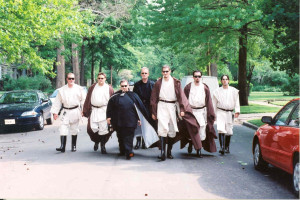
Reservoir Jedi
That stance lasted for a couple years. I even tried to sell my Star Wars collection, only to find that I wasn’t alone. A toy store in Chicago offered me 5 cents for brand new, mint figures — 1 percent of the retail price. He told me no one wanted Star Wars toys, new or old, and that he had a warehouse full of them that he couldn’t sell.
Also during that time my life changed a lot. I met Marjorie, we dated, and eventually moved in together. I also quit my low-paying job and returned to school full-time. We were living off her income and what savings I had put together. Times were tough, bills went unpaid, and there was no extra income to spend on toys. What movies we saw were mostly from the $1 rental bin, not full price theatrical fare.
Despite all this, when the first teaser trailer for Attack of the Clones was released I started to get excited. The trailer was attached to Harry Potter, and so Marjorie and I bought tickets just to see it in the theater. When it played… I was not thrilled. It looked like more of the same that we got in 1999 with Phantom Menace. We were so disappointed we actually left the theater without staying for Potter.
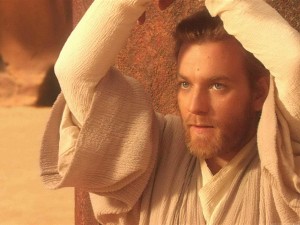
McGregor showed us Star Wars could be fun again.
For me, Star Wars was in a nosedive. But it did pull out, and I remember the moment perfectly. A secret trailer for Attack of the Clones named “Mystery” was released online. A friend came over and he, Marjorie, and I all gathered around my laptop to watch. Another tease, this one focused on an assassin out to get Padme Amidala (Natalie Portman). It showed action, it showed suspense, but best of all it showed humor! It seemed Lucas had realized how dull every character in Phantom Menace had been, and now the sarcastic wit was back courtesy of Obi-Wan Kenobi (Ewan McGregor).
I watched that trailer repeatedly. By the time the third trailer came, my break from Star Wars was over.
But there’s more than that — this film changed my entire life forever.
As mentioned, Marjorie and I were engaged. We knew we were going to get married, but I was hesitating because I was an unemployed graduate student. I had no money, and neither of our parents’ would pay for a wedding. As such, the engagement had no end date, and I hadn’t even scraped the money together for a proper ring. Instead I gave her a placeholder ring that took the last of my cash: $25.
Our excitement for Attack of the Clones grew together; she was as excited for the film as I (and she was nowhere near as hard on Phantom Menace). As such, Marjorie suggested, “What if we have a Star Wars wedding?”
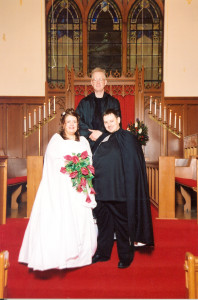
Marjorie, Arnie, and their minister pose for a photo at the wedding.
The thought had occurred to me; I’m not very traditional to begin with, and I considered all weddings to be pomp and circumstance. A tuxedo means nothing to me, nor does a wedding dress to Marjorie. All wedding garb is a costume, so why not make it a Star Wars costume? Plus there was no better time to do it than surrounding the release of a new movie, so a date was set and the Carvalho Star Wars wedding was on.
Her parents were excited. My parents were mortified. We kept certain things traditional — we were married in a church and there were no full-on costumes (I had never heard of the 501st costuming club, if I had I surely would have invited them). As I was the unemployed one I did much of the planning, and I did borrow some money — since repaid — from my godparents to get Marjorie a proper diamond engagement ring; smaller than she deserved but what I could give.
But she had another crazy idea.
The Star Wars Celebration II convention was the weekend before our wedding. As planning had left us stressed, we decided to max out our last credit card and go. I was hesitant; I had gone to a couple conventions in the past but didn’t see the appeal. That said, I had gone only for a couple hours, never an entire weekend. This was a totally new experience, and when we arrived we were immersed in Star Wars. Men in realistic-looking Stormtrooper armor worked security, triggering a latent fear of the men in white. On top of that, celebrities were everywhere; we even had Carrie Fisher (Princess Leia), Billy Dee Williams (Lando Calrissian) and other stars sign our wedding invitation!
Plus, there was new Attack of the Clones footage screened exclusively for convention attendees. We got to see a trailer that parodied Sam Raimi’s Spider-Man, ending with Yoda, lightsaber lit, jumping around like a crazy frog.
I had been excited for Episode II, but now I was practically vibrating with anticipation. I wanted to see Yoda kick ass!
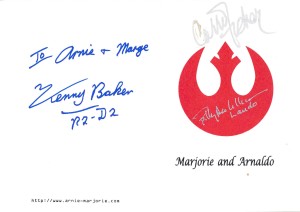
Marjorie and Arnie’s wedding invitation, signed by Star Wars celebrities.
Star Wars Celebration II was a magical weekend bested only by the next one, when Marjorie and I were married. Because of the Star Wars connection local media showed up, and once it hit the AP wire we were known around the country. Our honeymoon in New Orleans felt like a press tour as we woke up every morning at 5 a.m. to talk about our wedding on radio shows, and we were even taken to the local NBC affiliate to appear on MSNBC.
On that honeymoon we went to a midnight screening of Attack of the Clones, which turned out to be one of the worst theatrical experiences in my life. As it was told to me, the theater was showing the film on 16 screens, but had only 4 prints. They were trying to daisy chain the prints from projector to projector, and it didn’t work; the film simply ripped. They had to show the prints to 4 theaters, and the other 12 waited. Finally at 2:30 a.m. the movie started.
I was nervous, what if it was terrible? We were booked to go on MSNBC the next morning, and Marjorie and I had already rehearsed saying, “Loved it!” in unison — lest we look like fools, going on national television about a wedding to tie into a sucky film. The trailers looked good, but after The Phantom Menace I knew there was a risk.
I needn’t have worried. That next morning, when asked by Natalie Morales what we thought of the film, we were honest in expressing excitement. It truly was a return to the Star Wars I’d loved as a child.

The sheer enormity of the clone army excited me.
I’ve seen the movie dozens of times since 2002. Removed from the excitement of the release and the sentiment of our wedding I can clearly see it’s not a perfect film. If ranking the 6 live-action theatrical releases it would be second to last, Phantom Menace at the bottom. I felt the inclusion of Boba Fett as a child was unnecessary to the plot and some of the mysteries never made sense (though at the time I trusted, falsely, that Episode III would answer these questions). Still, the acting was far improved — Portman decided to use her skill this time, and McGregor was a joy throughout. The CGI effects were also better, with the huge battle at the end truly impressing and enthralling me. The lightsaber fight was exciting, and Yoda lived up to my expectations. It has flaws, but was certainly a step in the right direction.
Best of all, it ended with a wedding. Marjorie and I had both gone in spoiler-free and had no idea that we would be married only four days before Anakin Skywalker (Hayden Christensen) and Padme would also tie the knot. To have a Star Wars wedding tying into a new Star Wars film release was one thing, but to be that close to one that also involved a wedding seemed like kismet.

The wedding in Star Wars seemed perfectly timed for our Star Wars wedding.
Though I couldn’t buy Marjorie the ring she deserved, and though the wedding had to be done on a very tight budget, marrying her was the best decision in my life. We have not only shared a life, but we share Star Wars, both through our wedding and now through our podcasts. It would have happened anyway but, to quote Billy Crystal in When Harry Met Sally, “When you realize you want to spend the rest of your life with somebody, you want the rest of your life to start as soon as possible.” Thanks to this movie, it started earlier and has given me more great days than I’d have had otherwise.
More, Attack of the Clones brought me back into the Star Wars fold. I saw it multiple times in theaters, including a trip to Chicago to see it on IMAX — my first IMAX viewing experience. It righted much of what The Phantom Menace wronged.
It brought me back into collecting, as well. New figures were on shelves, but I couldn’t afford them. I finally gave up looking for a dream job and, to pay the bills (and buy a few figures), I took another low-paying temp job. In another unexpected twist, that temp job grew quickly into the career I have today.
And, yes, for our 10th anniversary I finally gave her the ring I wish I could have given her in 2002.
My wife, my work, and my continued love of Star Wars can all be traced back to Attack of the Clones. For that I can forgive its few cinematic flaws and appreciate it for the fun space fantasy that it is.
Tomorrow — 2003!
Arnie is a movie critic for Now Playing Podcast, a book reviewer for the Books & Nachos podcast, and co-host of the collecting podcasts Star Wars Action News and Marvelicious Toys. You can follow him on Twitter @thearniec
September 1, 2014 Posted by Arnie C | 40-Year-Old Critic, Conventions, Now Playing Podcast, Podcasts, Reviews, Star Wars, Star Wars Action News | 2000s, 40-Year-Old Critic, Action, Arnie, Attack of the Clones, Clones, Enertainment, Film, George Lucas, Hasbro, Marjorie, Marriage, Movie, Movies, Natalie Portman, Now Playing, Now Playing Podcast, Podcasts, Prequels, Review, Reviews, sci-fi, Space Fantasy, Space Opera, Star Wars, Star Wars Action News, Toys, Yoda | Comments Off on The 40 Year-Old-Critic: Attack of the Clones (2002)
The 40 Year-Old-Critic: Donnie Darko (2001)
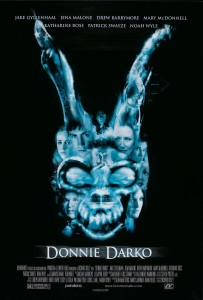 In The 40-Year-Old Critic, Venganza Media creator and host Arnie Carvalho recalls a memorable film for each year of his life. This series appears daily on the Venganza Media Gazette.
In The 40-Year-Old Critic, Venganza Media creator and host Arnie Carvalho recalls a memorable film for each year of his life. This series appears daily on the Venganza Media Gazette.
“You have to watch this movie!” Marjorie exclaimed.
I had just returned home from a very late night at work. I was exhausted and had no idea what she was talking about.
“Donnie Darko. You have to see it,” she told me. “It was on TV tonight. It’s great, but I have no idea what the hell it’s about.”
That, in 2003, was my introduction to Richard Kelly’s directorial debut, Donnie Darko.
I had heard about Donnie, but only in passing. I never knew of its release in 2001; a movie that featured a plane engine crashing into a house was a tough sell just a few weeks after the September 11 attacks on New York City.
The film did catch my eye the following year after it was released on DVD. The title repeatedly popped up at Bloody-Disgusting.com, one of my favorite horror movie websites. Wedged between news articles about Jason X and Bubba Ho-Tep, films for which I had built-in interest, it took several mentions of Darko for me to click the links and read the articles. When I finally did I was confused and slightly put off by the descriptions of a man in a giant bunny suit — I envisioned very low budget, low rent horror from a film with a ghostly bunny.
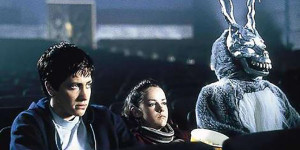
Three’s a crowd when Frank the Bunny comes on your date.
Marjorie’s enthusiasm that night and the online buzz I continued to read convinced me to rent the DVD immediately. I expected straight-up horror, perhaps with a guy in a rabbit suit killing random people.
That was not what I got. Not by a long shot.
First, I wasn’t sure why a website devoted to slasher and horror features spent so much time covering Donnie Darko, which I view as a dramatic sci-fi film. The story invokes concepts of time travel, parallel universes, and psychic phenomena; all delivered in an oblique, theoretical fashion.
When credits rolled I shared my wife’s enthusiastic reaction, but I understood it no better than she did. We talked for hours that night, debating the possible meanings of what we just saw.
What I knew, I knew for a solid fact, was that Donnie Darko was a period-piece teen film. Set in 1988 the story revolves around troubled teen Donnie Darko (Jake Gyllenhaal). On the surface his life looked perfect; he lived in a big house in Virginia, his parents were still together, his older sister was about to enroll in Harvard, and his younger sister was part of the successful dance troupe Sparkle Motion. Yet Donnie is a misfit, full of angst and despair, fighting with all of his family members. He also has weekly therapy sessions where he discusses his sexual fantasies and his fear of being alone.
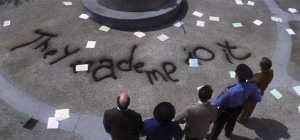
…but who are “they”?
Donnie is smart, his test scores are described as “intimidating”, but at school he has only a small group of friends that discuss nothing more important than the sexual preferences of Smurfs. Early in the film Donnie starts dating the new girl in school, Gretchen Ross (Jena Malone), his first real connection with anyone.
There are some teachers with whom Donnie gets along very well, including science teacher Dr. Monnitoff (Noah Wyle) and English Literature teacher Miss Pomeroy (Drew Barrymore, who also served as executive producer). Both are younger and freer to have open dialogue with their students.
Then there is older health teacher Mrs. Farmer (Beth Grant), an activist who rails against Pomeroy’s teaching of Graham Greene’s short story “The Destructors.” Farmer pushes the school to teach morality based upon the works of motivational speaker Jim Cunningham (Patrick Swayze), who believes everything in life is a choice between love and fear.
Donnie rails against this reductive philosophy, increasing his parents’ view of him as a troubled child.
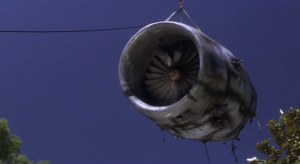
Deus ex machina…a literal God machine.
Taken just as the above, this movie feels like a throwback to classic John Hughes teen fare like The Breakfast Club or Pretty In Pink. It’s the standard tale of a high school student on the precipice of adulthood struggling for free thought in an environment that doesn’t foster such expression. The period-piece setting augments this feeling; the Bush/Dukakis election is referenced, Donnie’s mother reads Stephen King’s It, and the soundtrack features music by Tears for Fears and Duran Duran. There is a large aspect of Donnie Darko that plays just like one of those teen films, and could be taken as such.
But then there’s the jet engine, and Frank the Bunny.
Donnie is a sleepwalker; in the first scene in the film we find him waking up on a hill and riding his bike home. He appears to have been crying.
The next night he is called from his bed by a strange voice. Following it, he finds a man in a strange, dirty rabbit costume, wearing a twisted, frightening, metal bunny mask. This man is Frank, and he tells Donnie that the world will end in 28 days, six hours, 42 minutes, and 12 seconds. We’re not sure if Frank is real or a vision, but it saved Donnie’s life, as that was the night a jet engine crashed into the boy’s bedroom. Had Donnie been there he’d have been killed.
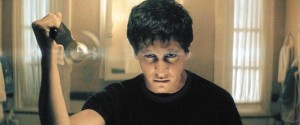
He has a knife in the bathroom. Is Donnie going Psycho?
Every time the film starts to settle into a predictable teen movie routine, something strange happens; Frank appears and gives Donnie destructive orders such as to flood the school or to burn down Cunningham’s house.
Donnie follows the orders, but the audience is left wondering what’s truly happening. Is Donnie a bad kid? Is he having a psychotic break? Is Frank a manifestation of Donnie’s insanity? If the latter is true, then what is with all the talk of time travel and parallel dimensions?
More, each of these bad acts lead to good ends. Flooding the school causes class to be cancelled, and in that free time Donnie first asks out Gretchen. Then, in the ashes of Cunningham’s home, a dungeon full of child pornography is discovered. It’s implied that Swayze’s character may be the head of a kiddie porn distribution ring, and Donnie’s arson helped put an end to it.
Slowly, Donnie becomes convinced that Frank is from the future and that Donnie himself can see future events. He discusses this with Dr. Monnitoff and is given a book, The Philosophy of Time Travel, which precisely details the strange things occurring in Donnie’s life.
Is this the case? Is Donnie insane? Is this all a dream in the character’s head? Is Donnie a stand-in for Jesus?
Simply put, the movie was a mind-fuck. When credits rolled I had no idea what I’d seen, but I knew I enjoyed it.
On Now Playing Podcast I’m often referred to as the critic who places the most importance on story, so it may be unexpected that many of my favorite movies are ones with incomprehensible plots. But I’ve also made it clear on the show that I often love to discuss films more than I love the films themselves. To me, the best movies are conversation starters — films that, as mentioned in True Romance, after watching you can go talk about over a slice of pie.
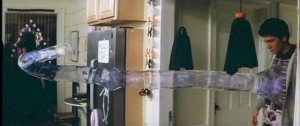
Is this telling Donnie where he will go, or determining his path? If Donnie hadn’t seen this vision would he still have walked this way?
The films need to have a hook; I don’t enjoy every overly dense, incomprehensible, artsy films. There must be some semblance of story, even if the story is not entirely clear. The film also needs relatable characters and circumstances. Having an awesome soundtrack or score, a fun vibe, helps as well.
More often than not this type of film just pisses me off and I never think of it again. But on the rare occasion, when the aforementioned elements come together, the result can be magic. Some other films that embody this include David Lynch’s Lost Highway, Oliver Stone’s Natural Born Killers, and Adrian Lyne’s Jacob’s Ladder. These are movies that stick with me long after the credits roll.
One key to make this type of film come together is the cast. Talented actors, especially familiar faces, can help me feel comfortable when undertaking a strange journey.
I only knew Gyllenhaal as the lead character in the horrible 2001 “comedy” Bubble Boy, and I wrote him off as someone who would never work again. After seeing Donnie Darko, his second lead role, I knew this was an actor with talent and range. This entire film rides on Gyllenhaal’s performance; the character is not only the focus of almost every scene, he’s also going to do illegal and destructive acts. Gyllenhaal gives Donnie a sweetness and vulnerability that makes him sympathetic and genuine. He may be dangerous, to himself or to others, but we want to see him happy.
While I barely knew Gyllenhaal, I was very familiar with his impressive supporting cast. When reading about the film’s low budget, I never expected to see actors I recognized. Yet this cast is full of them. Swayze’s inclusion really helped with the late 80’s vibe, as he was a star at that time with Red Dawn and Dirty Dancing. Mary McDonnell had two Oscar nominations in the 1990s, and soon after Donnie Darko she would rise to prominence again in the rebooted Battlestar Galactica series.
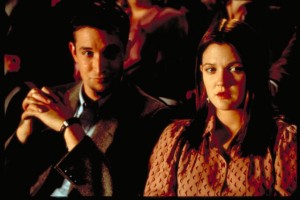
An impressive roster of known stars take bit parts in Donnie Darko.
While those supporting actors were having a lull in their careers at the time Darko was filmed, two stars were at their zenith. Noah Wyle was an actor hot on TV’s ER, and Drew Barrymore was riding high off her career resurgence in Scream.
Credit for this cast, and the film’s own creation, must be given more to Barrymore than Kelly. After Scream, Barrymore had begun a successful producing career with back-to-back hits Never Been Kissed and Charlie’s Angels. Kelly had no luck getting his film produced until Barrymore took on the project, and her involvement helped raise the $4.5 million budget and draw named talent to the project.
All of these elements combined to create an enjoyable movie viewing experience. But what was it about? I felt like I almost got it on my first viewing. Hours of reflection with Marjorie made us each realize a point, a line, which the other had missed.
We watched the film again the very next day, and I got a little more. My impression upon second viewing was that Donnie, a depressed and lonely boy, got to experience one month of happiness and reconnect with his family before he was destined to travel through time and die. I believe it was his destiny to die, but, thanks to unexpected time travel, his death is less tragic than it might have been.
I then spent the entire following day on the computer visiting the Donnie Darko website (no longer online but partially available via archive). Following the example set two years earlier by The Blair Witch Project; the Donnie Darko site was completely in-universe. I could read police reports about Donnie’s 1986 arrest for arson (briefly mentioned in the film), or the newspaper article about pedophile Cunningham’s suicide in the days after the film ends.
The site itself was as dense as the picture, with no obvious navigation. Animations played out on the screen and strange phrases appeared. As a gamer and web designer, the site sucked me in as much as the movie. It was designed perfectly from a psychological standpoint — I would click enough obscure links to get just a drip of information. Like a rat awaiting a treat I repeatedly pushed buttons. I sat at that computer all day, and I remember it well. I didn’t eat, I didn’t move, I just looked for more and more meaning.
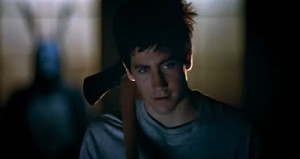
Donnie getting ready for school…
The site was filled with excerpts from the fictional book The Philosophy of Time Travel, written years ago by an old lady Donnie and his friends call “Grandma Death” (Patience Cleveland). The text talked about tangent universes, living receivers, the manipulated living, the manipulated dead, ensurance traps, and more dense terms. No, the site wasn’t here to give me clear answers, but it did aid in my interpretation.
Obsessed, I watched the movie again and this time I thought I had it. I could map the information in the site to the characters on screen. I had an explanation. I didn’t waver from my thought about Donnie experiencing happiness in his final days, but I did start to understand a little more about the mechanics of time travel in this movie, and how Frank the Bunny came to be.
Some may be right to say that films shouldn’t require hours of research to understand. To that I say it wasn’t required, it was desired. The film hooked me enough that I wanted to know more; I had my theories but for me it’s often more interesting to know the director’s vision and intent. Sometimes the intent is ambiguity, but other times they have many ideas but one “truth.”
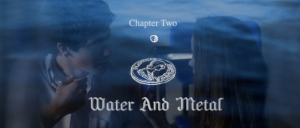
This is not a DVD menu or bonus feature. In the Donnie Darko director’s cut text is put on the screen to try and explain the film to the audience.
Finally, in 2004 I had the chance I missed in 2001 — to see Donnie Darko in theaters. Marjorie and I both drove to Chicago to see the limited release, joined by my Now Playing co-host Stuart, who had not yet seen the film.
The movie had been heavily edited between its Sundance premiere and its wide release. The director’s cut restored 20 minutes of footage, but made even more changes. In what I’m guessing was an attempt to be more accessible for mainstream audiences, Kelly added text to the screen — text taken straight from the Donnie Darko website.
There were other changes, including dialogue and music, but I felt adding the text was going a bit too far. In an effort to be less dense the director had created a weird movie experience that was akin to looking at an appendix while watching. I was happy with some of the scenes put back in the film, ecstatic to see it on the big screen, but in the end I prefer the original cut without the text. I liked the mental challenge of trying to piece this movie together on my own (Similarly, Lost Highway lost some of its appeal when the director went on record stating that film’s “truth”).
Having said that, I’m not certain that even with the text Donnie Darko is so clear-cut. For this review I re-watched the film for the first time in several years. I am a different person in 2014 than I was in 2012; as this review series indicates, I’m becoming more reflective about issues of life and mortality. In this viewing I saw a totally new interpretation of Donnie Darko, one that does involve time travel but also fate, destiny, and the will of God. When I took this as solely a sci-fi drama I missed the spiritual themes that permeate the movie.
In my original thesis, I believed that Donnie needed to connect and feel happiness before his death. But now I see the subtext about “God’s channel” — that Donnie had free will, he didn’t have to die, but to do so was to deny God. Donnie was having an existential crisis; his loneliness came in part because he didn’t want to die and he found no way to believe in anything more than this world. Through the experiences of this movie Donnie not only realizes his role is to die, but he knows it’s his choice to die. He could deny his fate, but in doing so he would deny God’s will. If God has will then there must be a God, and so, reassured and finally finding proof in divinity, Donnie laughs as he takes that next step into the afterlife.
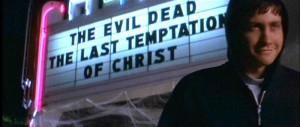
The viewer gets to pick which movie they see through various interpretations of Donnie Darko.
Yet, the more I ruminate on this movie, I would not say my interpretation is the only one. While I think it is what Kelly was going for, so many other interpretations are possible. I would be hard pressed to argue against a reading that Donnie is schizophrenic and having a psychotic episode, as his psychiatrist suggests. I read a theory online that Frank is like The Ghost of Christmas Future and no time travel actually happens, Frank just shows Donnie a vision of what could be. You could say this film is just a take on the theme of the Final Destination films — Donnie was supposed to die and, since he didn’t, Death surrounds him.
The alternate theory, though, that I think Kelly teases most is that there is no such thing as time travel, and this entire move is Donnie’s dream in the moments before his death, in the spirit of An Occurrence at Owl Creek Bridge. This is very clearly given as an option when Donnie and Gretchen go to a two-screen movie house. Do they choose The Evil Dead or The Last Temptation of Christ (which depicts such a dream-in-the-moment-before-death scenario)?
The film’s very final scenes, though, seem to indicate that others in town have a lingering memory, like an almost-forgotten dream in the night, of what Donnie experienced. That realization, that something happened to people other than Donnie, always returns me to my original theory: Donnie had to die, but he got to die after experiencing joy.
Even with this seemingly uplifting message, the movie is horribly sad. I well up every time during the film’s denouement. It’s set to a slow, somber cover of Tears for Fears’ “Mad World” sung by Gary Jules. I had never given that song’s bubble-gum pop lyrics much thought, but this version, mournful and soft, gave the words meaning I’d never considered. It’s the rare cover that makes all earlier versions of the song obsolete (though never, ever listen to the second version on the soundtrack where they added drums and other instrumentation. It is virtually ruinous to the perfect, minimalist recording).
A sequel to this film was released, S. Darko, telling an equally strange and surreal story about Donnie’s younger sister Samantha (Daveigh Chase). That film may contain more answers, but I refuse to see it. It was a studio made product with original creator Kelly having absolutely no involvement, insight, or approval. The director even took to social media to clarify that this was done without him. As such, I will never, ever watch this sequel, for my fear is that S. Darko won’t merely be terrible but, like the previously mentioned remix of “Mad World,” it will permeate my thoughts when I return to the original and ruin my enjoyment.
Donnie Darko changes every time I see it, or perhaps I change every time it sees me. It’s a film that has long moments of Donnie looking into a mirror, and perhaps that’s what I’m doing. In a film this impenetrable it’s easy to project your own thoughts and desires. What I do know is this is an absolute masterpiece of a film that everyone should watch.
When you do, share with me your theories. I’d love to hear them.
Tomorrow — 2002!
Arnie is a movie critic for Now Playing Podcast, a book reviewer for the Books & Nachos podcast, and co-host of the collecting podcasts Star Wars Action News and Marvelicious Toys. You can follow him on Twitter @thearniec
August 31, 2014 Posted by Arnie C | 40-Year-Old Critic, Movies, Now Playing Podcast, Podcasts, Reviews | 1980s, 2000s, 40-Year-Old Critic, Donnie Darko, Enertainment, Film, Mad World, Movie, Movies, Now Playing, Now Playing Podcast, Podcasts, Review, Reviews | 2 Comments
The 40 Year-Old-Critic: Requiem for a Dream (2000)
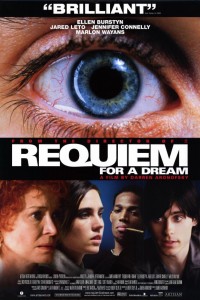 In The 40-Year-Old Critic, Venganza Media creator and host Arnie Carvalho recalls a memorable film for each year of his life. This series appears daily on the Venganza Media Gazette.
In The 40-Year-Old Critic, Venganza Media creator and host Arnie Carvalho recalls a memorable film for each year of his life. This series appears daily on the Venganza Media Gazette.
Have you ever seen a film that you instantly loved, but never wanted to see again? That was my reaction to seeing Requiem for a Dream in 2000.
I was drawn in by director Darren Aronofsky. I had seen his first film, the black-and-white techno thriller Pi, and was enthralled. The use of music, the sophisticated themes, the weird camera angles, the ideas of patterns in everything in life, the repeated sequences that formed a pattern in a movie itself about patterns; all of it left me entranced. I instantly knew Aronofsky was a talent to watch.
I anxiously awaited Requiem’s release, my excitement growing as I read high praise coming out of its screening at the Cannes Film Festival. Being a small film ($4.5M budget) with a very non-commercial NC-17 rating, I knew Requiem would not get a wide release. Sure enough, the picture opened on just 93 screens.
Like a character in an Aronofsky film, I was obsessed with seeing this movie. As such I made plans to visit my Now Playing Podcast co-host Stuart in Chicago, and there we would go see Requiem together.
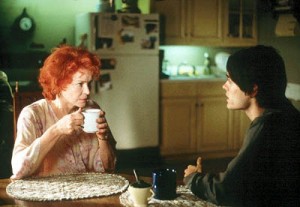
Burstyn and Leto share a rare scene together in Requiem for a Dream.
Based on the novel of the same name by Hubert Selby, Jr., the film follows nine months in the lives of Harry Goldfarb (Jared Leto) and his mother Sara (Ellen Burstyn). Despite the familial relation, the two characters rarely interact; their stories run parallel as we follow their hopes and falls. Starting in “Summer” and ending in “Winter”, the falling temperatures also represent the decline in the characters’ fortunes.
Harry is a heroin addict. He and his friend Tyrone (Marlon Wayans) have hit bottom so many times that stealing Sara’s television to pawn for drug money has become routine. After one theft, followed by a good high at the beginning of the film, Tyrone starts to show ambition –rather than just shooting up, the friends decide to resell some of their drugs to double their money. They have career aspirations of someday dealing a full pound of pure heroin that would set them up for a long time and allow Tyrone to move out of his bad neighborhood.
They start their plan — taking regular pauses to shoot up — and things start to go well. Harry even earns enough money to try to make amends with his mother, and buys her a new, modern television.
In addition to Harry’s burgeoning career as a drug dealer, he is madly in love with girlfriend and fellow junkie, Marion (Jennifer Connelly). The two dream of using their drug money to open a clothing store, allowing Marion to escape her controlling parents. With his money and his girl, things look great for Harry.
Sara, meanwhile, is also finding success. When the film begins she is an elderly widow living alone in an apartment, with little to do but watch self-help television shows. One day her fortune changes with a single phone call: she has been selected to be on her favorite game show. Sara is beyond excited, but also nervous about appearing on national television. A neighbor helps her dye her hair, with unfortunate results. She’s even more distressed after finding out the red dress she wants to wear on the show — one her late husband loved — no longer fits.

Sara starts popping the pills faster and faster to fit in that red dress.
After attempts at crash dieting prove unsuccessful, Sara visits a doctor and begins taking a heavy dose of diet pills. The amphetamines have severe side effects — Sara starts to grind her teeth and can’t sit still — but she loses 25 pounds and feels great. Her looming television appearance has made her the superstar among the retirees in her apartment building and she’s soaking it up.
When Harry brings his mother the new television he instantly knows Sara is tweaking on uppers. He tries to get her to stop, but she is too excited for the game show; even though her obsessive checking the mail for information about her appearance has yielded no results.
If you haven’t seen Requiem for a Dream, if you’ve only read the description above, you might think this is an ugly movie about despicable people. A heroin addict who steals from his own mother? A lonely old woman obsessed with television? A junkie aspiring to become a dealer? In so many movies these characters would be the villains, or at least the antagonists. But Aronofsky is a deft storyteller, and slowly he makes us care for each person on the screen.
Every character is given a touching moment. For Harry and Marion, it’s them lying in bed expressing their affection for each other. They don’t just say “I love you” — rather Harry uses the trite expression, “You’re the most beautiful girl I’ve ever seen.” She responds, telling him she’s heard that a lot, but adds that when Harry tells her it truly has meaning.
More than words, we see that scene through the points of view of both characters via split-screen, allowing for close-ups of Leto and Connelly. This unique approach drives home multiple points: a) they’re together, yet not, b) it’s the first sign that something will come between them, and c) the close-up shots convey intimacy, not isolation.
Then the shots get more inventive. We see Harry talk on one side of the screen, and on the other we see his hand caressing Marion, his thumb brushing over her lips, her palm. Then we see her close-up, and her hands on him. It’s not a sex scene, but this communion between two characters shows their relationship in a much more intimate setting. After only two minutes you want these kids to make it, yet their addiction hangs like a storm cloud.
The same goes for Harry and his mother. While he starts by stealing her television, causing Sara to lock herself in a closet away from her son, he still tries to assure her that everything will be okay. Later in “Summer” we see Harry and Marion on the beach, the man verbalizing how much he loves and cares for his mother and how, now that he has money, he wants to make right every wrong he’s done. It’s a deft turn, but thanks to Leto’s performance and earnest language, Aronofsky has made this thieving drug abuser actually seem noble and good.
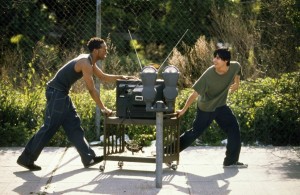
Harry and Tyrone take in some TV.
Tyrone is given the least background of the four, an odd choice considering he is the lead drug dealer. His girlfriend is never named, and his backstory is limited to a bit about honoring his dead mother. Still, Wayans gives a career-best performance in a rare, non-comedic role for the Scary Movie actor. Much of this is due to Aronofsky’s editing — one needs only to watch the deleted scenes on the DVD to realize Wayans tried multiple approaches to Tyrone, including a full-on Jar Jar Binks impersonation.
As shown on screen, Tyrone is the least developed character, yet still a likable personality thanks to the heart Wayans puts into the role.
It’s actually astounding that Requiem makes drug dealing seem like a bright, hopeful career path.
As for Sara, this character may not be one you hate, but one you pity. A virtual shut-in with a television obsession, it is again the script and the actress that makes Sara sympathetic instead of just pathetic. When Harry comes to tell his mother about the new television he asks why she cares so much about the game show appearance.
She responds at first by pointing out to Harry the reverential treatment she has been getting from the other biddies in her building:
“I’m somebody now, Harry. Everybody likes me. Soon, millions of people will see me and they’ll all like me. I’ll tell them about you, and your father, how good he was to us. Remember?”
Then after a pause, an even sadder truth comes out — this television show is all she has to live for.
“It’s a reason to get up in the morning. It’s a reason to lose weight, to fit in the red dress. It’s a reason to smile. It makes tomorrow all right. What have I got, Harry? Why should I even make the bed or wash the dishes? I do them, but why should I? I’m alone. Your father’s gone. You’re gone. I’ve got no one to care for. What have I got, Harry? I’m lonely. I’m old.”
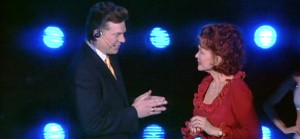
Sara hallucinates a visit to her favorite TV show, hosted by Tappy Tibbons (Christopher McDonald in a memorable minor role).
The obvious answer is right there: Harry could pay more attention to his mother. What she really needs isn’t another television, it’s human connection. But while Harry is desperately trying to be a good son he’s exacerbating his mother’s issue by allowing her to submerge deeper into television, versus helping her to escape it. Despite seeing his mother’s obvious bad reaction to the uppers, this is the last time Harry sees her.
Even with the obvious, unspoken truth of the scene, the monologue could have fallen flat if not for Burstyn’s amazing performance. She jitters while she plays the scene, expressing her agitation from the pills, with a nervousness at being so honest with anyone. She says the lines with a smile, but the sadness comes through in the delivery. Burstyn deserves every accolade she was given for this performance.
Finally, the mood is lightened with humor. When Harry and Tyrone steal the television it’s a joy watching them wheel it past all of Sara’s neighbors, who are more concerned with soaking up the afternoon sun than they are the obvious and strange theft. The characters laugh, joke, and keep the film from becoming too morose.
The combination of the amazing director, actors, and screenplay prevent this story from feeling trite or ugly. When “Summer” ends I was rooting for all four characters to achieve their dreams.
But if that was the summer, soon must come the fall, literally and metaphorically.
For Sara, this comes from her body building up a resistance to the amphetamines. She no longer gets her high from the pills, and though her red dress nearly fits, she needs to continue losing weight. When the doctor won’t up the dosage she self-medicates, taking multiple pills at once.
For Harry, Marion, and Tyrone, their downfall begins when a drug war breaks out in the city. Supplies of heroin have dried up — they can’t get any more to sell, and they can’t get any more to take. Their relationships are stressed, especially by Marion, who seems to suffer the worst withdrawal and blames Harry for her inability to shoot up.
By the time the film gets to “Winter” the movie is no longer a dark comedy. Each character becomes more desperate, and their ends are each so awful that Requiem for a Dream practically becomes a horror film. Yet none of it would work had we not cared for the characters — we would have applauded horrible people getting their just desserts. That I love these people and don’t want to see their ruination is the result of successful, manipulative storytelling of the best possible sort. Aronofsky made me like them, then pulled the rug out from under them — he did the same to us in the audience.

When I left the theater I was shaken and sad. The ending was depressing, but it was just; and I realized that. I felt as mournful as I would for a friend who’d gone down a bad road. This movie was hard — hard to watch, hard on its characters, and hard on the audience. I left the theater knowing I loved every frame of this film but also thinking it was such an emotional trial that I never wanted to watch it again.
I did though, many times. Beyond just great storytelling, Requiem for a Dream is a visual masterpiece that I — after some time passed — wanted to revisit to fully take in.
Aronofsky’s second feature brought back so many of the things I’d enjoyed in Pi, especially the inventive, experimental camerawork. Now, more than a decade later in a time when GoPro cameras are strapped to everyone’s heads, you see the genius in Aronofsky’s self-proclamed “Schnoz cam” — strapping the camera to an actor so the person always stays in the center of the frame while the background and scenery move around them. First used in Pi and then in Requiem, this gave the feeling of a character surrounded by a world out of control — a sign of madness, or a visual representation of vertigo. When sped up film footage is added to the effect, you see that Aronofsky created an entirely new way to deliver the same emotion as the old Hitchcockian “push and pull” change of depth.
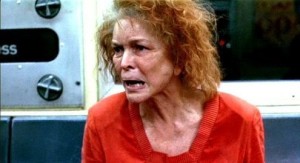
Sara finally fit in her red dress, but at what cost?
One of the things that impressed me about Pi was its unique visual style. Despite being very low budget, the use of superimposed images, quick cutting, and repetition was hypnotic. That is also on full display in Requiem. Every time the characters get high, be it by snorting, shooting up, or popping pills, a ritual is performed. The film cuts to a montage that lasts only seconds but shows the actions, and the characters. A lighter is lit, drugs boil, a syringe fills, blood courses through veins, pupils dilate. It all happens so fast that it’s virtually subliminal, yet it tells us everything we need to know. As the film becomes more desperate the montages are even faster, showing us people stuck in a cycle of self-destruction.
Aronofsky also isn’t afraid to get surreal. In the depths of psychosis Sara sees cupcakes floating in the air, her favorite self-help TV personality appears in her living room, interlaced at her television’s 480 lines of resolution. At one point her refrigerator even opens a gaping maw to eat her. These types of shots could undermine the mood but, as done here, they just enhance it.
In addition to the camerawork, enough credit simply cannot be given to composer Clint Mansell. I had the CD from Pi, his first film score, on an endless loop in my car; the electronic techno score was perfect for that film about a computer programmer, but I never would have thought the composer could hit the emotional resonance he did when he reteamed with Aronofsky for Requiem.
As this was a low-budget film, the score was performed by just four people: The Kronos Quartet. Still, with just violins, a viola, and a cello this score permeates nearly every frame of the movie. The low, sonorous tones of the cello dominate and make even the happy scenes foreboding. It’s a gorgeous composition that feels so classical it’s impossible to believe it was written in the 21st century; it feels like the work of Edvard Grieg, or one of Beethoven’s darker works.
The score has such an emotional resonance that it has been the breakout star of Requiem for a Dream; even if you’ve not seen this film I guarantee you’ve heard the score’s climactic movement, “Lux Aeterna.” Just two years later, in 2002, my jaw hit the floor when the trailer for Peter Jackson’s The Lord of the Rings: The Two Towers was scored to an orchestral version of “Lux Aeterna” — the assemblage of instruments and a faster tempo giving the song a more epic feel than the Quartet did alone (This orchestral version is available for digital purchase at Amazon).
In the years since, “Lux Aeterna” has been a go-to track for movie trailers, including Zathura, I Am Legend, Sunshine, The Da Vinci Code and, unlikely as it may seem, it was even used in Barbie doll ads!
Combined, every element of this film comes together as smoothly as one of Harry’s heroin montages. More, the performances, cinematography, and soundtrack all underscore the film’s thesis — summed up in the title — about the lengths to which people go to try and achieve their dreams. No matter what your dream, be it to be a TV star, a clothing shop owner, a screenwriter, or a podcaster, it’s a plight to which everyone can relate.
Aronofsky finally achieved mainstream success and acclaim with 2008’s The Wrestler, and then went on to even greater success with 2010’s Black Swan. I consider that unfortunate. While I like both of those films, the director has never achieved a more perfect theatrical representation of obsession than he did with Requiem for a Dream. And though I’ve yet to see this year’s Noah, my feeling is Requiem is Aronofsky’s best film to date.
Even if I do have to steel myself every time I rewatch it.
Tomorrow — 2001!
Arnie is a movie critic for Now Playing Podcast, a book reviewer for the Books & Nachos podcast, and co-host of the collecting podcasts Star Wars Action News and Marvelicious Toys. You can follow him on Twitter @thearniec
August 30, 2014 Posted by Arnie C | 40-Year-Old Critic, Movies, Music, Now Playing Podcast, Podcasts, Reviews | 2000s, 40-Year-Old Critic, addiction, Barbie, Darren Aronofsky, dealing, Drama, drugs, Ellen Burstyn, Enertainment, Film, Heroin, horror, Jared Leto, Jennifer Connelly, Lord of the Rings, Lux Aeterna, Marlon Wayans, Movie, Movies, NC-17, Now Playing, Now Playing Podcast, Podcasts, Requiem for a Dream, Review, Reviews, The Two Towers | 2 Comments
The 40 Year-Old-Critic: Armageddon (1998)
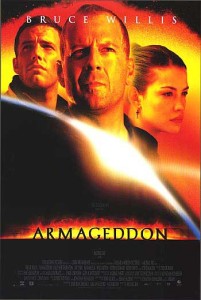 In The 40-Year-Old Critic, Venganza Media creator and host Arnie Carvalho recalls a memorable film for each year of his life. This series appears daily on the Venganza Media Gazette.
In The 40-Year-Old Critic, Venganza Media creator and host Arnie Carvalho recalls a memorable film for each year of his life. This series appears daily on the Venganza Media Gazette.
How Arnie Learned to Stop Worrying and Love the Asteroid
I’ve often referenced Armageddon on Now Playing Podcast, and, shockingly, those comparisons are usually favorable. This has led to many a raised eyebrow and gentle mocking — even from co-hosts who have never seen Michael Bay’s 1998 blockbuster (you know who you are).
So, though 1998 contained many movies that influenced me, from Bride of Chucky to Pi to Your Friends and Neighbors to Very Bad Things, I think I must take the opportunity to discuss Armageddon and explain how Bay changed my perception of action films.
If it helps you to relate to my position at all, I’ll admit that I was skeptical about the movie going in.
First, it was the second giant-rock-destroys-Earth movie of 1998 (it was a comet in Deep Impact). Believe it or not, this idea had been one that petrified me for nearly a decade.
In 1990 I read an article in the newspaper entitled “The Doomsday Rock” which described the likelihood that, eventually, a giant asteroid would collide with Earth and cause the extinction of the human race.
I had grown up with the fear of nuclear Armageddon ending our species, but by 1990 the Cold War was over and I could finally stop worrying. Now came an even bigger fear — at least nuclear war required two human beings to consciously kill everyone, but no one could control or stop a giant asteroid.
I kid you not; I didn’t sleep for days after reading that article. It became my biggest fear: death by asteroid. It’s a terror I’ve learned to live with, but every day I hope that NASA receives the funding it needs to track more of these objects in space; as even NASA’s chief Charles Bolden has said our only current hope is to “pray.”
While the concept was one that scared me, seeing two similar movies came out in the summer of 1998 seemed excessive. Deep Impact beat Armageddon to theaters by more than two months, and it was a deeply moving and touching film. By the time of Armageddon’s debut I thought we’d already seen all the giant rock movies we needed.
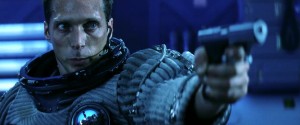
Before seeing Armageddon I could not imagine why an astronaut would need a gun. It’s one of the many improbable plot twists that I ended up going with.
Even more than that, Armageddon‘s pre-release press made the film sound absurd. While ostensibly a disaster film about a big asteroid, I read articles which mentioned scenes showcasing astronauts with handguns. In what world would a gun become instrumental when a giant rock is about to kill all life on Earth? Despite having Bruce Willis as the star, this wasn’t Die Hard; what role would guns play? The astronauts in Deep Impact didn’t need them.
Despite those reservations I still found myself in a packed theater during the film’s Fourth of July opening weekend.
I was drawn in by several factors, starting with director Michael Bay.
Bay had impressed me with Bad Boys, which I thought was the best buddy-cop film since Lethal Weapon, and it marked the first time I saw Will Smith as a movie star. Bay’s follow-up, The Rock, was loud and heavy on explosions, but had some great action scenes for Sean Connery and Nicolas Cage.
And, for the longest time, I thought Bay also directed Cage in Con Air, which was dumb fun. I was likely confused by the fact that Jerry Bruckheimer produced both films. So, despite Bay having no involvement in Con Air, it was still a factor in my seeing Armageddon.
A larger factor pulling me to the theater was the cast. I had been a devout fan of Willis since Moonlighting. I loved seeing him in film; it didn’t matter if it was Color of Night, North, Pulp Fiction, Nobody’s Fool, or even Hudson Hawk.
Next was Ben Affleck, an actor I knew from his work with Kevin Smith, plus his Oscar-winning screenplay for Good Will Hunting. This was his first big-budget epic, and as he was a friend of Smith’s I was rooting for his success.
The rest of the cast — the ragtag group of asteroid drillers — was made up of some of Hollywood’s best 90s character actors, including Billy Bob Thornton, Steve Buscemi, Michael Clarke Duncan, Owen Wilson, and Keith David. I was even happy to see Ken Hudson Campbell, an actor I fondly remembered from his role as the “Animal” emotion in Herman’s Head.
While many of those stars would be launched to greater fame by Armageddon, even in 1998 I thought of this as a “dream team” of performers.
It was very lucky that I did know this cast, as I quickly realized that in Armageddon they were not characters, they were “types.” Affleck was the young hotshot, Buscemi the sardonic genius, Wilson the funny one, Duncan was the big guy who was soft on the inside, and Willis was the tough-as-nails, no-nonsense leader of the pack.
The baggage I brought with me from previous films helped me tremendously, as Armageddon wasn’t going to spend a lot of time developing new relationships or exploring character emotions. This movie was going to put the pedal to the metal and go, go, go.
It opens with a meteor shower demolishing New York City, and from that moment NASA is racing the clock to save humanity. The pace is so fast, Bay never stops the film to let the audience catch its collective breath.
Initially I was put-off by this; here was a movie exploring my deepest fear, yet the characters on screen never worried. They’re laughing, drinking, going to strip clubs and spending money like there’s no tomorrow — because there might not be. What a tonal shift from the dour Deep Impact. Even when we weren’t dealing with the asteroid directly, there were few scenes that didn’t involve a fight or a chase.
When we are introduced to Willis’ Harry Stamper he’s chasing Affleck through an oil-drilling platform, the older man shooting at the younger one. The reason for this homicidal rage? Affleck’s character, A.J., was caught sleeping with Harry’s daughter, Grace (Liv Tyler), and Harry hoped she would do better than a roughneck like her father.
It’s silly. It’s outrageous. It’s over-the-top. I wasn’t sure if I was going with it at all. My consternation only increased as the movie continued through the training montage and other silliness.
It wasn’t the concept of “only the best oil drillers in the world can save us” that put me off. That was standard fish-out-of-water storytelling. Think back to The Last Starfighter, where only a teenage video game player can win an interstellar war. Or in 48 Hours, where a cop needs a convict to catch a killer. Even in The Terminator a waitress had to fight alongside a warrior. This “you’re the only one, even though you’re unqualified” trope was one I’d grown up with, though never witnessed to this extreme.
My problem was I had no idea who these characters were. In a rare slow scene A.J. and Grace enjoy a final picnic, and some erotic animal cracker play, before his spaceflight. When asked if he thinks anyone else is doing that same thing at that time, A.J. responds, “I hope so. Otherwise, what the hell are we trying to save?”
It was a question that resonated with me — in a film full of cardboard characters, why did I care if everyone died?
It started to click, though, in another pre-spaceflight scene. Driller Chick (Will Patton) goes to see his ex and their son. The son doesn’t know his daddy, and a dropped line about a court order implies Chick hasn’t been the best father. But in this moment, at the end of the world, Chick wants to give his son a toy space shuttle. This was a character with very little screen time and no distinguishing characteristics, yet, out of the blue, suddenly he has a backstory: a son, and his own regret.
This is when I had my “eureka” moment. How many times have I seen this story of the estranged father who, just before a moment of heroism, reconnects with his child? Or vice versa? It’s a moment intended to endear us to the character and show an emotional connection, a reason for them to live, or motivation for them to sacrifice themselves.
Be it Nancy saying goodnight to her mother in A Nightmare on Elm Street, Arnold Schwarzenegger’s tender reconnection with Alyssa Milano in Commando, or even Willis’ own Die Hard where he leaves a message of regret for his wife and children, we’ve seen this time and time again. (We’d see an echo of it later in Armageddon between Harry and Grace as well).
The difference is that in those other films the moment is the climax of an emotional relationship, recognition of clarity and regret. But for Chick this is the first sign of characterization he’s given. Did we know he was a bad dad before this second? Did we care?
Through Chick’s sudden storyline I realized this wasn’t a film in the classic sense, it was a two-and-a-half hour music video. The vibe is the same — rollicking rock music (mostly classic rock by ZZ Top and Aerosmith) blared through the theater’s sound system while the characters underwent mental health evaluations and simulated spacewalks.
There were so many Aerosmith songs I wondered if the band (fronted by Liv Tyler’s father Steven) was chosen because Liv was in the movie, or if Liv was in the movie in exchange for Bay being able to raid Aerosmith’s catalog.
Even when the characters go to space and the rock music stops, the bombastic score takes over and keeps the vibe going. But more than just being driven by music, the storytelling methods in a short video and Armageddon are identical.![]()
In a five-minute song there is little time to create a unique character, so tropes and types must be utilized to tell a story.
In Michael Jackson’s “Beat It” I don’t need to know the gang members have families and loved ones, I can bring that to the story myself. In Aerosmith’s “Cryin’” video I don’t need to hear a word to understand Alicia Silverstone is a rebellious teen. I didn’t need to see the kid picked on in school to know he’s a geek in the video for The Offspring’s “Pretty Fly for a White Guy.”
Bay came from music videos, and he trusts the audience to be used to this shorthand storytelling and rapid cutting. This movie was aimed directly at those weaned on MTV. If we have already seen scads of movies that embody a trope, why recreate it?
That’s when it hit me; Bay wasn’t lazy, he was efficient! He trusts his audience to have seen movies with these characters in them before, and thus he can actually get away with just putting tropes in a scene and letting them have their action. Characters can be types instead of people, in a movie that isn’t really about the people anyway.
I already hear, in my own head, the counter of that — that movies should be about people, and that if we don’t care about the characters how can we be excited by the action. It’s an argument I’ve used myself when discussing some of Bay’s later Transformers films.
Yet, I do believe that there should be balance. If all movies were the same, a cinema would be a mighty dull place to visit. There should be room for different types of stories. While two 1998 films told the story of a calamitous collision that ends life on Earth, the way the stories were told make those films as different as night and day.
But, and I cannot stress this enough, what Bay is doing is a tightrope walk. It is a dangerous game to rely solely on hackneyed plots and character tropes. Here, he pulls it off, in large part due to an extraordinarily likable, talented cast that brings more to the screen than they were given on the page.
The director must be given credit here as well. The editing, camerawork, and special effects were all top-notch. Bay knew how to film a scene for maximum adrenaline, and the music made it feel like a party.
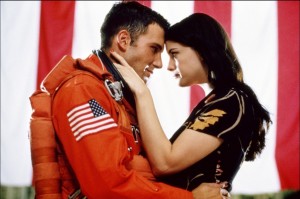
Bay’s go-to image for pride is a giant American flag. It’s not subtle, but there’s no denying it plays in the heartland.
Who knew the end of the world could be so fun?
The film does overstay its welcome, especially in the longer Criterion Collection Director’s Cut where Chick’s same story beat is repeated with Harry visiting his father in a nursing home. Yet, for all the crazy twists and turns the plot takes — and the obvious heartstring-tugging climax — Armageddon is a fun ride. I walked out of it knowing I enjoyed the movie, though I didn’t respect it very much.
As Bay has continued to make movies Armageddon has become harder to defend. With three abysmal Transformers films, plus Pearl Harbor, he’s too easy a target for us critics to hit. Transformers especially took the storytelling methods of Armageddon to their worst extreme, invoking tropes in ways that I didn’t give a damn about.
You can hear my detailed thoughts on those three awful films, plus the fourth not-too-bad one, in the Now Playing Podcast archives.
I may be mostly drawn to films that do provide insights into characters and comment on everyday life though on-screen events. But sometimes I just want escapist entertainment. Armageddon delivers that in spades.
Tomorrow — 1999!
Arnie is a movie critic for Now Playing Podcast, a book reviewer for the Books & Nachos podcast, and co-host of the collecting podcasts Star Wars Action News and Marvelicious Toys. You can follow him on Twitter @thearniec
August 28, 2014 Posted by Arnie C | 40-Year-Old Critic, Movies, Now Playing Podcast, Podcasts, Reviews | 1990s, Action, adventure, Aerosmith, Armageddon, Ben Affleck, Bruce Willis, Enertainment, Film, Michael Bay, Movie, Movies, Now Playing, Now Playing Podcast, Podcasts, Review, Reviews, sci-fi | Comments Off on The 40 Year-Old-Critic: Armageddon (1998)
40 Year-Old-Critic: Chasing Amy (1997)
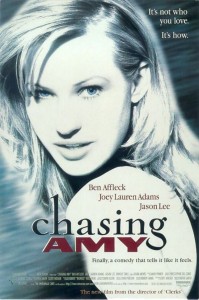 In The 40-Year-Old Critic, Venganza Media creator and host Arnie Carvalho recalls a memorable film for each year of his life. This series appears daily on the Venganza Media Gazette.
In The 40-Year-Old Critic, Venganza Media creator and host Arnie Carvalho recalls a memorable film for each year of his life. This series appears daily on the Venganza Media Gazette.
Kevin Smith is a polarizing figure in cinema. The director certainly has his legion of fans, and having attended several conventions with Smith as a featured guest, it seems those fans are mostly male, mostly under 30, and very willing to connect with his characters; lovable losers such as Clerks’ Randall and Dante (Brian O’Halloran and Jeff Anderson, respectively).
I am not in Smith’s camp, and on Now Playing Podcast I have repeatedly expressed my disdain for his body of work.
Yet allow me in this entry of The 40-Year-Old Critic to praise Smith’s best film, 1997’s Chasing Amy.
Amy (as some fans refer to it) was Smith’s third picture. The director was a Sundance phenom with his black-and-white debut (the aforementioned Clerks) in 1994. It did well in theaters and truly found its audience on video — an audience that included me. Thanks to Quentin Tarantino and Reservoir Dogs, I was paying more attention to indie films, especially those heavily promoted by Miramax. As such, I saw Clerks on VHS and enjoyed it.
As I mentioned in my review of Leaving Las Vegas, around this time in my life I was underemployed and frustrated with my lack of career options, so I related heavily to Dante in Clerks. Plus, I was enraptured by the raunchy jokes. Smith raised the bar on profanity with language that originally earned his film an NC-17 rating. As I did with Beverly Hills Cop before it, I laughed loud and hard at Clerks’ envelope-pushing comedy.
Smith parlayed that success into a studio picture, 1995’s Mallrats. The director spent $6 million of Universal Studios’ money on a movie that barely made one-third that amount. Even as a fan of Clerks I thought Mallrats was too cartoonish, too broad. With new lead duo Brodie Bruce and T.S. Quint (Jason Lee and Jeremy London, respectively), Mallrats tried to replicate the bromance of Clerks in a way that felt forced. More, it seemed Smith’s signature characters of Jay (Jason Mewes) and Silent Bob (Smith himself) would not work in color.
Mallrats would not be Smith’s last failure, but it may be his most fortuitous. First, it established his relationship with Ben Affleck, who had a minor role. Second, after Mallrats Smith returned to his “comfort zone” of small, indie filmmaking. On a $250,000 budget — extraordinarily low but still 10 times that of Clerks — Smith wrote and directed Chasing Amy.
By 1997 I was fully indoctrinated into the Cult of Kevin — as rabid a fanboy as any he’s had. I participated in his online message boards and I watched his first two films regularly (and convinced myself Mallrats wasn’t that bad… it is). Whatever Smith made next I would see. Yet the plot of Chasing Amy I found particularly interesting.

Alyssa (Adams) literally comes between Holden and Banky in this scene.
The film centers around two young independent comic book creators, Holden McNeil (Affleck) and Banky Edwards (Mallrats’ Jason Lee). The best friends find their relationship strained when Holden begins a romance with lesbian comic creator Alyssa Jones (Joey Lauren Adams; Smith’s then-girlfriend), spurring jealousy in Banky.
To me, the film seemed to be jumping on the bandwagon of “queer cinema” which had started to gain steam in the mid 90s. While mainstream Hollywood acknowledged gay characters in movies like Philadelphia and The Birdcage, it was really indie films that brought them to the fore, with such groundbreaking fare as My Own Private Idaho, The Crying Game, and Kiss Me, Guido.
Specifically, I saw in Chasing Amy echoes of Guinevere Turner’s Go Fish — a film Smith acknowledges as inspiration. Sexual preference felt like an exciting new frontier for films to tackle and, having seen all the ones I just mentioned, I likely would have seen Amy even with a complete unknown behind the camera.
I was actually a bit nervous to see Smith tackling LGBT topics. This was a straight man with a penchant for raunchy humor. In Clerks, for example, lead character Dante slut-shamed and dumped his girlfriend after finding out her sexual history. I wondered if Smith would use Alyssa’s sexuality as a source of humor, or to titillate his built-in male audience.
I was happily wrong. Chasing Amy is an exquisite balance of comedy and drama. The start of the film is right in line with Clerks’ humor, as militant black comic creator Hooper X (Dwight Ewell) dissects the racist undertones of the Star Wars trilogy. It was great fun, like a geeky twist on Tarantino’s Like a Virgin deconstruction in Reservoir Dogs. But the humor is nuanced. It’s quickly revealed that not only is Hooper’s rage an act to sell his comics, but he is also a closeted gay male and close friend of Banky and Holden.
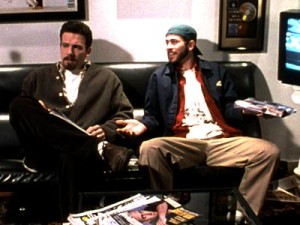
As Holden and Banky, Affleck and Lee created a genuine on-screen friendship. It was one my friends and I related to…until the final twist.
The latter two characters would be familiar to Smith, and not just because both Affleck and Lee appeared in Mallrats. In Clerks, Mallrats, and again here, Smith features the same central duo: immature twenty-something white males with potty mouths. The primary character is more serious, contemplative, semi-neurotic, and dealing with relationship issues. The sidekick is wacky, always given the movie’s funniest lines, but given short shrift in the plot. Here, Holden was our Dante/Quint, and Banky was our Randall/Brodie. The jokes were raunchy and familiar, and the laughs hit hard.
More, Smith seems to know his audience. Any homophobes in the theater get their say through Lee, who spouts gay slurs and stereotypes throughout the film. Featuring gay characters in a positive light, and having Banky spout ignorance, was a subtle way of Smith attempting to educate a more narrow-minded contingent of fans.
Chasing Amy slowly changes tone, though. While all of Smith’s films had dealt with romantic relationships, none had been a romance film. Amy becomes that as Holden befriends unobtainable Alyssa. Their friendship is tinged with longing, and not just on Holden’s side — Alyssa’s feelings for a man make her question her own sexual identity. The scene where Holden confesses his feelings, followed by a rain-soaked argument, is moving and engrossing. There is barely a laugh to be had, and shows a maturity not before seen in a Kevin Smith film.
The film takes continued twists and turns, and jokes keep coming, but Smith had sharpened his humor into a blade, using it to cut the tension of many tense, dramatic scenes. The audience, engrossed in this tumultuous relationship full of self-doubt, would find their laughter a welcome release — the film allowing us to breathe again.
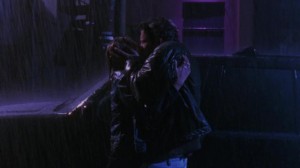
This kiss in the rain was Alyssa finally giving into her feelings for Holden. In most films that would be the end, but here it’s only the beginning of a journey full of self-doubt and jealousy.
While the romantic comedy fan in me was enjoying the Holden/Alyssa relationship, I was also empathizing greatly with Lee’s Banky. I was in my mid-20s and I had lost many friends to their girlfriends. I was all-too-familiar with the pattern of friends who hang out when they’re single, and then don’t return your calls when in a relationship. I saw Banky losing his lifelong friend to a new relationship, and, for the first time ever in a Smith film, I felt bad for the sidekick. Smith had finally created a supporting character with his own arc.
Holden and Alyssa’s relationship eventually hits the rocks when Holden finds out Alyssa was not always gay. The climax (so to speak) comes when Holden, desperate to save his friendship and his relationship, proposes a three-way to both Alyssa and Banky.
That was where the film took things too far. Until that point I felt Smith’s film had portrayed characters acting in ways that felt honest. This twist seemed to be the writer/director choosing to go with a wacky ending over a heartfelt one, or maybe he just wrote himself into a corner and couldn’t find a more earnest resolution.
The group sex idea felt totally outside the realm of Holden’s character. More, that Banky agreed, seemed to me a full character betrayal. I had completely understood Banky’s disappointment with a friend ditching him for a new relationship — it’s a real, common occurrence among single male friends. That Smith chose to write that entire emotion as based in latent homosexuality felt like a missed opportunity — an honest look at friendship was undermined by turning one character into a stereotypical gay male predator.
The film does recover from that moment, with an ambiguous ending that reminded me of The Graduate. Despite my disappointment with the final twist, the movie overall remained an on-screen romance that came across as honest and real. I left the theater entertained and believing Smith would be the next great voice of cinema.
He tried. His follow-up film, Dogma, attempted to analyze religion the way Amy deconstructed relationships, but to lesser effect. While amusing, the picture is scattered and scatological.
But it was with his next effort, Jay and Silent Bob Strike Back, that I realized Smith was not an auteur with things to say, but a writer of increasingly insipid comedy. I first saw Smith speak at a convention in 2001, followed by a preview screening of Strike Back, and I realized he was a more amusing speaker than filmmaker.
History would prove that assumption true, as Smith is now an accomplished podcaster, while the best thing I can say about his post-Strike Back films is that there aren’t many of them.
I have seen all of Smith’s directorial efforts, always hoping to see even a hint of the filmmaker that made Chasing Amy. But from Jersey Girl to Zack and Miri Make a Porno to Cop Out and even Red State, Smith has become a serviceable, but completely unexceptional, director of (mostly unfunny) comedies. I would characterize Smith’s later directing work as on par with Tom Shadyac or Steve Carr. If you don’t know those names, you can look them up, but had Smith not been an indie darling in the mid 90s I don’t think you’d know his name either.
I don’t mean that to say Smith is a one-film-wonder, still coasting on Clerks, because I have gone back and watched his directorial debut — it doesn’t hold up. Jokes that pushed the envelope in 1994 now seem almost tame. More, Clerks is less a film than it is a series of sketches loosely tied together. I loved it when I was the characters’ age and related to their Generation X angst, but it is a movie with limited appeal that is quickly outgrown.
I had hoped that after Cop Out’s critical drubbing Smith might — as he did after Mallrats’ failure — return to his roots and make more personal films. That hasn’t happened. While he has done more low-budget films, such as Red State, it appears the filmmaker who made Chasing Amy is gone forever.
It is a shame. With Chasing Amy Smith showed himself to be a talented writer who could balance both comedy and drama with equal measure. It remains a go-to film when I want to laugh, one of the most honest romances caught on screen, and a progressive view of LGBT characters in cinema. Yet it’s the only Kevin Smith film I can recommend.
Tomorrow — 1998!
Arnie is a movie critic for Now Playing Podcast, a book reviewer for the Books & Nachos podcast, and co-host of the collecting podcasts Star Wars Action News and Marvelicious Toys. You can follow him on Twitter @thearniec
August 27, 2014 Posted by Arnie C | 40-Year-Old Critic, Movies, Now Playing Podcast, Podcasts, Reviews | 1990s, 40-Year-Old Critic, Ben Affleck, Chasing Amy, Comedy, Comic Books, Comics, Drama, Enertainment, Film, GLBT, Jason Lee, Kevin Smith, Lesbian, Movie, Movies, Now Playing, Now Playing Podcast, Podcasts, Review, Reviews, Romance, Romcom | 2 Comments
The 40 Year-Old-Critic: Scream (1996)
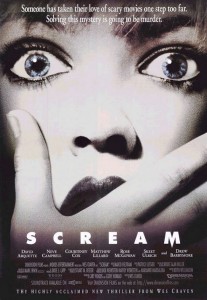 In The 40-Year-Old Critic, Venganza Media creator and host Arnie Carvalho recalls a memorable film for each year of his life. This series appears daily on the Venganza Media Gazette.
In The 40-Year-Old Critic, Venganza Media creator and host Arnie Carvalho recalls a memorable film for each year of his life. This series appears daily on the Venganza Media Gazette.
What’s your favorite scary movie?
As I mentioned in previous reviews of Love at First Bite and Hellbound: Hellraiser II, I have always been a horror fan.
As a very young child I loved the fear I felt toward forbidden cinema, and as I aged I came to see the humor, thrills, and scares in the genre. In my 20s, though, my love of horror changed. I had grown up and no longer had exciting nightmares starring Freddy Krueger. To me, there were no more mysteries in the world, and no more scares to be had on screen.
This problem was exacerbated by a lack of exciting horror in theaters. The slasher craze of the 80s had waned with Friday the 13th Part VIII: Jason Takes Manhattan and Freddy’s Dead: The Final Nightmare. By the early 90s the genre seemed to be gasping its last breaths; Jason Goes to Hell: The Final Friday was the 1993’s top-grossing horror film with only $15 million — nearly tying Manhattan’s $14 million for a series low. A year later the only notable horror release in theaters was Wes Craven’s New Nightmare. By the time The Mangler and Halloween: The Curse of Michael Myers came and (quickly) went, it seemed the bloody fun of the cinema was gone.
At the same time Hollywood was failing to launch new horror stars on screen. The first Leprechaun was released to little fanfare, and audiences simply laughed off Dr. Giggles.
I still enjoyed horror where I could find it, but that was mostly on direct-to-VHS releases. There was the occasional gem, such as Return of the Living Dead 3, or Tales from the Crypt Presents Bordello of Blood, but it was largely a parade of dreck.
I thought horror was dead.
But like any good villain, horror came back from the dead in the holiday season of 1996. The best gift I received that Christmas was an unexpected revival! Suddenly horror was cool again, and the film that made it happen was Scream.
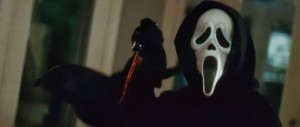
If Ghostface had narrowed the scope to “What’s your favorite scary movie from 1990 to 1995” I think his victims would still be trying to find one.
Even though I’d let my Fangoria subscription lapse, I’d kept up with horror film production in the 90s. I knew that Wes Craven, creator of the A Nightmare on Elm Street franchise, was working on a new slasher film… and I wanted nothing to do with it.
Though I idolized Craven growing up, due exclusively to the Nightmare series, the director’s later works were crap.
I was unimpressed and felt betrayed by Craven’s incoherent and bloodless 1989 slasher Shocker — though I have since come to love the film for the over-the-top “schlocker” that it is. Then in 1991 I raced opening weekend to see The People Under the Stairs, and was simply bored.
I still didn’t learn. I became ecstatic when I heard Craven’s next film would be a return to the Elm Street series, the director promising to make Freddy frightening once again. When I walked out of Wes Craven’s New Nightmare I felt I had seen my last Craven film. You can hear my full New Nightmare review in the Now Playing Podcast archives, but I truthfully wondered how I ever idolized this man who seemed able to only make terrible movies.
That line of thought was cemented with 1995’s Eddie Murphy horror comedy Vampire in Brooklyn, a film I saw out of devotion to Murphy, not Craven.
So in 1996, hearing Craven was going to make a new horror film was actually a turn-off. In ‘96 I would have rather gone to theaters to see Lawnmower Man 2: Beyond Cyberspace than Craven’s Scream.
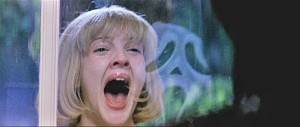
Scream turned Barrymore into an A-list star once again.
The cast did nothing to change this impression. Press materials touted Drew Barrymore’s role, and that seemed a bad sign. Back then she was still the little girl from E.T. who, like so many child stars, had developed a dependency problem. While I had seen her work in Boys on the Side and Mad Love I thought her heyday was behind her; the only roles she had in major releases were bit parts in Wayne’s World 2 and Batman Forever. She seemed “over” in Hollywood. I would never have guessed that, thanks to Scream, Barrymore was poised for a return to superstardom.
The rest of the cast — actors I’d not heard of or knew only from television shows — also failed to grab my attention. The only cast member that caught my interest was Matthew Lillard, whose zany performance I’d loved in Hackers, yet that was not near enough for me to want to see this movie in theaters.
Most of all, the film’s trailers didn’t hook me. I thought the killer’s mask was silly — had Michael Myers and Jason Voorhees taken all the good killer masks? I admit I was intrigued by the thought of characters that knew horror movie tropes; I mean, this was a horror movie where the characters were people like me. Still, with Craven’s name on the poster I wanted nothing to do with it.
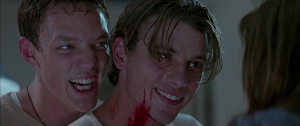
Lillard would go on to the Scooby Doo films after himself being unmasked as the bad guy in Scream.
I saw Scream in theaters only because I was invited by a group of friends and my options were to go to this movie or stay home alone. I wasn’t happy about going, and I anticipated a wholly miserable People Under the Stairs type of experience.
To say I was won over is an understatement. The film did have a good deal of true horror, with the opening murder scene a suspenseful highlight. With the scares firmly established, the movie achieved a near-perfect balance between self-referential humor and legitimate tension. While, due to my age, I was not afraid, the film did succeed in making me jump a couple of times.
In 2011 I gave my full review of Scream as part of our retrospective series leading up to Scream 4, so I will not repeat myself here. You can listen to that full review for a blow-by-blow analysis by Stuart, Marjorie and myself.
In short, not only did Scream win me over; I feel it is Craven’s best film — even better than my beloved A Nightmare on Elm Street.
I believe Craven was greatly assisted by the script from first-time screenwriter Kevin Williamson. Having seen many films made from Craven-penned scripts, none come near Scream in terms of plot twists, fleshed-out characterizations, and careful plotting. The movie was a whodunit, something I didn’t expect in a slasher. After all, in most slashers I knew the killer was Freddy or Michael or Jason or Chucky. That the killer was one of the kids was a fun experience — me trying to outwit the characters and peg the killer. When the mask is removed and the full story revealed, even I was taken aback by some of the twists. This is all Williamson, and I give him full credit for the film’s quality.
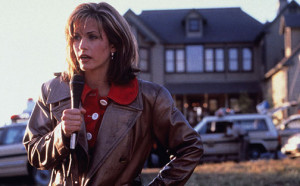
I watched Friends, but never saw Cox as a good fit for horror. Again, I was wrong.
Yet I cannot overlook Craven in the director’s chair. While the script was great, Craven brought two decades of horror experience to Scream. He knew how long to hold a moment, how to reveal a body, and how to build tension that would climax with a jump scare.
My heart was racing as I left the theater. This was the first great original horror film I’d seen in many years, yet had I known the long-lasting impact Scream would have, my exuberance would have been even greater.
The movie went on to make nearly $175 million on a $15 million budget, reminding Hollywood that a good horror movie can provide substantial returns.
Scream single-handedly revived the entire horror genre. The next year gave us not only Scream 2, but also — thanks to Williamson’s success — the enjoyable, but forgettable, I Know What You Did Last Summer.
We also got the Wes Craven-produced Wishmaster, which I saw in theaters and found a weirdly awful throwback to the days of Leprechaun.
By 1998, other studios had caught on and the post-modern, self-aware horror film had its heyday with Bride of Chucky, Halloween H20, Urban Legend and The Faculty. The quality was mixed, but all were far better films than Lawnmower Man 2 or The Curse of Michael Myers.
Scream made me appreciate Craven’s ability, but even more its success spawned dozens of films I’ve enjoyed over the past 20 years. For that reason alone, if not just for the movie itself, Scream might just be my favorite scary movie.
Tomorrow — 1997!
Arnie is a movie critic for Now Playing Podcast, a book reviewer for the Books & Nachos podcast, and co-host of the collecting podcasts Star Wars Action News and Marvelicious Toys. You can follow him on Twitter @thearniec
August 26, 2014 Posted by Arnie C | 40-Year-Old Critic, Movies, Now Playing Podcast, Podcasts, Reviews | 1990s, 40-Year-Old Critic, A Nightmare on Elm Street, Enertainment, Film, horror, Kevin Williamson, Movie, Movies, Now Playing, Now Playing Podcast, Podcasts, Review, Reviews, Scream, Slasher, Wes Craven | Comments Off on The 40 Year-Old-Critic: Scream (1996)
40 Year-Old-Critic: Leaving Las Vegas (1995)
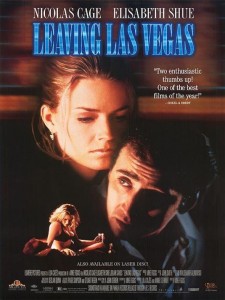 In The 40-Year-Old Critic, Venganza Media creator and host Arnie Carvalho recalls a memorable film for each year of his life. This series appears daily on the Venganza Media Gazette.
In The 40-Year-Old Critic, Venganza Media creator and host Arnie Carvalho recalls a memorable film for each year of his life. This series appears daily on the Venganza Media Gazette.
Have you ever had the feeling that the world’s gone and left you behind….
More than any other form of art, films have a soul. Moviegoers can experience a picture on more than an intellectual level; sometimes there is a base, emotional connection. Watching a great film can be akin to falling in love.
This is a view I first articulated while reviewing Gus Van Sant’s 1998 remake of Alfred Hitchcock’s Psycho for Now Playing Podcast (part of our Fall 2012 donation drive, that review is no longer available). That film showed two talented directors could take the same script, sometimes even the same camera shots, and produce different results. One filmmaker created art that engrossed and thrilled audiences, while the other produced a rote, mechanical and generic film.
Tens, hundreds, or even thousands of people — depending on the scope of the production — come together to create a single experience for a viewer. Even I sometimes forget this; the auteur theory takes hold and I focus on the director as sole creator of a vision. While the director usually maintains creative control, sometimes even through the editing stages, the movie itself is the result of millions of little decisions made by every actor, set dresser, composer, editor, and cameraman on the production. With the right people involved even the most mundane script can become a memorable experience.
One prime example of such a script elevated by those working on it is Leaving Las Vegas, the 1995 drama directed by Mike Figgis, starring Nicolas Cage and Elisabeth Shue. On paper, this movie seemed like the most trite of stories — depressed drunk Ben Sanderson (Cage) is a Hollywood screenwriter whose penchant for drink has ruined his every personal and professional relationship. When he is finally fired from his job he is ready to die, so he takes the last of his cash to Las Vegas where Ben plans to drink himself literally to death. In Vegas Ben hires a prostitute Sera (Shue), the damaged hooker with a heart of gold. The two lost souls fall in love, yet neither is willing or able to change their self-destructive habits.
These character tropes are so hackneyed that I would expect this to be a film made in the 1930s, when stories and characters were broader, and not the 1990s.
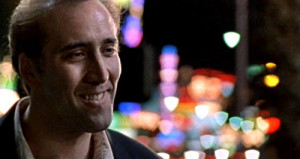
Cage in one of his more charming scenes, back-lit by the lights of the Vegas strip.
The film is based on a novel by John O’Brien. I have not read that book, but I have no doubt of O’Brien’s commitment to the material. Two weeks after discovering Leaving Las Vegas was to become a film, O’Brien used his gun to commit suicide. Clearly this was a man who understood the struggle with depression and the impulse to kill yourself. Yet, despite the insight his prose may offer, I have no interest in reading a book about two stereotypical characters going through a depressing endeavor. It may be very well written and I may be missing out, but the story itself sounds uninteresting.
Yet, despite cliched characters and a tired plot, in the hands of these filmmakers the result is a dramatically moving experience. Few movies I’ve seen in my life parallel the emotions stirred in me by Leaving Las Vegas, for what this team did, through filming and editing, was craft a film where the plot matters less and the characters matter more.
The tale is about a drunk, and the editing and filming often give the film a fugue-like ambiance. Sometimes the dialogue is crystal-clear, loud and in full focus. Other times the music mix raises. Sometimes you hear nothing as the actors’ lips move, other times there are words but you cannot make them out. It’s a dream-like experience that reminds me of techniques used by David Lynch.
The impact of the music cannot be overstated. The score, composed by Figgis himself, sounds like music played around 2 a.m. at an upscale bar. Heavy with piano and saxaphone, the music has a slow jazz feel that underlines the emotions of the moment. More, in an unusual move, some of the score is lyricized and sung by Sting. It blurs the line between soundtrack and score, but in the process creates sorrowful ballads of love and loss. Those original compositions intermix with covers of classic songs, such as “Lonely Teardrops” sung by Michael McDonald.
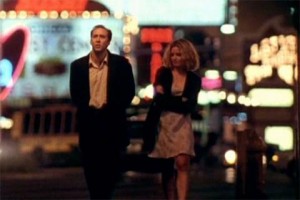
The sounds of the street often drown out character dialogue, to great effect.
The result sometimes feels like a depressing music video or an “in memoriam” montage, played while the characters still live. That Figgis is so willing to part with dialogue and just convey mood shows that in Las Vegas plot doesn’t matter. This is a character-driven story and we don’t need to hear their words to feel their pain.
This type of disregard for traditional narrative is used at the micro and macro scale. Sometimes the film cuts to the future suddenly, and we return to the present when Ben comes out of his stupor. We learn about the missing moments when Ben asks what happened. This is a movie told primarily from Ben’s shaky, out-of-focus point of view, and the camerawork and editing embody that mindset.
More than the cinematography, this film hops in and out of Ben’s own head. Sometimes we see Cage saying outrageous things, but then we discover it was only a fantasy in the character’s mind. In contrast, sometimes Ben makes equally offensive statements out loud and faces the very real consequence. As his blood alcohol content rises Ben cannot distinguish reality from fantasy, and, like Ben, the audience never knows exactly what is happening and what we can believe.
Of course, Figgis could not accomplish this alone. In the hands of a lesser actor than Cage Leaving Las Vegas could become an unintentional comedy quickly forgotten. Now, 20 years later, Cage is often disregarded, written off due to a long string of bad movies in which the actor makes unfortunate character choices.
Cage is an actor who gets off on playing characters in unconventional ways and giving them strange mannerisms. Often that will alienate the audience, but in Leaving Las Vegas Cage commits totally to the role. His body language exudes desperation. In one of the movie’s first scenes Ben is unintentionally sober, craving drink, and hitting up some colleagues for cash. He comes off sweaty, clumsy, and off-putting. One scene later, after a few drinks, Ben has an undeserved, over-inflated sense of self-confidence and makes improper advances on an attractive woman at the bar. It’s a wild swing of character, and is played perfectly through Cage’s intonation, eye work, and mannerisms.
This type of character could alienate audiences. Had viewers seen Ben as more creepy than sympathetic the result could be quite different. It’s little moments Cage plays, such as sobbing “I’m sorry” when being fired, that show humanity in this sad soul. It makes him someone we feel for, rather than pity.
I was a fan of Cage’s coming into Leaving Las Vegas, with Guarding Tess, Trapped in Paradise and Wild at Heart as highlights (though I’d also suffered through Kiss of Death, It Could Happen to You, and Amos & Andrew). Cage often gave captivating performances, but none I’ve seen before or since match his Oscar-winning performance here.
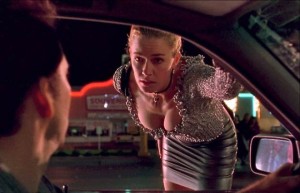
Despite how they meet, the relationship between Ben and Sera is about love, not sex.
Matching Cage’s portrayal is co-star Shue. In her roles in Back to the Future 2, Adventures in Babysitting, and even Cocktail I’d found the actress to be capable, but unexceptional. As Sera, Shue shows a range I’d never seen before. Early in the film Sera is a hooker, and very good at her job — she instinctively knows what the John wants, and becomes it. With Ben we see Sera start to open up. She lets down her guard, takes off her make-up, and becomes a real person. The transformation is startling, as is Shue’s lack of vanity in several unflattering scenes.
But Sera is not your normal streetwalker — she also has regular visits to a therapist. In these scenes we get to see inside Sera’s thoughts through monologues, confessions taken from her therapy session. As edited, these moments play like scenes from the confessional booth in MTV’s The Real World, but without them we would never be able to trust Sera. We never see the therapist; Shue is giving brief one-woman performances, but conveying pure emotion. This is a challenge for any actor, and she pulls it off. Shue fully deserved her Academy Award nomination for this performance.
Together Cage and Shue create a wholly believable, wholly dysfunctional, couple. Both broken characters are instantly drawn to the other. Though Sera knows Ben may be trouble, she puts that aside and chooses to follow her heart. The film avoids making their relationship too gross or base by actually, and believably, removing sex from the equation–while Ben hired Sera for physical gratification the liquor prevented him from performing. He becomes the only character not sleeping with Sera, even choosing to sleep on the sofa at night despite Sera’s repeated offers of more.
These two share a chemistry and a spark on screen that few romantic films can match. Though it’s a futile hope, it’s easy to root for these two to overcome their hardships through their new-found love.
Those two actors are the primary cast but even the minor roles are perfectly played by actors you’ll recognize; from Steven Weber (Wings, Stephen King’s The Shining), to comedian Richard Lewis, to Laurie Metcalf (Scream 2, Roseanne). It could almost be a drinking game — take a shot when you see an actor you know. With French Stewart, Shawnee Smith, R. Lee Ermey, Mariska Hargitay, and even, in the thankless role of bank teller, License to Kill’s Carey Lowell, you would be as drunk as Ben when credits roll.
No one on screen breaks the mood. Figgis has created his own Vegas, sometimes romanticized, sometimes demonized, but always real.
 Leaving Las Vegas is a film with layers. On the surface, taken literally, the plot is about a terminal man and the woman who loves him as he dies. In such a bland interpretation, Sera is nothing but a fantasy, a female who serves a man’s needs. Sera describes herself as being instinctively able to become what her clients want, and she does that for Ben. Early in the film the drunk fantasizes of a woman pouring liquor on herself so he can drink off her, and she would have purpose. Ben never tells that to Sera, but she does that for him — alcohol and sex, Ben’s fantasy realized. Ben calls Sera, “my Angel”, and you could see her as nothing but.
Leaving Las Vegas is a film with layers. On the surface, taken literally, the plot is about a terminal man and the woman who loves him as he dies. In such a bland interpretation, Sera is nothing but a fantasy, a female who serves a man’s needs. Sera describes herself as being instinctively able to become what her clients want, and she does that for Ben. Early in the film the drunk fantasizes of a woman pouring liquor on herself so he can drink off her, and she would have purpose. Ben never tells that to Sera, but she does that for him — alcohol and sex, Ben’s fantasy realized. Ben calls Sera, “my Angel”, and you could see her as nothing but.
Yet to take that interpretation is to miss several important details. Sera is, in many ways, a mirror of Ben. Both came to Vegas from Los Angeles. Both are recently unemployed (Sera finding herself without purpose when Yuri, her lover and pimp played by Julian Sands, is murdered by Russian mobsters). Both characters are deeply wounded and on dangerous paths. And both accept each other unconditionally; Ben’s condition of being with Sera is that she never ask him to stop drinking. Likewise, Ben is accepting of Sera’s profession, knowing that she will continue to hook while he lives with her.
 Finally, Ben’s course is a straight one. He starts and ends the film a drunk and he never waivers from his path of self-destruction. It would be nihilistic if his story was the only one in the film. Yet through loving Ben, Sera softens. The relationship forces Sera to mature, and she evolves from accepting her doomed relationship to trying to fix it, finally asking Ben to see a doctor. When Ben responds by bringing another woman home to her bed, she instantly kicks him out — she was not that strong when the movie began and she was working for Yuri.
Finally, Ben’s course is a straight one. He starts and ends the film a drunk and he never waivers from his path of self-destruction. It would be nihilistic if his story was the only one in the film. Yet through loving Ben, Sera softens. The relationship forces Sera to mature, and she evolves from accepting her doomed relationship to trying to fix it, finally asking Ben to see a doctor. When Ben responds by bringing another woman home to her bed, she instantly kicks him out — she was not that strong when the movie began and she was working for Yuri.
The star of the movie is clearly Cage as Ben, but every time I watch this film I become more convinced the true main character is Shue’s Sera. And it is through Sera that I found my own redemption in 1996.
That summer I had graduated college. My Communications degree and B-average in were not opening any doors. I had a small apartment in a boring town. Most of my friends had left for bigger cities and greater opportunities. My full-time job was working nights as tech support for an Internet company. It didn’t demand much; I sat alone in an abandoned building for eight hours a day, answering the phone on the rare occasion that it rang. It also didn’t pay much; I was living on $8.25 per hour.
Not that I had career aspirations. In college I spent my time doing my coursework and never got to the other things I wanted to do — write some screenplays or even publish some short stories. I had nothing to build my resume, and no idea what career path I should take. I still wanted to entertain people — that drive instilled since seeing Pump Up the Volume — but come fall, even my gig as a DJ would be taken away.
Despite having family living in my same town, we were never close. I preferred being alone in my dark apartment to spending time with them (and I loathed being alone). I was so desperate for friendly contact that, despite having graduated, I asked my college radio station if I could continue to work (for free) as a DJ through the summer.
Mostly, I was lonely. While friends would have alleviated this problem, to me the solution was a girlfriend. Many of my college friends had married soon after graduation. It is very easy for a lonely straight man to envision a woman as the answer to his troubles, and I certainly fell into that mindset. Yet with few friends, no social events to attend, and Internet dating not yet commonplace, I had no way to even meet a woman unless she happened to be delivering my pizza one Friday night.
With all these troubles, no money, few friends, bad job, no prospects, I was suffering from a deep depression.
I was never suicidal, but my overriding emotion was one of apathy, with a side of hopeless despair. My only pleasure in life came from movies. I couldn’t afford to see many in theaters, but I spent what little surplus income I had at the rental store week after week.
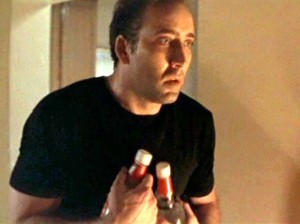
Ben’s constant fight against DTs show alcoholism isn’t a glamorous way to die.
That was when I found a kindred spirit in Ben Sanderson. Despite having recently turned 21, I was never much of a drinker. Still, there was something romantic in the very notion of going to Sin City and dying through copious consumption.
Yet through this act of destruction, Ben found his “angel” in Sera. And despite connecting with Ben’s depression, in Sera I saw strength and hope. Sera was in an equally bad situation — her “career” was short-term and dangerous. She was a smart, attractive woman, and even the Vegas cabbies were telling her she could do better than her station in life. When the movie ends Sera loses her love but gains hope for a brighter future.
Through Leaving Las Vegas’ trippy mood, moving characters, and tale of redemption I found my own. I was inspired out of my funk. Nothing happened quickly, but over the next four years my ambition redoubled, I went back to school to get a more employable degree, and I met my wife. But when my future seemed nearly as bleak as Ben’s, Leaving Las Vegas showed me the neon light at the end of a tunnel.
I believe that connection is partially because of the tragic, sad story presented, but the experience is heightened by Figgis’ choice to drop out dialogue and scenes. Figgis’ music created an emotional call-and-response; when the film’s dialogue was drowned out my own struggles filled in the blanks. When the dialogue faded out I would project my pain into the film, mixing with Ben and Sera’s until we were indivisible.
Even today, as I live a much happier, optimistic, and realized life, the film still moves me. You don’t have to be in pain to empathize with those in pain; you don’t have to hear their words to know their struggles.
This is where Leaving Las Vegas transcends being a movie and becomes a full, engrossing experience. This is the soul of a film.
Tomorrow — 1996!
Arnie is a movie critic for Now Playing Podcast, a book reviewer for the Books & Nachos podcast, and co-host of the collecting podcasts Star Wars Action News and Marvelicious Toys. You can follow him on Twitter @thearniec
August 25, 2014 Posted by Arnie C | 40-Year-Old Critic, Movies, Now Playing Podcast, Podcasts, Reviews | 1990s, 1995, 40-Year-Old Critic, Alcohol, Alcoholic, Drama, Elisabeth Shue, Enertainment, Film, Las Vegas, Leaving Las Vegas, Mike Figgis, Movie, Movies, Nicholas Cage, Now Playing, Now Playing Podcast, Podcasts, Review, Reviews, Romance | 1 Comment
40 Year-Old-Critic: Natural Born Killers (1994)
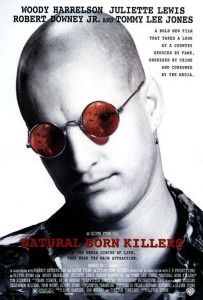 In The 40-Year-Old Critic, Venganza Media creator and host Arnie Carvalho recalls a memorable film for each year of his life. This series appears daily on the Venganza Media Gazette.
In The 40-Year-Old Critic, Venganza Media creator and host Arnie Carvalho recalls a memorable film for each year of his life. This series appears daily on the Venganza Media Gazette.
Mister rabbit says, “A movie review is worth a thousand prayers.”
In 1994 I was in college with aspirations of filmmaking. While my university did not have a dedicated film curriculum, my Mass Media Communications major with a Creative Writing minor afforded me classes in screenwriting, film criticism, editing, camerawork, and more.
But as the major was not simply film, there were numerous other classes I had to take for my degree. The list included Communication Ethics, First Amendment rights, studies of media impacts on the audience, and journalism, to name a few. As a college junior, I lived and breathed my major. Every form of entertainment I enjoyed, from video games to television to books to film, was a subject for my college studies. I wrote papers and gave multimedia presentations on violence in film, with a special focus on the Friday the 13th and Nightmare on Elm Street franchises.
But that year produced something unexpected from Oliver Stone and Quentin Tarantino. I was used to films factoring into my curriculum, but I never expected a major motion picture to be studying the same topic.
Natural Born Killers did just that.
The story is pure Tarantino. Having rewatched both True Romance and Reservoir Dogs multiple times I instantly saw a familiar trope in Mickey and Mallory Knox — the killers/anti-heroes of this film. Seeing two young outlaws in love and on a crime spree seemed right out of True Romance. That they are also merciless murderers felt like an extension of some of the characters from Reservoir Dogs — Mickey and Mallory could be Mr. and Mrs. Blonde. Finally, the film has a non-linear narrative that ends in a Mexican standoff. Despite Tarantino distancing himself from the production I saw his fingerprint on the negative.
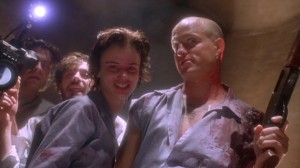
Despite the carnage, there was something pure and romantic about Mickey and Mallory’s love affair. It was sick and twisted, but also sweet.
I did later read the original script, which was published in book form. That draft was far more Tarantino, but still a reach for the director. More than a crime film, Tarantino’s Natural Born Killers had a pointed critique on American tabloid journalism.
Yet, in the hands of Oliver Stone, the film’s focus on the media grew exponentially. Stone, along with screenwriters David Veloz and Richard Rutowski, rewrote the script to the point that Tarantino ended up only receiving story credit. In the hands of Stone’s team, Natural Born Killers became a scathing commentary on American media.
It could not have hit at a more appropriate time. Rush Limbaugh was scoring big on radioand television with his daily indictment of the Clinton administration. Meanwhile the country was transfixed by the O.J. Simpson case. While this movie was released a few months before the trial began, the Ford Bronco chase and Simpson’s arrest were constant news.
The media focus seemed to go from one real-life drama to the next, be it Amy Fisher, Tonya Harding, Heidi Fleiss, the Menendez brothers, or even Woody Allen’s divorce from Mia Farrow — all were fodder for the newspapers and 24-hour news channels. What had once been the domain of the National Enquirer was suddenly considered “real news.” It seemed everyone was being given a talk show, and those who couldn’t host a show tried to get their 15 minutes of fame by appearing on one.
It’s ironic that Stone undertook this film as a chance to make a simple action picture, but he doesn’t do “simple.” As such, the result is an indictment not only of the media companies that propagate such coverage, but also the populace that consumes it.
Mickey and Mallory Knox, as brought to life by Woody Harrelson and Juliette Lewis, are products of the media. Despite Harrelson being in his early 30s when this film was made, Mickey and Mallory feel like members of the “MTV Generation.” These two realize they will never be TV stars, so they’ll be the next best thing: headline-makers. They guarantee it, always leaving one person alive to tell the media about Mickey and Mallory.
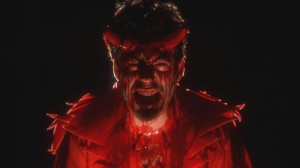
Stone has never been accused of being too subtle.
The journalists are not left untouched, though. The second half of the movie gets a shot of adrenaline in the form of Robert Downey, Jr., turning in a tremendous performance as tabloid TV reporter Wayne Gale. With an affected Aussie accent and an equally affected sympathetic persona, Gale convinces Mickey to do his first TV interview. As the film’s madness grows Gale starts to believe his own press, and eventually realizes the time comes when the audience wants to turn the TV off.
From the first frame to the last, Natural Born Killers is a film about the superficiality of personas, examining the concept of who a person is versus how he/she wants to be seen. While that difference is often greatest in the cases of public figures who must act a certain way in public but may be very different behind closed doors, the script shows that everyone has that secret face. The insight to that is Detective Jack Scagnetti (Tom Sizemore), who appears to be the heroic cop who brings down Mickey and Mallory. Yet the audience sees that he is a mirror image to Mickey. While Mickey kidnaps, rapes, and murders an innocent woman, Scagnetti hires, screws, and strangles a hooker.
Every character in the film is disgusting and immoral–save one Navajo Indian from whom Mickey and Mallory seek shelter. This character calls out blatantly that the two killers watch “too much TV.” While the mystical, magical medicine man is a blatant stereotype, he is the only character in the film who doesn’t deserve a bullet (but he gets one anyway). The police, the media, Mallory’s parents, even the random stranger Mallory seduces at a gas station, are all contemptible and repugnant.
In other words, they’re the product, creators, and consumers, of tabloid journalism.
Yet, for all of the high-minded idealism of the movie, Natural Born Killers avoids the usual “message movie” pitfall of heavy-handedness, which I discussed in my review of Philadelphia.
Stone’s filmmaking is too frenetic, too fast-paced, to ever linger. The film’s style changes with the scene; one moment we are seeing Mallory’s family portrayed as a sitcom, complete with laugh track, the next we have grainy black-and-white footage. There are even animated sequences inserted into the film that visualize the emotion of a scene. There is no way for the film to linger, there is too much going on.
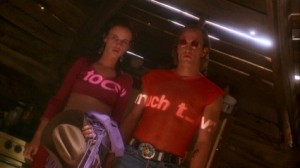
Something as simple as projecting a slide on actors felt fresh among the ever-shifting styles in Natural Born Killers.
In that regard, the picture is a critique of its audience. Stone knew that moviegoers in the 1990s had short attention spans, so he created a film perfectly suited to the mindset of an ADD-addled channel-flipper. The story and characters remain the same, but the tone, even the film stock, continually change. Stone also inserts bits of real commercials, as if he holds the remote we’re watching him scan to see what else is on.
The result is a trippy, psychedelic movie that truly feels like a tonal companion piece to his 1991 film The Doors. Mickey and Mallory are also rock stars of the media, and they even seek guidance from the spiritual Native American.
Like that earlier Stone film, Natural Born Killers is an experience more than a narrative. The color pallette, the transition to animation, the first-person camera shots years before found footage films were en vogue, the result is less narrative and more emotional.
And like The Doors, Natural Born Killers is propelled by a strong soundtrack. While the former film was almost exclusively set to Jim Morrison’s music, it was limited by the subject matter. Natural Born Killers doesn’t have that limitation, and the styles of music represented are as scattered as the film techniques.
Stone collaborated with Nine Inch Nails’ Trent Reznor to produce the soundtrack, and the result is a thumping, yet moody, symphony of discord. Music from Patsy Cline is interwoven with Patti Smith, Bob Dylan, L7, Dr. Dre, and much more — with a healthy dose of Leonard Cohen at the beginning and end.
Listening to the soundtrack is almost as involving an experience as watching the film. Reznor did not simply follow the Reservoir Dogs formula of putting film clips on the CD, he actually mixed it with the music, creating an aural cinematic experience.
(Though for those of us who are musical purists, it also ensured I bought many of the bands’ original albums to have versions of the songs without added effects and dialogue. It was this album that set me on the road to Leonard Cohen super-fandom.)
This entire tone could have been undercut by the lead actors, but Stone directed his cast expertly. All the leads, and key supporting characters, have left realism at the door. Exaggeration is the name of the game, so lines are screamed or drawled, movements emphasized, and facial expressions broad. Alone, that type of acting could undermine a film, but with the crazed visuals that accompany the scenes anything more natural would be lost.
The standout of the cast is Harrelson. Much like Tom Hanks with Philadelphia, I knew Harrelson from his comedies — not just Cheers, but Doc Hollywood, White Men Can’t Jump and even The Cowboy Way. I worried he could not pull off a performance as a homicidal maniac. More, as Harrelson was the son of a hit man who may have been involved in the John F. Kennedy assassination, it felt like stunt casting of the worst type.
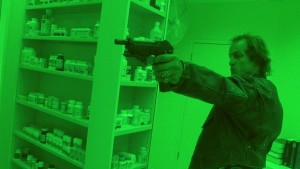
Harrelson left behind his good-ol-boy persona and fully inhabited the homicidal persona of Mickey Knox.
I was again wrong as I watched Harrelson, head shaved, fall into the character. By the film’s climax — when he has to break the fourth wall and deliver the line “I’m just a natural born killer” — all thoughts of comedy were gone. He was just a bad-ass, homicidal, rock star.
His performance is clearly aided by those of his co-stars. Lewis, a quirky actress I first noticed with 1993’s Cape Fear, is perfectly cast as a psychotic who becomes empowered and emancipated by following Mickey’s murderous examples. Sizemore carries a sleazy menace that follows him to every frame. Even Tommy Lee Jones overacts to the heavens as the spiteful prison warden. The result is a cast in perfect harmony, complimenting each other and their movie.
When I saw this film in theaters opening weekend I was mesmerized. I walked out, my head full of new viewpoints that I could incorporate into my coursework. I went back the very next day to try and catch more of the film, and to again experience the weird acid trip it offered.
Natural Born Killers spoke to me at a time in my life where I was already receptive to its message. I walked in expecting a road movie featuring mass murderers. I left thinking about media, and my own role in its creation.
But like Stone’s earlier film Wall Street, I feel the message of Natural Born Killers has been lost at best, or perverted at worst. Several instances of “copycat crimes” have appeared in the media, killers completely missing the point and, instead, are seemingly inspired by Mickey and Mallory Knox. It’s impossible to say if those acts would have been done without this film, but it’s a sad irony that a movie about the dangers of media violence then creates its own.
Yet every day when I look at the news, I feel that Natural Born Killers did not succeed in warning the media, or its consumers, about the impact of tabloid journalism. From Britney Spears’ head-shaving incident to Charlie Sheen’s “winning” display to even Robin Williams’ tragic suicide, the media is there to try and grab big ratings under the guise of informing the public.
On TV, audiences laughed at the obviously drugged antics of Anna Nicole Smith, until she died from her drugs. Audiences insist on Keeping Up with the Kardashians and watching Honey Boo Boo, The Bachelor or Catfish. Producers and editors sculpt clips from those shows, take sound bites out of context, and spend thousands of hours creating an audience-pleasing narrative of good versus bad that may have little bearing on reality.
I don’t know if fans of these shows a) don’t realize they manipulate the stars and their audience, or b) don’t care. Either way, we continue down the spiral to Stone’s original vision.
But if Natural Born Killers’ message didn’t last, the film didn’t stick with me either. Through my college years Stone’s film was in heavy rotation on my VCR. When the VHS release of the Director’s Cut came in 1997 (so long it had to be on two tapes) I rented it the first day. That was when I felt the trippy effect had finally worn off and I was no longer under the movie’s spell.
The scenes cut from Natural Born Killers — available on the second VHS tape — had every reason to be cut. I watched the extra hour Stone filmed for this movie and realized that, truly, this was a film made in the editing bay and not on the set. Assembling all the footage, including the cut trial scene and Mickey and Mallory’s attack on wrestling brothers Simon and Norman Hun, I realize Stone had a production out of control. The behind-the-scenes knowledge soiled this film for me, and for a decade I had trouble watching it at all. Now I can credit the final product, knowing how bad this movie almost was.
But in the fall of 1994 two Tarantino scripts were in theaters simultaneously: Natural Born Killers and Pulp Fiction. The masses crowded around Fiction, and Tarantino took home Oscar gold.
I greatly enjoy that second Tarantino-directed film, but if you asked me in the mid-90s to name my favorite of those two works, it had to be Natural Born Killers.
Tomorrow — 1995!
Arnie is a movie critic for Now Playing Podcast, a book reviewer for the Books & Nachos podcast, and co-host of the collecting podcasts Star Wars Action News and Marvelicious Toys. You can follow him on Twitter @thearniec
August 24, 2014 Posted by Arnie C | 40-Year-Old Critic, Movies, Now Playing Podcast, Podcasts, Reviews | 1990s, 40-Year-Old Critic, Juliette Lewis, Mallory, Mickey, Movie, Movies, Natural Born Killers, Nine Inch Nails, Now Playing, Now Playing Podcast, Oliver Stone, Podcasts, Review, Reviews, Robert Downey Jr, Trent Reznor, TV series, Woody Harrelson | 2 Comments
40 Year-Old-Critic: Philadelphia (1993)
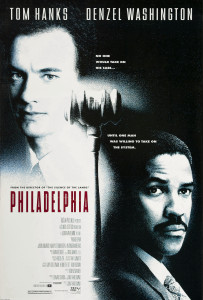 In The 40-Year-Old Critic, Venganza Media creator and host Arnie Carvalho recalls a memorable film for each year of his life. This series appears daily on the Venganza Media Gazette.
In The 40-Year-Old Critic, Venganza Media creator and host Arnie Carvalho recalls a memorable film for each year of his life. This series appears daily on the Venganza Media Gazette.
In many of these reviews I have observed how film can be an experience that takes you to other places and vicariously allow you to have extraordinary adventures. That was my childhood focus for films — escapist entertainment. As I aged, though, I came to discover film could also educate and open a window into the world of people totally different than myself.
The film that drove that point home more than any that came before was Jonathan Demme’s Philadelphia — a film I initially had no interest in seeing.
The picture had good people involved. Demme was not a favorite director of mine, but I had enjoyed Married to the Mob and fell in love with The Silence of the Lambs; the latter preceding Philadelphia by a couple of years. Likewise, co-star Denzel Washington had impressed me in his Oscar-winning role in 1989’s Glory. Both of these talents I liked, but neither did I love.
That affinity was thwarted by two large barriers.
My biggest problem with the film, before I even saw it, was star Tom Hanks. I had loved Hanks in the 80s. I had seen every episode of Bosom Buddies at least three times each; along with most of his films — Splash, Big, and Turner & Hooch are favorites. But by 1993 I felt Hanks was washed-up; a product of the 80s. The turn of the decade came and Hanks was starring in two of the worst films I had ever seen: Joe Versus the Volcano and The Bonfire of the Vanities. Sleepless in Seattle had also put me to sleep in theaters, and despite his acclaimed supporting role in A League of Their Own, I felt done with Hanks entirely.
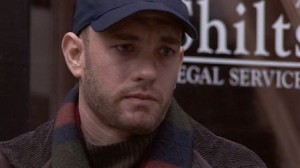
Despite having been a fan of Hanks in the 80s, he was a barrier to my seeing Philadelphia.
More, I pigeonholed him as a comedian. The thought of this guy doing a dramatic performance as a gay man dying of AIDS seemed funny for all the wrong reasons. I thought it was miscasting of the worst possible kind and that the film would be a train wreck.
But no matter who starred in the film, I still wouldn’t have rushed to see this it. From the trailers, from the interviews I read, from the film’s very premise, Philadelphia seemed like a movie with an agenda.
I had seen similar films by this point, from Born on the Fourth of July, to 1987’s Project X, to Gorillas in the Mist. I found them to be self-important slogs that would often have an effect opposite of what was intended. I was so put off by the picture I would feel kinship with the opposition. I had started to avoid “message movies” altogether.
Additionally, I was untouched by the AIDS epidemic. I had seen it covered on television shows like L.A. Law and St. Elsewhere and some “very special” sitcom episodes. I had watched the explosion of news coverage in the 80s. I was in the safe-sex ed classes in high school. I felt I knew all I needed to know, and I didn’t need to pay $7 for a movie to try and drive that point home again.
Further still, I wasn’t gay and, despite being a college student, had no gay friends (at least none that I knew of). Again, I had seen gay characters on television and in other films, but it was not a lifestyle, or even a cause to which I felt connected. My suburban, middle-class lifestyle made it all very unrelatable.
A combination of factors changed my mind, and I ended up seeing Philadelphia in theaters its opening week. First was the buzz surrounding the film. Critics I respected, and those who had lambasted Bonfire, heaped praise upon the film. It had started to become a topic of conversation among my friends.
Then there was the Bruce Springsteen song “Streets of Philadelphia”, a haunting piece that got heavy radio airplay. Never underestimate the power of a hit song to bring audiences into a movie — it worked for me. I wanted to see the film that could get The Boss to perform this song in a broken voice that made it sound as if he were on the verge of tears during the recording session.
Finally, my Now Playing Podcast co-host Stuart was in town for the holidays, and we would often see movies together on Christmas Day. We had already gone to see What’s Eating Gilbert Grape and were struggling to agree on a second film to watch. He suggested Philadelphia. By that point my curiosity was piqued, so we went.
It is a fine film. Not phenomenal, not outstanding, but very well done. I felt that way then, and now upon revisiting this film. The court case, which is ostensibly the film’s plot, is engaging. It clicked with me as a long-time fan of courtroom dramas. Still, the movie wasn’t only about the plot. This is a “message movie” and the point is to start conversation about homophobia in the workplace, and a true understanding of people not only dying from, but living with AIDS.
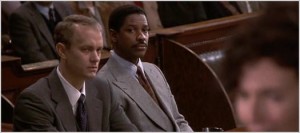
If what you want is a good courtroom drama, there are better out there. This plot is secondary to the human message of the film.
As such the plot does feel incidental.
As do any characters other than Hanks’ Andrew Beckett. The whole film is structured to engender audience sympathy for this man who lost his job, and eventually his life, due to his lifestyle and disease. Demme’s attempt to make the viewer connect with Beckett is obvious to me on a recent viewing.
More, Beckett is a character without much of an arc. He remains put-upon and in the right for most of the film. A late revelation on how he contracted the disease is a strange turn of events, but it doesn’t change Beckett for me. By that point in the film you were either on his side or walking out of the theater.
The true character arc is that of Washington’s Joe Miller. He plays Beckett’s lawyer and, over the course of the film, changes from a homophobe ignorant of AIDS and how it is transmitted, to understanding and accepting of Beckett’s lifestyle. Still, due to the script and the director, Washington’s performance and character is lost in Hanks’ shadow.
As for Hanks, who I expected to hate in his first highly dramatic screen role, Demme’s filmmaking was a success — I became fond of Beckett. The affinity I had for the actor helped me feel very comfortable with the dying lawyer he portrayed on screen. Perhaps it even created a feeling of closeness I wouldn’t have had if Beckett had been portrayed by someone unknown. Hanks physically transformed himself, losing a lot of weight to physically appear ill, and it did help both his performance and my sympathy for Beckett.
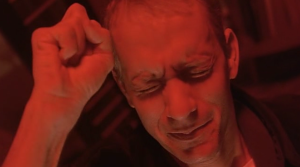
Did audiences really fall for this blatant manipulation? The film was moving, but this scene was too obvious in its pulling of the heart strings.
All that praise aside I do roll my eyes, unmoved by Hanks’ speech while playing an opera for Miller. The dramatic, high camera angle, Hanks’ closed-eye monologue with his hands raised to his head, it was the one scene of the film that felt unauthentic and overly manipulative. I imagined Hanks, after the take, grinning and telling his assistant “that is my Oscar moment.” Not only did the scene feel fake, I don’t think Hanks “sold” it to me. It was the one time I stopped seeing Andrew Beckett, and instead saw Tom Hanks. I also thought voters for the Academy Awards would be smarter than to fall for such chicanery… shows what I know about awards. They fell for it, and Hanks took home a gold statue, probably because of this very scene. With Forrest Gump the following year Hanks’ career hit new highs, and he keeps climbing to this day.
Yet I did feel moved at the end when Beckett lay in the hospital bed dying. Over the course of two hours I came to care for this man, and though his end was a foregone conclusion it still held impact.
I went into the film understanding how AIDS worked. When Miller goes to his doctor to see if he contracted AIDS from a handshake, that to me — even in 1993 — felt like an antiquated notion. More, I felt no bigotry towards homosexuals. I was a minority student at a liberal arts college and in my mind I held no judgement for anyone based on race, creed, gender, or orientation.
Still, this film opened my eyes. I may not have been discriminatory towards homosexuals, but that doesn’t negate that gays are discriminated against. I had thought that if I wasn’t a bigot than bigotry wasn’t my problem. This film helped me see another side. My views on AIDS and homosexuality were about me, this film helped me think about others. Philadelphia allowed me to experience the day-to-day life and struggles of homosexuals. No matter if I was bigoted, they must face and overcome bigotry. Just because I knew from classes how AIDS was transmitted, the film told me that even educated adults were sometimes ignorant about this disease. I may have had no gay friends, but this film made me feel as if, for two hours, I did. And I didn’t fear them or hate Andrew Beckett. I felt compassion.
More, this was one of the first homosexual characters I’d seen on screen that did not feel stereotypical. I didn’t think I knew any gay people because, in my teenaged mind, gays did not act the same as straight men. The epitome of this is Meshach Taylor’s Hollywood in Mannequin, but also George Hamilton’s Zorro, The Gay Blade, and Damon Wayans and David Alan Grier’s “Men on Film” sketch from In Living Color follow this pattern. Even the more toned down homosexual characters I knew, such as Billy Crystal’s Jodie Dallas on Soap, had affected mannerisms.
Hanks’ performance as Beckett was not a parody or a caricature — in most ways he acted like Hanks. Plus all those characters I listed were played for comedy; their homosexuality was cause for laughter. Here I was seeing homosexuality as cause for… nothing. He was just like everyone else.
This film was the first true step in my life toward a greater understanding, not just of gays but all people different from me. It helped me fully realize that a person cannot be judged by any single aspect of their character, but their whole being and the sum of their life experience.

Hanks’ commitment to the role was admirable. By the end of the film he was unrecognizable.
And I wasn’t alone. Philadelphia helped break down many walls. It seemed, after this film, gay characters became more accepted by mainstream America. On television, from My So-Called Life to Pedro Zamora on the 1994 season of MTV’s The Real World, I started to see more representation of gays.
Yet they all paled compared to the 1996 ER episode which revealed Gloria Ruben’s character Jeanie Boulet to be HIV positive — the first instance I saw of someone not dying from AIDS, but living with HIV. From films like My Best Friend’s Wedding and The Next Best Thing to Ellen Degeneres’ coming out on Ellen, Philadelphia made it okay for these stories to be told.
Given the weaknesses I see in the film itself, I’m not sure that it would hold up for new viewers. For more than 20 years this film has been in the public consciousness, and American culture has changed as a result. As such, in an era of Queer as Folk, Will and Grace, and even a gay married couple on Modern Family, the film just wouldn’t seem as groundbreaking as it truly was.
But I cannot rewatch this film and not think of the world in which I lived in 1993, and how Philadelphia changed that world forever.
Tomorrow — 1994!
Arnie is a movie critic for Now Playing Podcast, a book reviewer for the Books & Nachos podcast, and co-host of the collecting podcasts Star Wars Action News and Marvelicious Toys. You can follow him on Twitter @thearniec
August 23, 2014 Posted by Arnie C | 40-Year-Old Critic, Movies, Now Playing Podcast, Podcasts, Reviews | 1990s, 1993, 40-Year-Old Critic, AIDS, Antonio Banderas, Denzel Washington, Enertainment, Film, HIV, Jonathan Demme, Message Movie, Movie, Movies, Now Playing, Philadelphia, Podcasts, Review, Reviews, Tom Hanks | Comments Off on 40 Year-Old-Critic: Philadelphia (1993)
40 Year-Old-Critic: Reservoir Dogs (1992)
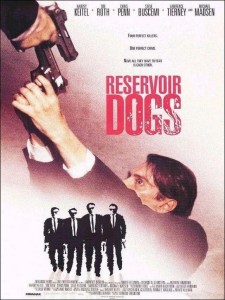 In The 40-Year-Old Critic, Venganza Media creator and host Arnie Carvalho recalls a memorable film for each year of his life. This series appears daily on the Venganza Media Gazette.
In The 40-Year-Old Critic, Venganza Media creator and host Arnie Carvalho recalls a memorable film for each year of his life. This series appears daily on the Venganza Media Gazette.
Are you gonna bark all day, little doggie, or are you gonna review a movie?
Throughout the 1980s American cinemas were dominated by blockbuster, event movies. They rose to prominence in the 70s, starting with Jaws and then Star Wars. By the “Big 80s” big films were the ticket, and the modern movie marketing machine began to form.
By the end of that decade, though, a counterculture of film had started to gain prominence — the indie picture. While this type of low-budget filmmaking was as old as movies themselves, the indies rarely received the publicity and the press afforded to large, studio films. That tide started to turn, in part due to the rise of the Sundance Film Festival in the mid-to-late 80s. Steven Soderbergh achieved critical mass with Sex, Lies, and Videotape in 1989. That same year Jim Sheriden’s My Left Foot was nominated for several Academy Awards, pushing star Daniel Day Lewis into the spotlight.
Both films were distributed by Miramax Films, a studio whose name would be at the center of the 90s indie movement. Studio heads Bob and Harvey Weinstein focused on distribution of smaller independent and foreign films. and the success of those aforementioned 1989 gave the Weinsteins a bully pulpit and legitimacy as they expanded their empire.
While I spent my senior year of high school watching big-budget fare like Lethal Weapon 3, Batman Returns, and Basic Instinct, even at age 17 I could see the shift was happening. I was regularly reading movie and entertainment magazines and following the careers of many actors and directors. I was aware of these low-budget films. Being the teen I was, I tried Sex, Lies, and Videotape, and found it to be much more dull than the titillating title had teased.
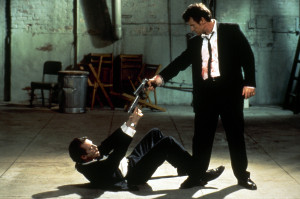
The image that sums up the movie perfectly–men ready to shoot each other.
Although I’d been consuming all of this media, I don’t remember ever hearing about a little film called Reservoir Dogs or its director, Quentin Tarantino. It wasn’t until 1993 — a year after its release — when my lifelong friend and Now Playing Podcast co-host Stuart turned me onto the film.
I had wanted to see True Romance, the 1993 Christian Slater crime film from Top Gun director Tony Scott. I missed it due to friends not wanting to see any film starring Slater post-Kuffs. Thinking I knew Stuart’s taste in film — he certainly was no fan of Slater — I didn’t even ask him, so I was surprised when he later told me he had already seen it and gave it a positive review. He even went out of his way to compliment Bronson Pinchot, of all people, while discussing the movie.
He told me the film was written by the guy who made his directorial debut with the film Reservoir Dogs. As I missed seeing True Romance in theaters (it was only in our town for one week) I immediately went out and rented Dogs with no idea what to expect. I’m not sure I even knew it was an indie film.
I was immediately drawn in. The opening scene had me laughing as the characters sat around deconstructing the lyrics of Madonna’s “Like a Virgin.” The slo-mo opening credits sequence, set to George Baker Selection’s “Little Green Bag”, had me grooving to a song that I hadn’t heard in almost 20 years. These guys were already so cool in their black suits, narrow ties, and sunglasses, and the movie hadn’t even really started.
Reservoir Dogs is really a whodunnit, only we aren’t looking for the identity of a killer, but a rat. Somewhere in this group of cool criminals was an undercover cop. When their jewel heist went bad some members of the gang were killed. The survivors gathered at the designated meeting point, but all are on edge wondering who was the turncoat.
The mystery is revealed through a series of flashbacks. Each of the main villains gets their own sequence showing how they came to be part of the group. As we find out about each member they are ruled out as a cop — until we get to the flashback that makes it explicit.
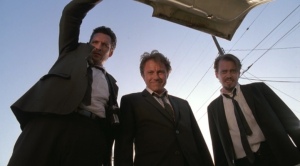
The camerawork in Reservoir Dogs was fresh and exciting. The steadicam following these dogs out of the building–the music fading behind them–was a technique I’d not noticed before watching this movie.
It wouldn’t be until years later that I would realize that through this structure Tarantino had revolutionized cinematic storytelling. Flashbacks were nothing new, but his copious use to unfold a story was uncommon and felt fresh. Today Reservoir Dogs has been copied endlessly — its structure was the template for every episode of Lost, plus hundreds more. Now I consider the flashback story a gimmick. Even Tarantino’s follow-up film Pulp Fiction continued this use, though, while the timeline of that latter film is not chronological, it is also not as scattered as this earlier work.
Watching this film I didn’t realize I was seeing a new storytelling structure that would permeate the mainstream. Through expert editing and story structure I was just drawn into Reservoir Dogs, without excess attention paid to the narrative. The dialogue, the characters, the mystery, it all had me.
Despite being a movie featuring murderous thieves, Tarantino found a way to make them likable characters. The opening scene in the diner, which helped establish a pecking order and general relationships, was a large part of that.
The flashback scenes also built upon this, showing a sense of family among many of the characters and their boss, Joe Cabot. Mr. Blonde (Michael Madsen, in his finest performance to date) is fresh out of prison having refused to rat on his employer. Still on parole, Blonde is afraid of going back. Joe, and his son “Nice Guy Eddie” (Chris Penn) set Blonde up with a fake job and a sense of security, before they do the job.
Likewise Mr. White (Harvey Keitel) is a longtime associate of Joe’s and flashbacks firmly establish their friendship and camaraderie.
The linchpin of the film, however, is Mr. Orange (Tim Roth). He gets the most flashback scenes, and here we get to connect with him outside of the crime family. Tarantino gets much praise for dialogue, and it comes through in these moments.
The sense of pop culture Tarantino put into the film is uncanny. Referencing songs of the 80s while bringing in music from the 70s, Reservoir Dogs clicked with a multitude of audiences. Yet, in a decade before Marvel films were popular, Tarantino referenced Fantastic Four as well — letting this teenage comic fan know a kindred spirit was behind the camera.
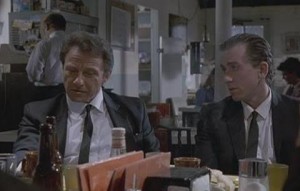
You give me a bad review in a dream you better wake up and apologize.
I also loved the way the soundtrack compiled these songs but, in between, included dialogue from the film. It was rare in 1992 to include anything other than music on a soundtrack. After Reservoir Dogs it became expected, until it — like flashback storytelling — became a tiresome and overused gimmick. With Reservoir Dogs, and then Pulp Fiction, Tarantino’s albums remain my gold standard for this trick.
Beyond all of that came my personal favorite character, the weasely, greedy Mr. Pink (Steve Buscemi). His instinctive sense of self-preservation plus his sardonic sense of humor was all established in his very first scene–he doesn’t tip waitresses. He cares more about his own finances than having compassion for the waitress, and tells this in a highly amusing way. Pink was always my favorite of the Dogs, and for years I thought he, the least trustworthy of all the criminals on screen, was the only survivor. Not only that, it seemed he got away with the diamonds! It wasn’t until 1996 when I saw a limited-run theatrical rerelease that I heard the audio and Pink ended up like the rest of the gang–shot to death.
I can continue to heap praise on this film, and over its 22 year history many have. Yet much of what I appreciated came in retrospect. Watching this film the first time, I was just taken in, and perhaps a bit shocked. Reservoir Dogs is bloody, foul-mouthed, and raw. The casual amorality that Mr. Blonde exhibits when he pulls his captive police officer from the trunk, where the cop had been stored for quite some time, brings the blackest of humor. It is a moment beaten only moments later by Blonde’s torture of the man, set to the jaunty Stealers Wheel’s song “Stuck in the Middle With You.”
This film was my intro to Tarantino, and I was instantly a fan. True Romance solidified that. The next year my dorm room was a practical shrine to the director, with giant Mr. Blonde and Mr. White posters dominating my walls. These films entered heavy rotation, and greatly influenced my creative view. I started tooling with my own crime stories that, at the time, I considered original. Now I realize they were blatant Tarantino rip-offs.
Through my love of Reservoir Dogs I also discovered new directors who followed Tarantino’s path and broke into Hollywood with gritty, genre-bending crime films. From Bryan Singer with The Usual Suspects to Guy Ritchie with Lock, Stock, and Two Smoking Barrels, and even Reservoir Dogs co-writer Roger Avary’s directorial debut Killing Zoe.
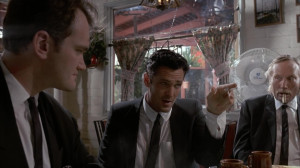
Tarantino pulled off the minor role of Mr. Brown, but he was not as fortunate in future acting gigs.
(I also followed Tarantino’s “acting” career to films like Sleep With Me and Destiny Turns On the Radio. Don’t make the same mistake I did. Never, ever watch Destiny Turns On the Radio)
Tarantino opened the door for indie filmmakers to be taken seriously in the 90s. He also shifted my focus for the rest of the decade, causing me to seek out small films as well as blockbusters, and to sample new directors as well as return to those I already enjoyed.
In the two decades since Reservoir Dogs Tarantino has gone on to win multiple academy awards and put together a very respectable resume of films. There is no doubt the man is a talented director, and an even better wordsmith. Still, to me, his earliest work remains his finest. Even Pulp Fiction, his directorial follow-up to Dogs, became more complex and bloated.
Here, with only the bare essentials and a meager budget, he created a work of genius, and an inspiration to aspiring writers and filmmakers across the country. Including me.
Tomorrow — 1993!
Arnie is a movie critic for Now Playing Podcast, a book reviewer for the Books & Nachos podcast, and co-host of the collecting podcasts Star Wars Action News and Marvelicious Toys. You can follow him on Twitter @thearniec
August 22, 2014 Posted by Arnie C | 40-Year-Old Critic, Movies, Now Playing Podcast, Podcasts, Reviews | 40-Year-Old Critic, Enertainment, Film, Harvey Keitel, Indie, Michael Madsen, Mirimax, Movie, Movies, Now Playing, Now Playing Podcast, Podcasts, Quentin Tarantino, Reservoir Dogs, Review, Reviews, Steve Buscemi, Tarantino, Tim Roth | 3 Comments
40 Year-Old-Critic: The Doors (1991)
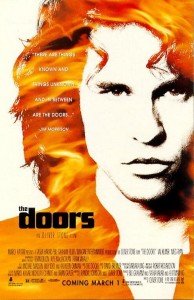 In The 40-Year-Old Critic, Venganza Media creator and host Arnie Carvalho recalls a memorable film for each year of his life. This series appears daily on the Venganza Media Gazette.
In The 40-Year-Old Critic, Venganza Media creator and host Arnie Carvalho recalls a memorable film for each year of his life. This series appears daily on the Venganza Media Gazette.
The critic awoke before dawn. He put his boots on. He chose a film from the ancient gallery and he walked on down the hall…
Believe it or not, I love the concept of film biographies, or biopics as they’re sometimes called. The world is full of colorful people with stories more strange and interesting than any fiction a Hollywood scribe can concoct. To learn a bit about a popular or historical figure, while also hopefully being entertained, seems like a win-win.
I realize this may be a shock to those who have heard my comments on the Now Playing Podcast review of The Aviator where I heaped my disdain on the overwrought, self-important Martin Scorsese-directed Howard Hughes biopic.
Therein lies the dichotomy: while I like the idea of a biopic, the execution is often lacking. A life cannot be compressed into a single film, so shortcuts are made to improve the narrative; and often the films come with this feeling that the director was saddled with the burden of making something to honor the subject.
Still, while they are the exception and not the rule, there are some biopics I completely love. Examples include: The Social Network’s profile of Facebook founder Mark Zuckerberg, Fire in Silicon Valley (the TNT TV movie about the rise of Microsoft and Apple), and Dragon: The Bruce Lee Story, which feels like a martial arts film while profiling the star of that genre.
Of all of those, though, no biopic has had the impact on me that came with Oliver Stone’s The Doors.
It was by chance that I saw The Doors. My interest in a biography film is directly proportional to my interest in the subject. I don’t care about Peter Pan author J.M. Barrie, so I didn’t see Finding Neverland; I’m not a fan of Liberace so I didn’t seek out Behind the Candelabra.
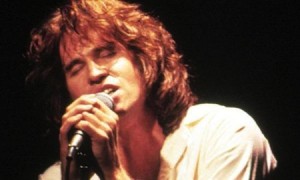
From movement to posture to body shape, Kilmer became Morrison for The Doors.
In my teen years, not only wasn’t I a fan of The Doors, I barely knew them. I was more familiar with the Echo and the Bunnymen cover of People are Strange featured in The Lost Boys than I was any given Doors song.
Nor was I especially a fan of Stone’s (though this review series may give the opposite impression, as I already profiled Wall Street, and one more Stone film will appear before this series ends). After Wall Street I had seen Born on the Fourth of July and found it interesting, and I actually saw JFK before The Doors due to more interest in the subject. But JFK ended up becoming one of those biopics — like The Aviator — for which I have no tolerance.
I saw The Doors due to utter boredom. I was home from college for a weekend with no plans, so, as I was wont to do, I went to the video store with no agenda. A Saturday night, the new releases gone, I eventually came upon this film’s VHS box and saw Val Kilmer staring out at me, his hair and shirt aflame.
Kilmer was an actor I’d greatly enjoyed. Real Genius remains, to this day, one of my favorite 80s comedies, in large part due to the actor’s fun, yet emotional role as young laser scientist Chris Knight. In addition, Kilmer had given strong performances in Top Gun, Top Secret!, and Willow. I wanted to see what the actor could do if given a more serious role, and I had read nothing but praise for his portrayal of singer Jim Morrison.
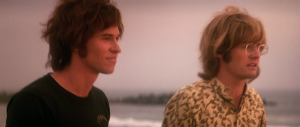
I mostly knew co-star Kyle MacLachlan from Twin Peaks when I first saw The Doors. His character of Ray Manzarek, Doors’ keyboardist, is lost in this film; despite the title this movie is all about Morrison.
I took the videocassette home, with no clue what to expect. I knew nothing of Morrison’s life or his band. I certainly didn’t expect to see visions of Native American spirit guides, trippy sexual satanic rituals, and Morrison receiving oral sex in the recording studio while singing. While there were silent parts, it felt like Morrison’s life was completely scored to his own music — and it fit perfectly.
I had never done acid or eaten hallucinogenic mushrooms, but after watching The Doors I felt as if I had done both. Even on my small television I lost myself in this story. The editing, the score, the dreamlike quality that inhabits almost every frame, made me feel I had experienced the film, not watched it. The Doors took their name from Aldous Huxley’s book The Doors of Perception, and I felt mine had been opened through this biopic.
I ejected the tape feeling as if I had communed with Morrison, as he had on screen with the Native American.
Much of the credit for that must be given to Kilmer. Everything I had read, all the accolades heaped upon the actor, did not begin to do justice to this transformative performance. Despite watching the movie for him, by twenty minutes into the film I recognized that the actor had become lost to the role.
Part of it was a physical transformation — Kilmer losing weight to make himself as wiry as Morrison was in classic photos. More than just adjusting his body mass, though, Kilmer moved with a swagger I’ve not seen him have before or since. When he sang the songs he wasn’t just passable but exceptional. Somehow he captured the mystical authority that was Morrison’s trademark.
On my first watching of The Doors I didn’t realize how accurate Kilmer’s portrayal was; I knew nothing of Morrison and thus had no basis to which I could compare. What I did know, though, was that Kilmer had transcended the performances I had seen before and transformed into someone else for two-and-a-half hours.
Kilmer’s Morrison was sexy, cool, confident, cruel, drunk, stoned… he was magical. He was The Lizard King, he could do anything.
I had never desired to own a Doors record before this movie, but after delighting in this film I became obsessed. The very next day I went to the used music shop (where I was a regular) and bought some Doors CD’s that I listened to hundreds of times.
More, I wanted to find out the rest of Morrison’s story. The film showcased the high points but I needed to know more; about his supposed bastard child, about the satanic rituals he undertook, about his tumultuous relationship with girlfriend Pamela Courson (Meg Ryan, lost in Kilmer’s shadow). This being the pre-Internet era, I had to go to a bookstore, and within a week I had bought Jerry Hopkins and Danny Sugerman’s biography No One Here Gets Out Alive.
This was not a short-term obsession. In the years since I’ve reread that book several times, as well as the autobiographies Riders on the Storm: My Life with Jim Morrison and The Doors by drummer John Densmore and Light My Fire: My Life with The Doors by keyboardist Ray Manzarek, and several other books along the way. I even bought a CD of a strange audio interview Morrison gave in his later years, and have listened to it religiously, looking for more insight into the man who hooked me on screen.
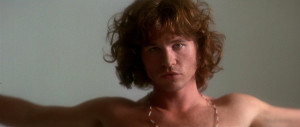
Kilmer perfectly recreates an iconic photo of Morrison.
Through those years of research I came to admire Stone’s work even more. It is impossible to sum up one man’s life in a single film, but Stone had come damn close. Though the surviving Doors disagree, my own readings show that Stone was mostly factual. With any real-life scenario there are different accounts of what happened, and even among the band there are disagreements about what in the film is fiction.
In the end, as with all biographies, some characters were combined or cut out, but it seems that Stone’s film did not indulge in the over-fictionalization and emotional shortcuts that are the hallmark of the genre. Even good biopics, like Dragon, rely on this crutch more than The Doors appears to have.
But beyond facts, Stone created a film that wasn’t about Jim Morrison, it was about being Jim Morrison. You didn’t need to see his every aspect so much as understand his point of view, and that is captured perfectly on film. Despite the seriousness of the subject, and contracts with Courson’s family and the remaining Doors, Stone kept the film light, fun, and trippy. He even avoided his JFK downfall — he never indulged a conspiracy theory over Morrison’s mysterious death in a bathtub. Several books propagate urban legend that Morrison’s death was faked, that Mr. Mojo Risin’ (an anagram of Morrison’s name) was living somewhere in Africa, and some day the world would witness the return of The Lizard King. That is subject material that seems tailor-made for Stone, but he does not follow the impulse. The result is a biopic that works as a movie, and a film that entertains as it educates.
Yes, while I only see most biopics due to an interest in the subject matter, this one was the total opposite — the biography film made me an uber-fan of the subject!
To this day The Doors is a film I watch regularly. It has stood the test of time better than its lead actor or its director. It has become iconic in my own mind, and when I envision Morrison in my head I’m never sure if I’m seeing Kilmer or Jim.
In the end, it doesn’t matter — for in this film they were one in the same.
Tomorrow — 1992!
Arnie is a movie critic for Now Playing Podcast, a book reviewer for the Books & Nachos podcast, and co-host of the collecting podcasts Star Wars Action News and Marvelicious Toys. You can follow him on Twitter @thearniec
August 21, 2014 Posted by Arnie C | 40-Year-Old Critic, Movies, Music, Now Playing Podcast, Podcasts, Reviews | 40-Year-Old Critic, Biography, Biopic, Documentary, Drama, Movie, Movies, Now Playing, Now Playing Podcast, Oliver Stone, Podcasts, Review, Reviews, Rock, The Doors, Val Kilmer | 4 Comments
40 Year-Old-Critic: Pump Up The Volume (1990)
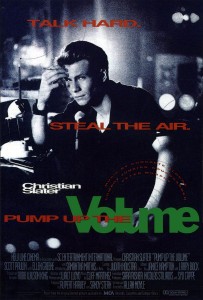 In The 40-Year-Old Critic, Venganza Media creator and host Arnie Carvalho recalls a memorable film for each year of his life. This series appears daily on the Venganza Media Gazette.
In The 40-Year-Old Critic, Venganza Media creator and host Arnie Carvalho recalls a memorable film for each year of his life. This series appears daily on the Venganza Media Gazette.
Okay, down to business. I got my Wild Cherry Diet Pepsi, and I got my Blackjack gum here, and I got that feeling… mmmm… yeah, that familiar feeling, that it’s time to write another movie review.
I think every generation of teenagers has a movie that speaks to them directly. Maybe it’s Rebel Without a Cause or The Breakfast Club or Mean Girls or High School Confidential; there is always a movie that can perfectly capture on screen a snapshot of your fears and concerns, along with the overall attitude of American youth.
For many people my age — the younger members of Generation X — that film is 1990’s Pump Up the Volume, and it is in a large part the reason that I’m writing this entire review series.
The film stars Christian Slater as Mark Hunter, a high school student recently transplanted from New York to Arizona. At school he is an introverted kid who stumbles over his words and mumbles when called on in class. But by night Mark rocks out as Happy Harry Hard-On, a pirate radio DJ — his name stolen from the initials of the Hubert H. Humphrey High School he attends.
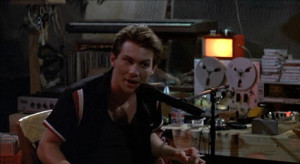
This looks like my studio. Only I have more toys, less records, and no reel-to-reel tape…but that would add atmosphere.
The show becomes a cult phenomenon at the school, with kids gathering nightly to listen in the remote locales that afford the best reception for Hard Harry’s low-powered FM transmission. Their communal experience stretches across class lines and cliques; and while Harry is simulating masturbation and playing banned Beastie Boys songs, he’s unaware that kids are looking up to him. As the audience grows Harry becomes an over-the-air Dear Abby for these pimple-popping pubescents. Unfortunately, one teen reaches out to Harry for help, and, when not satisfied with the response, commits suicide.
This leads to a contrived plot involving police and the FCC tracking down Mark on charges of criminal mischief. The film takes some Goonies-like kids-know-more-than-adults turns that stretch suspension of disbelief, and the last 30 minutes kind of fall flat as Mark tries to outsmart his pursuers. But the first hour truly succeeds in capturing the feeling of teen angst and insecurity shared by many high school students.
I know this film spoke to me in 1990. Like Mark, I had just moved to a new city, changing high schools in my junior year. That was my second move in three years, and I would live in five different cities over the span of four years. I always managed to make a small group of friends, but I understood Mark’s frustration. Also, like Mark, I avoided much of the situation by throwing myself into entertainment, be it books or films.
Each time I moved and lost contact with friends I’d have more free time to fill. Mark might as well have been speaking for me when he said, “I just arrived in this stupid suburb. I have no friends, no money, no car, no license. And even if I did have a license all I can do is drive out to some stupid mall, maybe if I’m lucky play some fucking video games, smoke a joint and get stupid. You see, there’s nothing to do anymore. Everything decent’s been done. All the great themes have been used up, turned into theme parks. So I don’t really find it exactly cheerful to be living in the middle of a totally exhausted decade where there’s nothing to look forward to and no one to look up to.”
Mark provided verbalization of my first post-modern early-life crisis.
My connection to this character was strengthened by Slater’s previous role as angsty, homicidal high school student J.D. in the dark comedy Heathers.
That film introduced me to the actor and his Jack Nicholson-esque delivery, and that’s why I was drawn to Pump Up the Volume. I have to say up front that Heathers is the better of the two films; both smarter and funnier.
In both films Slater’s character is an angry high school loner who seduces a brunette co-star while revealing the social hypocrisies that surround him. In many ways I saw Pump Up the Volume as a softer, less violent imitation of Heathers. I connected to Mark far more than J.D., the latter character’s mad bomber twist taking it a step too far.
As Mark, Slater took that angst and destroyed the school with words instead of dynamite. Through his one-man show he brought down a corrupt administration, got the girl, and made dozens of teens feel good about themselves.
It is the last point that gives Pump Up the Volume its power. Students call Harry’s hotline with problems so varied that everyone can find something to which they can relate. One pretty blonde girl is tired of pretending to be perfect. A gay teen is frustrated at the bullying he suffers. Another girl is kicked out of school after finding out she’s pregnant.
Gay or straight, male or female, fat or thin, Harry has self-affirming words of wisdom for you: “Feeling screwed up at a screwed up time in a screwed up place does not mean you are screwed up.”
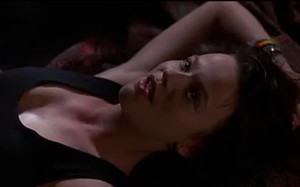
All my listeners have this look of orgasmic rapture on their faces when listening to my podcasts, right? No??
Don’t destroy my fantasy!
In that way Harry becomes a horny radio version of Robin Williams’ John Keating from Dead Poets Society. He realizes that teenage years bring pain, but he’s wise enough to know it’s temporary and won’t matter in five years. (That Mark espoused this so convincingly while also lamenting his own station in life is a dichotomy the script never cares to rectify.)
Mark lives a Superman-like lifestyle. He is a geek by day, and even wears glasses to hide his identity. By night he takes the glasses off and is a microphone superhero. To the teens in his audience, and this teen watching the film, he was an inspiration.
I mentioned in my review of Wall Street that, after seeing that movie, I had no career ambition. Turning 16 years old but having no concept of career goals was frightening. Soon I would have to pick a college, a major, a career, and I had nothing. Yet Happy Harry Hard-On sparked something inside me. He made me realize the true power of words, and how few things are more insidious than a whisper in your ear; few things more important than entertainment that can lift your spirits after a terrible day. Pump Up the Volume made me want to be an entertainer, and, while I would experiment with several avenues, that goal of bringing light to peoples’ day never changed.
In fact, I took a fairly direct path from Pump Up the Volume. Three years after seeing this movie I became a DJ at my college radio station. I never found corruption in the school administration, but I did smoke my share of cigarettes while lamenting into a microphone and wondering if anyone was out there listening. I do know I remotely deejayed a number of parties on and off campus.
And I played more than my share of Leonard Cohen songs. I also must credit Pump Up the Volume for broadening my musical tastes. Cohen’s song “Everybody Knows” launched Harry’s every broadcast and its cynical lyrics resonated with me:
Everybody knows that the war is over
Everybody knows the good guys lost
Everybody knows the fight was fixed
The poor stay poor, the rich get rich
That’s how it goes
Everybody knows
Cohen’s sonorous voice sounded like a funeral march, and this became my anthem. I bought the Pump Up the Volume soundtrack immediately. Though I was disappointed that Cohen’s version of “Everybody Knows” was absent, replaced by Concrete Blonde’s cover, that CD introduced me to the Pixies and Henry Rollins, along with Soundgarden and Sonic Youth years before they broke into the mainstream.
I finally rediscovered Cohen a few years later, but that will be discussed in time.
I still live with Pump Up the Volume as an influence on my life, though as an adult I find few of the characters relatable; my own teenage angst and awkwardness are now, fortunately, long buried in the past. Yet, as I mention this film — which I long considered an obscurity — to people around my age I find we, like Harry’s on-screen audience, had a shared communal experience. Pump Up the Volume became a film that, despite its faults, resonated with us.
Rewatching this film to prepare for this review I found myself connecting with Hard Harry in a new way. When he finally tells the story of how he got started with his pirate radio, it was a familiar one. He started broadcasting thinking no one, or perhaps one special person, was listening. Slowly he realized his show was picking up steam. It was an incredible dream, and one I think nearly every podcaster shares.
Every podcast begins the same way: someone picks up a microphone and starts talking with no clue if anyone will listen. Some shows may have better odds than others, being featured on other podcast feeds and the like, but I know when I recorded my first episode of Star Wars Action News I wondered if anyone would ever hear it. That it got 50 downloads in the first week floored me, that was a number far greater than I’d ever dreamed. I continued to record, and people continued to listen. Like Harry experienced in this movie, my audience grew.
Podcasting is the new pirate radio, and we operate outside the purview of the FCC. And as Harry does at the end of the film I urge each of you to, “seize the air. Steal it! It belongs to you! Speak out! They can’t stop you. Find your voice and use it! Keep this going! Pick a name, go on air. It’s your life, take charge of it. Do it, try it, try anything. Spill your guts out, say shit and fuck a million times if you want to, but you decide. Just fill the air! Steal it! Keep the air alive!”
Until tomorrow’s entry, talk hard!
Tomorrow: 1991
Arnie is a movie critic for Now Playing Podcast, a book reviewer for the Books & Nachos podcast, and co-host of the collecting podcasts Star Wars Action News and Marvelicious Toys. You can follow him on Twitter @thearniec
August 20, 2014 Posted by Arnie C | 40-Year-Old Critic, Movies, Now Playing Podcast, Podcasts, Reviews | 1990s, 40-Year-Old Critic, Christian Slater, Drama, Enertainment, Leonard Cohen, Movie, Movies, Now Playing, Now Playing Podcast, Podcasts, Pump Up the Volume, Review, Reviews, Samantha Mathis | 1 Comment
40 Year-Old-Critic: When Harry Met Sally (1989)
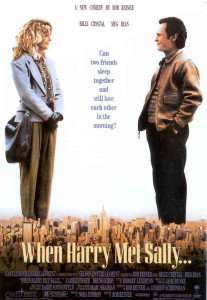
In The 40-Year-Old Critic, Venganza Media creator and host Arnie Carvalho recalls a memorable film for each year of his life. This series appears daily on the Venganza Media Gazette.
On Now Playing Podcast my co-hosts Stuart and Jakob often joke about my affinity for romantic comedies, or “RomComs.” I don’t mind the jokes. After all, it does seem that I tend to go to this lighthearted genre whenever discussing works of actors and filmmakers.
A History of Violence star Maria Bello? First saw her in Coyote Ugly and loved her in The Cooler.
I researched the work of The Wolverine director James Mangold by watching the atrocious Kate & Leopold.
Even mo-cap pioneer Andy Serkis — we actually see his face in 13 Going on 30.
The list goes on and on. I never analyzed my proclivity for these films, but the repeated jesting had me reflect a bit on why I spent time watching them in the first place. It quickly became clear that I chose to see those movies and more because of When Harry Met Sally.
When Harry Met Sally was released in the summer of 1989, which, at that point, might have been the biggest moviegoing summer in Hollywood history. Films like Star Trek V, Indiana Jones and the Last Crusade, Batman, Ghostbusters II, and Back to the Future Part II were all unleashed within weeks of each other.
With these blockbuster heavy-hitters on the calendar, Rob Reiner’s romantic comedy was not the No. 1 film on my “must see” list, but it was up there.
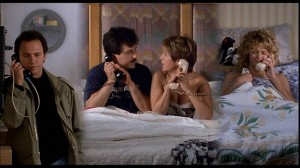
Crystal, Kirby, Fisher, and Ryan engage in 4-way split-screen action.
Part of the draw was the talent involved. I had liked Meg Ryan in Innerspace, and, although I was too young to appreciate the genius of Soap, Billy Crystal had really impressed me with Throw Momma from the Train.
But the biggest draw was Reiner. While I grew up watching “Meathead” on All in the Family, I’d already come to respect him as a director after seeing Stand by Me, The Princess Bride, and even the John Cusack comedy The Sure Thing.
Also, if I’m going to be completely honest, there was another big draw: Sex.
I was in my early teens and dating was a frustrating, confusing experience. I was also learning about sex through government-mandated public school health class as well as… extracurricular materials. As a boy desperately wanting to gain insight into the female brain, this film seemed like a wealth of knowledge.
The trailers teased wise phrases such as “Men and women can’t be friends, the sex part always gets in the way.” Was that true? It boggled my adolescent mind to ponder.
And there was the clip of Meg Ryan performing Sally’s fake orgasm in Katz’s Delicatessen. Yeah, I really wanted to know more about that!
Getting into the theater was a tricky proposition for someone three years shy of the 17-year-old threshold for R-rated films. I eventually convinced my prudish 21-year-old sister Michelle and her husband to take me.
I know that at 13 I didn’t get all the jokes or understand the subtle nature of some of the humor (I also totally didn’t recognize “Princess Leia” Carrie Fisher as Sally’s best friend Marie). Still, I was taken by this film and its world.
Crystal was funny and salacious as Harry. I was won over by this libidinous lothario early on, during the car ride when Harry propositions Sally despite the fact that he’s dating her best friend. Crystal’s timing is spot-on. In the hands of another actor this type of introduction could have alienated the audience, but Crystal’s light hearted delivery, his sparkling eyes, and his disarming smile made Harry the type of character men could root for and women could come to love.
As Sally, Ryan gave the performance of her life. I developed a major crush on Sally and, due to this, I saw most of Ryan’s work. The success of this film made her a hot property, but from Flesh and Bone to I.Q. to The Doors, no performance she has ever given comes close to matching the one she gives here.
I believe part of this is because of the way Ryan threw herself into the role, right down to the deli orgasm scene. While some actresses may have shied away from such an extreme moment, this scene was actually Ryan’s idea. With physical comedy, self-effacing stumbles, and great delivery, she gave her all to When Harry Met Sally.
More, I think her co-stars, primarily Crystal and Bruno Kirby, were so amazing that Ryan’s game was elevated.
Thanks to the performances from the two leads and a script by Nora Ephron, Reiner created the perfect romantic comedy; one that appeals equally to men and women. The movie delicately balanced the two points-of-view and at no point while watching When Harry Met Sally did I feel I was watching a “chick flick.” To me it was just a comedy film.
Not only did this film make me fall in love with Sally; I fell in love with New York City. This was the first time I’d seen New York truly romanticized on screen. Sure, Ghostbusters, Splash, and Short Circuit 2 were among the many movies set in the Big Apple, but this film truly drove home to me the differences between New York and other cities where I’d spent considerable time, such as Chicago or Fort Myers, Florida. The use of cabs for transportation, the unlikely experience of running into old acquaintances in a city with 8 million residents, the difficulty of taking home a Christmas tree in a town that relies on public transportation — I saw it all for the first time in When Harry Met Sally. This was the first movie that I realized to be as much about a place as the people.
Reiner deserves so much praise for the way he structured the film; using holidays to show the passing of time, the split-screens during the four-way phone call, the rapid-fire quips — honestly, I could gush about this film for pages. It is one of those movies that just came together and made on-screen magic.
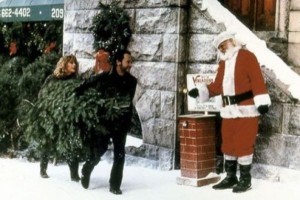
When Harry Met Sally is the perfect movie to watch between Christmas and New Year’s–a perennial holiday favorite.
This was my first foray into truly adult comedy, as compared to the Eddie Murphy comedy that just used adult language. When Harry Met Sally has adults dealing with issues of age, marriage, and commitment; and doing so in a funny way.
I left the theater still pondering the question of whether men and women can be friends; but I was certain that, through Sally, I’d gotten a glimpse into the workings of the fairer gender. I certainly didn’t know all I needed to know, but I felt that I’d been educated (through the film’s female perspective) as well as entertained (by the film’s male point of view).
I wanted to know more, and I wanted to laugh as hard as I did in that theater. Because When Harry Met Sally was such a success, the comedies of the 1990s and 2000s kept copying Reiner’s formula, and I watched dozens of them hoping to feel the same as I did in 1989.
I followed Ryan to French Kiss, Sleepless in Seattle, Addicted to Love, and many more hoping to see, but never finding, the magic she possessed as Sally. Only You’ve Got Mail came close.
I also followed Billy Crystal to the forgettable Forget Paris, but enjoyed his comedy more in City Slickers and Analyze This.
When neither Crystal nor Ryan repeated their success I tried to find this type of on-screen chemistry with other known actors. From Sandra Bullock and Bill Pullman in While You Were Sleeping, to Nicholas Cage and Bridget Fonda in It Could Happen to You, to several Friends stars in films best forgotten, I watched them all.
Most of them were terrible.
Not only did these movies lack the insight and wit of When Harry Met Sally, the genre itself slowly degenerated before my eyes. Initially the films would try to replicate Reiner’s delicate balance of romance and comedy, but in time they changed to focus far more on the romance, less on the comedy, becoming base female wish fulfillment. By the mid-90s the vast majority were, indeed, the “chick flick RomComs” that Jakob taunts me for watching. There were a few gems in the bunch, such as The Wedding Singer, There’s Something About Mary, Bridget Jones’ Diary and The 40-Year-Old Virgin, but, by and large, they were junk that left me bored.
But if I was not entertained, was I educated? Did this deep dive into the world of female-targeted cinema give me insights into women? Well, in the past 25 years I’ve learned a lot, and mostly it’s that everyone is a unique individual. My quest to learn some magic secret about “all women” was doomed to fail because each woman is her own person. I learned that not through film, but through dating and, eventually, marriage.
I also learned the answer to Reiner and Ephron’s main question — yes, men and women can be friends. The best marriages are those where the two are friends. I feel lucky to have that where my best friend is my wife.
So maybe When Harry Met Sally taught me something after all.
Tomorrow: 1990!
Arnie is a movie critic for Now Playing Podcast, a book reviewer for the Books & Nachos podcast, and co-host of the collecting podcasts Star Wars Action News and Marvelicious Toys. You can follow him on Twitter @thearniec
August 19, 2014 Posted by Arnie C | 40-Year-Old Critic, Movies, Now Playing Podcast, Podcasts, Reviews | 1980s, 40-Year-Old Critic, Billy Crystal, Bruno Kirby, Carrie Fisher, Comedy, Meg Ryan, Movie, Movies, Now Playing, Now Playing Podcast, Orgasm, Podcasts, Review, Reviews, Rob Reiner, Romance, Romantic Comedy, Romcom, When Harry Met Sally | Comments Off on 40 Year-Old-Critic: When Harry Met Sally (1989)
40 Year-Old-Critic: Hellbound – Hellraiser II (1988)
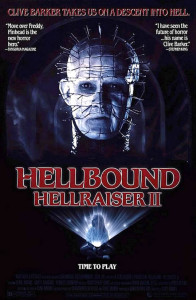 In The 40-Year-Old Critic, Venganza Media creator and host Arnie Carvalho recalls a memorable film for each year of his life. This series appears daily on the Venganza Media Gazette.
In The 40-Year-Old Critic, Venganza Media creator and host Arnie Carvalho recalls a memorable film for each year of his life. This series appears daily on the Venganza Media Gazette.
When I was young I was scared of horror. Not horror films, mind you, but the actual concept of horror petrified me. I mentioned in my earlier article discussing 1979’s Love at First Bite that even watching Dracula on television required an adult be home to protect me.
Yet, I was curious… I wanted to see it while I was frightened of what I might find.
The best analogy I can use for my view of horror is, indeed, the Lament Configuration puzzle box featured in the Hellraiser movies. I was a voyager seeking forbidden knowledge, but once the box was opened the pleasures, and terrors, inside would forever be unleashed. If I watched a horror film the hooks would be in my flesh, and what I would see were images relegated to the domain of nightmare.
I wanted to go there, but I took tentative steps over several years. As a very young child I stuck mostly to the safe horrors of Scooby-Doo ghosts and the seemingly supernatural mysteries in The Three Investigators young adult novels. At age 7 I tried to stretch my own limits by leaving the safety nets of kiddie fare behind and attempting to endure adult horror.
I saw The Shining on television in the early 1980s and was petrified by the decaying woman in the bathtub. I watched Frank Langella in Dracula around the same time. I would see ads for horror films like Return of the Living Dead, Friday the 13th, and Psycho III, read the reviews, and talk endlessly about them with classmates.
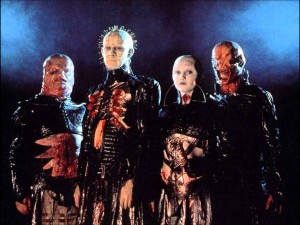
Like the cenobites I too wanted to explore the further regions of horror.
Finally, when I was 8 years old, I tried to face horror. I came home from school one day to find our hosted teenage exchange students were watching Friday the 13th on the VCR. My afterschool ritual was to watch a movie, often Star Wars or Grease, but these Brazilians had monopolized the machine. I was not going to change my routine, so if I could not pick the movie then I would just watch theirs. Not five minutes passed before I saw Mrs. Voorhees decapitated and I fled the room.
That image haunted me for years.
But as I grew into adolescence I wanted to stretch my boundaries further, and I did, starting with horror novels. I found the page safer than the screen, as the written word was always limited by the boundaries of my own imagination. I went further at age 12 and had my first horror movie marathon with the A Nightmare on Elm Street 1 and 2. While I did have a few nightmares of my own I loved every minute of it. I immediately started to consume all the horror I could, reading Fangoria magazine and watching more Stephen King films, the Friday the 13th series, Child’s Play, The Lost Boys, and more.
Within a year I was still captivated, but also starting to bore of the same routine. The vast majority of horror films I watched were slashers, each starring a new group of stereotypical teen characters taken to the slaughter. I had entered the realm of horror to stretch my boundaries, but I just found the same stories again and again. I had faced those fears and I wanted more. I wanted to be tested anew.
Then came Hellbound: Hellraiser II. I had known about the original Hellraiser from the ads. Stephen King’s words were put on the movie screen in a giant font: “I have seen the future of horror and his name is Clive Barker.” Trailers for the first Hellraiser raised my curiosity but the film never came to my town. In 1988, before I’d even had a chance to see Hellraiser on video, its sequel Hellbound came to theaters. The monstrous-looking Cenobites graced the poster. In the movie these creatures described themselves as, “Explorers in the further regions of experience. Demons to some, angels to others.” They were just what I wanted.
Being only 13, I couldn’t find any adult foolish enough to take me to see Hellbound. My parents were lax and would buy me tickets to A Nightmare on Elm Street films, but something about the Hellraiser series made them nervous. I had to wait for video, but the day Hellbound hit VHS I rented it and its predecessor.
I don’t know what I expected the movie to be, but my memory was of fevered excitement. I was going to see something forbidden; I expected something akin to a snuff film. I expected to be changed.
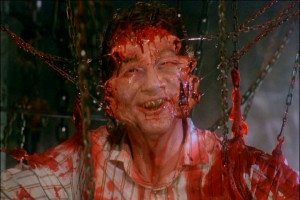
I wanted extreme…I got it. This was one of the first frames I saw of Hellraiser.
By complete accident I put Hellbound in the VCR first and it opened with a montage of the goriest, scariest scenes from the first film. I saw Larry (Andrew Robinson), his flesh stretched by hooks on chains. His distended face leaked more than just blood, and he slurred a blasphemous “Jesus… wept” before exploding into chunks of flesh.
Just these opening frames of Hellbound were an orgy of death and carnage. I was scared. I was nauseated. I was excited. I couldn’t bear to watch, yet I couldn’t turn away.
I had found exactly what I wanted in that damned puzzle box.
Eventually the opening credits started and I hit “stop” so I could watch the films in the correct order. I realized that this was not a Faces of Death-type snuff film but rather a mostly conventional horror film with a crazy woman seducing men and then killing them. Still, I had found a horror more pure, and more imaginative, than even Freddy. Pinhead and his varied demonic cohorts were immortal evil incarnate.
The first film had the better gore, but the second expanded the world further. In Hellbound we got to see the creation of a cenobite and travel to their labyrinthine realm; all taking place in an insane asylum — the heart of madness.
Yet the entire mad experience was accompanied by an amazing orchestral score by Christopher Young. From the disarming lullaby that played when the box was opened to the crescendos that sound like the soundtrack for the end of days, Young’s score stuck with me every bit as much as the latex work. I was no fan of Young’s given his “whale song” music for A Nightmare on Elm Street 2: Freddy’s Revenge but he redeemed by Hellraiser. I’ve still not heard a score he’s done better.
In the years since seeing Hellbound I have encountered many horror fans who claim the original Hellraiser is the only one worth watching. I disagree. Perhaps it was because I experienced them as a double-feature, prompted by the marketing for Hellbound, but I see the first two Hellraiser films as parts of a whole.

The matte work may not be cutting edge but Hellbound expanded the mythology of the Hellraiser franchise.
Yes, the first movie had a more visceral feel, but it also had long scenes of Kirsty Cotton (Ashley Lawrence) walking the streets of London. The sequel truly fulfilled Kirsty’s character arc and allowed her to escape the madness forever, or at least until the direct-to-video Hellraiser VI.
After seeing Hellraiser and Hellbound I felt I had gone to the limits of horror. I tried to explore further by reading Clive Barker’s books and seeing his follow-up films Nightbreed and Lord of Illusions. They couldn’t live up to the horrors of Hellraiser.
Repeatedly I’ve felt that Barker is the man who comes closest to taking the terror of nightmares and putting it on the page or screen, but he always falls just short.
For more than a decade the Hellraiser duology would be my bar for terror and horror, and they are both films I appreciate to this day.
I continue to try and find new boundaries to push in every aspect of life. I find contentment to be equal to death and I want to be pushed further. In the 25 years since first seeing Hellbound I’ve discovered films that grossed me out more (Human Centipede comes to mind), but none that felt as forbidden as the first two Hellraiser films.
I will continue to find the next cinematic puzzle box, and when I find it I’ll open it without hesitation.
Tomorrow: 1989!
Arnie is a movie critic for Now Playing Podcast, a book reviewer for the Books & Nachos podcast, and co-host of the collecting podcasts Star Wars Action News and Marvelicious Toys. You can follow him on Twitter @thearniec
August 18, 2014 Posted by Arnie C | 40-Year-Old Critic, Movies, Now Playing Podcast, Podcasts, Reviews | 1980s, 40-Year-Old Critic, Barker, Books, Books & Nachos, Cenobite, Clive, Clive Barker, Enertainment, Film, Hellbound, Hellraiser, horror, Movie, Movies, Now Playing, Now Playing Podcast, Pinhead, Podcasts, Review, Reviews, Sequel | 1 Comment
40 Year-Old-Critic: Wall Street (1987)
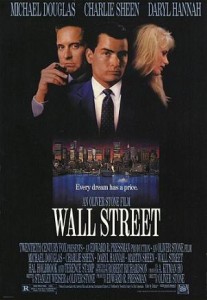
In The 40-Year-Old Critic, Venganza Media creator and host Arnie Carvalho recalls a memorable film for each year of his life. This series appears daily on the Venganza Media Gazette.
Growing up I wanted to be a stockbroker. Other kids said they wanted to be astronauts, movie stars, or firemen; I said stockbroker. In my preteen years I upgraded that to investment banker.
Why wouldn’t I want to go into that world? I grew up in the big 80s, the era of Reaganomics. Money was being flashed everywhere, and it wasn’t just the musicians and actors who had rich and famous lifestyles; there were also names like Ivan Boesky, Carl Icahn, Jordan Belfort, and Donald Trump.
My godfather, who rode the stock market to a healthy retirement, told me that the brokers had the best gig — no matter if their clients won or lost, the broker got the commission.
What did I really want to be when I grew up? I wanted to be rich. I saw the stock market as the avenue to that lifestyle. When I turned 13 I even became a stock owner, my godfather buying me some shares of Ohio-Edison.
That dream crashed in 1987, starting with Black Monday, when the Dow Jones Industrial Average dropped 508 points (which would still make headlines today, but back then it was almost 25 percent of the Dow’s value). I heard stories of broker suicides and rich people in ruin. My faith in the avarice of the economy was shaken.
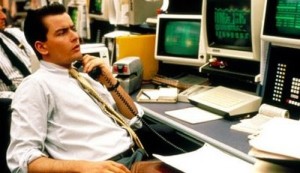
As a child this wasn’t how I envisioned the job of a stock broker.
It was broken entirely two months later when I saw Oliver Stone’s Wall Street. I had looked forward to that film for months. I didn’t know much about Stone (I hadn’t yet seen Platoon), but I knew his name and his Oscar-winning reputation.
Had I researched the man further I would have known that Wall Street wasn’t going to be what I expected, which was a more realistic version of The Secret of My Success.
Instead I saw a film to which I could relate a bit too well. Charlie Sheen played Bud Fox, an up-and-coming broker barely making ends meet. The early scenes that give you a glimpse into the life of the average, front-line broker did not depict the glamorous lifestyle I’d seen on television — it actually looked like Bud might have earned less than a talented bartender.
The high-pressure nature of the business and the cold-call sales techniques combined to make Bud hungry and bitter. Even as a kid I could relate to him; his drive to get out of the phone pool and make a name for himself.
But then we were introduced to Michael Douglas as Gordon Gekko. I had seen Douglas a few months earlier in Fatal Attraction and thought of him as a good guy. In Wall Street he’s a ruthless, wealthy businessman, but I envisioned him almost as a guardian angel that would show Bud the road to riches.
Instead Gekko turned out to be a greedy, deceitful, vengeful criminal. He corrupted Bud with promises of women and riches until the young businessman betrayed his own father in service of his mentor.
Bud redeemed himself — he came up with a plot to save his father’s company — and served time for his misdeeds, but as Sheen’s character was taken to prison I found myself finally questioning this lifestyle I had coveted for years.
Stone told the story exactly how it should have been told in 1987; show the flash, the cash, the allure of riches in the big 80s. Then show the cost, including the broken relationships, the drug hangovers, and the realization that Bud’s “friends” (and even his girlfriend) all disappeared when the money was gone.
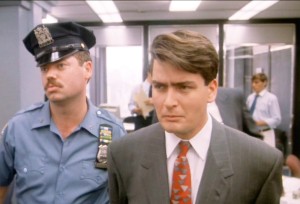
This was the image that struck me hardest from the film. Not the penthouse, not the girl, but the consequences.
This was a movie with a social commentary, and one that should have been made louder and more often in the 80s. The “Greed is Good” mentality prevailed as the economy boomed, but while the success stories got the press, little attention was paid to the illegal and immoral activities undertaken by so many to achieve those ends.
More, the film could not have had a luckier release schedule, if you can ever call Black Monday “lucky.” The stock market was on everyone’s minds and tongues, questioning this ethereal concept of non-liquid assets in a grand trading scheme. Stone’s message rang true, for a period.
I now feel the message of Wall Street has been lost. The stock market is more vital to the lives of Americans than ever thanks to 401(k) plans and other reliances. Despite the crash of the NASDAQ at the turn of the century (when several of my close friends lost everything) and the crash of the Dow in 2007, it seems Americans still like to play the market like a Blackjack table.
More, Gordon Gekko and his “Greed is Good” speech have become lionized by today’s hungry, young businessmen. Even this year’s The Wolf of Wall Street seemed to play up the glamour of Jordan Belfort’s illegally-funded lifestyle rather than focus on the victims he snookered.
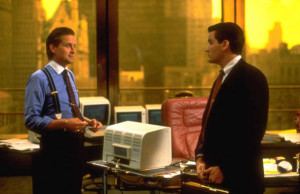
“Please allow me to introduce myself. I’m a man of wealth and taste.”
Had Stone been a different filmmaker and Wall Street a more Wolf-ish tale perhaps my ambitions would have redoubled. I might be a very wealthy man today, or I might be in prison. Fortunately I saw the right movie at the right time. In 1987 and now, Stone’s message rang true. I went in wanting it all, and I left the theater a boy without a goal, perhaps slightly more normal for that.
For that life-changing course — setting me on a path where I would end up helping people by day and entertaining people by night — Stone’s film will always remain a profound symbol of how art can change the direction of your life.
Not all films are pure entertainment, the best ones raise questions as well.
Tomorrow — 1988!
Arnie is a movie critic for Now Playing Podcast, a book reviewer for the Books & Nachos podcast, and co-host of the collecting podcasts Star Wars Action News and Marvelicious Toys. You can follow him on Twitter @thearniec
August 17, 2014 Posted by Arnie C | 40-Year-Old Critic, Movies, Now Playing Podcast, Podcasts, Reviews | 1980s, 1987, 40-Year-Old Critic, Bud Fox, Charlie Sheen, Enertainment, Film, Gordon Gekko, Michael Douglas, Movie, Movies, News, Now Playing, Now Playing Podcast, Oliver Stone, Podcasts, Review, Reviews, Stock Market, Wall Street | 2 Comments
40 Year-Old-Critic: Howard the Duck (1986)

In The 40-Year-Old Critic, Venganza Media creator and host Arnie Carvalho recalls a memorable film for each year of his life. This series appears daily on the Venganza Media Gazette.
In 1986 I was obsessed with, and repulsed by, one film.
It starred a creature not entirely human, nor entirely animal.
The creature wanted to mate with its frizzy-haired, yet attractive, female co-star.
The film also featured a teleportation plot and a once-gentle scientist that slowly transforms into a beast.
That film was David Cronenberg’s remake of The Fly, and even its trailers scared the bejesus out of me. Those trailers ran before nearly every movie I watched. I was 11 years old, but still needed to leave the theater when I’d see The Fly approaching.
I was afraid. I was very afraid.
If I was writing this retrospective before 2011, this article would have focused on that film and how it pushed my adolescent boundaries into new territories.
But now I am going to write about Howard the Duck.
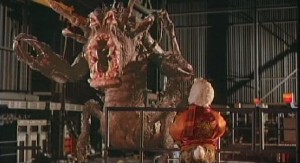
This is what I see in the ink blot…
Or, more accurately, I’m going to write about talking about Howard the Duck. I think I’ve said everything I needed to say about the notorious 1986 bomb three years ago when I reviewed it — alongside co-hosts Stuart and Jakob — for Now Playing Podcast. I discussed seeing the film in theaters, reading the novelization (which I reviewed as well, on the Marvelicious Toys podcast), and even seeing the Dark Overlord in a Rorschach Test. After more than two hours discussing Howard the Duck, what more could I have to say?
Plenty, it turns out. It was a complete accident, but Howard the Duck changed my life.
As I discussed on that show, I’d always had a kitschy fascination with George Lucas’ follow-up to Return of the Jedi. I knew people hated it, but didn’t understand why. It followed the Ghostbusters formula to a T: creatures from another plane come to Earth, wacky scientists try to determine the cause, and hilarity ensues. It even ends with one of the main characters transforming into an evil beast and the fate of the world determined by an animated laser battle between the heroes and giant, evil creatures.
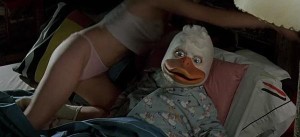
“They let kids watch this film????”
I loved Ghostbusters, and I loved Howard the Duck even more — as Sigourney Weaver’s Dana never wore anything close to the slinky, sexy outfit that perfectly framed Lea Thompson’s Beverly.
Though it had been 25 years, I was excited by the chance to review Howard the Duck for Now Playing Podcast. Our movie review show was coming up on its 4th anniversary and it had always been a way for me to discuss films for which I had passion. Whether I loved a film or hated it, if I felt something then I wanted to talk about it.
Around this time the show was also finally starting to find some success. Our early, short-form reviews had downloads that measured in the teens. With our Friday the 13th Retrospective Series — something I envisioned as a quick one-off — downloads jumped from the teens to the thousands.
We continued to work hard and over the years our audience started to find us. We were still a small fish in a large sea, but we had grown from a dwarf puffer to at least a catfish.
The success of our 2010 A Nightmare on Elm Street series emboldened me, and, that same year, Iron Man 2 inspired me. After seeing Iron Man, War Machine, Nick Fury, and Black Widow share the screen I could not contain my excitement for The Avengers. So I pitched to Stuart and Jakob the biggest retrospective series ever: all of the Marvel movies, in order, starting with Howard the Duck.
There was quite a bit of negotiation, wrangling, and reordering of movies; but between May 2010 and March 2011 we came to an accord and the Now Playing Marvel Movie Retrospective began.
It was our biggest series, or biggest gamble, and it all hinged on Howard.
Perhaps it was the buildup, but that show always seemed special. We were coming off the Philip K Dick Retrospective Series, which had been pushed to Spring 2011 after The Adjustment Bureau’s release date changed. Downloads were low on the Dick series and there were some production issues. By the time we hit The Adjustment Bureau morale behind-the-scenes was low.
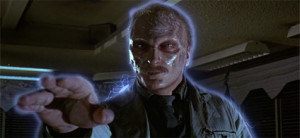 All of that changed with Howard. To my memory, that was the first Now Playing review that, in its raw audio, went more than three hours. Over the course of two years I had allowed Now Playing’s runtime to grow, but only one show had ever gone more than 2 hours: the 2010 review of the A Nightmare on Elm Street remake.
All of that changed with Howard. To my memory, that was the first Now Playing review that, in its raw audio, went more than three hours. Over the course of two years I had allowed Now Playing’s runtime to grow, but only one show had ever gone more than 2 hours: the 2010 review of the A Nightmare on Elm Street remake.
I spent about 80 hours editing our Howard the Duck review, trying to hold to the editor’s axiom of “kill your darlings.” But I just couldn’t do it.
Even during my 11th pass on the Howard the Duck review I was still laughing out loud at the jokes.
Before I even finished the edit I knew that show was something special. I just prayed it would find an audience.
It did.
Maybe it was the press releases I had sent, maybe it was the social media promotion, but for the first time, Now Playing Podcast broke through iTunes’ Top 10 TV/Film audio podcast rankings. It took a few days after the show was released, but we had done it!
That spot increased our visibility, and the downloads multiplied exponentially. To go from the unsuccessful Dick series to the top of the iTunes charts was just incredible. Howard the Duck became iTunes’ 5th most downloaded episode in the aforementioned category.
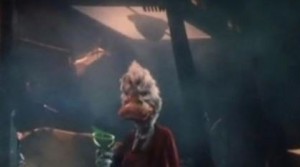
Howard had a theatrical come-back this year, but this mangy fowl is NOT my Howard! The costume in 1986 looked better than this.
The success was so astounding I actually hesitated before releasing the next show. I knew our Man-Thing podcast was also pretty funny, but the newest show is always the most downloaded. Downloads of Howard were sure to decrease.
Still, we had a schedule, and so Man-Thing went out on time, and became iTunes’ No. 1 most downloaded TV/Film audio podcast. The following week we reviewed Kick-Ass and it grabbed the No. 1 slot, pushing Man-Thing into second place.
Stuart, Jakob, and I were stunned. It was unbelievable to look at the iTunes rankings and see Man-Thing at the top. I have since joked that more people listened to our review of Man-Thing than actually saw that damn film.
One thing we all agreed on — it was Howard the Duck that launched those shows to the top. Howard was a special show, combining serious film criticism with a terrific dose of humor, making fun of ourselves as well as the film, and we knew that was why listeners kept coming back to our show.
Now Playing has had its ups and downs since then. Some shows and retrospectives click more with audiences than others, and some shows I am more proud of than others. Still, it was with Howard the Duck that all the pieces fell into place and listeners responded.
For those reasons I will always love that duck.
I have stated at least twice on the podcast that I wish I could turn that “Red Arrow” grade for Howard into a “Green Arrow” on our site. I realize the film has its flaws — I still believe the second act drags — but I enjoy it anyway. I gave Howard the review I did not because I didn’t like the movie, but because I didn’t think others would find the same enjoyment. After all, our end rating is always a “recommendation” and not a “thumbs up.” When I give the “Green Arrow” I’m not saying, “I like this movie,” I’m saying, “I think you will like this movie.”
Well, I knew back then that I liked Howard the Duck in spite of the flaws.
That fondness has grown as, through Now Playing, I’ve become closely associated with that “fowl” creature. Stuart and Jakob were with me in the review, but I was Howard’s champion (and the one that saw the Dark Overlord in a Rorschach test). Over the past three years that special relationship with this childhood guilty pleasure has grown.
I started collecting a few trinkets from the Howard the Duck film — the old trading cards, a candy cigar, a mini duck head that once held sugar treats. Then I got the Bowen statue, the Toy Biz figure. Finally, this year, I took the plunge — one of the Industrial Light and Magic creature shop workers was selling several Howard the Duck production pieces.
On my desk, a foot from me as I write, is a glass egg that Lucasfilm gave to crew and press back in 1986. Inside that egg is a single duck feather. The Howard the Duck logo on the front makes me smile, not because of that 1986 film about a duck trapped in a world he never made, but because of the podcast that I made that found its place in the world.
Tomorrow — 1987!
Arnie is a movie critic for Now Playing Podcast, a book reviewer for the Books & Nachos podcast, and co-host of the collecting podcasts Star Wars Action News and Marvelicious Toys. You can follow him on Twitter @thearniec
August 16, 2014 Posted by Arnie C | 40-Year-Old Critic, Comic Books, Marvelicious Toys, Movies, Music, Now Playing Podcast, Podcasts, Reviews | 1980s, 40-Year-Old Critic, Action, Collecting, Comic Books, Comics, Enertainment, Film, George Lucas, Marvel, Marvel Comics, Marvelicious Toys, Movie, Movies, News, Now Playing, Now Playing Podcast, Podcasts, Review, Reviews, sci-fi, Toys | Comments Off on 40 Year-Old-Critic: Howard the Duck (1986)
40 Year-Old-Critic: Goonies (1985)
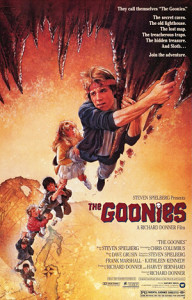 In The 40-Year-Old Critic, Venganza Media creator and host Arnie Carvalho recalls a memorable film for each year of his life. This series appears daily on the Venganza Media Gazette.
In The 40-Year-Old Critic, Venganza Media creator and host Arnie Carvalho recalls a memorable film for each year of his life. This series appears daily on the Venganza Media Gazette.
Tastes change through the ages. As a child I could not stand the bitterness of coffee, but now you wouldn’t want to engage me in conversation before my second cup. I also used to love maple sugar candy, a confection so sweet it made me gag when last I tasted it.
As it is with food and drink, so it is with movies.
Recently I attempted to watch The Goonies and I turned it off halfway through. It wasn’t the same.
But in 1985 I was a Goonie.
Executive produced by Steven Spielberg and directed by Superman’s Richard Donner, Goonies told the story of a group of pre-teen boys who lied to their parents, snuck out of the house, and saved the day. It was a film that continued a narrative Spielberg introduced in E.T.: a child outsmarting his parents and undertaking an adventure that would solve a family crisis and bring everyone closer together.
Surely every boy on the playgrounds of every school across America was the target audience for Donner’s film. Fat or thin, with or without braces, fast-talking or shy, there was a Goonie on screen with whom children and young teens could connect (Or at least every white child; the film lacked in diversity, with the only non-white child being an uncomfortable Asian stereotype).
For me, just 10 years old, I looked at the screen and saw myself as Mikey, the lead Goonie. Both of us were prone to flights of fancy, both of us would come up with crazy plans that often ended with my friends and I getting grounded, both of us still believed in the fantastical, and, hey, we were both asthmatic.
I was thrilled as the Goonies dodged booby traps and slid down a waterfall. I rocked out to the soundtrack featuring pop stars like Cindi Lauper and The Bangles. I shuddered when Chunk was locked in a room with the monstrous Sloth, and then cheered when the two became best friends and saved the day. I was engrossed as I watched the Goonies not only outsmart their parents, but also overcome the criminal Fratelli family. Truly this was a kid-power film if ever there was one!
At the time I didn’t see the movie for what it was: Indiana Jones for the playground set. Just look at all the booby traps, the majority of The Goonies could have been filmed on remnants left over from Temple of Doom.
Instead, I just went with the Goonie kids on their wild adventure to find One-Eyed Willy, and left the theater feeling that children could do anything. Parents were but unnecessary obstacles that tried to downplay the magical nature of the world.
This was the message I learned from so many films, from E.T. to Explorers to Cloak and Dagger to The Last Starfighter; but it was Goonies that drove it home. My childhood friends and I started to have our own misadventures, including the time we tried to catch some teenage drug-dealers by the mall, or when we started investigating ghosts that may or may not have haunted my house (both of these stories ended in humiliation and ruin).
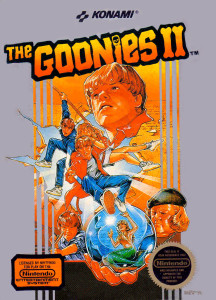
A couple years later my dream of Goonies 2 came true–but in a Nintendo game. My script was better; it didn’t have needless mermaids.
Even more though, if children could do anything, why couldn’t we actually be Goonies? By age 10 I was familiar with moviemaking — having watched many behind-the-scenes TV specials. I picked up movie magazines that had interviews and profiles with the actors and directors involved. The movie Clue, with its multiple, random endings, even started to give me ideas about marketing.
Not understanding the struggle child actors face trying to break into Hollywood, I was resentful of the Goonies casting and what I considered “Hollywood nepotism.” My Goonies Official Film Magazine made me realize all the Goonies were either actors who had been in other films (Corey Feldman and Jonathan Ke Quan) or children of famous people (Sean Astin and Josh Brolin). Obviously, boys from Springfield, Illinois, had no chance of being cast.
So I decided to make my own Goonies 2.
It had to happen — a 10-year-old boy obsessed with watching movies would surely turn into an 11-year-old who wanted to make movies. My parents had an 8mm film camera for family movies and, at age 8, I’d already filmed Star Wars 4: The Return of Darth Vader.
It’s a mostly ad-libbed, terribly embarrassing 10-minute-short that ended with Luke Skywalker and Darth Vader playing together in a swimming pool.
But I was now older, wiser, and had dreams of filmmaking.
Over the span of a month I hammered out a script for Goonies 2. The plot was simple enough: the jewels were not enough to save the homes and the Goonies had to go out and find even more money. With my best friend Stuart’s help we cast our friends and family in various roles. A group of us even successfully recreated some of Data’s gadgets, including a spring-loaded, belt-worn dart gun.
I clearly was not alone in this dream. Earlier this year I saw an episode of the ABC sitcom The Goldbergs in which lead character Adam tried the exact same thing! As this show is loosely based off the real life experiences of showrunner Adam Goldberg, I do wonder how many other kids across the country were inspired to grab cameras and try filmmaking because of this Donner-Spielberg adventure.
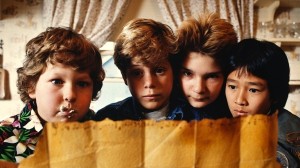
I felt “Good Enough” to hang with The Goonies
Fortunately, we never shot a frame of Goonies 2 — I doubt I could survive such embarrassment. The props were repurposed into a sixth-grade class performance for Goonies Cereal (we got an A). The script, typed in Wordstar on a NEC APC III, was lost when the 5.25-inch floppy was bent. My only memory of the script is my sister Linda saying she had memorized her dialogue. She was cast as Mama Fratelli, and all she did was scream.
Rewatching The Goonies recently, I imagine my 10-year-old self really did tap into the core of that film, because it’s full of screaming, shouting, hollering, and various other loud noises.
As an adult it was just an assault on my senses.
The film is too sugar-fueled, too chaotic, and too… kiddie for me to enjoy. But I will always have those memories of being 10 and dreaming I could be a Goonie.
So, if this were an episode of Now Playing Podcast, would I recommend The Goonies? Being a film critic means more than just saying “I liked a film.” Everyone has opinions, but an opinion is not a critique. While personal judgments will always play into a review, more must be taken into account in order to properly judge any creative work. Not every film is made for mass appeal, and sometimes focusing on a niche audience is key to a movie’s success. The Goonies clearly struck a chord with its core audience, and I can’t think of a higher recommendation than that.
Tomorrow — 1986!
Arnie is a movie critic for Now Playing Podcast, a book reviewer for the Books & Nachos podcast, and co-host of the collecting podcasts Star Wars Action News and Marvelicious Toys. You can follow him on Twitter @thearniec
August 15, 2014 Posted by Arnie C | 40-Year-Old Critic, Movies, Now Playing Podcast, Podcasts, Reviews | 1980s, 40-Year-Old Critic, Corey Feldman, Enertainment, Film, Goonies, Joey Pants, Josh Brolin, Movie, Movies, Review, Reviews, Richard Donner, Sean Astin, Sloth, Steven Spielberg | 1 Comment
40 Year-Old-Critic: Beverly Hills Cop (1984)
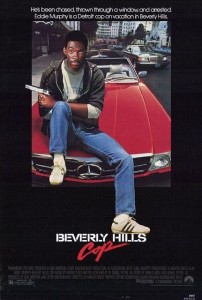 In The 40-Year-Old Critic, Venganza Media creator and host Arnie Carvalho recalls a memorable film for each year of his life. This series appears daily on the Venganza Media Gazette.
In The 40-Year-Old Critic, Venganza Media creator and host Arnie Carvalho recalls a memorable film for each year of his life. This series appears daily on the Venganza Media Gazette.
For as long as there have been movies, there have been movie stars.
As early as the 1910s film studios realized familiar faces could bring in audiences. From Florence Lawrence to Humphrey Bogart, Marilyn Monroe to Charlton Heston, Tom Cruise to Will Smith, the right movie star can trump story, script, and even production value and turn terrible films into box office gold.
As a child, though, I didn’t understand the concept of following actors; instead, I followed characters. I wanted to see the next film with Kermit the Frog, Luke Skywalker, or God. I wasn’t thinking about Jim Henson, Mark Hamill, or George Burns.
That changed in 1984 when I found my first cinema idol, the man I wished I’d grow up to be.
Much to my parents chagrin, that man was Eddie Murphy.
I was not much of a Saturday Night Live fan when I was young. While I didn’t have a set bedtime, midnight was a bit later than I usually stayed up. I’d seen the show a few times but I was neither a fan, nor did I even know the comedians in the cast.
But in 1984 I had become a cinephile, seeing dozens of films in theaters and countless more on VHS. In addition to the standard kids fare, like Ghostbusters and The Neverending Story, my tastes were starting to evolve. Thanks to Siskel & Ebert I was asking my parents to take me to see some movies where I was clearly not the target audience, such as Amadeus, as well as the fairly risque Johnny Dangerously (I saw it in theaters once… once).
My older sister Susan, home from college for Christmas break, witnessed my maturing interest in film and felt there was one movie phenomenon I was totally missing: Beverly Hills Cop. It had been out a few weeks and had started to build amazing buzz. Critics loved it, and it was topping the box-office.
 But it had a hard-R rating, with nudity, intense gun violence, and more curse words than I could count. My parents were fairly lax about what media I consumed (a year later they’d let me rent Revenge of the Nerds knowing full-well what I was about to see), and Susan decided it’s better to beg forgiveness than to ask permission. So she took me to the mall, ostensibly to Christmas shop, but, in fact, to see my first R-rated film: Beverly Hills Cop.
But it had a hard-R rating, with nudity, intense gun violence, and more curse words than I could count. My parents were fairly lax about what media I consumed (a year later they’d let me rent Revenge of the Nerds knowing full-well what I was about to see), and Susan decided it’s better to beg forgiveness than to ask permission. So she took me to the mall, ostensibly to Christmas shop, but, in fact, to see my first R-rated film: Beverly Hills Cop.
I was absolutely awestruck. I had never seen a movie as extreme as this.
The story, originally intended to star Sylvester Stallone, followed fast-talking Detroit police detective Axel Foley’s trip to Los Angeles investigating the murder of his childhood friend. But the cop becomes the criminal when clues point to wealthy art dealer Victor Maitland, and police actually authorized to act in the Beverly Hills jurisdiction try to reign in Foley’s unorthodox inquest. The result is quite a bit of 80’s action, as well as the usual fish-out-of-water jokes, as Foley works both with and against the Beverly Hills Police Department in trying to bring his friend’s killer to justice.
The violence excited and frightened me. I’d seen guns on the big (and small) screen, but before Beverly Hills Cop I’d never seen a man shot twice in the head; chunks of the victim’s skull falling to the carpet. I’d seen car chases on Dukes of Hazzard and other shows, but none had the metal carnage like the truck chase in the film’s opening minutes. I’d seen machine gun shootouts on The A-Team, but those didn’t actually have people falling dead from the wounds.
Then there was the language. My parents had been known to use a few choice words but never had I heard expletives used in this way. Murphy had gone beyond just cursing, he turned his Beverly Hills Cop dialogue into a virtual tone poem of profanity. So shocked was I that I completely misunderstood the main character’s name — in my mind Murphy starred as “Asshole Foley”, with every single character referring to him by that descriptive term. Given the way he acted, who could blame them?
Yet, the entire picture was set to a light, pop score. The synth tones of Harold Faltermeyer ran throughout, interrupted only by chart-topping hits by The Pointer Sisters, Glenn Frey, and Vanity. I was never afraid or scared, I was enthralled. My adrenaline was pumping, I was rocking, and, most importantly, laughing. I had never before experienced a film that felt subversive, like I was seeing a peek into the adult world, hearing how they talked with no kids around.
I loved it.
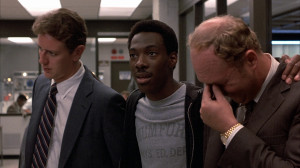 More, I loved Eddie Murphy. The comedian is in nearly every frame of Beverly Hills Cop and his energy is infectious. Here the actor perfected the con-artist persona he previously used on the small screen, as well as in 48 Hours and Trading Places. No matter how dangerous the situation, I knew Murphy would be able to talk, joke, or shoot his way out of it. I don’t recall ever laughing quite as hard as I did in that theater watching Axel Foley stick a banana up the tailpipe of that car staked outside his hotel.
More, I loved Eddie Murphy. The comedian is in nearly every frame of Beverly Hills Cop and his energy is infectious. Here the actor perfected the con-artist persona he previously used on the small screen, as well as in 48 Hours and Trading Places. No matter how dangerous the situation, I knew Murphy would be able to talk, joke, or shoot his way out of it. I don’t recall ever laughing quite as hard as I did in that theater watching Axel Foley stick a banana up the tailpipe of that car staked outside his hotel.
I walked out of the theater ecstatic. I wanted to see more. For the first time in my life I was starstruck and wanted to see everything Eddie Murphy had done or would do.
I made it a point to stay up late that week and watch Murphy host Saturday Night Live (his “White Like Me” sketch still makes me laugh). Quickly I went to the video store to rent his previous two hits. And I went opening weekend, again with Susan, to see The Golden Child.
Yes, I even bought the novelization to try and quell my excitement two years later for Beverly Hills Cop II.
I started buying Eddie Murphy comedy albums and watching Raw and Delirious. Through those specials I connected with Murphy, because I realized I idolized him as Murphy in his youth idolized Richard Pryor. I even found myself trying to tell Eddie Murphy-style jokes, and, for a time, flirted with the idea of doing stand-up comedy. I didn’t have much of a sense of humor as a child; I developed it in my teen years and Murphy was my teacher.
My parents were not overly fond of their son’s new hero. The string of profanity that emitted from our family room television would prompt my mother to use a few choice words of her own.
I didn’t see it the way she did. Murphy’s complete ownership of his vocabulary allowed me to see the power words have without fear. As a young kid I would curse for the wrongness of it, but Murphy helped me see that cursing punctuates language with an emphasis that nothing else can emulate.
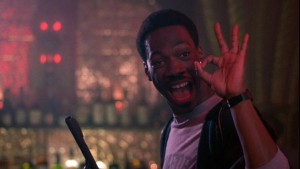 Older generations would state that swearing was for the dumb; Murphy showed me the truly intelligent know-how to wield every word for maximum impact. Some listeners have complained about the language we sometimes use on Now Playing Podcast, but I would not change a syllable. I believe the complete use of the English language allows me to express myself uniquely and clearly. I learned that from Murphy’s ad-libs and stand-up routines.
Older generations would state that swearing was for the dumb; Murphy showed me the truly intelligent know-how to wield every word for maximum impact. Some listeners have complained about the language we sometimes use on Now Playing Podcast, but I would not change a syllable. I believe the complete use of the English language allows me to express myself uniquely and clearly. I learned that from Murphy’s ad-libs and stand-up routines.
I wasn’t the only one to fall under Axel Foley’s influence. Beverly Hills Cop became the first R-Rated film — and the first comedy — to gross more than $200 million at the box office. That was a very exclusive group well into the 1990s.
Murphy even beat fellow Saturday Night Live alums Bill Murray and Dan Aykroyd, with Cop making more money in 1984 than Ghostbusters.
I must admit that Ghostbusters, with its lighthearted comedy, special effects, and giant Marshmallow Man, left a cinematic legacy that may be greater than Beverly Hills Cop. The Ghostbusters formula is aped to this day with films like R.I.P.D., Men in Black, and Evolution. There’s even a director signed for Ghostbusters III.
On the other hand, I don’t feel Murphy has aged as well. While his box-office mojo reigned for many years, even as a child I knew his follow-up films, The Golden Child and Beverly Hills Cop 2, didn’t measure up to his first star vehicle. While Coming to America was a brief return to form, it was also the last time I loved an Eddie Murphy film.
After The Distinguished Gentleman I realized his films had dropped significantly in quality, but due to my childhood devotion, I saw every film Murphy released through the 1980s and 1990s (yes, even Holy Man and Life). I watched every new Murphy movie hoping to laugh as hard as I did in Beverly Hills Cop and Coming to America. I finally gave up in 2001, I could not abide Pluto Nash.
But Murphy was the first movie star to impact my viewing habits. For that reason, even though I should know better, I continue to cross my fingers and hope the “Asshole Foley” I know and love will be back in Beverly Hills Cop IV.
Arnie is a movie critic for Now Playing Podcast, a book reviewer for the Books & Nachos podcast, and co-host of the collecting podcasts Star Wars Action News and Marvelicious Toys. You can follow him on Twitter @thearniec
August 14, 2014 Posted by Arnie C | 40-Year-Old Critic, Movies, Now Playing Podcast, Podcasts, Reviews | 1980s, 40-Year-Old Critic, Action, Beverly Hills Cop, Comedy, Eddie Murphy, Enertainment, Film, Ghostbusters, Movie, Movies, Now Playing, Now Playing Podcast, Podcasts, Review, Reviews | 6 Comments
40 Year-Old-Critic: Return of the Jedi (1983)
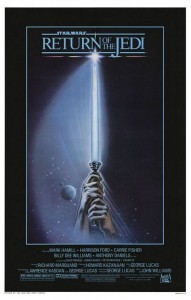 In The 40-Year-Old Critic, Venganza Media creator and host Arnie Carvalho recalls a memorable film for each year of his life. This series appears daily on the Venganza Media Gazette.
In The 40-Year-Old Critic, Venganza Media creator and host Arnie Carvalho recalls a memorable film for each year of his life. This series appears daily on the Venganza Media Gazette.
Anticipation for a film can be like great sex.
The foreplay starts when the film is announced, giving fans a hint that something great is to come. The slow build of anticipation can be excitingly agonizing. News bits are teased like a nibble on your earlobe, pictures are released from the set — the brief flashes making moviegoers anxious for the full reveal — and quotes tease the mind with plot threads as vague as an erect nipple through a cotton blouse. Finally, it all climaxes on the opening weekend; and that first viewing can sometimes be even better than the build up, or it can be a frustrating experience as the film exposes itself as something lesser than the fantasy built up in your mind.
To properly hype a film is a delicate dance. Studio marketing teams must be careful not to show too much too quickly, while still ensuring the filmgoer remains not only interested, but almost intoxicated by the perfume of previews.
I learned all of this as an 8-year-old. The film that taught me this lesson was Return of the Jedi.
Up until the spring of 1983 moviegoing was always spurred by an adult in my life. Even when I picked the film we attended I chose by simply looking at the newspaper listings, with no knowledge of release dates or whether the film was leaving theaters soon.
I usually became aware of a film upon its release. As mentioned in yesterday’s E.T. article, I watched Siskel & Ebert At The Movies weekly to learn about new films, but until their review aired I knew nothing about new movies being made. I may have seen an ad or two on television or trailers before other movies started, but I was too young for any of that to grab my attention.
I was too young to plan.
But that started to change after The Empire Strikes Back, with its unresolved cliffhanger of an ending. Being only 5 years old when I first saw Empire, I couldn’t fathom waiting three years for a conclusion to a story. After all, that was more than half my lifetime!
Primarily due to the toys, Star Wars was a constant topic of playground conversation, and throughout first, second, and third grade rumors about the next Star Wars film spread through the grapevine like urban legend.
“George Lucas was going to make Return of the Jedi three years after Empire, just as Empire was three years after Star Wars!”
“Then he’s planning to take a break for a few years, and release the next movie — Episode I — in 1989!”
To this day I don’t know how much of the “news” I heard about future Star Wars films was made up, how much came from news and magazines — passed down from parent to child — or how much I’ve learned since that has retroactively mingled in my imaginings.
What I do remember is the anticipation — for years — of that next Star Wars film.
I was not a child who dealt well with suspense. Commercial breaks were often agonizing torture, and season-finale cliffhangers would cause me physical pain — the need to know. But for three years I battled, wanting so badly to see what happened in the final Star Wars film.
Yet, despite all the anguish and all the talk about that third film it never felt real until late 1982 — six months before Return of the Jedi‘s release. When the trailers and magazine articles started, when toys started to hit shelves bearing the new, red Return of the Jedi logo, when bookstores had entire displays of Star Wars books promoting the upcoming film… that was when 8-year-old Arnie went insane.
Toys, books, and magazines were all purchased in anticipation of this film — surrogates I used to try and satiate my desires until the Jedi’s release. My godparents would placate me with a deal: If I did good in school that week, then on Saturday they would take me to buy one action figure.
ONE!?!?! But there were dozens on the store shelves, and so many more to come! I would watch Saturday morning cartoons and make lists of all the figures being released. I took a cardback and would X off each figure I owned as a way of marking time until I could have them all.
My parents, however, were not as indulgent regarding toys. They did however encourage me to read, and so I remember one Sunday going to the (now closed) local bookshop, The Book Emporium. There I saw a massive display of Star Wars novels, and a poster promoting the upcoming release of a Return of the Jedi novelization! That image of two hands clasping the blue lightsaber was burned into my brain, and to this day it is my iconic image of that film. I couldn’t bear it so I badgered my father to buy me all the Star Wars books, and I took my pleasures where I could — reading the novelizations of Star Wars and The Empire Strikes Back to fully re-experience those stories before seeing Return of the Jedi.
Finally, two weeks before the film was out, the novelization by James Kahn was in stores. I bought it the Saturday after it was released and tore into it. I couldn’t wait any longer for Return of the Jedi — the thirteen days until the film would be in theaters was agonizing. I had to have it now. I read like I’d never read before, page after page, excited for every new reveal.
It was a feeling like I was doing something naughty. There was forbidden knowledge in this book! I knew things no one else on the playground knew!
So excited was I about my insight into this upcoming movie that I would regale my sister Susan with anecdotes from the novel. Perhaps wanting me to have a pure movie experience (perhaps just wanting to shut me up), she introduced me to the concept of what we now call a “spoiler.”
She asked me if I was ruining the movie by knowing all about it before I saw it. Now, I wanted to see this movie more than I wanted air to breathe, so I promised her I would not read the last 50 pages. The film’s ending I would save for the screen.
But the waiting was killing me. Never before had I paid careful attention to a film’s opening date, but that year I knew Return of the Jedi would open on May 25. I had never been to an evening movie before — my parents always saved money by taking me to matinees — but Susan promised to take me opening night. My childhood best friend Stuart, now my co-host on Now Playing Podcast, also joined us.
We went early; Susan knowing that her brother wasn’t the only one anxious for Jedi. Still, the line was long at the Fox Theater in Springfield. It ran the full length of the strip mall, and for a half-hour we stood right outside the toy store where I practically drooled over the giant Star Wars toy display in the window.
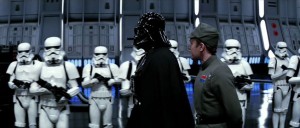
Vader walked the line at our Return of the Jedi screening.
Walking down the line, working the crowd, was Darth Vader. I’d seen costumed characters before on stage shows, and sometimes superheroes would appear at that very same toy store. But those were scheduled appearances. I had no concept of cosplay, and I was somewhat frightened by this tall man carrying the Kenner lightsaber. Part of me knew he wasn’t the real Darth Vader, and part of me hoped he was indeed the Sith Lord come to terrorize my town.
When we got to the box office we were told there were only 3 tickets left for the film — all of us could get in, but we couldn’t sit together. My sister was flummoxed by this, as we were two children in her care for the night.
But I didn’t care who I sat by, or didn’t sit by, just get me in that theater! Sorry Stuart. Sorry Susan. I cared more about seeing Return of the Jedi than spending time with either of you!
That was another radical shift. Up until that point in my life, movies were always a social event. I couldn’t imagine watching a movie alone, and going to a cinema was always as much about time with friends and family as it was the film itself.
Not this time. This time Return of the Jedi and I had to be together. Now.
So in we went. I had an end-of-the-aisle seat next to a stranger. Before the lights dimmed I tried to look around and see where Stuart and Susan were seated, but the theater was large and soon I ceased to care. They never once entered my thoughts as I was transported at 0.5-past-lightspeed to a galaxy far, far away.
The film moved so fast and had so many vivid creature designs that I instantly forgot everything I had read in the book. On the page I had only my own imaginings, and a few photos in the middle of the novel, to aid in the visualization of the story. Now, with dancing Twi’leks, organ-playing muppets, and slithering Hutts the film consumed me whole — as the Rancor would to the Gamorrean guard. The Emperor, the red-robed Royal Guards, the speeder bikes, they enthralled me. But my favorite were the Ewoks. Some have claimed the fierce teddy bears were Lucas’ crass marketing attempt to appeal to children. It worked. I was hooked by these furry, man-eating creatures, and immediately every Ewok figure was at the top of my toy-buying list.
When the Death Star exploded, I didn’t care that it was a retread of the same climax Lucas had done six years earlier, the one I’d watched on VHS nearly every day after school. Evil was defeated. That was what mattered.
This film lived up to what I wanted at that age. It was love-at-first-viewing, and like any new romance the euphoria made me proclaim it the best movie I’d ever seen. I knew I had seen E.T. 12 times in theaters the year before, so I would not be satisfied until I’d seen Jedi 13 times and it could claim my record.
(At 17 viewings, counting the ‘97 rerelease and a convention screening, Jedi is to this day the movie I’ve seen most often theatrically.)
As an adult I feel Return of the Jedi, while still very good, is by far the weakest of the three original Star Wars films. The pacing is downright odd, with too much time spent rescuing Han Solo in a subplot far removed from the main action of the saga. Lucas had painted himself into a corner and it took a long side-trip to the Pit of Carkoon to fix it. Yoda’s death was convenient, Luke and Leia’s sibling relationship was contrived, and Han Solo was neutered.
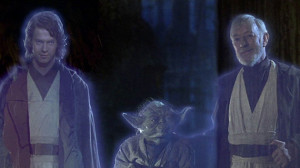
“Obi-Wan, invite the creepy guy to join us, did you?”
Jedi was also the first Star Wars film where I felt Lucas was too ambitious and the technology was not able to realize his vision. From Imperial Walkers to Tauntauns to Landspeeders to Yoda, the effects wizards in Lucas’ employ had made it all work in his previous films. But in Jedi the seams were showing — quite literally in the case of the puppets in Jabba’s palace. From the shoddy matting of the Rancor to the poor articulation in the Ewok faces, this is the Star Wars film that looks the most fake.
Lucas would try to fix some of these technical issues in myriad re-releases, starting with the Special Edition in 1997. Each time Jedi got a little worse, right down to the creepy insertion of Hayden Christensen at the end, and Darth Vader’s lame battle cry of “Noooooo.”
Still, despite these issues, the core storyline of Vader’s redemption, a son’s determination to save his father, and the final battle between good and evil makes this a worthy entry in the Star Wars franchise.
But this experience — anticipating a film so hotly that I was near-obsessed — was euphoric. To this day few experiences in my life are as pleasurable as the anticipation for a great, exciting movie.
It was this level of hype I had for the remake of Friday the 13th that launched Now Playing Podcast’s first retrospective series. That same hype for The Avengers, more than one year before its release, instigated Now Playing’s Marvel Movie Retrospective.
As for future hype, I look at Star Wars Episode VII. I believed for 30 years that the Star Wars story ended with Return of the Jedi, but Lucas’ decision to retire — combined with Disney shareholders’ lust for profit — mean the story will continue. Part of me feels like this is a spinoff, a story based on characters created by George Lucas. Episode VII is in completely unnecessary, save for the Disney folks who watch it with dollar signs in their eyes.
But… it could be good. The recent reveal of an X-Wing is pulling at my nostalgic love for the original trilogy. Certainly all the marketers at Disney will try to seduce me. The images revealed, the first trailers, will all be Episode VII courting me, teasing me, trying to gain my interest and make me excited. Time will tell if Star Wars can still get me hot and bothered 32 years later.
But I’ll never forget my first, and as such Return of the Jedi will always be special.
Arnie is a movie critic for Now Playing Podcast, a book reviewer for the Books & Nachos podcast, and co-host of the collecting podcasts Star Wars Action News and Marvelicious Toys. You can follow him on Twitter @thearniec
August 13, 2014 Posted by Arnie C | 40-Year-Old Critic, Marvelicious Toys, Movies, Podcasts, Reviews, Star Wars, Star Wars Action News | 40-Year-Old Critic, Arnie, Books, Collecting, Enertainment, Ewok, Film, George Lucas, Hasbro, Kenner, Now Playing, Now Playing Podcast, Podcasts, Return of the Jedi, Review, Reviews, sci-fi, Star Wars, Star Wars Action News, Toys | 3 Comments
40 Year-Old-Critic: E.T. the Extra-Terrestrial (1982)
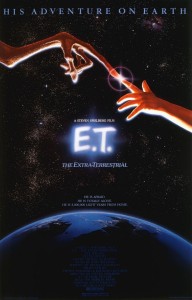 In The 40-Year-Old Critic, Venganza Media creator and host Arnie Carvalho recalls a memorable film for each year of his life. This series appears daily on the Venganza Media Gazette.
In The 40-Year-Old Critic, Venganza Media creator and host Arnie Carvalho recalls a memorable film for each year of his life. This series appears daily on the Venganza Media Gazette.
Movies are magic.
The commonplace nature of cinemas in the United States allow us to take for granted the power of cinema. Most of us live close to prolific multiplexes, so no effort is needed, no great journey undertaken, to get to a theater.
But once inside we enter a dark room and are taken far away from our everyday lives. It is so easy to fall into the world of a well-crafted movie that I often find myself lost in the experience. That magic of cinema makes me a movie lover to the point that I spend countless hours each week watching and reviewing films for Now Playing Podcast.
Because cinematic worlds are consumed so easily by moviegoers, it is easy to overlook the talent of hundreds, sometimes thousands, of people whose combined work creates a vision from nothing. I know as a very young child I never thought about who made a film. I never envisioned writers trying to sell a spec script, directors scouting for suitable locations, or puppet-makers designing detailed creatures. Despite loving Star Wars I didn’t know the name George Lucas. I just paid my two dollars and was taken to a galaxy far, far away.
But I can very clearly remember the year in my life when that simplistic view of movies changed, and I realized movies were made by people — and certain people made films better than others.
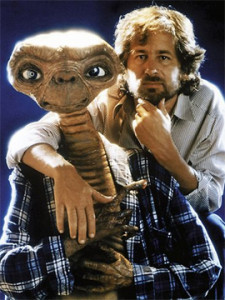 I was 7 years old, the year was 1982, and the film that made it clear was Steven Spielberg’s E.T. the Extra-Terrestrial.
I was 7 years old, the year was 1982, and the film that made it clear was Steven Spielberg’s E.T. the Extra-Terrestrial.
I didn’t know Spielberg’s name, nor his work. Jaws, Close Encounters of the Third Kind and Raiders of the Lost Ark may have been the films that made the director a household name, but as a young child that was lost on me.
The first time I paid attention to his name was a Saturday night in the spring of ‘82. Despite my age, my Saturday night ritual was to watch Siskel & Ebert At The Movies. I was interested in which movies deserved the coveted “Thumbs Up” from the critics, but more than that I loved seeing the clips of so many different movies all in a half-hour. Through these two iconic critics I was exposed to more movies than my parents would allow me to see.
On this particular Saturday night Gene Siskel and Roger Ebert showed a movie clip from E.T. that fascinated and scared me. It was the scene where Elliott rolls a baseball into the shed, and it comes back out. He runs in and gets his family, and his older brother, Michael, looks down at the alien footprints in the dirt and declares, “The coyote’s come back again, Ma.”
The pre-release materials never allowed audiences to view the alien creature — you had to pay admission to see it — but from that trailer I felt there was something dangerous and wondrous in that shed. I thought E.T. was a horror film and I thought Elliott was in grave danger from the unseen beast, but I wanted to know more.
In their review Gene Siskel and Roger Ebert repeatedly referenced director Steven Spielberg.
 I remember going to see E.T. opening weekend. Unlike Raider’s of the Lost Ark the year before, I would not miss this film. But I needn’t have feared — going was a family event. For a change it wasn’t just the science-fiction obsessed boy in the house demanding to see the movie. Everyone, from my workaholic, absentee father to my pragmatic mother to all three of my teenaged sisters, wanted to see this movie.
I remember going to see E.T. opening weekend. Unlike Raider’s of the Lost Ark the year before, I would not miss this film. But I needn’t have feared — going was a family event. For a change it wasn’t just the science-fiction obsessed boy in the house demanding to see the movie. Everyone, from my workaholic, absentee father to my pragmatic mother to all three of my teenaged sisters, wanted to see this movie.
Being a large family with children ranging from 7 to 19, whole-family outings to a movie theater were rare. But this was one of those occasions. I remember the six of us taking up a good portion of the row, and how I was once again transported into the world Spielberg created. I also remember crying at the end, and trying desperately not to.
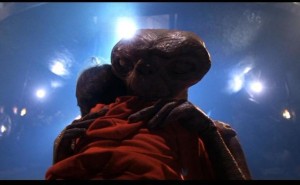 As a child I was very sensitive. I also was not wholly unfamiliar with the idea of a bittersweet ending. My sister Susan helped me remember watching a rerun of the 1978 TV special Puff the Magic Dragon and how at the end Puff flew off, leaving Jackie alone. I didn’t understand then the importance of Jackie’s transformative experience with Puff, I just saw a boy losing his friend. I heard the line, “Dragons live forever, not so little boys” and I cried. Hard. My father, however, had no sympathy and chastised his 4-year-old son for getting emotional over a television show.
As a child I was very sensitive. I also was not wholly unfamiliar with the idea of a bittersweet ending. My sister Susan helped me remember watching a rerun of the 1978 TV special Puff the Magic Dragon and how at the end Puff flew off, leaving Jackie alone. I didn’t understand then the importance of Jackie’s transformative experience with Puff, I just saw a boy losing his friend. I heard the line, “Dragons live forever, not so little boys” and I cried. Hard. My father, however, had no sympathy and chastised his 4-year-old son for getting emotional over a television show.
Now here it was just a few years later and that Puff ending was replayed with E.T. leaving Elliott, and once more I was crying. My father was sitting just a few seats away, and I tried to hold in the tears. I failed, and left the theater sobbing.
I also left that theater changed. The film had engrossed me, and I’m told I wouldn’t stop talking about it for weeks to come.
More, I kept going back to see it. The second time I saw E.T. I went with Stuart, whom I had met the previous year in grade school. Knowing the ending in advance, I told myself I’d hold it together. I did better, but when the credits rolled my lower lip was quivering and tears streamed down my face. Then I saw it with my godparents, then a babysitter, then my mother’s friend who took me, both to occupy me one afternoon and to see the film herself.
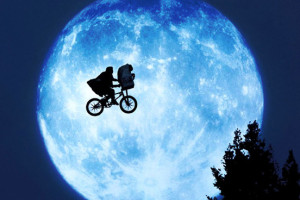 Going to see E.T. became a habit. I ended up seeing it about a dozen times in theaters.
Going to see E.T. became a habit. I ended up seeing it about a dozen times in theaters.
Then I started to seek out more about Spielberg. I started to connect that name with Raiders of the Lost Ark and other films both at the video store and in theaters. Through At The Movies I became more exposed to the people behind the camera, as well as in front of it. But no matter how many names I learned, Spielberg’s was special from that moment with E.T.
That film was a massive success, dethroning Star Wars as the highest-grossing picture of all time. As such, the number of “Spielberg films” exploded, from Gremlins to Goonies, Indiana Jones and the Temple of Doom to Back to the Future, Poltergeist and even An American Tail (which, at 12, I felt far too old to see in theaters, but went for Spielberg). I sought them all out.
The lesson I learned as a 7-year-old took many more years to sink in fully. I spent my teen years following actors instead of filmmakers. I would enjoy a film with Corey Feldman, John Candy, or Eddie Murphy and wanted to see more of them, but I was repeatedly disappointed by the uneven nature of their performances. Finally, later in life, I would relearn the childhood lesson, as I started to appreciate films for those who made them. I would follow the careers of Oliver Stone, Quentin Tarantino, Richard Linklater, Darren Aronofsky, and others.
But Spielberg was the first auteur to excite me — at just 7 years old — as I watched E.T. phone home again and again.
Next — 1983!
Arnie is a movie critic for Now Playing Podcast, a book reviewer for the Books & Nachos podcast, and co-host of the collecting podcasts Star Wars Action News and Marvelicious Toys. You can follow him on Twitter @thearniec
August 12, 2014 Posted by Arnie C | 40-Year-Old Critic, Movies, Now Playing Podcast, Podcasts, Reviews | 1982, 40-Year-Old Critic, Be Good, E.T., E.T. the Extra-Terrestrial, ET, Movie, Review, Reviews, Steven Spielberg | Comments Off on 40 Year-Old-Critic: E.T. the Extra-Terrestrial (1982)
40 Year-Old-Critic: Raiders of the Lost Ark (1981)
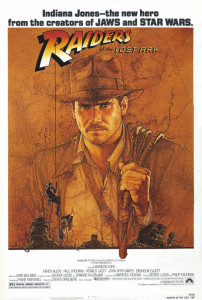 In The 40-Year-Old Critic, Venganza Media creator and host Arnie Carvalho recalls a memorable film for each year of his life. This series appears daily on the Venganza Media Gazette.
In The 40-Year-Old Critic, Venganza Media creator and host Arnie Carvalho recalls a memorable film for each year of his life. This series appears daily on the Venganza Media Gazette.
I wrote at length about the summer blockbuster in the 1975 installment of this retrospective series discussing Jaws. I recalled how it seemed each year had one movie that everyone was talking about. Hollywood now gives its tentpole pictures one or two weeks to make an impact, but when I was a kid the biggest films ran for months and would remain in the public conversation for years.
In 1981 I learned what it was like to be on the outside of that conversation.
I spent a lot of time at the movies as a kid. I remember a summer program in our town that screened older, child-friendly films each week for just $1 — a small price for my mother to pay to have me sit quietly for two hours. My mother, my godmother, and my sister would coordinate schedules to take me to see those summer films and, being the completist that I am, I refused to miss a single installment.
Not content with the preprogrammed children’s fare, I started to make my own decisions about which new releases I would see. I remember begging my mother to take me to Clash of the Titans, The Great Muppet Caper, Superman II, and The Fox and the Hound. But one film that totally escaped my attention was Raiders of the Lost Ark.
By the summer of ‘81 Steven Spielberg was already a name-brand director with blockbusters Jaws and Close Encounters of the Third Kind under his belt. He’d survived a rare misstep with the ill-conceived 1979 comedy 1941 and returned to form two years later with the first installment in the Indiana Jones franchise.
This film carried more than just Spielberg’s golden name. The poster boasted “From the creators of Jaws and Star Wars.” It was Spielberg’s collaboration with the man who had made the most successful film of all time… George Lucas.
With those names on the poster it is no shock that moviegoers turned out in droves to see the film, with no misgivings about its period setting — a far cry from the filmmakers’ recent science-fiction fare. Plus Raiders wisely featured a strong supernatural bent for those who appreciated the fantastical elements of Close Encounters and Star Wars.
Raiders of the Lost Ark went on to become the top-grossing film of 1981. It was a cultural smash, a critical darling, and nominated for several Academy Awards.
I totally missed it.
The first Indiana Jones movie opened in our town on June 12 — the same day as Clash of the Titans. I didn’t just choose to see Greek gods over Indiana Jones, I have no memory of knowing Raiders of the Lost Ark was out there. Soon after, Superman II opened, and that was the movie I’d been waiting to see.
Raiders was totally lost on me.
When school resumed that fall it didn’t take long for me to realize I’d missed something huge. Now a second-grader, I returned to classrooms ready to reunite with schoolyard friends and talk about Clash of the Titans and Superman II, but the only movie on their minds starred some guy with a whip. Playground chums regaled me with tales of the swordsman who performed deft moves only to be quickly shot dead, and that magical box that made Nazi faces melt. I had nothing to add to these conversations, I could only nod and say it sounded fun.
 This feeling of isolation continued for years, and I felt Raiders of the Lost Ark would taunt me forever. For Christmas in 1982 my sister Susan bought me the Raiders of the Lost Ark Atari 2600 game. She was now a college student and assumed I’d seen the film and loved it. I played that game for days, trying to use it as a surrogate for the movies I’d missed. I created a story in my mind featuring snakes and whips and anchs and black markets.
This feeling of isolation continued for years, and I felt Raiders of the Lost Ark would taunt me forever. For Christmas in 1982 my sister Susan bought me the Raiders of the Lost Ark Atari 2600 game. She was now a college student and assumed I’d seen the film and loved it. I played that game for days, trying to use it as a surrogate for the movies I’d missed. I created a story in my mind featuring snakes and whips and anchs and black markets.
Finally, the next year, my long nightmare ended.
In late 1982 my family bought our first VCR and, a few months later, we rented Raiders of the Lost Ark on VHS. Of course, I loved the film (and was surprisingly happy to see how little it resembled its Atari counterpart). It was exciting and funny, and also a bit scary. I had nightmares for months about those melting faces. Though I would rewatch Raiders regularly on video, for the first year or more I would cover my own eyes during the bloody climax.
Then, in 1984, when Indiana Jones and the Temple of Doom was released, I ensured I didn’t make the same mistake — I saw the sequel twice on opening weekend and read the novelization.
I still watch Raiders of the Lost Ark regularly to this day (though I now laugh at the effects that made me wince as a child). Just this past summer I went on a fishing trip with friends and we gathered around the cabin’s small television to watch Harrison Ford in his second-best role. We applauded its genius, debated the importance of Indy in the movie’s plot, and lamented the franchise’s abysmal fourth installment.
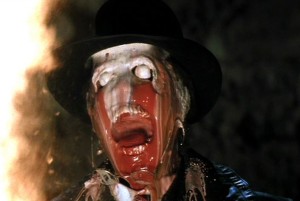 Raiders of the Lost Ark was the best film of 1981, but it also taught me the importance of cinema as part of a cultural conversation. Shared experience creates a community, and in the 1980s part of our nationwide identity was defined by blockbuster films. National defense programs were named after sci-fi flicks, presidential candidates quoted hit movies, and playground friendships were made and broken by what you saw over summer vacation.
Raiders of the Lost Ark was the best film of 1981, but it also taught me the importance of cinema as part of a cultural conversation. Shared experience creates a community, and in the 1980s part of our nationwide identity was defined by blockbuster films. National defense programs were named after sci-fi flicks, presidential candidates quoted hit movies, and playground friendships were made and broken by what you saw over summer vacation.
I do feel that today some of the magic is lost when there is a new “must see” movie every weekend. It waters down the experience. Now there are more fractured groups of fans, and rarely is there a film like Titanic, Star Wars, E.T., or Raiders of the Lost Ark that can transcend age, race, and gender and become a cultural phenomenon.
At 6 years old I learned how important that was, thanks to Raiders, and it’s a belief I hold today.
Next — 1982!
Arnie is a movie critic for Now Playing Podcast, a book reviewer for the Books & Nachos podcast, and co-host of the collecting podcasts Star Wars Action News and Marvelicious Toys. You can follow him on Twitter @thearniec
August 11, 2014 Posted by Arnie C | 40-Year-Old Critic, Movies, Now Playing Podcast, Podcasts, Reviews | 1981, 40-Year-Old Critic, Clash of the Titans, George Lucas, Harrison Ford, Indiana Jones, Now Playing, Now Playing Podcast, Podcasts, Raiders of the Lost Ark, Review, Reviews, Steven Spielberg, Superman | 4 Comments
40 Year-Old-Critic: Popeye (1980)
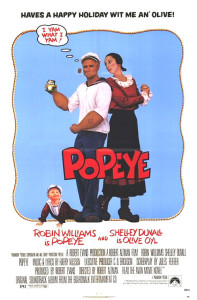 In The 40-Year-Old Critic, Venganza Media creator and host Arnie Carvalho recalls a memorable film for each year of his life. This series appears daily on the Venganza Media Gazette.
In The 40-Year-Old Critic, Venganza Media creator and host Arnie Carvalho recalls a memorable film for each year of his life. This series appears daily on the Venganza Media Gazette.
What, you thought The Empire Strikes Back was a given for 1980? Absolutely not! Let me explain.
1980 is a special year for me because it is the first year I can actually remember seeing movies in theaters. I have vivid recollections of my mother taking me to see The Empire Strikes Back on a hot summer day while weekending in Chicago, and I remember going to see Superman II when it opened at our local mall. And I remember later that year my sister Susan taking me to see the Robin Williams “comedy” Popeye, and sadly this is the moviegoing experience I remember best of all.
As a child I loved cartoons. Mostly, I was interested in superheroes like Superman, but I watched the Bozo show religiously and it featured a variety of cartoons, including Tom and Jerry, Mighty Mouse, and Popeye. I consumed this animated fare as part of a daily television diet.
My TV viewing was not confined to mornings, I was also starting to watch prime time shows. Being the youngest child in the house I rarely choose what shows were on our one television. Occasionally, when I was alone, I’d get to see Dukes of Hazzard or The Incredible Hulk. But most nights I watched whatever my older sisters wanted to see.
Their tastes ran to sitcoms of the day: Happy Days, The Jeffersons, Three’s Company,The Facts of Life, and my absolute favorite, Mork & Mindy. Robin Williams’ character, along with his colorful costumes, kept my attention for the full half-hour every Thursday night.
So, Williams as Popeye? It had to be a no-brainer for Susan to take her kid brother to that movie. To this day, the experience of seeing that film is burned into my brain.
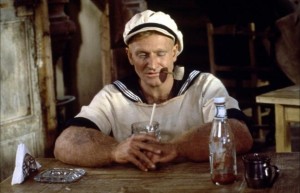
I yam what I yam…a bad movie.
My first reaction to this dirty, ugly picture was, “This isn’t my Popeye!” I wasn’t sure what had happened to the character I loved from The Bozo Show, but as shown on-screen “our hero” Popeye was beaten down and disavowed. His every scene seemed to be a boring exercise in humiliation. Worst, this Popeye hated spinach! A recent rewatch made it clear that the ingestion of that canned plant is the character’s arc — his origin story — but to a 6-year-old it seemed this movie didn’t know the first thing about the cartoon I loved. It lacked the crazy, fast-paced antics of the animated show and replaced it with warbled songs sung by Shelley Duvall and Robin Williams, neither of whom should ever be allowed to sing again (Aladdin aside). It seems even Williams was embarrassed during the making of the movie–he looks depressed in nearly every scene.
And it wasn’t just Williams, it was everyone. As Pappy, Ray Walston was a frightening character who denied Popeye’s parentage. Bluto was a bully that seemed comical in animation, but when personified in the flesh his hairy bulk repulsed me.
At 6 years old I did not yet possess the vocabulary to express how this movie made me feel. I did not know the meaning of words like “abrasive” or “grimy.” I couldn’t properly express that Popeye lacked the fun, spirited tone of the cartoon, and that its rundown river-town setting made me feel like I needed a hot bath. I didn’t just experience disappointment, I had a feeling of utter betrayal — and not just by Popeye. I wasn’t that big of a fan where an inaccurate on-screen portrayal would scar me.
No, I felt betrayed by cinema.
Up until this point in my life I’d had a magical experience every time I had gone to the movies. I’d seen Yoda teach Luke Skywalker about good and evil. I’d listened to Muppets sing and loved it. I’d seen God in the guise of George Burns. I’d been enthralled as Mickey Mouse made brooms dance. I’d believed a man could fly! I hadn’t seen a lot of movies in theaters at this age, but each one seemed hand-picked for maximum enjoyment. I thought the movie theater was a place where only good things happened.
Seeing Popeye made me realize, for the first time, that a movie could be really, truly terrible. In some ways, it was the death of my childhood innocence.
I insisted my sister take me back to the movies a week later to wash the taste of spinach out of my mouth. She picked a film I hadn’t heard of, Flash Gordon. Again, I thought I would be seeing another cartoon hero come to life (I’d mistaken it for the DC Comics hero, The Flash).
It was like a one-two punch, Popeye and Flash Gordon. I’d never look at movies the same again.
From the moment I walked, shell-shocked, out of that mall theater something inside me changed. My trust in the silver screen was broken. It would take many years for me to fully comprehend the enormity of that concept — that choices had to be made where I spent my money and time — but it all started with what surely must be director Robert Altman’s worst picture.
I am now about to turn 40, but inside I’m still a 6-year-old every time I go into a theater. I still hope every movie I watch — especially every theater-going experience — will be magical and wondrous. And I still feel betrayed when I’m instead given something as disastrous as Popeye or Aliens vs Predator.
At least now I can channel those memories and spare others from the letdown I experienced. As a critic on Now Playing Podcast I, hopefully, can warn people when there’s a Popeye at the multiplex. Also, as an adult, I can now fully put into words those negative feelings I had as a child.
Thinking now about 1980, I realize so many films I love today were released that year: The Empire Strikes Back, The Blues Brothers, Raging Bull, Ordinary People, and, of course, the original Friday the 13th. I have memories of seeing them all, but none are as vivid as that horrible Saturday when I saw Popeye.
Next — 1981!
Arnie is a movie critic for Now Playing Podcast, a book reviewer for the Books & Nachos podcast, and co-host of the collecting podcasts Star Wars Action News and Marvelicious Toys. You can follow him on Twitter @thearniec
August 10, 2014 Posted by Arnie C | 40-Year-Old Critic, Comic Books, Movies, Now Playing Podcast, Podcasts, Reviews, Television | 40-Year-Old Critic, Bluto, Cartoon, Comedy, Flash Gordon, Movie, Movies, Now Playing, Now Playing Podcast, Olive Oil, Popeye, Review, Reviews, Robin Williams, Shelly Duvall | 4 Comments
40 Year-Old-Critic: Love at First Bite (1979)
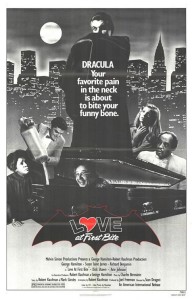 In The 40-Year-Old Critic, Venganza Media creator and host Arnie Carvalho recalls a memorable film for each year of his life. This series appears daily on the Venganza Media Gazette.
In The 40-Year-Old Critic, Venganza Media creator and host Arnie Carvalho recalls a memorable film for each year of his life. This series appears daily on the Venganza Media Gazette.
It’s not easy to choose a favorite film from 1979 — so many of that year’s films have influenced my life in one way or another, from The Muppet Movie, which solidified a love for the older-skewing Muppets, to Alien, which scared the pants off me (and Sigourney Weaver), to The Jerk (which may be Steve Martin’s finest ludicrous performance). And I cannot leave out Francis Ford Coppola’s mad masterpiece Apocalypse Now, which is certainly the most engaging and best-made film from 1979.
But while I always enjoy getting lost in the jungles of Coppola’s Vietnam, I didn’t see the film until adulthood, and it hasn’t shaped my life or my views.
The movie that did was a little George Hamilton horror spoof, Love At First Bite. The story tells of Dracula (George Hamilton) coming to (then) modern-day New York City to find his true love Mina Harker, who has been reincarnated as supermodel Cindy (Susan Saint James). His quest is thwarted by Cindy’s psychiatrist boyfriend Jeffrey Rosenberg (Richard Benjamin), who also just happens to be a descendant of Dracula’s nemesis van Helsing.
Barely in first grade, I was probably far too young to be watching Love At First Bite. I was too naieve to really understand all the references to the swinging seventies, and the meaning of the word “kinky.” More, the social commentary about urban youth rehabilitation, psychiatry, and religion was all mostly lost on me.
Yet I was enraptured by this movie. As I have mentioned in previous reviews, I have always been fascinated by horror. I was mesmerized by trailers on television for movies like Friday the 13th and Evil Dead. It was as if seeing them would be like reading from the Necronomicon itself, opening me to a world of demons and monsters. To an imaginative young boy that thought is rapturous, and terrifying. I would watch horror films through slatted fingers; I could not bear to see the monsters but I also could not look away. The few times I would try to watch horror films — including Frank Langella’s Dracula from this same year — I needed an adult nearby to protect me from the “evil” radiating from the screen.
But in Love at First Bite — here was a Dracula I could handle. Hamilton was sharing the screen with familiar faces like George and Weezie Jefferson (Sherman Hemsley and Isabel Sanford, respectively). He didn’t want to slaughter innocents, he wanted to be reunited with his centuries-old-love! He wasn’t turning people into ghastly, zombie-like minions, he was feeding on winos and getting drunk off their blood! I understood this Dracula to be silly.
Now, just because I thought he was funny didn’t mean I wasn’t also in awe of Dracula, his immortality and powers. His magical ability to transform into bats and dogs, and his thirst for blood, still held me in thrall. The movie didn’t intend it, but I must admit, I was slightly afraid of George Hamilton’s Dracula.
This was a movie that made horror accessible to a 6-year-old. It was the stepping stone for me between Sesame Street’s Count (always my favorite Muppet, as I secretly hoped one day he’d count the other Muppets on which he’d fed) and true horror killers like Freddy and Jason. I especially liked the crazy antics of Arte Johnson as Dracula’s servant Renfield, the actor throwing himself into the role with wild abandon.
I have since revisited Love at First Bite and can see its many flaws. The film is very much a product of its time. It’s a desperate Mel Brooks wannabe, attempting to be a vampire version of Young Frankenstein, but, strangely, adds the racist humor of Blazing Saddles. The jokes are dated and most don’t hold up, the effects are shoddy and obvious, and while the score is amazing, the best song in the movie — Alicia Bridges’ “I Love the Nightlife” — has been cut from home video releases due to rights issues. Still, some of the Dracula jokes, such as “Creatures of the night….shut up!” still make me giggle. Revisiting Love at First Bite in 2014 was not a rewarding experience and if this were a review for Now Playing Podcast, I’d struggle with giving it a recommend.
Yet this film helped me accept a dichotomy in my own mind that monsters could be frightening and alluring. Just as I was repulsed by — yet drawn to — horror films, Cindy was drawn to — yet frightened by — her undead on-screen lover. The fine line between terror and turn-on was revealed to me. It’s something I’d explore further in Hellraiser, but I recognize that I was first exposed to it by Love at First Bite.
In the 30-some years since I have read Bram Stoker’s original novel and watched countless versions of the quintessential vampire on screen, but when I think of Dracula, it’s George Hamilton that I picture in my mind. So for that long-lasting bite this film gave me, it is the film from 1979 that I remember most.
Next — 1980!
Arnie is a movie critic for Now Playing Podcast, a book reviewer for the Books & Nachos podcast, and co-host of the collecting podcasts Star Wars Action News and Marvelicious Toys. You can follow him on Twitter @thearniec
August 9, 2014 Posted by Arnie C | 40-Year-Old Critic, Movies, Now Playing Podcast, Podcasts, Reviews | 40-Year-Old Critic, Arnie, Comedy, Dracula, Entertainment, Film, George Hamilton, Love at First Bite, Movie, Movies, Now Playing, Now Playing Podcast, Podcasts, Review, Reviews, Vampire | 2 Comments
Now Playing soars on iTunes, Bleeding Cool covers ‘The 40-Year-Old Critic’
Venganza Media celebrated dual successes on Thursday, as Now Playing Podcast’s Guardians of the Galaxy review cracked the Top 5 on iTunes, while the company’s latest project — Arnie Carvalho’s The 40-Year-Old Critic — received a welcome reception from pop culture website BleedingCool.com.
“I love hearing people talk passionately about their interests, and there are fewer people that do so with as much vigor and resourcefulness as one Arnie Carvalho,” Bleeding Cool’s Jeremy Konrad wrote of the Venganza Media founder and Now Playing Podcast co-host.
In anticipation of his 40th birthday, Carvalho has been taking a look back at an influential film for every year of his life. That list includes hits like Jaws and E.T., but also notorious flops such as Popeye and Howard the Duck – the latter having previously been featured in one of Now Playing Podcast’s most famous episodes.
Konrad’s Q&A also covers the podcast’s popular donation shows, Carvalho’s toy collection, and Now Playing Podcast’s continued dominance of Apple’s iTunes podcast page.
Now Playing Podcast is currently featured in iTunes “What’s Hot” section, and on Thursday the review of Guardians of the Galaxy reached No. 3 on the Top 200 TV & Film episode chart. The review — released Monday — is the latest entry into Now Playing’s celebrated Marvel Comics Movie Retrospective Series, which began in 2011 and has covered every theatrical and television film featuring a Marvel superhero.
Now Playing Podcast is also wrapping up its Teenage Mutant Ninja Turtles retrospective, with the final film in the five-episode series scheduled for release Tuesday, Aug. 12.
https://venganzamedia.com/Gazette/2014/07/31/venganza-media-announces-the-40-year-old-critic-series/
August 8, 2014 Posted by Arnie C | 40-Year-Old Critic, Comic Books, Marvelicious Toys, Movies, News, Now Playing Podcast, Podcasts, Reviews, Site Information, Star Wars Action News | 40-Year-Old Critic, BleedingCool, Howard the Duck, Jeremy Konrad, Marvel, Marvelicious Toys, Movies, Now Playing, Now Playing Podcast, Press Release, Review, Star Wars, Star Wars Action News, Venganza Media | Comments Off on Now Playing soars on iTunes, Bleeding Cool covers ‘The 40-Year-Old Critic’
40 Year-Old-Critic: Superman (1978)
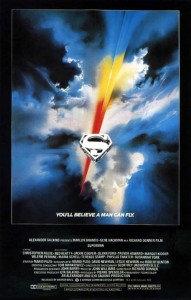 In The 40-Year-Old Critic, Venganza Media creator and host Arnie Carvalho recalls a memorable film for each year of his life. This series appears daily on the Venganza Media Gazette.
In The 40-Year-Old Critic, Venganza Media creator and host Arnie Carvalho recalls a memorable film for each year of his life. This series appears daily on the Venganza Media Gazette.
I look at 1978 as the middle-child of movie years. Moviegoers were still wowed by 1977’s Star Wars, which was continuing to play on many screens in’78. Lucas’ masterpiece had just set Hollywood on its own space race, but it took a couple of years for Lucas imitators and other sci-fi directors to get their films produced. As such, many of the sci-fi films I grew up with and celebrate as seminal were not released until 1979. But what about the year in-between? It had Dawn of the Dead, a smart mix of social commentary and horror, and Grease, which is a fun sing-a-long romp that I’ve watched more times than I can count. Still, neither changed my life nor my view of film. And please don’t bring up Jaws 2, Animal House, or Every Which Way But Loose. No, in 1978 there are only two films that resonated with me. The first was Halloween, an annual must-watch for me that iterated the Texas Chain Saw Massacre formula and is the father of the 80s slasher film. But its impact pales in comparison to the single 1978 movie that made me believe a man could fly — Superman: The Movie. I was 4 years old when this superhero film was released, but my parents took me to see this in theaters despite my young age. In one viewing my focus changed.
I’ve gone back and looked at family photo albums. From September ‘74 through November ‘78 all my photos were full of the usual childhood accouterments: I had PlaySkool’s wooden Sesame Street figures, clown items, Cookie Monster designs on my 4th birthday cake. You can see the changes after December ‘78. My clothes were no longer Big Bird T-Shirts, now they were superhero Underoos. Away went the baby PlaySkool toys and, in their place, was a collection of Mego Superheroes. And on my bedroom wall were two new posters: Lou Ferrigno as CBS’s The Incredible Hulk, and Christopher Reeve, arm pointing to the sky, advertising Superman: The Movie. Obviously, many films captured my imagination (and my parents’ dollars) as a child. That alone is not enough to warrant the title of Most Important Film of 1978. However, when I look at my life, and when I look at the hit movies of today, it’s impossible not to see the legacy of star Christopher Reeve and director Richard Donner. In the mid-70s superheroes were seen as campy entertainment for children. Comic books had long been stigmatized as pulp trash, and that reputation was solidified by the 1960s Batman TV series. Early drafts of Superman reflected that attitude as well (you can hear all about that in the Now Playing Podcast Superman review). But with this Superman film Donner saw an opportunity to make a more serious superhero adventure. He gave A-list stars Marlon Brando and Gene Hackman top billing, brought in state-of-the-art special effects, and allowed John Williams to create that emotional, rousing anthem for his hero. The result was a film that lived up to the promise on its poster, and as a 4-year-old I believed a man could fly. Admittedly, Superman did not completely abandon some campy scenes and performances; Ned Beatty’s Otis could have been teleported right from that 60s Batman series. Still, by taking the material as seriously as it did Donner and company created the first modern superhero film.
You can see the lineage: Superman begat 1989’s Batman, which begat The Crow five years later, which begat Blade in ‘98, which begat 2000’s X-Men (also produced by Donner), which begat 2002’s Spider-Man, which led to the creation of the Marvel Cinematic Universe, starting with Iron Man in 2008, and The Avengers four years later. And those are just the game changers. More than 100 other big-budget, major motion pictures follow Superman’s example of treating the material with respect and casting big-name stars as iconic comic characters. To this very day, almost every single superhero film is still following the mold created by Donner. As the Now Playing Podcast reviews show, the Superman series went downhill very quickly. Producers Alexander Salkind and Ilya Salkind fired Donner, and without his vision the series devolved into a Richard Pryor yuk-fest. It took Tim Burton’s Batman to remind Hollywood that audiences will turn out for a serious superhero film. Then, like Superman before it, the Batman series quickly collapsed when Burton moved on. It was finally Bryan Singer’s X-Men that ignited what has become the blockbuster movie genre of the 21st century. (Don’t get me started on what Singer did to Superman, you can hear my review of that travesty in the Now Playing Podcast archives.) As for me: seeing 1978’s Superman at such a young, impressionable age forever changed my world view. While I was never heavy into comic books, Superman turned me on to multimedia superheroes. My morning cartoons became filled with Batman and Spider-Man and Hulk, and every time there was a new comic-based television series or film I was in the audience.
I am forever chasing the sense of wonder I felt in 1978 when Clark Kent ripped open his shirt and I saw the bright red and yellow S. Better still, this is a good movie. Unlike Texas Chain Saw Massacre, which I don’t enjoy but which fathered films I love, Superman: The Movie is always a joy to watch. While the pacing (especially in the director’s cut) may bore some people, I love the character exploration and world-building that Donner indulges. This love of superhero movies would be a direct catalyst for the creation of Now Playing Podcast, a show that’s been downloaded by hundreds of thousands of people across the globe. The idea for what would become Now Playing came to me as I was leaving a screening of the Marvel Comics movie Ghost Rider, and our first review was Sam Raimi’s Spider-Man 3. The excitement for Marvel’s The Avengers kicked off Now Playing’s longest retrospective series, and turned the podcast into a weekly show as we revisited every Marvel movie, starting with George Lucas’ Howard the Duck.
It is also Marvel’s Iron Man 2 that made me a serious collector of comic book-related merchandise. That led to the creation of the podcast Marvelicious Toys and my sizable Marvel collection, full of movie-based Hot Toys figures, quarter-scale statues, and even some one-of-a-kind production materials from Howard the Duck. And while my collecting focus has been the Marvel films, I do own one single collectible from the DC universe: a Hot Toys figure of Christopher Reeve from 1978’s Superman. I own it not as a collector, but as a fan, and I display it in my home theater as a reminder that I still believe a man can fly.
Next — 1979!
Arnie is a movie critic for Now Playing Podcast, a book reviewer for the Books & Nachos podcast, and co-host of the collecting podcasts Star Wars Action News and Marvelicious Toys. You can follow him on Twitter @thearniec
August 8, 2014 Posted by Arnie C | 40-Year-Old Critic, Comic Books, Marvelicious Toys, Movies, Now Playing Podcast, Podcasts, Reviews | 40-Year-Old Critic, Arnie, Christopher Reeve, Comic Books, Comics, Enertainment, Film, Movie, Movies, Now Playing, Now Playing Podcast, Podcasts, Review, Reviews, Richard Donner, Superman | 6 Comments
40 Year-Old-Critic: Carrie (1976)
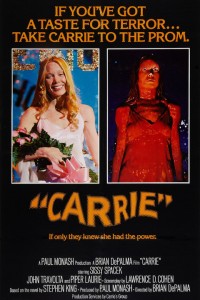 In The 40-Year-Old Critic, Venganza Media creator and host Arnie Carvalho recalls a memorable film for each year of his life. This series appears daily on the Venganza Media Gazette.
In The 40-Year-Old Critic, Venganza Media creator and host Arnie Carvalho recalls a memorable film for each year of his life. This series appears daily on the Venganza Media Gazette.
Last October, prompted by the release of the remake, Jakob, Stuart, and I reviewed 1976’s Carrie for Now Playing Podcast. It was the first film in our ongoing (with no end in sight) Stephen King Movie Retrospective. I came to that series a Stephen King fan, as I’ve followed his work since the mid 1980s. While researching Carrie for that review I realized I am likely only a Stephen King fan thanks to Brian DePalma’s film adaptation.
It’s not that I believe DePalma’s Carrie to be the best adaptation of a King novel, for proof you can listen to my thoughts in our Now Playing review. I think it’s a well-crafted and enjoyable film, but some poor characterizations and pacing issues prevent me from heralding it as the best King film to date.
I think Carrie’s greatest achievements took place off-screen.
King’s debut novel was published in April 1974, five months before I was born. Carrie sold well — especially in paperback — and secured the author a multi-book deal, but its overall performance was not exceptional. Even a year later, with the release of his second novel, Salem’s Lot, King was still not a household name. All of that changed in ‘76 when Carrie hit theaters. DePalma took that story, added his visual style and a Hitchcockian score, and the result was an Academy Award-nominated film.
I have no doubt that the success of Carrie in theaters gave King the boost he needed to achieve critical mass and have his first hardcover bestseller in 1977 with The Shining.
 It helps that King is a prolific storyteller, and I’ve always believed his appeal comes from engaging stories filled with relatable characters. No cinematic success can turn a poor writer into one of the bestselling authors of all time. But with Carrie, a spotlight was shone on King. He was exposed to a broader audience than the bookstore shelves could ever provide. De Palma opened the door and King had the talent to walk through it.
It helps that King is a prolific storyteller, and I’ve always believed his appeal comes from engaging stories filled with relatable characters. No cinematic success can turn a poor writer into one of the bestselling authors of all time. But with Carrie, a spotlight was shone on King. He was exposed to a broader audience than the bookstore shelves could ever provide. De Palma opened the door and King had the talent to walk through it.
The result is publishing history. I grew up going to schools where it seemed every third student was reading a Stephen King novel. Not only were my friends engrossed in the pages, but the parents of my friends were also reading King. I was enthralled. As a child drawn to horror — and simultaneously terrified of it — I couldn’t not read these books.
The first book I read was Carrie, suggested to me by lifelong friend and fellow Now Playing host Stuart. A few weeks after finishing the novel I saw De Palma’s film for the first time, and I became a Stephen King fan. He was the first author whose name would make me immediately interested in a book.
King has published 64 novels — most of them bestsellers — as well as countless short stories, and I have read most of them. I continue to read King as I enter my 40th year, and will continue through my 41st, 42nd, and so on, until one of us dies. I’m also reviewing every widely-published Stephen King story on our Books & Nachos podcast. As I write this I’m also working on a review of his ‘78 masterpiece, The Stand.
And it all goes back to DePalma’s Carrie. Without that film, it’s possible King would have been one of 1,000 authors who publish countless books for their niche audience, but never gain widespread attention. That film was a cultural phenomenon that shaped me as a person.
Tomorrow — 1977!
Arnie is a movie critic for Now Playing Podcast, a book reviewer for the Books & Nachos podcast, and co-host of the collecting podcasts Star Wars Action News and Marvelicious Toys. You can follow him on Twitter @thearniec
August 6, 2014 Posted by Arnie C | 40-Year-Old Critic, Now Playing Podcast, Podcasts, Reviews | 40-Year-Old Critic, Academy Award, Arnie, Book, Brian DePalma, Carrie, Fiction, horror, Novel, Now Playing Podcast, Oscar, Review, Stephen King, Telekenesis | 3 Comments
40 Year-Old-Critic: Jaws (1975)
 In The 40-Year-Old Critic, Venganza Media creator and host Arnie Carvalho recalls a memorable film for each year of his life. This series appears daily on the Venganza Media Gazette.
In The 40-Year-Old Critic, Venganza Media creator and host Arnie Carvalho recalls a memorable film for each year of his life. This series appears daily on the Venganza Media Gazette.
My childhood was defined by the summer blockbuster. Each year I can think of one, and only one, major movie that held me — and the entire country it seemed — in its thrall. E.T. (1982), Return of the Jedi (1983), Jurassic Park (1993), Independence Day (1996), the list goes on. Each year there seemed to be one film that unified audiences, and I could discuss this film with everyone I met. I never thought about why this was the case, it simply was a fact.
What I didn’t realize for more than thirty years was that the summer blockbuster phenomenon had not always been, but rather started just before my first birthday with the release of Steven Spielberg’s Jaws.
The director’s breakthrough film didn’t have an immediate impact on me. Jaws had become part of our cultural lexicon by the time I was able to speak. John Williams’ theme music was omnipresent in films and television, the film’s dialogue was quoted regularly, and the ride was a staple at Universal Studios theme park. As such, I never felt the need to watch Jaws — I figured pop culture had exposed me to all I needed to know. I even saw Jaws 3D before viewing the Spielberg original, the red-and-blue gimmick glasses drawing me in 1983.
Finally, in 2011, as part of Now Playing Podcast’s Spring Donation Drive (an exclusive series for donors) I watched the original Jaws and realized I only thought I knew that movie.
Jaws is not just Spielberg’s breakthrough picture, it’s the original blueprint for the stereotypical “Steven Spielberg Film.” Though it’s based on Peter Benchley’s novel, Spielberg initiated several rewrites to the script to make the film more fun, the characters more likable, and the ending more explosive.
T he story follows Amity Island Police Chief Martin Brody (Roy Scheider), a man who must defend his family and his town from a man-eating shark. While the story is presumably about the hunt for the shark, the film focuses more on Amity Island town politics and Brody’s relationship to his wife and children. Creating relatable character drama with a backdrop of extraordinary events is the hallmark of Spielbergian filmmaking, and it all started here with a shark tale.
he story follows Amity Island Police Chief Martin Brody (Roy Scheider), a man who must defend his family and his town from a man-eating shark. While the story is presumably about the hunt for the shark, the film focuses more on Amity Island town politics and Brody’s relationship to his wife and children. Creating relatable character drama with a backdrop of extraordinary events is the hallmark of Spielbergian filmmaking, and it all started here with a shark tale.
The result became his cinematic template — the way Amity Island is made real with its cast of colorful characters is echoed in Spielberg films I had seen throughout my childhood, films like E.T., Poltergeist, Gremlins and Goonies. I was dumbstruck when I realized that with Jaws, Spielberg created a narrative that he would copy, and see imitated by others, for decades.
The impact of Jaws, obviously, was felt even more at the box office. It changed moviegoing forever. Until that summer, Hollywood viewed the winter months as the time to release its blockbuster films; summer was a dumping ground for under-performers. But first with Jaws and, a few years later, Star Wars, Hollywood studios began to program the “summer movie.” More, the summer blockbuster had a type: high-concept, audience-pleasing characters, ever-improving special effects.
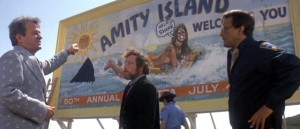 These films captivated moviegoers year-after-year, and throughout the 1980s I was one of the summer masses going to theaters for every big opening day. It was the heirs to Jaws’ legacy that made me love movies.
These films captivated moviegoers year-after-year, and throughout the 1980s I was one of the summer masses going to theaters for every big opening day. It was the heirs to Jaws’ legacy that made me love movies.
It took me 36 years to get around to watching Jaws, but when I did I immediately recognized that this film’s DNA was passed on to all of the favorite films from my youth.
Tomorrow — 1976!
Arnie is a movie critic for Now Playing Podcast, a book reviewer for the Books & Nachos podcast, and co-host of the collecting podcasts Star Wars Action News and Marvelicious Toys. You can follow him on Twitter @thearniec
August 5, 2014 Posted by Arnie C | 40-Year-Old Critic, Now Playing Podcast, Podcasts, Reviews | 40-Year-Old Critic, Arnie, Jaws, Now Playing, Now Playing Podcast, Review, Shark, Steven Spielberg, Summer Blockbuster | 6 Comments
40 Year-Old-Critic: The Texas Chain Saw Massacre (1974)
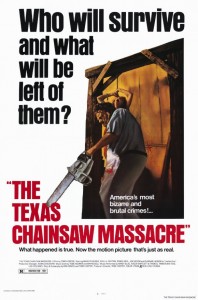 In The 40-Year-Old Critic, Venganza Media creator and host Arnie Carvalho recalls a memorable film for each year of his life. This series appears daily on the Venganza Media Gazette.
In The 40-Year-Old Critic, Venganza Media creator and host Arnie Carvalho recalls a memorable film for each year of his life. This series appears daily on the Venganza Media Gazette.
I was born in 1974, and if my parents took me to a movie that year I have no memory of the trip. In the 40 years since, I’ve caught up on many of the classics from that year such as The Godfather Part II, Blazing SaddlesThe Conversation, and Young Frankenstein. But, truthfully, none of those pictures shaped my life nearly as much as the small indie film The Texas Chain Saw Massacre.
Of course, I didn’t see this film in its original release. I was only 19 days old when Texas Chain Saw hit theaters. And while my parents were pretty lax with the content of movies I watched or books I read, even they would have had serious concerns about my watching teens carved up for food. I got into true, hard R-rated horror films when I turned 12, and the constant Chain Saw references in the 1987 Mark Harmon film Summer School had me finally rent this grindhouse film on VHS.
I was unimpressed.
I had built Leatherface up in my mind as a Freddy, a Jason, or a Michael Myers. But, in truth, Leatherface had none of the slick, commercial appeal of those later imitators. As such, the film was less fun for me as a teen. I later returned to Texas Chain Saw in 2010 for Now Playing Podcast’s retrospective series and, to the shock of many listeners, I gave it a red arrow. The cacophonic score, annoying performances, and dirty, low-budget look of the film still made it a movie I couldn’t enjoy. I labeled it “horror homework” — great for aficionados of the genre but not a film I’d recommend for the masses.
But while I may not recommend watching the film I truly recognize there are few films more important than this. It is no exaggeration to say that without The Texas Chain Saw Massacre the horror films I love may never have come to be.
First, Texas Chain Saw was a hugely successful film, costing only $300,000 to make and grossing over $30 million at the US box office (which, per BoxOfficeMojo is more than $131 million adjusted for inflation). This showed studios that inexpensive horror films could make bank.
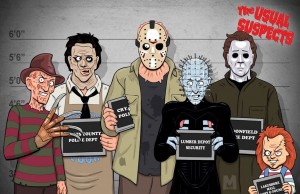 In addition to showing studios a pathway to profit, Texas Chain Saw also inspired screenwriters and directors. This film, along with Alfred Hitchcock’s Psycho, provided a template for the “slasher” sub-genre of film, combining a masked killer with an iconic weapon Later horror films like Halloween, Friday the 13th, A Nightmare on Elm Street, and even Scream and I Know What You Did Last Summer, all series that I love, took this formula and refined it for even greater success. And Leatherface’s greatest successor may just be Hannibal Lecter, another cinematic cannibal that has captured my imagination.
In addition to showing studios a pathway to profit, Texas Chain Saw also inspired screenwriters and directors. This film, along with Alfred Hitchcock’s Psycho, provided a template for the “slasher” sub-genre of film, combining a masked killer with an iconic weapon Later horror films like Halloween, Friday the 13th, A Nightmare on Elm Street, and even Scream and I Know What You Did Last Summer, all series that I love, took this formula and refined it for even greater success. And Leatherface’s greatest successor may just be Hannibal Lecter, another cinematic cannibal that has captured my imagination.
More, this film launched director Tobe Hooper into the spotlight, paving the way for him to direct Poltergeist, another seminal horror film of the haunted house variety. (And yes, we discussed how much influence Hooper had on Poltergeist in Now Playing Podcast’s 2011 Spring Donation Drive. Those podcasts are no longer available.)
While this film doesn’t click with me as entertainment, I credit Texas Chain Saw for paving the way for later horror films I love. This film was born the same time I was, and without it I would not be the man, or the movie critic, I am today.
I do, however, stand by that red arrow. As I found out when I was 13, this isn’t a film I can recommend for those looking for the same glossy thrill given by Friday the 13th Part VI. It is not a Hollywood production and it shows. But while I can’t recommend it, I love it for the future films it enabled.
Tomorrow — 1975!
Arnie is a movie critic for Now Playing Podcast, a book reviewer for the Books & Nachos podcast, and co-host of the collecting podcasts Star Wars Action News and Marvelicious Toys. You can follow him on Twitter @thearniec
August 4, 2014 Posted by Arnie C | 40-Year-Old Critic, Now Playing Podcast, Podcasts, Reviews | 40-Year-Old Critic, Arnie, Freddy, horror, Leatherface, Michael Meyers, Now Playing, Now Playing Podcast, Review, Texas Chain Saw Massacre, Texas Chainsaw Massacre, Tobe Hooper | 10 Comments
Review: The LEGO Movie — Everything Isn’t Awesome.
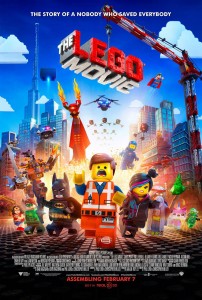 The rise of LEGO from brick-building toy to multimedia empire has been fascinating to watch. For almost 50 years LEGO was a staple in every boy’s toy box, but that’s where it ended. In the 1990s, though, LEGO started to branch out with video games, television specials, and more. As an adult Star Wars and Marvel LEGO collector I’ve watched with great interest as the toy company produced several amusing TV episodes and the video games, though some of their productions clicked with me more than others (the recent Marvel Superheroes: Maximum Overload was a rare misstep). Still, I always saw LEGO as leveraging their licensed titles for multimedia projects rather than creating their own characters and situations.
The rise of LEGO from brick-building toy to multimedia empire has been fascinating to watch. For almost 50 years LEGO was a staple in every boy’s toy box, but that’s where it ended. In the 1990s, though, LEGO started to branch out with video games, television specials, and more. As an adult Star Wars and Marvel LEGO collector I’ve watched with great interest as the toy company produced several amusing TV episodes and the video games, though some of their productions clicked with me more than others (the recent Marvel Superheroes: Maximum Overload was a rare misstep). Still, I always saw LEGO as leveraging their licensed titles for multimedia projects rather than creating their own characters and situations.
As such, I wondered what plot could propel The LEGO Movie. LEGO has no characters, their sets exist to stimulate the imagination of the builder. Despite having a strong voice cast, including Morgan Freeman, Will Ferrell, Elizabeth Banks, Will Arnett, Liam Neeson, and Guardians of the Galaxy‘s Chris Pratt, this is a movie I would likely have skipped were it not for the strong word of mouth. On Twitter, Facebook, and elsewhere I read great praise for The LEGO Movie and so I decided to give it a chance.
Thirty minutes into the film I was regretting that choice.
As I’ve heard nothing but praise sung from the heavens since The LEGO Movie opened I do realize mine may be a minority opinion. That said, I cannot get past the film’s rote storyline. The movie follows Emmet Brickowski (Pratt), a LEGO minifigure who’s only remarkable quality is how average he is. Early in the film the character’s desire to build friendships comes off desperate and pathetic. The film quickly introduces other stock characters including the love interest, the bad guy, and the henchman, and even an eight-year-old could see where this story was going.
But only a child who skipped his Ritilin would want to see it through. The loud, garish editing of the film’s opening could appeal only to the most ADHD-addled minds. Worse, the opening montage is a musical number set to the irritating Disney Radio-esque earworm “Everything is Awesome.” One-third of the way into the film I strongly considered turning it off and forfeiting my $5 iTunes rental fee. LEGO had finally created their own characters, but failed to create a single one I wanted to watch on screen.
Then Batman showed up.
I have seen Batman save thousands of lives in television and film, but no rescue is more impressive than the way The Dark Knight (voiced by Will Arnett) salvages The LEGO Movie. Soon after Batman appears more LEGO licensed properties arrive, from Star Wars to the LEGO NBA All-Stars to “Middle Zealand” (did Weta not want to share in the fun by letting LEGO use the name Middle Earth). While the story of The LEGO Movie was beyond repair, the inclusion of these licensed LEGO characters brought to the film some of the winking, good-natured fun I had seen in the licensed LEGO games and TV specials. Finally some of the jokes really started to hit (the one about Batman only using black or dark gray bricks was one of the laugh-out-loud moments in the film).
Anyone who has seen Toy Story could figure out where this movie was going, especially when real-world, non-LEGO items like Band-Aids, golf balls, and Krazy Glue start to appear. Yet despite figuring out the world these LEGO builders had crafted, even I was shocked by the schmaltzy, live action ending the film had in store.
The true irony is that the film seems to be mocking commercialism while, at the same time, being a giant commercial. The song “Everything is Awesome” epitomizes this theory–it’s mocked in the film for its banality, while the movie plays it endlessly and sells it as the title track on the movie soundtrack. More, a LEGO movie exists to sell kids LEGO toys–there are LEGO Movie licensed building sets. As such, the hypocrisy on display with the film’s demonization of commercial culture is astounding.
In the end, LEGO is a pretty average film. It has a strong “believe in yourself” message that I’m sure is great for those of single-digit ages, but unlike some of the Pixar or recent Disney animated films I felt LEGO lacked in broad appeal. Perhaps this is because I was never deep into LEGO (though I did own the red and blue spacemen in the 80s). The only thing that saved this movie for me was the humor. Superman’s loathing of Green Lantern was a high point (especially given how Warner Bros. has seemingly disavowed the Ryan Reynolds film) as was the mispronunciation of everyday items.
Because I did laugh out loud several times during this film I give it a RECOMMEND, but this film, like its main character, is nothing special.
As for that ending, I have a personal story to share
SPOILER ALERT
The most shocking thing about the film is that, in the end, it is a corporate statement against those who want to glue their LEGO sets together. Unlike many toy companies who are happy to have customers buy and collect their toys for whatever reason, The LEGO Movie states clearly there is a right way and a wrong way to play with LEGO.
As stated earlier I am an adult LEGO collector. I spent a week building a LEGO Star Wars AT-TE and had it on display for quite some time, though I’d sometimes return to find bricks had fallen off. After moving to a new house I unpacked my AT-TE to find it as a pile of bricks not too unlike what had originally come in the box.
Frustrated by this, in 2009 while covering a toy event I asked a LEGO Master Builder which glue they recommended to keep LEGO sets whole. The LEGO builder refused to recommend a glue and said the intent of LEGO is to build them again and again. I pressed on the issue, though, pointing out the impressive display LEGO had. I asked, honestly curious, if that was built on-site. He admitted that the set was built and transported. Though he wouldn’t admit the displays were glued, it was strongly implied. Eventually he relented and told us that most forms of super-glue will keep the sets together.
But now I see that corporate anti-glue attitude on display in a full film. I wonder if I was the only one audacious enough to ask a Master Builder how to glue my sets together or of the question may be common. Now, rather than have to answer us one-by-one LEGO has answered as a company with this movie.
July 5, 2014 Posted by Arnie C | Movies, Now Playing Podcast, Podcasts, Reviews | Animation, Batman, Kids, LEGO, LEGO Movie, Movie, Review, Star Wars | 1 Comment
Halloween 35th Anniversary Blu-Ray: The Night HE Looks Better Than Ever!

Review copy provided courtesy of Anchor Bay
If Psycho is the granddaddy of the slasher film, Halloween is the father of modern horror. While the 1970s had its fair share of horror films, including The Texas Chain Saw Massacre and Black Christmas in ‘74, Carrie in ‘76, Dawn of the Dead in ‘78 and so many more, it was Halloween’s critical and box office success that put a new spotlight on horror cinema.
For many the Halloween season is a time to rewatch Halloween the film, and this year you can watch John Carpenter’s classic like never before. On Tuesday, September 24th, Anchor Bay releases the 35th Anniversary Edition of Halloween on Blu-ray.
Halloween has been released to home video many times. I personally have bought DVDs of the original cut, the longer cut with the TV footage added, the 25th Anniversary Edition DVD, and the original 2007 Blu-ray release. Given that I’ve spent so much money on Halloween, and that I already owned it on Blu-ray, I was skeptical that another release would be worth the purchase. It felt like another “double dip” Blu-ray release.
I quickly learned how wrong I was when I looked at the disc in person. Bound in a gorgeous, gold embossed DVD case, the video boasts an all new commentary with Carpenter and star Jamie Lee Curtis. There is also a new documentary following Curtis as she makes a rare appearance at a fan convention. These are great new bonus features for fans of the film. Additionally, as bonus features, you get an older featurette and the extra footage shot for the TV release.
I rarely find bonus features worth the repurchase of an entire movie, so despite the quality of these new additions I was still unmoved that a new copy was worth a buy. Special features, commentaries, these are items I watch once at most; it’s the film itself that gets played time and again in my home theater and which motivates my purchases. So could this new release impress me enough, especially since I already own a copy of Halloween in 1080p?
The answer is an unequivocal “YES!” With the 35th Anniversary Blu-ray you can see this horror classic at home like never before. I have seen Halloween in theaters at conventions and in the above listed DVDs and Blu-rays. With all of those in mind, I say without a doubt it has never looked better to me than it does on this video release. The picture is crisp and the motion smooth, as I have come to expect from high-grade Blu-rays. But often on even quality Blu-ray releases I’ve noticed colors that are too saturated or a picture that has had too much grain removed, giving the entire film a blurry quality. None of those earmarks of Blu-ray audience pandering are on this disc. This Blu-ray contains a brand new transfer of the film overseen by Dean Cundy, the movie’s original Director of Photography. You are now, for the first time, able to see this movie the way Cundy envisioned it as it was shot, and the difference is marked. The colors are more muted than I’ve come to expect, and the result fits both that 70s vibe as well as the film’s atmospherem. The color timing was a point of contention for many with the original Halloween Blu-ray release, and Anchor Bay has certainly corrected it here. Anchor Bay did this film a great service in hiring Cundy to oversee the video.
Additionally the audio is perfect, with a mono score for the purists, as well as a 7.1 TrueHD lossless soundtrack. Carpenter’s haunting piano and synth score has never sounded as good as it does here, and the movie audio is rich and immersing. The effects are a bit center-channel heavy, which is common for upmixes of older films, but it’s a great effort for those of us who prefer multi-channel audio.
All that said, there are a few areas where I wish this release was beefed up. There are many bonus features that were released previously, including older commentaries and documentaries, that are not included here. As such, for bonus feature collectors, this release is not a one-stop shop. Additionally, the bonus made-for-TV footage is presented in an ugly DVD resolution with colors much more saturated than the actual film. I would have liked to see the TV footage given the same treatment as the movie and a branching option available to watch both the movie’s extended cut, with those scenes reintegrated, as well as the original theatrical cut. But while these are features that would have been nice to have, they are not requirements. As I’m certain this is not the last time HE will come home on video, perhaps these bonuses are being held back for a future release.
But as stated, the true value of this disc, the “feature” I’ll revisit again and again, is the movie, and now owning this disc this is the only version of Halloween I will ever rewatch. The transfer, the audio, the overall production values, are exceptions. So Trick-or-Treat yourself to this movie, available today.
As for the movie itself, you can hear Stuart, Arnie, and Brock review Carpenter’s original Halloween as well as all the sequels, remakes, and sequels to remakes in the franchise, in the archives at NowPlayingPodcast.com
September 24, 2013 Posted by Arnie C | Movies, Now Playing Podcast, Podcasts, Reviews | 1970s, Anchor Bay, Blu-ray, Halloween, John Carpenter, Michael Myers, Movie, Movies, Now Playing, Review | Comments Off on Halloween 35th Anniversary Blu-Ray: The Night HE Looks Better Than Ever!
Review: Lou Ferrigno – Liberator Issue 1
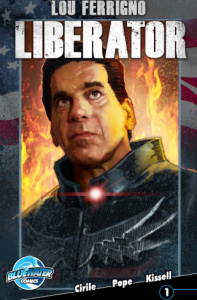 Lou Ferrigno has come full circle. He achieved international fame playing TV’s Incredible Hulk, based on the green, raging Marvel Comics character. Now there is a comic based on a character Ferrigno played on screen–Lou Ferrigno: Liberator. It is a 2-shot comic, of which I have read part 1.
Lou Ferrigno has come full circle. He achieved international fame playing TV’s Incredible Hulk, based on the green, raging Marvel Comics character. Now there is a comic based on a character Ferrigno played on screen–Lou Ferrigno: Liberator. It is a 2-shot comic, of which I have read part 1.
Now, full confession, I had never heard of Liberator, the short film on which this Bluewater Comics title is based. I received a solicit from Bluewater requesting we review the title, and was provided this first issue.
From the title, with Ferrigno’s name prominent and his face drawn on the cover, I expected an End of the World type story telling of a “real world” Ferrigno becoming a superhero. The rock band Kiss had such stories told, as did Mr. T and pro wrestler The Undertaker. So I was surprised to see that despite his name in the title Ferrigno is neither a character in this book, nor credited as part of the comic’s creative team.
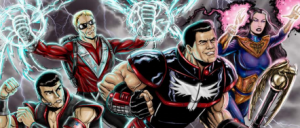
Research then led me to realize that this comic is an adaptation of an 18-minute film starring Ferrigno, Don ‘The Dragon’ Wilson, and Star Trek’s Michael Dorn. Both the film and comic focus on Ed Migliocetti (Ferrigno), pro footballer-cum soldier-cum superhero named Liberator. A decade earlier Ed was assigned to kill someone, but rather than be a whistle-blower he took a fall that landed him in prison. separating him from his wife and daughter. Now Ed wants redemption and is writing a tell-all book. Of course, shadowy figures don’t want the truth coming out, and the first issue ends on a cliffhanger.
This comic is a very short read. With more of an emphasis on art rather than dialogue, the book feels very anemic for a first issue. It is an introduction issue and little more, with the characters and movie events recapped for those who have not seen the film. While the story has a good hook, there is nothing in this first issue to make me crave Issue 2.
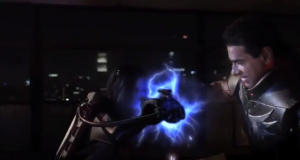
But the research did take me to YouTube where I saw a trailer and a clip for the film Liberator and despite the cast being a list of comic-con autograph hall staples, the production values have me very interested. Unfortunately there is no online or video release of Liberator, the film. It is currently touring.
The film looks really good, but the comic only works for me as a teaser for the film itself. It’s a pretty book, but the story is average. So I will give it a pretty average rating of 2.5 stars.
September 11, 2013 Posted by Arnie C | Comic Books, Marvelicious Toys, Movies, Podcasts, Reviews | Bluewater Comics, Comics, Hulk, Incredible Hulk, Liberator, Lou Ferrigno, Review | Comments Off on Review: Lou Ferrigno – Liberator Issue 1
Review: The Chronicles of Riddick: Dark Fury
At the end of Pitch Black only three passengers of the spaceship Hunter-Gratzner were still alive. These three, Riddick, Jack, and Imam, took to space, destination unknown. Possibly New Mecca, if their little shuttle could make the trip. At the beginning of Pitch Black’s follow-up film, The Cronicles of Riddick, Riddick is a shaggy haired, scruffy bearded refugee on U.V. 6 chased by a bounty hunter named Tooms, Imam is on a planet called Hellion Prime, and Jack is a captive on the prison world of Crematoria.
Did you wonder how these three survivors split up? Why they were not all living happily together on New Mecca? Nope, those questions never crossed my mind either, but continuing to answer questions fans never asked come DVD bonus features and animated interquel films, such as The Chronicles of Riddick: Dark Fury.
This direct-to-video animated short picks up immediately where Pitch Black left off. We see Riddick’s shuttle had barely left the planet when a mercenary ship arrived and captured the three survivors of the Hunter-Gratzner. But this is no ordinary merc troupe—this cadre is led by Antonia Chillingsworth, a psychopath who equates murder with art. She has traveled the galaxy collecting the most notorious killers and turning them into frozen, living statues in her gallery, cherishing the artistry of homicide.
What are the odds of such a collector randomly stumbling across Riddick, one of the galaxies most infamous killers? Slim. But logic goes out the window early in this action-fest who’s real purpose is not to tell a story but to entice Pitch Black fans with more of Vin Diesel’s monotone lines, and more of Riddick’s talent for killing.
The short was directed by Peter Chung, and without knowing his name I knew his work—the animation style, violence, and sensibility of Dark Fury closely mirrors that of Chung’s best-known creation Aeon Flux. Despite being based on a story by Riddick’s creator David Twohy, the film has Chung’s fingerprint on every frame. As such, your opinion of Chung’s old Liquid Television action heroine will likely influence your viewing experience of this Riddick animated movie.
With Chung’s style-over-substance approach Dark Fury’s 35 minute running time drags despite being almost nonstop action from start to finish. The fights are inventively staged; Riddick’s final showdown with Junner, Chillingsworth’s lover and chief lieutenant, is a highlight. But for me the animated violence fails to adrenalize. Like the merc leader I appreciate Chung’s artistry but feel no passion for it myself.
And if the action doesn’t work there is little else in the movie. The character moments entirely reprise those from Pitch Black—Jack idolizes Riddick; Riddick will risk his life to save Jack and Imam despite seeming to care for nobody but himself. We’ve seen it all before, done better. The film also introduces a new nemesis for Riddick: Tooms. This establishes Tooms as a soldier for Chillingsworth before we see him as a merc in The Chronicles of Riddick film, creating an unnecessary bridge between the two films.
But despite being unnecessary, I enjoyed this short far more than the film that succeeded it. It is stylized and violent with a good hint of dark humor as well. I have long been a fan of Aeon Flux and appreciate Chung’s return to form. It’s something only a fan of Chung or Riddick can appreciate, but as a fan of both I give it a recommend.
September 6, 2013 Posted by Arnie C | Movies, Now Playing Podcast, Podcasts, Reviews | 2000s, Action, Animation, Direct-To-Video, DVD, Movie, Movies, Now Playing, Pitch Black, Review, Riddick, sci-fi, Vin Diesel | Comments Off on Review: The Chronicles of Riddick: Dark Fury
Review: Into Pitch Black
Before Pitch Black hit theaters audiences were invited Into Pitch Black–a Sci Fi Channel special promoting the film. But unlike most TV specials promoting new release films with their behind-the-scenes footage and “making of” documentaries, Into Pitch Black took us into the Pitch Black universe with a fully dramatized story. It’s a rarity not included on any home release of the Riddick films, nor easily obtained online. But as part of Now Playing’s Riddick Retrospective Series I did my best merc impression and captured a copy.
Taking place several months after the events in Pitch Black we follow an unnamed law enforcement officer charged with finding escaped convict Richard B. Riddick, last seen aboard the spaceship Hunter-Gratzner. Unable to find any leads, the officer hires a female bounty hunter to help his investigation.
As the two dig into the background of several passengers on the Hunter-Gratzner we are treated to many scenes from the actual movie Pitch Black. Of the special’s 45-minute running length, about 15 minutes are scenes from the movie. We witness the spaceship’s crash-landing and several of the survivors exploring the planet. The narrative sells these scenes as information found during the investigation.
To try and expand the universe beyond the events in Pitch Black we also get footage, shot night-vision style, of “Cutter”, the psychologist who studied Riddick in prison. In the only useful piece of trivia in the special we find Cutter was the doctor who “shined” Riddick’s eyes, giving him night vision (a fact later retconned out in the video game The Chronicles of Riddick: Escape from Butcher Bay).
Despite the aspirations of being a mini-story set in Riddick’s universe, Into Pitch Black never escapes the trappings of a promo TV special. There is a lot of emphasis in teasing the audience with Pitch Black footage. More, the low production values of this special, from the washed-out home-video camerawork to the worse-than-porno acting makes this show virtually unwatchable. To have this amateurish footage intercut with high value production and acting by Keith David and Vin Diesel makes the new scenes seem even more pathetic.
I believe the obscurity of this piece is because it is an embarrassment–nothing any Riddick fan would really want to revisit. I give it a strong Not Recommend.
August 28, 2013 Posted by Arnie C | Movies, Now Playing Podcast, Podcasts, Reviews, Television | Now Playing, Pitch Black, Review, Sci-Fi Channel, Syfy, Television, Vin Diesel | Comments Off on Review: Into Pitch Black
Movie Review: Kate & Leopold
This was released on Christmas Day…I’d have preferred the lump of coal.
Today The Wolverine opens in US theaters. Excited for this next film in the X-Men saga I watched Kate & Leopold, a 2001 romantic comedy starring Meg Ryan and Hugh Jackman.
No, I wasn’t just going to watch any Jackman film; Kate & Leopold is directed by James Mangold, and based off their working relationship in this film Jackman tapped Mangold to direct The Wolverine when first choice Darren Aronofsky dropped out. Jackman has said in interviews this decision was based largely off their relationship founded during Kate & Leopold.
While Mangold has done many other respected films, including award-winning Walk the Line, Girl, Interrupted and 3:10 to Yuma, plus the Tom Cruise action/comedy Knight and Day, I wanted to see this Jackman-Mangold time-travel rom-com collaboration to set my expectations for The Wolverine. Would I see something in Kate & Leopold, a spark of creativity, a visual flare, that would show Mangold a good fit for a high-octane comic book film? Would Jackman’s performance be one no other director had been able to get from the actor? Would I see anything in this film to indicate through style or sensibility that Mangold was the man to give fans, as the TV ads state, “the Wolverine film you’ve been waiting for”?
Having now seen Kate & Leopold I certainly hope not.
Jackman stars as Leopold, a 19th century Duke and future inventor of the elevator (which, the credits admit, is not historically accurate). With his family fortune dwindling Leopold is forced to take a wealthy wife, though Leopold has never loved anyone. But at the party where his engagement will be announced Leopold spots Stuart (Liev Screiber)–a strange, shifty man carrying a miniature camera.
Stuart is actually Leopold’s great-great-grandson from present day New York City. Through the laziest time travel explanation ever (he just jumped off a bridge), Stuart came back in time to see his ancestor. But Leopold gives chase and both he and Stuart arrive in 21st Century Manhattan. There, Leopold meets Stuart’s ex-girlfriend Kate (Ryan), a cynical, bitter, career-minded woman, working in market research. Eventually Kate’s resistance melts and she falls in love with the Duke, but Leopold must return to his own time lest a paradox remove all elevators from modern life.
From the trailers and description, I expected Kate & Leopold to be a version of Back to the Future. Jackman plays a man unfamiliar with modern technology and customs, so the obvious plot would be that his focus is to return home while also falling in love. Plus the ancient-man-in-modern-times concept has many opportunities for hilarity, as seen in Jean Renot’s The Visitors.
But under Mangold’s direction Kate & Leopold eschew most all attempts at comedy or realism. The film is a banal romantic fantasy tailored for aging, lonely women. As Leopold, Jackman is polite, charming, and handsome. More, his every attention is given only to Kate–he has no job, no friends, nothing else to occupy his time; Kate is the center of his world. He makes her breakfast in the morning, does her dishes in the evening, and stands up when a lady leaves the table. Leopold doesn’t even seem to want to return to his own time, he’s happy to just stay in the future, living in Stuart’s apartment and romancing Kate.
In Ryan’s introductory scene she is doing market research on a rote rom-com which isn’t working. The researchers think the female lead is unlikeable, and the film’s director exclaims that marketers are sucking the soul from the art of film. That is certainly true of Kate & Leopold. The entire film is so obvious it is set to play to a test audience of the least sophisticated of Americans. An audience with expectations set so low as to simply find comfort in the familiar.
And a romantic comedy with Meg Ryan as the female lead is nothing if not familiar. Here, in the waning years of her popularity, her face taut and lips inflated by the work of a plastic surgeon, Ryan is breaking no new ground. Her character Kate observes a neighbor who plays the soundtrack for Breakfast at Tiffany’s every night, and the same can be said for much of Ryan’s career, stuck in an endless loop of interchangeable roles as a romantic lead. Certainly she does nothing here to broaden the range of her characters.
I am a fan of escapist fantasy, but Kate & Leopold is too obvious in its pandering, and painful to watch in that it ignores its own ironies. Kate broke up with Stuart because he was an unemployed dreamer, yet she falls in love with his ancestor who is just a more romantic version of that same persona. More, as Kate eventually travels back in time to marry Leopold, the film glosses over the icky fact that for four years Kate was sleeping with Stuart, her great-great-grandson!
The film does have several chase scenes, such as Leopold running down a mugger in Central Park and Kate having to rush to travel back in time before the portal closes. Under Mangold’s direction these scenes have no spark to them. They feel obligatory, not exciting. Kate and Leopold stole the plot from Back to the Future’s climax, but got none of its excitement.
This film is not recommended for any but the loneliest of spinsters who want to dream of finding love before their lady parts dry up.
And Kate and Leopold has given me a feeling of trepidation as I prepare to see The Wolverine. There is no doubt Jackman made friends while hanging out on sets leftover from Gangs of New York–Schreiber would play his “brother” Sabertooth in the first Wolverine film; Mangold would direct the second. But in a film this unoriginal I see nothing that makes me think Mangold is a fit for The Wolverine.
But we will find out! You can hear Now Playing’s review of The Wolverine on August 13th at NowPlayingPodcast.com
July 25, 2013 Posted by Arnie C | Comic Books, Marvelicious Toys, Movies, Now Playing Podcast, Podcasts, Reviews | 2000s, Comics, Hugh Jackman, James Mangold, Marvel, Meg Ryan, Now Playing, Review, Romance, Romantic Comedy, Romcom, Time Travel | Comments Off on Movie Review: Kate & Leopold
Film Fans of All Types Can Enjoy Days of the Dead
To someone who’s never been to a horror convention the thought could be as frightening as the blood-soaked splatter fests that appear on screen. One could imagine pale, pierced social misfits and psychopaths standing in line to meet their favorite serial killer. Many may feel if they aren’t into the gory or the grotesque then a horror convention is not for them.
That impression is totally false as shown last weekend at the Days of the Dead horror convention in Indianapolis. Of course it was a blast for those into fright films, but it also had entertainment to offer any movie lover!
One of the big draws of the convention were the large number of celebrity guests in attendance. The stereotype of a celebrity on the autograph circuit is an actor with his career on the decline, clinging to former fame. Days of the Dead proved that image wrong by bringing in several A-list celebrities promoting current films. Some of the headlining guests have big movies out soon included Danny Trejo (Machete Kills in October), Keith David (recently in Cloud Atlas and a dozen more films in production), and Academy Award Nominee Gary Busey (Behaving Badly due out this year). This is an amazing roster for a con only in its third year, besting some of the other national companies who host conventions in the Midwest.
Access to the celebrities was incredibly easy. At many conventions fans have to wait in line for four hours or more to meet their idols. At Days of the Dead my wait time to see Trejo was 10 minutes, and only 15 minutes for Busey.
More, the prices were very reasonable. At conventions such as Dragon*Con or San Diego Comic-Con I’ve paid over $100 for signatures from actors who have not worked in several decades. At Days of the Dead the majority of autographs were $20 and headliners Busey and Trejo were just $40. Trejo would take a picture free with an autograph, while Busey charged only $10 additional for a photo; at some conventions photo opportunities start at $20 and can be as high as $150.
While all of the celebrities have horror films on their resumes, Trejo would sign a copy of the comedy Bubble Boy as rapidly as the vampire film From Dusk ‘Til Dawn, and Busey had available photographs of his roles in Lethal Weapon and Point Break. I did not see anyone asking Keith David to sign their copy of Requiem for a Dream but I doubt he’d have declined.
All the guests were not just polite but completely engaged with the fans, having short conversations and truly making the con attendee feel appreciated. This is far better than the assembly-line like atmosphere found by some guests at Wizard World or New York Comic Con. In fact, the longest line to see a celebrity seemed to be A Nightmare on Elm Street 4 star Lisa Wilcox who would spend up to 5 minutes talking with her fans while signing their items. (Unfortunately for Wilcox one of those fans I observed was a socially awkward male in his twenties regaling her with a story about a specially lit photo he had of Wilcox in his bedroom…so while some of the stereotypes were present at the con most of the attendees were overwhelmingly normal).
Even the guests whose primary work was in horror had non-horror items available. For example, Wilcox is best known for starring in A Nightmare on Elm Street but the actress also had available a wide selection of photos from her single-episode guest-starring role in Star Trek: The Next Generation. As she rarely appears in the Midwest, Wilcox was a draw for Trekkers and horror fans alike. Original Nightmare on Elm Street star Heather Langenkamp also had a minor role in this summer’s Star Trek: Into Darkness.
Of course, the horror fan had much to celebrate. Icons of the genre including Tony Todd (Final Destination, Candyman, Wishmaster), Derek Mears (the Friday the 13th reboot, 2007’s The Hills Have Eyes II), Tyler Mane (Michael Myers in both Rob Zombie’s Halloween films), Leslie Easterbrook (Zombie’s Halloween and The Devil’s Rejects), several stars of Cabin Fever, and over a dozen more horror film character actors were also there.
The vendor areas of the convention were a shopper’s delight. While the non-horror fan would find less that appeals to them in the vendor booths, there were plenty of superhero toys and Star Wars collectibles to choose from. I bought an original painting based on the Howard the Duck movie!
Many booths catered to all children of the 80’s, including Don’t Eat the Gum – a company that sells trading cards from the 1980s and 1990s (and my wife should have listened to the company name as she almost broke her tooth on a stick of gum from Howard the Duck trading cards…the gum was made in 1986). Also there was Adjust Your Tracking selling movies on VHS that were never officially available on DVD.
Of course, being a horror convention, slasher-film fans could buy items not found anywhere else. Many booths offered DVDs of horror movies, including bootlegs of some incredibly rare films like Fright Night 2 and Silent Night, Deadly Night: Initiation.
There were also custom T-Shirts, paintings, and other original expressions of creative horror. At one booth Curious Goods offered custom action figures, including Rob Zombie, and Deathtroopers–Star Wars Stormtroopers turned zombies.
The exhibit floor was split into two small ballrooms, a sign that Days of the Dead is quickly outgrowing the space offered by the Wyndham Indianapolis West hotel. Having Days of the Dead split among several walled-off areas did make the convention feel smaller than it was. While it were ever too crowded, as is often found at larger conventions, the lines often crossed and merged, making celebrity areas hard to navigate. This is likely the product of becoming incredibly popular in only three years, and something I’m sure will be corrected at future conventions.
Overall Days of the Dead Indianapolis was an incredible experience, and I will certainly be attending their Chicago convention this November. While the only guests announced thus far are stars of the Return of the Living Dead and The Blair Witch Project it’s sure to be fun!
When not attending conventions across the globe Arnie can be found hosting the movie review podcast Now Playing, which has reviewed hundreds of movies of all genres, as well as the toy collecting podcasts Star Wars Action News and Marvelicious Toys. He also reviews books on the Books & Nachos podcast.
-

- Gnomes protect your flowers…by eating the babies that crawl by! Another gory custom from Curious Goods.
July 12, 2013 Posted by Arnie C | Comic Books, Conventions, Marvelicious Toys, Movies, News, Now Playing Podcast, Podcasts, Reviews, Star Wars Action News | Chicago, Comics, Curious Goods, Danny Trejo, Days of the Dead, Gary Busey, horror, HorrorCon, Illinois, Indiana, Indianapolis, Movie, Movies, News, Now Playing, Review, Television | Comments Off on Film Fans of All Types Can Enjoy Days of the Dead
Movie Review: Despicable Me
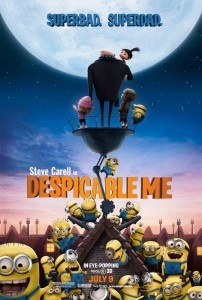 Despicable Me is not a Pixar film. It is not Toy Story where adults and children alike can be swept away into a colorful computer-animated world, both generations equally entertained by the multi-layered storytelling.
Despicable Me is not a Pixar film. It is not Toy Story where adults and children alike can be swept away into a colorful computer-animated world, both generations equally entertained by the multi-layered storytelling.
Despicable Me is also not a DreamWorks Animation film. It is not Shrek where kids laugh at the toilet humor while adults are mildly entertained by the endless barrage of modern pop-culture references.
No, Despicable Me is the first film from Illumination Entertainment, Universal Studios’ attempt to cash in on the computer-animated film market. This studio also released the forgettable Hop and The Lorax (do you even recall either in theaters? I remember The Lorax more from the “turn off your cell phone” ads than the film itself).
Like Illumination’s other two titles, Despicable Me focuses its energy entirely on the youngest segment of the audience. Adults, and even older children, will be familiar with the tropes of the story in which a super villain named Gru adopts three lovable little girls to use as pawns in the crime of the century. Nevertheless, while entertaining the children with bedtime stories and trips to amusement parks Gru finds his nefarious plot mattering less and less while these children become more and more important. The climax of the film is will Gru steal the moon, or will he give up that lifelong dream and attend the children’s Swan Lake ballet.
Gru’s crimes are so soft-core that never is a person hurt, his primary crimes seem to be using a freeze ray to cut in line at the coffee shop while driving an obnoxiously large vehicle. He is more a comment on Hummer-driving, Starbucks swilling suburbanites than criminals.
Given this, I found myself relating very much to Gru in a scene where he is forced to read the three children a bedtime story. “This is literature?” Gru exclaims in disgust, “A two year old could have written this!” Indeed, Gru could be speaking about his own film.
More, an A-list voice cast is wasted. Every role feels written for a different, less famous actor. In the lead role of Gru is Steve Carell. Gru does not speak in the oddly-inflected stammer that is Carell’s trademark in films like The 40-Year-Old Virgin, Anchorman, and Dinner for Schmucks. Instead, Carell adopts his worst brogue accent. In voice and in inflection he comes across as a poor man’s Mike Myers. Jason Segel is unrecognizable voicing Gru’s nemesis Vector–twisting his windpipes into a lame Andy Dick impersonation. Even astute audience members will only be able to discern Russell Brand as he voices the one character with an English accent, his voice affected (or digitally altered) to the point of sounding like any generic Cockney.

But despite breaking no ground in storytelling, Despicable Me is not without its charm. While the primary plot and the characters of Gru and the children are all adequate, the film’s spark of originality come from Gru’s minions–a drove of mostly indistinguishable short, yellow creatures that aid Gru in his plots. They speak in unintelligible babble, but their giant eyes, wide smiles, and good nature light up the screen (sometimes literally). They engage in wacky slapstick, dressing up in human clothes to go shopping, and engaging in Gru’s wild experiments. It is physical, silent comedy in the tradition of Charlie Chaplin and Buster Keaton. Their jokes come in a rat-a-tat manner while also including wonderful callbacks. The creatures also have a blind adoration of their master, which makes them lovable like pets. I was far more satisfied at the end of the film by the minions finding their place in Gru’s heart than the three generic children.
It is no wonder that the ads for Despicable Me 2 focus so much on the Minions while the three little girls are nowhere to be seen.
For all its hackneyed, recycled plot devices, Despicable Me is far from despicable. Young children ignorant of common story tropes will undoubtedly be entertained. Adults will find enough here to pass the time, if not hold their full interest. I give this film a mild recommend for adults, and while I will be skipping Despicable Me 2 I anxiously look forward to next year’s Minions film.
When not gushing over the cuteness of Minion bobble-heads Arnie is co-host of the movie review podcast Now Playing.
July 3, 2013 Posted by Arnie C | Movies, Now Playing Podcast, Podcasts, Reviews | Animation, Illumination Entertainment, Jason Segel, Movie, Movies, Now Playing, Review, Russell Brand, Steve Carell, Universal Studios | Comments Off on Movie Review: Despicable Me
The Collection Movie Review
The Collection
Director: Marcus Dunstan
Writer: Marcus Dunstan, Patrick Melton
Starring: Josh Stewart, Emma Fitzpatrick Christopher McDonald, Lee Tergesen, Randall Archer
Studio: Fortress Features Features
Release Date: September 21, 2012
Elaborate, fatal traps? Squirm inducing injuries? Copious blood? Combine these features with a sadistic and mysterious killer and you’ve got The Collection, a sequel to The Collector. The Collector was initially written as a prequel to Saw. When it was rejected, it became its own movie outright, spawning this franchise.
Arkin, having escaped from The Collector, is tapped by a private security team to tell them where he was held captive so that they can rescue Elena, the latest victim. He’s forced at gunpoint to enter the abandoned hotel that is the villain’s lair, in order to make sure that they get their target. As the team is picked off by the deadly concealed ambushes, they are astounded by the grotesque acts The Collector has committed to his victims.
The Collector likes to kill his victims using fancy mouse (human?) traps. Try to escape through a window and you’re likely to have your hand sliced off when you open it. Step on a certain spot on the floor and large spears will impale you. There’s a dotted line in the horror movie family tree from Jigsaw to The Collector. They seem fairly similar in operations. But The Collector lacks a motive. The novelty of Jigsaw was that he offered his victims a chance at redemption. Freeing oneself from the contraption was also freeing yourself from your past. There is nothing hidden here, these exist solely to kill. There is no redemption for any of the victims. The contraptions are not elaborate as they were in the Saw series. These try but they come off more as a deadly Home Alone movie.
The one thing this film does both very well is the character of The Collector. He is incredibly menacing as we have never seen his face nor has he ever spoken. He lurks, stalks and grabs with the precision of Michael Myers. He’s very mysterious with his lucha libre like mask and insect collection. The potential for a great serial killer is there with all of this covertness, but he is too unknown. There just aren’t enough character details to make him a great antagonist. Other than he collects one person to keep from every killing spree, we don’t know anything else about him. He’s portrayed as cryptic for cryptic sake but for no good reason. It was unfulfilling to know so little.
Instead of paying homage to the granddaddy of torture porn, The Collection comes off like a made for TV copycat movie. It’s similar enough to remind the viewer of its roots but it has just enough differences to escape plagiarism. There wasn’t enough originality to make this work and let’s be honest, if you’re going to emulate another franchise, do it bigger, badder and better. Although the murderer has potential, his details aren’t revealed enough to make him add anything more than a frustration. Even with razor blades held to my face, I wouldn’t recommend this movie.
April 10, 2013 Posted by Arnie C | Movies, Now Playing Podcast, Podcasts, Reviews | horror, Movie, Now Playing, Review, Slasher, The Collection, The Collector, Torture Porn | Comments Off on The Collection Movie Review
Movie Review: Spring Breakers
Spring Breakers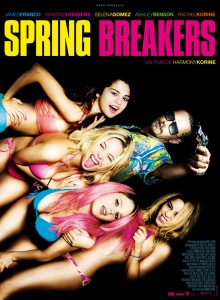
Director: Harmony Korine
Writer: Harmony Korine
Starring: Vanessa Hudgens, Selena Gomez, Ashley Benson, Rachel Korine, and James Franco
Studio: Muse Productions
Release Date: March 22, 2013
Harmony Korine, a provocateur with a long rap sheet of films about juvenile delinquency, isn’t the most obvious candidate for directing a teen party movie set on the beaches of St. Petersberg. His previous youth culture explorations have shunned Disney princesses in florescent bikinis in favor of more extreme subjects – a serial rapist spreading AIDS (Kids), a drooling schizophrenic (Julien Donkey-Boy), cat killers on ten speed bikes (Gummo), and fetishists grinding their pelvises against canisters of garbage (Trash Humpers – his most literal celebration of depravity).
Yet the four curvaceous coeds at the center of Korine’s new opus Spring Breakers share a commonality with all the other freaks in his menagerie: they’re poor, horny and bored… and that makes them dangerous. Desperate to escape the crushing sameness of their deserted dorm, Candy (Hudgens), Brit (Benson), and Cotty (Rachel Korine, Harmony’s wife) use squirt guns and harsh language to intimidate patrons at an all-night diner into funding their hedonistic vacation. Faith (Gomez) knows she’s courting sin by abandoning her Bible study group for beach time with these hellions, but the utopian promise of Florida’s flesh parade proves equally irresistible to her repressed soul. These girls are sick, and fun is the only cure for what ails them.
Ironically, those most primed for the sun-burnt decadence of a Girls Gone Wild video, or crass Hollywood comedy like Project X, will probably be Spring Breakers’ most disappointed audience members. Korine has never cultivated a taste for commercial storytelling or traditional beauty, and remains fixated on unflattering details as he reduces the foursome’s exploits to a disjointed montage of scooter rides and repetitious drunk talk. Boredom hasn’t been conquered, merely transformed into something more frenzied and sad.
The fun doesn’t begin for viewers until our heroines are jailed and forced to take bail money from Alien, a drug smuggler with delusions of rap superstardom. One look at James Franco’s gold-toothed leer as he leads the ladies from the courthouse into a spaceship-shaped bed blanketed in $100 bills tells you Korine has finally found the proof he needs to convict the American Dream. “Look at my sheeyit! This ain’t nuttin’, I got ROOMS of this shit,” the narcissist boasts as he produces everything from Kool-Aid to Calvin Klein cologne in an effort to impress his guests. It’s Alien who completes Candy and Brit’s transformation into gangsta bitches now packing real firepower, and the trio sail off into a day-glo finale filled with Britney Spears sing-a-longs and drive-by shootings.
Many will call Spring Breakers an empty exercise full of callow behavior, and I’ll not dispute them. Still, I Recommend the movie to anyone able to appreciate the singular way Korine and cinematographer Benoit Debie (Enter The Void) render depravity as its own special kind of beauty. The paradox of their painterly images, married with Franco’s gonzo-yet-human performance, creates empathy for these shallow party girls when their words and deeds might otherwise draw contempt. Korine might not be an artist, but I refuse to label him an exploiter. Perhaps we’ll agree he’s that nose picker that sits in the back of the classroom making sculpture out of his boogers. Certainly Spring Breakers is a gross and glorious mess not soon forgotten.
March 28, 2013 Posted by Stuart in LA | Movies, Now Playing Podcast, Podcasts, Reviews | Florida, gomez, harmony korine, james franco, Movies, Review, spring break | 2 Comments
The American Movie Review
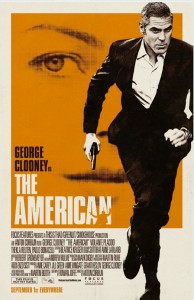
The American
Director: Anton Corbijn
Writer: Rowan Joffé
Starring: George Clooney, Violante Placido, Thekla Reuten, Paolo Bonacelli, Irina Björklund
Studio: Focus Features
Release Date: September 1, 2010
The American is a taut thriller. Every actor delivers an authentic performance that makes their character feel real. Every shot in the film is gorgeous and feels like each frame could be a postcard. The American may just be the best film I cannot possibly recommend.
Clooney plays Jack, a gunsmith and hit man on the run from relentless Swede assassins. In most movies with this type of set-up we would see Jack investigate his attackers, eventually uncovering their boss in an action-filled climax, but The American provides a refreshing, seemingly more realistic take. Instead of going on the offensive, Jack goes into hiding in the Rome countryside, counting on his employer Pavel to keep him safe. More, this attack has frightened Jack, making him want out of his lethal lifestyle.
It’s a very low-key, suspenseful take on a story about hit-men, and that is The American’s greatest strength. Even when Jack’s serenity is interrupted by a Swede attack, the action scenes are bloody and short, the exact opposite of the glossy, adrenaline-filled fights in action films like The Bourne Identity. The scenes are not here to thrill, but to remind Jack, and the audience, that death surrounds him and his quiet respite could come to a bloody end at any moment. This is driven home to great effect.
Indeed, The American treats the Swedes as a subplot, with the main focus being Jack’s relationship with local prostitute Clara. What starts as a purely professional relationship ends in a true romance as Jack connects with Clara, despite not ever truly trusting her intentions. Clara could be a plant, and we’ve already seen Jack kill one girlfriend. As such, Jack and Clara’s scenes together are always bittersweet as the audience knows at any moment one of these lovers could kill the other.
But despite all that is done right, The American fails in many respects. Jack is a laconic cipher We have endless scenes with him drinking coffee, or expertly machining a rifle, but Cloony’s performance always leaves us disconnected from the assassin. Jack’s lies are told so often and so easily that we never know what to believe. We don’t trust Jack and Jack trusts no one, leaving the viewer with no character with whom they can relate. Do we want this agent of death to find love and salvation, or do we want the Swedes to deliver swift justice?
The film’s final fall is in its finale. As we are kept emotionally distant from our main character, his fate becomes ultimately unimportant. The suspense of the eventual double-cross reaches its climax, but in an unfulfilling, perfunctory way.
The American is like one of Jack’s guns–lovingly crafted, expertly made, but ultimately cold and mechanical. Not recommend
March 19, 2013 Posted by Arnie C | Movies, Now Playing Podcast, Podcasts, Reviews | Assassin, Drama, George Clooney, independent film, Indie Film, Now Playing, Review, Suspense, Thriller | Comments Off on The American Movie Review
Would You Rather Movie Review
Would You Rather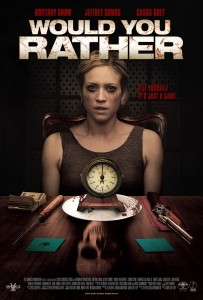
Starring: Brittany Snow. Sasha Grey, Jeffrey Combs, John Heard
Directed by: David Guy Levy
Once you RSVP, it’s too late…
Would You Rather takes an innocent slumber party game and twists it, replacing kissing the school dweeb with self mutilation. Reminiscent of the Saw franchise, this is torture porn with reduced gore. The concept of this movie is grotesque but it’s a safer, gentler release with less in your face graphic violence, all while maintaining an interesting and unique story.
Iris is dead broke after the death of her parents and desperately needs money. She accepts a mysterious invitation to a dinner party that promises the chance to win enough money to solve her problems. The party is hosted by Shep Lambrick (Jeffrey Combs), with the promise of one attendee winning money via an contest. The game is revealed to be “Would You Rather”, the party game that forces you to choose between two choices. Instead of choosing to kiss the their friend Martha or their friend Bob, the guests are astounded to learn that their choices are self mutilation or mutilating someone else. As each round progresses with a new painful challenge, guests are eliminated either by fatal injury or killed during an escape attempt leaving Iris and one other as the finalists.
Refreshing a stale genre, Would You Rather presents a new twist that is both unique and original. The writers rely on implied gore to create the suspense.
The mutilating challenges all sound horrible and conjure graphic images but it’s a stark contrast to what is shown. Lucas’s challenge is to slice open his eye. We hear his resistance, see his panic at the thought but when he actually does it, it is so quick and shot at such an angle that there is no blood. Peter’s challenge is to blow up a firecracker in his hand. It sounds simple enough until it’s revealed to be a quarter stick of dynamite and that it is duct taped thoroughly to his hand. When it explodes, the carnage is poorly lit so it’s impact is minimal and the focus is on Peter having a heart attack. Anything imagined is much worse than what is shown causing a much more intense movie.
Combs is delightful in his role as philanthropist turned sadist Shep Lambrick. Known for his stoic portrayal of Dr. Herbert West in Reanimator, he is wonderfully chipper and animated in Would You Rather. His delight and mockery at the moral dilemmas facing his dinner guests is fun to watch. He munches on snacks while they decide who they are stabbing, shocking or whipping. Combs doesn’t portray Lambrick as a maniac, he’s mostly a madman but with social skills. Combs has such a delightful giggle when he is enjoying tormenting his guests. It’s nice to see him break out and have some fun, even if it is at the expense of others.
Would You Rather is a nice twist on the overdone torture porn genre. It had become graphic for graphic sake (Saw) by replacing shock with copious amounts of blood. By relying on good old suspense and implied violence, Would You Rather takes it to a new level and keeps the audience entertained all the way to the surprise ending.
March 15, 2013 Posted by Arnie C | Movies, Now Playing Podcast, Podcasts, Reviews | horror, Jeffrey Combs, Movies, Now Playing, Review | Comments Off on Would You Rather Movie Review
TV REVIEW: HOUSE OF CARDS (Season One)
A pretty good first hand for an aspiring web series network
Netflix, having successfully slain the video store with their revolutionary DVD-by-mail business model, plans to challenge cable television by offering subscribers an exclusive line-up of streamed programming. The first original show out of the gate is House of Cards – a sophisticated one-hour drama about Washington political corruption that re-teams Oscar winner Kevin Spacey with his Seven director David Fincher. The $100 million price tag and A-list Hollywood talent lets the world know that HBO and Showtime are no longer the only destinations for premium serialized entertainment, but is House of Cards good enough to re-position Netflix as the TV network of the future? Maybe. Season One wobbles under the weight of its many ambitions, but stands on a solid foundation of satire and delicious Machiavellian power plays.
Francis Underwood, Spacey’s silver-tongued Congressman, is our tour guide through the dimly lit halls and shadowy chambers of a White House besieged by distrust and petty grievances. Frank’s got an axe to grind too. The newly re-elected President passed him over for Secretary of State, so now he’s going to mobilize a cabal of conspirators to win himself an even bigger seat in the administration. Despite frequent asides to the camera, stoic Spacey keeps his cards close to the vest. We always know what the scheming politician thinks, but rarely understand what he’s doing behind the scenes. It’s the kind of calculating antihero role the actor has always excelled at playing – a cross between tragic Shakespearean tyrant and his genteel murderer from Midnight In The Garden of Good And Evil.
All we know for certain about Frank’s plot is that it hinges on turning Peter Russo (Corey Stohl, Midnight In Paris) into governor of Pennsylvania, despite the Representative’s well-documented problem with drugs and alcohol (or is that part of the plan?). The one character on this cynical show truly deserving empathy, Russo struggles to clean up his act and become the transformational figure his blue collar constituency needs to survive a downturn economy. Hope is a rare commodity on House of Cards, but Stohl’s raw and human performance inspires it all the same.
Frank’s other key player in the game is blogger-journalist Zoe Barnes (Kate Mara, sister of Dragon Tattoo star Rooney). The Congressman feeds the cub reporter Beltway secrets, which she turns into headlines that keep Frank influential on public opinion. Another series might be tempted to sensationalize the sexual affair that springs from their mutually beneficial partnership, but House of Cards largely avoids arousing libidos. Zoe and Frank’s bedroom scenes contain no more heat than the numerous policy briefings and education bill debates that fill the man’s day planner.
I wish the other characters were more organically integrated into Frank’s schemes. Large chunks of time are devoted to trophy wife Claire (Robin Wright) making difficult choices about her overextended humanitarian organization, and flirting with having an affair of her own. I appreciate the irony of a professional do-gooder turning out to be such a callous person, but it’s a Hillary Clinton spoof that ultimately has little impact on Frank’s rise to power. There’s also a disgruntled natural gas lobbyist, a contracted call girl, a terminally ill bodyguard, and even a barbeque restauranteur. They offer great local color, but drop out of the main story too frequently to truly endear themselves.
On one hand, it’s admirable that Fincher has translated the brooding, monochromatic aesthetic of Social Network and Zodiac into a sprawling D.C. tapestry. He’s never worked with a canvas so large, and I love that he’s able to hold up a mirror to today’s obnoxious political theater and find a marathon of authentic, intimate moments that other media misses. Yet I’ve always felt that television needs to be compulsively watchable in order to sustain viewership. Cruelty can be a darkly satisfying spectacle within the confines of a two or three hour movie, but spend a full season in a reptile cage and all that cold-blooded behavior is bound to numb audience enthusiasm. The trouble is I never had a burning desire to know what happens next, particularly when outcomes rarely stray far from the most pessimistic possibilities.
Maybe it’s a good thing then that all 13 episodes of House of Card’s first season have been made available at the same time. Because every one of the show’s principals plays the long game, it takes several episodes for audiences to get hooked on their myopic power manipulations. Indeed, I wasn’t sold until Hour 6. Binge viewers can consume the low boil intrigue in a single day rather than risk losing interest in the weeks it’d take for the story to climax on broadcast TV.
Overall, this is an easy RECOMMEND for Fincher fans, political junkies, or anyone curious about where TV is heading. And it comes at a bargain when you consider Netflix’s monthly rate for unlimited streaming is comparable to the price of a matinee movie ticket. I don’t’ know if I need to chase after Spacey as he races towards the uncertain fortune of Season Two, but I’m anxious to check out the rest of Netflix’s 2013 line-up: Eli Roth’s April horror series Hemlock Grove, prison sitcom Orange Is The New Black, Ricky Gervais’ Derek, and the return of Arrested Development. It does indeed look like the revolution will not be televised, but streamed.
March 6, 2013 Posted by Arnie C | Now Playing Podcast, Podcasts, Television | David Fincher, Kevin Spacey, Netflix, Now Playing, Review, Television | Comments Off on TV REVIEW: HOUSE OF CARDS (Season One)
Movie Review: Twilight – Breaking Dawn Part 2
Look but don’t sink your teeth into…
The first three Twilight films boiled with sexual desire that could never be quenched in a thinly veiled analogy for abstinence. Once the vows of marriage were made in the fourth entry, Breaking Dawn – Part 1, Bella entered a twisted fairy tale where the swan is reverted to an ugly duckling. She was heavily bruised through rough sex, literally feasted upon by unborn child and husband, and left for dead. The pent up sexual frustration continues to find violent outlets when she is resurrected for Breaking Dawn – Part 2. However, this final installment still maintains a prudeness that doesn’t allow for a satisfying climax; only giving a peek of enjoyable possibilities before quickly covering up.
Bella (Stewart) is now a vampire; having been saved by husband Edward’s (Pattinson) bite that granted her immortality after nearly dying while giving birth. The Volturi, a ruling class of vampires, believe the half-human, half-vampire newborn may threaten the stability between their kind and humans. Bella and Edward must create an alliance between vampires and werewolves if they want to protect the child from the diabolic plans of the Volturi.
The film lacks a sense of irony. I often found myself laughing at the film when I should have easily been laughing with it. For example, Bella must learn to act mortal again to keep her transformation secret. It’s humorous to watch her practice breathing and how to casually slouch because of Stewart’s reputation for being emotionless and stone faced. However, the humor seems unaware of Stewart’s perceived coldness and relies on the actress’s attempt at physical comedy rather than giving the audience a knowing wink. The entire Twilight Saga must receive some kind of erotic gratification from its broodiness if after five films it just can’t relax and have some fun.
The movie also doesn’t understand what makes for an exciting protagonist. Twilight’s vampires are more like superheroes than the classic Dracula. Each character has a unique power—elemental control, telepathy, electric bursts—to accompany the super strength and speed given to all the creatures of the shade (sunlight doesn’t harm them, only makes them sparkle). However, after waiting so long for Bella to become super, her empowerment is backhanded. She can only block other vampires’ more impressive talents. The result is a heroine, already scorned by feminists for being too passive, who mostly stands around projecting invisible forcefields instead of bloodying her fangs in the climactic battle versus the Volturi.
This battle becomes an orgasm of severed heads that somehow maintains a PG-13 rating. The story takes some risks by having major characters decapitated. While the action is merely adequate, there is a certain pleasure with its excess. Or at least there is until the script decides it isn’t that kind of movie. Even these most exciting moments are positioned as safe, unfulfilling fantasies.
There is little gratification to be had as the film frustratingly embodies the franchise’s abstinence subtext. The non-recommendable Breaking Dawn – Part 2 refuses to penetrate the deeper desires of those who committed to the saga.
The Twilight Saga: Breaking Dawn – Part 2 is available on DVD, Blu-ray, and other formats March 2, 2013.
February 24, 2013 Posted by Arnie C | Movies, Now Playing Podcast, Podcasts, Reviews | Movie, Now Playing, Review, stephanie meyer, team edward, team jacob, team jakob, tween, Twilight | Comments Off on Movie Review: Twilight – Breaking Dawn Part 2
Movie Review: The Package
There is nothing good inside this Package
I knew what to expect from Anchor Bay’s The Package. Any film starring Steve Austin (no longer Stone Cold) and Dolph Lundgren is not going to have touching character moments, powerful acting performances, a gripping story, or eye-popping special effects. These types of movies exist to deliver some base thrills with lots of bone-crunching fights and explosive gunfire. But even viewers with those low expectations will leave disappointed in this adrenaline-free shoot-em-up.
The very loose plot of The Package is a rip-off of Jason Statham’s successful Transporter films. Austin plays a mob enforcer tasked with delivering a small package of high importance to The German (Lundgren). Along the way a squad of goons tries to stop Austin in the hopes of ransoming the package to The German for a higher price. The goons just hope to make some money, but as no one knows the contents of the package the goons have no stakes in successfully stealing it from Austin. This makes all the gunfire and fistfights a mere stalling tactic, dragging this film to feature-length.
Unfortunately, the fights are not even entertaining. Directed by veteran Hollywood stuntman Jesse V. Johnson (Starship Troopers, Thor), this film proves just because you can do stunts doesn’t mean you can direct them. The gunfights are loud but uninventive, and the hand-to-hand brawls are all shot with the close-up, choppy, shaky-cam effect that was passé a decade ago. None of the fights even come close to the outrageous WWE matches of Austin’s past.
The movie hits the depths of stupidity when Austin battles one goon in a construction zone. In the background, atop scaffolding, stand two welders going about their work. The light of their arc welder provides a cool strobe-light effect and delivers the only impressive visual in the movie. Despite two large men engaging in mortal combat mere inches from their work area, the teamsters work doesn’t stop. Their torch never turns off, even though a body colliding with their scaffold would likely jolt the machine and scar the workers for life.
If the welders don’t care, why should I?
The high point in this movie is The German. Lundgren plays this mysterious bad-ass for humor. Obsessed with culinary delights, The German regales his victims with recipes for fish sandwiches, fruit smoothies, and martinis. While even in his heyday Lundgren was never one for emoting on-screen, here the aging tough-guy has a subdued sense of playfulness that makes me wish he was given more to do.
Despite the movie saying Lundgren and Austin were on the same side, audience demand the two stars face off, and sure enough they do. This climactic battle between these two action stars should be the most spectacular and memorable fight in the film. Unfortunately, the battle is over in moments, and pales in comparison to some earlier in the film.
Even the most undiscerning action film fan will be disappointed in The Package. It’s an action movie that lacks punch and punches. Not recommend.
February 20, 2013 Posted by Arnie C | Movies, Now Playing Podcast, Reviews | Action Film, Anchor Bay, Now Playing, Review, Steve Austin | Comments Off on Movie Review: The Package
Movie Review: The Watch
Men in Black it isn’t.
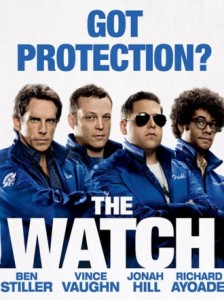 |
|
| The Watch | |
| Starring | Ben Stiller, Vince Vaughn, Jonah Hill, Richard Ayoade |
| Director: | Akiva Schaffer |
| Writer: | Jared Stern, Seth Rogen, Evan Goldberg |
| Studio: | 20th Century Fox |
| Release Date: | July 27, 2012 |
When Evan’s (Stiller) co-worker is found dead, Evan responds the only way he can–by forming a Neighborhood Watch group to find the killer. Joined by high school dropout and failed police candidate Franklin (Hill), British horndog Jamarcus (Ayoade), and party-guy construction worker Bob (Vaughn) the foursome uncover an invasion plot by extra terrestrials that threatens their small Ohio town.
As a fan of the three of the four stars (I’d not heard of Ayoade before this film) I ignored the word of mouth on The Watch and gave it a try. The Vaughn/Stiller team-up led to big laughs in Dodgeball and I hoped for a similar experience here. Surely enough, neither actor strays far from their wheelhouse–how often have we seen Stiller play a neurotic, pent-up suburbanite who can’t tell his loved ones about a personal failure? And once again Vaughn is playing the carefree party-guy who both parties like a college student and yet is also a devoted family man. These actors have had huge successes playing these exact characters, and they play it safe here. It’s a smart choice–all the film’s laughs come from these two characters and their opposing view of the group.
The other two Watch members are not as amusing. Hill once again plays a somewhat socially awkward sidekick. It worked for him well in Superbad and Forgetting Sarah Marshall, but it was disappointing to see him again playing the same character. All of Franklin’s dialogue has an ad-libbed feel that would work in any film Hill has appeared, and becomes less funny and more sad every time I see it. Avoade’s Jamarcus makes little impression as a British divorce. His character is important to the plot, but Avoade never escapes the shadow of his more famous co-stars.
The result is a highly uneven film. While ostensibly about an alien invasion, the first two-thirds of the film are really about these characters and their interactions. We also see Evan and Bob having trouble with the women in their lives, Evan’s marriage strained, Bob’s daughter partying too hard with a boy in school. These parts of the film are full of raunchy laughs and hard-R rated dick jokes, several of which were laugh-out-loud funny.
But when the film finally has to turn to the overarching plot it fails completely. It was a mistake to make this film about an alien invasion; the film has neither the budget nor the inclination to tell a good story about evil E.T.s. The film’s entire third act when the invasion comes to the fore is a painful exercise in banality.
Overall I give this film a mild not recommend. There are laughs to be had in this movie, but the three leads have all had bigger laughs in better films, and only Stiller and Vaughn die-hards need to Watch this for the few funny moments.
February 2, 2013 Posted by Arnie C | Movies, Now Playing Podcast, Reviews | Alien Invasion, Ben Stiller, Comedy, Movie, Now Playing, Review, Vince Vaughn | Comments Off on Movie Review: The Watch
Movie Review: Officer Down
A tight neo-noir thriller with an amazing cast.
Review Copy provided to Now Playing courtesy of Anchor Bay films
Detective David Callahan was a dirty cop. He took payoffs from criminals, abused alcohol and drugs, and cheated on his wife with prostitutes. But when a drug deal goes bad and Callahan is shot and given a chance at redemption. Declared a hero by the community, Callahan cleans up. But two years later when the man who saved his life that night shows up and asks a favor, Callahan must return to the seedy underworld he once inhabited to stop a sexual predator called “The Angel” (Goggins). But nothing is as it seems, and Callahan’s past will return to haunt him as he tries to find the line between doing what is right and slipping back into the habits of the man he once was.
As Callahan, Dorff (Blade, Feardotcom) portrays a likeable, layered character. For the story to work Callahan must be a likable character that the audience can root for in spite of his dirty deeds, and Dorff brings the right mix of bad-boy and earnest cop to the role. You believe he is wanting, and deserving, redemption for his sins, and his personal downward spiral is the center of the film. The story’s framing structure of flashbacks-within-a-flashback reveal key plot points to the viewer in a way that allows claustrophobia to build as the walls close in around Callahan. While at first a disorienting storytelling structure, as the film hits its rhythm this technique is used to maximum effect, and repeatedly pulls the rug out from under the viewer.
This is a neo-noir thriller, full of twists and turns in the style of Body Heat or Against All Odds, even casting the latter film’s star Woods at the role of Callahan’s complicit police captain. The film style, including several scenes in black-and-white, enhance the noir style as well. Once I realized this film was a deep mystery, and not a straightforward dirty-cop drama, I was engaged and found myself rooting for Callahan and wondering what insurmountable obstacle would step in his way next. But the script by Chase kept me guessing, and even as the film’s final act started the script still had ways to surprise me.
The script is aided by a cast of name actors, mostly from television work. Several Law & Order alums are in supporting roles, as well as two stars of Angel. The budget of this film was well spent on capable actors. But despite being recognizable faces, most of the cast is kept to the background with only Dorff, and to a lesser degree Goggins (Predators, House of 1000 Corpses) being given a chance to make a lasting impression. In the role of a dirty strip club owner is Purcell (Prison Break, Blade: Trinity) and I can’t help but wonder if Purcell and Dorff spent time on set sharing Wesley Snipes war stories. But if so, none of that levity made it to screen as the dark, suspenseful atmosphere of Officer Down is never broken.
Full of impressive camerawork, including some nice aerial establishing shots of the film’s Bridgeport, CT locale, every piece of this film comes together better than your average direct-to-video fare.
Title cards that end the film feel tacked on for audiences that hate ambiguity, but other than that one element every part of this film clicks. For fans of character-driven suspense I recommend Officer Down, available Tuesday, January 22 from Anchor Bay home video.
January 20, 2013 Posted by Arnie C | Movies, Now Playing Podcast, Podcasts, Reviews | Action, Anchor Bay, Movie, Noir, Now Playing, Officer Down, Review, Steven Dorff | Comments Off on Movie Review: Officer Down
Incredible Hulk Season 2 Episode 9 – Stop the Presses
The ABCs of tabloid reporting spell trouble when a newspaper story on the Hulk includes a photograph that could expose David.
For many episodes I’ve commented on the dour nature of The Incredible Hulk‘s second season. I have repeatedly called Hulk an action series, but truthfully for most episodes the tone has felt far more in line with Little House on the Prairie than contemporaries like Charlie’s Angels.
Remember the old adage “Be careful what you wish for, you may get it”? I get it in Stop the Presses.
We open with establishing shots of San Diego and the “happy” theme music we’ve heard in several previous episodes. Not only is David (Bill Bixby) in America’s finest city, San Diego also houses the headquarters of the National Register tabloid newspaper. A shot of the newspaper’s office building shows that it was established in 1969, by no means a long-standing bastion of information. Plus there is a sculpture on the outside (likely not done by Ricky) that looks like a Picasso with long arms, pert breasts, and a hole in its head. Really the more I look at the sculpture the more foul it appears.
This one shot gives me more information on the Register than I’ve had in the other 20 episodes combined! For instance, we now know that Hulk-obsessed reporter Jack McGee (series regular Jack Colvin) is working for a newer newspaper. The writers of previous episodes have been unclear about the Register, sometimes making it sound like The Enquirer with its tales of Bigfoot and Farrah Fosset, but then other times the Register is out covering real news like nuclear reactors and legitimate sporting events. Plus there’s the Disco Dude competition.
But as we cut inside, we see McGee is bringing some of the hard-hitting journalistic ethics to his role as he refuses to use photos taken by Charlie (played by Art Metrano who would go on to play Mauser in the Police Academy series), a freelance paparazzi in a loud striped jacket. Charlie works for Joe Arnold (former Bionic Woman regular Sam Chew Jr.), a Register reporter with questionable ethics who “turns local filler into big story.” While currently covering a triple murder, Arnold’s primary stories are exposées on restaurants with unclean conditions. As McGee’s editor Mark puts it, “Our readers like to see us as the guardian angels of the restaurant eaters.”
But the real reason Mark is darkening McGee’s desk is to take him to task over his weekly creature report. The Hulk hunt is too expensive with plane tickets, wrecked cars, and the ten-thousand dollar reward with nothing new to show for it. Jack is given an assignment to cover a fortune tellers’ convention and to drop the Hulk story until he has something more than an out of focus photo.
Now given that the Hulk (Lou Ferrigno) has been anything but subtle, running down the field of a televised football playoff game with 75,000 attendees, storming through a crowded race track, interrupting a heavily attended demolition derby, and other such major events I think there must be some great footage of Hulk out there. Especially from the football game, the sports reporters with their long lenses should have glamour shots of Hulk lining their walls. To think that the Hulk is considered a myth like Bigfoot and Bat-Boy after being seen by literally hundreds of thousands of people is a stretch, and that McGee is the only reporter in the country trying to get the story a bigger stretch still.
But when McGee sees the cover story of that day’s Register is of a gorilla brought down by a tranquilizer gun McGee gets a thoughtful look that can only mean a new plot to find Hulk.
Meanwhile down at the studio backlot David is working at Bruno’s pizza joint as a dish washer–and he’s not very good as owners Jill Norton (Julie Cobb, who would go on to play the mom on Charles in Charge) and Karen Weiss (Mary Frann, who would go on to play Bob Newhart’s wife on Newhart) tell each other, and us. But while not much of a dishwasher David has his benefits, getting the restaurant’s liquor license straightened out and helping Jill do the books. And it’s also implied that Jill hired David out of an attraction to the kind drifter–an attraction that Karen shares, flirting openly with the dishwasher.
We quickly realize this is a “wacky restaurant'” as Karen is taking photos of their customers and the restaurant for their “wall of fame”, and one owner is telling their pizza chef Fred (Happy Days’ Pat Morita) that he is using too much garlic while another owner claims there is not enough.
Morita is a bit of stunt casting for Hulk. He had been running an all-American burger joint on ABC for years, so I suppose having him as a chef at a pizzeria is typecasting. But Morita does not play Fred like Arnold, the delivery and mannerisms are completely different. Of course Morita’s eventual claim to fame will be as Mr. Miyagi in The Karate Kid but here we see his trademark humor as he delivers great reaction shots to the two women flirting with David. He also gets great lines, saying that with them both interested in David “They’ll be flinging ravioli at each other before this is over.” This episode already has the tone of a sitcom, and Morita’s comic timing suits it perfectly.
But the novelty of this sitcom setting is actually working for me early on. It’s fun to see Bixby in this Jack Tripper-esque role. Bixby rarely is allowed to lighten up as David, and here, playing off Morita and the target of the two attractive women’s affections, Bixby is all charm and smiles. It’s too rare we get to see some of his comedic roots in Hulk and it’s a welcome sight.
We also find that Jill used to be a reporter for the Times but never made much of herself with the small-time stories she was assigned so she opened her own restaurant. This is important as later in the episode we need someone to provide exposition for the audiences about newspaper printing practices, and here she is!
But Jill is about to get more of the press than she can handle as Charlie and Arnold have Bruno’s set in their sights for their next story. Their restaurant cleanliness stories that Mark bragged so much about are all faked by the two unscrupulous journalists. They pick joints that cannot afford lawyers as targets, and newly opened Bruno’s is next on their list. Charlie sets a fire in Bruno’s dumpster, then the two put rancid meat and other garbage around Bruno’s kitchen. Fred and David come in and catch the two “reporters” getting their story, and Arnold snaps some very clear pictures of David before running off.
Fred thinks that Arnold’s story is the end of Bruno’s. It will take years and insane lawyer fees to prove Arnold faked the story, and by then the customers will have been run off by the supposed “health hazard”. But David’s concerns are deeper as the shots of him will surely be seen by Jack McGee and many others who believe David Banner to be dead. His concern causes Jill to wonder if David is a fugitive but they have the more immediate concern of keeping their restaurant open.
The two women go down to the Register to try to talk Joe Arnold into having the story killed but the reporter is less than receptive. The two women make a scene but are unsuccessful in convincing Arnold or his editor to not run the story, so David takes matters into his own hands.
That night David goes to the Register after hours as the fortune teller’s convention arrive to be interviewed by Jack. David integrates himself in the group, pointing at a random name on the list, but soon finds himself on a crowded elevator with McGee. It’s a well framed shot with David clearly visible to the camera though surrounded by the fortune tellers, and David covering his face with his hand as McGee enters.
But while I enjoy that bit, this is the first of many places where I think the episode strays too far into sitcom territory. Harnell’s silly musical score during this scene seems more fitting of an episode of Bewitched than Hulk. The writers also introduce a recurring gag about a fortune-teller who repeatedly incorrectly guesses people’s astrological signs and when she’s corrected she shouts “I knew it!” This comedy is a bit broad my tastes and while it may have fit in with the sitcoms of the 70s humor is very timely and often does not age well.
Plus the scene is only there for the humor it provides, it does not advance the narrative one iota. It does introduce Sam, the Register’s security guard, but the sight of McGee chases David away before the dishwasher can abscond with the pictures.
The next day Arnold’s story exposing Bruno’s dirtiness is in the paper, but David is lucky–the photo used of him is the one where he had covered his face. But it’s not over yet as Karen and Jill lament that “next week there will be another story and more pictures.” I doubt that even a tabloid like the Register could turn a dirty pizzeria story into weeks of coverage, but it’s enough for David to worry that the next picture printed will show his face.
At the Register the next day we see Arnold having a meeting with Geller from the Health Department. Geller is giving Arnold an “unofficial warning” about his continuing to write that the Health Department is slacking off. Arnold shows Geller some of the staged photos and Geller replies “A little garbage, some moldy cheese. Your readers may not have anything better to worry about but we do. Come see us when you bust some real offenders. Maggots, cockroaches, real filth, that’s when we get involved.” Personally I’d like to think the Department of Health would prevent me from eating moldy cheese as well as maggot-laden meat, but I guess not.
Geller’s speech gave Arnold some new ideas and he and Charlie head back to Bruno’s, this time with a jar full of cockroaches. Sneaking into the kitchen they start to stage their photos, but are seen by David. David slyly takes Arnold’s camera and snaps pics of the reporters planting the evidence. Charlie and Arnold give chase and Charlie, a former wrestler, starts to beat up David, slamming him into walls, and finally shoving his face into a pizza.
Fred must have again used too much garlic as David’s eyes go white.
Hulk-Out #1 Charlie throws David under a table and, hoisting up his plaid pants, ignores the dishwasher, never seeing his clothes rip or his skin turn green. But soon Hulk is there in the kitchen roaring at the two reporters. Charlie says “I ain’t gonna wrestle this guy” and tries to run, but Hulk slides a large freezer in front of the paparazzi to trip him, then Hulk throws the former wrestler through a screen door, never to be seen again. Arnold snaps some pics of Hulk and runs away, as Hulk also runs down the alley
Later at the Register Arnold is confronting McGee about the Hulk pictures snapped at Bruno’s. McGee had taken the photos from the file cabinet in the hopes “the brass” would be impressed by the pictures and allow him to resume his weekly Hulk report, but it did not.
McGee then confronts Arnold over his journalistic ethics. Arnold reveals his motives saying, “There’s only a handful of reporters in this country that make big money, and I intend to be one of them” and “you want me to do it straight the way you do and end up with nothing?” But McGee is a hard-boiled, ethical tabloid reporter and doesn’t take to Arnold’s cheap shots.
Back at Bruno’s we see Karen, Jill, and David trying to move the freezer back in place. Pat Morita is not helping as, sadly, Fred has called in his resignation. I’m a bit upset as I liked the energy Morita was putting into his small role, but his time on set must have been limited as he never returns to give more patrons bad breath.
As David tries to clean up the kitchen, Jack McGee comes in to talk to the girls about the Hulk. The girls try to do a quid pro quo–McGee gets Arnold’s faked photos and they’ll give McGee their Hulk story, but McGee says “Those photographs are logged and dated. I’d have to steal them. It’s a violation of ethics.” Technically, Jack, even if they weren’t logged I’d think stealing them could be an ethical violation; that said, letting photos you know to be fake destroy a small business may not be entirely ethical either. Jill asks what anyone working at the Register would know about ethics, and McGee looks stung but not shocked by their statement.
At an impasse he leaves saying “I honestly wish I could have helped.”
David meanwhile has found some of Jill’s photos that had been developed, including one shot of Arnold making a pizza in the kitchen. After McGee leaves, David makes a big show of the photos, saying “Those photos were taken on Monday, the same day Joe Arnold showed up.” Now, while these photos are 3.5″ x 5″ pictures, David is able to make out the time on the wall clock and read the headline of the newspaper Fred had hung in the kitchen, all supposedly proving the picture was taken of a perfectly clean kitchen less than an hour before Arnold’s fake photos. Never mind that the newspaper could have been saved and hung and the picture taken later–according to Karen the receipt for the pictures being developed “proves” the photos’ authenticity.
These photos could force the Register to print a retraction, but they’d need a copy of the Register‘s photo log. Karen says “We can’t just walk in there and take it,” then, sitcom style, her face breaks into a large smile as she realizes what she said and adds, “can we?” I smell a heist afoot!
Meanwhile McGee has tracked down the big game hunter from the Register’s front page. Remember that minor subplot? I probably wouldn’t have either. McGee is interviewing the hunter, asking about the tranquilizer darts used for big game, ensuring there are no ill effects of the tranquilizer dart. The game hunter with his proper British accent is happy to show off his new rifle and darts that could put an elephant to sleep.
All these various plot lines come together that night when David, Karen, and Jill go to the Register. Jill enters the lobby wearing a very sexy dress bearing cleavage to get security guard Sam’s attention. She says she’s there to see the publisher, Robert Steinhauer, and walks around the far side of the guard’s desk keeping the guard’s eyes while David and Karen sneak past and up the stairs. The amusing part is the guard doesn’t want to hit on Jill, as was their plan, but instead adopts a paternal attitude, offering the girl some of his wife’s hot soup from a plaid Thermos.
David and Karen call down, pretending to be Steinhauer, asking Jill to be sent up. The elderly guard gives Jill a talk about how the publisher may be a big shot but the guard wouldn’t let his daughter date the newspaper mogul. Jill smiles and rejoins her partners in crime. The three then start to rifle through the Register’s photo logs (kept in a filing cabinet that has a lock but, typically, isn’t locked) finding the shots of Bruno’s that are timed and dated.
They are ready to leave but Jill notices the run sheet on the wall shows the Bruno’s story is the front page of the next edition, which has already gone to press. Jill, with her journalistic background, knows all about the press and tells Karen and David the photos chosen are already imprinted on the plates, and the only way to stop the story is to steal the plates. David looks at the photos and sees the shot of his face is circled for use, so the three go off for the plates.
We then see McGee at his desk late, with the large rifle he got from the hunter by his side. Sam is making his rounds and offers Jack some soup (God, Sam, enough with the soup already! I’m sure your wife makes great soup but what will you eat if you give soup to everyone around?) McGee is putting pins in a map trying to determine where Hulk will appear next, and I’m thinking McGee would have as much luck consulting the fortune tellers he interviewed the night before.
David sends the two girls down telling Jill “You look lovely but you’re not dressed for fast getaways,” plus if only one person goes into the print shop only one person will get caught. I think to myself that if only one person goes in no one will see that one person Hulk-out as well.
David sneaks into the printing presses, which is either a location shoot or the most elaborate set I’ve seen on this show in a long while. David cuts the power in a shot that is imaginatively lit, a single light on David’s face after the lights go out. As the workers and Sam the guard, go to investigate the circuit breaker David sneaks into the press to grab the plate. David doesn’t know where the plate is, but he has plenty of time–he locked the door to the circuit breaker and bumbling, old Sam has dozens of keys to try.
This scene reminds me of a video game, as looped lines urge Sam to hurry up and find the key. There’s a few seconds pause, then another looped line trying to urge Sam along. It’s uncanny that such a trope would be used in a media other than a game, as it’s rare in media that there are long enough pauses in the action for such an event, but it provided me with a smile here.
Finally David finds the plate and starts to pry it from the drum. Just as he removes the plate, careful to not make any sound, Sam unlocked the doors and the workers turn the power back on. David tries to get out but in his attempt to be stealthy he doesn’t notice his jacket is dangling precariously close to the spinning press (don’t worry, it’s not his trademark tan jacket about to meet its untimely demise, it’s a new denim one). The coat gets caught and pulls David toward the press. Fighting with the coat his hand gets caught in the press and the pain is too much.
Hulk-Out #2: Hulk is able to easily extract his hand from the drums, moving the rollers backwards in doing so. He roars loudly over the sound of the machines, then smashes the machine, stopping the presses. He pulls out a heavy drum, and also happens to step on the plate David was trying to steal, denting it. Hulk throws the drum and knocks over shelves of printing ink.
But coming to stop the hulk is Jack McGee! The reporter was talking to Sam when Hulk revealed himself, and McGee ran down with the rifle. He shoots Hulk in the leg, but Hulk isn’t stopped. He runs at McGee and pushes the gun down, causing McGee to shoot himself in the calf with a dart. Hulk then crushes the gun and runs away as McGee, drugged, tries to follow but can barely make it down the stairs.
Hulk is lost and reaches a dead end of 500lb spools of unprinted news paper. Hulk’s vision is getting blurry and he is getting weak from the dart, but he musters enough strength to push down the rolls and run past.
Finally Hulk finds a quiet place to sit and the reverse transformation occurs. We see a face from Ferrigno to Bixby in the silly large eyebrows, to Bixby just in the contact lenses, but the green glow is gone so, while rudimentary, it’s less cheesy than previous transformations.
Human again, David pulls the dart from his leg. Then finds himself face-to-face with Jack McGee!
But McGee is drugged, his vision so blurred he cannot see any details. Saying “Who are you? Help me.” McGee passes out and David escapes.
And in the coda we are back at Bruno’s. Jill and Karen are there, but David is not. On the wall is a news headline that reads “Restaurant Stories Exposed – National Register Seeks Help” and the women say they are back in the black. But Jill says “The place sure has lost a lot of its magic since he left. I mean men like David just don’t come into a girl’s life very often. David was so special.” Karen says if she ever sees him again she’ll give him a piece of her mind for leaving without notice, but Jill has David’s number: “We’ll never see him again. Another town, another name. Wasn’t he wonderful?” and Karen replies “he was perfect”.
The whole time the two girls are holding a photo of David as they reminisce, but then we get the punchline–the picture is of David’s back, and there’s no way to make out his face.
And we end, as we always do, with David walking down the highway (hey, where’s the tan coat? Maybe in the bag) as The Lonely Man theme plays on.
Thus ends The Incredible Hulk: Three’s Company edition where a misunderstanding causes two girls to go on a wacky adventure with a guy who’s not all he claims to be. With amusing characters scattered around like Sam the guard and Fred the cook, this is a drastic change of pace for Hulk. While I am very appreciative for an episode that is not morose, I do feel the pendulum has swung a bit too far the other way. The comedy in Stop the Presses is too broad, too wacky, and in this episode I was hoping for some great McGee/David cat-and-mouse like we got in The Hulk Breaks Las Vegas. Instead there is virtually no suspense, just jokes.
Still, while not every joke hit, the episode was an amusing diversion aided by fantastic performances. As Karen and Jill, Frann and Cobb exhibit amazing chemistry and timing, the type it usually takes actors years to establish. I wish the characters were a bit more different (I got confused who was Jill and who was Karen halfway through the episode) but they were a joy to watch on-screen and could easily have led a Laverne and Shirley type spin-off. Morita is underutilized in this episode, I wish they’d filmed one scene of Fred returning to his job at the end, but also provides a great energy and timing. All of this gives Bixby a chance to show his comedic chops, and while this episode may have too much garlic I still give it a solid recommend.
Read my other Incredible Hulk Series Reviews
March 20, 2012 Posted by Arnie C | Comic Books, Movies, Reviews, Television, The Incredible Hulk TV Series Reviews | 1970s, 1980s, Bill Bixby, CBS, Comics, Hulk, Incredible Hulk, Lou Ferrigno, Marvel, Now Playing, Review, Television, TV series | 1 Comment
Incredible Hulk Season 2 Episode 8 – Killer Instinct
It’s not all fun and games for David when he becomes an assistant football trainer, because the team’s physician is studying aggressive behavior.
By this point in Season 2 of The Incredible Hulk I was still enjoying each episode, but I found myself growing weary of the unsubtle life lessons the stories had been built around. Season 1’s pattern of often inserting Hulk into a different hit movie was obvious but a usually resulted in a fun mash-up. The more serious tone of Season 2 had weighted down the episodes and while they were still enjoyable they simply were not as fun as I had expected. As such, when I saw the preview and read the DVD description posted above for Killer Instinct I felt I was in for another episode that felt like an After School Special, this one against steroid use in sports. I was ready to call out the irony of having a series starring a bodybuilder damn steroids, but I was sure the footballer’s aggressive behavior would be the result of a chemical administered by the mentioned physician, or perhaps the coach.
I am very happy to report that is not the case. This episode of The incredible Hulk is a simple adventure story that fits in with the action series of the time such as The Bionic Man and The Dukes of Hazzard. That said, it’s an episode that still lacks quite a bit of fun, treating the story of a football player with anger management issues as a serious melodrama.
When the episode begins we see a football team practicing and, as a good Illinosian, I notice the football players all have large Cs on the side of their helmets–the trademark of the Chicago Bears. I figured David had made his way to the Windy City this week, but no! The football team we see is the fictitious pro football team the Los Angeles Cougars. Admittedly C stands for “Cougar” as well as it does for “Chicago” (and far better than it does for “Bears”), but the reason for the uniforms and helmets the Cougars wear is to match up with stock footage of the Bears that will be inserted into the episode later.
Beyond the football uniforms I could not help but laugh at the 70s style in evidence in the establishing shots. For this scrimmage game all the players as well as support staff are sporting short black shorts with white socks pulled up to their knees. This includes David (Bill Bixby) who is working for the team as an assistant trainer treating the minor injuries of the team players. Not wearing black shorts, but with one hell of a perm, is Dr. Byron Stewart (Rudy Solari), a psychologist performing a study on the team. He is watching the practice game taking photographs for his research.
During the practice star player John Tobey (Denny Miller–Duke Shannon from Wagon Train) is delivering hit after hit, even cracking the ribs of one of his team members. Tobey is proud of being able to hit so hard and playing his hardest even in practice, but the other players think something may be wrong with Tobey–something echoed by the media and Tobey’s wife June (Barbara Leigh).
David goes to speak to Dr. Stewart, who has published several books on aggression in football players–books that built on the work of a Dr. David Banner! David’s real motive for taking the job was to get close to Stewart in the hopes of using Stewart’s research to help him gain control of the Hulk (Lou Ferrigno). The two chat, then David asks to sit in on some of Stewart’s hypnosis sessions with the football players. It’s an odd request coming from an assistant trainer who is not supposed to be a medical professional, so Stewart initially refuses. When David asks if it would be acceptable with a player’s permission Stewart then acquiesces
During his time with the team David became close with Tobey, spending dinners at the footballer’s house, looking at the little army men Tobey spends hours painting in his off-time. Tobey also confides in David, telling the trainer about his rise to fame, and how his father was a stern man who got Tobey into the military hobby. Due to their personal relationship Tobey agrees to let David sit in.
June also asks David to keep an eye on Tobey. She noticed her husband has become more angry and aggressive, not like the man she knew. She fears that the press is right, that Tobey is playing dirty.
Soon we find that there is a lot of aggression in Tobey as we see him in one of his sessions under hypnosis. It’s a very strangely edited scene, as Tobey, eyes shut, slams his fist and whines “Lousy stinking cheaters!” Then the film rolls from the bottom up to the same shot zoomed in tighter. Then it rolls from the bottom again and he does it in extreme close-up. I’m sure the rolling of the frame is intended to create a hypnotic mood but it just made me roll my eyes at the obvious trick editing technique.
Tobey is reliving a childhood memory of playing touch football with friends but the opposing quarterback was cheating, causing Tobey to lose. Under the hypnosis Tobey is back in his childish mindset, and having a full-on tantrum like a child so Dr. Stewart talks him down from the session as David looks on from behind one-way glass.
Stewart later explains to David that he is having Tobey reexperience the first moments of anger and aggression that stick with him through to adulthood. David is concerned about Stewart’s methods, fearing they may be dangerous, but Stewart is convinced that this is the path to curing such aggression. Stewart postulates that by perhaps using hypnosis to alter the memory it can allow the patient to continue to experience the anger, but to control it, possibly by using hypnosis to alter the original memory. The end goal is to allow the uncontrollably aggressive bring their rage under control. David is skeptical but does not intervene, perhaps due to his hoping Stewart will be successful and able to cure David of his own anger.
We then cut to some quite obvious footage of the Chicago Bears playing the Pittsburgh Steelers (I can tell by the helmets), but all the voices are overdubbed by the actors and the audience is chanting “Tobey! Tobey!” Intercut with the stock footage are shots of Tobey and David, and damn if the editors didn’t do a fantastic job of matching the crappy look of the stock film! I really thought at first the shot of Tobey was from the original game, with the grainy, washed-out film. It’s impressive that they can match the film so well, even if it means making the new footage look terrible. Still, the shots of the football game remind me of an ad for Sports Illustrated, hit after hit, tackle after tackle, not feeling cohesive, feeling more like a montage than a scene.
Tobey’s next hypnosis session shows Tobey’s anger with his own father over his father making him shake hands with the cheater of the touch football game. I want to give credit to Miller for committing to his role as Tobey. It’s not every actor who will drop all vanity and act like a temperamental 6-year-old screaming “I don’t like cheaters!” repeatedly. An experienced actor, if not a star, Miller both looks and acts the part of the aggressive sportsman, and it goes a long way towards helping me not laugh during these hypnosis scenes.
We then see the next football game (one in which the stock footage and new scenes don’t match nearly as well as the first game). Tobey gets hit hard by opposing player Kermit Connelly After the play Tobey retaliates, tacking the unsuspecting Connelly. It causes a all out riot on the field and Tobey is ejected from the game.
David goes to see Tobey in the locker room but finds Tobey out of control. The footballer is punching the lockers screaming “Cheaters! I’m not shaking anybody’s hand!” Worried, David goes to Stewart and asks the psychologist to go to Coach Haggerty and suggest that Tobey be benched as a danger to himself and to others on the field. Stewart refuses, stating David is not a professional, and kicks him out.
But in Stewart’s waiting room two of Tobey’s teammates overhear David’s suggestion, and are not happy with David trying to bench the team’s star player during playoffs. They follow David into the locker room where the assistant trainer is gathering some towels. They threaten David, snapping towels at him, the makeshift whips stinging David’s skin. David retreats and the two players push him in the steam room, turning the steam up to high. Unable to see David they start saying “You stay in there and think about this”, but the players don’t hear what we hear–the telltale high pitched sound that signals David’s Hulk-out!
Hulk-Out #1: As the steam temperature raises the players cannot see anything, but they hear a low growl. Then right on the other side of the glass appears a green, wet face–Hulk! I have to say they did a good job of keeping Ferrigno’s make-up in tact while he’s wet, and the close-up of his face through the glass is a great shot. That said, David was wearing those black shorts when pushed into the steam room, creating a very skimpy wardrobe for Ferrigno. David usually wears long pants and makes Hulk look ready for a flood, but I feel Hulk is strangely vulnerable, exposed as he is in black shorty-shorts.
Hulk punches through the steam room door with both hands, one hand grabbing each player. He pulls them against the door, and they make comical “smushed” facial expressions. Hulk then pushes the door back, and both players fall under it.
Standing, one of the men attacks Hulk using a football helmet as a melee weapon, but Hulk deflects it, shattering the headpiece. Giving up, the players flee when Hulk is distracted by seeing his own reflection in a mirror. Hulk flexes and growls for a while then throws a bench into a mirror, shattering it.
After the commercial the two players try to convince their coach about the Hulk, but Coach Haggerty (Pepper Martin, Rocky the garbage-eating thug from Superman II) thinks the two players were juicing and caused the damage to the locker room themselves. There’s a funny line where Haggerty asks if the Hulk is a Packers fan with the green skin, and if Hulk is so strong they should try to sigh him to the Cougars.
During all of this Tobey goes to see Kermit. Kermit’s leg was horribly injured and he may never play again but Tobey still tries to cheer up the sidelined player. Kermit finally explodes, calling Tobey a grandstander, accusing Tobey of intentionally maiming him.
Tobey is shaken by this accusation and goes to David for help saying he did want to kill Kermit. David says he has “transference reaction”, that Tobey has lost the ability to discern between what has happened in the past and the present, between what is real and what is not. David reassures Tobey that it can be treated with treatment and rest. Tobey blows up at David at the “rest,” realizing it would mean not playing in the upcoming championship, and storms off.
Back home Tobey starts to box up his little Civil War men and then leaves, never knowing June is watching the whole time. He takes the army men to the stadium and uses them as mock football players in a game, then crushes one of the most intricately painted ones. It’s a scene that doesn’t entirely work, though we’re supposed to see that Tobey is so angry that he will destroy that which he spent hours creating.
Worried about Tobey disappearing, June calls David and says “I can’t get through to him, not like his father could” and that gives David an idea. Checking one of the pictures in the team display case David realizes that the cheater in Tobey’s game of touch football was Tobey’s father. The hypnosis sessions Stewart conducted have brought all these childhood feelings into Tobey’s present and since the elder Tobey is now dead John cannot confront him and put the feelings back where they belong. Stewart tries to kick David out, but David is adamant that Tobey must confront the photo of him and his father and that if Tobey is not stopped he may kill another player out of aggression.
David finally realizes that Stewart won’t stop Tobey from playing for fear of losing his two hundred twenty-five thousand dollar research grant. More, Tobey is not Stewart’s patient, he’s a research subject so Stewart feels no moral obligation to step in. David asks Stewart what it will mean for the psychologist’s career if Tobey kills someone on the field in the game, and walks out.
As the Cougars prepare for the game we see Tobey is more sullen and despondent than ever. Coach Haggerty is less worried about Tobey’s anger than Daivd’s absence–he failed to get the playoff footballs signed by the players so Tobey has David fired and his pass revoked.
When David arrives at the game late he is stopped by security. Needing to get to Tobey he tries to buy a ticket but doesn’t have the $200 the scalper demands. Finally, desperate, he climbs the fence, using his boot to avoid the barbed wire, but he is spotted and apprehended by stadium security. The guard grabs David by the forearm and puts him in a holding pen with other people. I’m not sure what they did to get locked in the pen, I assume they tried to get into the game without a ticket, but in the credits someone is listed as “Drunk Man” so perhaps they were disorderly during the game. These men sit around a radio listening to the game they have been prevented from seeing.
On the field Tobey is seeing his father in place of the other players. He is trying time and time again to hit the opposing quarterback but has been stopped.
In the pen David is shouting and rating that if Tobey gets to the quarterback the quarterback will be killed. David is becoming irate with panic and worry for Tobey. He’s yelling at the others in the pen to not cheer for Tobey but to try and help him, and annoyed by David’s shouting one of the men throws a metal bowl at David, striking him in the back. David can take it no more–his eyes go white.
Hulk-Out #2: The other men in the cell are so fixated by the transistor radio playing the game and their chants of “Tobey! Tobey! Tobey!” that none notice when David’s clothes start to tear. Only when Hulk roars disturbing their enjoyment of the game do they realize they are caged in with a green beast. But Hulk isn’t here for them, so with a roar he leaps from the second-story window out into the stadium. Running through the stadiums Hulk tries to get to the field, while the Cougars try to set up for another play. Tobey calls the play saying “I’m gonna kill that quarterback this time” and it’s not an exaggeration.
The ball is snapped, but Hulk enters the field and the announcers are fixated by Hulk but the players, their heads in the game, don’t notice the green giant bearing down on them. Tobey sacks the quarterback, then starts to punch the man while he’s down. Before he can do serious damage to the quarterback, Tobey is lifted off his opponent by the Hulk, who slings Tobey over his shoulder.
An amusing scene follows of Hulk running down the field carrying Tobey. It’s set up like a football play, with the announcers saying “He’s past the 15 yard mark, the 10…” and the Cougars trying to block Hulk but Hulk just pushes them aside one by one. Hulk scores a Tobey Touchdown entering the end zone and dropping the pro baller. When the other Cougar players try to attack Hulk, Hulk pushes the goal posts over stopping them.
But Hulk must now face Tobey, who gets up and tries to go after the opposing quarterback again. Hulk pushes him down once, twice, then Tobey tries to attack Hulk himself. Hulk grabs Tobey by the helmet and pushes him to the ground. This time Tobey stays down, and Hulk realizes the crowd for the first time. He flees, smashing through several barricades in the stadium before pushing down the gate and running off into the city.
In the coda we see David at the Tobey’s house, he, June, and John surveying John’s army men. We find that the Cougars lost the playoff game to Memphis, but John is now getting the help he needs to deal with his anger and will be playing again next seasion. David says he has to leave as he does not want to become part of the publicity Tobey’s actions and Dr. Stewart’s research will bring.
Donning his tan jacket and bell bottoms once more David walks away from the Los Angeles Olympic Building, looking back wistfully for the first time in the series, as The Lonely Man theme plays on.
Thus closes a well-acted, well staged episode of The Incredible Hulk. Technically I can find no flaws other than the hallmarks of low-budget television production 30 years ago. However, the episode is at best a field goal, not a touchdown.
First, the story feels stretched too thin. We see not one scene of Tobey being rough on the field but three, not one hypnosis session but two, David asking Stwart three separate times to help Tobey. Had there been more story to fill the hour it would have tightened up the script and removed a lot of redundancy.
More, this is really another episode of Hulk without a villain. Tobey is as much a victim as a villain. While he hurts people, it is out of his control–he’s sick, not evil. When there are no villains it’s hard for Hulk to have someone to smash and the green guy often ends up feeling superfluous, or, worse, obligatory.
I do recommend Killer Instinct due to the performances but I know Hulk can do better.
Read my other Incredible Hulk Series Reviews
March 19, 2012 Posted by Arnie C | Comic Books, Movies, Reviews, Television, The Incredible Hulk TV Series Reviews | 1970s, 1980s, Bill Bixby, CBS, Comics, Hulk, Incredible Hulk, Lou Ferrigno, Marvel, Now Playing, Review, Television, TV series | 1 Comment
Incredible Hulk Season 2 Episode 7 – Alice in Disco Land
David takes a job in a disco, where he meets a troubled dancer and soon realizes that she is a remnant of his past.
After a string of episodes that , while mostly entertaining, danced with danger bringing in racial stereotypes and topics like child abuse and the mentally challenged it was such a relief to be going towards an episode entitled Alice in Disco Land. I was pretty sure the only stereotypes I’d be facing were those of 70s disco divas and swinging bachelors. For a show based on a comic book intended for kids, The Incredible Hulk was dealing with some pretty heavy issues. It’s not that I mind the occasional issue episode, but I felt there were too many in a row. After a series of serious reviews, I was up for the Hulk to have some fun boogieing on the disco round!
Can you imagine my disappointment when I found out it was another serious “issue” episode, this time dealing with alcoholism? It was an episode that had far more in common with the 70s book Go Ask Alice than Alice in Wonderland, but while unexpected given the title I found the episode entertaining.
We open at the Pandemonium Disco. DJ Dr. J is hooting while spinning his 12-inch records and sharing his slogan “Shake it, but don’t brake it, and if you can’t shake it then fake it”. We are in the 70’s for certain. The music is a groovy disco beat, and the camera is zooming and spinning around the dancers on the disco floor like I was watching an episode of Solid Gold.
This is where David works as a bartender, taking crap from drunk ditzes. It’s his first night and we are quickly introduced to his coworkers: Al the bouncer (played by Brion James who I instantly recognized from Blade Runner and 48 Hours), penny-pinching club owner Ernie (guest star Marc Alaimo, Gul Dukat from Star Trek: Deep Space 9), plus an unnamed slutty waitress.
Despite it being his first night David is already giving lectures to Al that it appears the bar is serving underage minors. Sure enough, he soon sees one on the dance floor, someone that he recognizes–Alice Morrow, David’s goddaughter! After Alice’s father died her mother moved to Canada; the last time David saw the girl was at her father’s funeral over a decade earlier.
We see flashbacks of David lying in the grass with little Alice reading her Alice in Wonderland, a book he gave her for her birthday. Now Alice is sixteen and has been crowned “Queen of Pandemonium” along with her “king” Louie Sharp. David tries to call Alice’s mother and learns from the maid that Alice has been constantly running away since she was 14, stealing her mother’s jewelry to fund her travels. David wants to speak to Alice’s mother Rosalyn, but she is on business in New York.
She is dancing and she is drunk, and she doesn’t recognize David when she sits at the bar to get a drink. But she obviously still remembers her time reading Alice in Wonderland with David as she cannot stop quoting Lewis Carroll. But this provides an opening for David, who also seems to remember the book line for line, and his ability to quote it opens an avenue for him to talk to Alice. In the course of the conversation David immediately realizes Alice has a drinking problem.
For once there is an area where David is not an expert! The next day he goes to see Joan Roberts at the Alcohol Abuse Program where she lectures David (and the audience) on the “epidemic” of teen alcoholism. Joan tells David no one can force Alice to get help, she has to come into the program on her own. Because Alice is underage Joan suggests reporting the girl as a runaway. When David says that won’t work because of Alice’s parents Joan then suggests David make an anonymous tip to the bureau of alcohol control.
David does make the tip anonymously, but alcohol inspector Art Philben is on Ernie’s payroll. Art tries to tell Ernie to not serve underage people for a day or two until the heat is off, but Ernie says he’s almost broke and needs the money the kids bring.
That night Ernie plays by Art’s rules and the teens leave in droves, except for Alice who is going through withdrawal. Her need for booze has her even being judged by Louie, who tries to cheer her up with news that they are finalists in the disco dance competition. When she only wants a drink, he storms out.
Then Alice hits rock bottom, flirting with David, subtly offering sexual favors to the much older man in exchange for a drink. David of course turns her down and tries to make her realize she’s addicted, but she uses the age old line “I can quit any time I want. I just don’t want to.”
Staring into the looking glass (a mirror to the rest of us) behind the bar Alice starts talking nonsense saying “Daddy will tell me what to do” and runs out. When David is able to follow he finds Alice has climbed atop a tall billboard, telling her friends she “followed the white rabbit down the hole.” Alice is swaying on her feet and looks ready to fall to her death at any moment. She is hallucinating that she is in a tree, her father standing below to catch her when she jumps. That vision changes to her father’s casket, all interspersed with drawings from “Alice in Wonderland.” Alice cries, shouting “Who’s gonna miss me tonight?” and “Daddy, where’s Wonderland?”
David tries rushing up to get her but the only way is through an abandoned building with a rickety staircase. David keeps falling and sliding down the stairs. Out of breath from running up so many flights he reaches the door to the roof that can take him to Alice, but the door is locked.
David’s eyes go white.
Hulk-Out #1 David’s Pandemonium shirt tears and then the Hulk (Lou Ferrigno) is there. He knocks down the locked door, running out onto the roof. He then bursts through the billboard from behind, grabbing Alice before she can fall. Alice yells “please let me fall!” but Hulk takes her to the middle of the roof where she will be safe. Alice’s friends then come to the roof and Hulk runs off into the distance.
After the commercial break David finds Alice, looking pretty peaked with big bags under her eyes, sitting in a park. She had been taken to the hospital the night before, but she left not wanting to be found out as a runaway. David talks to her about the dangers of alcohol withdrawal such as tremors and hallucinations and Alice says “I don’t know what’s worse, drinking or not drinking?” Seeing that Alice is ready to stop drinking the potion, David takes her to see Joan at a meeting reminiscent of Alcoholics Anonymous.
Alice is rude and surly at the meeting. In a really terrible exchange Joan asks Alice how old she is. I guessed Joan to be in her 50s; Alice guessed 35. Joan revealed she is 26 but looks 35 because she was a hard drinker for ten years starting at age 13. Hearing Joan’s story lowers Alice’s defenses and she begins to participate honestly with the group.
But they are seen leaving the group by Art, who calls Eddie. Joan is one of the District Attorney’s prime witnesses against Pandemonium for selling alcohol to minors, and Art jumps to the conclusion that Alice and David are other witnesses against Eddie..
At Pandemonium Louie is practicing for the disco competition when in walks National Register reporter Jack McGee (Jack Colvin). Louis is excited thinking McGee is there to interview him for the Register‘s “Disco Dude” competition that Louie entered, but McGee isn’t down with disco, he’s hunting for Hulk. Louie isn’t interested in the Hulk until the reporter mentions the newspaper’s $10,000 reward for information on the big green guy. Spurred on by the thought of quick cash Louie takes McGee to Alice, but Alice refuses to talk to McGee. More, she tells Louie that she won’t dance with him in the competition, that she’s never coming back to Pandemonium.
Louie races to Eddie to tell him about Alice, and Eddie is upset as Eddie and Alice’s dancing brings in crowds. Louie is very money hungry–he wants McGee’s $10,000 and he wants the $500 prize money for the disco competition, so when Eddie offers Louie $100 to ensure Alice dances that night Louie heads to Alice’s apartment trying to bribe her with a bottle of alcohol.
He arrives to find Alice being interrogated by McGee, and as she kicks them both out McGee says “I wasn’t able to stop having nightmares about the Hulk until I talked to somebody about it.” Assuming McGee isn’t lying to gain Alice’s trust I find it interesting that they portray McGee as having been traumatized by the events in the pilot. In the pilot and every episode since McGee seemed only interested in the story but never the least bit afraid of the Hulk or the death supposed deaths the Hulk caused. If some of his first season attitudes were a response to fear, and his hunt the attempt to face that fear, that would add a lot to the character. I’m reading quite a bit into a single line said in passing, but I do hope it’s a sign of things to come for McGee.
David visits Alice after the two men have gone. Alice complains that Louie is trying to force her to go to the disco but she doesn’t want to go because she’ll drink. Unlikely as it seems, David sides with Louie. David has seen Alice dance and knows she has a special talent. He tells her she has a disease and she cannot run from it, the problem isn’t the disco–the problem is wherever she goes. What I’ve read about addiction says that you should never put an addict in the path of temptation, so I find David’s advice to be medically false as well as being too much too soon for a sixteen year old addict. But David’s words get through to the girl, she returns to Pandemonium that night to dance with Louie.
And dance they do…to a disco version of The Lonely Man theme. It’s groovy to the max.
David then goes to talk to Eddie, and Eddie and Al take David to the basement. They call David a fink and accuse David of being a grand jury witness against Pandemonium. They handcuff the bartender and, despite David’s honest denials, Eddie and Al don’t believe him. They leave David locked in the basement and go to take Alice “for a little ride” to see if she’ll tell them about the grand jury investigation.
Eddie and Al go to wait as Alice finish her dance, and David tries to escape in the basement. He flings his rolling chair into a wall, breaking the chair’s arm and releasing him. His hands still cuffed together he cannot open the gate to the stairs, and trying to climb atop boxes of booze they collapse and David falls.
His eyes go white as Alice finishes her dance.
Hulk-Out #2: Eddie and Al go up to take Alice, but before they can make it to the door Hulk comes out of the basement. He throws Al into the bottles of alcohol behind the bar. He then shatters the looking glass with the cash register. He trashes the bar, preventing anyone else from being served, then chases after Eddie. Eddie throws a chair at Hulk, but Hulk deflects it right into the disco ball. He then throws Eddie against the turntables in the DJ booth.
The fight over, Hulk notices all the discoers staring, and at the front of the pack is Alice. Hulk walks onto the disco round, and everyone but Alice backs away. They stand and look at each other, and the way it’s filmed I really wonder if they are about to dance. Maybe they would have, but right then the disco ball falls from its impact, crashing in front of the hulk. Hulk is startled and roars at the kids before running outside. On the outdoor backlot Hulk rounds the corner to see McGee just arriving at Pandamonium. Hulk growls at McGee for good measure and runs off into the night.
After the final commercial David and Alice are both leaving town. Alice is going to become a disco dance instructor, and David is going to parts unknown. She gives David her copy of Alice in Wonderland saying she won’t need it any more, and David dons his heavy black coat and sticks out his thumb for a ride as credits roll.
And thus another “important” episode of The Incredible Hulk ends. I must say that seeing these Season 2 episodes in sequence has completely changed my view of The Incredible Hulk. I had seen many of these episodes, including Alice in Wonderland, in syndication over the years, but in the random order of syndication I never before realized Hulk was a show that really changed over time. In the first season the show was finding its legs and often using blockbuster film plots for inspiration while adding in Hulk. Now in Season 2 we are dealing with a string of episodes where almost every one has a moral.
Truthfully it makes sense. Given that Hulk is based on a comic aimed at kids inserting a moral lesson each week makes sense. My disconnect is I never saw Hulk as a children’s show as it was beloved by people of all ages. In these early episodes I believe the producers were not so confident that adults would turn in at 8pm to watch a big green man beat up bad guys so they aimed these episodes very squarely at children.
I wouldn’t mind a few life lessons sprinkled throughout the series, and not every episode has attempted to teach while it entertains. The Antowuk Horror and Another Path certainly had no deeper meaning. The ratio just seems reversed from what I would expect.
That said, as I wrote above, many of these episodes are entertaining–including Alice in Disco Land. While the way David handled Alice’s addiction may not match my 21st century knowledge of addiction treatment, seeing David reconnecting with someone from his past and stepping into a paternal role worked well for me. His relationship with Alice was entertaining on screen; the two actors had chemistry. Plus it was groovy to see the Disco club. I do recommend this episode.
But I do feel the title was misused. While clever because it stars a girl named Alice and she is in a disco, I expected this episode to be a modern retelling of Carroll’s classic story. I expected to see characters who were taking the place of the white rabbit, the Mad Hatter, and possibly even the Queen of Hearts. I think that a pastiche of Alice in Wonderland, Hulk, and disco would have been far more entertaining than what we got. Hell, they don’t even have Alice facing a bottle of booze that says “Drink me.” A good episode but many missed opportunities.
Read my other Incredible Hulk Series Reviews
March 18, 2012 Posted by Arnie C | Comic Books, Movies, Reviews, Television, The Incredible Hulk TV Series Reviews | 1970s, 1980s, Bill Bixby, CBS, Comics, Hulk, Incredible Hulk, Lou Ferrigno, Marvel, Now Playing, Review, Television, TV series | 1 Comment
Incredible Hulk Season 2 Episode 6 – Another Path
In San Francisco, David meets Li Sung, a Chinese philosopher who suggests that controlling the autonomic nervous system may be a way to subdue the Hulk.
After David (Bill Bixby) visited a Native American looking for an herbal potion that would rid him of his Hulk alter-ego (Lou Ferrigno) I was less than enthused when I read the next racial stereotype David would seek out was a Chinese philosopher. At this point in American culture we still were okay with Asians being portrayed as laundromat owners who used Calgon on laundry and claimed it was an “ancient Chinese secret.”
But my spirits were buoyed when I saw the writer was Nicholas Corea, a series producer at this time this man would go on to write the TV movie The Incredible Hulk Returns and had previously written the enjoyable, gonzo The Antowuk Horror. I hoped Corea could deliver another fun episode of Hulk.
And he did. Unfortunately the episode is littered with Asian stereotypes, but the way the episode is handled makes up for it. This episode isn’t about teaching acceptance and understanding of others, this episode is a mash-up between The Incredible Hulk and Kung Fu, two of the most popular action shows in the 70s. As the episode follows many kung fu tropes of the day and makes no attempts to be at all serious it makes the stereotyping of the Chinese characters slightly less offensive,
The episode opens with David hitchhiking in the rain, his tan jacket covered by a slicker. Not finding a ride, he comes across a stopped semi truck with a refrigerated trailer pulled to the side of the road. He asks the driver for a ride, but the driver wants nothing to do with hitchhikers. Desperate to get out of the rain David hops in the back against the driver’s wishes, but the driver is wise to him. He locks David in the trailer and turns on the cooling unit.
In the trailer David finds an another man taking shelter from the storm, Li Sung (character actor Mako, who I know best from his role as Kanemitsu in Robocop 3). Li Sung is meditating and does not respond to David’s attempts to rouse him.
David soon realizes that the trailer has dropped below 30-degrees, but David’s pleas for help fall on deaf ears as the trucker drives on. David gives up his tan jacket to keep the Asian man warm, and continues to yell for help. Accidentally clasping his hand around a frozen metal rod, David’s hand is burned from the cold and his eyes turn white.
Hulk-Out #1 The Hulk-out is very early this episode, and I was shocked that the transformation was happening right in front of Li Sung but the man, who’s eyes were now open, did not react with shock or even interest. I didn’t guess it then, but Li Sung is blind, thus he had no knowledge of David’s double identity. Yet.
Hulk starts to smash his way through the side of a semi truck. Sadly, due to the quality of DVD, I can see exactly where the false portion of the trailer wall was hung and knew exactly where Hulk would smash it.
The trucker had started to warm up the back, but it was too late. He comes to the back just as Hulk punches down the doors, knocking the driver flat. Then Hulk carefully helps the blind man out of the back of the truck and carries him to safety. This is when I first realized Li Sung is blind, as I notice him carrying a large white stick, looking like the cane of a blind man, while Hulk carries him.
Sitting under the hot California sun Hulk transforms back to Banner and it’s a well done transformation, with just an extreme close-up of David’s eyes, caked in green make-up with white contact lenses, the reverse-transformation sound plays, then David is sitting there half-naked. He pulls out the spare shirt he’s smart to keep in his knapsack and goes over to Li Sung who is making tea by a fire he had built.
Li Sung gives David a cup, and if you haven’t figured out Li Sung is blind you might be confused.. We get a close-up of Li Sung pouring the tea, his thumb in the cup. He pours the tea up to his thumb, submerging the tip. This is how Li Sung knows when the cup is full, but if you didn’t catch that you may just think “I don’t want to drink tea that the old man dunked his thumb in!”
As David cannot remember what happened while he was Hulk, Li Sung recounts the events. David is relieved when Li Sung says no one was hurt, but something about Li Sung’s description is off–he mentions that Hulk “The vehicle we were traveling in was damaged. At least it sounded damaged.” That is when David catches up to me and realizes the man is blind.
My fears of the portrayal of Asians in this episode is confirmed in this scene however. Li Sung is a caricature right out of the Kung Fu playbook, spouting Confucius-like wisdom, such as “Each question in time. We are where we are” and “Yes, I am blind, a physical disorder which fortunately has little to do with true seeing.” Additionally, immediately after revealing he is blind, Li Sung uses his super kung-fu hearing to smack a snake on the head with his stick, scaring it away from their camp site. I wish I could say that all portrayals of Asians in the 21st century are more enlightened, but Chinese mystics like Li Sung are far too common. Still, it did not ruin my enjoyment of the episode. Nor will I count the times the Asian mystic trope is used, lest this entire review be a list of Li Sung’s fortune-cookie dialogue.
Li Sung also reveals that, in his own way, he saw “the power” David possesses, and I am shocked that three episodes in a row someone has learned David’s secret.
Li Sung describes to David the process of his meditation, and that in the trailer he was meditating so deep that he was not feeling the cold. When David seems to doubt Li Sung’s ability the Asian man picks up a burning ember from the fire. Li Sung never shows any indication of pain, and after he sets it down David cannot find a burn mark on the man’s hand.
David is astounded and immediately thinks if meditation can prevent an ember from causing flesh to burn it surely can allow him to control his Hulk-outs. He asks Li Sung to teach him how to meditate to control his “disease” and he even reveals to Li Sung how his wife Caroline (from Married) tried to help him find a cure before she died–the second Married callback this season and I’m again impressed by the continuity. After bonding over a love of jazz music Li Sung agrees that David can travel with him and Li Sung will instruct the man in meditation techniques.
Li Sung tells David he is returning to San Francisco where the old man used to run a school teaching meditation to Americans. The school became a huge success and Li Sung ran away leaving the business in the hands of his student Steve Silva (played by Tom Holland who would go on to direct Fright Night and Child’s Play). Having been gone for two years Li Sung is now returning to his school, and takes David with him.
But Li Sung is unaware that Silva has turned the school into a protection racket, extorting the residents of the Chinatown-dressed backlot out of their savings. Silva tells the residents he does it in the name of Li Sung so none of the residents oppose him.
Li Sung and David arrive in a beat-up pick-up truck. Li Sung rides in front while David meditates in the back, sitting cross legged with his thumb touching his middle finger. I am reminded of Edward Norton’s meditation scenes in the recent Incredible Hulk film and wonder if they drew inspiration for Bruce Banner’s meditations from David Banner’s travels with Li Sung. David had been sitting in that position for six hours, and Li Sung must work to bring him back to consciousness; David is a fast learner.
Returning to Chinatown Li Sung discovers his old friends are now afraid of him, thinking Li Sung is the mastermind behind the protection racket. Li Sung takes David to the school’s original location in a humble building, but finds the school is now in a glitzy high rise. Entering a receptionist tries to sell Li Sung a membership saying they take credit cards. When Li Sung is recognized as the face on the wall he is quickly shown to the classroom where Silva is teaching students.
But he’s not teaching the Americans to meditate, he’s teaching them kung fu! And he’s teaching it aggressively, calling his students “weak willed”. It is much like the scenes of John Kreese teaching the Cobra Kai in The Karate Kid.
The Mr. Miyagi like Li Sung interrupts class and takes Silva to task over his teachings. Li Sung had used martial arts as a minor part of his teachings, whereas Silva has it as a primary focus. In conversation Silva makes his rationale seem reasonable, that it works better for Americans who need more discipline, but David and Li Sung both see the school’s focus is far different than it was under Li Sung’s watch.
That night Li Sung and David begin to snoop around the school but before they make it far they are attacked by a girl with a knife. Li Sung starts to fight her off, but when she realizes she is attacking the famed Li Sung she turns and flees. Then Silva, Silva’s goon Simon Ming, and many other students come out for their midnight workout. Silva says the girl, May, should be arrested for trying to kill David, but David thinks the attack was a case of mistaken identity. He points out that Silva himself may have been the target as May seemed to be awaiting his midnight training.
We then get a scene that shows us Tom Holland is a better director than an actor. He is talking to Simon, explaining he has the power to decapitate a bust made of solid plaster. His kung fu is slightly more believable than Loni Anderson’s karate, but not much. At no point do I believe Holland is a kung fu master, nor that he is dangerous.
Meanwhile Li Sung tries to convince David to leave, saying it took half a lifetime for Li Sung to find how to control his small anger, let alone a rage as long as David’s. But when David pushes Li Sung admits if David stays Li Sung will use him selfishly to find out what is going on with his school. David smirks, wanting to know himself, so Li Sung’s partner in crime heads to May’s house to find out why she attacked the two.
May explains that when Li Sung left Silva showed his true nature, changing the school’s regimen and using business skills to build an empire–all done in Li Sung’s name. May’s father knew Li Sung had no part in Silva’s plans, so Silva had him killed. May’s attack was to kill Silva for revenge. David asks why May doesn’t go to the police but she says that the people there don’t trust police.
That night Li Sung comes to May’s apartment where several locals tell Li Sung of the crimes, including extortion and murders, Silva orchestrated to promote the school and Silva’s business interests. Hearing this, Li Sung says “Silva must come down. He’s twisted the power I gave him. It’s my responsibility,” but David still advocates police involvement.
Li Sung says “great strength can be summoned and controlled” through meditation and I wonder if Li Sung is suggesting David can control the Hulk but it is actually Li Sung saying he can summon the strength needed to stop Silva.
We also see Silva is no meditation master. He tries to use meditation to put his hand in a flame, but cannot muster the concentration and overcome his fear. When Simon brings word the people are gathering around the returned Li Sung Silva says he will defeat the meditation master in public combat to destroy the local’s faith in him.
David knows that Li Sung plans to fight Silva, and believes the old man cannot win. He says he’ll go to the police with or without Li Sung, so Li Sung touches David’s shoulder and does a Vulcan nerve pinch. He pinches David’s shoulder and David slowly passes out. When David awakens he’s tied in bed, being fed tea by May’s grandmother.
David starts to become irate, demanding Gramma Loo cut him free, and when she refuses his eyes turn white.
Hulk-Out #2: David transforms and, with his hands tied to the bed frame, the frame splinters as his clothes rip. Gramma Loo was discarding of a broken tea cup, but when she returns to find her furniture smashed, David gone, and a large topless green man climbing out her window she starts to scream and slap Hulk with a fan. It’s the Chinese stereotype combined with the funny grandma stereotype, and it actually could have been funny if Ferrigno had given a good reaction. As it is Hulk gives Gramma Loo a look and just shakes his head “no.” Hulk climbs out the window to go save Li Sung and runs through the backlot, roaring at locals and flipping furniture.
The old meditation master is entering the tower to attack Silva. Silva and Simon hide in Silva’s office, with Silva’s students poised to take down the old man. Silva is not worried, saying “If Li Sung gets this far he’ll see that the student has now become the master.” Not even Simon believes this bull as he makes a disbelieving scowl behind Silva’s back. The look the actor playing Simon gives is priceless.
Li Sung enters the school and I’m watching, a TV version of Enter the Dragon as the evil white man’s students attack the kung fu master. Li Sung holds his own, the blind man taking out four of Silva’s students. Li Sung moves on, but the it’s now Enter the Hulk as the green giant enters the dojo! The students attack Hulk with sticks and Hulk doesn’t even move. He throws one student across the training room, and when another attacks Hulk with a bo staff, hulk pins the man to the wall with the weapon, then lifts him up to the ceiling, wedging the staff to keep the man trapped in the corner.
Li Sung continues to take out Silva’s students with ease, averaging about five seconds per student. Hulk follows in Li Sung’s wake, finishing off the students the kung fu master had already beaten. Hulk throws one student over a stair railing, and I’m thinking that student may be maimed or killed. We know the Hulk never really hurts anyone, but a fall down a cement staircase can lead to a broken back or worse. We never see that student’s fate.
Li Sung finally reaches Silva’s office and the two start their fight. Li Sung easily knocks down Silva, hurting the younger man’s hand in the process.
Hulk eners, and Simon attacks the green man with a spear. Hulk grabs the spear and knocks Simon down with a sumo belly bump. Hulk then throws the spear into the ceiling where it cannot hurt anyone.
Li Sung doesn’t need Hulk’s help after all as unaided he bests Silva in combat, eventually grabbing Silva’s shoulder and doing the Vulcan nerve pinch again.
The locals enter to see Li Sung standing victorious over Silva’s unconscious body, but Li Sung does not rejoice for while he’s freed the neighborhood he knows he’s lost not one but two students, and tears well up in his eyes over David’s loss of control.
After the final commercial break David and Li Sung walk down the streets of backlot San Francisco saying goodbye. Li Sung says May will assist him in rebuilding the school. Li Sung says David can stay as well but David says he has to go. Bixby finally verbalizes David’s rationale for running: “Now that the creature has shown himself I think it’s better for everybody if I get out of town.” Li Sung says he understands,though I’m not sure I do. But for skeptics like me, Li Sung also mentions National Register reporter Jack McGee called from Miami and is coming to San Francisco to investigate the reports of the Hulk sightings. This is a reason for David to run that I understand.
Sung Li says he wished they had more time to work on David’s problem, and David says he’s learned a great deal, enough to give him hope. But Sung Li won’t let David go so quickly, saying “if we don’t have the years necessary to cure you perhaps we could afford a few hours. We could go someplace, listen to some jazz.” With a big smile David agrees and, tan jacket in hand, he walks Li Sung down the backlot street as a jazz version of The Lonely Man theme plays.
While full of Asian stereotypes I found myself enjoying Another Path. It’s story was a bit of a retread of Terror in Times Square but mashed-up with Enter the Dragon, a hit 5 years earlier, and David Carridine’s Kung Fu. The combination is fresh and original, and it’s fun to see the Hulk as a fish out of water.
That said, Hulk was pretty useless this episode. He saves an old man from a truck that was about to be heated up anyway, and then he follows in the old man’s wake fighting people Li Sung had already defeated. It’s likely that without the Hulk’s intervention the end result would have been the same. But even though Li Sung’s power made Hulk useless I’m actually glad the episode stuck to its guns and made the old man competent, not needing to be rescued by the all-powerful green man.
Also I would have liked the episode to try and tell us that kung fu is really powerful, and a kung fu master can possibly hurt or defeat the Hulk. Would Li Sung have been able to Vulcan nerve pinch Hulk? That’s a fight I would have liked to see. But what we get is a blast in its own comedic way with Hulk fighting kung fu masters. With the stylize black dojo as the background, the fight scenes were fun even if they were unnecessary.
I recommend Another Path.
Additional note: IMDB and many other sites incorrectly list Tom Holland’s character as “Frank Silva”. Having watched the episode twice for this review I can say clearly he is referred to dozens of times as “Steve”.
Read my other Incredible Hulk Series Reviews
March 17, 2012 Posted by Arnie C | Comic Books, Movies, Reviews, Television, The Incredible Hulk TV Series Reviews | 1970s, 1980s, Bill Bixby, CBS, Comics, Hulk, Incredible Hulk, Lou Ferrigno, Marvel, Now Playing, Review, Television, TV series | 1 Comment
Incredible Hulk Season 2 Episode 5 – A Child In Need
Taking a break from his search for a cure, David finds refuge in the great outdoors when he works as a school gardener and befriends a 10-year-old who is either accident prone or the victim of child abuse.
I read the one-sentence summary of this paragraph and just thought “Oh no, the Hulk smashes child abuse.” For three episodes in a row The Incredible Hulk has courted controversy by approaching very sensitive, real-world topics and framing it as an action story starring a giant green man. I appreciate television that takes risks and does not shy away from hot-button issues, but there is the question of appropriateness. As a young series that focuses on what Hulk can smash it seems like there is no right way to go about it. While neither Ricky‘s take on the mentally challenged nor Rainbow’s End dealing with Native Americans was a tragic failure, neither really clicked with me as the right way to handle those topics. So here as Hulk takes on a child abuser I really wondered how this would play out. As always I hoped for the best, and as the others before it excelled in some respects while failing in others.
The episode opens and David (Bill Bixby) is working as a groundskeeper at Lincoln Elementary School in Lincoln, Nebraska. Given that David has forged his identity in every city, has no social security number, and no background I am concerned about the level of care these children are receiving. I would hope background checks would be mandatory for workers at a school, especially one with young children. But this episode has some big issues to deal with, so if to do so requires a leap in logic about how David got his job at a school I will let it have that “gimme”.
David is tending to the school’s garden accompanied by a sweet, somewhat happy version of The Lonely Man theme when he comes upon student Mark Hollinger, sitting alone and crying. David notices cuts on the boy’s arm and, thinking Mark was recently hurt and that’s why he was crying, David takes him to Mary Walker, the school’s nurse.
Mary tells David that Mark is accident prone and often has these types of injuries, and David points out that accidents cause scrapes and bruises, not “multiple contusions.” The nurse brushes off David’s concerns. Her face shows a modicum of guilt, but she says “my job is to patch the cuts and bruises, not to worry about how they got there.” David doesn’t force the issue, he just smiles smartly.
After school Mark runs up to David, and David buys the boy an ice cream. Someone needs to teach Mark “stranger danger” as you never take food from strangers. As they eat David asks about Mark’s hobbies and his friends, trying to get at the root cause of Mark’s injuries, but Mark doesn’t get it, just saying he doesn’t have many friends and usually plays with his dad. David eventually asks outright about Mark’s bruises. Mark insists he got them falling down and David doesn’t push. He just knowingly tells Mark if he needs a friend he’ll be there. (A strange man offers to be a special friend for a young boy! Stranger danger!)
Mark then asks where David lives, and David takes him to his apartment (stranger danger!), and it’s a very nice place for a gardener on the run. Spacious, glass french doors, really extravagant. I think David should be living someplace more humble and saving his money for a rainy day when McGee comes knocking, but, again, this episode is not about David. If David lived in a shack it’s unlikely Mark would want to move in with David, which he asks to do. He hints around, asking David if his sofa folds out into a bed, saying how David’s apartment could easily hold two or three people which David takes as a sign of trouble at home.
David says “I imagine your mother and father are very worried about you” and I think “Yeah, if they knew he was sitting on a sofa that turns into a bed in the home of the newly hired school groundskeeper.” If I didn’t know David was the hero of the series I honestly think this episode would be a story similar to Dudley and Arnold at the bike shop on Diff’rent Strokes.
David walks Mark home where David is introduced to Mark’s father Jack, who sees the injuries on the boy and asks how he got them. The look on David’s face says he thinks Jack is putting on a show, as do I. As does Jack, I think as Jack invites David in for a beer and David accepts.
The inside of Jack’s home is the height of suburban 70’s style. I swear when I was growing up my parents had the exact same furniture, if not the upholstery, as the Hollingers — the same gold sofa, the same dark wood frame chair. It’s uncanny, and I wonder if every house in the 70’s had those pieces. I keep checking the walls for a giant wooden fork and spoon.
Chatting with David, Jack seems to put the blame for Mark’s injuries on his wife Margaret. He says she works nights and is very stressed, and that it is hard for her to be a mom and hold a job. David takes the bait and immediately shifts all suspicion to Mark’s mother, going so far as to track Margaret down at her job at a convenience store. Under the guise of a customer David starts casual conversation, but in under a minute he starts to accuse the woman of beating her son. He starts first through implication, “Mark gets hurt…a lot…and no one seems to know why.” When that doesn’t illicit a response David puts it bluntly “I think Mark’s being beaten.” Margaret is shaken and asks him to leave.
But being a good employee she first has to ring up David’s purchase. When Margaret hands David his change he gets a good look at the large, dark bruise on Margaret’s hand. David smiles smugly, knowing now that Jack is beating them both.
At this point I think Bixby is playing this wrong. He’s too full of smiles when this is a topic not able to be smiled about. He shouldn’t be smug when he’s shown he’s proven right, he should be upset that he’s right. Instead he just smiles this fish-eating grin. And then he goes home? He doesn’t go to get the boy, he doesn’t call the police, we just jump to the next day and David is back at work. He couldn’t wait a moment to confront Margaret, but he then can go home and get a good night’s rest? It’s poor writing and likely poor directing not telling Bixby the right way to portray Banner in these moments, and it’s keeping me from thinking David is the right person to be getting involved. I think someone needs to get involved, but not the newly hired gardener of the school.
The next day David sees Mark at school and claps the boy on the shoulder, causing the boy to wince. David looks down Mark’s shirt (Stranger danger!) sees another round of injuries, and takes him back to Mrs. Walker. The injuries are so severe this time that the nurse writes Mark a note and sends him home. When David again pushes Mary to report the abuse the nurse confesses she wishes she could help, but at her last job she reported a parent for abuse. No one would corroborate Mary’s story, the family denied it, and she ended up losing her a job. David asks if anyone from the school can talk to Jack and the nurse replies “Why don’t you?” It’s not a come-up, it’s an honest suggestion, and one that David appears ready to take.
We then follow Mark home. He is coming home late, having spent the day alone. He tries to enter quietly and sneak into his room but Jack calls him in. The musical score by Joe Harnell sets a menacing tone, taking Jack’s fairly flat line deliveries of “You’re late again” and turning them into the most ominous of threats. When Jack sees a note in Mark’s pocket showing that Jack was sent home early Mark is even more upset, but he’s not shouting, he’s aggravated. He says “You get more out of hand every day. What do we have to do to teach you to behave?” and I think a beating is coming, but no, not yet. Margaret sends Mark to get ready for dinner.
But Jack sits there stewing, and a story about a boy saving his father’s life in a plane crash is what sets Jack over the edge. I’m not sure why that story is what does it, but we see Jack is pushed to the edge by the thought of a father being saved by his son. Jack’s face gets red, and he leans forward agitated.
Jack asks Mark to bring him a beer, and Mark is afraid. Margaret tells Jack to wait for dinner, but Mark demands the beer now, and he demands Mark bring it to him. Mark opens the beer and walks tentatively, taking baby steps towards his demanding, red-faced father. Jack continues to bark orders, getting irate, saying insane things like “you don’t like to help me do you” and making Mark put it in his hand.
Mark is shaking and at the last second he drops the beer. I saw that coming from the moment Mark popped the tab off, but I suppose Jack did too. Jack didn’t want to get a beer, he wanted to give a beating. Jack starts to shout and he’s turning even more red; it’s the human equivalent of a Hulk-out. If he had been gamma irradiated he would have white eyes, but instead he just kicks the beer and starts to chase Jack through the house. Presumably he is hitting Jack, but we don’t see it, just hear it.
Truthfully this scene is well done. The actors, at the extreme reach of their limited range, do a good enough job of selling the emotion of the moment, aided greatly by Harnell. More, the dialogue is a bit odd but it shows the pathos and the pain of abuse. This moment was one I feared would either be too soft or over the top, but they hit the right note here. You feel for the victims, and more than any episode before I want Hulk to show up and put a stop to it.
And he will. We cut outside to see David walking up to the house. Hearing the screams he knocks on the door, trying to interrupt. Margaret answers and tells David to go away, but Jack comes and tells the gardener to mind his own business. When David doesn’t appear ready to take that suggestion Jack shoves David who falls backwards over a railing, falling several feet.
I’m sure the physical violence from Jack will make David Hulk-out, but no! David is just fine. Standing, David sees a neighbor across the street working in his yard, but when the neighbor witnesses the violence in the Hollinger’s yard he starts to hustle indoors. David catches up to the man and asks for help, but the neighbor refuses saying “That Hollinger is crazy.” David tries another neighbor and gets the same result. When the neighbor refuses to open the door David can take no more. We get white eyes.
And what white eyes we get! It’s an extreme close-up of the contact lens Bixby wears and it’s white, tinged with green. Really impressive on DVD. I recommend you see that frame!
Hulk-Out #1 We cut inside and see Jack terrorizing his family. He shoves Margaret to her knees by her shoulders, showing us how Mark got the bruises on his shoulder. Jack then lifts Mark off the ground and slams him into a wall.
Then Hulk (Lou Ferrigno) slams into, and through, the opposite wall. Coming in, Hulk stalks towards Jack who stands in the dining room, frozen to the spot where he was beating his son. Hulk flips the dining room table out of the way and Jack forgets about beating his son, cowering from Hulk. Hulk lifts Jack off the ground as Jack lifted Mark. Jack tries to punch the green beast, and Hulk throws him through some shutters that cover an indoor window, throwing the man into the kitchen.
(I thank Hulk for destroying that 70s bastion of style, the shutters covering interior windows in a home. Do they even make houses with interior windows any more?)
Hulk then turns to Mark, and Margaret is yelling for Hulk to not hurt her child. But Hulk is there to help, not to hurt. He picks up the boy and flees the house, with Margaret shouting “don’t take my baby!”
Hulk takes Jack to a studio backlot that is supposed to represent Lincoln, and he’s chased by the Keystone Cops. It appears the cops have Hulk cornered but when Hulk doesn’t comply they start to move in. With some wacky disco music a chase scene begins. It’s totally out of place to have in this episode, but Hulk flips a pick-up in the street causing all the police cars to crash. Their cars hit fire hydrants and they don’t even bother to pursue on foot instead just radioing for back-up. Mark helps Hulk escape the cop’s view.
When out of sight, Hulk transforms back into David in a unique way, the best reverse transformation of the series. Mark and Hulk walk in shadow, and through a series of obvious fades Hulk grows smaller and eventually becomes David, still holding hands with Mark. While the fades were obvious, it is the closest thing to a “morph” that the 70s could do, and with the actors walking instead of standing still, covered in shadow to hide bad make-up effects, it shows a full-body transformation in a way the series has never done before.
Mark now is one of the few that know David’s secret, and he says he wish he could change too. Obviously Mark wishes that to fight back against his father.
The next day David calls Mary over to his apartment. She asks about the green monster, David replies that the only monster is Mark’s father. He tells the nurse that he found Mark walking on the streets the night before. He brought Mark back to his apartment to protect the boy from his father. (Mark spent the night in the groundskeeper’s apartment? STRANGER DANGER!) David asks the nurse again to go to the cops saying “There’s more important things than losing one’s job”. Mary rightly asks why David doesn’t go, and David says “because I have considerably more to lose than my job.” Mary asks if David is wanted, and David says “Something like that”.
David asks Mary if she’ll talk to the police if he can find one other witness to corroborate Mary’s information, and Mary agrees, so David goes to see Margaret. But National Register reporter Jack McGee (Jack Colvin) has gotten to Margaret first. David hides from the reporter and hears Margaret tell McGee that Hulk beat her son and her husband. Of course a giant green man who’s wanted for murder is the perfect scapegoat for any unexplainable injury.
But the clock is ticking. Jack (Hollinger, not McGee, and I’m frustrated that there are two people named “Jack” in this episode) is in the hospital for observation to ensure the Hulk didn’t seriously hurt him. David tries to convince Margaret to go to the police for Mark’s sake. He informs Margaret, and maybe the audience “There are laws against child abuse” and says he is afraid their lives are in danger from Jack’s beatings. Margaret says “it doesn’t happen very often, only when Jack loses his temper.” Ut-oh.
More dialogue continues and it becomes obvious that the writers are trying to draw a parallel between the anger Jack feels that causes him to beat his son and the anger David feels that causes him to become the Hulk. That is an incredibly bad decision. Hulk is our hero in the story who took the battered child and saved him from the abuser. To draw parallels like this, to equate our hero to a wife-beater and child abuser, is in extremely poor taste. More, it paints our hero as a bad guy who is half a step away from beating children! It was an ill-conceived parallel that should not have been explored as it was.
Margaret gives the abused story “He doesn’t mean to do it, it just happens” and David says Jack needs psychiatric help before he kills one of them. This is the beginning of David’s “message” for the episode. David doesn’t see child abuse as a crime, he sees it as a disease. While Margaret and Mark are worried that Jack will go to jail, David tries to convince them that Jack doesn’t need jail, he needs a hospital. I am not an expert on abusive situations, and I am certain that therapy is part of any attempt to break the cycle of abuse, but the oversimplification here is off-putting. More, we watched as Jack tortured and beat his wife and child. Sorry Jack, you are now a loathsome individual who I don’t want to see helped. I want to see you go to jail. I don’t want to see you helped, I want to see you punished. You didn’t try to shoot a horse, you beat your family. You are past the point of no return; you are irredeemable.
But not to the writers and, thus, not to David. David preaches the benefits of the hospital, while Margaret gives the standard, cliched, tearful responses. Finally she says “Give me some time” and David agrees. He tells Margaret to meet him, Mrs. Walker, and Mark in the gym after school.
When school ends David challenges Mark to some basketball. While playing twenty-one David tells Mark that the two of them, plus Margaret and Mrs. Walker, need to go to the police. Mark asks if his father will go to jail and David again starts preaching the benefits of medical care for abusers. But Mark is on my side–he wants his father to go to jail. He says if his father doesn’t get locked up then he’ll just come back madder and start all over.
David then becomes an apologist for the abuser. David says “Your father doesn’t want to beat you, he just has a problem” trying to explain child abuse as a mental illness to the child. While I think on the one hand it’s important for the boy’s self-esteem to know that his father doesn’t hate him specifically, it’s again not right to say these things. It’s one of those times I think David needs to shut his mouth and just wait for this to be handled by someone who won’t be packing up and abandoning everyone at the top of the hour.
But David is so busy telling Mark about the social programs for child abuse he doesn’t see Jack come in the back door. Jack hears David telling Mark about these programs and the man changes from child abuser to adult abuser as he starts to pummel David. Jack lands punch after punch to the stomach, the face, throws David into a wall, and finally thorws him through the double hinged gym doors.
It’s just a shame he was too busy beating David to notice the white eyes.
Hulk-Out #2: Behind the doors Jack cannot see David’s transformation, and it is one moment required but not believable. Rather than pursue David through the doors, Jack calls for the man to come back and get more of a beating. But it’s not David that comes back through the doors.
Hulk smashes through the gym doors and stalks at Jack. Like any good bully, Jack backs away in fear from Hulk, but Hulk keeps coming, demolishing gym equipment in the process.
Jack turns to run but Hulk catches up, grabs Jack and slides him into the wall. Cornered, Jack tries to fight. He punches Hulk repeatedly but Hulk just growls and pushes him back into the wall. Jack continues to attack but Hulk just keeps shoving him back, bullying the bully.
But Jack is starting to break down. He’s having memories–memories of a belt whipping across. Jack has memories of his own father beating him with a belt, and starts to project images of his father onto Hulk. Jack soon breaks down crying “please don’t hit me daddy” and bawls on the floor. He calls for Mark, sobbing apologies to the boy, and I think we’re now supposed to think Jack is redeemed and will get the help he needs. But I still hate the man.
In the coda we see David, looking sharp in a new black turtleneck he must have spent his security deposit on. He is at Mark’s house with Margaret and Mary. Margaret happily says “the hospital says Jack will be back in less than a month!” The way she delivers the line makes me think of a housewife telling the benefits of an appliance. The hospital is sold as a “set it and forget it” solution. They also show Mark is healthy, having him babble about what he’s learned about the subconscious and repressed memories that caused his father to hit him.
Everyone is beaming with smiles, everyone is happy.
Mary and Margaret tell David “are you sure you don’t want to stick around and talk to the reporter about the green man? You could get your name in the paper” but David demurs.
Mark tries to get David to stay a bit longer by challenging him to another game of twenty-one, tossing David the ball. David throws it one-handed and, swish, makes a perfect shot. Saying “I better quit while I’m ahead” he throws his tan coat over his shoulder and walks off down the road as Mark watches on from the lower left corner of our screen.
Like David with Hulk, I am torn in two regarding this episode. On the one hand I admire A Child in Need for daring to cover such a hot-button, real-world issue as child abuse. The scenes of the abuser and the portrayals of the abused were, for the most part, convincing and done in a sensitive manner. In an era where such topics were not often discussed, it would serve to raise awareness with children and adults who enjoyed the show. Had this show come a decade later I have no doubt that it would have ended with Bill Bixby, out of character talking straight to the audience, giving an 800 number for a crisis center for the abused, saying “If you or someone you know is the victim of abuse, don’t hesitate. Call now.” It is very possible that the airing of this episode did raise awareness, and who knows, perhaps one or more abusers were made to stop by people reacting to this episode.
But on the other hand the episode oversimplifies the entire problem of child and spousal abuse. The episode ends with everyone smiling, almost giving a thumbs-up to the camera. This is Hulk‘s idea of a happy ending, but truthfully in a situation such as this there are no happy endings, especially not this quick. There needs to be time for healing.
Yes, I’m asking for some realism in a television show about a puny man that transforms into a giant green rage monster. If they are going to tackle serious issues like child abuse, they cannot treat it with the same comic-book style they treat their hero. It, again, is the appropriateness of the forum for such a serious issue. If you cannot handle it seriously because “that’s not what this show is” then this show is not the proper medium to discuss serious topics.
Bixby’s portrayal of David just irks me this episode. I like David when he’s smart, I hate David when he’s a smug know-it-all, and in this episode he’s definitely the latter. His little smiles, his knowing glances, his proselytizing how doctors can cure abuse, it’s a bit too much to bear.
As for Hulk, his scenes were good. Both times I felt Hulk was really in the right place at the right time. I felt bad for Mark and his mother, and I wanted to see Hulk smash the abuser.
It’s not a perfect episode, it didn’t astound me with its handling of the subject matter, but I admire the episode for doing what it did back in 1978. A very mild recommend.
Read my other Incredible Hulk Series Reviews
March 16, 2012 Posted by Arnie C | Comic Books, Movies, Reviews, Television, The Incredible Hulk TV Series Reviews | 1970s, 1980s, Bill Bixby, CBS, Comics, Hulk, Incredible Hulk, Lou Ferrigno, Marvel, Now Playing, Review, Television, TV series | 2 Comments
Incredible Hulk Season 2 Episode 4 – Rainbow’s End
Hoping to tame the Hulk, David works at a racetrack and seeks out a trainer who has successfully used a vitamin formula to calm a troubled horse.
In the previous episode of The Incredible Hulk we had the show tackle the issue of the mentally challenged, to ill effect, so you can imagine my nervousness when I realized this next episode would portray David (Bill Bixby) going to a Native American to find an herbal cure for his Hulkism. Attitudes towards Native Americans have changed drastically in 30 years, and I was very worried that here we’d see stereotypical headdresses, peace pipes, sweat lodges, and more. After all, in Married the writers were happy to portray cancer as Indians slaughtering pilgrims.
I was half right. Rainbow’s End does have several moments of poor taste, but, like Ricky, was not as bad as I’d feared. I will explain why throughout the review.
The episode begins with David relaxing with a beer in a random bar. It’s good to know that despite being on the run from the law and the media, having no reliable source of income, and having a giant green rage monster inside of him, David can still enjoy the finer things in life like a cold beer on tap. I do find it amusing though that David is a paying customer at the bar when most episodes would show him working at the bar.
As an aside, have you ever seen such a clean, well dressed homeless man in your life as David Banner? While he may sometimes have to scrounge for money for a pay phone he can always pay for his pilfered clothing, cab rides, and beers.
The television in the bar is turned to news of horse races, featuring a story on Rainbow’s End, “the meanest horse in racing” who has now been tamed by Thomas Logan (guest star Ned Romero). As pharmaceutical solutions such as tranquilizers would bar Rainbow’s End from racing, Logan was able to concoct a natural alternative using vitamins and herbs.
Poor Indian Stereotype #1: We find out about this partially from a newspaper headline which reads “Indian Hocus-Pocus Rocks Racing World.” Accompanying the headline is a picture of Thomas Logan, a Native American, wearing a feather warbonnet. As this is our first view of Logan I did fear David would Hulk-out in a sweat lodge before the night was through.
David wonders if Logan’s herbal cure can help him repress or control the Hulk (Lou Ferrigno), so he hops a bus and heads to the race track.
Poor Indian Stereotype #2: While on the bus David is reading the newspaper article about Logan. The boorish man seated next to David takes this as an opportunity for a conversation with such lines as “That Thomas Logan sounds like one crazy Indian!” and accuses Logan of giving the horse “firewater”. The man doesn’t trust Logan’s medicine, saying “the chief doesn’t know his herbs from his elbow” and that he’s betting against Rainbow’s End in the upcoming race.
Now while I list that as “Poor Indian Stereotype #2” it was the first time this episode that I wondered if the writers were trying to dispel Native American stereotypes. The man seated next to David is obnoxious, but I cannot tell if he’s supposed to be, thus showing the loathsome nature of those who view Native Americans in such a way, or if I am reading this character as repellent because of what he’s saying and the writers considered him just a neutral character. Even after the episode ended I am not sure.
Despite the man’s views, David decides he will bet on Logan, continuing on to the race track for the cure. He arrives and is somehow able to walk right into the closed racetrack to see Rainbow’s End doing practice runs on the track watched over by Logan.
Happily, Logan is dressed like an ordinary person with no moccasins, no headdress, no face paint. He also speaks proper English. Whew, crisis averted! After the picture on the front of the paper I expected the writers to portray Logan as a Tonto-like character, and I’m happy to see a more realistic portrayal. Logan even overtly confronts Native American stereotypes.
But for that step forward, there is also a step back. Logan is an isolationist, not trusting David thinking he is a reporter trying to sneak out word about Logan’s methods. More, it cannot be denied that while Logan is acting like a normal person the writers have cast him in the role of “medicine man”, using a special blend of seven herbs and spices to create a medicine that science cannot.
Logan tries to send David away, but their conversation is interrupted when Rainbow’s End starts to buck and rear, throwing the jockey. A woman tries to grab the horse’s reins and is knocked down. David puts himself in front of the girl and calms the horse. I think. Obviously Bixby was a bit nervous being around a bucking horse, so all we see is the woman on the ground and some looped lines of Bixby saying “whoa, whoa, calm down” and then we cut to David petting a perfectly calm horse.
The owners of Rainbow’s End, Jimmy Kelly and Laurence Henry Carroll the third (guest star Craig Stevens, star of Peter Gunn), rush out and thank David for his quick work. The girl David saved was Kim Kelly, Jimmy’s daughter an an aspiring jockey herself. For saving the girl Laurence offers David a job at the stables, which David happily accepts. No discussion is had about David’s duties or pay, but a mention is made of him shoveling hay.
Of course, David took the job as a way to stay near Logan, and keeps asking Logan about the medicine given to Rainbow’s End. Logan is still worried, asking David “Are you sure you’re not a reporter?” David laughs and says “Honest,” and Logan replies that if David says “honest injun’ I’ll deck you.” Again I wonder if the writers are trying to put forth a positive, realistic view of Native Americans–one where they don’t appreciate the stereotypical media view of their culture. Then again if that’s the case why did Logan agree to pose with the headdress?
Logan’s fears about David are quickly put to rest when David realizes why Rainbow’s End went wild at the track. It wasn’t that Rainbow’s End was just a bad horse or that Logan’s medicine didn’t work, someone replaced the saddle oil with acid. When the acid mixed with the horse’s sweat from running it caused so much pain that the horse reacted wildly. It’s a contrivance that makes about as much sense as the heart-attack potion in Final Round, but it clues us off that there is a saboteur at the racetrack.
Logan and David take the acid to Jimmy who seems unworried. When they say they want to alert Laurence, Jimmy snaps they’re “not to bother Mr. Carroll over a bad can of saddle oil.” Neither one bothers to point out it’s not bad saddle oil, it’s acid. Corrosive acid that someone intentionally burned a horse with.
David discovering the acid causes Logan to trust the newcomer and start to share details of the compound he uses to calm Rainbow’s End. After a time, David asks Logan if the compound has been used on a human. Saying he has hyperactivity followed by blackouts, David asks Logan to try it on him. Logan initially resists afraid of the risk, but David persists. Meanwhile, I wonder what the risk is of using herbs and vitamins on a human, but I don’t hang out at The Vitamin Shoppe.
The focus returns to the primary plot of who’s trying to hurt Rainbow’s End. At this point I know from his reaction to the acid that Jimmy is the villain, but I am hoping the writers are more clever than that. Perhaps he is just stupid and our red herring? No, I gave them too much credit, Jimmy burned the horse and has a lot more dirty tricks up his sleeve. We find out the entire back story on Jimmy, as told to David by Kim.
Jimmy developed a new radar device that will track horses as they race on the track (and kudos to the writers for being able to foresee that races would soon have computerized results). As Jimmy didn’t have much money he sold the patent to Carroll to fund the development. As Kim puts it, it was “fair and square.” But once Jimmy had a working prototype he became enraged, thinking he’d been swindled by the rich man. Jimmy wants the patent back but everyone, including Jimmy’s own daughter, thinks he should be grateful Laurence believed in the device enough to invest with it.
It’s an odd, convoluted story that I couldn’t quite follow. Laurence is shown as a kindly fellow, befitting of the actor who played good guy Peter Gunn. He does not come off as a harsh businessman with a “you made a deal, you have to live with it” ethic. More, Laurence only gets rich if Jimmy’s device works. Jimmy is close to perfecting it, but he hasn’t yet. There must be some financial incentive for Jimmy to continue his work. Even if he sold the entire patent to Laurence, either he must be a paid employee performing work-for-hire, or a business partner with some cut of the profits. I think the writers have no clue what words they’re putting in the character’s mouths. The writers aren’t contract lawyers and in the end it’s supposed to be “Jimmy thinks he’s getting a raw deal but he’s not.”
I’m also confused by the course of action Jimmy takes during this. Instead of sabotaging the sonar device, or refusing to work on it, he burns a horse with acid? I don’t see the direct link between Rainbow’s End’s and the sonar, but the rest of the episode will be Jimmy attempting to assassinate the horse.
Oddly, I believe Kim is telling David this story as some type of flirtation, as she then invites him to a dance being held that night. I suppose it’s like a team-building exercise, having all the track workers come together and dance. At the dance Jimmy blows up at Laurence shouting “Do you really think I’m going to stand around and watch you make millions off my invention?” and “you don’t just steal money from me and walk away.”
Jimmy storms off and David follows “to make sure he gets home okay.” But Jimmy doesn’t make it home okay–he goes and sets a major fire to Rainbow’s End’s barn.
David goes to save the horses, setting several of them free, but Rainbow’s End is too skittish and violent. David gets a leash on him but the horse bucks and kicks at David. They have made little progress when the fire causes structural damage to the barn, and a flaming beam falls on David.
Hulk-Out #1 Rainbow’s End is no match for the Hulk. Hulk grabs the reins, knocks aside some bails of hay, and punches through a wall to lead out the panicked steed. It’s a funny scene and, like Bixby before him, you can see Ferrigno break character a bit, dealing very gently with the horse. Seeing the workers coming, Hulk runs off with Rainbow’s End, and I wonder why he doesn’t just let the horse go. Sitting still with the horse Hulk begins to transform back into David while the worrkers extinguish the blaze. But one worker, Logan, was out looking for Rainbow and witnesses David’s metamorphosis. Now Logan is one of the small number of people who know David’s secret.
With the reverse transformation it’s another step backwards for the series as the bad eyebrows and green glow are also evident, but as the plot demands Logan see David transform I can forgive it this one time.
In most episodes after David transforms into the Hulk for the first time he is hounded by National Register reporter Jack McGee (Jack Colvin) and David has to continue running, but something always keeps him there just a while longer. But in the majority of episodes the Hulk was actually seen by bystanders who call the police or the media. That is what alerts Jack to the Hulk’s presence. In Rainbow’s End however Hulk rescued the horses and was only seen by Logan; everyone else was too fixated on the fire. No one is talking about a large green man, and no one was hurt. As such, I’m very confused in the next scene where David tries to leave, but Logan talks him into staying.
Poor Indian Stereotype #3: We also get a dropped reference to McGee, not in relation to the Hulk but to Rainbow and Logan’s miracle drug. Logan receives a call from the reporter, and Logan again says he doesn’t want to talk to the press. It ends with Logan calling McGee “Kemosabe” in a way that does not come off as ironic. More, McGee never struck me as especially bigoted or racist except against large, green men with a poor grasp of the English language.
That done, Logan and David look to using the drug as a cure for the Hulk. There is some truly great dialogue in here between Logan and David.
Logan: My grandfather’s tribe would have treated you like a god. If you could control it you’d have great power.
David: I don’t want that kind of power.
and also
Logan: You posses a powerful force!
David: No, it possesses me! I can’t control it. Even in my sleep.
The two actors really sell this scene and it is a standout. The debate ends simply with Logan saying “We begin the treatments today.”
But before treatments can begin David tells Logan that Jimmy started the fire. Kim, working outside, overhears this and confronts her father. He doesn’t deny it, he just sits there with his face scrunched up like a five-year-old throwing a temper tantrum. It’s an astoundingly silly facial expression that doesn’t even change when Kim engages in some emotional blackmail, invoking her dead mother, saying she loves him. She says she’ll try to make things right with Mr. Carroll. I’m not sure how she can “make things right” for her father committing arson, attempting to kill Rainbow and half a dozen other horses, and generally being an ass. Despite how kindly Carroll has been so far I strongly suspect any reasonable person would respond to this information by calling the police.
But we have to wait a while to see what happens to Kimmy and Jimmy, as we see David and Logan try to cure the Hulk.
Poor Indian Stereotype #4: In this stereotype I have to fault Joe Harnell, the composer of the score for The Incredible Hulk. While I love Harnell’s title themes for Hulk, and in most episodes his score is perfect, sometimes he plays a scene wrong. This is one of those times. In montage form we see Logan make the formula for David. All the actions, all the things the actors are doing, are completely normal. But in scoring the scene Harnell took inspiration from the same Cowboy and Indians movies that were referenced in Married. The score is a slow, moody rendition of the Native American ceremonial music used in thousands of films and cartoons, filled with mystic overtones and wood instruments. While Logan is wearing jeans and working in a building, as far as Harnell’s score is concerned he might as well have the headdress on and be in a tepee. The music tells me Logan is a medicine man, while the script seems to mock those who hold such notions of Native Americans. I am disappointed in the lack of imagination the score shows, but I have to remember it was a different time and a television show on a tight schedule.
David drinks the liquid from a large stein. Will it calm him? Will it transform him? Will he get stoned? Will, as David jokes, he turn into a horse? Instead it seems to put him to sleep. This doesn’t surprise me as the drug has often been called a tranquilizer. I’ve never been entirely sure how it would cure David of the Hulk unless it just kept him so sedate that he’d never get angry again.
David goes to bed and has memories/visions of his second wedding, and his marriage to Caroline in the season opener. I’m pleasantly shocked to see these scenes. Not once since Married aired has David mentioned his second wife, and it’s nice to see Dr. Caroline Fields lives on in David’s memories. It even includes scenes of Caroline having her seizure, and the hurricane during which she died. That said, as David didn’t mention it this episode either, these scenes would be very confusing to someone who skipped the season opener, it’s trusting the audience to have seen it. I suspect the script just said “David has a nightmare” and, in editing, they decided to add these scenes to show the audience the dream. I also think they needed to stretch the episode out a couple more minutes as this goes on longer than it really needs to. Either way, a series with as little continuity as The Incredible Hulk maintains should not have this type of reference with no set-up.
In this scene Harnell proves himself once again. I may not have enjoyed the Native American score for Logan, but I love the score during this dream. It is a perfect mix of melodies and fear as the dream transitions from good times to bad.
David’s sleep gets more restless, he’s tossing and turning. Will this be the third time that a dream turns him into the Hulk? He shouts “Carol” in the half hulk voice in his dream, and wakes up…his eyes aren’t white. He’s not changing. It seems as if he may have found his cure.
But if he has, who will stop Jimmy? Kim’s talk must not have taken hold as the grumpy old inventor is oiling his rifle, with a sharpshooter’s scope on it. The next day is the race that will prove Jimmy’s device works, and Jimmy refuses to let that happen so he is going to shoot Rainbow’s End. And he’s practicing his aim by watching Rainbow’s End race on TV. I hate to tell him but the cameraman is already keeping the horse in the center of the screen so being able to keep the video in your crosshairs is not a sign of your ability to hit a moving target.
The next morning David tells Logan that he feels the best he has in a long time, calm but alert, and I’m wondering where I can score some of what David’s drinking. As the topic changes to the workplace drama David asks if Jimmy’s troubles will hurt Kim’s racing career. Logan says “not if she’s good. Which she is.”
She’ll have to prove how good she is, though, as Andy the jockey isn’t feeling well and David diagnoses that Andy sustained a concussion when he was thrown from Rainbow’s End during the acid incident. David says if he rides again he could be killed (though David fails to mention it would require another blow to the head, which seems unlikely). Not wanting to risk Andy’s life, kindly Laurence has Kim saddle up to ride Rainbow in the race.
Of course Kim’s dad Jimmy is going to shoot the horse, and may kill his own daughter by accident in the process! Oh the suspense.
Logan watches from the stands with Mr. Carroll. Jack McGee shows up to continue his investigative journalism into Logan’s potion. David watches in the standing-room-only area. Above them all Jimmy takes up position on the roof.
Much like the last episode we set up the race with lots of obvious stock footage showing a crowd far larger than the show’s budget can afford. We see close-ups of David standing in the bleachers with a few people around him but in wide shots it appears to be a sold out crowd.
But somehow in the chaos David is not looking at the race or at flirty Kim’s big moment, but at the roof. Maybe his Hulk-sense is tingling because while I see nothing he keeps staring at the roof. Finally Jimmy takes aim and David sees Jimmy with his scope. David tries to get to the roof working through the crowd, but the race is on and the very small crowd is refusing to step out of the way for David. He trips on someone’s foot, someone else steps on his hand, and then some real jerk pours hot coffee poured on David’s back. Oh the indignity! There was no warning on the cup saying “The beverage you are about to spill on a fugitive from the law may be hot” so I smell a lawsuit!
Logan’s formula must have worn off as we get white eyes.
Hulk-Out #2: We see little transformation here, just a shirt tear then a shot of the crowd and, like he’s on a spring, Hulk jumps up in the middle of it. With a roar he does what David couldn’t, parts the audience and runs through the crowd.
We get a reaction shot from McGee who can’t believe his luck to have Hulk come to him, and a shot from Logan who knows David’s first dose was not an instant cure. They both race after Hulk.
Now in the past we’ve seen Hulk do super-leaps, but here Hulk must feel he needs more cardio as he chooses to take the stairs, smashing through a glass double-door in the process. He knocks down the door to the roof just as Jimmy was taking aim. Unable to cross the distance of the roof before Jimmy can pull the trigger, Hulk pulls off the entire railing of the roof, dislodging it, a section of it knocking Jimmy down. Hulk runs up to Jimmy and chucks the rifle far away, and I hope it doesn’t land and hit poor Andy in the head, killing him.
The police soon arrive and then when police come on the roof Hulk runs away. Having gotten his workout in, Hulk takes the short path, leaping from the high roof to the ground, while the police tend to Jimmy.
Hulk runs out the parking lot while Kim enters the winner’s circle having set a world record time riding Rainbow’s End to victory. But she wants to share her success with David, who is nowhere to be found.
We see later that David has come to get his tan coat and say goodbye to Logan. Logan wants to try altering the dosage or the ratio, but David says it could take weeks and with McGee around he can’t take the chance. Logan understands and tells David “all things do pass.”
Then he stops to say goodbye to Kim, who says Mr. Carroll is going to help her take care of her father. I say never quit your job as Mr. Carroll is the single kindest employer ever.
Kim asks why David wasn’t in the winner’s circle, and he says it was hard to get through the crowd, but there will be lots of winner’s circles. She says she will be looking for him in every one, and David walks off as a faster version of The Lonely Man theme plays.
Rainbow’s End is another uneven episode of The Incredible Hulk. It seems the writers cannot find a good balance when there is David’s personal story as well as a criminal plot for Hulk to fight. Sometimes the pendulum swings too far one way and we get Married with no villain at all. Other times it goes the other direction and we get episodes like The Antowuk Horror. Here the dual plots never seem to mesh, and neither is entirely satisfying.
For David’s story I find it frustrating that David comes close to a cure, or at least a path worth exploring, but he is easily scared off by McGee. It’s McGee’s purpose in the show, but to make it work I’d have liked to see McGee have a greater presence. Sometimes finding Jack Colvin in an episode is as hard as finding Waldo on a page.
I also found Jimmy’s horse-assassination plot to be muddled. I could determine no logic behind Jimmy’s anger, and Laurence is such a nice freaking guy that even after Jimmy sets fire to the stables and tries to shoot the horse he still wants to help take care of the man. He’s a saint! Even Kim sees it and she’s Jimmy’s daughter. I understand they say the sonar device is the reason, but if that’s the case why’s he killing the horse? It’s all very confusing and unsatisfying.
As to the handling of Logan’s being Native American I do think this episode may have been an attempt to apologize for Married‘s metaphorical Indians killing David’s wife. But despite the show being very progressive about exposing Native American stereotypes, perhaps a make-good for Caroline’s cowboys-and-Indians visualizations in Married, it’s not consistent in its delivery of the message. They give us a caricature of a man discussing “firewater” but in the same scene show Logan wearing a headdress. They say “Don’t say ‘honest injun'” but give us a musical score full of melodies taken from the most obvious of Native American themes. It’s a very odd aesthetic that I blame on the fast production of television episodes; it’s obvious that not all parties were quite on the same page with this episode’s “message.”
Finally Hulk’s scenes were a bit lackluster. I enjoyed his appearing in the middle of the crowd, and laughed that it was hot coffee that pushed David over the edge, but from the calm way Hulk rescues a horse to the fact that Hulk’s ultimate goal is to beat up an old man, I fail to be excited.
All that said, I love two scenes in this episode, the scene where David and Logan discuss if Hulk is a blessing or a curse, and David’s dream sequence. Those two scenes alone elevate this otherwise unspectacular episode. I feel those are scenes every Hulk fan should get a chance to enjoy, so I recommend Rainbow’s End.
Read my other Incredible Hulk Series Reviews
March 15, 2012 Posted by Arnie C | Comic Books, Movies, Reviews, Television, The Incredible Hulk TV Series Reviews | 1970s, 1980s, Bill Bixby, CBS, Comics, Hulk, Incredible Hulk, Lou Ferrigno, Marvel, Now Playing, Review, Television, TV series | 2 Comments
David Banner’s Not-So-Secret Identity
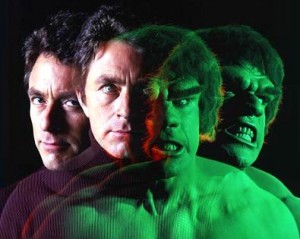 Over the course of the series The Incredible Hulk a standard trope is that someone close to David witnesses his metamorphosis and, thus, is in on his secret. But how often does it really happen, and do those who find out live to tell the tale? Here is a list of everyone who finds out that David can transform into the Hulk:
Over the course of the series The Incredible Hulk a standard trope is that someone close to David witnesses his metamorphosis and, thus, is in on his secret. But how often does it really happen, and do those who find out live to tell the tale? Here is a list of everyone who finds out that David can transform into the Hulk:
Season 1:
The Incredible Hulk pilot movie:
- Dr. Elaina Marks (deceased): told of David’s change and studies him. Dies in a lab fire.
- Julie Griffith: sees David transform after hitting him with a pot.
- Michael: sees David transform while fighting a bear.
- Dr. Caroline Fields (deceased): told of David’s true identity and secret. Dies of a rare disease.
- Thomas Logan: sees David’s reverse transformation while looking for a horse.
- Mark Hollinger: after being rescued from his abusive father by the Hulk he walks down an alley holding Hulk’s hand while the green giant transforms back into David.
(This list will be updated as our Incredible Hulk review series continues!)
Read my Incredible Hulk Series Reviews
March 14, 2012 Posted by Arnie C | Comic Books, Movies, Television, The Incredible Hulk TV Series Reviews | 1970s, 1980s, Bill Bixby, CBS, Comics, Hulk, Incredible Hulk, Lou Ferrigno, Marvel, Now Playing, Review, Television, TV series | 2 Comments
Incredible Hulk Season 2 Episode 3 – Ricky
Both David and the Hulk go the distance for a mentally challenged young man who is goaded into driving a defective car in a demolition derby.
On the back of each DVD in The Incredible Hulk box set is a brief description of every episode. I have been posting these descriptions at the top of each review. However, this one had me truly worried. The Incredible Hulk (Lou Ferrigno) befriends a mentally challenged man? Given the changes in attitudes towards the mentally handicapped in the past thirty years, I was honestly apprehensive about this episode. With the production values of 70s television and the perfunctory life lessons that are often inserted as an afterthought to the on-screen action, I truthfully expected Ricky to be a cringe-worthy.
The preview before the show started didn’t help. It shows mentally-challenged Ricky getting yelled at and he responds “Maybe the big green man did it.” Then it shows Ricky sitting behind the wheel of a race car making engine sounds like a child. Almost every line in the preview is someone shouting “Ricky!” with a different inflection. I am prepared for the worst.
Fortunately the episode was not as embarrassing as I had expected. It’s merely bad, accented by some truly awful moments.
The episode opens with stock footage of stock cars racing. Clearly in the lead is Buzz Deter (guest star James Daughton, Greg Marmalard from Animal House) and it looks like former champ Sam Roberts (guest star Gerald McRaney) will have to settle for second. Sam is fighting hard to regain the lead, but his “unsportsmanlike” driving causes him to spin out on the track, and in the spin his door gets jammed shut.
He screams for his pit crew to come get him out, but the first on the scene is Ricky, Buzz’s mentally challenged brother. Why he’s out in the middle of a race track is beyond me, and given his size I don’t think he was the fastest to get to Sam’s car. In his attempt to be helpful Ricky works his fingers into the car door frame and uses his weight to pull, prying back the door slightly. At this point I’m especially worried, please don’t tell me this boy is mentally challenged and as strong as the Hulk! Fortunately that is not the case.
Sam, in the car, establishes himself firmly as the episode’s villain as he yells “Someone get that retard out of here.” Hearing that voice is when I first realized Sam is played by Gerald McRaney (Major Dad) in his second guest-starring role in The Incredible Hulk. Previously he was Denny, the foreman and Julie’s suitor in the second pilot episode The Return of the Incredible Hulk (aka Death in the Family). In 1978 McRaney was not a known actor. Sporting the thick beard he wears in this episode I doubt even the casting director would remember he had a bit part in a previous episode, let alone a television viewing audience that had not seen his previous episode in almost a year.
Far less recognizable is Mickey Jones who plays Ricky. A character actor who I’ve seen a dozen times in TV guest star roles such as this as well as in the movies Sling Blade, Total Recall, and Tin Cup. Only when I looked him up in IMDB did I realize I have just one memory of the man–he was the sheriff-slash-mechanic in Vacation who takes all of Chevy Chase’s money after he drives off a cliff. He has a trademark Captain Lou Albano beard in most of his roles, but as Ricky he’s clean-shaven making him unrecognizable.
Ricky looks about to get in some trouble from Sam when David (Bill Bixby), dressed in pit crew coveralls, comes and escorts Ricky away from the crash. David has hitchhiked his way from Utah to Nevada and gotten a nondescript job at the racetrack where he cleans up, repairs soda machines, and helps fix cars.
David introduces himself to Ricky, and notices the mentally challenged man wears a large pin on his shirt that says “Ricky.” Here my first moment of horror sets in. Ricky explains the button was a gift from his brother. “I have to wear it all the time or I might get myself lost,” Ricky says, and thus we have the first inkling of Buzz’s character.
Truthfully I’m not sure what to make of Buzz this episode. Trying to put myself in the head of writer Jason Summers, I think Buzz is supposed to come off as a caring brother who simply doesn’t have the resources or training to care for a mentally handicapped individual. To me, however, Buzz comes off as an ill-tempered jerk who worsens the stigma of the learning impaired. He makes Ricky wear a button which I take to be a mentally handicapped version of a scarlet letter. Then whenever Ricky deviates from Buzz’s orders in the slightest of ways Buzz flies off the handle shouting at his brother. In the calmer moments he tries to tell David “Ricky’s retarded. People just won’t understand” but I think Buzz doesn’t understand either. Buzz is so set on winning the Daytona race and buying a house for his fiance-slash-mechanic Irene that I wonder where Ricky fits into Buzz’s world view.
In truth, Ricky doesn’t. Buzz wants to win enough money to be able to afford to put Ricky in a home. David starts to preach about state homes and programs that can give Ricky the care he needs now. Buzz says Ricky has been in and out of hospitals, but David is referring to more specialized care. As I watch this conversation I become quite uncomfortable. First, as in Life and Death David is preaching about personal matters that are really none of his business. Second, that David is constantly pushing people towards government funded programs is sending a weird political message that the show is ill-equipped to discuss. Finally, that the one thing both David and Buzz agree on is that Ricky needs to be locked away in a home and not able to live in society is really off-putting. I am no expert in caring for the mentally handicapped, but Ricky seems beyond functional to me. I know of many organizations that teach the mentally challenged how to function, get their own homes, work jobs. But getting Ricky to stand on his own two feet is nobody’s objective–getting him “proper care” (meaning: out of Buzz’s hair) is.
While the portrayal of Ricky is not offensive, David and Buzz’s plans for the man are.
During all of this we also find out the background of Sam Roberts and his brother Ted. The two are partners in racing, Sam drives the cars and Ted fixes them. They were offered a job as “PR Reps” for Allied Tires, a job Sam turned down because he was on a winning streak. Now, I could see Allied Tires wanting Sam and Ted to be a spokesperson, possibly used in some advertising, but they continually use the term “PR Rep”. A PR rep is who you use to communicate to the media, to handle advertising, external communications, and such. If Allied Tires had a Bridgestone-Firestone type situation with tires blowing up and killing people it is the job of the PR Rep to issue statements like “We are looking into the situation.” I cannot see these two gearheads as PR Reps, they are thugs who party until 4 a.m. then get up and race cars and drink beer. But their dream of the good life, either as racing champs or PR Reps, was stolen when Buzz showed up and started to win every race.
Buzz goes on a date with Irene, leaving Ricky alone for the night to watch horror movies. He’s watching the Universal classic Wolf Man and I think for sure that Ricky will see David transform into the Hulk but no one will believe the boy. Unfortunately this doesn’t pan out in the least. Instead, the moment Buzz is gone Ricky sneaks into the garage. Ricky is infatuated with race cars, and he hops behind the steering wheel and starts the car. With the car in neutral, he floors the gas and pretends to be racing, all the while making revving sounds verbally. I don’t know why he had the engine running and was making “grrrr, grrrr” sounds, but I guess it’s because it’s the writer’s view of the mentally challenged. More, it is simply uncomfortable to watch a 37-year-old man (Jones’ age when this was filmed) performing these scenes this way.
Due to the exhaust from the car being trapped in the closed garage Ricky soon passes out from the fumes.
David happens to be right outside the garage, having been tasked by the Roberts Brothers to fix a broken soda machine. Hearing the engine he tries to get into the garage, but Ricky locked the door from the inside. David tries to break in using a shovel, but it slips and jams his hand.
Hulk-Out #1 Hulk breaks down the door with ease and rushes to the front of the car. Around him we see smoke that is supposed to represent the exhaust from the car, and perhaps it is dry ice on the set but the way it moves it appears to be a very poor animation. Additionally, the smoke appears green, perhaps a nod to the Hulk?
Now with the door down Ricky would likely be fine. It’s a large garage door that would vent the area quickly, but Hulk is never satisfied with the simple fix. He first goes to the front of the car and smashes down on the roof, obviously crushing something important as the car stops immediately. Then Hulk goes to the driver’s side of the car, tears out the seat belt, and carries Ricky outside.
The mentally challenged man wakes up almost immediately and starts coughing, but his near-asphyxiation is quickly forgotten when he sees the Hulk standing over him. And Hulk is all up in Ricky’s face, clearly invading the shorter man’s personal space. “You’re…green! How can you be green?” Ah, the writer’s mind of the mentally challenged, too innocent to be afraid of a giant half-naked green man.
But Hulk’s response is very odd. He responds with a growl, but am I mistaken or did Hulk just say his first word? Much like a baby first intoning “da da”, Hulk’s first word might be a word or it might be a series of noises that my mind is turning into a word, but damned if the Hulk didn’t just growl the word “Green.” It’s no “Hulk is strongest there is” but it’s a start.
His throat burning, Ricky goes for a soda, but as David never had a chance to repair it the machine steals his money. Hulk retaliates by ripping off the front of the soda machine. Don’t make Hulk thirsty, you wouldn’t like him when he’s thirsty.
Ricky takes the soda he paid for, then offers a grape soda to Hulk. Of course, since no “good” character in the series must ever be seen doing anything unethical Ricky leaves the money for Hulk’s soda in the machine. However I notice no one is leaving money to replace the soda machine’s missing front door.
Ricky then gives Hulk a lesson in how to open a can of soda. “See I can teach you because Buzz showed me. People used to laugh at me before I could do this.” It’s an insane moment. I get the writer’s intent–it’s showing that Hulk has an even more childish mind than Ricky, and that Ricky is so kind he will immediately become the big brother to Hulk teaching him to open a soda. And I do understand this is supposed to be amusing to see Hulk doing something as everyday and mundane as drinking a cola, but the humor is not clicking for me. Seeing Hulk dribble down his chin, infantilizing Hulk and Ricky both, feels very wrong to me.
The only positive thing I can say about this scene is that I forgot pull-tab soda cans existed, and it takes me back to my childhood.
I do wonder about the wisdom of giving Hulk a sugared soda. Since we are treating Hulk like a child, many parents of small children won’t give their kids soda due to how it causes hyperactivity and restlessness. I really hoped the episode would go in weird directions, with Hulk rampaging on a sugar high, but instead he just slowly wanders off. We see his shadow grow smaller and I think it’s the best Hulk to human transformation we’ve seen yet.
After the commercial we return to see Buzz yelling at Ricky again. Buzz’s car is smashed, as Hulk is wont to do, and no one believes Ricky’s story about “the big green man.” The story makes Buzz even angrier, calling it the first time Ricky has ever lied to him. Truthfully I think the writer is again cheating. It doesn’t matter who smashed the engine, big green man or Ricky, had Ricky not been playing behind the wheel it never would have happened. Second, the car has obviously not moved, and it was smashed from the top. Does Buzz really think Ricky is strong enough to crush a car? Even kindly garage owner Mac says “Ricky’s strong, but is he strong enough to crush a car?” but Buzz refuses to acquit his own brother just calling it “weird”.
I likely would have gone through the entire summary without mentioning Mac were he not played by Gordon Jump, one of the iconic Maytag men who rose to fame as the “big guy” Arthur Carlson on WKRP in Cincinnati. The second WKRP star to appear on Hulk, Jump filmed these scenes before WKRP premiered, and as WKRP was not a quick success he likely was not recognized by many Hulk viewers when this was first run, but to see him play such a bit part was shocking to me having grown up with the man as a TV star.
Mac offers the less-than-helpful suggestion that Buzz should “enter the car in the demolition derby” but Buzz and Irene are convinced they can make it race-worthy by Saturday. Feeling guilty for Hulk’s damage, David offers to pitch in as well. He is sent to get parts for the car and to cheer Ricky up David takes him on the errand, promising that Ricky can help Buzz fix his car.
In this scene David asks Ricky “did the green man hurt you?” Ricky says “No” and David seems relieved again…or is it more? Maybe I am reading into this scene as I think David should have learned long ago that Hulk is not a killer, but I think when Ricky says he wasn’t hurt David is bemused, not relieved. It’s like Bixby is portraying David as learning the Hulk’s pattern. He’s not as worried about the Hulk really hurting innocents. I hope the writers catch up to Bixby soon.
On their outing David takes Ricky on a side-trip to a park. There David lets Ricky roam on his own and examine the sculptures. Ricky is tentative and unsure if it’s okay to go on his own and the scene has the feeling of a domesticated animal being released in the wild. But rather than run away, Ricky runs towards sculptures and fondles them. He rubs the tummy of a cherub, just feeling everything. The acting is bad, with Jones squinting and making the most extreme “dumb happy face” he is capable of, and the score is worse trying to sell me on sweetness I don’t feel. David has a huge smile cross his face. He’s clearly seeing something I am not. What I am getting from the scene is once again a creepy feeling watching a 37-year-old fondle statues. What I am supposed to be getting from this scene is that Ricky has an affinity for art, specifically sculpture. It’s not as useful as being able to take Ricky to count cards in Vegas, but it’s a step towards Ricky’s happy ending.
Returning to the race track David again corners Buzz and tells this man how he should treat Ricky. Were I Buzz I think I’d tell David where to stick it. Daughton was 27 when this episode was filmed, so assuming the character is about the same age I think Buzz has far more experience with Ricky than David, who’s been in Ricky’s life for a few days. David says Ricky has a great feeling for art. “Maybe he lost something at birth, but maybe he gained something else.”
Buzz continues to argue the point, but now we get an important scene. We know it’s important because the music tells us so, and because everyone stops what they’re doing to just watch Ricky in this moment. Ricky sees two screwdrivers hanging on the wall out of order, and is able to on his own figure out how to rearrange them from largest to smallest. It’s such a saccharine scene that I wonder if later in life when Bixby was a director of Blossom he would return to this moment to get inspiration on how to stage the “very special episodes”.
But seeing that Ricky can order things small to large Buzz relents. He won’t let Ricky use a welder, but he gives Ricky some epoxy glue to glue some scrap metal together “but don’t get it on your fingers or your eyes, and always wear gloves.”
For the first time in this entire Hulk series, I wonder where is Hulk?
He will return, thank God, due to a plot by the Roberts brothers. They have called to beg for the PR Rep job, and have been told if they win Saturday’s race they can have the job. (Is it one job or two jobs? I really don’t understand the entire PR Rep goal.) They think the race is theirs with Ricky and Hulk damaging Buzz’s car, but Irene is too good a mechanic and Buzz is taking the car for a test drive. Seeing Ricky with the epoxy, the Roberts out some in the car’s gas tank and ruin the carburetor.
Again Buzz blames Ricky for the damage. While Ted and Sam did set Ricky up for just this, it would be nice just once to see Buzz not jump to the worst conclusion about his brother. Irene can fix it but she needs parts and time. Then we get a montage of Irene fixing the engine, Ricky helping but moping, Buzz and David fixing the car, full of trumpet and piano music. It’s truly terrible, and ends with Buzz asleep while the other three have pulled an all-nighter to fix his car. Sure, on the one hand the driver should be well rested, but on the other hand it’s a dick move. One last part is needed to get the car ready so Irene and Buzz head off in a beat up family truckster (I’m sure Ricky could have fixed the truckster if needed, but not the race car!).
But once Ricky is left alone the Roberts come in and lie to Ricky, telling him that regulations won’t allow Buzz’s car in the race and the only way for Ricky to help Buzz is to drive the car in the demolition derby. They tell Ricky comforting lies, that they are his friends, and that Ricky is a good enough driver to win. As Ricky has always wanted to be a race driver, and he wants to help his little brother, he is pretty easily convinced.
As he starts to drive the car out David comes in, but Sam hits him from behind with a wrench. David is knocked unconscious before he can transform, and Ricky, mistaken for Buzz by the race announcer, enters the demolition derby. Also entering the derby is Sam, who is gunning for Ricky specifically to finish off Buzz’s car permanently.
The demolition derby begins and we are treated to more stock footage. I have discussed in previous reviews when stock footage used enhanced the episode or detracted from it, but in no previous episode has the stock footage been so seemingly out of place. I don’t know where the footage originated, but it appears to be a demolition derby in the 60s, completely out of date even when this episode first aired. Cars straight out of American Graffiti smash into each other, and I swear I saw Herbie the Love Bug in there somewhere. None of the cars in frame with Sam or Ricky look anything like the cars in this footage, and between that and the poor method of editing that shows random crashes without any connection to our characters it really felt arbitrary. More, the stock footage of the stands shows crowds of people, but in new footage showing the announcers it looks like the bleachers at a high school football game. If any effort was made at all to match the footage it failed completely.
Having never raced before, possibly never even driven before, he is looking like he might win the derby, and Mac says Ricky is driving better than anyone else; driving like he was trained to do it. Now I fear that we will be told that Ricky’s true skill is driving the demolition derby and the episode will end with Ricky a champion demolition derby driver. Thank God that didn’t happen either.
Irene and Buzz return to find David just coming to and Buzz’s car missing. They soon find the car in the demolition derby, but their worry for the car becomes secondary when Irene reveals the part they needed was a coupling for the fuel line. The car is leaking gas and if Ricky’s car gets hit he’ll be killed. Only Ricky’s beginner’s luck has kept him alive so far.
While Irene and Buzz stare and gape, David grabs the first car he sees and races to Ricky’s aid. I don’t know where David found this purple car to drive into the race or if cars are just sitting around during these derbies, but David is soon in the derby.
But David is too late. Sam repeatedly rams Ricky’s car and it catches fire. David’s car also gets sandwiched, trapping David inside. He can’t get out, cant escape, and shouting “Ricky” in his half-hulk voice we get white eyes and
Hulk-Out #2: In Never Give a Trucker an Even Break we saw Hulk transform in a car in the most lackluster way. Here they do it right…Hulk tears the steering wheel off the column. Then, the doors trapped by cars, he tears open the roof and leaps out. Plus with the car being purple it’s the closest we’ll come to Hulk wearing purple pants until Trial of the Incredible Hulk.
When Hulk enters a demolition derby, Hulk wins. Hulk flips a car and chases after Sam. Usually Hulk rescues the innocent then punishes the guilty, but here the order of operations is reversed. Growling menacingly he flips Sam’s car. This could have killed the person, but we see Ted rushing to the car and pulling Sam out, Sam is okay.
Then Hulk gets to Buzz’s car and again tears out the seat belt. I’m wondering if Hulk is thinking “Hulk tear this out before! Who put this back here? Hulk smash seat belt repairman.” Hulk grabs Ricky and runs away as the car explodes, and I wonder if this is the creation of the “I’m too cool to look at the explosion” shot.
Setting Ricky down Hulk growls and flexes for several seconds. He finally runs off when Buzz, Irene, and Mac come to Ricky’s aid. Ricky says “The big green man came back” and now Buzz and Irene know he’s telling the truth. Aww.
Ricky sees that in the race he lost the button Buzz gave him, and Buzz says “You don’t need it, not any more.” Double aww.
And Mac, running the race track, tells the Roberts Brothers to pack up and get out, they’re finished for what they did to Ricky. I guess their PR Career is over, perhaps they can try social media?
The episode ends and we see Ricky is back at the sculpture park, but now he’s sitting at a table creating a sculpture with other mentally challenged adults. I’m not sure if the clay Ricky sculpted was supposed to be Hulk; it has as much resemblance to Ferrigno as the bust of Lionel Richie has to the singer in the video for “Hello”.
We find out Ricky has been admitted to a boarding school for the mentally challenged. I don’t know if the sculpture park was on the school grounds or if the school was on a field trip to that same park. Intellectually I know that the director is being economical reusing shooting locations, but narratively this is nonsense.
More, as I stated, I continue to question the happiness of the family looking on and saying “I think he’ll find what he needs here” while they tuck him away in a facility away from his brother, the only family he has left. But the writer thinks it’s a happy ending so David and Buzz think it’s a happy ending so we are supposed to think it’s a happy ending. I’m not so sure.
David goes to say goodbye to Ricky, and Ricky says “You won’t visit any more?” David says he can’t, but he will write. Ricky says “Misses James can read them to me and pretty soon maybe I can read them myself.”
Then David, tan jacket in hand, walks off as a crane shot lifts higher and The Lonely Man theme plays on.
The most ironic thing about this episode? By having two pairs of racing brothers, Summers had an opportunity to create a story that shows a healthy fraternal relationship contrasted with an unhealthy one. Showing Buzz and Ricky to be a team that no one could break, while evil Ted and Sam constantly bickered and sabotaged each other, would have been genius. But instead Summers does just the opposite! Ted and Sam are great brothers. They take a little anger out on each other when they lose the races, but the whole episode they have each other’s back and work as a great team. Meanwhile Buzz doesn’t trust Ricky, often can’t be bothered with Ricky, and his actions, if not his words, show he thinks of Ricky as a burden. Given the alternatives, maybe Ricky was better off in the home after all.
The episode honestly was not as cringe-inducing as I’d expected it to be. I feared something incredibly politically incorrect and possibly unintentionally mocking the mentally handicapped given how attitudes have changed in 30 years. But while I do question the “happy ending” of tucking all mentally challenged people away from society in a home, I think it was handled pretty well for the time, but not well enough for me to truly believe Ricky as a character, nor care about him.
The episode could have been saved by some good Hulk action scenes, but Hulk merely flips a few cars, rescues the same person from the same car twice, and drinks a grape soda.
More, am I the only one disappointed that Ricky’s last name wasn’t Jones?
While not as bad as I’d feared, I still can not recommend Ricky.
Read my other Incredible Hulk Series Reviews
March 14, 2012 Posted by Arnie C | Comic Books, Movies, Reviews, Television, The Incredible Hulk TV Series Reviews | 1970s, 1980s, Bill Bixby, CBS, Comics, Hulk, Incredible Hulk, Lou Ferrigno, Marvel, Now Playing, Review, Television, TV series | 3 Comments
Incredible Hulk Season 2 Episode 2 – The Antowuk Horror
After getting a glimpse of the Hulk, the citizens of a struggling resort town invent their own replica Hulk as a way of increasing tourist business.
In the season two premiere of The Incredible Hulk we were treated to a dramatic character exploration. David (Bruce Bixby) travelled to Hawaii, got married, confronted the beast inside him, and lost his wife. We last saw him sitting on a Hawaii beach mourning Caroline outside her destroyed home.
I can’t say that I’m surprised that all of these major developments were forgotten by this next episode; that is how all action series worked in the 70s and 80s. But just because it was what I expected doesn’t mean I wasn’t slightly disappointed. For all the drama David endured, the reset button has been hit. David is somehow back in the states and back on the run.
That said, a return to the formula also means a return to form for Hulk. While it’s not in this show’s DNA to allow David to evolve and change much, this reset brings the show back to what viewers expected and wanted from their weekly series.
We open with National Register reporter Jack McGee (Jack Colvin) walking through a wooded area in Utah where Hulk (Lou Ferrigno) had been spotted three weeks prior. There have been no sightings of the creature since, and McGee is stumped. Despite his frustration, he is still not ready to take up master hunter Buck Hendricks’ offer to kill the Hulk.
When at the top of his game Buck was an expert hunter and tracker, but now he’s down on his luck and living in his car. Buck wants McGee to give him a job finding the Hulk, and thinks that if he can be the man to kill the Hulk it will get him back on the lecture circuit. Because, as we all know, hunters travel the world, giving lectures. Hunters are known for their astounding oratory skills. Especially hunters that became bloodthirsty old coots.
McGee refuses, seeing the desperation in Buck’s face. McGee says, “You wouldn’t used to think of shooting something that’s worth more alive than it is dead” and we see that McGee may want the Hulk but he has a moral code about it–he wants the Hulk captured, not killed. Buck doesn’t care either way, and that desperation will lead to trouble for David. When McGee turns Buck away, the old hunter challenges the reporter to see who can get the Hulk first.
Buck had said that Hulk went up into the mountains, and he was right. After his Hulk-out in the woods David had found his way to Antowuk, UT, an obvious back lot, I mean, former resort town in desperate need of tourists. Most people, tourists and locals, have left the town already but David found work in a general store owned by Harlen Bates.
Trading labor for room and board David has been performing odd jobs around Harlen’s store, and also watching after Harlen’s daughter Samantha. Samantha is a precocious girl. She is very smart in science, but worried about her own future living in a ghost town.
There are some very cute scenes between Samantha and David that are a joy to watch. It’s adorable that Samantha sees David using a dirty bandanna to wrap a cut and she gives him a lecture about germs and proper first aid. Bixby is charming playing off the little girl. He has a skill of working well with child actors that he likely honed with years on The Courtship of Eddie’s Father.
While David bonds with Samantha, Harlen drinks beers with his friend Brad. The two knock back a cold one while brainstorming ways to drum up business and tourism. Brad is ready to leave the town behind, as so many others have, but Harlen is attached and becomes frustrated with Brad’s fatalism.
Harlen becomes more angry when he goes inside and sees that Samantha and David have rearranged the store. Obviously threatened by David’s intelligence and ability to connect with Samantha, Harlen snaps at both of them. He tells Samantha she’s lucky her mother’s not alive to see her treating the hired help better than her own father, causing Samantha to burst into tears and, even with Harlen offering an apology, the little girl runs out. Seeing David worried about Samantha’s emotional state angers Harlen even more, and he orders David into a back room to clean and inventory all the items. I’m not sure what Harlen sells, but this back room was full of an insane number of crates and boxes that had been stored behind nailed two-by-fours. In addition to the boxes are steel gas canisters, wood barrels stacked to the ceiling, and more.
Not content to just have David perform manual labor, Harlen stands there berating David as he works, trying to goad David into a physical fight. Harlen obviously wants to take out his frustration by administering a beating to the smarter man. He pushes David around, bullying him, guessing David is on the run. “I know your kind. Big shots, can’t stand having someone tell them what to do. They have little tantrums, Davy. Let loose on me and get it out of your system.”
Truthfully Harlen does have David pegged. Perhaps that is why David looks ready to fight back. The berating, the physical abuse, David looks ready to throw the first punch possibly for the first time in his life. Harlen is inviting it, saying David can keep his job if he beats Harlen in the fight. David forms a fist…he’s considering it. He’s restrained, but prepared to defend himself. If Brad hadn’t come in perhaps David would have thrown the first punch, but Brad does come in. Harlen throws himself at David, and Brad restrains the larger man, escorting him from the room. Alone and frustrated, David does take out some aggression on the boards he must tear out. Working angry, David is careless and a crate falls on his foot. The pain causes him to fall backwards into a pile of wood barrels that collapse upon him. From underneath the barrels David pops his head out and we see the white eyes.
Hulk-Out #1 Hulk throws a barrel and hits the camera! I found it amusing as it’s obviously an accident, the frame shaking as the camera wiggles form the impact.
Hulk then picks up one of the random metal tanks Harlen had in the back room and throws it through the roof. It launches out of the building like a missile. Hulk smashes out of the storeroom and into the streets and everyone is frightened and running. Of the group only Samantha thinks “where is David”. Hulk runs away down the back lot as the crowd gathered around Harlen’s store looks on.
Now is a commercial break, and this is the beginning of a new Hulk trope. I’ve complained in many previous reviews about the bad effects of the reverse transformation, and Bixby himself did not like the time required for the prosthetic appliance application. As such, my memory is that most often Hulk would run away, we have a commercial break, and then when we return David is back. Truthfully, this is better in every way. For almost twenty episodes we’ve seen the transformation of Hulk back into David, then we see David try to surreptitiously, but legally, obtain new clothes. At this point in the series economical storytelling is a bonus as is not having to see those embarrassing fake eyebrows on Bill Bixby. Here at the very start of season two this new, improved method of returning Hulk to David form is born. After the commercial David returns with clothes in tact, so he must have gotten them somewhere. I don’t mind not knowing who’s clothesline he left a fiver on.
David returns to find Harlen’s store in chaos, with Mayor Murphy, Sheriff Colton, and the press all there to find out about the green monster that caused so much damage. David feels guilty for the damage caused to Harlen’s store, but Harlen sees the destruction as a good thing. Finally the shopkeeper thinks he has a way to restore the tourist trade in Antowuk, using the story of this monster to attract “wierdo” monster hunters–monster hunters with money in their pocket. “Resort community battles mountain monster,” is how he spins it to Mayor Murphy and Sheriff Colton, entitling it “The Antowuk Horror”. With nothing to lose, the sheriff and mayor agree to the publicity stunt.
After the people leave we get an unlikely tender moment between Harlen and David. It’s completely unbelievable that Harlen, who had to be physically restrained from beating David when last they met, would pour his heart out to David now. I can chalk it up to Harlen was drunk and now he’s sober, or he had calmed down and now wants to make amends, but it is still an unlikely scene playing out. Harlen is semi-apologetic to David, saying “I don’t really want you to hurt yourself”, as he helps David right some furniture. Then David listens sympathetically while Harlen discusses not being able to fit in with normal people, and the only place Harlen feels at home is on the mountain. This is supposed to explain the gruff, abusive man to us and let us feel bad for him. I just roll my eyes. For all his talk saying he’s stupid, I never got that Harlen was exceptionally dumb. Nor does he come off like a mountain-bound hermit. Had this story been that Harlen built his business with his dead wife and letting the store go would be like the last memory of his wife slipping away I might have bought his rationale for where the story goes. However, trying to tell me that the owner of a shop on a mountain cannot fit in with the residents of Salt Lake City is a stretch. I blame both the writer and the actor for this.
Harlen also has a tender moment with his daughter, perhaps spurred on when David seems to care more about Samantha than her own father does, but more than likely because Harlen has a scheme up his sleeve that will make it so he doesn’t see Samantha for a few days.
Harlen and Brad get gear from the store and make a big show of going out to hunt the Hulk, and Harlen asks David to watch after Samantha while he’s gone. The next morning Brad comes running back into town shouting for help, telling a fake story that they were attacked by the creature and it took Harlen and ran off. Of course, David knows it’s a lie because he still has his clothes on, but they find Harlen’s shirt with blood on it leading the sheriff and mayor to start a posse to find the creature and rescue Harlen.
We then hear a car radio as a reporter says “Harlon Bates is reported missing, supposably captured by the creature.” Yes, the radio reporter says “supposably.” Not “supposedly”, “supposably”. But with that blow to English grammar the reporter sparks a wildfire which causes Jack McGee and a dozen other reporters from TV and print to descend on Antowuk. It’s a media circus and Sheriff Colton, enjoying the spotlight, stands with his chest puffed out looking like Jackie Gleason’s Sheriff Buford from Smokey and the Bandit.
The town is buzzing, and David should be fleeing the town but is tethered by his promise to look after Samantha. He hides from McGee in the store, watching as the tourists Harlen promised come to town and even throw a carnival.
But the carnival is interrupted as the Antowuk creature attacks–and it’s not the Hulk, it’s Harlen with black shoe polish smeared over his face. Having seen Hulk himself I don’t know why Harlen paints himself black instead of green, maybe green shoe polish is harder to find, but it really look’s like Lon Cheney is attacking Antowuk in full werewolf make-up.
Harlen runs around screaming like a loon and shakes a popcorn stand, terrorizing the tourists. But then I get a bit confused as he effortlessly flips the sheriff’s pick-up truck. No show is made of it, but it’s later revealed some of the steel canisters Harlen kept in the storeroom were full of compressed air. Harlen hid it under the truck and, with it as pressure, used a secret lever to flip the vehicle.
I also wondered if the sheriff was in on this ruse. Both Sheriff Colton and Mayor Murphy were up for using the monster to bring tourists, so it’s not a stretch that this small town could concoct a conspiracy to boost tourism. Plus we never see anyone find Harlen’s car-flip contraption, and I would assume the Sheriff’s first order of duty would be to tend to his flipped truck. But it’s later revealed this was Harlen and Brad working alone, and I’m probably asking too much by hoping for a bit more logic in a 70s television episode.
But Harlen’s timing for this “attack” couldn’t be worse as Buck just arrived in Antowuk looking for the Hulk. Buck sees Harlen’s “monster” and gets Harlen in his sights, but in his haste Buck forgot to load the gun. By the time the ammo is ready Harlen has run into the night, but Buck is ready to use his expert tracking skills to find and kill the Antowuk Horror.
We see Brad and Harlen plotting, and any audience member who didn’t realize Harlen was the monster is now shown clearly that it was a hoax, and that Samantha is in on the hoax. Brad told Samantha the truth so the little girl didn’t worry about her “missing” father. With Harlen’s antics the night before the town is booming with tourists and Brad thinks it’s time for Harlen to be “rescued,” but Harlen wants to give one more performance before putting up his blackface.
But in town Samantha breaks down and, worried for her father, tells David the truth. Of course, David had it all figured out already. When Buck, mistaking Samantha’s concern for the monster as fear, tells her that he’s sure he’ll kill the beast, Samantha gives David directions to where Harlen is hiding. David wants to go alone to talk sense into the shopkeeper, but Samantha follows David up the mountain.
There Harlen is preparing for the performance of a lifetime. He has hid another canister of compressed air under a large boulder for “the monster” to roll down the mountain, and also a pile of logs he plans to roll down and scare reporters. He then has Brad to gather the reporters to lead them to his site.
After Brad goes, David finds Harlen’s hiding spot. Harlen begins his performance early, trying to scare off David by rolling the logs. Undeterred, David loses his patience with the shopkeeper, telling Harlen to stop acting foolish and that the people aren’t coming to report on the creature, they’re coming to kill it. Harlen is having none of it, mostly concerned that if the reporters come and see David they’ll figure out Harlen’s ruse. Resorting again to violence Harlen pushes David, so David retaliates by shouting to the reporters that the monster is just Harlen. The shopkeeper then shows how monstrous he can really be, lifting David in the air and throwing him down the mountain. “He asked for that anyway” Harlen says as David’s shirt tears. Harlen is walking back to his mark to await the reporters so he never sees…
Hulk-Out #2: We start with a close-up of the Hulk’s face and he doesn’t look good. Perhaps it’s the camera angle, perhaps it’s the lighting, but Ferrigno’s eyebrow appliance appears too large, the largest it’s been since the pilot episodes, and the wig looks a bit like Hulk just came from a guest spot on The Monkees.
Hulk’s make-up problems are far less evident in a wide shot as he goes after Harlen. The shopkeeper is panicked seeing the real monster again and, without waiting for reporters, launches his boulder down at the Hulk. Hulk doesn’t run, Hulk doesn’t dodge, Hulk just stands still and punches the boulder. This is why I love the Hulk. He. Punches. A. Boulder. Take that, Indiana Jones! The boulder shatters, and Hulk doesn’t budge an inch.
No one can face a man that can punch a boulder, so Harlen runs and Hulk gives chase. I also notice that we are seeing this chase in real-time. Season one Hulk was almost entirely seen in slow motion during action scenes, much like the Six Million Dollar Man. Now the producers are comfortable enough to let the action be in real-time and it’s more exciting for it.
Hulk catches up to the mountain man and throws Harlen, much like Harlen threw David earlier. But Harlen is finally getting the fight he’s been itching for the whole episode. He stands up, pulls off his furry gloves, and obviously forgetting what happened to the boulder he goes at the Hulk. Deflecting a punch, Hulk effortlessly pushes Harlen down again.
But the two gladiators are unaware they are being watched by two people with drastically different motives. Samantha has followed David up the incline and is crying out to try and help her father, and at the bottom of the cliff Buck sees the two and, thinking there are two monsters, plans to kill them both.
Samantha rushes toward her downed father, but in her haste she slips and falls off the side of the mountain. At the last moment she is able to grab hold of a small tree, but her grip is slipping.
Hulk, always the good guy, goes to rescue the girl, but she is out of reach and even Hulk knows he can’t get to her without falling. Harlen also goes when he sees his daughter needs help. There is a great moment where Harlen stands toe-to-toe with Hulk, unflinching, putting his need to save his daughter above his own fear. But Hulk isn’t there to fight, he’s there to help Harlen rescue the girl.
Harlen tries to have Samantha grab a stick, but she can’t get a grip. Hulk then grabs Harlen by the ankles and lowers him over the cliff to grab the girl.
But at the bottom of the mountain Buck sees Hulk exposed and takes aim. It is truly a tense moment. We know nothing will happen to Hulk, but we also know bullets hurt the green beast. If he is shot while lowering Harlen his grip will slip, and then will the father and daughter fall? It seems poetic if Harlen were to cause the daughter he ignored to be injured or killed as part of his foolish plot to save the town he put above his family. I know Samantha’s not going to die, but I could see her being hurt so I’m on the edge of my seat.
Buck shoots. Hulk is hit in the shoulder (he’s always hit in the shoulder), and he recoils. He loses his grip on Harlen with one hand, but the other hand holds tight and, single handed, he holds both father and daughter. Even injured Hulk gets back to work pulling the two up to safety.
With Samantha out of danger Hulk roars, and leaps off the top of the mountain. I love Hulk this episode! It’s the most super we’ve seen him, punching boulders, leaping from mountains. He drops hundreds of feet but lands upright in front of Buck, pushing the old hunter into a tree and bending his gun in two. Even bleeding from his arm nothing can stop the Hulk!
Except a posse with a bloodlust. At the top of the mountain the posse rush to the edge with their guns, taking aim at Hulk, but they don’t shoot for fear of hitting Buck. The actual looped line of dialog is “Don’t shoot, you’ll hit the old man” and I feel bad for Buck. This once unstoppable hunter has now been reduced to living in his car, beaten by Hulk, and then called “the old man” by a group of strangers.
Hulk runs off, but standing at the top of the mountain holding his daughter is Harlen, still half in his monster make-up. The sheriff and the mayor are enraged, and the reporters are ready to denounce the entire thing as a hoax, but McGee saves the day pointing out that while Harlen may be a hoax Hulk most certainly is not.
In a bit of comedy, reporters start to declare Buck a hero for standing up to the Hulk, and as reporters rush after Buck for an interview, McGee shouts “that man is an employee of the National Register!” We end the episode knowing Buck will be alright and he didn’t have to kill the Hulk to do it. Of course, he’ll likely be too busy on the lecture circuit to come back and repay McGee by finding the Hulk.
Left alone, Harlen has finally stopped acting like a jerk. He tells Samantha, “We better find David. I’ve got some apologizin’ to do. To both of you.” But it’s too late, David had left town. He put a note in Samantha’s microscope kit saying good-bye, but the girl chases David on the highway. She tries to convince him to stay, but David has to move on.
As they say farewell a car of tourists stop and ask the two “is this the way to Antowuk where the monsters hang out?” Thus, while David may be gone, we know Samantha and Harlen will do okay because tourism will still be alive and well for some time to come.
David throws his tan jacket over his shoulder and walks down the side of the mountain while credits roll.
With a horrible title that attempts to evoke thoughts of The Amityville Horror this episode began with me prepared for the worst. I could not have been more wrong. Bixby shines in this episode, his scenes with Harlen show a stronger side of David than we’re used to, and his scenes with Samantha show David as a good-hearted person. Bixby is just a pleasure to watch scene to scene here. Even when he has no dialogue, such as when he’s standing in Harlen’s store watching the carnival outside, we know his every thought and motivation. This episode is a shining example of why I love Bixby as David Banner.
Hulk also shines this episode. While the first Hulk-out is a bit lackluster, causing some minor property damage, the second Hulk-out has monster fights, bounder punching, and leaps off mountainsides. Due to budget the action is shot in such a way as to not be too incredible, but it’s exciting nontheless.
Finally we get to see McGee as a good-hearted person. While he is chasing Hulk from town to town for his own career, he doesn’t want to see the Hulk killed, and he also is a moral compass for his old friend Buck. It’s nice to see this third series regular become a bit more fleshed out.
The worst thing about this episode is its title. I give it a strong recommend.
Read my other Incredible Hulk Series Reviews
March 13, 2012 Posted by Arnie C | Comic Books, Movies, Reviews, Television, The Incredible Hulk TV Series Reviews | 1970s, 1980s, Bill Bixby, CBS, Comics, Hulk, Incredible Hulk, Lou Ferrigno, Marvel, Now Playing, Review, Television, TV series | 3 Comments
Incredible Hulk Season 2 Episode 1 – Married (aka Bride of the Incredible Hulk)
In this gripping two-hour season premiere, David travels to Hawaii, where he meets a beautiful psychiatrist who agrees to take him on as a hypnosis patient–and then as a husband after they fall in love.
For the second season premiere of The Incredible Hulk When Season 2 of The Incredible Hulk began series creator Kenneth Johnson wanted to ensure it started right. While the majority of season one episodes were formulaic, standalone episodes written and directed by a variety of people, Johnson himself returned to write and direct this two-hour episode Married.
While the set-up of this episode is similar to most others in the series, the tone of Married resembles no single episode, but rather the pilot movie for The Incredible Hulk. Both are slow-paced dramatic stories of David Banner (Bill Bixby) searching for a medical breakthrough, all the while falling in love with a blond scientist aiding him with his research. In Now Playing’s podcast review Stuart in LA called The Incredible Hulk pilot “a superhero origin without a villain.” Like the pilot, Married has no villain; there are no smugglers, drug dealers, or mafioso. But it also has no origin story; David Banner is already the Hulk.
Yet despite those absences, Married is considered to be one of the best episodes of The Incredible Hulk, and the only episode of the series to win an Emmy award when guest star Mariette Hartley won for Outstanding Lead Actress in a Drama Series for her role as Dr. Caroline Fields. Additionally, like the two pilot movies before it, Married received theatrical release internationally with the title Bride of the Incredible Hulk. By taking the formulaic superhero series and making a feature-length dramatic episode Johnson found success.
That said, the episode is a bit of an oddity for this series, and I wonder how the viewers who enjoyed watching Hulk (Lou Ferrigno) put the smack-down on criminals felt about watching a psychological drama that served as a psychological exploration of David Banner’s psyche. I know it wasn’t what I expected out of this series to be sure!
The episode opens with David in Hawaii. There’s a great line when he tells Caroline it was very difficult for him to get to Hawaii and she asks “Did you swim?” David laughs and says “Almost, yes.” So the show acknowledges it’s hard for working people to afford a trip to the big island, let alone David who previously didn’t have enough money to use a pay phone.
Dr. Caroline Fields is a psychologist and expert in hypnotherapy. David has gone to Hawaii to find her in the hopes that she can help him cure his bursts of anger that trigger the release of the Hulk. It’s a bit more of a naturalistic solution to the Hulk problem, versus the science-fiction radiation treatments that have failed David so often in the past.
David’s unlucky streak continues, however, as he arrives on Caroline’s last day; she’s taking an extended sabbatical. David follows the doctor out, pleading with her to take his case, but she refuses and refers David to one of the associates at the institute. David equates that to “Going to see Michelangelo and getting one of his apprentices” and refuses to give up. He even stalks Caroline, following her to her house, and I’m thinking this is not a great way to convince a psychologist that he is sane and deserving of her help. It is more likely she will file a restraining order against him.
When he arrives at her house he finds her hooked up to an EEG machine and performing self-hypnosis. This is shown in a visual montage of effects similar to the opening credits of every Hulk episode, showing close-ups of her cells, her trachea, her brain, her veins, and even her heart and blood cells. It’s a visually striking montage, and also reminiscent of the Hulk pilot when David is experimenting on himself. It ends with Caroline having a seizure in the chair. It’s shot in an extreme way, using a fish-eye lens positioned right above her head, her neck craned back to look into it, attempting to provide the distorted tunnel-vision point-of-view of a seizure victim.
David rushes to her aid, breaking through her glass door, cutting his arm on the glass. Once her fit ends she realizes he’s helped her, and responds with kindness–instead of calling the cops about her stalker she bandages his arm.
While tending to David’s wounds we find out that she has a terminal illness. It is one of those fictitious Hollywood glamorous diseases where the afflicted woman looks perfectly right up until the time of their tragic death, but it is described as similar to Lou Gehrig’s Disease, but it also causes circulatory malfunction and her cells are malfunctioning, refusing to repair themselves. She is shocked at David’s ability to diagnose the disease, and when he tells her he worked at in advanced genetic disease research at the Culver Institute in California her face brightens. She asks if he worked with Dr. Banner, and David wryly says “quite closely.”
Then we get a bit of backstory that I wondered about since the pilot episode. In that podcast I wondered if David had been researching strength enhancement before his wife died or if he just accomplished a lot of research in less than a year. Here we get more of David’s backstory, told in third person by David himself. While his wife Laura was alive David’s focus of research was curing of genetic diseases like the one Caroline suffers. After Laura’s death David abandoned his genetic research and switched the focus to strength enhancement.
After learning Caroline’s secrets David spills his own, revealing his true identity as well as his alter ego as the Hulk. He again asks for her help, asking her to give him hypnotherapy will help him control Hulk. Caroline is willing, but simply cannot–she only has six to eight weeks to live. She is hoping that through self-hypnosis she can find a way to arrest her own illness, and she cannot take time away from that pursuit to help him.
But David offers to stay in Hawaii and help Caroline. He claims the reason is that if he can help her have more time to live then maybe she can help him control the Hulk. In Bixby’s performance though I get that David is helping because it’s what David does, helps those in need. Possibly David is also anxious to return his life to a bit or normality as well, performing genetics research as he did before the Hulk entered his life.
We then have several scenes of David looking into microscopes, talking about mitochondria, and other technobabble that reminds me of the pilot episode and it’s slow pacing, spending lots of time on the science research. That languid pace is repeated here, which is not shocking given that Johnson is once again writing and directing the show.
But, also like the pilot, the focus here is on David’s relationship with his research partner. In the pilot we saw David’s unspoken reciprocated love with Dr. Elaina Marks. Here we see Caroline and David researching, spending all day and night together, taking respites on the beach, and making progress with her illness. With the acting of both Bixby and Hartley I believe the relationship is genuine and enjoy watching it progress.
But after a few days of research Caroline cannot resist the chance to help David in return. She puts him under hypnosis, having him revisit the events of his first metamorphosis. We see the scenes in flashback as David recounts the events, and when he starts to get worked up Caroline calms him down through hypnosis.
I love David’s description of becoming the Hulk for the first time: “I had a feeling inside me like 100 people shouting all at once. Like a locomotive beginning to roll.” For a year viewers watched David transform, but now we finally hear what it’s like for him to transform, and it does not disappoint.
What is slightly disappointing is that David blacks out totally when he becomes the Hulk. But Caroline tries to push him further, to find the repressed memories of what the Hulk did that night–and he does get some images! The film style changes, to an almost frame-by-frame slow motion of his first transformation, of Hulk smashing the car. Then Caroline jumps to his second transformation, and David recounts his dream in the hyperbaric chamber. He tells of the good times with Laura, and then the car accident in which she died. Footage from the pilot is used liberally here.
I’m torn on these retellings. When this episode aired in 1978 it had been almost a year since The Incredible Hulk pilot aired. Without the benefit of home video, video-on-demand, or even syndication, audiences would have not had a chance to revisit this pilot except in the rare rerun. By putting these scenes in the second season opener Johnson allows latecomers to see the exciting scenes from the pilot that populate the opening credits every week. It also reiterates David’s full backstory, the death of his wife and the direction of his research. And I do love that we hear David’s own retelling of events, giving us insight into the origin of our hero.
By the same token, these scenes are very drawn out and while David’s viewpoint is a nice shading, there’s no new information here. And while these scenes were exciting in the pilot, seeing them as they happened, the slow-motion flashback style robs the scenes of all excitement and tension. While I watched the pilot a month ago, not a year, I find myself thinking that Johnson may have overplayed his hand by bringing back too many scenes from the pilot all in the first hour of this episode.
Hulk-Out #1: As David tells of Laura’s fatal car accident and his recurring nightmares reliving the event his emotions become heated and Caroline’s hypnotic suggestion to stay detached have no effect. As he relives the death of his wife, David shoots up in the chair, he growls in his Hulk voice “I couldn’t get her out!” and his eyes go white.
This is the first time since the pilot that David has transformed without a task for Hulk to perform. Be it to take out aggression on a car, land an airplane, or beat up a mobster, when Hulk comes out I’m pretty sure of what he’ll smash. But in this scene, for the first time since his transformation in the hyperbaric chamber I don’t know what Hulk will do. I am enraptured, and Caroline is, rightly, petrified.
The transformation is one of the best ever as well. First, that animated green blob that annoyed me so much season one is finally gone. They show Bixby’s face in make-up, but the make-up is much improved. Instead of green kabuki make-up and silly Groucho Marx eyebrows, now they have applied latex moldings to his face. It now really makes Bixby himself look larger and more muscular. The shot is bottom-lit, like a kid using a flashlight to distort his face while telling a scary tale by a campfire. It makes Bixby look even more inhuman. Intercut with shots of the clothes tearing I see that the make-up and transformations have received a second season upgrade, and I like it!
On the commentary Johnson mentioned that Bixby had little patience for the make-up process employed here, which may explain the more lackluster transformations of the first year. Still, it’s an astounding moment and I can only hope Bixby’s distaste for the latex process doesn’t force a return to the cheesier transformations and reverse transformations going forward.
When the transformation is complete we see Hulk, also bottom-lit from a lamp, and he starts to smash Caroline’s house. He goes for the window, his normal means of escape, but Caroline says “no” so Hulk stops. But while he obeyed that first order, Hulk is testing his boundaries. He seems to toy with the psychologist, kicking a table in her direction. Here Ferrigno is showing true menace, more than I ever saw him show to one of the villains-of-the-week. There seems to be some intelligence in Hulk’s eyes, and his actions are not those of an unleashed berserker but that of an evil demon who wants to show Caroline who’s the boss. I don’t know why Hulk is this way–is it an after-effect of the hypnosis? Was it the hypnotic control that stopped Hulk from smashing the first wall? Whatever it is, Hulk almost shows a sarcastic smile as he throws a lamp backwards to break a window, and runs out it–cutting his arm on the way out just as David did on his way in earlier this episode.
Then we get a startling jump-cut to a man screaming at the top of his lungs. The loud noise had me jump in my seat, but it was just a Hawaiian luau and show for the tourists; the scream was that of a performer. The noise attracts Hulk, and then the performer screams again–a scream of terror seeing the green giant. All the attendees scatter, but for one curly-haired boy who sits and smiles as Hulk punts the roast pig.
Hulk eventually calms down and the reverse transformation beings, witnessed by Caroline who followed Hulk across the island. This transformation is also without the animated green light, but in Hulk the transition from Hulk to David has never been as elegant as that from David to Hulk and this is no different. We get some fades between shots of various make-ups that, honestly, the green glow helped hide how terrible this effect is. As a child I would watch Hulk and always be excited on the rare occasion that I would see this reverse transformation. As an adult I just know that these look terrible and my memory tells me that in later episodes they would do all they can to not show the transformation back to a human. Seeing this attempt of the effect I understand why.
While cleaning up Caroline’s house from Hulk’s mess she notices that David’s arm is mostly healed, and that the injury Hulk sustained is halfway healed already. David reveals that as a result of his metamorphosis his metabolism is very high, and Caroline gets excited thinking the Hulk may be the key to her cure. She wants to again hypnotize David, to help him control the Hulk, so they can get a sample of his tissue. With that sample Caroline hopes they can cure her disease.
I smile inwardly knowing that this same exact fool’s errand of cultivating Hulk’s tissue is what led Glenn Talbot to his death in Ang Lee’s Hulk. But here we see the plot’s live-action origin!
So Caroline puts David under hypnosis again, and now we get the spotlight of the episode–we get to see inside the mind of David Banner and the Hulk! I have read much about the making of this scene both online and in Lou Ferrigno’s autobiography. But for all the heat and troubles the cast and crew suffered, these scenes are worth it.
It starts like a scene from Oliver Stone’s The Doors, David walking across sand dunes in his bell-bottom jeans. In this desert is the only time the entire series that David and Hulk are on the screen at the same time, and it’s a remarkably powerful sight to behold. Ferrigno plays it so well, all confidence and strength, and puny Banner runs from Hulk!
As this is David’s mind, rules don’t matter, so I let it pass that suddenly some construction equipment appears out of nowhere and David is able to use it to drop a net on the beast. But even the strongest ropes David’s mind can make cannot cage the beast, and so Caroline wakes David up and they plan to try again later.
Now my appetite has been whetted for David’s internal psychological battle, so I find myself less patient with the romantic scenes of Caroline and David. My patience is strained further when David adopts the stereotypical accent and pigeon English of an Asian while bringing home Chinese take-out…I cringe at the offensive stereotype but remind myself this was 35 years ago and this must have passed for a charming flirtation with “mama-san.” We also find out that Caroline was almost married but held off, wanting to put off children and focus on her career. She and David walk the beach, hold hands, and the love theme that played in the pilot during the scenes between David and Elaina is reprised here as David falls for another blond scientist.
I also find myself a bit disinterested when we have hypnosis of Caroline, trying to control her cells and fighting off her disease through the power of her mind. Caroline is using visualization techniques and stock footage in her hypnosis. While there is stock footage of cells and such, Caroline was inspired by David and a grating John Wayne impersonation to visualize her disease as a group of Native Americans attacking a convoy of “pioneers”. The footage in in black-and-white and serves to make me feel like TBS inserted footage of an old spaghetti western in the middle of my Hulk episode. Worse, it’s full of racial stereotypes and a terrible score. I want to back Caroline and her fight against the disease but I am put off by the way the story is told.
I am more interested when National Register reporter Jack McGee (Jack Colvin) arrives on the scene. With the Hulk having been spotted at the luau McGee couldn’t be far behind. Hell, if I were Jack and the Register would pick up my travel expenses I’d research Hulk sightings in Hawaii, Rio, Sydney, and London. As always, when Jack arrives the stakes are upped as David must hide both his Hulk face and his real one. We find out here the Register is offering a $10,000 reward for information that leads to the Hulk’s capture, so every fortune hunter around will be trying to capture the green beast.
Jack has come to question Caroline about possible Hulk sightings, but unsuspecting of trouble David goes to answer the door. It’s a well-filmed and choreographed dance that occurs. David walks towards the door, and I wonder what will happen to make McGee not see David. But David opens the door! McGee has his back turned, looking away. He spins around, just as David realizes who is there and slams the door shut again. It’s the closest call the two have had so far this series and quite a bit of fun, feeling like a throwback to the comedies of days gone by. Caroline opens the door the second time and shoos away the reporter.
I hoped McGee’s arrival portends an increase in the suspense of the episode, but it didn’t–this is McGee’s only scene in the entire episode. While it’s a fun scene, it does not drive the plot and hardly justifies the flight from Los Angeles for the actor! I really hope Jack Colvin enjoyed his trip to Hawaii, because a vacation is the only excuse for him being here.
Then we go back into the recesses of David’s mind. This time Hulk is in a cage, reaching through the metal bars to grab at David, his captor. I notice Ferrigno’s make-up is shedding in the heat and his sweat, but the scene is still powerful, and made more so when David starts to release a yellow gas tranquilizer in the cage. From this scene came a poster that graced the walls of thousands of boys across America, including me, with Hulk in a cage, the gas swirling about.
But Hulk still breaks out of the cage, and David is awakened again, frustrated that the Hulk is “too damn strong to be caged, even in my imagination!” but Caroline remains optimistic.
At this point we are about halfway through the episode, and I have really enjoyed the performances and the hypnosis scenes. The romance is evolving in a very natural way, with flirtation that has not yet boiled into a love affair, but is certainly at a full simmer. But nothing we’ve seen in the episode so far could prepare me for the wild, crazy ride that was about to come.
Despite her racially biased self-help visualization Caroline gets a pathology report showing no progress against the disease. She has only two to three weeks to live.
I am a fan of Joseph Harnell who did the music for all Hulk episodes, but he insists on playing these test result scenes too large. The instrumentation is akin to that when Janet Leigh is being stabbed in the shower. The score this entire episode is tremendous, even if it does devolve into disco riffs at times, but during these scenes his atonal notes serve to undercut the tension.
Speaking of disco riffs, we get our best disco scenes here as Caroline, upset with her test results, goes on a self-destructive bender. She starts a dangerous, speedy drive in her Mercedes. She happens upon a bar named “Swingers” and pulls into the lot. Perhaps I was naive, perhaps I thought the 70s were a simpler time, but I never expected Swingers to actually be a bar for Hawaiians into partner-swapping. Nor did I expect Caroline to be a freak on a leash. It turns out Caroline also has a monster inside of her–a sex monster, and it’s aching to get out in a big way.
Caroline goes in and drinks fruity cocktails served with pineapple wedges and the disco music plays. The scene is the epitome of the 70s with the waka-waka music and the man with a large afro and sideburns. Then a guy with a porn-style handlebar mustache, his shirt unbuttoned to his naval to show off his gold chains, hits on the drunk psychologist.
This is the exact 70s swinging stereotype mocked in every episode of Three’s Company but here Brad is being entirely serious, and the audience is expected to go with it. “Hello”, he says, “I’m Brad.” Caroline replies “Oh yes, you probably are.” The two then go disco dancing and I cannot contain my laughter. But I stop laughing and my jaw hits the floor when she goes back to his place with another couple.
The dialogue is really something. The other woman says to Caroline “Aren’t they gorgeous?” and Caroline replies “Yes, and their chests are so neatly brushed!” I am dumbfounded. Is this intentional humor poking fun at what men considered “sexy” in the 70s, or is she really turned on by this man’s lush body hair?
Then both women start to dance with Brad then go looking for the hot tub and a bit of group sex. Brad notices how drunk Caroline is and tells his friend “I think we can get out the cheap stuff now” and his friend replies “I can dig it.” The pure 70s-ness of this scene is out of sight, man!
But before Caroline and her new girlfriend can run their hands through the rest of Brad’s brushed body hairs David shows up. He sees Caroline have a momentary breakdown, falling to her knees crying, and tries to go to her but Brad stops David at the door. Looking back and seeing Caroline having a good time with the brunette Brad and the other guy have no reason to believe David even knows Caroline.
In another bit of unintentional comedy, Brad’s friend pops a champagne cork right into David’s chin. David runs past the men to Caroline, but Brad and his friend will not allow this jive turkey to harsh their buzz, so they beat David and throw him off a balcony into a glass table. To which the brunette slut exclaims “Far out!”
Hulk-Out #2: The two studs go to throw David out, but waiting for them is the Hulk. He lifts one of them up by his chest hair and throws him behind a bar (No, I’m not joking). Hulk then super-leaps to the balcony, and seeing him the brunette slut moans in ecstasy and cries “Far out!” again. Hulk goes to toss Brad by his hair, on his head this time, and ends up ripping the swinger’s toupee right off! Brad is as bald as Telly Savalas, and Hulk is just confused by the rug in his hands, so he pushes Brad back through a wall into a bathroom. Hulk then picks up the passed-out Caroline, but the first stud can’t leave well enough alone and throws bottles at Hulk.
Hulk replies by picking up the entire fireplace and tossing it at the bar, causing the house’s second story balcony to collapse–so much for Brad’s sexy swinger pad! No one is hurt in the collapse, but their night, and Brad’s house, is ruined. Hulk finally leaves with Caroline, as the fire starts to spread through the ruins of Brad’s house.
And now I wonder how off-the-rails this episode has gone! I was fine with the slow paced melodrama and romance-through-research of the first hour, and captivated when it evolved to the symbolic representation of the Hulk in banner’s psyche. But suddenly we have devolved to Hulk saving Caroline from poor moral choices and beating up some swinging singles. It went from serious to absurd in the span of a single disco song. I can only presume this was to stretch the episode to a two-hour running length while giving us someone this whole episode for Hulk to fight, but due to the dated nature of the scenes and the crazy, sexual nature of the plot I have gone from praising to mocking this episode. Truthfully, these scenes have to be seen to be believed.
Transforming back into human, David takes Caroline home and puts her to bed. And then they make love…so Caroline still got what she wanted that night, though with maybe only half as many people involved. But David wakes up to find himself alone in bed, and thinking it was wham-bam-thank-you-Banner he runs to look for her. We see Caroline has not gone off on another group sex bender, but is just playing Frisbee with the curly-haired boy from the luau, obviously regretting her life choice to not have kids.
David can read all this in her face, so he asks Caroline to marry him. She doesn’t get it at first thinking it is a gesture, but David tells a story about a tiger and a strawberry that basically says “we may not have much time but let’s enjoy the time we have to the fullest.” They pledge their love to each other, and then they get lai’d–as in they put lais over each other’s necks before their wedding ceremony. It’s a small ceremony but done in the beauty of Hawaii I can think of no spectacle as sweet as these two damned people exchanging rings.
It also is good to see David over Laura once and for all. While David has had girlfriends, and presumably lovers, as he wandered the country, his original motivation for becoming the Hulk was to pay a karmic debt for Laura’s death. His cheap flings in Vegas and Texas cheapened that somewhat in my mind. But now he has had a true love affair, and though everyone knows she is going to die before credits roll it is a sweet and subtle character evolution for David.
The honeymoon is short though as we return to hypnosis scenes. In the desert of David’s mind the scientist is locking Hulk in a large safe. Caroline’s hypnosis is to trap the Hulk so David can release him in controlled circumstances. But even the large vault cannot contain the Hulk.
Meanwhile Caroline’s pilgrims are still fighting those indians, but the cavalry, in the form of a new chemotherapy drug, has come riding over the ridge. Her newfound energy allows Caroline to rescue the curly-haired boy from drowning in the ocean, as well as “play doctor” with Dr. Banner. But her exertion speeds up the progression of her disease.
As David sleeps one night we see more of his desert subconscious, this time without Caroline’s guidance. Hulk is breaking free of his cages and following David in the desert. Then David’s memory changes, leaving Hulk behind and going to happy times with Laura, and then to happy times the past few days with Caroline.
The dream changes again. Caroline, in her wedding dress, takes off her lai and boards a bus driven by the Grim Reaper, in full black cloak. The bus drives away and Caroline waves from the rear window, and try as he might David cannot catch the death bus.
The death of his past and current wife intermingle in David’s dream, and we see where this is going.
Hulk-Out #3: This is another incredible transformation with Bixby wearing facial appliances and good make-up. Hulk stands and begins to smash Caroline’s bedroom before turning on the psychologist herself. Perhaps Hulk is upset at the hypnotist’s attempts to cage him, but he walks towards her menacingly, crushing the bed frame.
But Caroline is determined to get what she needs, and she uses a tool that looks like a pet-hair brush to get a tissue sample from the green beast. He throws her onto the bed, but her soothing words calm him.
The next day David is worried by the bruises Hulk’s slap left on Caroline’s arm, but the cells seem to offer the psychologist the chance at a cure so both doctors put forth all their energies into the research. David thinks that in a sterile hospital environment they can use the Hulk cells to save Caroline’s life.
Unfortunately Banner’s bad luck continues–a hurricane is hitting the island. Caroline’s condition is too critical to wait, and the two newlyweds fight. David accuses Caroline of using too much energy, and we’re meant to understand that Caroline is not just dying of her disease–she traded her life so she could save that of the curly-haired-boy. But she won’t give up without a fight so David takes her Mercedes to the hospital, and we are treated to some grainy, old stock footage of hurricanes while they drive.
In the commentary Johnson said the cinematographer intentionally degraded the new footage shot so as to better match the grainy stock footage. While it did help to minimize the contrast between the two scenes.
That said, where did this hurricane come from? For David’s entire stay in Hawaii he’s been treated to blue skies and sunny times on the beach. There was never any talk of an impending storm, and there should have been. First, had this entire story been set against the background of a storm it would have provided a metaphor for Caroline’s disease and her relationship with David; it would start sunny and the clouds could build as her condition deteriorated. Second, with some set-up this ending wouldn’t feel so random. As is, it feels like a contrivance to keep Caroline from reaching the hospital.
Caroline starts to have a fit in the car and, for some reason, grabs the car door and jumps from the moving car, running off into the storm. David gives chase, and is hit by a car which injures his leg. He still is able to keep pace with the infirm woman, who is grabbing her head and hearing loud noises, but his path is cut off by some fallen electrical transformers. Trapped by the sparks we have
Hulk-Out #4: Hulk can easily smash and throw the transformers and give chase after Caroline, who keeps shouting for David though, again I reiterate, she lept from his moving car. Hulk races through the hurricane, having to tear down a fence to get to Caroline (and I wonder how the sick Caroline got there in the first place). Then the two have a tender moment, as she embraces and kisses the Hulk, saying “At least we never gave up trying. I’ll miss you David,” she dies in the Hulk’s arms. Hulk stands there holding his bride in the torrential storm as sad music plays.
The storm passes, and we see in the light rain Hulk has transformed back into David, still holding Caroline tightly.
We then get a scene the next day of David and the curly haired boy sitting outside Caroline’s house which was demolished in the storm. The boy says he wants to be a doctor when he grows up and hopefully find a cure for what killed Caroline. “I’d never have the chance if it wasn’t for her,” the boy says. He imparts a few other pieces of trite wisdom, such as “My grandma always says people never die so long as someone remembers them,” and that gives David a smile.
As David sits on the beach morning his wife, The Lonely Man theme plays and credits roll.
As I said at the start of this review, at the time this was the most acclaimed episode of the series. Perhaps in 1978 this passed for amazing television, but I must say 25 years later the episode does not shine so brightly.
The show certainly has its high points, all courtesy of the performance of the three principles Ferrigno, Bixby, and Hartley. All three give tremendous performances that make me forget of them as actors and make me believe in the reality of their characters.
Mariette Hartley did not want to be in an episode of The Incredible Hulk. Like Bixby before her she thought starring in a comic book show was beneath her, but she was convinced by her agent who said “Mariette, this is your Emmy.” He was right, she won an Emmy for this performance. But I have to say that while I enjoyed her romance scenes, the rest of her performance was merely passable. Her drunk performance was not convincing, and her rare moments of illness seem affected.
That said, I feel like the romance scenes played out a bit too long. I liked that it added realism to their relationship, but it played unevenly. A montage of science experiments does not a great love story make.
And truly I think that is what Johnson wanted to make, not just a love story but Love Story. Much like previous episodes, this one feels drawn from that big screen hit. The parallels are too profound to ignore. But is that what a viewer of The Incredible Hulk wants to see?
Truthfully the high points of the series for me were not in Hawaii but in David’s mind. The metaphorical confrontations with Hulk, the retelling of his first transformation, these scenes were standouts. I feel in this episode Bixby outshone Hartley in every scene. If this were a movie-of-the-week and not a regular episode perhaps Bixby would have had an Emmy himself, but his nomination would have to be judged on an entire season and I imagine voters may not be as forgiving when we return to the normal Hulk formula. From Banner’s finding a new love to help him get past Laura to his fear at facing his inner beast, it was Banner’s story, not Caroline’s, that interested me. Johnson said in the commentary that he was frustrated Banner and Hulk could never meet and this dream arena was his answer to that problem. I’m glad he found the way to do it, the scenes pay off the contrivance of hypnosis.
These scenes are greatly aided by Ferrigno, giving the best performance of his career. Both in the dreamscape and in Caroline’s house, this is a totally new Hulk under different circumstances. This is a Hulk that would give the youthful me nightmares. To paraphrase the self-help mantra David and Caroline chant on the beach “in every day in every way Hulk is getting better and better”.
But the episode also did not date well. The random swinger subplot is the epitome of pre-AIDS sexual freedom. With the gold chains and the chest hair Brad is a walking, talking stereotype that I could roll with in any other Hulk episode. In this serious drama, however, Brad is out of place.
I do recommend you see Married. The unintentionally comedic Swinger bar scenes have to be seen to be believed, and the Banner/Hulk scenes are some of the best of the series. But it’s not as strong a recommend as I had expected to give it due to the episode’s pacing and uneven atmosphere.
Read my other Incredible Hulk Series Reviews
March 10, 2012 Posted by Arnie C | Comic Books, Movies, Reviews, Television, The Incredible Hulk TV Series Reviews | 1970s, 1980s, Bill Bixby, CBS, Comics, Hulk, Incredible Hulk, Lou Ferrigno, Marvel, Now Playing, Review, Television, TV series | 4 Comments
Turn Around, White Eyes – How The Incredible Hulk Traumatized Me For Life
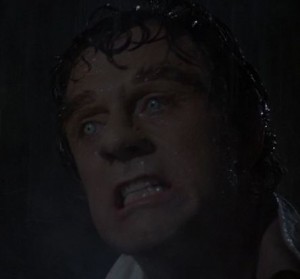 On many episodes of Now Playing Stuart has called out my phobia of anything related to eyes. Be it needles in eyes, eye surgeries, eyes popping from heads, any form of eye trauma has made me wince. Sometimes my sphincter actually closes up when I watch something very grotesque and eye-related. Some of my earliest memories are eye related, such as an episode of Dr. Who where someone had anti-matter eyes, or in Superman 3 where the robot woman opened her eyes and underneath was bare metal! But I’ve never known why I have such an aversion to eye trauma. But now, doing my reviews of The Incredible Hulk for Now Playing for the Venganza Media Gazette I think I have found the origin!
On many episodes of Now Playing Stuart has called out my phobia of anything related to eyes. Be it needles in eyes, eye surgeries, eyes popping from heads, any form of eye trauma has made me wince. Sometimes my sphincter actually closes up when I watch something very grotesque and eye-related. Some of my earliest memories are eye related, such as an episode of Dr. Who where someone had anti-matter eyes, or in Superman 3 where the robot woman opened her eyes and underneath was bare metal! But I’ve never known why I have such an aversion to eye trauma. But now, doing my reviews of The Incredible Hulk for Now Playing for the Venganza Media Gazette I think I have found the origin!
As a child of 3 or 4 Hulk scared the crap out of me. When I was 4 my godmother took me to a local toy store to meet superheroes. Guys were there in costumes, and I was pleased to meet Spider-Man, Captain America, and Superman. To me I was meeting the stars from the TV series, too young to know the difference between fantasy and reality.
But also there was Hulk. And I was frightened. The image is burned into my mind 30-some years later–and looking back the costume was god-awful. It was this thing made of what looked like bent cardboard, and covered with green felt like a mini-golf course. The mask frozen in place…it was comical. But it was Hulk, so I hid behind my godmother’s leg, scared the creature would hurt me. All because of this TV show. I was as scared of Hulk as Carol Anne was of The Beast; as Tina was of Freddy.
So why did I watch Hulk if it scared me so? I love horror. Since preschool I have been fascinated with that which frightened me. At age 3 I loved The Count best of all Sesame Street muppets because he was a vampire, and I wanted to know if he counted sheep in a coffin. And every Friday at 7 I would face my fear of Hulk.
Some episodes were just too traumatic. But even the most rote of episodes had me transfixed, and petrified, when Lou Ferrigno showed up.
But now I realize, what is it that preceded the Hulk? What is the trademark first sign of the transformation? David Banner’s white eyes! The eyes went white, the clothes would tear, a low growl would erupt, and then a green, unstoppable force of terror would dominate my imagination as it did my television screen.
I imagine I will go to my grave freaked out every time I see something to do with eyes, but now I think at least I know why.
March 9, 2012 Posted by Arnie C | Comic Books, Marvelicious Toys, Movies, Now Playing Podcast, Podcasts, Television, The Incredible Hulk TV Series Reviews | 1970s, 1980s, Bill Bixby, CBS, Comics, Hulk, Incredible Hulk, Lou Ferrigno, Marvel, Now Playing, Review, Television, TV series | Comments Off on Turn Around, White Eyes – How The Incredible Hulk Traumatized Me For Life
Incredible Hulk Season 1 Episode 12 – The Waterfront Story
After taking a job in a Texas dock tavern, David becomes immersed in a ruthless world of union politics.
We have now reached the last episode of Season 1 of The Incredible Hulk. While in many series a season-ending cliffhanger is the norm, ensuring viewers are left in suspense over the summer hiatus, Hulk sticks to its episodic structure and ends its first with this standalone story of David (Bill Bixby) in Galveston, Texas.
Hulk-Out #1: We start at the Galveston Harbor Imports docks–Hulk (Lou Ferrigno) is bursting through an aluminum wall and throwing crates at dock workers. Why is he there? What did the workers do to him? We don’t know, but we soon find out.
The next day David, in his trusty tan coat, comes back to the docks where National Register reporter Jack McGee (Jack Colvin) is interviewing a security guard. The guard says that a shipment was being robbed and he was being held down when someone stopped to help. The mysterious good samaritan got beaten for his efforts, but then the Hulk showed up and saved the guard’s life by scaring off the thieves.
McGee is more interested in the Hulk than the robbery, and David shows up at the tavern where he tends bar to give his resignation. Whenever McGee shows up David has to move on.
But tavern worker Sarah guilts David into staying. In the few weeks he’s been in Galveston David has formed a relationship with widow tavern owner Josie (played by Sheila Larken who played Agent Scully’s mother on The X-Files). David’s affections have pulled Josie out of her shell, and when he tries to tell Josie he has to leave the widow begs David to stay.
But fighting for Josie’s attention, if not romantically, is Cliff McConnell (played by Doogie Howser dad James Sikking). Cliff is running for dock union president, a position Josie’s husband Frank last held. Cliff is urging Josie to support him in the upcoming election. Also hounding Josie for the endorsement is Cliff’s union rival Tony Kelly (Jack Kelly, star of Maverick), who Josie believes engineered Frank’s “accident”. Both men believe Josie’s endorsement can determine the election’s victor–Cliff is trying to use sympathy to get Josie’s endorsement, Tony is using intimidation. When Josie is noncommittal she then finds Cliff being beaten by three men, men Cliff claims Tony sent.
Honestly I saw where the wind was blowing–despite the episode telling me through the musical score and Josie’s actions that Cliff was good and Tony was bad, I felt like there was more to this than met the eye. When Josie said Frank was investigating robberies at the dock when he died I realized the mastermind is going to be more suave and less gruff. More, Tony is talking about setting up a fund for dockworkers’ widows, something Josie takes as a bribe but which I think is meant to show Tony really has a heart. Perhaps it’s the actors; Sikking is just exuding slime while Kelly is coming across pretty earnest after his first scene. Plus with Kelly being Bart Maverick I’m just inclined to trust him. So the casting is working against the script, and I saw a mile away that Cliff staged his own beating to get Josie’s endorsement.
While the dock worker union is our “A” plot, the heart of the story is its “B” plot of David and Josie in love. We see them sipping coffee, fishing for the morning breakfast (Josie says fish is wonderful for breakfast if it’s fresh caught–I’ll take her word for it). But in their romantic moment, David again tries to tell Josie he must leave. Her attachment to him is obviously far stronger than his to her, and she cries in his arms when he tires to go. It’s a solid storyline. David stuck around for Josie, despite McGee snooping around. Might he have found love worth staying for?
Unfortunately while that’s the plot that interests me more, the script pushes us back to the dock story. Whoever the mastermind, the face of the criminal operation is Marty Hammond (Ted Markland, Hap from One Flew Over the Cuckoo’s Nest). Hammond makes phone calls with his mysterious boss while arranging for the theft of goods from the dock. His boss says something which obviously means “that interloper David is standing in our way” as in the next scene Hammond is in Josie’s tavern slipping a dead fish into one patron’s picture of beer and blaming David for the joke. A bar fight ensues, complete with the crazy, wacky, rootin, tootin wild west harmonica and banjo music one expects. David is beaten repeatedly.
Hulk-Out #2: David’s eyes are already white when he is thrown out of the bar (literally, he’s thrown through the double-hinged doors). He is quickly forgotten as it seems every patron of Josie’s bar was itching for a fight. People are punching and choking each other, and one eager woman has jumped on a man’s back and started pummeling him with both fists. One rascal is staying out of it, drinking all the beers of the distracted fighters. Then Hulk roars, bringing all the patrons to attention.
He punches down the stockroom doors, and tears through the bar. Before the fight the people of the bar were laughing about McGee’s article on the Hulk, but now he’s there in the flesh!
At first this is played serious, with the ominous score from Joseph Harnell. But soon it devolves back into wacky western territory, the harmonicas are blaring, and Hulk is causing wanton destruction while everyone runs. The last few fighters team up with pool cues and balls to attack the giant, but the comedic music shows Hulk is in no danger. They may attack with pool balls and cues, but Hulk attacks back by throwing the entire pool table at them!
Sarah is the only one remaining in the bar, and says Hulk reminds her of her second husband, “the strong, silent type” and tries to help Hulk escape before the police arrive. She hides Hulk in a back room saying Hulk’s “handy to have around” and, alone in the quiet, Hulk transforms back into David. It’s not shown much but the green glow is still there. Once back to himself, David escapes out the window lest Sarah know Hulk went in and David came out.
After the commercial break we see Josie giving Cliff her endorsement, blaming Tony for the fight that tore up her bar. Despite level heads thinking the bar is a total loss, Josie is resilient and ready to use her savings to open the bar again that week.
David returns and Shelly says what we’ve always thought–she calls Hulk the “Jolly Green Giant”. Ho ho ho! Bixby again plays it tense, asking if anyone is hurt, and literally breathing a sigh of relief when Shelly informs him that no one was. I think about a year into it that we should know Hulk isn’t a killer, but David is still not so sure.
And now David feels he must leave. It is the pattern, one Hulk-out and David starts to leave, two Hulk-outs and he hits the road. He has come to say goodbye to Josie, saying he found a job in New Orleans with an old friend. He has his tan jacket and his bag, and the end-of-show music is playing. But I know the union worker plot is unresolved and the hour isn’t up so there is no way David is going to make it to the town border. But Josie is at least happy David stayed until she was ready to stand on her own two feet, and this time she allows David to go.
On his way out of town, David walks past the docks and sees what I already knew, Cliff is in cahoots with Hammond. More, Hammond caused the accident that killed Frank. David cannot leave with Josie endorsing the man who instigated her husband’s murder, so he rushes back to tell her.
But Josie doesn’t need David. Listening to one of her husband’s favorite operas, she finds he has recorded evidence of Hammond’s role in the dock thefts. Cliff comes to see Josie and hears Frank’s tape. He takes it from her and claims they will take it to the police, but the music tells me he’s planning something far more evil.
David calls Josie’s house (and Josie has a 6-line business phone in her house? Was the prop master out of home phones?) and when Cliff answers David takes Sarah’s car and races to help Josie. A car chase ensues, with David chasing after Cliff and Josie. Of course, Cliff isn’t taking Josie to the police but to Hammond.
Cliff reveals he is over his head in gambling debts and the stock market. Frank wanted his resignation, so he and Hammond killed the union president. Now, to avoid being discovered, they must also kill Frank’s wife. The two criminals tie up Josie and tell one of their cohort ship captains to drop Josie in the middle of the water on their next boyage.
David rescues Josie and I’m happy to see David do some heroics, not Hulk. It’s too rare that Dr. Banner is shown as a competent adult. But before they can escape the ship captain, Cliff, and Hammond come back and give chase. Hammond tries to shoot the two, but Cliff is worried about witnesses. Running, Josie trips over some crates and is knocked out (how does one pass out from a fall? I didn’t see her hit her head), and the two are taken hostage and locked in a crate. Despite the captain’s objections, they begin to load the crate onto the boat.
Hulk-Out #3: David’s yells for help are unheeded so he Hulks-out. With the crate hoisted high in the air to be loaded, Hulk breaks it apart and, holding the unconscious Josie, leaps to safety. On the ground Hulk seems more concerned with Josie’s safety until the boat captain attacks with a stick. Hulk throws him in the water, so we know he’s out for the episode.
More dock workers attack with pipes, and they too are thrown in the water.
Seeing how easily Hulk took out three dock workers, Cliff and Hammond try to escape in Hammond’s pick-up truck. But one handed Hulk holds the truck and prevents it from moving. Then he tears off the door and the truck spins out of control, crashing into two other vehicles.
The police sirens start to get closer, so Hulk runs off and we hear some canned looped lines like “That sucker’s big!” and “What is that thing?”
In the last segment of the show we see that Josie is supporting Tony in the race, Cliff and Hammond have been arrested, and once more Josie and David must say goodbye. She now knows he’s in some sort of trouble and needs to leave, and donning his heavy black coat he walks down the Texas street as The Lonely Man theme plays on.
This was an episode full of promise unfulfilled. I was excited when the episode opened on a Hulk-out and, minutes into the episode, McGee was there investigating. It was a perfect set-up for dramatic tension, with McGee searching for the Hulk, David knowing he has to leave but his love for Josie keeping him in Texas. Had that been the episode I think I would have been happier. I would have preferred the dock worker union plot kept in the background as the impetus for action and David’s eventual departure, with the focus on David’s relationships and motivation to stay or go. Instead the entire focus of the story is on the dock workers, and I’m left yearning for what this episode only hints at. More, the episode is uneven. It goes for deep dramatic moments, then cuts to a wacky wild west bar fight. One more rewrite and a director with a stronger vision could have made this a standout episode of the entire series. As it is, this is still one of the better Hulk episodes of the ten-episode regular part of the first season. Recommend
Read my other Incredible Hulk Series Reviews
March 9, 2012 Posted by Arnie C | Comic Books, Movies, Reviews, Television, The Incredible Hulk TV Series Reviews | 1970s, 1980s, Bill Bixby, CBS, Comics, Hulk, Incredible Hulk, Lou Ferrigno, Marvel, Now Playing, Review, Television, TV series | 1 Comment
Incredible Hulk Season 1 Episode 11 – Earthquakes Happen
Hoping to access gamma-ray equipment, David poses as a scientist inspecting a nuclear research facility and becomes trapped in the complex when a devastating earthquake strikes.
After last week’s inventive and original episode Life and Death, now we’re back to “Hulk Goes to the Movies!” First we had Rocky, then Airport ’75, then Duel, and now it’s Earthquake! Universal Studios owned the movie Earthquake, thus its scenes and general plot were both used liberally in this episode of Hulk.
We have establishing shots of Los Angeles, David (Bill Bixby) has made his way back home to California. Here we get a rare instance of David performing a grift–he makes a phone call where he pretends to be Ted Hammond, head of the San Thomas Nuclear Research Facility. He’s calling to delay a visit to the facility by Dr. Robert Patterson (and that’s Dr. Robert Patterson, not to be confused with Robert Pattinson Twi-hards…though I wonder how many hits this blog will get now that I’ve invoked the name of the unkempt one).
Visit delayed, David then impersonates Dr. Patterson. He goes to great lengths in this, stopping by a local shop claiming to have been robbed and needing new photo identification. With his fake credentials ready he heads to the San Thomas Nuclear Research Facility pretending to be Dr. Robert Patterson, who is an expert in structural stress analysis and atomic safety systems.
The facility is run by Ted Hammond, but was designed by Dr. Diane Joseph, and the two are at odds over the facility’s safety. Ted ordered a safety review after he discovered the lab was built on a fault line. He thinks Diane is overconfident about the center’s ability to withstand an earthquake.
Of course, David isn’t interested in the nuclear reactor. He has performed this entire con to gain access to the facility’s Gamma Lab, and we see a flashback to the pilot episode with Dr. Elaina Marks reminding the audience that radiation reversal may rid David of the Hulk (Lou Ferrigno) forever. David hopes his access will give him a moment alone with their gamma machine.
David arrives at the lab we see National Register reporter Jack McGee (Jack Colvin) is there already. For once Jack isn’t hunting the Hulk, but instead pursuing a story that there is an impending earthquake and the lab is unsafe. McGee is accusing the lab of running on a skeleton crew to minimize casualties if the reactor goes nuclear. When David, posing as the safety inspector, arrives McGee tries to chase the supposed safety inspector down for an interview. It’s another moment of a close call between David and Jack, but David hustles into the lab, his back always to the reporter.
Once at the lab we finally see a hole in David’s scientific knowledge–he’s not up on his structural safety techniques. He is being guided by Diane, who quickly becomes suspicious when she realizes he’s not doing the study correctly and not answering questions properly.
And David certainly is acting desperate. His interest in getting to Level 4, which houses the gamma lab, is a bit too obvious. The moment he’s left alone he tries to use an axe to open a locked door. When he sees others coming through the other way, he slides a broom (in an awesome broom-cam shot) to prevent the door from closing and makes his way to the lab.
But due to her suspicions, Diane has Patterson’s dossier pulled and finds what she needs–due to an artificial knee Dr. Patterson walks with a cane. David had no cane, and so they know he’s an impostor. She alerts lab owner Ted Hammond, and they go to have him arrested, but it’s too late–David has already powered on the gamma lab.
In doing so, David fired up the lab’s nuclear reactor. He places a chair underneath some ominous looking piece of equipment, preparing to irradiate himself with gamma rays yet again. It’s a wonderfully ominous scene, aided by the music from his experiments in the pilot. I was engaged, even though I recognized the silliness of David so quickly gaining access to a gamma gun and immediately ready to shoot himself with it.
Diane finds David and stops the gamma gun from firing with just three seconds to go, and before they can argue any more an earthquake hits. Footage of massive destruction to Los Angeles landmarks, as seen originally in Earthquake, is shown while the set upon which David and Diane stand shakes. David tries to get Diane to safety, and a refrigerator-sized computer bank falls upon David.
In the chaos, the gun switches modes from gamma to laser, and a blue laser starts shooting randomly at the ground. Because, of course, all radiation machines also can weaponize to shoot lasers. Despite how unlikely the situation, the lasers shoot repeatedly, starting fire and threatening the life of the unconscious Diane. David cannot get to her to help her, so we have
Hulk-Out #1: The green glow is back, and we see David’s clothes rip underneath the computer bank. Then Hulk is there, quickly ripping the gamma/laser machine from the ceiling, and carrying Diane to safety.
Outside the radiation chamber the other center workers react to the danger, some shaken and frozen with fear, others doing their job to try and mitigate the damage to the reactor. Some workers call to the gamma lab, and Hulk rips the phone and speaker from the wall, right before peeling back the lead door to the lab so he can escape. But moans from the injured Diane call Hulk back and, taking her hand, he is calmed and the reverse transformation happens.
Again we see the green glow cover Hulk’s body, and a close-up of Bixby in fake eyebrows. They’re starting to get better at the reverse transformation, and I’m starting to be used to the silly green glow, but I am also comforted in the knowledge that it improves and I won’t have to see it 80 more times.
David quickly dons a lab coat to cover himself and puts his shoes back on. I’m confused how turning into the Hulk would have his shoes pop off unharmed and not split, but I guess we don’t need a Die Hard situation with barefoot David searching a demolished, glass strewn lab for shoes.
Things go from bad to worse when Ted discovers the nuclear reactor is running, started by David when he fired up the gamma machine. The turn-offs and emergency shutdown are not working and the cooling units are overheating. The secondary cooling unit is running, but if it stops there will be a nuclear meltdown!
David and Diane are trapped with Ted, lab worker Turner, and security guard Paul. Paul’s leg broke during the earthquake, and the five are trapped in the gamma lab due to steam from the reactor blocking their exit. Carrying Paul, they climb through a corridor full of high voltage wires to make an escape.
As the group make their way to safety, the secondary cooler goes out. The reactor is going to meltdown, and all personnel are to evacuate.
Much like in Earthquake, the group of survivors trapped in the corridor begin in-fighting, with petrified Turner wanting to attack David for being the one who caused this whole mess. But David’s medical knowledge plus his being an able-bodied person have Diane and Ted feeling they need him to escape and the authorities can deal with him after.
In the control room the remaining workers are trying to turn on the emergency valve to cool the reactor. Without the valve opening, the facility has less than five minutes until meltdown, but the motor for the valve has jammed. Those above ground can escape, but David’s group is trapped.
There’s a scene of the lab workers above ground arguing about escape, with one saying “there may be people alive down there” and the pragmatist replying “but only for three more minutes!” The scene is unintentionally humorous due to the cliched nature of the conversation, but it serves to drive home the danger David is facing.
But David isn’t willing to give up. The group tries to open the valve manually. It opens some, but the heat from the reactor causes the corridor to flood with steam. Turner and Ted flee back to the group, while David stays to try and turn the valve.
The pipe burns his hands, so he takes off his shirt to touch the pipe, and I know this means one less torn shirt as we hear the transformation sound.
Hulk-Out #2: We see no transformation here, but Hulk is there and opens the valve, averting the nuclear meltdown and saving the city. Then, needing an escape, Hulk punches through a thick cement wall to get away from the steam. He runs out the corridor to the outside and off into the city.
In the end, McGee questions the scientists about the fake Dr. Patterson, and Ted says he saved them all but may have been killed in the steam of the tunnel.
But David was not killed, he dons a long black coat and tries to hitch a ride to the next nuclear lab as The Lonely Man theme plays on.
This episode is rather rote. While capitalizing on the disaster movie craze of the 70s it strains credibility to set up the chain of events that can lead to a nuclear meltdown. I will say the footage from Earthquake! is used to good effect. Unlike Never Give a Trucker an Even Break, Earthquakes Happen uses the footage to up their production values and create tension, while not aping them for climactic plot points. While the entire premise of a group of bickering individuals trying to escape a building after an earthquake is the general premise of Earthquake!, this doesn’t feel as plagiarized as the previous episode.
By the same token, Hulk doesn’t really fit in this episode. While David and his quest for a cure creates the entire series of events, the Hulk-outs are sparse. Plus, knowing the Hulk can solve any problem through strength, there’s no real sense of danger. When David can’t turn the valve, it’s an eye-rolling “okay, Hulk, open the valve”. This, of course, is the case with all Hulk episodes, but if the set-up and action is entertaining I go with it. As depicted in this episode, I simply don’t think an earthquake is an exciting enough situation for the Hulk to be in. I honestly found the scenes of David performing his con and trying to break into the lab far more exciting than what happens after the earthquake.
It’s a perfectly average episode, and I like this series so average is pretty good. This episode gets a weak recommend.
Read my other Incredible Hulk Series Reviews
March 8, 2012 Posted by Arnie C | Comic Books, Movies, Reviews, Television, The Incredible Hulk TV Series Reviews | 1970s, 1980s, Avengers, Bill Bixby, Blade, CBS, Comics, Hulk, Incredible Hulk, Lou Ferrigno, Marvel, Now Playing, Review, Television, TV series | 2 Comments
Incredible Hulk Season 1 Episode 10 – Life and Death Review
David becomes friends with a pregnant woman, and together they uncover a chilling plot to steal infants for use in DNA experimentation.
This episode begins with David (Bill Bixby), wearing his tan jacket, at the end of a hitched ride. He is in Oregon, headed to Marysville where Dr. Stan Rhodes (Andrew Robinson) is conducting DNA experiments.
But getting out of the truck sitting there, as if waiting for him, is a very pregnant woman, Carrie Taylor, also looking to hitch a ride to town. David is concerned as she looks ready to go into labor at any time, but she says she has no choice. David flags them both a ride and they drive into Marysville.
Then something very odd happened. Up on the screen flashed the text ALL CHARACTERS, ORGANIZATIONS, AND EVENTS IN THIS STORY ARE FICTIONAL. While this disclaimer is often found at the end credits of a movie or show, to have them so bold at the start is odd. It usually means a fictional story is being told inspired by, or loosely based on, real events in the news. I see this warning at the start of several episodes of Law & Order but never before on Hulk, so I am immediately on guard to see what in this episode could have been considered slanderous to the point of needing this title.
I think, however, that this was there because television viewers in the 70’s weren’t as sophisticated as today’s audiences. I recall reading reports that people in the early 80s would go to Pontiac dealerships in the hopes of buying a Knight Industries Two-Thousand. Likely producers feared that this episode, with it’s all-too-real topic of illegal baby sales, could cause outrage among television viewers if they weren’t told outright “Hey, this is fake.” (Of course, those same viewers must somehow live with the belief The Incredible Hulk is a documentary. Just think about that.)
The title is then followed by another: MARYSVILLE, OREGON. While I appreciate the show giving me a geographical location, it’s usually either cagey about the locale (a’la Death in the Family) or it states it through events and dialogue. Nothing in this episode seems to require such specifics, so it struck me as odd.
We find that Carrie is a single mother, and is going to a company called Matrix who will pay her a good sum of money for her baby, then sell the child to people who can afford to give it a better home.
As David accompanies Carrie to Matrix he gives a rare bit of personal information, talking about how he grew up with a younger sister–an interesting detail that will come into play later in the series.
David then goes to meet Dr. Rhodes, and I immediately recognize the actor as Andrew Robinson. I know him best as Larry, Kirsty’s father in Hellraiser, though he may be more famous for being Garek in Star Trek: Deep Space Nine. In the late 70’s and 80’s he had a run of television guest appearances, and I always like seeing a familiar face guest-starring in a TV show. That said, at this point he’d best be known for a villainous role in Dirty Harry so I also immediately distrusted Dr. Rhodes and his very large perm.
Rhodes is excited to see David as he has been anxious for human volunteers for his DNA experiments. Using an X-Ray machine Rhodes plans to “eliminate an extra adenine thymine link” in David’s DNA (which has a theoretical connection with excessive aggression). This involves injecting a mutant cell into David’s brain–a very dangerous, untested procedure that Rhodes can’t even do legally. He can’t get funding for his experiments and tells David he’s up to his ears in hock self-funding the research, but the benefit of possibly curing birth defects in the womb is worth it.
There’s a lot of technobabble here involving X-Rays, DNA, the thyroid, and more. Good to see Robinson getting early practice at that Trek hallmark practice.
But then Rhodes is called into an emergency–a woman was brought in shortly after giving birth. She is delirious and bleeding but keeps saying “Matrix took my baby.” This puts David on alert, so he goes back to where he dropped off Carrie and the voice on the speaker claims to have no knowledge of Carrie Taylor.
Undeterred, David climbs the cement wall surrounding the complex, and finds Carrie walking in the back yard in the early stages of labor. David tries to talk the impoverished woman out of selling her baby, asking her if it’s what “she really wants” and Carrie starts to have second thoughts. David continues to preach about state-funded programs that can help Carriecare for the child, and I really wonder what business it is of David’s. When Carrie is still unsure, David threatens to go to the police to turn in the illegal baby-selling ring.
But then the other shoe drops–Dr. Rhodes shows up at Matrix. He is their on-staff obstetrician, delivering the babies in exchange for Matrix funding his DNA experiments. He confronts Matrix owner Ellen about the girl who was found on the streets, but then Rhodes and Ellen see David in the yard with Carrie.
Ellen is suspicious. David and Carrie contacted Matrix and Rhodes about the same time, and seem to know each other. She fears they may be cops or, worse, planning to blackmail Matrix. Ellen then tries to convince Rhodes to kill David during the experiment later that day.
This scene between Ellen and Rhodes is shot with a hand-held camera, and some really extreme camera motions and angles. The camera doesn’t zoom in during the conversation, the cameraman walks closer and closer–camera wobbling all the way. It ends with an up-the-nose shot of the two villains. I admire any attempt by the show to be artistic but this was so poorly done that I can’t entirely support it. But later in the episode this would be forgiven.
More, while the topic of the conversation is murder, it’s the most uninteresting murder plot ever. The entire conversation is about getting David to sign a release form so that Rhodes can legally kill him during the experiment. I really hope that’s not how medical releases work, otherwise I’m never getting a tooth pulled again! It was already said Rhodes was making David sign a form for a completely different procedure–I’m pretty sure Rhodes would lose his medical license for causing a death while performing illegal experiments, no matter what forms were signed.
Nonetheless, the next scene has David reading aloud the agreement he is to sign that releases Rhodes and the hospital from liability during the experiment. As David signs a fake name, David Bernard, the questions about how much protection the form provides Rhodes multiply.
But Rhodes is committed to kill David now. He straps David to a medical desk, and injects David with a poison. David starts to panic, knowing the needle is too short, the injection is too low, and the injection is in the wrong place. I figure he’ll Hulk-out before he can be injected, but I am wrong! Rhodes injects David, saying he’s sorry but it’s what he has to do to stop David from blackmailing Matrix. Rhodes leaves David on the table to die, and only then do we get
Hulk-Out #1: As David is strapped to a medical table this transformation must be different–and it’s different for the better. We do still get that animated green glow on David’s face, but then we have a quick-cut scene of clothes tearing, Hulk (Lou Ferrigno) breaking his restraints as well as his clothes, and he is free! The score turns to a style inspired by monster movies as we see Hulk rise from the table in silhouette, shot backlit through the frosted glass window to the lab. It’s actually an artful scene, and I’m realizing director Jeffrey Hayden has a strong visual style, sometimes to better effect than others.
Hulk breaks through the glass and we get to see Ferrigno act. He is stumbling and lethargic. Shots from the Hulk’s point-of-view show his vision fuzzy–the poison is rendering even the Hulk powerless! He stumbles, and while Ferrigno’s facial expression is blank, his squinting and body language do sell the scene effectively.
The scene is played mostly right, showing people afraid of Hulk and Hulk stumbling around, but it goes one step too far when Hulk stumbles onto an elevator with an old man on a walker. The old man’s reactions can only be described as intentionally comedic, and it begins to rob the scene of its tension.
Hulk tears through the side of the elevator and jumps out. Sadly the shot of Hulk jumping is a bit silly, with Ferrigno obviously suspended on a cable doing some kind of hand jive motion–it looks like he’s dancing, not falling. But the shot is brief, and I can forgive it in the scope of things. Despite the old man and the dance-fall, the score and the drama are so good that I am with it.
Hulk breaks through a brick wall to escape the hospital, and then wanders into a grove of trees where the poison’s effects finally overtake the green giant. He closes his eyes and starts to pass out, and the green glow covers his face as he changes back to David in the most artful reverse transformation we’ve seen yet. While there’s a bit of the green glow on Hulk’s face, mostly we see Hulk’s point-of-view go bright, then restore back to David’s point-of-view. A close-up of partially-transformed David’s face is actually grotesque, not comedic like the large eyebrows on Bixby have been in the past.
Human again, David is still drugged and barely able to stand. We get more point-of-view shots seeing that David’s vision is blurred and, I hate to say it, but I really think Ferrigno did a better job acting drugged than Bixby. Bixby’s face has a wide-mouthed expression, and it comes across as a bit silly.
But as David stumbles, in the hospital we see something shockingly realistic–another doctor is checking up on the mystery patient in the hospital and realizes the medicine Rhodes prescribed is improper. In an ER it’s common for doctors to change shifts and double-check each other’s work. The patient spills the beans on Matrix and Rhodes’ connection with the organization, so the covering physician calls the police. I am stunned–this is the most realistic downfall for a villain in any Hulk episode to date.
Rhodes has returned to Matrix to give birth to Carrie’s baby, and Ellen and Rhodes plan to give Carrie the same poison they did David after she gives birth. On the hospital table, Carrie reveals she doesn’t want to give up the baby, that she can keep him with state programs and child support, that they’ll make it so long as she loves her baby, but Ellen and Rhodes continue with their procedure. Of course, their procedure is just giving birth, which Carrie cannot stop, so her objections seem ill-timed. It would be simple for Ellen or Rhodes to lie and say “okay, you can keep your baby” and calm the panicking mother-to-be, but they are evasive. They’ll poison the woman but not lie to her? Odd ethics.
As they prepare for the birth, David makes his way to Matrix. Even drugged, his concern for Carrie has given him the drive to stumble to the address, somehow pull himself over the wall, and break into the complex. He tries to go up a flight of stairs, but stumbles and falls down, leading to
Hulk-Out #2: Drugged Hulk claws his way up the stairs, and then is finally back to full strength. He triumphantly breaks through the door where Rhodes and Ellen have just finished delivering Carrie’s baby. Hulk grabs the doctor and his assistant and throws Rhodes down the same stairs that David recently fell on. The assist gets dropped off a second story landing.
But in the delivery room, Ellen is still trying to steal the child. She puts the baby in a cart and tries to roll it out of the room, but the Hulk is waiting. I expect a push-and-pull, but the Hulk is so frightening Ellen just runs off and leaves the baby. She runs outside, where the police are waiting, and I guess a Hulk is more frightening than prison as Ellen lets the cops in so they can stop the Hulk.
Hulk picks up the baby and gives it a smile that is actually incredibly cute, then hands the baby back to her mother. The police barge in, guns pointed at Hulk, but as Hulk is by the mother they cannot shoot.
Then we get a fairly amusing scene as the police order Hulk to go to a wall, turn and face it, and finally put his hands against the wall. Of course, as soon as I see Hulk near a wall I know that wall will soon be in need of repair. But to have the cops say “Put your hands against the wall” and Hulk does just that, knocking the wall down in the process, is subtle humor that I can appreciate. More, it’s another great shot. The Hulk is lit from one direction in such a way to create a dark shadow behind him, right on the wall that will be his escape.
The cops are so stunned by the wall being broken that they just stand there while Hulk leaps from the second-story balcony to the yard and runs off to freedom.
After the last commercial break we see David, perfectly healed, in the hospital with Carrie and her happy, healthy baby. She says if the baby was a boy she’d name it David for all the help David offered. A nurse radios that a reporter named McGee wants to talk to Carrie about the Hulk, and that’s David’s cue to leave.
As he leaves, Carrie asks David if his reason for coming to the hospital was a success. David gives a wan smile and says “No, but this time it’s for the better” and we realize this man truly is willing to sacrifice his own happiness in the protection of others.
In one last scene we see David and McGee in the same hallway, and David has to duck to use a water fountain, narrowly hiding his face from the reporter’s eyes. Another near miss, David again hits the highway, thumb out for a ride, as The Lonely Man theme plays on.
This episode has strong writing and strong visuals. From never before seen ways to attack the Hulk, not knowing if a poison can kill the beast, to a realistic downfall for Matrix, I am impressed with the script for Life and Death. David’s role in the events don’t matter on a large scale; had David never come Ellen and Rhodes still would have been arrested due to the escaped woman. But David and Hulk’s actions prevent Matrix from taking Carrie’s baby, a clear win. Episode screenwriter James D. Parriott is also listed in the credits as the Supervising Producer of the series and it’s clear from this script he has a great handle on Hulk and what makes the series work, even only ten episodes into the series. I am not entirely sure it’s David’s place to convince impoverished single women to not give their babies up for adoption, I think it’s a very personal decision David should have stayed out of, but it’s a minor quibble.
I give this episode a solid recommend.
Read my other Incredible Hulk Series Reviews
March 7, 2012 Posted by Arnie C | Comic Books, Movies, Reviews, Television, The Incredible Hulk TV Series Reviews | 1970s, 1980s, Avengers, Bill Bixby, CBS, Comics, Hulk, Incredible Hulk, Lou Ferrigno, Marvel, Now Playing, Review, Television, TV series | 3 Comments
Incredible Hulk Season 1 Episode 9 – Never Give a Trucker an Even Break Review
It’s full-throttle action when David aids a female trucker on the road for vengeance against the hijackers who took her father’s rig.
After Final Round and 747 the writers of The Incredible Hulk had a pattern–pick a hit movie and reproduce it cheaply while finding a way to add the Hulk into the action. It’s like the Hulk (Lou Ferrigno) was just wandering through the Universal Studios backlot, going from movie to movie like a giant green Forrest Gump.
This time the movie in question is Smokey and the Bandit. A smash 1977 hit, Smokey and the Bandit was the latest in a series of trucker films that were a rage in the 70s and early 80s, including Convoy, Breaker! Breaker!, and one of the earliest trucker films, Steven Spielberg’s Duel.
Before Jaws made Steven Spielberg a household name, and Close Encounters of the Third Kind certified the director a hit-maker, he made Duel for Universal Pictures. But by the time this Hulk episode was made both those blockbusters had been released to great fanfare, and Spielberg would be a Hollywood power player with some significant clout.
And, as I learned reading Lou Ferrigno’s autobiography, this episode of The Incredible Hulk made Spielberg angry–and you wouldn’t like him when he’s angry.
As I mentioned in previous reviews, Hulk, like many other TV series around the same time, used footage from movies as cheap stock footage. For Never Give a Trucker an Even Break the Hulk creators went into Universal’s archives and mined Spielberg’s Duel. The producers didn’t only take shots of big rigs from Duel, they took entire action sequences and plot points! As Duel had very specific vehicles and action scenes, items that would be integral to the story of this episode, the writers wrote an entire episode of Hulk around the action from Duel.
Spielberg was not happy with his directorial debut being recycled for a television series, and tried to prevent the show from using his shots. However, due to the contract he signed with Universal he was powerless. Burned by The Incredible Hulk, Spielberg would wield his clout to demand in his future contracts that none of his footage could be recycled in such a manner.
Spielberg may have had his revenge a few years later while making the TV series Amazing Stories episode Remote Control Man. An episode all about TV series come to life, there was a cameo by Hulk (not played by Lou Ferrigno, but a much less muscular double).
But looking at this week’s episode of Hulk, I can see why Spielberg might be upset. I can only imagine Kenneth Johnson, writer for this week’s episode, watching Duel and specifically trying to figure out how much of it he can use in an episode. The amount of reuse goes beyond homage or convenience and almost into piracy!
The episode starts with David (Bill Bixby) walking the streets in Nevada. As the series has not really kept verisimilitude with David’s geography from the end of one episode to the start of the next, I liked seeing him still in Nevada creating stronger ties to the previous week’s The Hulk Breaks Las Vegas. The dialogue even references David having come from Vegas, and the episode starts as most episodes end, with David hitchhiking on the highway, The Lonely Man theme playing.
But now we see what happens after he hits the road. He is picked up by a young, fast talking blond girl. Something seems amiss when she offers David $10 to deliver a “funny birthday card” to her boyfriend at his office. David, ever the trusting soul, agrees happily, seemingly anxious to see the joke himself. Bixby plays this scene horribly, with a stupid grin on his face. It’s worse because we all know David’s being played for a fool, and his complete naiveté in this situation is silly.
It all pays off when the recipient Ted opens the letter and, shocker, its not a funny card but a note that says “I’ll kill you if I get the chance.” Ted and his workers blame David for the note, made worse when he cannot give the name of the blond girl that lied to him, and the blond girl’s car has disappeared.
The men are about to beat David when they’re all distracted by one of their trucks, the iconic rusty, beat-up red truck from Duel, starts driving off. David was a patsy to distract the men while the blond stole their truck! David flees the men and jumps on the moving truck, climbing through the cab window into the passenger seat.
And then we get some terrible dialogue. I think it’s supposed to be quick and clever, the type of dialogue you’d hear in Ocean’s 11 (or Smokey and the Bandit). For example David says “I’m just trying to catch up” and her response is “Yeah, but let’s hope they don’t.”
Through this painful banter we find out the crux of the story. The truck belonged to the girl, who’s name is Joanie, and her father. They were hauling ten-thousand gallons of gasoline when Ted and his goons hijacked the truck and put Joanie’s dad in the hospital. Telling this Joanie spouts more bad dialogue, “I could never figure out who’d want to steal ten-thousand gallons of gas anyway? I mean beer maybe, but gas?”
Ted’s goons disguised the truck (presumably with beat-up red rust paint) but Joanie recognized it and decided to steal it back. David postulates maybe they wanted the truck, not the gas Joanie was hauling. He peers in the back to find the goons had emptied out the gas and filled the tanker truck with “very expensive computer components”. Ted and his goons hijacked a truck full of these random, anonymous computer components, and were planning to use the tanker to smuggle them. Smuggle them where? Sell these computer components to whom? In the 70s “very expensive computer components” would be of use to large corporations like IBM, but unless it was a prototype Apple PC I can’t imagine them having much in the way of street value. You can’t grind them up and snort them, so I fail to see the profit for Ted.
Joanie and David drive along looking for a phone to call the cops (ah the 70s when pay phones were along the sides of the road and no one had heard of “cell phones”), but none is forthcoming.
During all of these scenes Joanie and David are being chased by Ted and his lackey Mike in a red Plymouth (go figure, the car from Duel), and this episode’s bottom-barrel production values get the spotlight. The scenes inside the car or truck are obviously filmed on a rear-projected set. The camera angles, the scenery, nothing about it looks real. But when we get the exterior shots (from Duel) the film grain is different, as is the color processing, and the vehicles are moving quite quickly. The producers don’t even seem to try to make it match. Worse, the entire episode is scored to an upbeat, jaunty western tune that seems right out of Smokey and the Bandit. It’s a total tonal mess.
The action is staged directly from Duel storyboards, using Duel’s film, with the Plymouth using a dirt road to pass the truck and Joanie using the truck to bump the back of the car, making it swerve off the road and hit a guardrail. Duel is a film full of suspense and terror. This episode is an absurd tale full of broad humor. I can see why Spielberg was pissed; imagine taking footage from Fatal Attraction and interspersing it into an episode of Growing Pains and you’d have the same type of effect.
Only ten minutes into the episode I realize I’m in for quite a bumpy ride myself.
Ted and Mike are sloppy and incompetent, searching their Plymouth for a gun that they just can’t find. Is it in the glove box? Is it on the floor? The toolbox in the back seat? It’s a gun in a small car. They find the gun and…it’s not loaded and they have to search the car for bullets. It becomes very clear this episode isn’t going for suspense, it’s going for the lamest form of humor. I cannot believe this farce was written by series creator Kenneth Johnson, who created the melodramatic psychological pilot for this series.
The story continues to plagiarize Duel as the goons have to pull off for gas and find the Plymouth’s radiator hose is in need of repair. Joanie and David pull off at a gas station as well. Still looking for a phone they ask the gas attendant, but his phone isn’t working. Joanie gets gas, and David parts ways with the troublesome blond. He stays at the gas station preferring to take his chances hitchhiking rather than with Joanie and the expensive computer components. Joanie promises to call the police on Ted as soon as she can find a phone, and David starts walking the highway as The Lonely Man theme plays.
Wait, what? The Lonely Man theme? We’re only a half hour into the episode and we haven’t even seen the Hulk yet? This can’t be how it ends.
And, of course, it isn’t.
David wanders up the road to see Joanie’s truck pulled over, Ted and Mike having caught up to the blonde. We don’t see how they stopped her in the big rig, but they have taken Joanie captive and stolen back the truck, leaving their Plymouth unattended in the desert. Ever the hero, David hot wires the car and takes off in pursuit to rescue the girl. He follows them back to where they have Joanie hostage, so David runs off to find a pay phone to call the cops.
Yes, this entire episode has been a hunt for a pay phone in the desert.
But this time David finds one! I have no idea where this oasis of a pay phone was by Ted’s base in the desert, but now halfway through the episode David can finally call the authorities. He puts in his dime to call the operator. No answer! So he calls the number of the pay phone company, but the support woman is less than helpful. She refuses to call the police, and “is not equipped” to connect David to a call. She gives him the number of a police station, but he used his last dime on the unanswered call to the operator.
I’m laughing, but David is getting frustrated. He’s checking the coin return for a stray dime, anything to call the police. He finds a dime and calls the police, but the operator says “please deposit twenty-five cents for the first three minutes.” David is fumbling through change, finding only pennies. Joanie is screaming in the distance, and then we get…
Hulk-Out #1: Yes, I’m not kidding. His lack of a quarter has caused David to Hulk out, screaming the words “I don’t have twenty-five cents!” in his gravely Hulk-transformation voice. The green animated blob takes over David’s face, his eyes go white, and he transforms. The buttons pop off his shirt and I’m thinking if he doesn’t have a quarter there’s no way he can afford new buttons for his shirt, but now the Hulk is here and proceeds to take out David’s anger on the phone booth. Hulk crushes the phone receiver and tears the phone out from the wall, smashing the phone booth in its entirety.
Hey, Hulk, remember Joanie? Want to rescue her?
Once the phone booth is suitably destroyed Hulk breaks through the aluminum wall of Ted’s base. Hulk lifts up one goon with one hand, and uses the other to toss another lackey across the garage. He then lifts up Joanie in his arms and flees.
Another one of Ted’s goons picks up a chain and starts to swing it above his head–the first time Hulk has been attacked by a real weapon other than a gun! I think a good fight may follow, and the goon captures Hulk’s arm with the chain. But he’s apparently throwing the chain from only three feet away as Hulk reaches out with his other hand and throws the goon up to the roof of the building! The goon is able to catch a fingerhold, and Hulk runs off.
But during all this, Ted and Mike have driven off in the truck with the “very expensive computer components”. Joanie takes chase in the red Plymouth (so I know more scenes from Duel are coming!), and Hulk is left there to roar impotently.
I want to say I think Lou looks good in the make-up this episode. With the torn shirt hanging from his shoulders, he is intimidating and after the farce that we’ve been watching on screen his presence is more than welcome. But he has little to do, the fight is too short, and before we know it we’re at a commercial.
Joanie is driving over 80 miles per hour! Still she cannot escape the scenes from Duel as she drives and hides behind an embankment. (At this point can I start calling Joanie “Mann”, the lead character in Spielberg’s film?) Once the truck passes, she drives on and sees David by the side of the road, just post-transformation. Despite his torn clothes Joanie doesn’t connect David to the Hulk. In this exchange I cannot decide which line was funnier, Joanie saying “We have to find a phone!” continuing the endless search for telecommunications, or David searching through his bag for a new shirt saying “I really need to start buying shirts that stretch.”
They drive and see a phone by the side of the road. Joanie pulls off, but the truck is in pursuit, so David gets behind the driver’s seat and the two take off once again.
Banjo music as loud as can be, Mann, er, Joanie and David try to outrun the truck. The truck bumps them, and they pull in front of a train, and now I just wish I was watching Spielberg’s film en toto rather than this rip-off.
We do get some new footage interspersed with Spielberg’s, seeing the car hit some barricades Dukes of Hazzard style but the majority of the external shots are from Duel. As is the plot as the radiator hose of the Plymouth gives out and the car overheats. The car barely makes it to the apogee of the mountain, and then pick up speed as they coast down the other side. This happens near the climax of Duel and leads to an exciting and innovative ending. But in Never Give a Trucker an Even Break it instead ends with David losing control of the car and hitting the side of the mountain. Joanie is knocked out, and Ted and Mike bear the truck down on the car. The stress causes
Hulk-Out #2: In 747 we saw Hulk fly a plane. Now we see him drive a car. Unfortunately this is not filmed nearly as well. Rather than have Bixby in the rear-projected car doing his transformation, they have him on an all-black set with the green glow on his face. Close-ups of shirt arms tearing and Bixby in partial make-up are interspersed with car chase scenes, and it all ends with Hulk, obviously not in a car, holding a steering wheel attached to nothing.
And we never get to see Hulk try to mess with the brakes, or steering. Instead the car just stops, and Hulk knocks the door off its hinges, then throws it aside, also pulling Joanie free from the car.
The banjo music is replaced by the Hulk theme from the pilot intermixed with rapid piano notes to indicate danger. It’s actually not bad but, like this entire episode, uneven.
Hulk pushes down an electrical pole, and using the 40-foot post like a wooden baseball bat he smacks the front of the tuck. He then pushes the Plymouth into the truck, and the two vehicles collide in a fiery explosion. The climax from Duel is shown with the car and truck both going off the side of a cliff, but Johnson must think Duel would have been improved by having the Hulk in it as the scene is now intercut with Hulk standing at the top of the cliff roaring triumphantly. It’s a long drawn-out crash that makes sense in the film, but just seems to pad this episode’s running length.
Before the truck went over the cliff Ted and Mike jumped to safety. But Ted’s leg is broken and Mike is unconscious. Hulk goes to the unconscious, but safe, Joanie who awakens to again see David post-transformation. Joanie never asks what happened to David’s shirt again, but they walk away to go to the cops.
And in the last scene Joanie buys David some new clothes with the reward money she got from turning in Ted, and the shop owner tells Joanie that a reporter named McGee is looking to talk to people who saw the green creature. This, of course, cues David to leave, but Joanie convinces him to stay!
Joanie: David, I’d like to share that reward with you.
David: That’d be nice, but I really have to leave.
Joanie: (suggetively) I’d like to share more than that with you.
(now a porn groove bass funk starts playing)
David: How about lunch?
Joanie: That’s a start. (laughs)
David: (suggestively) Yeah…
And instead of The Lonely Man theme we get a disco version of it, perhaps the “David Gets Some” theme? But it ends with a banjo riff out of Deliverance as credits roll.
And none too soon for my tastes. After each episode being better than the last, this is the first real stinker of the season. There is a reason I’m reviewing an episode of The Incredible Hulk every day and not an episode of Dukes of Hazzard–I don’t really care for Dukes. I don’t like the juvenile humor of Roscoe P. Coltrane and his dog Flash, and I don’t get excited by car chases scored to banjo music. Yet that’s what this episode has in abundance. I’m sure to CBS this served as a great episode to get Hulk watchers to stick around for another hour to watch more car chases on Dukes but for me this episode was miserable. I didn’t find the intentional humor funny, and I found the serious moments unintentionally hilarious.
The only good thing I can say about this episode is that if it was still 1978, and you didn’t see Duel in theaters seven years prior, you could see the best scenes in Never Give a Trucker an Even Break and not even have to pay the $3 for a movie ticket. But now that we have home video I strongly suggest you check out Duel instead of this turkey. I saw it for the first time during my research for this episode, and I can give that a solid recommend.
I understand that people with different tastes than mine, those who still enjoy Dukes of Hazzard and Smokey and the Bandit to this very day, may find something they’re looking for in this episode. These tastes are not mine; being in a comedic truck heist film wasn’t what I wanted to see the Hulk do. I give this episode a strong not recommend.
Read my other Incredible Hulk Series Reviews
March 6, 2012 Posted by Arnie C | Comic Books, Movies, Reviews, Television, The Incredible Hulk TV Series Reviews | 1970s, 1980s, Bill Bixby, CBS, Comics, Hulk, Incredible Hulk, Lou Ferrigno, Marvel, Now Playing, Review, Television, TV series | 3 Comments
Incredible Hulk Season 1 Episode 8 – The Hulk Breaks Las Vegas Review
The stakes are high when David takes a job in a Las Vegas casino and agrees to help a reporter who’s working on a piece about a gambling scandal.
We open with establishing shots of Las Vegas and a casino. This is no shock given the title, but what makes it special is the music! It’s a wonderful synth-funk beat with a strong bass line that combines funk and disco on a TV budget. There have been five CD soundtracks of The Incredible Hulk released on CD but this track has escaped release? It’s a crime!
We see David (Bill Bixby) is now working at Elder’s Casino as a shill. He’s being trained by a sweet blond blackjack dealer named Cathy (Simone Griffeth). The audience knows these two are clicking when Cathy picks up a copy of The National Register and makes fun of another one of Jack McGee’s Hulk stories, claiming the fuzzy picture of the green muscle man is likely McGee in a rubber suit.
But trouble is afoot. In Vegas, newspaper reporter Ed Campion has a hot story with evidence proving that the Casino’s owner Tom Edler is linked to organized crime. But Edler’s people are on Campion’s tail, and Campion’s wife Wanda is ambushed at the airport when she tries to fly to Los Angeles with the evidence. Desperate, Ed calls his friend and fellow reporter Jack McGee (Jack Colvin) to come to Vegas and take the evidence back to LA.
Edler demands a meeting with Campion at his casino, offering the reporter $250,000 to kill the story. When Campion refuses Edler’s bribe, Edler has his lackey Lee hit Campion with a car outside the casino. But David happens to be getting off work and rushes to offer medical aid. David accompanies the injured man in the ambulance, where the reporter gives David a tape recording of Edler’s attempted bribe and information on an airport locker where Wanda stashed the rest of the evidence. As he slips from consciousness, Campion makes David promise to get the information to Jack McGee, the only man who can help.
Of course David is torn, and the audience is in great suspense. David is the type of man who keeps his promises, but he can’t show his face to McGee, and thus we have the suspense of the episode. David tries to drop the tape at the front desk of McGee’s hotel, and we get a tense scene of David calling McGee on the phone to pass on the information. It’s David’s first direct interaction with McGee since the pilot! McGee knows David’s voice but can’t quite place it, and the episode-long game of cat and mouse is afoot.
Later at the casino Lee recognizes David as the man who helped Campion after the crash. Afraid that Campion may have given David evidence, Edler and Lee interrogate David, first trying to play on his company loyalty, then turning to coercion. But when David tries to escape Edler turns violent and we know what this means…
Hulk-Out #1: David is knocked down the stairs and what comes back up is the Hulk! He knocks around Edler, then rampages through the casino, scaring dancing girls and upsetting a stereotypical gambling southerner complete with 10-gallon hat. But the Hulk is focused on escape, not destruction, and runs out of the casino and into an alleyway where he transforms back into Banner. Again the reverse transformation is accompanied by the green animation.
We see David interrogated by cops who believe him to be a drunk, and then David offers to buy some spare clothes from a municipal worker, but these scenes aren’t coming off as either funny or suspenseful.
Instead, stealing the show this week, is Mr. McGee. Working with Wanda, Jack has been gathering the evidence and doing some actual investigative reporting. I see now that Colvin was perfectly cast as McGee and he comes off as a classic investigator in the vein of Sam Spade. It’s fun to watch, and I do believe I would watch a Jack McGee spin-off where the reporter investigated a new crime every week so long as Colvin was the star.
And this week it is Jack who is the hero, taking the risks to get the information from the airport locker. But McGee doesn’t know there’s an ambush awaiting him at the airport, and David has to take a cab to the airport to try and warn the reporter. Before she can call airport security Wanda is taken hostage by Edler, and I do find it odd that crime-lord Edler does so much of his own dirty work such as kidnapping women and beating up employees. What’s the point of being the boss if you still have to get your hands dirty?
David arrives at the airport too late and McGee is taken hostage by one of Edler’s men, and Lee then captures David. The goons put David in the back seat of their car…right next to McGee! Again it’s suspenseful–David is at gunpoint so there’s no way he can avoid McGee this time! He gets in the car and Bixby plays the scene perfectly, not wanting to look at McGee lest he be recognized, but unable to look away. But the joke’s on us, and David, as McGee is out cold having been hit by Edler’s goons when he tried to make a break for it.
The goons take David and McGee to an obvious soundstage that is supposed to be “the landfill on the south side of town”. There’s not a star in the sky, but the lighting is perfect! The goons plan to kill the two, pushing them into a pit and using a bulldoser to dump loads of sand on the two. Edler shows up with Wanda, another victim for the sand pit. McGee stays out cold, but after the third load of sand is dumped David finally has had enough!
Hulk-Out #2: Rising from the sand we get a hero’s shot of Lou Ferrigno as the Hulk. Even in the dark lighting of evening he is bright green and looks great.
Moments later McGee awakens and is more afraid of the Hulk than he is of the goons that tried to bury him. But while McGee fears the Hulk is a killer, Hulk effortlessly picks up McGee and performs a superhuman Bionic Woman type leap out of the sand pit, dropping McGee safe on the ground.
Hulk then turns his attentions to the goons, throwing Lee for yards into the sand. The second goon uses the bulldozer to attack the Hulk, and Hulk stops the land mover in its tracks, ripping off it’s blade and knocking it on its back wheels. Bested the goons run off.
But now we get the best scene of the episode. Finally face to face with his quarry, McGee doesn’t run. He isn’t even afraid. Instead he walks up to the Hulk and starts to question the monster. He asks if Hulk can understand him, and it gets even more suspenseful when we see McGee ask Hulk if he knows Dr. David Banner. It’s a great moment, and plays well in the preview, though it makes little sense. McGee doesn’t suspect Banner is alive, he thinks Hulk killed Banner and Elaina Marks. It would have made sense for McGee to ask about both doctors, but it’s been eight months since the pilot aired and, without the aid of home video, it’s likely the audience barely remembers Dr. Marks. It’s obvious, but I can’t deny the excitement of watching McGee stand feet from Hulk and invoke the name Banner.
The Hulk cannot answer, but he is calming down, and the green animated glow covers his face–he’s about to turn back into David right in front of McGee!
But while Edler’s goons made a run for it, Edler himself just went to get his gun. He shoots the Hulk in the arm, bringing back the beast’s rage and stopping his transformation. Hulk shot-puts a rock at Edler, hitting Edler’s car door and knocking the man out. Then, before McGee can question him further, Hulk runs off into the desert.
In the dénouement we see David leaving the Casino, saying goodbye to Cathy. In addition to providing exposition that Edler has been arrested, it’s actually a great ending scene, full of quotes with double meaning. Cathy says “You run into [McGee] yet?” and David smiles wryly and says “Not yet”. Cathy gives David a token to play in a slot machine and when it comes up a loser Cathy says “Maybe some day you’ll hit it.” David replies sadly “Maybe I will at that” and he leaves the casino as a different version of The Lonely Man theme plays.
And what a great episode this was. I love the cat-and-mouse between McGee and David. With McGee set up as David’s nemesis this type of direct interaction and confrontation is exciting and ups the stakes. Every time McGee comes to town David’s life is made a bit more difficult, and here Jack is not only in Vegas from the beginning but David is tasked with getting in touch with the reporter. It provides a tense dynamic to the episode that raises the stakes to more than your standard episode.
I just wish the writers had found a better way to create this situation. It’s just an unlikely crazy coincidence that David just happens to be working in Vegas at a casino owned by a criminal under investigation by a friend of Jack’s. I’d have preferred a less unlikely set-up, but that’s a mulligan I can give this episode if the rest of the episode proves worthy.
And it does. Well-written, exciting, and entertaining it gives Colvin a chance to shine in the spotlight while keeping David and the Hulk central as well. A very strong recommend.
Read my other Incredible Hulk Series Reviews
March 5, 2012 Posted by Arnie C | Comic Books, Movies, Reviews, Television, The Incredible Hulk TV Series Reviews | 1970s, 1980s, Avengers, Bill Bixby, CBS, Comics, Hulk, Incredible Hulk, Lou Ferrigno, Marvel, Now Playing, Review, Television, TV series | 2 Comments
Incredible Hulk Season 1 Episode 7 – 747 Review
Terror soars to new heights when David and a young boy must land an airplane after the flight crew is disabled.
With four regular episodes under their belt, plus the two pilot movies, The Incredible Hulk’s creators seemed to have stumbled upon a formula: “What would happen if the Hulk were in this location, which is the worst possible place for the Hulk to be?” Last week that location was Times Square, a hubbub of noise and people. Putting the Hulk (Lou Ferrigno) in that chaos is a recipe for mayhem, and people would surely turn in to watch.
This week the concept goes entirely the other way–an airplane! I can hear their pitch now: “Trapped in a confined space thousands of miles in the air, there’s nowhere for people to escape the Hulk! Worse, with Hulk’s penchant for running through walls, he could depressurize the entire cabin and fall thousands of miles to his death! It’s The Hulk meets Airport ’75! Ratings gold, I tell ya!”
Either that or the same production crew who saw Rocky in 1977 and thought “Let’s make that an episode of The Hulk saw Airport ’75 two years prior and followed the same pattern.
Thus we have the next episode of The Incredible Hulk: 747.
David (Bill Bixby) is still looking for a cure for the Hulk and he has found an article about a radio-neurologist named Dr. Charles who has done some cutting edge research in gamma radiation. Charles is about to start a long lecture tour across Europe, and he is leaving that very day at 5 pm. The problem is Charles is in Chicago and David is in San Francisco! David says he’s going to fly out immediately, and I wonder why bother? Given the amount of work and research I can imagine will be needed to cure Hulkism I don’t think even the world’s smartest neuro-radiologist could fix David by 5.
Nonetheless, David takes Columbia Airlines Flight 14 from San Diego to Chicago. Of course, the plane is doomed. It is carrying Egyptian artifacts, and the flight’s stewardess Stephanie and pilot Captain Phil are plotting to steal the priceless artifacts and parachute out of the plane. They will drug the pilots for the heist, but the pilots will awaken to safely land the plane.
While the writers and producers were likely thinking Airport with this film, even using some footage from Airport for establishing shots of the airport and airplane, I couldn’t help but think of Airplane! as David pulls up and a voice announces “The white zone is for immediate loading and unloading of passengers only. No parking.”
The ties to Airport continue as we are introduced to the passengers on the plane: A first-time-flying shoe salesman Mr. Leggit, an elderly couple sitting next to David called Mr. and Mrs. MacIntire, and Kevin, a precocious boy traveling with his mother. The boy is played by Brandon Cruz, who played Eddie Corbett, the son of Bill Bixby’s character in The Courtship of Eddie’s Father.
After takeoff the stewardess proceeds with her plans to drug the pilots, slipping a special drug in their coffee. But when Stephanie is looking away that rascally caffeine addict Mr. MacIntire swipes a cup of coffee, one with the drug in them. The nurse tries to retrieve the coffee by telling MacIntire there was medication in the coffee, and David is immediately suspicious. Panicked, Stephanie just throws a bottle of prescription drugs in another cup of coffee and proceeds to poison the pilots. Once the two other pilots are unconscious Stephanie and Phil are free to continue their plan. Were it not for David.
When Mr. MacIntire passes out from the drug, David performs a surreptitious medical exam, then interrogates Stephanie about what medicine was in the coffee. Stephanie gets flustered and, not trusting the stewardess, David demands to speak to the pilot. Phil comes out and, feigning concern, he leads David down to the cargo hold under the strained guise of looking for a medical kit. Phil tricks David into stepping inside a locker that supposedly has a medical kit inside. Phil locks David in the locker, then proceeds to loot the artifacts in plain sight of his captive.
These are some wonderfully stereotypical artifacts too! A gold head of a pharaoh, some gold bracelets, all valuable I’m sure. But David overhears not only the names of the looters but also that they plan to parachute into Fremont Pass. To prevent David from telling the authorities this information Phil decides to push David out of the plane. There’s no way he could have expected…
Hulk-Out #1: David transforms inside the crate, and while Phil cannot see the actual transformation it shouldn’t take a leap of logic for the pilot to realize only one person was in that locker a minute ago, ergo David must be the Hulk. Not that Phil has much time for reasoning when the Hulk comes at him. Phil goes for a gun and shoots, but misses Hulk, instead hitting a fuel line. Hulk throws the pilot towards the open hatch, and Phil almost falls out. Phil screams for help and the Hulk, always a hero, goes to help the thief but slips on the fuel and falls out the airlock! It actually is quite an exciting moment to wonder how the Hulk will survive a 30,000 foot fall, but at the last second he grabs onto the hatch with one hand. Phil tries to knock Hulk loose, but using his free hand Hulk flings the evildoer across the hold and, roaring, pulls himself back in.
We then get a very funny scene of Mr. Leggit going to use the bathroom, opening the wrong door and seeing the Hulk. It’s played quite well and the laugh provides tension relief from the intense fight we just had. Leggit’s attempts to convince Kevin, Kevin’s mother, and the stewardess that the Hulk is aboard continues the amusement.
Meanwhile Hulk then transforms back into David with the animated green glow, and now the glow covers not only David’s face but also his arm. The arm actually worked to good effect, but the face is still awful.
Leggit’s rants cause the other stewardess, Denise, to investigate the hold and she finds David dressing himself with clothes found in the luggage. David tells Denise of the planned heist, which Denise of course doesn’t believe. Seeing pilot Phil unconscious on the ground she is more suspicious of David than her co-workers. She asks David what he hit the captain with and David, reaching, says “we’re in the hold, I hit him with whatever I could!” It’s quite a funny evasion.
But with Phil to reassure her that the heist would work the already skittish Stephanie cracks. She backs up David’s story, confessing her story to Denise, and tells David which medicine she used to knock out the pilots. Ever the doctor, David realizes the dosage she used was so strong the pilots will never awaken in time to land the plane. Worse, with the fuel leak, they cannot stay airborne…and there’s no one aboard who can land the plane! Denise and David radio the flight tower, who responds saying the plane needs to land in Denver–even if there are no pilots! They will walk David through the steps involved in landing the plane. Why David? Because he’s the star of the show, I suppose. In the 70’s perhaps it was still unthinkable that a woman could land a plane, even if Denise would be more familiar with a cockpit than David. And despite there being 100 other people on the plane, David was there first, so he must land the plane!
Fortunately he does have help. Denise and David hope an experienced pilot may be among the passengers, but they don’t want to cause a panic, so they make an announcement offering experienced pilots a tour of the cockpit. There are no experienced pilots, but Kevin comes up as he wants to be a pilot when he grows up. As Kevin’s father has a private jet he is the passenger most familiar with airplane instrumentation stays in the cockpit, helping David find the controls and instrumentation. Meanwhile Denise recruits Stephanie to come back to the light side and help prepare the passengers for a crash landing in the hopes that Stephanie’s recklessness didn’t kill them all.
Now I want to say that thanks to Airplane!, Snakes on a Plane and countless other movies and TV series this trope of an untrained layperson landing a plane has become a cliche, but back in 1978 this still would have been fairly novel. And while it may have recalled scenes from Airport ’75, that film didn’t commit to this plot line–Hulk does.
The landing goes fairly smoothly with David keeping his cool, but during the landing it’s found that the plane is leaking hydraulic fluid as well and David can’t pull back the yoke. Even with Denise pulling the stick won’t move, and the yelling by the ground control crew push David past the edge. At the last second David orders Denise and Kevin to leave the cockpit and we get
Hulk-Out #2: This ranks as one of the most inventive Hulk-Outs of the whole series. David needs to keep control to land the plane–if he transforms fully the plane will crash and they all die. So we see Bixby, face panted green, in partial transform. This is proof of something important–David can control his metamorphosis. It may take training and practice, but because it matters and he’s focused here David stays in mid-transformation for the entire landing, using the strength of the Hulk to pull the yoke but keeping some of David’s intelligence as well to stay in control.
It’s also a great coincidence that he’s talked through it by the ground crew on the radio. The air traffic controller, referring to the plane, keeps repeating the mantra “stay in control”, but that applies just as much to David’s control of his strong alter-ego.
Unfortunately David loses control just before the landing. Fully transformed, the Hulk follows the controller’s order to pull back the yoke saving the plane, but when the man on the radio asks Hulk to hit the brakes it just confuses the green Goliath.
As the plane is not slowing down on the runway Kevin knows something is amiss so he runs into the cabin to find Hulk. Kevin logically thinks David has left and Hulk came from…somewhere, but in mid-crash there’s no time for conversation. With Kevin’s instructions Hulk is able to push on the brakes. In a sweet moment, Kevin puts his hand on Hulk’s to pull back the throttle, and Kevin steers while Hulk brakes narrowly averting a total disaster.
With the plane landed and everyone safe the Hulk rages through the plane, not sure where to go and legitimizing Mr. Leggit’s rants. Finally Hulk knocks open a hatch and runs down the tarmac, knocking down a fence and racing to Denver.
As our episode ends, we see David calling Dr. Charles’ office to find that Charles has left for Europe, though he will be happy to see David when he returns. In three months.
Heartbroken, David dons a much heavier coat than he has in previous episodes (hey, it’s cold in Denver) and walks into town as The Lonely Man theme plays on.
While this episode repeats Final Round‘s idea of taking the plot of a hit movie and inserting the Hulk, 747 is a much better choice of movie to ape. A boxer versus the Hulk isn’t suspenseful, but the Hulk in the middle of a disaster film is! While the nefarious heist plot is a bit of a reach, I do like it better than something more violent than the plane being taken over by hijackers or just a random accident.
Plus in this episode Banner and Hulk’s relationship actually evolves. Now we have seen the Hulk is able to follow simple instructions, and David able to control his metamorphosis. It is a wonderful step that, if this series were airing today, could have been the first step on a journey of David gaining control of this new power. Unfortunately due to the nature of episodic television in the 70’s and 80’s characters were far more static, and such evolutions uncommon, so I don’t think this is the first step of David’s journey but merely a one-off occurrence that will not be referenced again for the rest of the series.
But no matter what the series has in store, this episode is the best to date. A solid recommend and I hope the quality can stay aloft as the shows continue!
Read my other Incredible Hulk Series Reviews
March 4, 2012 Posted by Arnie C | Comic Books, Movies, Reviews, Television, The Incredible Hulk TV Series Reviews | 1970s, 1980s, Avengers, Bill Bixby, CBS, Comics, Hulk, Incredible Hulk, Lou Ferrigno, Marvel, Now Playing, Review, Television, TV series | 3 Comments
Incredible Hulk Season 1 Episode 6 – Terror in Times Square
David finds work in a Times Square arcade, but the job is hardly fun and games when he realizes that the owner is being blackmailed, and he also uncovers a murder plot.
The episode opens with some stock footage of New York in the 70s, and it really is an “incredible” sight. I love New York City but only went in the late 90s and after, when Giuliani had already begun his sanitization of the city in general, and Times Square specifically. So when the episode began with a montage of arial shots from the bay and seeing the Chrysler Building and Empire State Building I actually did some freeze frames, to compare the city as I know it to how it looked 35 years ago.
The third shot is of Times Square, and if the same year this episode was released George Benson sang “the neon lights are bright on Broadway” he had no idea the garish spectacle it would be in 2012! In these early scenes I see an almost quaint Times Square with old school Sony and Coca-Cola ads, very subdued to the Times Square of the 21st century.
But soon we’re taken to our reason for being in New York City–the Hulk! For a change, we start off with Jack McGee (Jack Colvin) telling his friend Bobby the Hulk had been spotted in New Jersey. Now McGee thinks the Hulk has come to The Big Apple. Bobby accuses Jack of being obsessed with the Hulk, revealing the reporter has traveled to Chicago, St. Louis and even Cleveland chasing after the elusive green giant.
This gives us our first look inside the life of Jack McGee. In every episode since the pilot Mr. McGee has shown up halfway through the episode and snooped around making things difficult for David and bringing the police to arrest the bad guys. But we have never heard his reasons why focuses so much on the Hulk, or what his contemporaries think of his investigation. Here we see he’s seen as a bit crazy chasing stories about green men, but McGee reveals his view that the Hulk is “the biggest knock-down drag-out five-star final I’ve ever latched onto.”
And through his investigations McGee has come to know the Hulk’s patterns, because he’s exactly right–David Banner (Bill Bixby) has come to New York. David wants to find Dr. Everett Lewis, an expert in genetics research, looking for a cure to his Hulkism. But Dr. Lewis is out of town until “next Friday” and in the meantime David took a job working at an arcade.
Not to spend this whole review reflecting on the 70s, but arcades were very different before Pac-Man and Frogger. Full of pinball machines and novelties, it’s a different type of arcade than any I’ve known.
We’re also introduced to Carol Abrams, the boss’ daughter. She is being tutored in her pre-med studies by David, and she seems to have a flirtation with the older man. I was shocked at how forward she was when she, pretending to be an unruly customer to see how David would react, told David “how about I go for your sack”. I could not believe a testicle joke on family television! But it turned out she meant a bag of quarters David was carrying, retrieved from the pinball machines. Still, I think this was an intentional double entendre.
But wherever David works we know there’s trouble, and at the arcade we find the arcade’s owner, Norman Abrams is one of several Times Square businesses being shaken down by local mobster Jasion Laird (Robert Alda) for protection money. When the businessmen revolt and start to reduce their payments to “Uncle Jason”, Laird and his lackey Johnathan thinks that a “cancer” is spreading through Times Square. In retribution for Norman reducing his latest payment, Jason orders Norman to kill”Uncle” Leo (Hello!)–the ring leader of the revolt. Jason makes vague threats towards Carol if Norman refuses.
David overhears Jason’s demands and tries to intervene, but one of Jason’s goons stands in David’s way with a clever bit of dialogue to David: “Look, you really don’t want to make me angry. And I don’t want to make you angry.” A nice play on David’s famous opening credits line. The goon then takes David hostage, but we know where this will end up…
Hulk-Out #1: Jason’s goon takes David to Jason at a shipping dock where Jason does some smuggling of “candles”. Candles supplied by Eddie Franklin, the biggest drug dealer in New York. Jason suspects David to be a middle-man for a competing mafioso and orders his goons to beat the truth out of David. Not wanting to witness the violence, Jason leaves David with the odd threat “there’s a shortage of wheelchairs in this city.”
David ends up making a run for it and we see Bixby to be quite nimble, vaulting over shipping crates, before being caught and punched behind a series of crates, just out of sight for his transformation.
The Hulk (Lou Ferrigno) has a new wig this time with bangs!
He throws some crates and goons around but doesn’t see a sneak attack from behind by a forklift. Hurt, Hulk bends, then topples the forklift, showing some great feats of strength. But now wounded, Hulk runs off down an alleyway, kind of skipping to show him favoring his wounded leg as we go to commercial.
We return to the reverse transformation and the animated green glow over the face is almost entirely gone now. He found a quiet spot in Manhattan–in an alleyway? Having been to Manhattan many times I know alleys are basically nonexistent; real estate is too valuable to spend unused as alleyways are. We are obviously on a soundstage.
Now once again human David whispers “Norman!”, super worried for his employer. When we last saw Norman and Leo it did look like Norman was going to give in and, to protect his daughter, follow Jason’s wishes and kill Leo. We, the audience, have every reason to want David to hurry and stop Norman from becoming a murderer. But before heading to help his boss, David first finds some fashionable plaid shirts hanging from a clothesline. David takes the shirts, but leaves some cash in their place because, remember kiddies, stealing is wrong!
We see David limping, wincing from the leg injury he sustained as the Hulk, but he still makes it to Norman’s apartment and when Norman doesn’t answer David breaks down the door. And we thought only the Hulk could break through doors! But all David’s worrying was for nothing as he enters to find no one killed. Instead, Norman and Leo drunk themselves into a stupor while planning to kill Jason.
David tells Norman to do nothing rash as he plans to use the information he found out at the dock to get Jason arrested. Needing hard proof, David steals a stethoscope and goes to Jason’s warehouse and starts searching crates. He finds some piece of art that, judging from Bixby’s sniffing his fingers, is apparently filled with heroin or cocaine or some such. Then David uses the stethoscope to crack Jason’s safe. Oh that wily Dr. Banner!
In the safe David finds Jason’s little black book of debts and, careful to not touch it with his own fingerprints, David puts it in an envelope. Then, sure to wrap the statue in a brown paper bag, David flees the warehouse with the evidence.
But sobering up, Norman and Leo decide to team up to kill Jason, knowing they will die in the process. And we get some honestly touching, fairly well-acted scenes of Leo coming to terms with the end of his own life, and Norman having a subtle goodbye with Carol. Joe Harnell created a great piece of piano and synth music for this familial scene, and it’s built up so the audience really believes it’s Norman’s last goodbye.
And it would be, if not for the Hulk!
This whole episode seems to be David chasing a couple old men and always being a few steps behind. He is getting agitated, unable to score a cab (which is a challenge oft times in New York). With his lame leg, he travels around the city. At the arcade David finds Norman and Leo have gone to their fatal appointment with Jason. David brings Carol up to speed and gives her the incriminating evidence and orders to call the police. Unwilling to wait for the police himself, though, David continues his chase for the old men. This time he actually scores a cab and offers the cabbie $5 to take him to the Park Avenue rendezvous. Again I laugh; $5 wouldn’t get me 3 blocks in New York today, let alone motivate the cabbie to do it quickly.
Then again it doesn’t help David either, nor does another Hamilton David offers the cabbie to hurry. So agitated by the city’s gridlock, and worried about Norman’s well-being, David starts yelling at the cabbie. The stress of the situation gets to him and then right there in the back seat of the cab we have…
Hulk-Out #2: There is a great pun as the cabbie, not looking in the back seat, says “You’re gonna be 10 minutes late so keep your shirt on” only to look up and see Hulk, who has never worn a shirt. After some humerous facial expressions both from Lou and the cabbie, Hulk smashes off the cab door, and starts to run down the street.
And now we get our money shot. This is what we are here to see–the Hulk in Times Square, running through the streets. While much of this episode has been shot on a soundstage with some stock footage for establishing shots, there’s no mistaking–this is the real thing. I’m again gawking at the time period, seeing one movie theater proudly proclaiming they are playing Saturday Night Fever, another playing Coma. But beyond the dated landmarks and fashion the scene is actually phenomenal. There are plenty of reactions from both extras in the shoot and regular New Yorkers Ferrigno just happened to run past. The score works well for these scenes, a bit of gothic rock, and the use of a telephoto lens adds some grit to the film. It really is a great scene, Hulk smashing newspaper kiosks on his way to save Norman.
You also can tell it’s cold. There is snow on the ground, and the Hulk’s breath is visible as he roars. The wet cement and brown color of the film stock makes New York feel seedy and dangerous, as I remember thinking of it before I went. The camera circles round and round the Hulk, giving me another great look at the Times Square of the 70s. Shockingly they had those shady electronics stores on every corner even back then.
But yes, this is one of the famous episodes where we see the “Hulk slippers”–a pair of green ballet shoes that Ferrigno sometimes wore to protect his feet. On DVD they do stand out, but if I hadn’t read about them in Lou Ferrigno’s autobiography I may not have noticed. They did a good job of matching the paint of his body, and for most shots his feet are out of frame.
It only takes a few minutes of Hulk terrorizing Times Square before reports make their way to Jack McGee, who is soon chasing the Hulk down to Park Avenue. It’s a wonderful shot of McGee casually wandering the streets, smoking a cigarette, until he spots the Hulk. McGee throws down his smoke and takes chase, and again Colvin has sold me on the reality of his character.
Hulk finally gets to the parking garage where Leo and Norman plan to kill Jason. To stop Norman from pulling the trigger Hulk throws the old man into a wall. Hulk then throws around Jason’s mobsters, and throws head mobster face-down into some wet cement–a reference to Jimmy Hoffa perhaps?
But the police sirens cause Hulk to flee. Carol summoned the cops as David ordered, and they quickly arrest Jason and his goons. Inexplicably Norman and Leo, a duo planning a murder, are left unmolested.
The heat is now on, so David dons his tan jacket, kisses Carol goodbye and wanders off to a saxophone-laden rendition of The Lonely Man theme–perhaps the big city remix? But it fades to the familiar piano score and a wide shot of New York one last time as credits roll.
This episode does have some disappointing aspects. From the opening with Jack McGee and his buddy I expected the reporter to play a much larger role in the episode. Seeing McGee with other reporters in the big city, as well as the NYPD, would have been an interesting dynamic for David and the Hulk to face. I mean, for once McGee got to town before the Hulk showed up, so I was certain that would play into the plot. But I was wrong. Despite the wonderful opening scene of McGee, he’s forgotten until the last 5 minutes of the episode…just like every other episode.
Also the main plot of local businessmen shaken down and fighting back against a mafioso is mundane and hackneyed. I liked the way it was played, but it didn’t feel like a story that had to be told in New York. The same story could have been played in Los Angeles, Las Vegas, Phoenix, or any big city. If the production was going to fly to New York, I’d have preferred a story that really played on that fact.
Despite this, the scenes of Hulk in New York are damn fun. And the director knew it, letting the scene go on so long as to become indulgent, but it never lost its energy. Ferrigno gave it all he had on those streets and it worked perfectly. Add to that some good character actors cast as Leo and Norman, and it’s a very solid episode that I can easily recommend.
Read my other Incredible Hulk Series Reviews
March 3, 2012 Posted by Arnie C | Comic Books, Movies, Reviews, Television, The Incredible Hulk TV Series Reviews | 1970s, 1980s, Avengers, Bill Bixby, CBS, Comics, Hulk, Incredible Hulk, Lou Ferrigno, Marvel, Now Playing, Review, Television, TV series | 4 Comments
Incredible Hulk Season 1 Episode 5 – Of Guilt, Models and Murder Review
The picture isn’t pretty when david awakens in a room next to a dead model. Is the Hulk a killer? Loni Anderson guest stars.
Since the pilot episode of The Incredible Hulk we’ve been told that the Hulk could be dangerous, yet we’ve seen him only act on the side of good. He’s been kind to children and beaten up bad guys, but Hulk’s potential to harm innocent people has been a constant thread throughout the series.
This is something taken into great use in the fifth episode of the series: Of Guilt, Models and Murder. We open to see David (Bruce Bixby) just finishing his transformation back into a human from the Hulk (Lou Ferrigno). The sound effects, torn clothes and white eyes show us clearly he has been the Hulk, but neither David nor the audience know the circumstances of why he transformed, or why he’s in a very fancy bathroom.
After washing up, David emerges to find a room in shambles, the furniture overturned, and the body of a beautiful young woman lying on the ground. Did Hulk kill her? Of course not, but while the intelligent audience may know this David does not. And thus we get our first true mystery story in The Incredible Hulk.
David thinks back and we see him in flashback just walking the streets when he hears someone yelling for help. Being a good guy he goes to help and sees the beautiful woman in the window of a mansion yelling.
Hulk-Out #1: Trying to get to her, David is attacked by Dobermans. He gets the white eyes, and we see his point of view as he looks to the woman in the window, and see that as he changes his vision is tinted green. We never see Lou in the make-up, because David can’t remember what the Hulk does, but we see the before and after of this scene.
Then we come out of that flashback and into another, a scene from the pilot, David remembering Dr. Elaina Ross saying that as the Hulk is an outgrowth of David Banner the Hulk won’t kill because it’s not in David’s nature to kill.
As he’s on the run already, David leaves the scene and the next day sees on the news that the dead girl was Terri Ann-a model who was the face of Joslin Cosmetics. In a press conference, James Joslin (guest star Jeremy Brett) said that Terri was playing around, calling for help in the window. But the Hulk came, tossed their dogs around like rag dolls, and burst through the door. In a flashback showing Joslin’s story we see Hulk tear up the house, break furniture, growling the whole time. Cutting back to Joslin, he says the Hulk crushed Terri, breaking her back and leaving her dead. Afraid, Joslin says he ran for safety.
I think the telling of this story is very bold. While the audience knows from the beginning that the Hulk didn’t kill this girl, the director chose to have it acted out anyway. Home audience members watched as the Hulk attacked a girl, and that is serious, gripping material. Immediately this episode had me hooked.
This story also ups the ante by introducing National Register reporter Jack McGee (Jack Colvin) very early on. As McGee goes wherever reliable Hulk sightings are reported, he is one of several reporters camped outside Joslin’s mansion. McGee always raises the stakes of an episode as now David has to hide his real face. It’s nice to see McGee acting like a reporter, interacting with other tabloid journalists, acting like paparazzi stalking Joslin. It adds a bit of much needed realism to McGee’s role. But unfortunately McGee does little else, spending much of the episode just sitting outside the mansion, and the rest of it looking for his stolen car. But we’ll get to that.
David is distressed by these reports and we get some great scenes of him conversing with another transient, a girl, discussing the dangers of life on the streets in a scene that really added depth to David’s plight, and when David goes up to the police car I thought he might actually turn himself in. But a flashback of a blond Joslin was with on TV clicks in David’s fuzzy Hulk memories, so he instead goes undercover to take the job of valet for Joslin.
Getting the job, David quickly learns that Joslin’s previous valet was a man named Sanderson, and now Sanderson is blackmailing his former employer.
Also soon after arriving at the mansion David spots the blond girl he saw on TV–someone any 70s TV aficionado would recognize as WKRP in Cincinnati star Loni Anderson. As this episode aired six months before WKRP premiered Anderson was still mostly an unknown at this time, but I cannot separate her from her most famous role.
Here Anderson is playing Sheila Cantrell, Joslin’s newest top model. Meeting David at Joslin’s mansion she tells the new valet how Joslin is a dangerous, viscous man and I feel certain that Anderson will be this episode’s damsel in distress, the next target of Joslin’s rage. But the writers fooled me–she’s not the victim, she’s the true killer!
Even a slip in Sheila’s story didn’t tip me off. She mentions the Hulk had white eyes, a detail not released in the press. But this only gets Sheila to claim Joslin is the murderer, which made David very relieved and me even more certain Loni would need to be rescued by the Hulk before credits rolled.
As Sheila tells her account of that night, we again see the events in flashback. Now an attempted rescuer, the Hulk gets to flex right into the camera, something Ferrigno does best, and I notice they finally got rid of the huge eyebrow appliance. Now Hulk just has bushy eyebrows and a large green wig, the iconic Hulk make-up.
And in this scene Ferrigno has to emote, acting distraught at the death of Terri. It’s a different emotion being played than when Dr. Marks died in the pilot. I’m not entirely sure Ferrigno pulled it off, but it was mercifully short.
Anderson continues to sucker me in with her damsel in distress routine, and David urges her to flee Joslin’s influence. Meanwhile David steals Mr. McGee’s car and goes to find Sanderson at the auto salvage yard he owns. Using McGee’s tape recorder, David hopes Sanderson will tell David something that would clear the Hulk of Terri’s murder. But David’s confab with Sanderson is interrupted by Joslin, Sheila, and Joslin’s goon Elkin. Sheila then makes the villain’s mistake of confessing everything–she killed Terri, not Joslin. Sheila wanted to be Joslin’s cover girl, but Terri wouldn’t back down. So Sheila used her karate skills to kill her…and seeing Loni Anderson try to fake karate movies is the epitome of unintentional humor.
They shove David and Sanderson into a run down car in the salvage lot which they then forlkift into the car crusher, leading us to
Hulk-Out #2: The car is put in the crusher, and Elkin starts the crusher (which has a hysterically placed “Please, no smoking” sign by the controls). The three glamor villains stand to watch David die. But David gets the trademark white eyes and the green animated glow on his face is subdued this time. As Sanderson is in the front seat, and David in the back, Sanderson never sees David transform, but the Hulk tears the roof off the car (and we see all the make-up rubbed of Ferrigno’s hands in the process). Then Hulk uses one single hand to hold off the car crusher, while using his other to throw Sanderson to freedom. Ferrigno does a great job of showing the strain against over three thousand pounds of pressure, really selling us on Hulk’s strength, before he finally has to jump free and attack the baddies.
He crushes Elkin’s gun and tosses him into a pile of cars, but before he can take care of Sheila and Joslin he has to run away–the police found Mr. McGee’s car outside the salvage yard, and came in to investigate. Joslin claims Hulk was about to kill them all, and as Sanderson had fled earlier there was no one to discount the story.
Except for David. Despite his pants being stretched to their limit in his Hulk transformation, Mr. McGee’s tape recorder stayed safe in his pocket, capturing Sheila’s entire confession.
We then cut to several days later, where Mr. McGee is being interviewed about his discovery of Sheila’s taped confession, and saying while the creature may have been cleared for this murder he is still a wanted fugitive. And David, his conscience cleared if not his name, turns from the TV set and walks away into the studio back-lot as The Lonely Man theme plays on.
This is the first really inventive episode The Incredible Hulk has given us. It had two unique elements that elevate it above the standard episode. The first is the mystery of who killed Terri. While a sophisticated audience is pretty sure Hulk wasn’t to blame, David wasn’t so sure. This is an effective reminder why David wants to be rid of his alter ego–he can not be assured of the safety of those around him when the Hulk arrives.
Then the way the story was told, using multiple instances of flashbacks to show the audience what happened that night–first showing it as Joslin told the night to be, then as Sheila said it was, then finally showing it as it really happened–helped to change up the show’s pattern. Usually we get Hulk-Outs about 25 and 55 minutes into the episode, but here the episode started after a Hulk-Out that was then shown throughout the entire episode. It greatly increased the Hulk’s presence in the episode, and gave us an episode about the Hulk, rather than the episode about some other plot that the Hulk just happened upon.
Unfortunately the villains in this episode are stock, and even though Loni Anderson brings name recognition to the role now, but at air time she was literally just another (very) pretty face. The writers did sucker me in thinking she was the next victim when she was the killer, but the fact that she killed Terri through her mastery of karate was farcical.
But no matter how poor the villians’ acting or plot was, this episode easily gets a recommend. I hope to see more creativity in future episodes like what was exhibited here.
Read my other Incredible Hulk Series Reviews
March 2, 2012 Posted by Arnie C | Comic Books, Movies, Reviews, Television, The Incredible Hulk TV Series Reviews | 1970s, 1980s, Avengers, Bill Bixby, CBS, Comics, Hulk, Incredible Hulk, Lou Ferrigno, Marvel, Now Playing, Review, Television, TV series | 2 Comments
Incredible Hulk Season 1 Episode 4 – The Beast Within Review
A job at a zoo introduces David to a female scientist who is conducting genetis research that may help him gain a better understanding of his own condition.
The second regular episode of The Incredible Hulk TV series, The Beast Within is the first regular episode showing David (Bill Bixby) going undercover in the search for a cure that can rid him of the Hulk (Lou Ferrigno) .
In an article of Anthropology Monthly David read about the research of Dr. Claudia Baxter (Caroline McWilliams) into the root chemical cause of animal aggression. Her goal is to find an antidote to aggression in animals, and David thinks it may help aggression in humans as well. David takes the job as a janitor at the zoo where Baxter works and approaches the scientist, claiming to have had a couple years of pre-med as well as experience in animal husbandry.
As Baxter must have needed a tiger masturbated she decides to show David around the lab and bring him up to speed on her research, but waiting in her lab is sexual harasser Carl (Richard Kelton). Offering grant money in exchange for a date, Baxter coldly turns him down. We find she’s more interested in animals than humans as she is disappointed by most of the people she’s met. But she has full trust in her animals, even allowing a gorilla named Elliot to wander free in the lab.
There’s a wonderfully funny moment where Dr. Baxter presents David with “the work of Dr. David Banner–a brilliant, if long-winded, scientist” who’s work Baxter wants to continue. Bixby plays that moment perfectly, bemused to hear opinions on his own work in that way.
She has continued Banner’s work and created AGD-4, a drug that seems to stop the aggression in animals, but then causes an after effect of severe aggression in the animals.
But Baxter’s work is in danger of losing her grants due to the death of several animals due to infection. We find this out from Baxter’s boss Dr. Malone (Dabs Greer, best known as Reverend Alden from Little House on the Prairie) who cracks the whip saying if they had more people like David working there the zoo would never be clean.
Which is true, actually. We have many, many scenes of David, a janitor, flirting with Dr. Baxter, performing experiments, and buying hot dogs for the comely scientist.
If we didn’t already suspect Carl and Dr. Malone of being evil, it’s confirmed the next scene where Carl is seen carrying a chimp that he and Malone declare dead. David examines the chimp and think it is just in a “comatose state”. And we soon discover the depths of the plot when Carl and Malone meet with a South African diamond smuggler named Joe. The zoo is using the animals to smuggle diamonds into the United States, and killing the animals to remove the diamonds. This makes me wonder, if they have to autopsy the animals to get the diamonds out, how are they getting the diamonds in the animals in the first place? More animal husbandry?
It’s a ludicrous plot that is strained even further when we see Malone having second thoughts, and Joe and Carl conspiring to kill David, fearing the janitor may “know too much”. Rather than kill David obviously Carl decides to inject Elliot the gorilla with the AGD-4, then locks David in the cage with the enraged ape.
Hulk-Out #1: With Elliot beating David, David starts his transformation and beats on the gorilla. While the fact that Elliot was a guy in a suit worked okay during the early scenes, in the fight with the Hulk the costume’s limitations become obvious. Ferrigno flexes and growls, and so the gorilla throws some lab equipment at Hulk and we can actually see the gorilla suit wrinkle. The fight continues all in slow motion, Lou’s pecs jiggling, the lab being destroyed, until Elliot retreats into his cage. But at the last minute Dr. Baxter comes in to see the giant green Hulk, so Hulk breaks through the wall and runs off following a sign that humorously says “To the Animals.”
In most episodes this is where the Hulk-Out would end, but this one continues for many more scenes of Hulk flexing and growling at zoo attendees, giving plenty of eye-witnesses to Hulk’s escapades. But, lest the younger members of the audience be frightened by the rampaging green man, Hulk also has a tender moment with a little girl who feeds peanuts to Hulk. Of course, Hulk eats them shell and all. It’s a mash-up of two scenes from the pilot movies, but it is there to gently remind the audience that Hulk is friendly to children.
After the girl’s shrieking mother frightens Hulk off he finally he hides in the tiger den. There, petting a baby tiger, the Hulk finally change back into David. And once human, David is quite scared of all the giant cats around him (though I’m not sure why; if a tiger attacked I’m sure he’d just change back into the Hulk).
The Hulk’s appearance has upped scrutiny on Dr. Malone and the zoo, and Malone plans to use Hulk as a scapegoat for all the dead animals. Malone suspends Baxter from the zoo, but as she’s packing, David returns and notices some of the AGD-4 compound is missing and a blood sample shows that it was the cause of Elliot’s attack.
But with all these eye witnesses to Hulk’s appearance, the police and Jack McGee (Jack Colvin) are out in full force trying to capture the creature. And we get a funny moment when Baxter asks David to get rid of Mr. McGee as she doesn’t want to deal with the press. David is unsure what to do and gives Baxter a character-building speech about how she can’t hide from people forever and she should start with McGee. It is a manipulative move on behalf of our hero.
Additionally, with The Incredible Hulk’s pilot episode fresh in my mind, and the havoc McGee caused the last time he tried to get a news story about some scientists, it was funny to see McGee snooping around another scientist’s lab. His methods have improved, though, as here McGee tries to lure Baxter into an interview by saying the press can help her research or hurt it.
After Baxter brushes off McGee, David and Baxter realize all the dead animals are South African, and deduce from a newspaper headline that they must be used for smuggling diamonds. But Carl overhears their talk, and takes the two hostage at gunpoint. They tie up David and Carl plans on throwing Baxter into the lion’s cage, while Malone goes to inject David with a lethal dose of AGD-4.
Hulk-Out #2: Before Malone can inject David, the janitor Hulks out, snapping his ropes. Hulk knocks Malone aside, and punches through an aluminum wall, running to the Lion’s cage to rescue Dr. Baxter. Carl is just about to throw Baxter in the cage as Hulk approaches, and Carl just drops Baxter and tries to make a run for it in his jeep.
Here we see the Hulk’s most impressive feat of strength since the pilot: Hulk picks up a jeep and starts shaking it until Carl is thrown from the driver’s seat, then Hulk throws Carl in some water. As it’s the 70’s, the rules of television clearly state that if someone is in water they are completely immobilized and unable to either flee or attack, and this gives Hulk a tender moment with Dr. Baxter as police arrive. Then Hulk runs off into the night, as police arrest Carl, leaving me disappointed we didn’t get to see the Hulk battle a lion. He’s fought a gorilla and a bear, a lion seemed the next logical step.
And in the denouement we see that Dr. Malone, Carl, and Joe were arrested and Dr. Baxter’s name cleared. More, she is promoted to director of the zoo. But despite her asking David to stay on and continue her anti-aggression research, Mr. McGee’s sniffing around forces him to move on. So with a tender first and last kiss with Dr. Baxter, David dons his tan windbreaker and walks down the road to The Lonely Man theme. But we see he left one final clue, signing Dr. Baxter’s cast to try the effects of gamma rays on DNA overlap as she continues her research.
This episode was very formulaic and did not change the status quo any from what we’ve seen in previous episodes. The plot of zoo animals being used to smuggle diamonds from South Africa was a bit silly, but yet very inventive. And despite the bad 70’s effects and costumes, the Hulk/gorilla fight was rather fun. A middle of the road episode, this gets a mild recommend.
Read my other Incredible Hulk Series Reviews
March 1, 2012 Posted by Arnie C | Comic Books, Movies, Reviews, Television, The Incredible Hulk TV Series Reviews | 1970s, 1980s, Bill Bixby, CBS, Comics, Hulk, Incredible Hulk, Jack Colvin, Lou Ferrigno, Marvel, Now Playing, Review, Television, TV series | 2 Comments
Incredible Hulk Season 1 Episode 3 – Final Round Review
A boxer comes to David’s aid when he is mugged and then finds him work at a gym, but the gloves are off when it’s discovered that the boss is also a drug dealer.
In November, 1977 CBS aired two pilot films of The Incredible Hulk TV series. The first was the pilot movie telling the origins of how David Banner became The Incredible Hulk. The second, called Return of The Incredible Hulk, and renamed Death in the Family for syndication, was the first episode showing the formula the rest of the series would follow.
When those two TV movies were a hit in the ratings, CBS ordered a full pick-up of The Incredible Hulk as a weekly TV series, but since no regular episodes of The Incredible Hulk were made pending Return of The Incredible Hulk’s ratings, fans had a long wait before the green Goliath would again grace their television screens.
Finally, in March of 1978, the first weekly episode of The Incredible Hulk was broadcast: Final Round.
It’s lucky The Incredible Hulk had the preceding two TV movies before it, because as a first episode this one is quite ridiculous, and incredibly dumb.
It begins with David Banner (Bill Bixby), on the run, and arriving in Wilmington, Delaware…or a reasonable Universal Studios back-lot facsimile thereof. A quick Google search tells me Wilmington has a very high crime rate, something David finds out pretty quickly as he is mugged within minutes of his arrival in the city.
The three gang members drag David into an alley and start to beat him, and I am expecting a very early episode Hulk-Out. But series creator and episode writer Kenneth Johnson played me well! Before David’s transformation can begin a stranger clad in a gray sweatsuit comes to David’s aid.
The stranger is Henry Welsh. Calling himself “Rocky”, Welsh wants to be “a contender, like all those other Rockies”. The problem is–he can’t fight. His girlfriend Mary knows it, the other fighters at the gym know it, everybody knows it but Rocky. In a clumsy scene where someone’s car just so happens to have broken down we’re shown Rocky does have a talent for fixing engines, but his dream of a heavyweight belt has him rejecting a job at a garage owned by Mary’s brother.
Welsh is played by Martin Kove, best known for his role as The Karate Kid‘s evil sensei John Kreese. Before he played the Karate teacher for rich kids of Reseda, Kove played an aspiring boxer in The Incredible Hulk and it’s amusing to see him try to put on a bad fake accent here. Less believable than the accent is Rocky’s behavior. In the first five minutes of seeing this character, I hate him. I hate him because he makes me feel dumb. First, he invites David back to his apartment, and his every word and action sell him as being a boxer. He can’t walk back to his apartment–he has to bounce like a fighter the whole way. And he can’t be named Hank. Despite there having been Hank Armstrong, Henry Hank, and many other boxers named Henry, this Henry wants to be “Rocky”. Why? Not because of Rocky Marciano specifically but because of “all those other Rockies”. Like Balboa? Who was in theaters the year before?
So it has hit me within Rocky’s first few lines that this script is lazy, but like an uppercut it’s hammered home when, during the run back to Rocky’s apartment, there just happens to be someone outside with a dead car that Rocky fixes instantly. Immediately this entire story’s arc is completely evident. I know every “what” and just need the “how”.
The laziness continues as Rocky, for no apparent reason other than he’s a good guy, offers David both a place to stay and a job. While I do like David’s cover story of having been a medic while serving in Viet Nam, it’s far too convenient a way to integrate David into Rocky’s everyday life. Through David we learn that Rocky is a terrible boxer but a really nice guy, and that gym owner Mr. Sariego is using Rocky to deliver mysterious packages across town. Rocky thinks the packages are gambling related, but we find out the truth.
Hulk-Out #1: David is keeping Rocky company on one of the deliveries, and they are ambushed. The muggers from the first scene found out where Rocky worked and they wanted revenge. They beat up David and push him into some garbage, then turn their back and gang up on Rocky, allowing David to conveniently transform unseen.
The transformation is very primitive compared to later seasons. We get the white eyes, but they color Bill Bixby’s face with an animated green glow as they did in the pilot films. Then the Hulk (Lou Ferrigno) stands up–wearing very different pants…no seam down the front. Hulk is still in his green wig and makeup with the large forehead and eyebrows as seen in the pilot, a look that evolves as the season goes on.
After knocking down the muggers, Hulk then leans over Rocky and starts to growl. It’s an odd scene as the Hulk has never before threatened to any of David’s friends, but here are left to we wonder what Hulk might do. But one of the muggers attacks from behind, and Rocky is left alone, save for the bag Hulk stepped on revealing Rocky has been transporting heroin for Mr. Sariego.
The rest of the Hulk fight is fairly entertaining. The Hulk throws one guy through a car roof, crushes a garbage can lid, and then when the thugs try to run Hulk chases them through a brick wall! It’s a shame the DVD shows so clearly that the bricks were just stacked, not mortared in any way, but my memory of Hulk is always running through walls and this is his first full-on Kool-Aid Man moment. (Yes in Death in the Family he knocks out part of a wall, but that’s the part next to a window.)
After the fight we see Hulk transform back into David with some fades, bad false eyebrows on Bixby, and the green glow again. After returning to his human form, David sees the white powder on his feet, and has a memory of the Hulk stepping on Rocky’s bag. So here we see that David at least retains some memories of what was done as the Hulk, in contrast to what we saw in the pilot movie.
Rocky doesn’t want to be used to run drugs, but in a moment that makes the character less sympathetic he refuses to go to the cops immediately. First he decides to leverage this knowledge. He confronts Sariego, who then offers Rocky a championship fight against champ Bill Cole–a fight that not only Rocky thinks he can win. Worse, Sariego intends for the fight to actually kill Rocky. In the most silly plot twist yet, Sariego went to his heroin supplier to get a liquid that, when mixed with Rocky’s water, will cause Rocky’s already high blood pressure to spike. That, combined with the exertion of the fight, will cause Rocky to have a heart attack and Sariego will be minus one snitch.
David overhears this nefarious and inane plot, so Cole, working for Sariego, knocks David out with one punch. That was actually a twist I liked–we’ve seen David has to be beaten quite a bit to transform, so a boxer who can deliver a one-punch K.O. shows that David is not invincible. When unconscious he could be hurt or killed without transforming.
But that one good idea for the plot is then quickly undone as the criminals first decide to wait until after the boxing match to kill David, and then think the only good place where they can hide their captive is, of course, in a wrestler’s cage hung in the rafters above the boxing match. Not a closet, not the basement, not an office, but out in the open in a room filled with thousands of people.
Thousands of people, including Mr. Jack McGee (Jack Colvin), reporter for the National Register. After the initial Hulk sightings, McGee came to Wilmington. Due to the Register’s impressive sports section he ends up being convinced to cover Rocky’s fight. Sitting next to an annoying boxing promoter, McGee shows no interest in the fight until
Hulk-Out #2: David awakens in his cage, tied up above the fight. Rocky is taking a severe beating and, knowing Rocky will die, David begins to transform. This time we get the button-popping, seam-ripping transformation (but still the green blob on David’s face). The Hulk then rips the bars off the cage and leaps into the ring in the best scene of the episode.
Colvin’s facial expression is priceless during these Hulk scenes. While everyone else around him thinks this is all part of the show, Jack shows fear and recognition. A smile plays across his face as if he can smell the riches he will get by breaking this story.
Cole, who knocked David out with one punch, hits Hulk in the ribs, and is slapped off his feet, into the air, out of the ring, and lands in the lap of McGee and the fight promoter. While subtle, this is great comedic use of the Hulk, undermined only by repeated shots of Hulk mugging and growling into a fish-eye lens.
Sariego and his goon Wilt flee, and the Hulk goes after, but is stopped by the boxing promoter who wants to sign Hulk for a show. For his enthusiasm, Hulk throws the promoter up in the rafters to dangle from a bar, which seems a bit extreme given the offense, but I think this is all now being played for comedy not action.
But Colvin again steals the scene. Sitting next to the promoter he is always in frame, and Hulk even flexes and growls at McGee. Colvin’s facial expression is not one of fear; he’s downright giddy to be seeing the creature again. When Hulk runs after Sariego, everyone sits stunned except McGee, who chases after the Hulk.
Hulk knocks a door down on Wilt, and throws Sariego across the room, and by the laws of 70’s television that means the fight is over. And truthfully I feel a bit bad seeing an old man beaten up by a bodybuilder, even if the old man was a heroin dealer. It looks like Hulk may smash the man further, but they are interrupted by McGee, Rocky, and a dozen others who think they have the Hulk trapped in Sariego’s office. So Hulk jumps through the window in a great shot, and runs off down an alleyway into the night.
The episode concludes the next day with David packing to leave and saying goodbye to Rocky and Mary. In the chaos the police found out about Sariego’s drug dealing, and gave Rocky immunity in exchange for testimony. Also, having faced a champ, Rocky realizes he’s no boxer. He takes on the name of “Henry” and accepts the job as a mechanic. But with Mr. McGee sniffing around, David must say his goodbyes.
So with McGee coming in one door of the gym, David walks out another as the Lonely Man theme plays.
For a first episode this sets the bar fairly low. Plagued with silly plot twists, cartoonish characters, and a complete aping of the movie Rocky for a plot, this show is the epitome of what I consider 70’s television cheese. But both Hulk-Outs are fulled with well shot action, and Jack Colvin steals the show (in slo-mo) with his performance here as McGee. The final boxing scene is a lot of fun, but I can’t get past the set-up so I give this episode a mild not recommend.
Read my other Incredible Hulk Series Reviews
February 29, 2012 Posted by Arnie C | Comic Books, Movies, Reviews, Television, The Incredible Hulk TV Series Reviews | 1970s, 1980s, Bill Bixby, CBS, Comics, Hulk, Incredible Hulk, Jack Colvin, Lou Ferrigno, Marvel, Now Playing, Review, Television, TV series | 6 Comments
The Return of the Incredible Hulk (Death in the Family) Review
While searching for his mysterious condition’s cure, David doesn’t shy away from battling a wealthy and powerful ranching family, a grizzly bear and, most importantly, his own temper in this action-packed two-hour movie. Gerald McRaney guest stars.
In November 1977, The Incredible Hulk premiered on CBS. But just a few weeks later, a second pilot movie aired to gauge audience reception to the now-famous Incredible Hulk formula. David Banner, on the run and searching for a cure, stumbles into a murder plot. Julie’s stepmother and doctor are slowly poisoning the girl. Can David and old coot Michael save the girl? With such future TV stars as William Daniels (voice of KITT on Knight Rider) and Gerald McRaney (Major Dad), is this an Incredible series launch? Listen to Jakob, Arnie, and Stuart’s review to find out!
Read my other Incredible Hulk Series Reviews
February 28, 2012 Posted by Arnie C | Comic Books, Movies, Reviews, Television, The Incredible Hulk TV Series Reviews | 1970s, 1980s, Avengers, Bill Bixby, Bruce Banner, CBS, Comics, David Banner, Hulk, Incredible Hulk, Lou Ferrigno, Marvel, Now Playing, Review, Television, TV series | 7 Comments
The Incredible Hulk – Pilot TV Movie Review
In this thrilling two-hour movie, Dr. David Banner inadvertently exposes himself to a high amount of gamma radiation and is horrified to discover that in moments of frustration and anger he is transformed into the incredibly powerful Hulk. Susan Sullivan guest stars.
The Incredible Hulk has been a staple in Marvel Comics since his first appearance in 1962, but to many The Hulk is less known for his comic book persona than his portrayal by Lou Ferrigno in CBS’ hit prime time series The Incredible Hulk. Starring Bill Bixby as David Banner, a scientist who overdoses on gamma radiation, the series ran for five years, and it’s impact can still be seen through references in both the Eric Bana and Edward Norton Hulk film adaptations. Now, as Now Playing starts its next leg of it’s Marvel Comic Movie Retrospective, leading up to The Avengers, Jakob, Arnie, and Stuart are reviewing the television movie that started it all–The Incredible Hulk. Does this incarnation of the green giant make our reviewers angry? And would you like them when they’re angry? Listen to find out!
Read my other Incredible Hulk Series Reviews
February 28, 2012 Posted by Arnie C | Comic Books, Movies, Reviews, Television, The Incredible Hulk TV Series Reviews | 1970s, 1980s, Avengers, Bill Bixby, CBS, Comics, Hulk, Incredible Hulk, Jack Colvin, Lou Ferrigno, Marvel, Now Playing, Review, Television, TV series | 7 Comments
Incredible Hulk Series Review Index
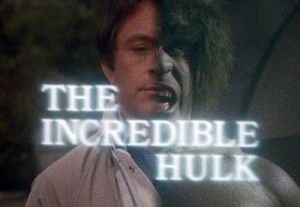 |
|
| The Incredible Hulk TV Series | |
| Seasons: | 5 |
| Episodes: | 82 |
| Air Dates: | 1977 – 1982 |
| Series Creator: | Kenneth Gilbert |
| Stars: | Bill Bixby, Lou Ferrigno, Jack Colvin |
In anticipation of The Avengers opening in May, 2012, Jakob, Stuart, and I are doing a podcast retrospective series of all the movies based on the Marvel Comics Superheroes at Now Playing.
With Now Playing’s current Incredible Hulk Retrospective Series I will also be looking back at every episode of The Incredible Hulk TV series that ran from 1978 to 1982.
Pilot TV Movies
The Incredible Hulk (Pilot)
The Return of the Incredible Hulk (aka Death in the Family)
Season 1
Final Round
The Beast Within
Of Guilt, Models and Murder
Terror in Times Square
747
The Hulk Breaks Las Vegas
Never Give a Trucker an Even Break
Life and Death
Earthquakes Happen
The Waterfront Story
Season 2
Married (aka Bride of the Incredible Hulk)
The Antowuk Horror
Ricky
Rainbow’s End
A Child in Need
Another Path
Alice in Disco Land
Killer Instinct
Stop the Presses
Escape from Los Santos
Wildfire
A Solitary Place
Like a Brother
The Haunted
Mystery Man (1)
Mystery Man (2)
The Disciple
No Escape
Kindered Spirits
The Confession
The Quiet Room
Vendetta Road
Season 3
Metamorphosis
Blind Rage
Brain Child
The Slam
My Favorite Magician
Jake
Behind the Wheel
Homecoming
The Snare
Babalao
Captive Night
Broken Image
Proof Positive
Sideshow
Long Run Home
Falling Angels
The Lottery
The Psychic
A Rock and a Hard Place
Deathmask
Equinox
Nine Hours
On the Line
Season 4
Prometheus (1)
Prometheus (2)
Free Fall
Dark Side
Deep Shock
Bring Me the Head of the Hulk
Fast Lane
Goodbye Eddie Cain
King of the Beach
Wax Museum
East Winds
The First (1)
The First (2)
The Harder They Fall
Interview with the Hulk
Half Nelson
Danny
Patterns
Season 5
The Phenom
Two Godmothers
Veteran
Sanctuary
Triangle
Slaves
A Minor Problem
Reunion TV Movies
The Incredible Hulk Returns
The Trial of the Incredible Hulk
The Death of the Incredible Hulk
February 28, 2012 Posted by Arnie C | Comic Books, Movies, Reviews, Television, The Incredible Hulk TV Series Reviews | 1970s, 1980s, Bill Bixby, CBS, Comics, Hulk, Incredible Hulk, Lou Ferrigno, Marvel, Now Playing, Review, Television, TV series | 19 Comments
Cougar Town Returns Feb 14
This Valentine’s Day, snuggle up on the couch, grab a glass of wine, and turn on ABC at 8:30 EST because Cougar Town is back!
I realize you may have other plans for that night which may involve a dinner out, but dinners can be rescheduled. Cougar Town‘s return is an event worth staying in for.
Cougar Town is a sitcom created by Bill Lawrence and Kevin Biegel originally envisioned as a show starring Courtney Cox as a 40-something divorcee reentering the dating world by dating younger men–hence the title. But as Cougar Town beings its third season it bares little resemblance to its original pitch line. Realizing the strengths of the supporting cast the show has evolved to a concept much harder to sum up. But despite the lack of a pitch line, Cougar Town 2.0 is one of the funniest shows on television.
Echoing Lawrence’s previous series Scrubs, Cougar Town has a strong supporting cast of characters. All played by actors recognizable from previous works, the characters all have charm and wit but the chemistry between the characters allows for both laughs and genuine, touching moments.
The ABC sitcom Cougar Town has struggled in the ratings its first two seasons, and when the network announced their Cougar-less 2011 Fall schedule fans were worried. While ABC assured viewers that Cougar Town would be back as a midseason replacement, the future seemed dark when ABC cut Cougar Town‘s season order from 22 to 15 episodes. However the show never strayed far in fans’ minds as the creators Tweeted regularly giving updates on the show and even throwing parties that allowed fans to see Season 3 episodes early (and drink for free).
But now that the show is back the fan enthusiasm must stay strong, and Lawrence and Biegel’s fan push is continuing as well. Lawrence wrote on his Twitter page that he is trying to find a sponsor to send bottles of wine to all fans who stay in Valentine’s Day and watch Cougar Town. And Biegel said that any group of 25 or more who has their own Cougar Town viewing party will receive free penny cans, signed scripts, and maybe even some series stars to Skype with their fans.
Tips for throwing your own Cougar Town party
But a show this good shouldn’t need such gimmicks to stay on the air, and from the two episodes previewed at the Chicago viewing party, this season appears to be the best yet. With plenty of cameos from Scrubs alumni as well as a season premiere surprise that is perfect for a Valentine’s Day airing.
I highly recommend you check out Cougar Town.
And if you absolutely must go out on February 14th, at least do yourself and your loved ones a favor and set your DVR!
When not reviewing TV for the Venganza Media Gazette, Arnie is a reviewer on the Now Playing Podcast, as well as co-host of Star Wars Action News and Marvelicious Toys
January 17, 2012 Posted by Arnie C | News, Television | Bill Lawrence, Busy Phillips, Cougar Town, Review, Television | Comments Off on Cougar Town Returns Feb 14
How to throw a Cougar Town Party (and why you should)
January 11, 2012
Last Saturday night Chi-town became Cougar Town for an evening at the Racine Plumbing Bar and Grill in Lincoln Park. No, older women were not out prowling for young men, but rather a bunch of fans of the low-rated critically-acclaimed TV series Cougar Town showed up for free drinks and the chance to meet some of the talent behind the show.
Cougar Town is a show from Bill Lawrence, who also created Spin City and Scrubs. Plagued by a title that Lawrence regularly mocks on the show itself, Cougar Town has struggled in the ratings. When ABC did not include Cougar Town in its fall 2011 schedule, fans became concerned despite ABC’s assurances that it would return to the air as a mid-season replacement. A low-rated show going on hiatus is often the death knell of that series.
As we now enter the second half of the 2011-2012 television season, Cougar Town still has not had a return announced. But that is not stopping Lawrence and the rest of the cul-de-sac crew from using social media and local gatherings to mobilize Cougar Town fans and fight for the show to continue.
The creators of Cougar Town have had a greater level of interaction with viewers than most shows. In Season 2 they put a telephone number in the show. If you called the number in real life, you’d sometimes be greeted by a voice mail, but some lucky callers could find themselves talking to some of the show’s creators or stars.
Now Lawrence is taking this interactivity on tour to major cities like Atlanta, San Francisco, Los Angeles, and Chicago. Through Lawrence’s Twitter and Facebook pages fans were invited to come out, watch some as-yet-unaired episodes of Cougar Town, and mix and mingle with the show’s stars and creators. And drink for free on Lawrence’s dime.
The Chicago party was hosted by Busy Phillips (Dawson’s Creek, White Chicks) who plays party-girl Laurie Keller, and series writer Melody Derloshon. Derloshon worked the room well, introducing herself to attendees and sharing anecdotes about the behind-the-scenes goings on of a sitcom. Phillips was also gracious to fans, stopping several times to pose for photos, and sharing stories about her co-stars (In Season 3 when Dan Byrd, who plays Travis on the show, wears a helmet it’s due to the actor’s real-life aversion to washing his hair). Phillips even showed grace when a somewhat creepy fan (also named Travis) seemed unable to separate fact from fiction, repeatedly pulling his shirt down to expose his chest and openly hit on the married actress.
Phillips also provided a running commentary during two episodes of Cougar Town shown to the partiers. The first episode shown was the Season 3 premiere which promises a surprise change in the show’s status quo. The second episode of the evening will be the fifth episode of Season 3, one no Scrubs fan should miss. That episode guest starred Sarah Chalke (Scrubs, Roseanne) as well as Sam Lloyd reprising his Scrubs role of Ted. While hard to hear all the dialogue of the episodes, it seems like Cougar Town’s strongest episodes may be those yet to air.
Ted and his band from Scrubs
Phillips and Derloshon encouraged Cougar Town fans to be vocal with their support, and to use social media to spread the word about the show. And, perhaps, have their own Cougar Town viewing parties when the show does return to the air. And the Chicago party provided the perfect template for your own Cougar Town viewing party:
- Start with plenty of alcohol. The characters on the show are borderline alcoholics with the amount of wine they consume. (Sadly the Racine Plumbing Bar and Grill did not have Big Carls for us to drink from, and our wine was sipped from mason jars)
- Put out a Penny Can or two for people to test their aim on. Don’t have a Penny Can? You can buy the limited edition Blue Penny Can at Cafepress. (The Green Penny Can is now sold out)
- When people start to tire of Penny Can, have some Cougar Town trivia, such as the name of the town in which Cougar Town takes place.
- Watch an episode of Cougar Town.
- Continue to drink
The Cougar Town tour is set to continue with dates announced in Austin, TX as well as New York. If in the area, it’s a unique opportunity to interact with television stars and creators, as well as get free drinks, and support the best show that’s not currently on television.
For future dates on the Cougar Town tour, follow the cul-de-sac crew on Twitter:
Bill Lawrence (series creator)
Kevin Biegel (series producer)
Nicki Maron (Lawrence’s assistant)
Melody Derloshon (series writer)
Busy Phillips (series actress)
Laruie Keller (the Twitter account of Phillips’ character on Cougar Town)
January 12, 2012 Posted by Arnie C | Conventions, News, Reviews, Television | Bill Lawrence, Busy Phillips, Chicago, Cougar Town, Illinois, Party, Review, Television | 1 Comment
A Spider Island Post-Mortem Review
With the recently concluded Spider Island crossover event, Marvel comics and Spider-Man writer Dan Slott have spun a web of fun that has too long been missing from comic books and created a cure for Event Fatigue.
But with Spider Island Slott and company have beaten the odds and done the unthinkable–they created a comic book crossover event that doesn’t feel the need to make seismic changes to the Marvel Universe. At the end of Spider Island no major character dies, no deals with the devil reset continuity, and no superhero zombies eat each other. As such, Spider Island hasn’t gotten much mainstream media coverage. Instead of relying on gimmicks, Spider Island has just given readers a fun, funny adventure that reminded me why I love to read comic books.
In Spider Island Spider-Man’s old villain The Jackal has modified bedbugs to give Manhattan residents powers similar to Spider-Man’s. But while Spider-Man’s motto is “With great power comes great responsibility” the majority of newly super-powered New Yorkers are not as responsible with their powers. Instead of a city full of superheroes, many Manhattan residents use their powers for crime, or just in reckless and dangerous ways. Of course, as is always the case, the plot isn’t quite what it seems and if the heroes aren’t able to stop the spider-people the entire world could be overrun.
It’s a crazy plot that careens from borough to borough, and comic to comic. Spider Island covers Amazing Spider-Man 666 to 673, but also Cloak and Dagger 1 – 3, Venom 6 – 8, Deadly Hands of Kung Fu 1 – 3, Herc 7 – 8, as well as numerous one-shot comic releases bringing in fan-favorite and lesser known characters from Marvel’s roster.
The core of the story is told in the Amazing Spider-Man books following Peter Parker, the true Spider-Man, as he becomes but one of the many Spider-People of New York City. Amazing Spider-Man has had a long history of ups and downs, and recently angered long time fans with its One More Day storyline. After One More Day Spider-Man went through a time of renewal and rotating writers, and finally Slott has come to be the series’ sole writer. Even some of One More Day’s biggest detractors have come to admit that Slott has given Amazing Spider-Man an energetic and fun spirit that were missing during previous runs by authors like J. Michael Straczynski.
With Spider Island, which Slott said on Twitter was the largest writing project of his career thus far, Slott has kept the fun and irreverent attitude and injected a good deal of heart, spirit, and character development. I can easily say the Spider Island issues of Amazing Spider-Man are the best I’ve read in 20 years.
Spider Island is action packed. With so many people gaining superpowers almost every page of every issue is jam-packed with fights. The Avengers, Cloak and Dagger, Spider-Girl, Spider-Woman, the X-Men, and many more are all dealing with outbreaks of criminal activity relating to the new spider people. But while those heroes try to deal with the symptoms of Spider Island, Peter Parker, former girlfriend (and wife though no one remembers that) Mary Jane Watson, Venom, and a few others work at finding the cause, and a cure, for these events.
It’s a crazy plot, and in the wrong hands the story could be a debacle. If taken too seriously, played for horror, this story would be easily mocked. Likewise, played just for laughs this event would lack import. But Slott has found the perfect balance of action and whimsy which makes the issues simply fun to read.
Additionally, Spider Island brings in a good mix of major and minor characters from the Marvel roster. It makes sense as the majority of the Marvel characters are based in New York, and it is a blast to see a great mix of heroes dealing with these events in their own way.
The first few pages of Amazing Spider-Man 673 feature many of these characters in the aftermath of the Spider Island events and Slott’s handing of these characters comes close to breaking the fourth wall with its commentary on superhero conventions, but I haven’t laughed so hard in a long time.
My only negative with the Spider Island issues of Amazing Spider-Man is the art. The primary artist on Amazing Spider-Man was Humberto Ramos, who drew issues 667-672. While his art is incredibly detailed, I cannot warm up to his angular style. To me, Ramos’ drawings are reminiscent of political cartoons more than comic books, and the people are more caricatures than characters. Issue 666 and 673 were drawn by Stefano Caselli and I wish he’d had the entire run as every single page he drew was gorgeous. His last page of 673 deserves to be framed due to both the art and the emotional closure it brought to the event.
The Spider Island stories in the crossover titles ranged both in quality as well as in importance. I understand that it makes sense from a marketing perspective to put the Spider Island logo on as many books as possible to spur sales (it worked for me as I bought every Spider Island issue the day it was released), but as a reader it can be a frustrating experience. 30 comics were released with the Spider Island imprint, and there was no way for the reader to tell which issues were “must reads” and which were elective. Given the price of each issue, it was an expensive gamble.
The most important of these other series were the Venom comics. In a shocking move, some of the events biggest revelations happened in these pages, and readers who stuck to the core Spider-Man issues were left to play catch-up.
Venom also remained very serious, a large tonal shift from the Amazing Spider-Man issues. It shows the events from the perspective of Flash Thompson, the current Venom, who has to try and infiltrate Manhattan while his father lies dying in a hospital. Complicating matters, Thompson’s father was abusive and Flash isn’t sure if he even wants to see his father one last time. It’s a portrayal of parental death far more moving than any of the times Aunt May has been near-dead to dead.
Those readers who did buy the Venom books were doubly rewarded, though, as they both had necessary plot and carried an emotional punch that stuck with me long after I put down the books.
I have not been a fan of old Spider-Man classmate Flash Thompson taking up the Venom mantle–I’m a traditionalist who wants Eddie Brock still trying to dine on Spider-Man’s brain–but despite my feelings towards Flash these Venom issues are a great example of how comics can tug at the heartstrings.
All other Spider Island crossovers are less vital, telling stories against the backdrop of the Spider Island events. They range in both tone and quality. My favorites of the tie-ins are the ones that matched Slott’s playful tone, infusing action and humor with their stories. These include the issues of Herc, Spider-Girl, and the most silly of them all Spider Island Avengers.
Several of the other series, including the Black Panther tie-in, Heroes For Hire, Cloak and Dagger, and Deadly Hands of Kung Fu were more serious stories. These issues were purely elective and I found my enjoyment was directly related to my affinity for the characters involved. I was happy to see Cloak and Dagger headline a comic again, and found myself mostly confused at what was going on in Black Panther. If you are a fan of Black Panther, Cloak and Dagger, or Misty Knight you will already be buying the issues featuring those heroes, but for the characters I did not regularly read these tie-in stories did nothing to make me return.
Spider-Island Deadly Foes gave some great background to the motives of the Jackal and Hobgoblin for these issues. For those who want more of these two, there was also Spider Island: Emergence of Evil reprinting some of the early appearances of these two Spider-villains.
Finally, Spider Island: I (Heart) New York City is the ultimate example of stories told in the backdrop of Spider Island giving an anthology of stories about everyday people getting spider powers. From a Spider-Toddler to a Spider-Mom, these stories were completely unnecessary but well done.
Spider Island: Daily Bugle Free Preview
Spider Island: Deadly Foes
November 5, 2011 Posted by Arnie C | Comic Books, Reviews | Comics, Marvel, Review, Spider-Man | 1 Comment
Duran Duran Rocks Chicago
 After a brief intermission, it was time for my childhood fantasies to be played out. I had no idea what to expect. Previous concerts by 80’s bands have been let downs. Given that I paid higher than average for the ticket and that they were still selling out shows, I felt there was only a slight chance at disappointment. By the time they finished their first song, Before The Rain, any doubts I had were gone. These guys were good. They played well and they sounded great.
After a brief intermission, it was time for my childhood fantasies to be played out. I had no idea what to expect. Previous concerts by 80’s bands have been let downs. Given that I paid higher than average for the ticket and that they were still selling out shows, I felt there was only a slight chance at disappointment. By the time they finished their first song, Before The Rain, any doubts I had were gone. These guys were good. They played well and they sounded great.
The set list was a mixture of their well known hits like A View To A Kill, The Reflex, Careless Memories, and some newer songs such as All You Need Is Now. Throughout the years, they have kept the same sound – something to be said for a band that formed in 1978. New songs blended in perfectly with their classics.
The first song to really get the crowd going was View To A Kill. That song seriously rocked live. While Duran Duran’s original guitarist Andy Taylor no longer tours with the band, his current replacement Dom Brown filled the vacancy well. He played every note like it was his own. After this point, the concert only got better. The Reflex was played to an astounding sing a long as was Hungry Like The Wolf.
Simon LeBon really knows how to work a crowd. He was engaging and all eyes were on him. Nick Rhodes and Roger Taylor appeared to be mostly behind the scenes. I think the only time I saw both of them look engaged with the audience was when Simon announced the band individually. They looked serious, but not like they were having a bad time. The clear cut stage leaders are John Taylor and Simon. Both worked the crowd and spent time on both sides of the stage appeasing fans.
Their stage was not the elaborate sets of the 80’s. This was simple, with three video screens, lots of lights and four weird video screen faces. We might have been too close for the full effect but the video screen faces made Simon look like Terrance Stamp in Superman 2.
All in all, Duran Duran’s music, as well as themselves, have held up well in the thirty-something years since they formed. Their music is solid and they play one hell of a live show.
October 25, 2011 Posted by Arnie C | Music, Reviews | Chicago, Concert, Duran Duran, Illinois, Review, Rock | 1 Comment
Blade: The Series – Post Mortem
As listeners to the Now Playing podcast know, I am a fan of all three Blade films. Having the vampire hunter’s adventures continue on a weekly basis was an appealing proposition. However, I never tuned in during Blade: The Series’ inital run because Spike TV was a cable station best known for lowbrow T&A programming like Manswers and Stripperella. I ended up buying Blade: The Series for $8 at a closing Suncoast Video. I knew the series had been cancelled, but wondered what adventures the writers had given the daywalker in his short TV life. It took Now Playing’s Blade retrospective series for me to finally pull the shrink-wrap off my box set–and I wish I hadn’t.
I was surprised that Blade ended up being a serialized drama series. I had expected it to be episodic like The Incredible Hulk or The A-Team, with each show pitting Blade against a new nest of “suckheads”. In previous reviews I compared this series to Angel and Buffy and those were obvious, but smart, models for Executive Producer David Goyer to emulate. I think it was the right choice to introduce a strong supporting cast of heroes and villains.
But this cast of new characters was not supporting — they were the focus of the series! This seems to be a Goyer’s trademark, as Blade II and Blade: Trinity also sidelined the daywalker to showcase second stringers. I thought a series titled Blade would star a character named “Blade”! But this show would be better off entitled Krista or, were it a hip-hop song, Krista feat. Blade. He’s just using a brand name to sell Krista’s story, much like Frank Mancuso Jr. did with Friday The 13th: The Series. As a fan of Blade the character, this series is not what I wanted. I was blindsided by the House of Chthon drama. I imagine most Blade fans agree.
I will admit there was some Blade backstory shoehorned into this thing, sometimes more successfully done than others. Perhaps the plan was to drip little bits of Blade’s arc into a season, but that seems like a mistake. They scored a major casting coup by getting Richard Roundtree as Blade’s father, but he’s the one given the shaft after five minutes of screentime.
Try as I might, I never could get into Marcus’ conspiracy. I’ve seen this type of story told better a thousand times. Trying to make this series as much about a crime family of vampires as about the hunter was a misstep–and from what I can tell a misstep that Goyer never planned to correct.
I fully expected Marcus and the House of Chthon to comprise the entire Season 1 plot, but figured Blade would vanquish them in time to do something new in Season Two. There are eleven other Houses to explore after all. But no, Marcus and Chase were still out there to cause problems by season’s end. Instead of following the Buffy formula, they tried to be Lost. Well, they did lose!
Admittedly, it would have been harder to make Krista an integral part of the plot had the enemy changed. The show that began with Krista’s brother murdered in cold blood by Marcus, and her conflicting loyalties became the centerpiece of all storylines. Too bad they trivialized her motivations for revenge with daytime soap opera storylines which had her screwing and possibly falling for the man guilty of the crime she wants to avenge. If the creators were going to sideline Blade for other characters, they needed to be likable and strong. Krista does not fill that bill, and while I have been (deservedly) harsh on Jill Wagner’s performance the writers did the character no favors.
I do hold these writers most responsible for the series’ many failings. They seemed unable to pace the plots. Characters like Detective Boone and FBI Agent Collins were given lengthy introductions but never get any payoff. The way these characters were dropped is inexplicable, and frankly embarrassing.
The damning blow was the finale. Ending on a cliff-hanger where Marcus reveals knowledge of Krista’s betrayal, I should have been incensed that I would never know more. I think back to other cancelled shows that concluded with cliffhangers – Twin Peaks, The Dead Zone, Lois and Clark, and even Sledge Hammer. In each of those cases I was furious at the unresolved plots. I even called ABC executives at 11 p.m. on a Sunday night begging for more Twin Peaks. With Blade: The Series I didn’t care. I really didn’t want to see more of Marcus, and I certainly didn’t ever want Krista again.
Series writer Geoff Johns stated in a letter to Wizard Magazine that Blade: The Series was cancelled due to high production costs, not low ratings. Indeed, Blade’s premiere episode was the most-watched episode in Spike TV’s history. But those 2.5 million viewers had dwindled to less than 1 million by the time the season finale aired. I envy those that turned it off. Truth be told, had Blade been renewed for a second season I wouldn’t have watched.
This show was desperately in need of a (pardon the pun) revamp that curtailed the House of Chthon and brought Blade and his partners to the fore. It was what worked in the best episode —Hunters, a mostly Krista-free hour where Blade and Shen got a chance to shine pursuing a tough and frightening vampire they vanquished by the end.
So my final advice is to skip Blade: The Series. While television might have been the right place for the character to nest, this series did not deliver. Hunters was light enough on the overarching stories that I can recommend that single episode for fans of Blade. The rest of it deserves to be ashed. Maybe the upcoming Blade anime series will give our daywalker a proper TV home?
Verdict: Not Recommend
September 14, 2011 Posted by Arnie C | Blade - The TV Series, Comic Books, Reviews, Television | Blade, Marvel, Review, Television | Comments Off on Blade: The Series – Post Mortem
Blade: The Series – Season 1, Episode 12: Conclave
Original Air Date: September 13, 2006
Director: Alex Chapple
Warning: the following review contains spoilers for this and the previous episodes of Blade: The Series You can watch this episode free at thewb.com
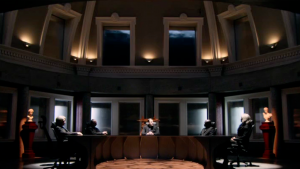
This is the conclave Marcus has worked for years to sabotage? Five vampires? I thought it would be hundreds. Did he really have to work so hard to just kill five vampires? Couldn't he have just done that by hand?
Here we are at the season finale (and unwilling series finale) of Blade: The Series–an episode entitled Conclave.
While this is the culmination of everything Blade: The Series has done, or ever will do, I will review it individually as I have all the other episodes. If you want my overall “final thoughts” on the series, come back tomorrow.
In Conclave, after a dozen hours of show, the stage is set for Marcus’ attack on the purebloods. Unlike all the past episodes of the series, Conclave doesn’t have an A-story, B-story, and a C-story. There is just the one final arc to quite literally bring down the House.
Despite the insane deadlines and his protests last episode, architect extraordinaire Tucker (Tom Butler) met every demand put on him by House of Chthon conclave organizer Marcus Van Sciver (Neil Jackson). The Aurora virus, which will kill only pureblood vampires, is ready. Marcus, in preparation for being the first turned vampire to head the House of Chthon, is trying to forge peace between his right-hand vampire Chase (Jessica Gower) and his new vampire lover Krista Starr (Jill Wagner). Marcus envisions a time soon where the three can rule in harmony when his plot, and the pureblood vampires, are executed.
As mentioned last episode, Blade (Kirk “Sticky Fingaz” Jones) doesn’t want to stop Marcus. Marcus and Blade share a goal–kill vampires. Despite that, Blade is obsessed with attending the conclave. Blade’s partner Shen (Nelson Lee) tries to dissuade the daywalker from interfering, to which Blade responds, “Seeing is believing.” While the mindset is consistent with Blade’s character, it feels like a lazy way for the writers to put Blade in the thick of action again without justifying the stakes.
However, Marcus must have read the script, as he sends Chase to ambush Blade’s lair. Krista, despite her recent romantic feelings towards Marcus, fulfills her duty as Blade’s spy and warns him of the coming attack– only she’s too late. Shen is captured and, in a scene reminiscent of Blade: Trinity, Blade sets off explosives hidden throughout his lair. Most of Marcus’ troops are killed in the blast, though none with speaking parts.
Marcus and Chase presume Blade was also killed in the blast, but decide to pump Shen for information anyway. Marcus, knowing of her experience in the Iraq War, asks Krista to do the torturing of Shen. Krista tries to stall but eventually must apply a scalpel under Shen’s fingernails. “I’m sorry”, but I feel like the one being tortured with this painful sight.
Wagner’s performance actually works for this scene – showing different emotions depending on who she’s facing. We see her inner pain, while she pretends to be playful about it for Marcus. That said, Wagner’s acting range for 11 episodes has never stretched farther than angst and so her Playboy Bunny of Death routinue doesn’t feel genuine.
Krista slips Shen the scalpel while breaking his finger, and later when he’s left alone the man is able to cut his bonds and begins his escape. Shen picks up a sword, then instead opts to arm himself with a pen (a “pen is mightier than the sword” visual gag? Seriously?!) He writes the guard a note and then takes him in hand combat after a tough battle that leaves him pretty bloody. I kept wondering why Shen didn’t keep the sword and save himself a beating. Shen opens the room’s window blinds and dusts the bodyguard, and again I wonder why he didn’t do this before hand combat. Shen’s the brains of the operation, but he’s not showing that here.
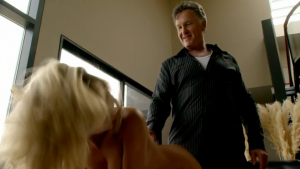
I really never wanted to see the father from Freddy vs. Jason have a sex scene. But now that I've seen it, it's burned in my mind.
Meanwhile Blade somehow deduces the Marcus’ association with the architect Tucker, shows up at his office, and finds the man about to get his groove on with a hot, naked, ready and willing Familiar that Marcus sent him as a thank-you. It’s a sight I found even more repulsive than Shen’s fingernail torture, and was glad to see Blade interrupt by staking the woman to the desk and cutting out one of Tucker’s eyes. He’ll use the severed eyeball to the retinal scanners at the conclave.
I have to pause and wonder why this scene was put in the episode. Sure, another gratuitous titty shot may be appealing to Spike TV’s barely post-pubescent, testosterone filled base, but seeing the father from Freddy vs Jason ready to take the woman from behind was truly repugnant. More, he pauses to get a condom, saying Tucker has “passed around” this woman. Is this supposed to be a safe sex message, alerting viewers to be aware of diseased skanks? Is it just another moment of raunch? Misogyny perhaps? I am dumbfounded. But I’ve already spent more time on Tucker than Blade did, so we move on…
The episode moves to Toronto, where the House of Chthon Pureblood Council awaits Marcus’ presentation. The purebloods have long, self-important speeches explaining how they manipulate tragedies, like the dropping of the H-bomb in Nagasaki, to their benefit. Why is this relevant? It’s not–the screenwriters are just stalling while Blade and Shen reunite and break into the complex.
The episode shows its foolishness when the two vampire killers use Tucker’s eyeball to bypass the retinal scanners and gain entrance to the building. The eyeball is preserved in liquid that makes it revolve in the bottle. Yet somehow the door opens with the retina facing the wrong way from the scanner.
The delays continue as Marcus gives a grand speech to the purebloods and reveals to them that Aurora never worked. Huh? Instead of being sneaky and poisoning the unsuspecting purebloods, he’s just going to stand there and announce his betrayal? I fully expected this idiocy to be Marcus’ downfall, but the joke was on me.
It’s revealed that Chase was a triple agent who’s really aligned with Charlotte and the House of Chthon against Marcus. The special air vents meant to deliver the Aurora poison were shut down, and replaced with a poison to choke Marcus (making me wonder why that wouldn’t also harm vampires. Who doesn’t need to breathe?).
Suddenly, Blade barges in. He throws the vial of Aurora into the air and shoots it while delivering the lame one-liner “Can’t have the party without the keg”. The purebloods begin to writhe and melt away. The effects are full of blood and prosthetics – one of the best, most horrific, visuals of the series.
That only leaves our final showdown a dozen episodes in the making — Blade versus Marcus. Blade states the obvious: “I should have let them kill you” as the two engage in some swordplay and wire-fu. While not even on par with Stephen Dorff’s blade-work from the original film, this stands as the best fight in the whole series.
Meanwhile Chase and Krista go at it in a series of spins and martial arts kicks. Compared to the Blade/Marcus fight, this battle falls short. Generic lines such as “Who belongs to who now bitch?” are given flat delivery, the editing is rapid to hide the actresses’ inability to fight, and often the characters’ faces are blocked by wigs and posts to hide the stunt doubles. In the end, this entire secondary fight comes off like a commercial for Axe body spray, with two girls fighting over Marcus.
The fight ends as Chase is thrown down a huge staircase, and the show’s limited budget again reveals itself–the fall looks like the same effect used in 1989’s Batman Jack Nicholson death. Of course a fall is not enough to kill a vampire, but Krista doesn’t follow up with the death blow and returns to Marcus and Blade’s fight instead.
Shockingly, Blade and Marcus are evenly matched, despite the vampire never really seeming like a fighter. Jackson sells us on Marcus’ physicality, and the wire-fu may be the best I’ve ever seen on television. Unsurprisingly, Blade finally gets the upper hand and goes to deliver the killing blow–when he is stopped by Krista! The distraction allows Marcus to get Blade down. Shen enters, shoots Krista in the back, and Blade uses the distraction to dodge Marcus’ attack.
Krista and Marcus flee. Alone in the conclave, Shen inexplicably chooses this exact post-fight moment for a heart-to-heart. The sidekick claims the fight wasn’t worth it because they ultimately aided Marucus in his insurrection for the House of Chthon. Blade feels that the death of five purebloods, and Krista’s cover kept, is a win. That dubious proclamation ends Kirk “Sticky Fingaz” Jones’ run as Blade.
As for Krista and Marcus, they escape back to Detroit and hide out in Blade’s abandoned lair. Marcus believes Aurora will allow him to rule Chthon, though he believes Chase will come for vengeance. He states: “Even if I watch her ash I’d still watch my back for the rest of my years on Earth”. Wish I knew that a few episodes ago!
Krista has one remaining question: how did Marcus know the location of Blade’s compound. The vampire reveals his full hand–he intercepted Krista’s phone call to Blade and knows she’s a double agent. Fangs out, Marcus grabs her face and says: “How long have you been working for Blade?” as the screen cuts to black. It’s a cliffhanger never to be resolved.
This episode had all the hallmarks of the Blade series–gratuitous nudity, innane character decisions, and lots of action (of varying quality). In contrast to previous episodes, however, the Aurora plot finally moved forward considerably, though not in a satisfying manner. I was left shaking my head at so many stupid character moments courtesy of Blade, Shen, and Marcus. In Blade: Trinity a Familiar asks Blade “Why aren’t you smarter” – a line that kept running through my head this entire episode. Even Shen and Chase, my two favorite characters of the series, make dumb choices in their moments in the spotlight.
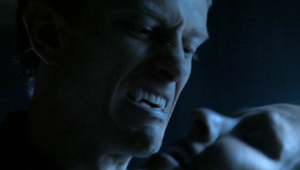
The final shot of the series--Marcus knows of Krista's betrayal. Will he kill her? The world will never know. Or care.
The quality and quantity of fight scenes in this episode made it my second favorite of the series after Hunters. Taken on its own, this was a satisfying episode full of action and excitement. But as a season/series finale it feels lackluster. It felt like we were building to something big, but all that’s here are five dead purebloods. I expected more.
As for the series as a whole? Tomorrow on NowPlayingPodcast.com Stuart, Jakob, and I finish our Blade movie reviews as we look at Blade: Trinity. Take a listen tomorrow afternoon, then come back here for my final thoughts on Blade: The Series.
You can hear Arnie, Jakob, and Stuart review all the Blade films on the Now Playing podcast!
Read Arnie’s other Blade TV Series reviews:
| Introduction | |
| 1 | Pilot |
| 2 | Death Goes On |
| 3 | Descent |
| 4 | Bloodlines |
| 5 | The Evil Within |
| 6 | Delivery |
| 7 | Sacrifice |
| 8 | Turn of the Screw |
| 9 | Angels and Demons |
| 10 | Hunters |
| 11 | Monsters |
| 12 | Conclave |
| Conclusion | |
September 12, 2011 Posted by Arnie C | Blade - The TV Series, Comic Books, Reviews, Television | Blade, Marvel, Review, Television | Comments Off on Blade: The Series – Season 1, Episode 12: Conclave
Blade: The Series – Season 1, Episode 11: Monsters
Original Air Date: September 6, 2006
Director: Ken Girotti
Warning: the following review contains spoilers for this and the previous episodes of Blade: The Series You can watch this episode free at thewb.com
When the TV series Lost was approaching its series finale, my wife and I would watch every episode faithfully and then discuss our thoughts on that episode with each other. On the second-to-last episode my wife expressed disappointment in the episode; how so little happened and it seemed like filler.
Unfortunately that is a pattern I have found with lots of action and sci-fi television series. When leading up to a climactic episode (usually during sweeps, often a season or series finale) there is far too often an episode that merely exists to set everything up, so that the final episode may be almost entirely devoted to the showdown. All the pieces must be in place when we ramp into the final episode.
The problem with such episodes is they’re often extraordinarily dull. The story arcs have been leading to this point for a season or more, so an entire episode just to remind us of what we loyal viewers already know comes off as filler and, worse, as poor writing.
There are also financial concerns to consider.. Series producers want their shows to go out with a bang, and leave the audience wanting more. In television series the cost-per-episode is not consistent–sometimes they cheap out on one episode so they can spend more on the next, and these set-up episodes almost always feel like they were purchased at a Dollar General.
Which leads me to Monsters, the second-to-last ever episode of Blade the TV series….
I really had hoped for another standalone plot after previous episode Hunters, but I didn’t really expect it. With only two hours left I figured we’d return to the uprising of vampire Marcus Van Sciver (Neil Jackson) in the House of Chthon, and the rogue vampire Boone (Bill Mondy) coming to take revenge on Marcus.
In some ways, that is what we get. Our A-story starts off with House of Chthon elder Charlotte (Emily Hirst) and her goon Thorne (John DeSantis who played Lurch on The New Addams Family) flying back home. Marcus’ aide Chase (Jessica Gower) had pretended to dish on her employer and given Charlotte the hilt to Blade’s sword. However, hidden inside the handle was an explosive, which sends Charlotte’s airplane crashing to the ground when it detonates. It’s presumed by all that everyone was killed on impact, but Charlotte and Thorne emerge from the wreckage and slaughter a small town to obtain the blood they need to heal their injuries. How did they survive the crash in the first place? The writers speak through Blade when he mutters “doesn’t matter.” They just needed to get the plot set up!
News of the plane crash forces Blade to seek help from his new partner…FBI Agent Ray Collins (Larry Poindexter)! It turned out the reason the coroner reappered a couple episodes back was merely to tip Collins off that Blade was somewhere in Detroit. Based on that information, Collins walks right into Blade’s lair. Through his FBI connections Collins is able to find out where the plane went down. Blade doesn’t think Charlotte survived, but wonders if any records on the location of the House of Chthon conclave may have survived the crash.
Of course, this is a bit of a paradox. Collins came to Blade wanting to stop Marcus, but Blade says he and Marcus have the same goals–death to vampires. With the enemy of Blade’s enemy being Blade’s friend, Blade wants to let Marcus finish his plot..and yet Blade seems intent on knowing every detail. But maybe that will be explained next episode?
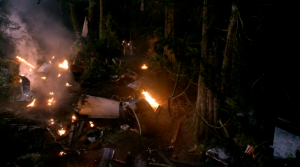
Throw some burning cardboard around and pretend it's a crashed airplane. Isn't that what Lost did? No? Okay then.
But in this episode, what we get for the next hour are Blade and Collins searching the crash and following the trail of Charlotte and Thorne to a local school, all the while swapping war stories. For a laconic hero, Blade is pretty forthcoming to Collins–both about methods to kill vampires and about Shen’s (Nelson Lee) backstory. This gives me another peak into my favorite supporting character. It turns out Shen is hunting a couple of vampires (presumably the ones who took his sister). Shen’s agreement with Blade is when Blade finds the vampires, Shen gets the honor of killing them.
In response, Collins shares his backstory–he caught a serial killer, but an improperly executed warrant allowed him to go free and murder Collins wife and daughter. Collins went rogue, executing the killer before he could have a second trial. Since then he has used “unorthodox methods” to stop criminals.
It seems like Blade and Collins have a partnership made in vampire heaven, and the two work together in the school killing vampire townies in some lackluster fights. Seeing the vampire hunters’ success, Charlotte traps Collins by pretending to be a scared child. Perhaps due to the death of his own daughter, Collins falls for it and Charlotte bites him.
Blade and Thorne have the best fight in the episode (which isn’t saying much). After dusting Thorne, Blade goes to confront Charlotte, who makes Blade the same offer Deacon Frost did in the first movie–join us, work with us. Blade responds with his glaive and dusts Charlotte.
That is the first of two lackluster deaths. Don’t get me wrong, I’m very glad to see Charlotte go. The character had promise, but the actress ruined it for me. Every word she uttered thudded to the ground, and I’ve commented on it in each review where she appeared, so I will not linger on this topic. I just hope I never have to see actress Emily Hirst in anything again. However, it was an anticlimactic death for a character built up as a supposedly powerful foil for Marcus.
But that is nothing compared to what comes next.
Blade is reluctant to stake his new partner after bonding on the hunt, but Collins knows it’s necessary. So Blade dusts the former agent. Talk about an aborted plotline! For ten hours I’ve watched Collins hunt rogue cop/vampire Boone across the country. Now Collins is killed so arbitrarily in a school? How can the show not give me a Collins/Boone showdown? How can we not get the “you’ve been looking for me, here I am” moment? But no, Collins is killed for no reason, accomplishing nothing in this series. What a freaking waste of my time, and of a character.
Now Collins did lead Blade to recover items from the plane wreckage Shen is able to track to the conclave in Toronto, but that does not justify the length of this character’s arc. It’s as purposeful as the easily-forgotten coroner telling Collins about Blade. Finding the plane is a job for any minor character, not one who’s story we’ve followed the whole season.
This is poor, poor writing, and it angers me greatly. Now maybe the writers aren’t entirely to blame–many things influence television show evolution, including actor contracts, reduced episode orders, and so on. But given Blade only lasted one season I cannot imagine any of that happening here. That the Boone/Collins storyline arced over the whole season and ended this way is just frustrating. If this is the way the show would have continued, I am glad it was not renewed after this season.
As for our B-plot, following Blade’s House of Chthon undercover spy Krista Starr (Jill Wagner) and Marcus’ plan to kill all the Chthon purebloods, very little happens. We see Krista and Marcus having some loving moments, and Krista is torn between her attraction to the kind, gentle Marcus with whom she makes love, and her disgust for the vampiric, violent Marcus who ruthlessly kills without remorse. This is, of course, setting up suspense for the finale where Krista must surely choose sides once and for all.
Meanwhile, Chase is becoming more jealous of Krista’s place at Marcus’ side and in Marcus’ bed–a jealousy fueled when Marcus gives Krista a locket once owned by his human wife. There is a slightly erotic scene where I wasn’t sure if Chase was threatening Krista or hitting on her. Chase stands close to Krista and kisses her on the lips, but also talks about how Chase sees Krista as “a hollow little girl playing hollow little games”.
And as for Marcus? When he’s not enjoying a romp with Krista, he’s killing his familiar contractors. Marcus demands a special air handling system be put in place but his favorite architect Tucker (Freddy vs. Jason‘s Tom Butler) threatens to quit if Marcus doesn’t scale back. Marcus, realizing Tucker is too valuable to kill, threatens everyone Tucker knows if the work is not done. Of course, Tucker acquiesces. And the air system? My guess is it’s the delivery mechanism for the Aurora virus that will kill the purebloods. I wish the show would have kept its hand a little more hidden.
As I said above, this episode is getting the pieces in place for the showdown; it’s unfortunate they had to spend a full episode of the series doing so.
But we end this episode with Blade meditating, then vamping out and roaring for no apparent reason, I hope it’s because the finale is coming, and Blade and Shen get to kick some ass.
You can hear Arnie, Jakob, and Stuart review all the Blade films on the Now Playing podcast!
Read Arnie’s other Blade TV Series reviews:
| Introduction | |
| 1 | Pilot |
| 2 | Death Goes On |
| 3 | Descent |
| 4 | Bloodlines |
| 5 | The Evil Within |
| 6 | Delivery |
| 7 | Sacrifice |
| 8 | Turn of the Screw |
| 9 | Angels and Demons |
| 10 | Hunters |
| 11 | Monsters |
| 12 | Conclave |
| Conclusion | |
September 11, 2011 Posted by Arnie C | Blade - The TV Series, Comic Books, Reviews, Television | Blade, Marvel, Review, Television | Comments Off on Blade: The Series – Season 1, Episode 11: Monsters
Blade: The Series – Season 1, Episode 10: Hunters
Original Air Date: August 30, 2006
Director: Brad Turner
Warning: the following review contains spoilers for this and the previous episodes of Blade: The Series You can watch this episode free at thewb.com
Episode Ten opens in a nightclub, and immediately I’m reminded of the original Blade movie (sure they played New Order and this show can only afford heavy metal music in the public domain, but the comparison is still welcome). Is this a vampire club? Will Blade (Kirk “Sticky Fingaz” Jones) come in and ash everyone here?
Party girl Jennifer is slipped a rufie and wakes up handcuffed in a dingy basement. She’s the latest prisoner of The White Prince (Scott Heindl) – a vampire not connected with any of the Houses we’ve seen and has spent centuries feeding on and brutally torturing women. Like we’re told he cuts open their stomach and dances on their intestines (sadly visions of the guy tilting his head back and doing the Snoopy Dance on a pile of guts are left strictly to our imaginations). His face scarred from self-inflicted wounds, White Prince dons a poorly sewn mask (think Platinum Dunes Leatherface crossed with the David Cronenberg in Nightbreed) and films himself extracting all of Jennifer’s teeth.
Yes, coming completely out of left field is a stand-alone murder mystery episode that actually plays thing like a straight up horror tale – a rarity for Blade given how often it features action vampire over scary vampire. And by breaking from the serialized storylines the show now gives new viewers a chance to get hooked. I cannot imagine flipping through the channels, stumbling upon an episode like last week’s Angels and Demons, and being captivated by the multitude of new characters in a 19th century setting (and Blade himself relegated to a walk-on). But Hunters is an ideal introduction for viewers late to the Blade series. It certainly would make my Must-See TV schedule from this point forward (though admittedly we’re catching it two episodes from cancellation).
Another girl named Nicki goes missing, and concerned friend Daniel asks Shen (Nelson Lee) to take the case. Shen, writing Nicki off as dead, initially refuses until Daniel accuses Shen of being Blade’s lackey who wasn’t so blase when his own sister was in danger. It’s satisfying to get some character development for this sardonic co-star, and I’m happy to see Shen taking the spotlight this time. It’s inferred that Shen came to hate vampires after his sister was…bitten? Killed? Abducted? A thread for a future episode which may never come.
But this is Shen’s case now, with Blade, always up for killing vampires – playing second string. There’s a great exchange between the two:
Shen: You don’t think she’s alive do you?
Blade: No
Shen: Do you hope she is? Do you care?
Blade: You do that for me
This sets up a good dynamic, showing that Shen is Blade’s conscience as well as his weapons maker. Perhaps even more important, Blade knows it.
This story continues with some red herrings as Shen and Blade try to find out the identity of the White Prince’s Familiar, whom the men amusingly refer to as “a Renfield” (a nice callback to the original Familiar). Blade and Shen use Nicki’s sister Bethany as bait, and she’s abducted by bartender Kurt (Dominic Zamprogna) to become the White Prince’s next victim.
I like The White Prince as a concept, but I’m lukewarm on the execution. How quaint that he uses VHS to videotapes himself torturing the victims. Sure, age-old vampires may not be up on the latest digital technology but you’d think in 2006 mini-CD or digital would be preferable! His look worked for me at times. He wore a stylized coat that actually allowed him to camouflage himself against the wall, and the mask was creepy. That said, I was disappointed when the eventual unmasking comes.
Masks really should serve one of three purposes in horror — 1) hide a killer’s identity so when the killer is revealed we have a shock (Scream); 2) hide something so grotesque we are revolted when we see it (Friday the 13th); 3) be spooky enough on its own that we are terrified (Leatherface). There should also be an in-story reason for a character to wear a mask, such as trying to hide their own identity, or a psychological defect where the mask allows disassociation of the person from their acts (Michael Myers).
The mask had me guessing the entire episode. While all signs pointed to the wearer being the White Prince vampire, I started wondering if perhaps it was a human serial killer emulating a famous vampire. After all, why would a vampire torture rather than feed? Maybe it’s Detective Boone (Bill Mondy), who is constantly hunted but we haven’t seen since the fifth episode? Or maybe it’s a minor character from the House of Chthon? Will it be someone from Blade’s past, or perhaps Shen’s? Maybe even Shen’s sister?
Nope.. it’s just a vampire with a hang-up over self-inflicted scars. Wow, what a let-down from what could have been a killer unmasking scene (pun fully intended)! Blade unmasks and fights the White Prince, ripping the killer’s jaw off before dusting him.
Meanwhile, Shen keeps his focus on rescuing the girls, but is ambushed by Kurt. This gives Shen a chance to shine in some hand-to-hand combat, and for me to actually be shocked when Shen is not content to just hand Kurt over to authorities after defeating him. Instead Shen buries a straight razor in Kurt’s stomach and the way it comes off does not play as self-defense but murder. A wonderfully ironic ending — Kurt helped the Prince so he could be immortal and instead died young.
Is the show posing a moral question here, or are we just to take Shen’s killing of Kurt the same way we do Blade dusting the White Prince? This feels different for some reason, perhaps because Kurt leaves a corpse rather than flaming out in a fake-looking CGI shot.
But all told, it was a satisfying story that focused on our heroes for a change, rather than the villains in the House of Chthon. A welcome change of pace that becomes only the second episode in the series that I would rate as “good”, and which usurps Sacrifice as my favorite episode of the series.
Hunters does include a few ongoing subplots for long-time viewers, with a B-story involving Krista (Jill Wagner) in detox after her feeding frenzy and copulation with House of Chthon power-player Marcus Van Sciver (Neil Jackson). Krista has fully rejected Blade’s serum and goes out on the hunt. Blade quickly captures her, force-injects serum, and makes it clear Krista will get over her bloodlust and return to his side of the war on vampires or Blade will dust her. There are several scenes of her fighting to get out, eventually breaking down the metal door that contains her and… stays put. When Shen and Blade return at the very end of the episode, Krista has conquered her bloodlust and is ready to be Blade’s spy in the House of Chthon again.
And speaking of Chthon, in our C level story House elder Charlotte (Emily Hirst) is coaxing Chase (Jessica Gower) to reveal Marcus’ plans. Of course we know Chase is siding with Marcus against the purebloods when she pretends to align herself with Charlotte and promises delivery of both Marcus and Blade.
Mercifully the House of Chthon scenes, especially those featuring piss-poor actress Hirst, are short. I am growing weary of this plot line that doesn’t hold enough twists to be stretched over a dozen episodes. I was glad to get confirmation of my suspicion that the baby in a bag from last episode was a snack for Charlotte, who prefers the blood of hours-old newborns. Ahh, if only she could act she might be a good villain.
For the first time in the series we have no sign of FBI Agent Collins (Larry Poindexter) and his new coroner partner, nor any reference to Boone. The episode smartly focused on the White Prince story and was the better for it.
Two episodes left to go, I actually find myself hoping for another hour devoted to a self-contained story as fulfilling as the White Prince’s and then a finale wrapping up the House of Chthon/Boone storylines. But we shall see.
You can hear Arnie, Jakob, and Stuart review all the Blade films on the Now Playing podcast!
Read Arnie’s other Blade TV Series reviews:
| Introduction | |
| 1 | Pilot |
| 2 | Death Goes On |
| 3 | Descent |
| 4 | Bloodlines |
| 5 | The Evil Within |
| 6 | Delivery |
| 7 | Sacrifice |
| 8 | Turn of the Screw |
| 9 | Angels and Demons |
| 10 | Hunters |
| 11 | Monsters |
| 12 | Conclave |
| Conclusion | |
September 10, 2011 Posted by Arnie C | Blade - The TV Series, Comic Books, Reviews, Television | Blade, Marvel, Review, Television | 2 Comments
Blade: The Series – Season 1, Episode 9: Angels and Demons
Original Air Date: August 16, 2006
Director: Norberto Barba
Warning: the following review contains spoilers for this and the previous episodes of Blade: The Series You can watch this episode free at thewb.com
I mentioned in the Blade movie review for Now Playing that I saw similarities between the character of Blade and the character of Angel from Buffy the Vampire Slayer, a vampire who had his soul restored. Angel thus has all of the powers of a vampire, and uses those powers to fight other vampires. Sure, there are some differences between Blade and Angel, but there are a lot of similarities too.
But in watching this latest episode of Blade: The Series I was not happy to be reminded of Angel’s own self-titled spin-off series. There are some parallels between the two series–Marcus Van Sciver’s company is similar to Wolfram and Heart, and Blade and his friends fighting to take it down. The two even have similar story structure with the episodic fights that lead to the larger story arc. But if the differences before were subtle, this week’s episode made them abundantly clear.
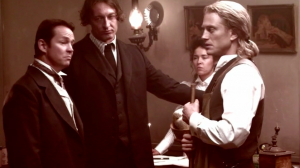
Filmmaking 101: If you have no confidence in your sets, your costumes, or your actors to sell the time period, make everything brown like an old timey photo.
One of the storytelling devices the Angel series used was showing flashbacks of the vampire characters from hundreds of years earlier when the characters were in their human lives or newly turned as vampires. Angel, Spike, Drusilla, Darla, and others all had their backstories fleshed out through flashbacks. I always felt these period-pieces were poorly done in Angel, and asking one-note actors like David Boreanaz to pretend to be old world characters with accents didn’t work either. I hated those flashback episodes and always fought to pay attention.
And so I had a flashback of my own while watching Angels and Demons: a flashback to watching Angel and hating that they were subjecting me to needless scenes from Angel’s early life. Of all the things from Angel to copy, that is one Blade‘s creators should not have emulated. Yet they did.
To be clear, I am not entirely anti-flashback. Just two episodes ago in Sacrifice we got wonderful flashbacks to Blade’s childhood, but those flashbacks were given in a way that both served character and story. By contrast, in Angels and Demons we get flashbacks to House of Chthon power player Marcus Van Sciver’s (Neil Jackson) human origins in the late 19th century, and what a mess these scenes are!
First, the performances are not convincing. I’ve always felt Jackson was perfectly cast as evil businessman vampire Marcus, but playing a happy-go-lucky newlywed opening a feed store in the 1800s was not in the actor’s range. (I really hope he honed his period-piece acting chops before filming 2013’s The Scarlet Pimpernel in which he is rumored to be the lead).
Second, the film style was annoying. Perhaps the budget was not there to convincingly create sets that look like old-time Detroit, but to put the scenes through an obvious video-toaster level sepia filter is obnoxious. It made the scenes ugly.
And third, while the flashbacks did tie into the modern day story, it was nowhere near as cleanly interspersed as Blade’s childhood was in Sacrifice. For much of the episode I didn’t realize they tied in at all. The framing for this week’s story was that Marcus’ newest protégée Krista Starr (Jill Wagner) was distraught over her role in the deaths of her mother and uncle last episode, and Krista works through her grief by getting drunk attacking humans.
Marcus is understanding but not exactly sympathetic as he tells Krista that all vampires suffer the deaths of the ones they used to love in their human lives. To illustrate this point, Krista has an after-death experience in which she sees Marcus in his human life.
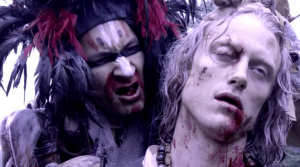
Had the series continued, would the Native American Vampire plot been further explored? I'd love to see Goyer try to explain that.
With that lame a set-up I was really not happy these flashback scenes at all. More, they confused me as we had seen Marcus being turned in the pilot as Krista’s first after-death experience, and I thought it took place in 14th or 15th century Africa with witch doctors and such. Seeing natives in tribal headresses and Marcus sporting an old-world hairstyle I thought it was far earlier than the 19th century, and not in the USA. Fortunately, the episode does address that dissonance.
However, the flashback got a bit more interesting as Marcus opens his store, and in walks Damek (Brent Stait) of the House of Armaya. We saw Damek previously, blackmailing House of Chthon pureblood elder Charlotte (Emily Hirst), but now we see him as an old-school gangster vampire running a protection racket in 19th century Detroit.
Marcus is willful and refuses to pay, so Damek forces Marcus to watch as he rapes and bites Marcus’ wife Isabelle in a scene that actually shocked me. I expected Isabelle to be beaten and disfigured, but the rape was graphic and extreme. And when Marcus still will not bow to Damek’s request, Damek boxes Marcus up in a coffin and ships him…somewhere. Here the episode doesn’t go into great detail, but I am taking it that the tribal people who turn Marcus are not African, but rather Native Americans who, with a black wolf, perform a ritual which turns Marcus into a vampire.
I can’t say I like the idea of American Indian vampire tribes, and I would have preferred something a bit more old-world, a bit more Anne Rice, which I had originally thought was Marcus’ background. I also do not understand why Damek would punish an enemy by sending him to be turned immortal. But I did like that Marcus has a long history with Damek, and an intense reason beyond the normal caste system for his hatred of pureblood vampires.
In the most trite of writing cliches, we see that in modern day Detroit the same Marcus/Damek dynamic is playing out again. While Damek got everything he wanted from Charlotte in his blackmail scheme, he has gone to Detroit to visit Marcus and demand a cut of Marcus’ financials. Why? Because he can is the best answer the episode gives us, and that isn’t enough for me. But it does shoddily create a parallel between Damek entering Marcus’ store in the 19th century demanding a cut, and Damek doing the same thing on a larger scale in modern day.
And, as in the 19th century, Marcus refuses to give in to Damek’s demands, and the two engage in a bloody brawl. I must say this fight has some truly great moments, such as Marcus holding Damek’s head in the burning fire, and Damek impaling Marcus with a fireplace poker. The sub-par CGI effects, such as Marcus pulling the poker out, don’t lessen the fight’s excitement.
I wish the episode had gone into more detail about why Marcus chose this moment to kill Damek. For nine episodes we’ve seen Marcus cow-tow to the purebloods while, in secret, working on the Aurora virus to kill them. But now that the virus is almost ready, Marcus kills Damek hand to hand? I would have liked to see the Aurora plot tie into Damek’s murder. How easy it would have been to, instead of having a brawl, have Marcus offer Aurora to Damek? As Marcus’ front for Aurora is that it makes vampires immune to silver, garlic, and sunlight, Marcus could have pretended to capitulate and offer Damek the opportunity to be the first unstoppable vampire. Then Damek’s greed causes a painful death fitting for his character.
Don’t get me wrong, the fight between Damek and Marcus was good, but it was random. The death by Aurora would have been a culmination of the plot so far. Instead, we just see Marcus, after over 100 years of being subservient to Damek, taking a stand and fighting back physically with no explanation as to why.
I do love Damek’s last moments. While Marcus has brooded for over a century about the way Isabelle was raped and killed, Damek just laughs saying “I don’t remember you, or whoever that whore was you say I killed”. A nice, evil touch that works to put centuries of evil deeds in perspective.
And with that strike against the House of Armaya, Marcus sends his right-hand vampire Chase (Jessica Gower) to dust Damek’s driver. And she does so in a very cool way–a swift roundhouse kick, her boot containing a James Bond-like blade, which cuts the vampire’s throat.
Then, in their shared pain, Krista and Marcus then have tender vampire sex. Well, tender may not be the right word, it’s actually really violent–full of fangs, blood, and biting, but the musical score tries to make the scene seem tender and emotional. I have to say I didn’t see this twist coming. The entire series thus far has been about Krista trying to get revenge on Marcus for murdering her brother. If we had a better actress than Wagner in the role of Krista perhaps this would have been foreshadowed and come across as believable; instead it just comes off as a shock and felt arbitrary.
And while Krista and Marcus do the bloody deed, Blade (Kirk “Sticky Fingaz” Jones) is watching from outside like some creepy peeping-Tom. Oh yeah, Blade! This series is called Blade, not Marcus! So where was Blade this episode? Well, he had a few scenes. Shen’s friend at the CDC diagnosed the Aurora as a virus designed specifically to kill only pureblood vampires, and there is some shaky scientific reason given as to why it’s developed in the wombs of human women (as revealed in Episode 6). So Blade goes to the House of Chthon to investigate, and Shen hacks the security system cameras…only to have his hacking undone by episode’s end.
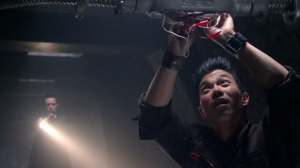
Given Whistler's fate in the films, I keep expecting Shen to have a lame death, such as being caught by a House of Chthon security guard.
Blade’s appearance in this episode felt obligatory and he really had no story to speak of, but there were some bright moments courtesy of Shen who I’m liking more and more as the series continues. Shen is alone in the sewer, hacking into the Chthon security system when he is interrupted by a security guard. Here, I really thought Shen might die. His snarky attitude was one of the bright points of the series, and I would have been upset to see him go. But surprise! Blade is lurking, and pulls the guard into the ceiling then drops his dead body. It was a fun bit of violence and I’m glad to see Shen live on.
Finally we get one scene of Charlotte, who becomes more convinced of Marcus’ betrayal when Charlotte’s spy Glynnis goes missing. This scene is there just so we don’t forget Charlotte, though I keep trying to.
And we get two scenes of Agent Collins. He is going back with his captain, when he sees a tattoo on the captain’s wrist–the captain is a Familiar. Collins escapes and goes running to…some woman’s house. This really confused the hell out of me so I had to stop the episode and do some digging–who was this woman? It turns out her name is Jessica Ellis, and way back in episode 3 she Was the coroner who showed Agent Collins the van full of ashed vampires. She was such a minor, functional character that I didn’t even include her in my episode summary, but now she’s back.
We had not seen her in 6 episodes, and for normal TV viewers this would have been a month and a half between appearances of this minor, generic character. I even went to TheWB.com where they have all these episodes on demand and include the “last time on Blade” scenes that are not on the DVD. In this episode’s recap there is no shot or mention of Ellis, so I imagine I was not the only one who was like “who is this?”
But the coroner has seen enough strange deaths, so she believes Collins’ story of vampires. She tells Collins of Blade, who was last seen in Detroit.
Overall, this episode was pretty mediocre. Still nowhere near the heights of Sacrifice, and with only three episodes left to go I am really hoping things escalate. A little less backstory and a little more story would be a welcome change of pace.
You can hear Arnie, Jakob, and Stuart review all the Blade films on the Now Playing podcast!
Read Arnie’s other Blade TV Series reviews:
| Introduction | |
| 1 | Pilot |
| 2 | Death Goes On |
| 3 | Descent |
| 4 | Bloodlines |
| 5 | The Evil Within |
| 6 | Delivery |
| 7 | Sacrifice |
| 8 | Turn of the Screw |
| 9 | Angels and Demons |
| 10 | Hunters |
| 11 | Monsters |
| 12 | Conclave |
| Conclusion | |
September 9, 2011 Posted by Arnie C | Blade - The TV Series, Comic Books, Reviews, Television | Blade, Marvel, Review, Television | 1 Comment
Blade: The Series – Season 1, Episode 8: Turn of the Screw
Original Air Date: August 16, 2006
Director: Norberto Barba
Warning: the following review contains spoilers for this and the previous episodes of Blade: The Series You can watch this episode free at thewb.com
After being treated to the best episode in this series, I had high hopes coming into Turn of the Screw, and the opening scene didn’t disappoint. At first I thought it was going to be a recap of last episode’s conclusion, as we see Krista Starr’s mother Lisa (P. Lynn Johnson) lying in her hospital bed, as we saw last episode. I had assumed that we would see a replay of last week’s final scene–Krista (Jill Wagner) choking her mother with a pillow, then Glynnis (Jody Thompson), the vampire spying on Krista, entering and discovering Krista’s collusion with Blade. As the two women prepare to fight, FBI Agent Collins (Larry Poindexter) would enter and get visual proof that vampires exist, and the two vampires would turn their fangs on him. Then, finally, the action would begin.
I thought all this as the camera held steady on Krista’s mother, but the scene was still. And as I saw Krista’s mom laying there, bleeding from her wrist, I found myself wondering “Where’s the pillow Krista used to choke her? Is the choking coming?” Then the episode shows its hand and it fooled me — the silence is broken by Agent Collins’ body being thrown over the body of Krista’s mom, and the episode begins where I wanted it to–with the vamp-on-vamp fight between Glynnis and Krista.
And man what a fight it is! The stunt men have their best wire-fu going. Sure, some of it is sped up obviously to enhance the action, and it would still be sub-par for a Blade theatrical film, but this stands as the best fight we’ve seen in the series to date. Glynnis hugs the ceiling to avoid Krista, and Krista wins the fight by smashing Glynnis with a full-length mirror. Glynnis dissolves because, as Krista helpfully states, mirrors are backed with silver, and I’m left to Google “mirror, silver” to see if it’s true. Sure enough it is!
Still, the fight ended exactly as I predicted, with Glynnis dead and Krista and Collins back where they were before. I would have liked a game-changer; instead I got yet another Krista victory.
During the fight, newly-turned Lisa escapes the hospital room, thus setting up the plot of the episode: Blade (Kirk “Sticky Fingaz” Jones) and Krista chasing after Lisa. Blade’s security system had tapes of Krista stealing his serum, so he goes to confront his partner but quickly joins Krista in the hunt for Lisa.
Not familiar with her vampiric nature, Lisa first goes to her bother’s house where the thirst overtakes her. As she feeds on Krista’s uncle she has a vision. Vampires often get visions of their makers being turned, and Lisa witnesses her daughter being turned by Marcus Van Sciver (Neil Jackson). As Marcus is a local celebrity, the confused Lisa heads to the head vampire’s office complex.
Krista and Blade spend the episode playing “catch-up.” They find the body of Krista’s uncle, and while Wagner tries to display pain outside her acting range, Blade beheads the corpse lest it turn into a vampire.
When the two finally catch up to Lisa, she had already fed enough times that Blade’s serum held no power and there was no choice but to kill her. Blade is, of course, ready to do the deed but Krista ends up taking responsibility for her actions. Krista pulls the trigger putting her mother out of her misery as the screen cuts to credits.
And thus ends this week’s lackluster A-storyline. A far letdown from last week’s Blade story.
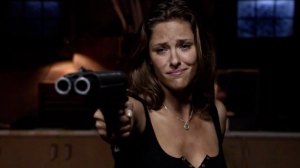
Krista should be torn up as she is about to ash her own mother. But Wagner's facial expression looks like she just ate some bad Thai food.
I was immediately disappointed when this episode started with Shen (Nelson Lee) asking if Blade would try to talk to his father, introduced last episode, and Blade responds “no”. I was hungry for more Richard Roundtree, and this episode was fatherus interruptus. Replacing it with Krista hunting her mother was a poor substitute indeed!
But this week’s B-storyline involves my favorite fanged fiend, Chase (Jessica Gower)! Marcus’ right-hand-vampire is mostly healed from Blade’s planted bomb, with just some burns on the back of her neck, so Marcus sends her to Vegas to lowball a business deal. Of course, this deal takes place in a strip club, and my “unrated” DVDs make up in one scene for the gratuitous titty shots that have been lacking the past several episodes.
At the strip club Chase is spotted by a pureblood vampire named Alex (Kavan Smith), who apparantly likes a challenge as Chase is the only clothed woman in the room. It is revealed Alex and Chase had a relationship 60-some-odd years ago–a relationship Alex wishes to rekindle with some wonderfully kinky, violent vampire sex. There are some great lines in this scene such as Alex saying “I have missed you” and Chase replying “I haven’t thought of you once” before cutting her breast for Alex to feed on. With Chase it seems possible.
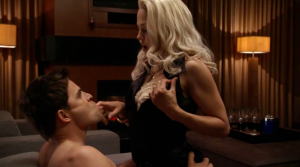
Chase and Alex look like they're having a bloody good time together. But what happens in Vegas...ends in Detroit I guess.
This plot then becomes muddled. Chase tells Alex that since the bomb in Berlin, Marcus has lost faith in her, and she thinks she’s been sent to Vegas set up to fail. Chase says she’d like to stay in Vegas, away from Marcus, and be with Alex. Marcus then shows up, catches Chase in bed with Alex, and Alex throws some insults at humans-turned-vampires in general and Marcus in particular with the best one being that turned vamipres are “pieces of meat that got a reprieve”.
With the posturing out of the way, Alex then tries to pay Marcus for Chase’s freedom. Alex views this as rescuing Chase, but she sees as being bought from Marcus like cattle. Alex and Marcus toast to the agreement, but Alex’s blood drink was drugged, and when Alex awakens he’s strapped down to a chair and injected with the Aurora virus which causes him to die a slow, agonizing death–the final test for Marcus’ biological weapon against the purebloods.
Now I don’t know if Chase’s angst was real, or if all this was a plot set up to lure Alex so they could test the drug on a pureblood. As written, the episode allows it to go either way. You can see Chase enjoying the rough sex, and also hurt by Alex’s comments on turned vampires, so had he not been so callous would he still have died? I don’t know.
What I do know is that Marcus wanting to use the drug on the purebloods was set up episodes ago, robbing this episode from any surprise when we see Aurora used as a weapon. There was no suspense as Alex was injected, just a knowledge that he had been betrayed by Chase.
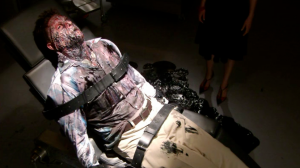
With Aurora we get to see an all new way for Vampires to die. Slowly. And with lots of latex make-up.
The ambiguity of Chase’s motivations intrigues me, but the entire plot line was hampered as we had never seen Alex before. Had this plot been executed against Frederick, Chase’s ex-husband, rather than newly introduced Alex perhaps the scenes would have had more weight. As depicted, this story was diverting but not enthralling.
Finally, the C for the C-storyline stands for Collins. After the fight with Krista, he reports the existence of vampires to his superior officer, Agent Sorenson. As a result of this unlikely proclamation, Collins is put through the cliche of having his badge and gun revoked by Sorenson. But Collins persists and Sorenson agrees to listen, and thus Collins’ story gets stalled for yet another episode.
And as the episode’s credits roll I feel let down. I thought with last week’s tremendous episode Sacrifice the series may have hit its stride, but Turn of the Screw is back to the old game of inching forward the overall storylines but not providing any real development or payoff.
I did like the idea that Krista’s selfishness, her refusal to allow her mother to rest in peace, causes immeasurable pain as well as the death of Krista’s uncle. It is well written, but by now my displeasure with Jill Wagner’s acting has been well documented and her performance yet again undercuts what could have been a great dramatic storyline. The best writing can be hampered by the worst actress, and this isn’t the best writing.
While starting off with the best fight I’ve seen on Blade so far, the episode quickly falls back on its old habits, and I’m disappointed yet again.
With four episodes left, I’m left only with the hope that the House of Chthon-Marcus versus the purebloods-story must advance soon. Right?
You can hear Arnie, Jakob, and Stuart review all the Blade films on the Now Playing podcast!
Read Arnie’s other Blade TV Series reviews:
| Introduction | |
| 1 | Pilot |
| 2 | Death Goes On |
| 3 | Descent |
| 4 | Bloodlines |
| 5 | The Evil Within |
| 6 | Delivery |
| 7 | Sacrifice |
| 8 | Turn of the Screw |
| 9 | Angels and Demons |
| 10 | Hunters |
| 11 | Monsters |
| 12 | Conclave |
| Conclusion | |
September 8, 2011 Posted by Arnie C | Blade - The TV Series, Comic Books, Reviews, Television | Blade, Marvel, Review, Television | 4 Comments
-
Archives
- February 2021 (1)
- January 2021 (1)
- December 2020 (1)
- November 2020 (3)
- October 2020 (2)
- September 2020 (1)
- August 2020 (2)
- July 2020 (1)
- June 2020 (1)
- May 2020 (1)
- April 2020 (3)
- March 2020 (2)
-
Categories
-
RSS
Entries RSS
Comments RSS
Site info
Venganza Media GazetteTheme: Andreas04 by Andreas Viklund. Get a free blog at WordPress.com.

